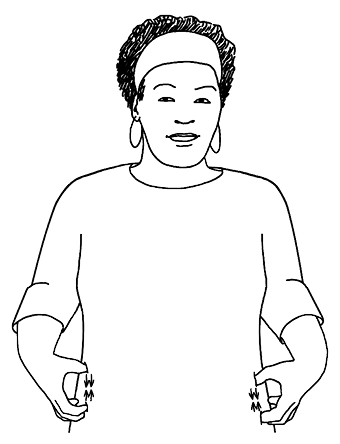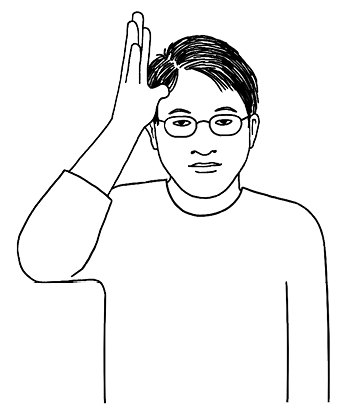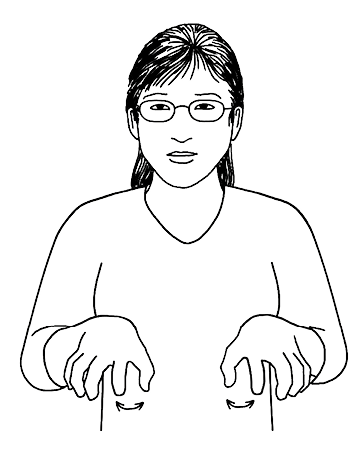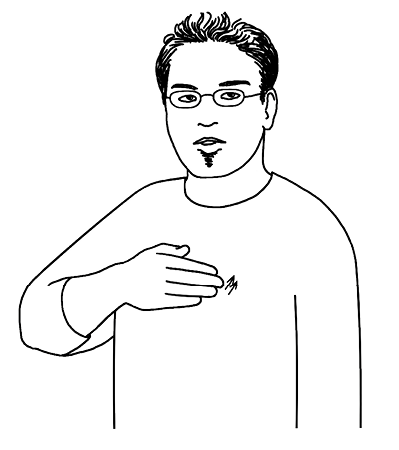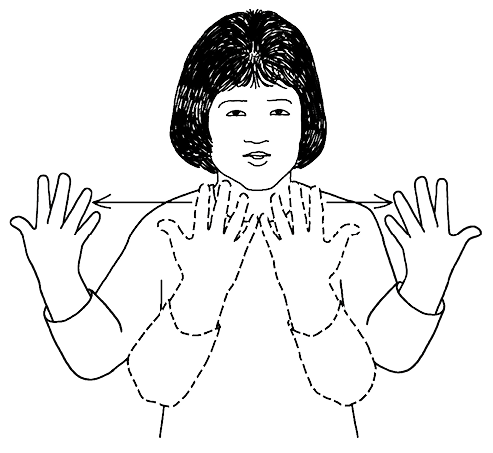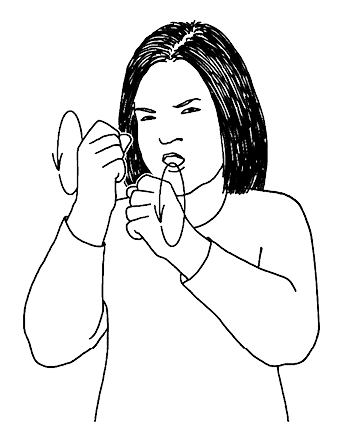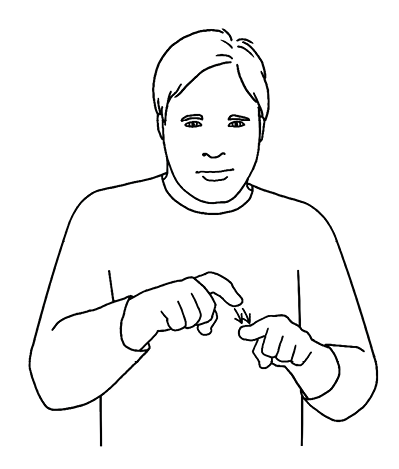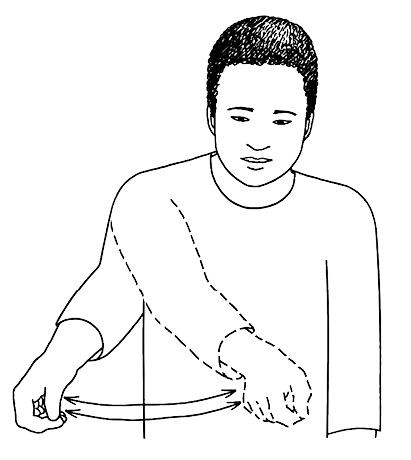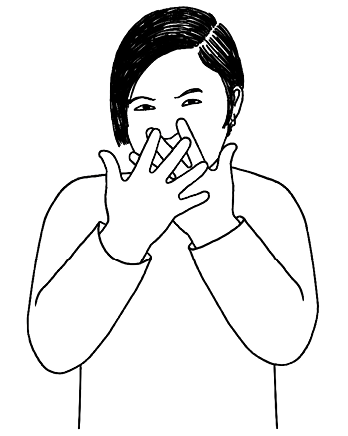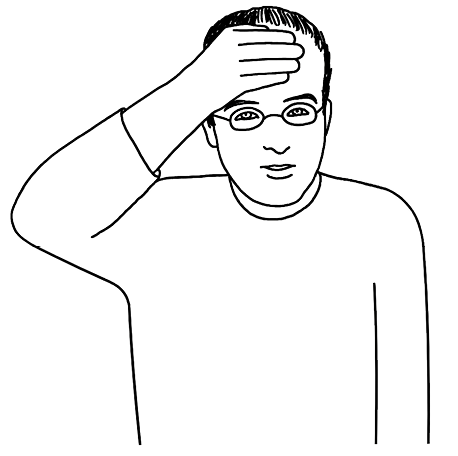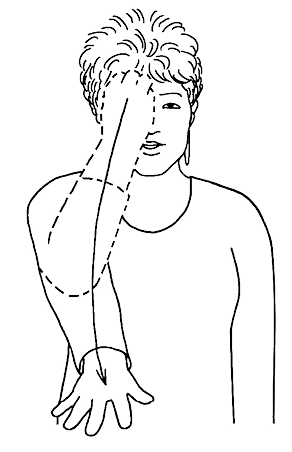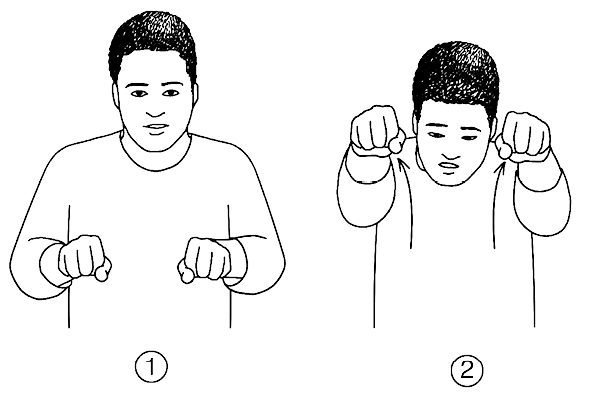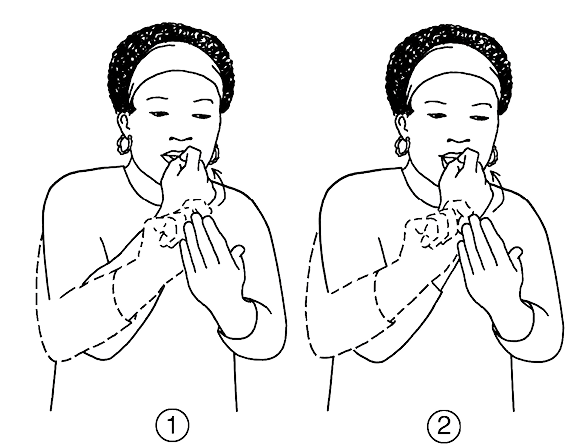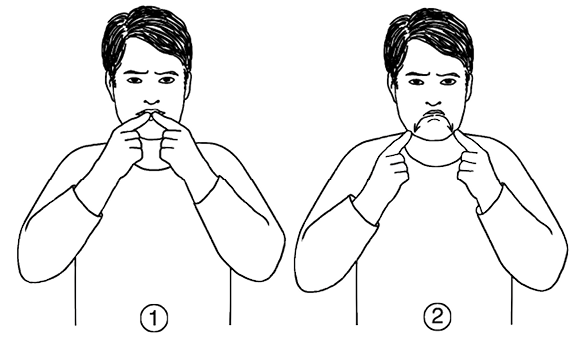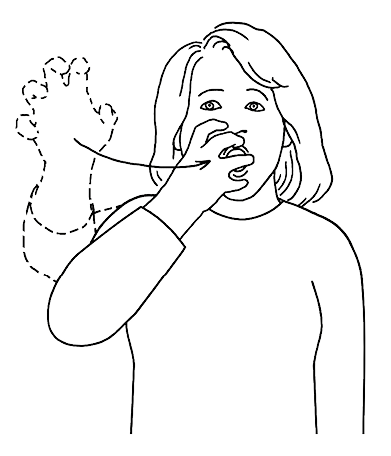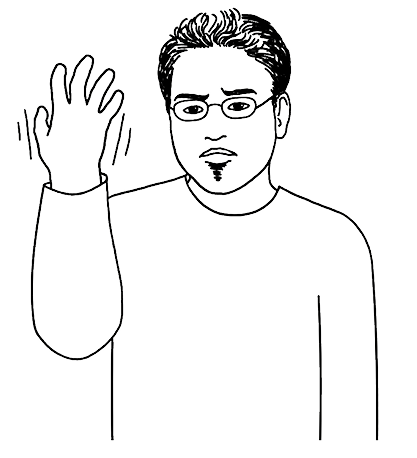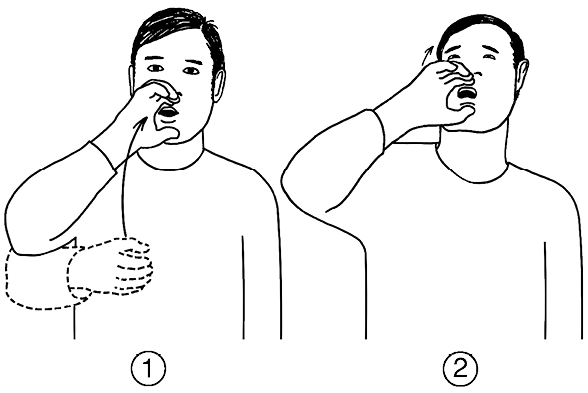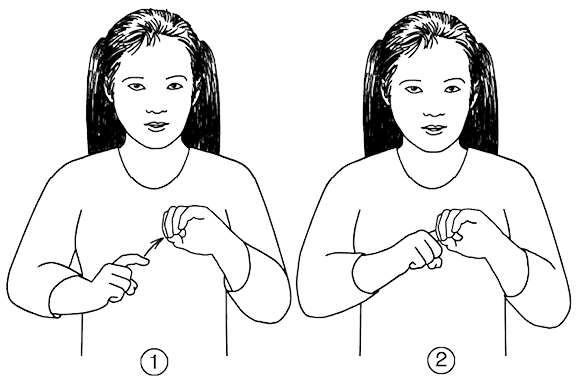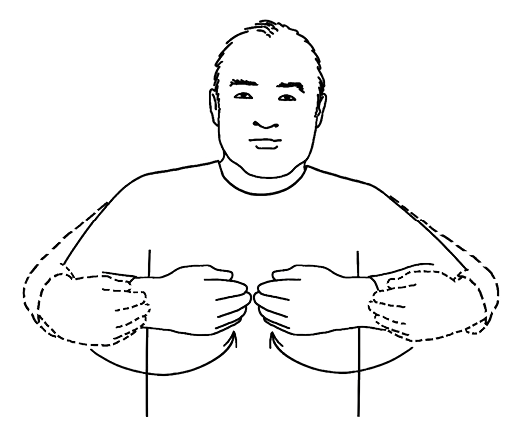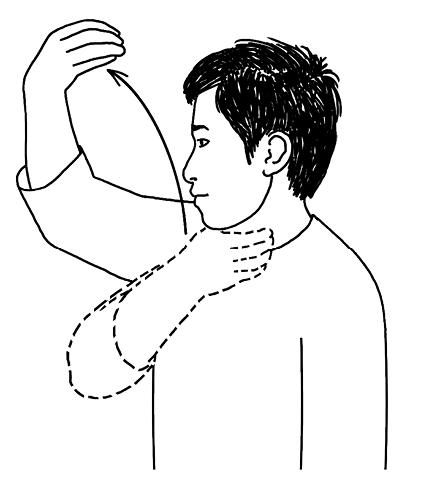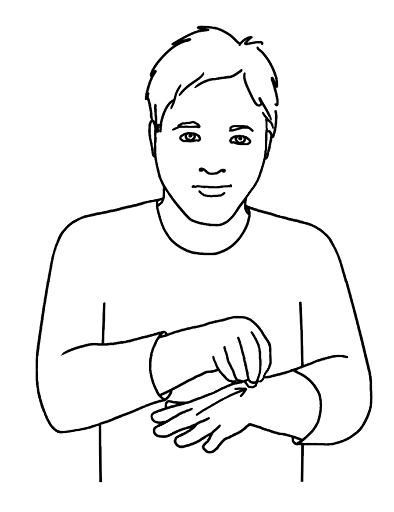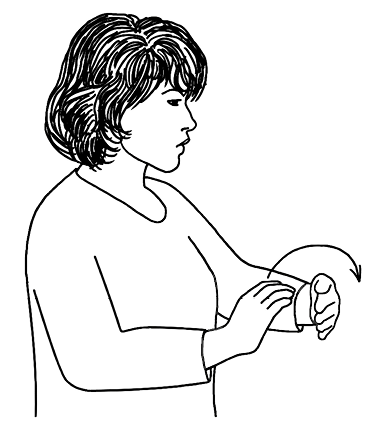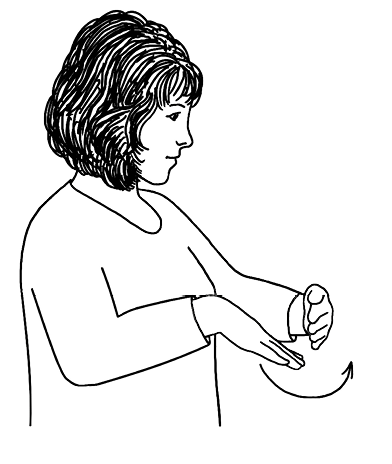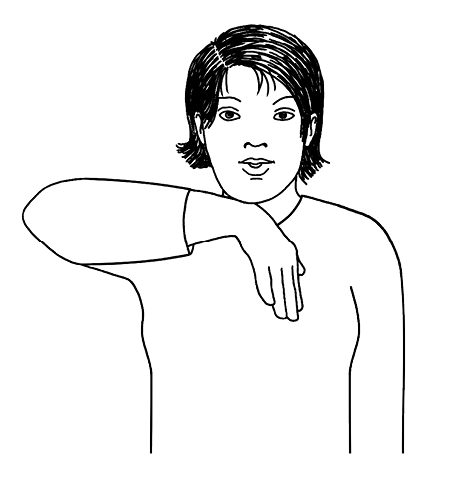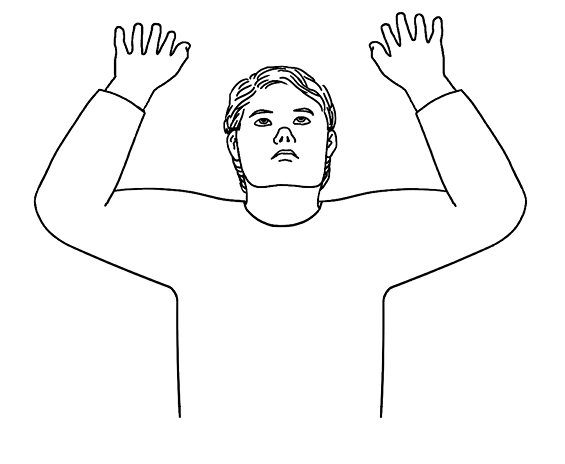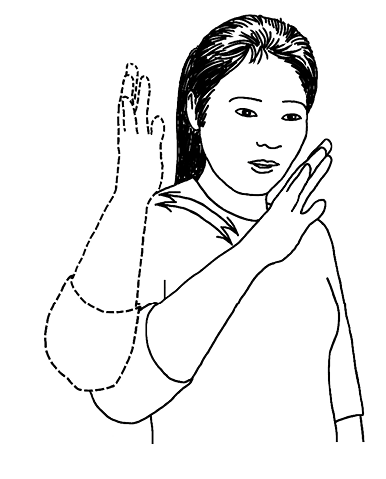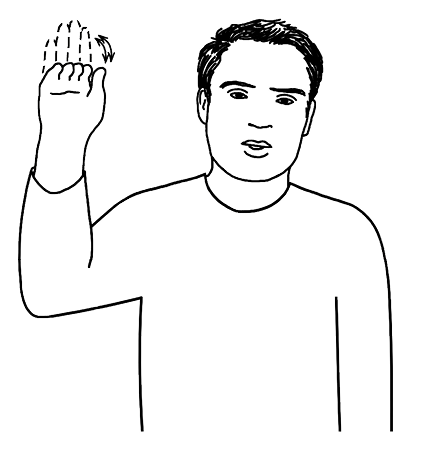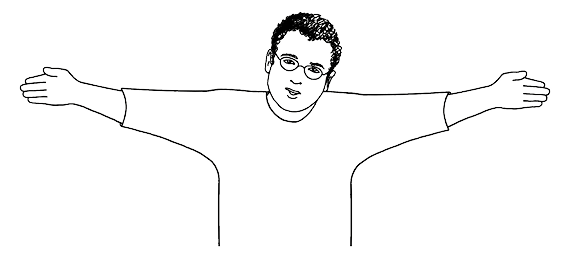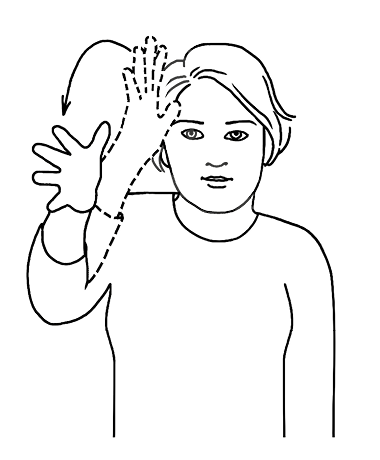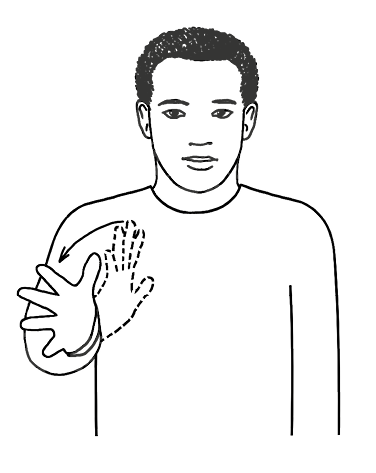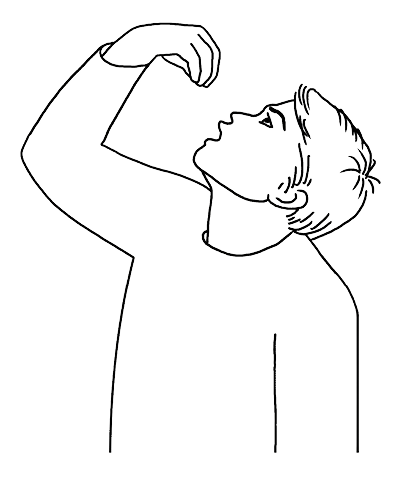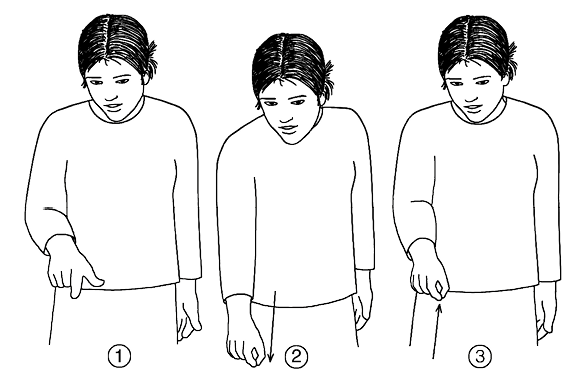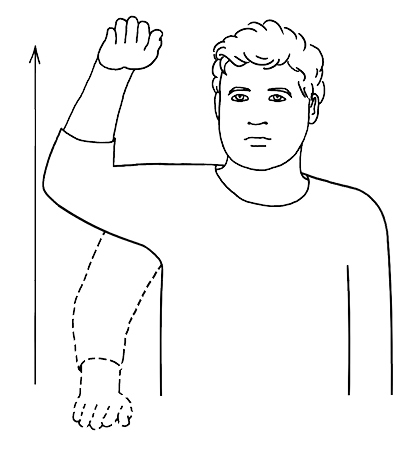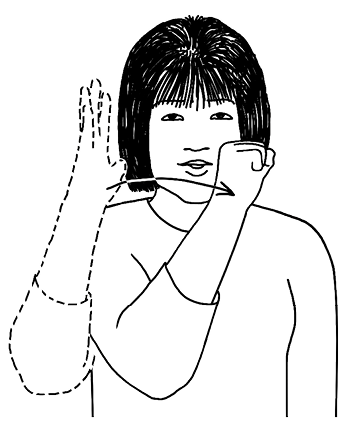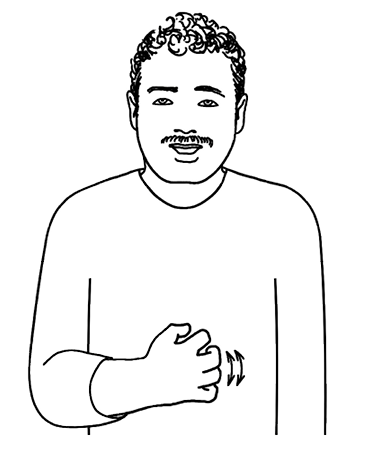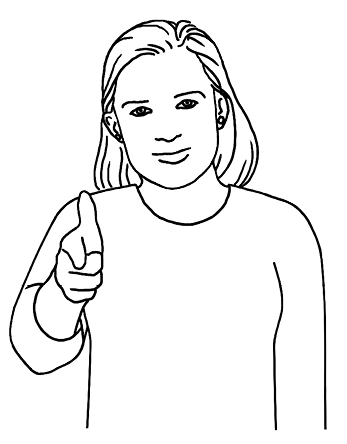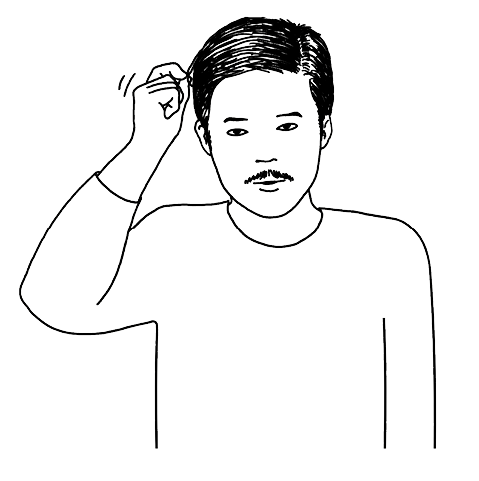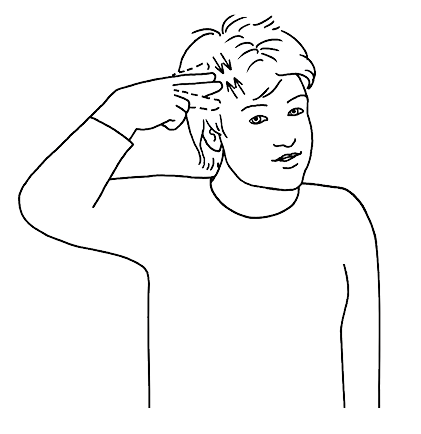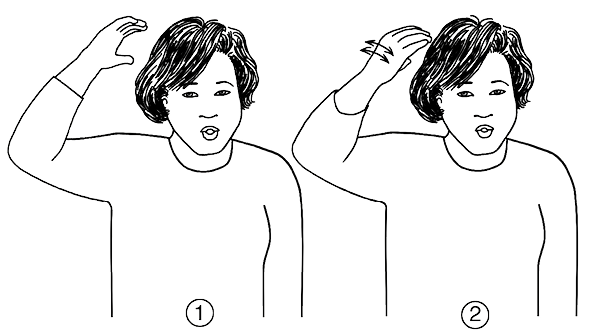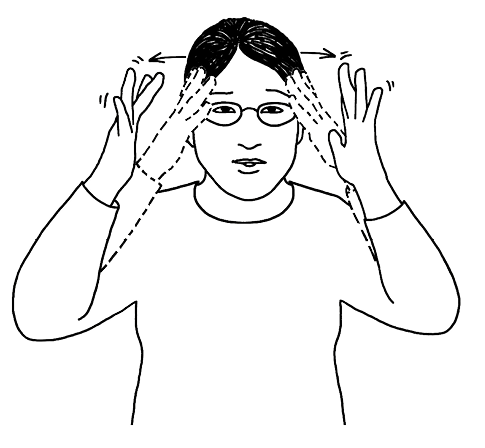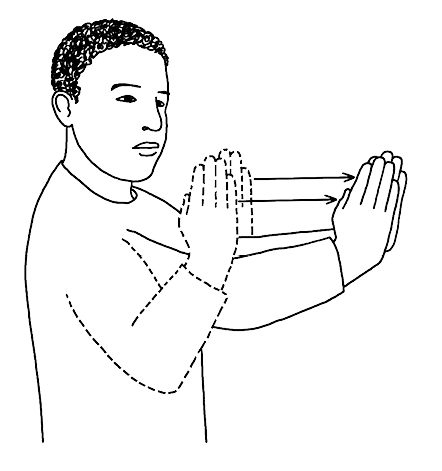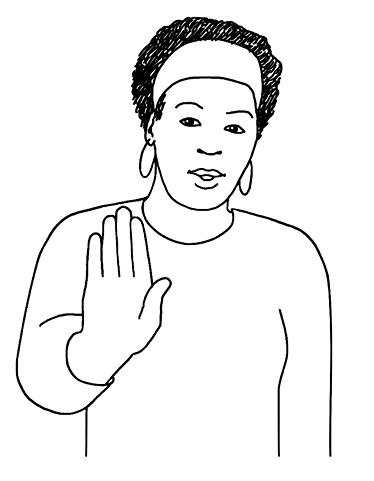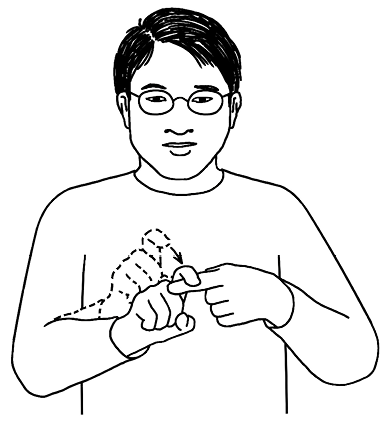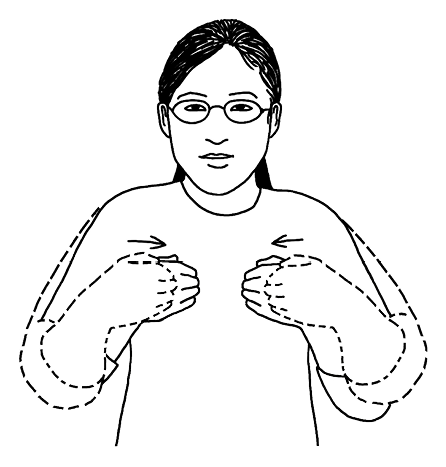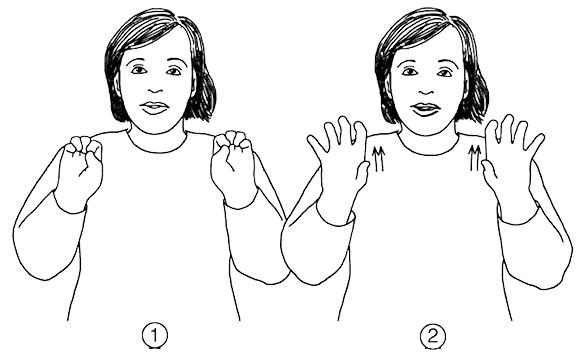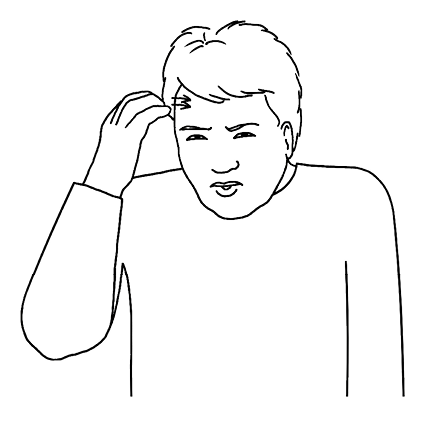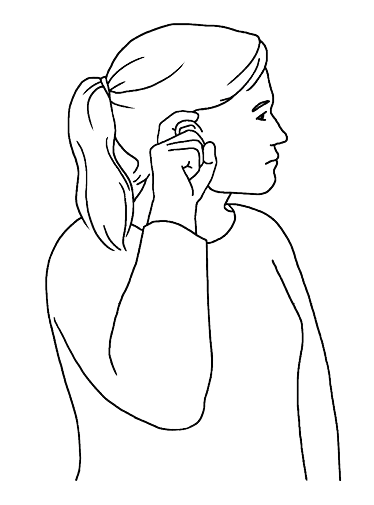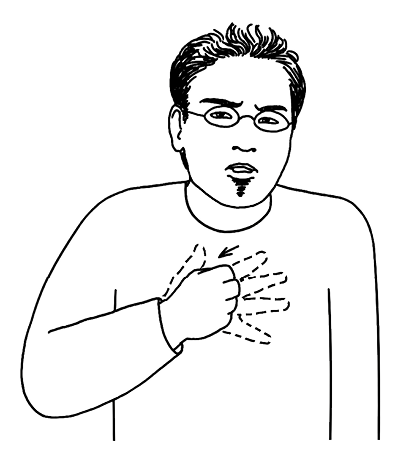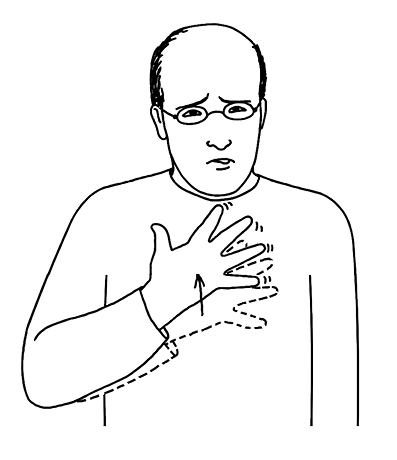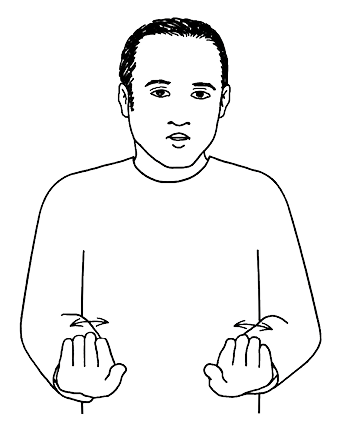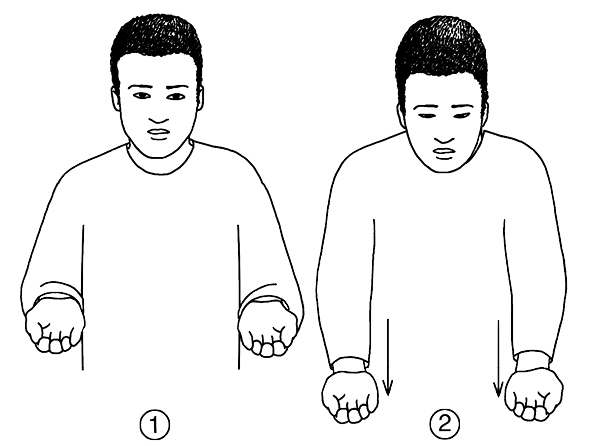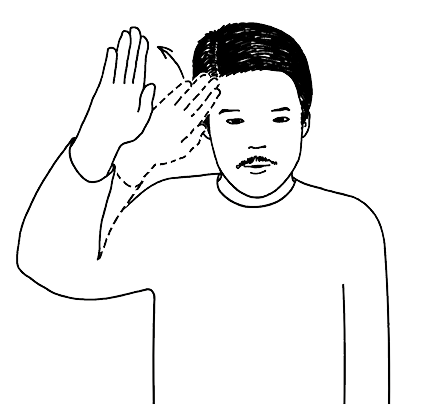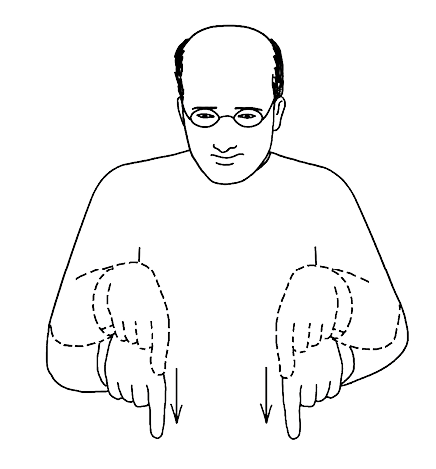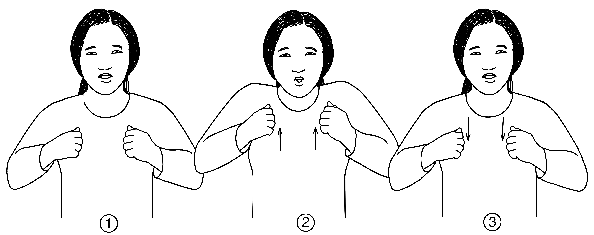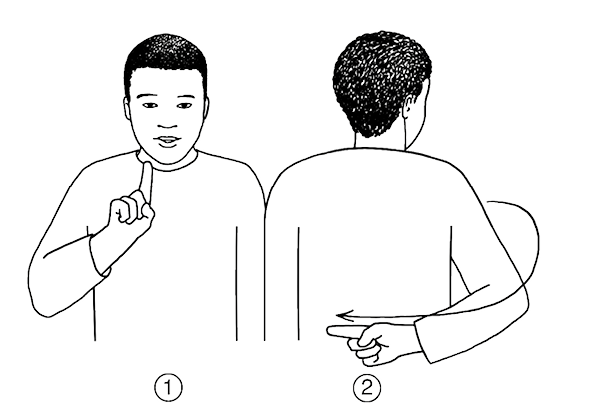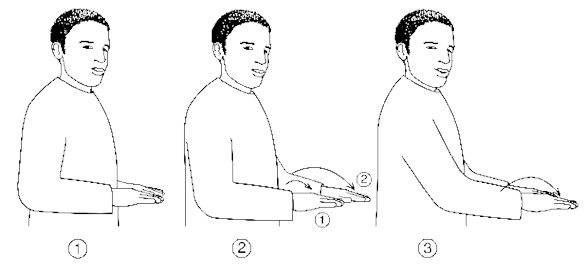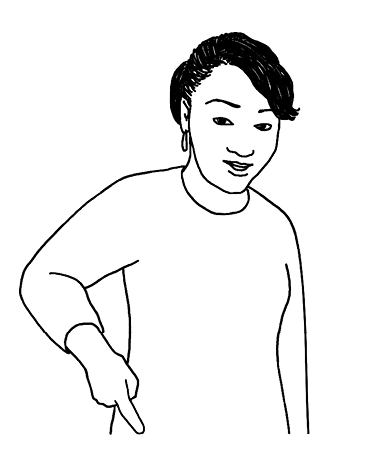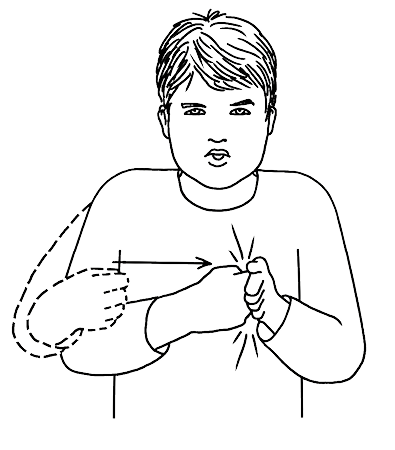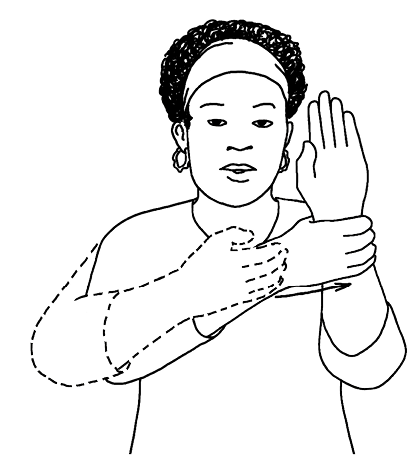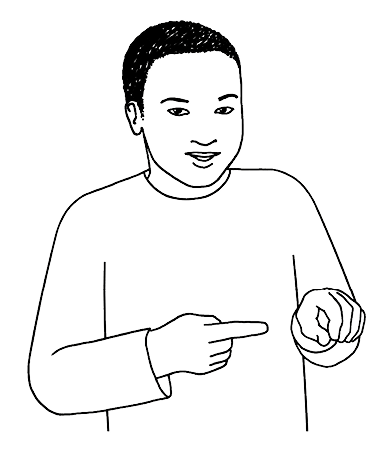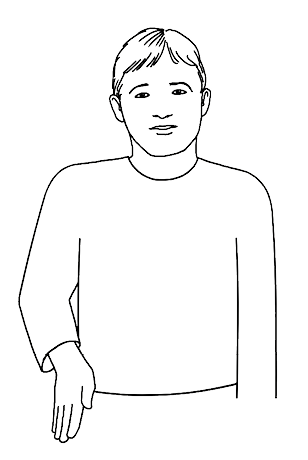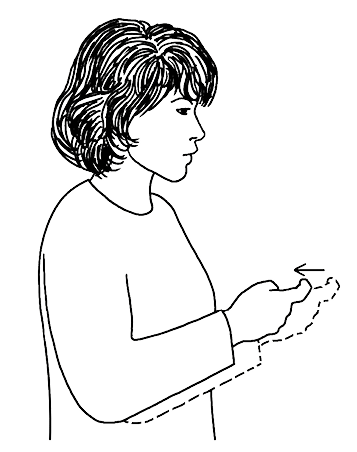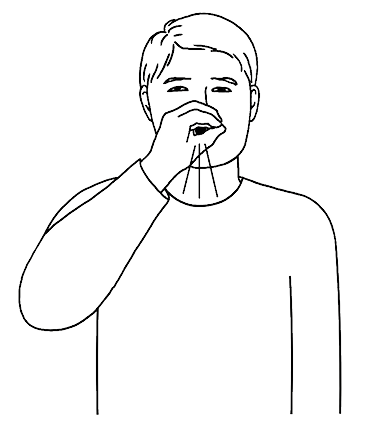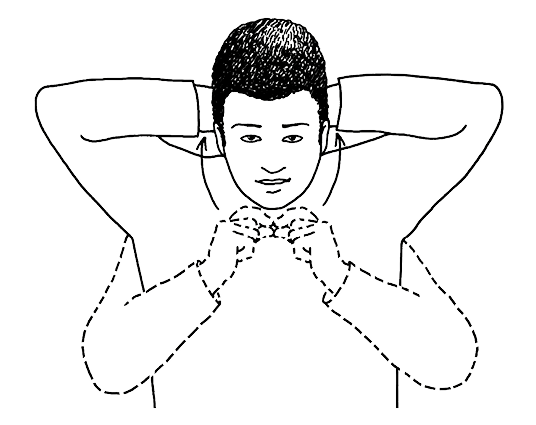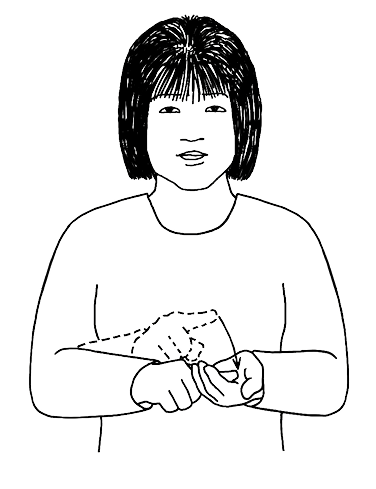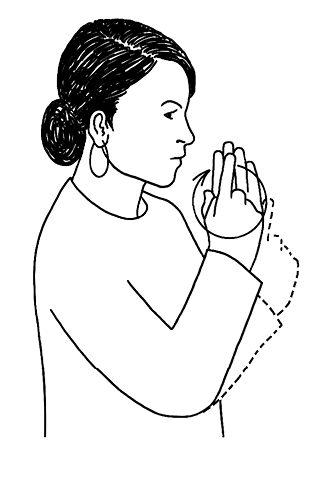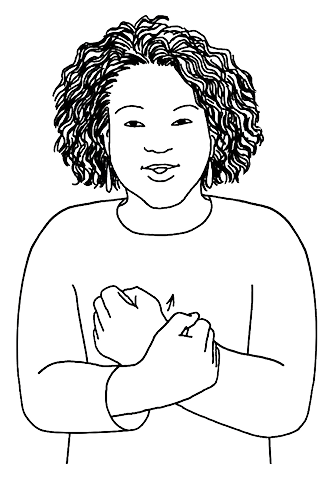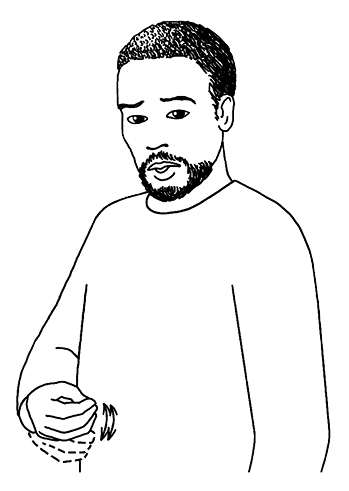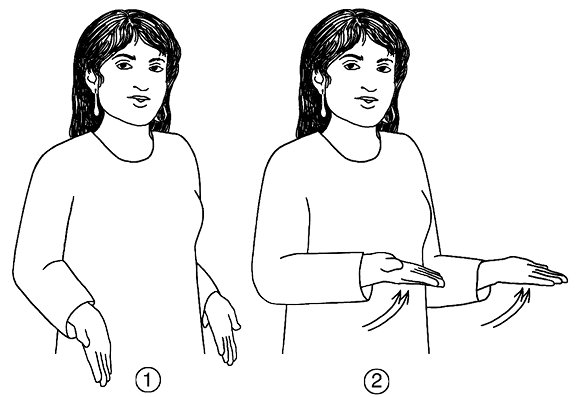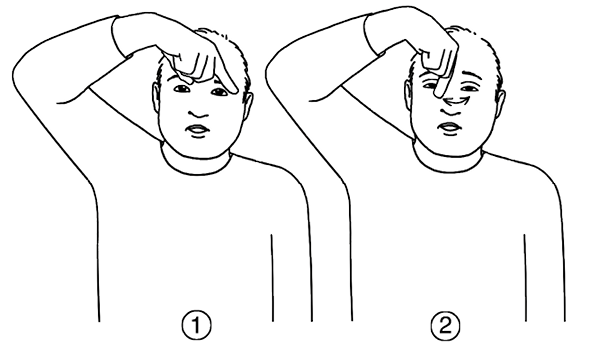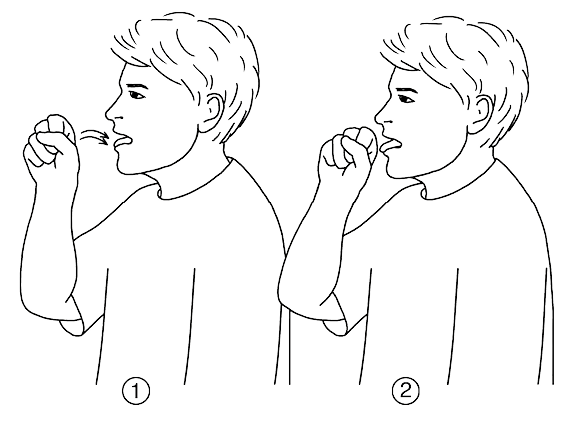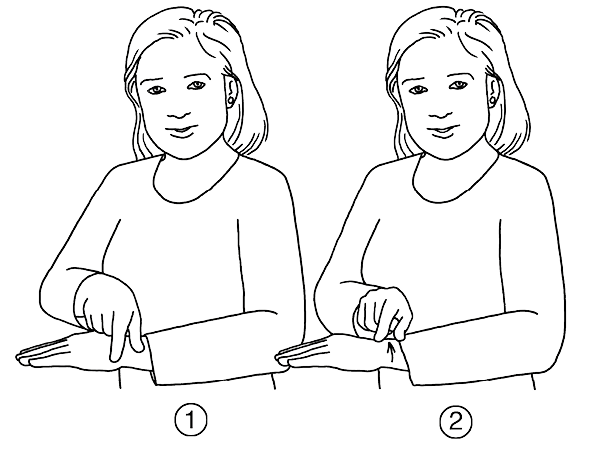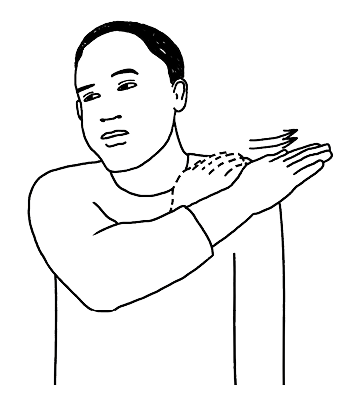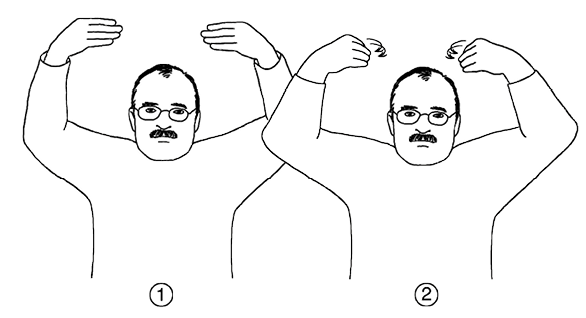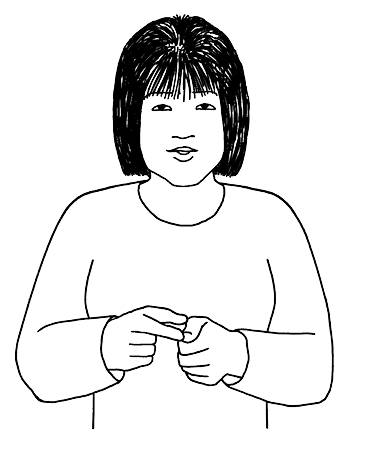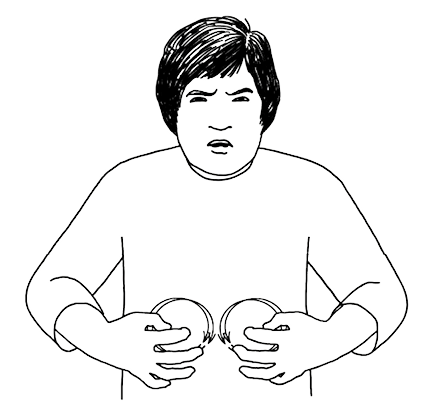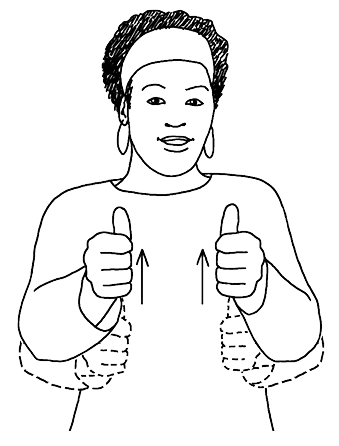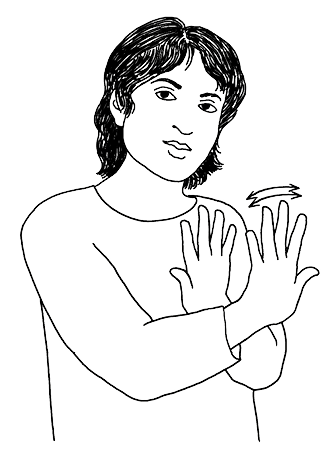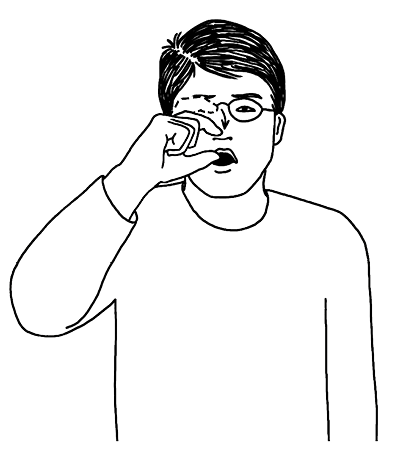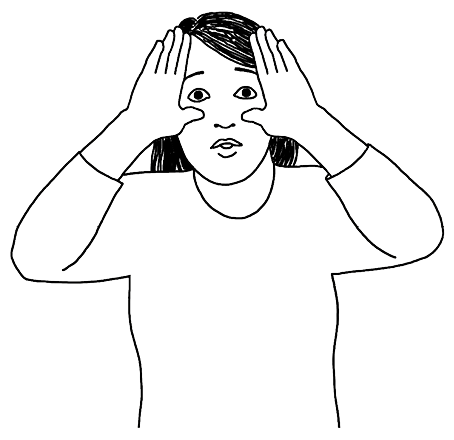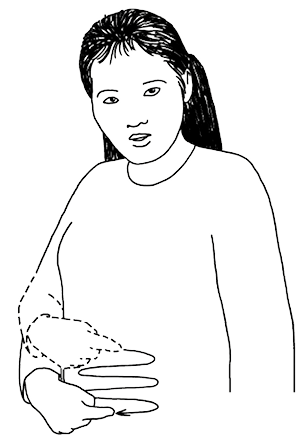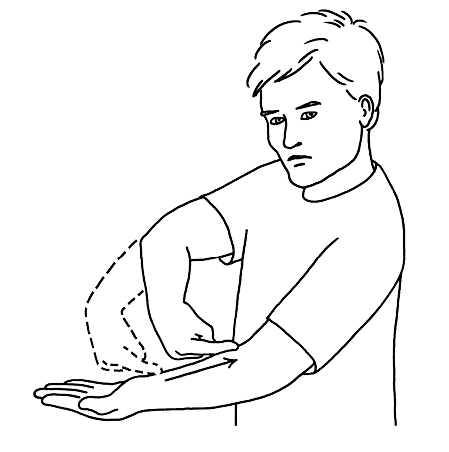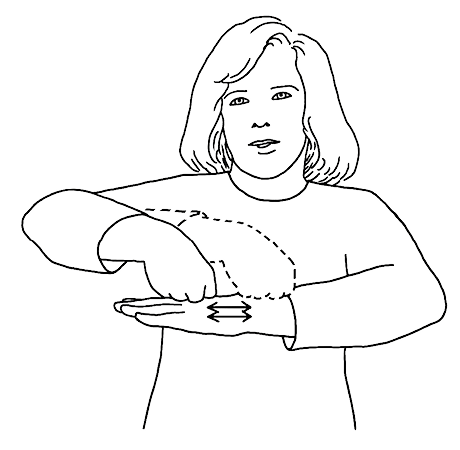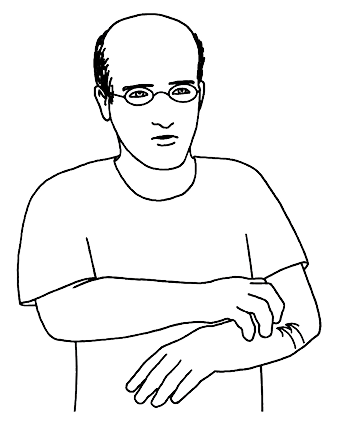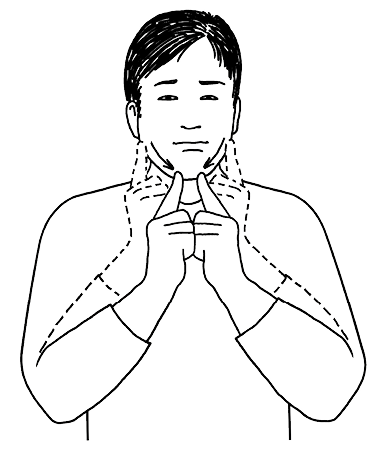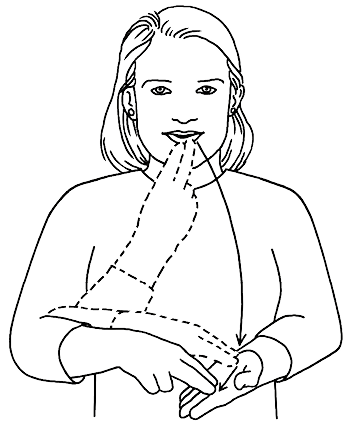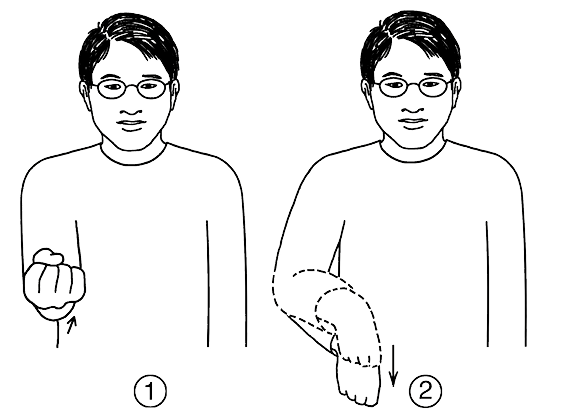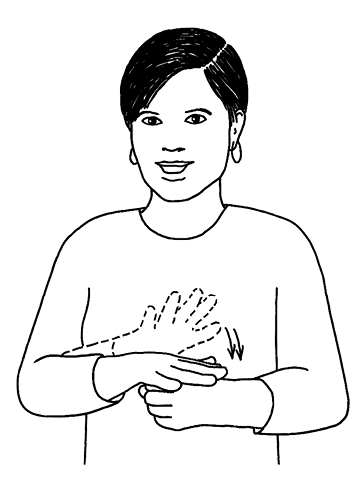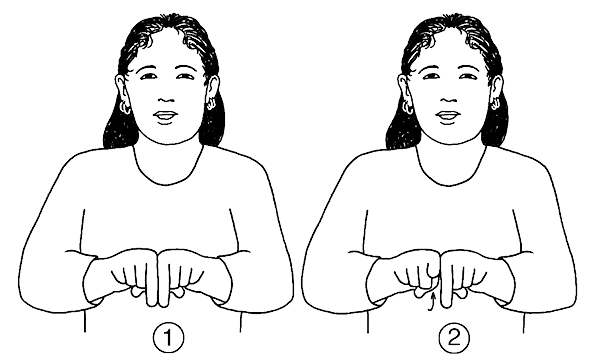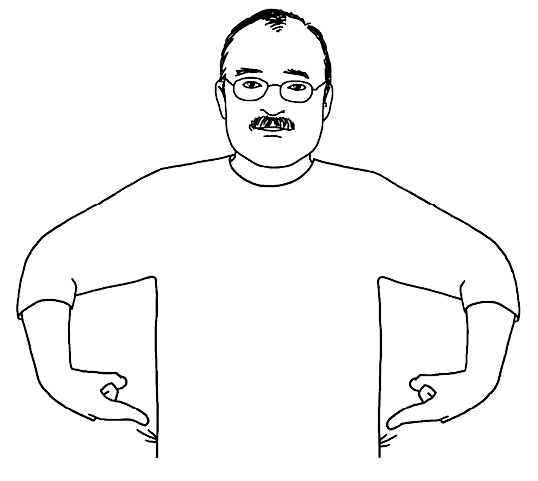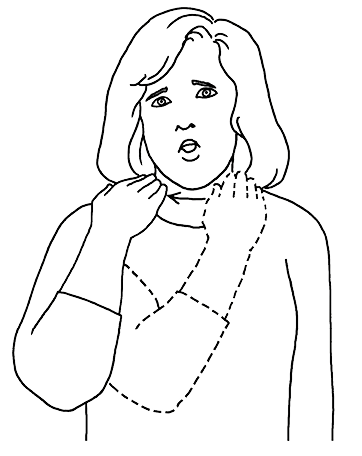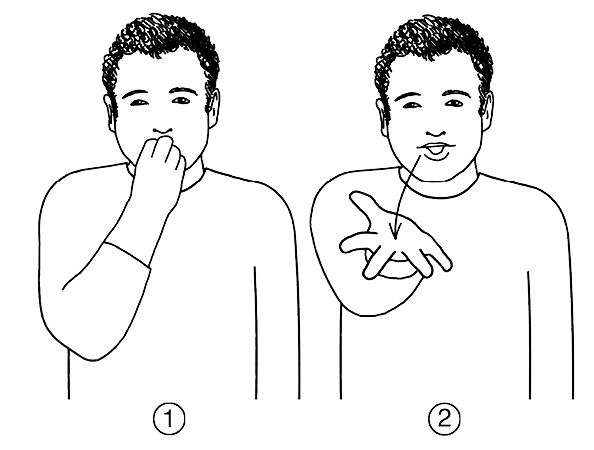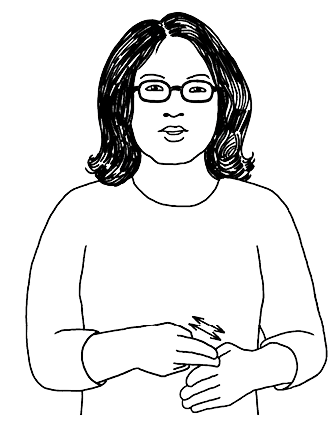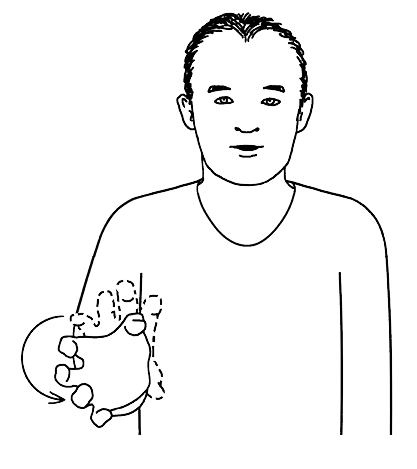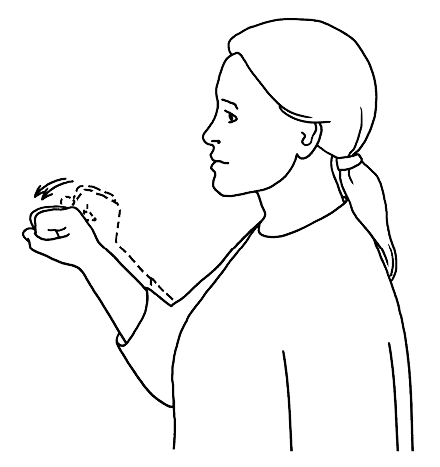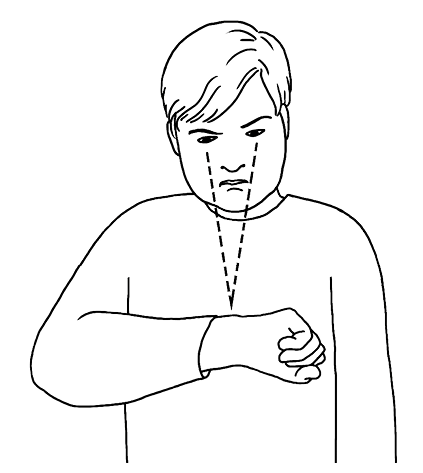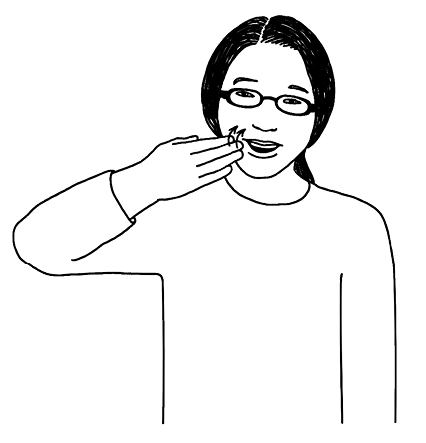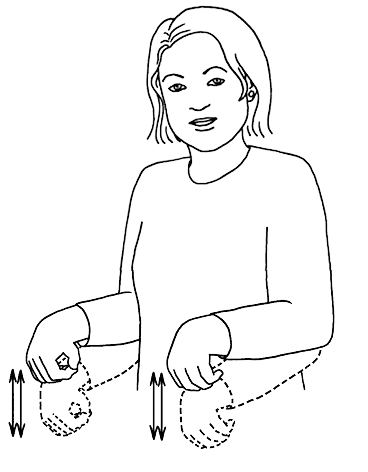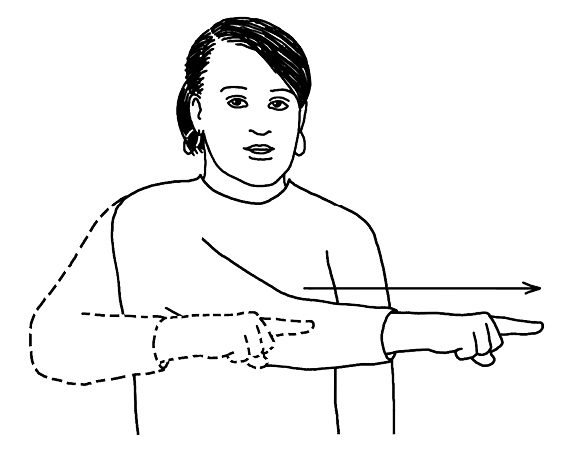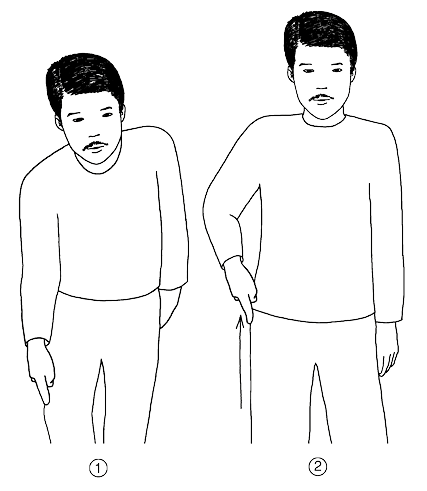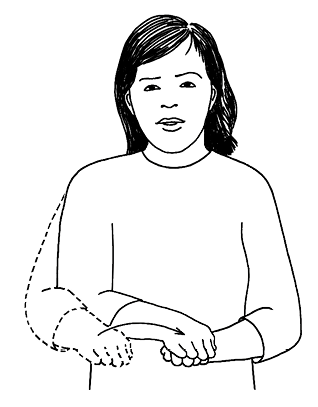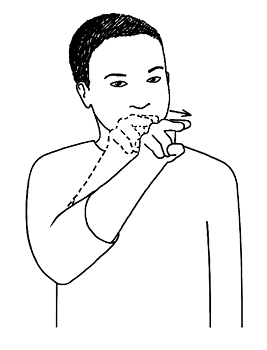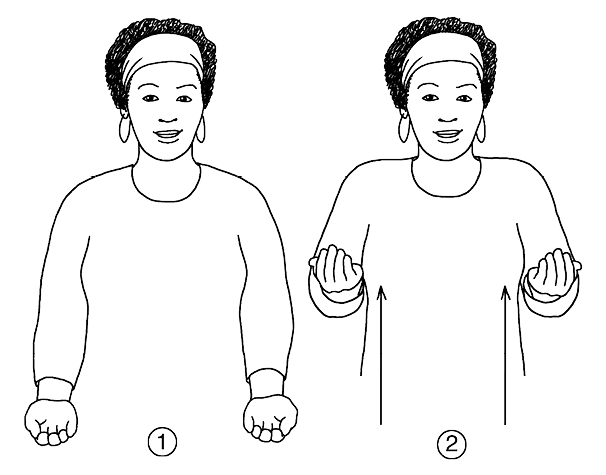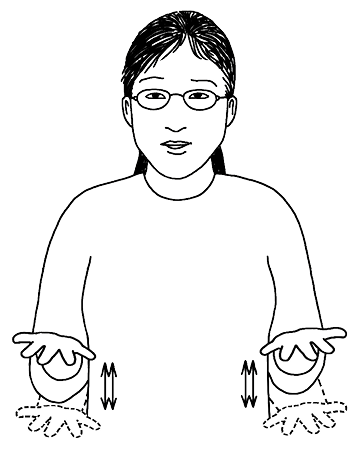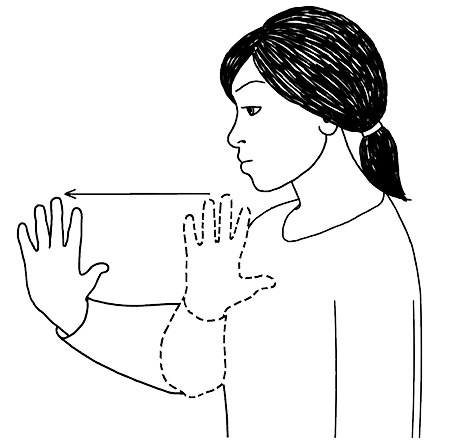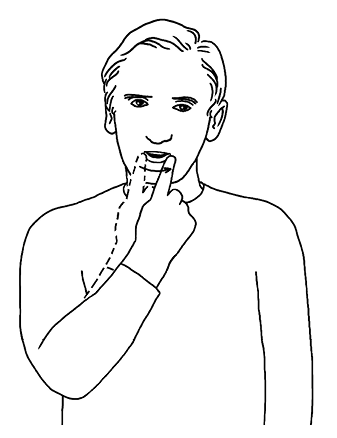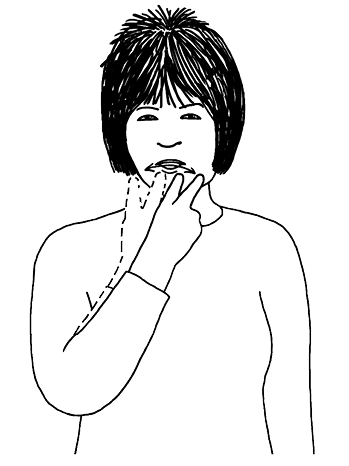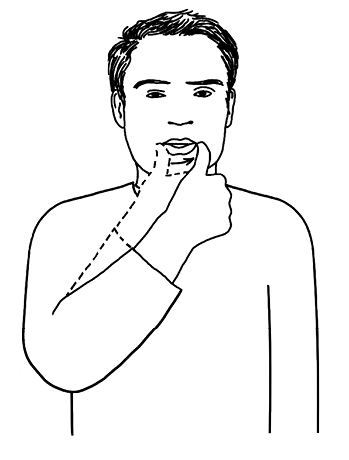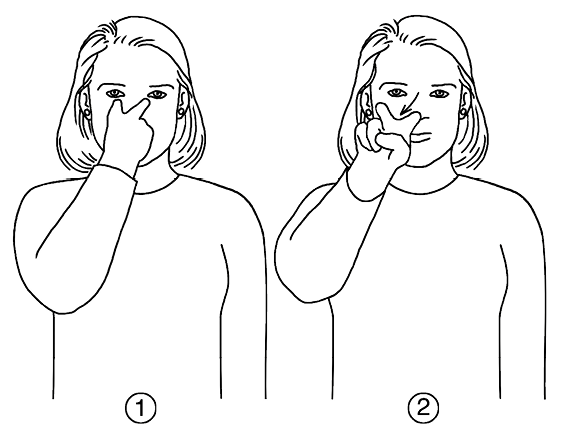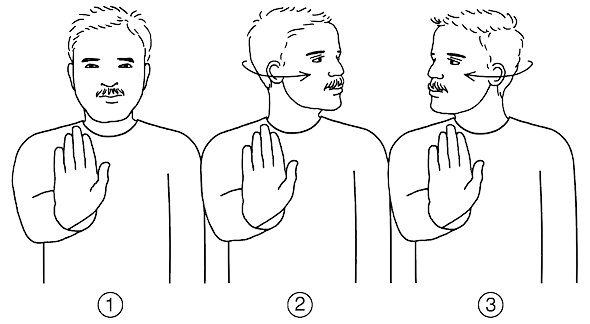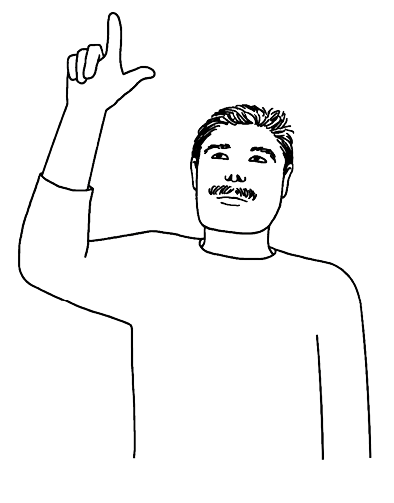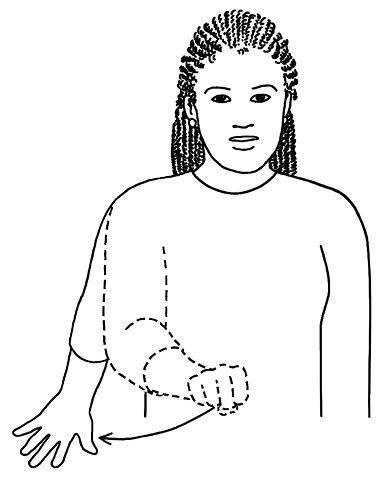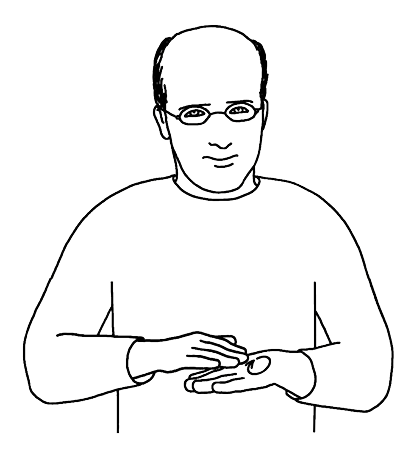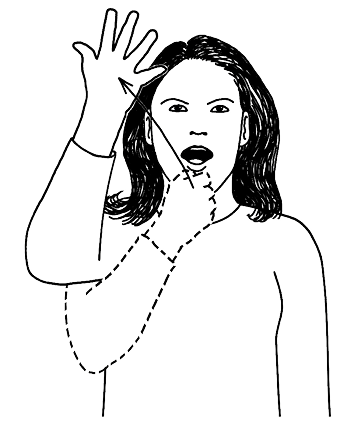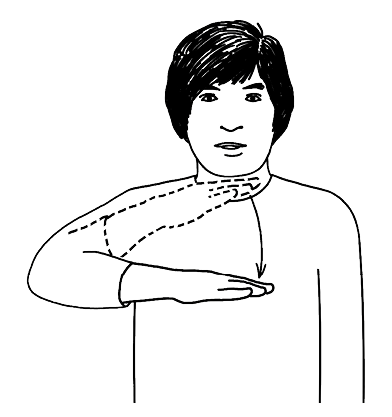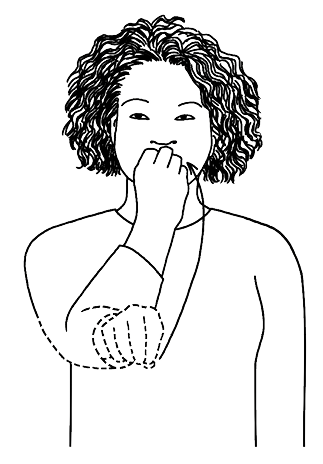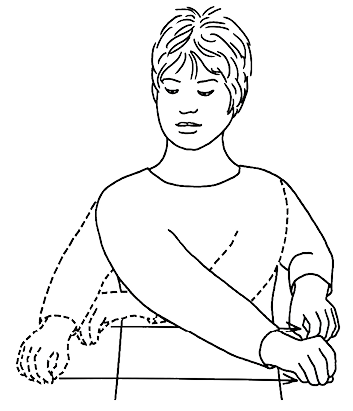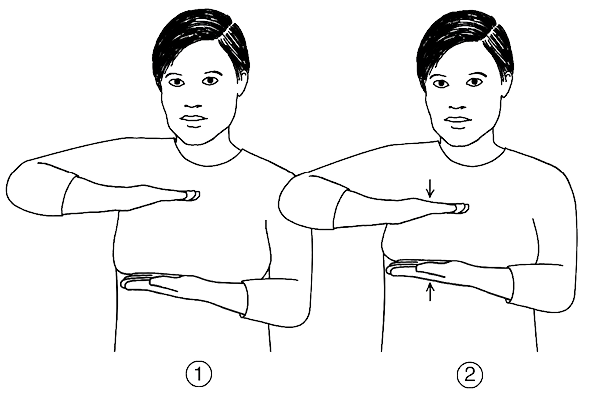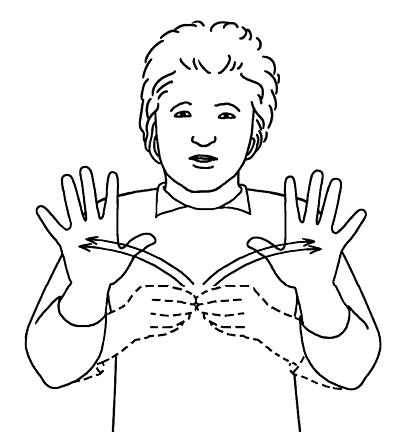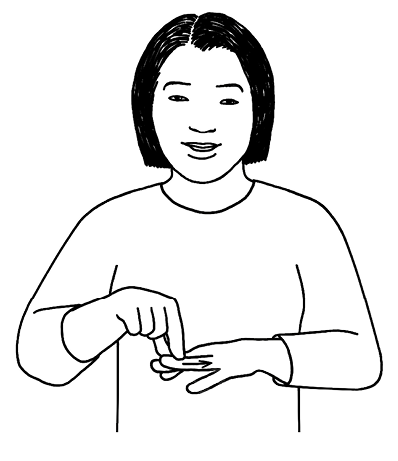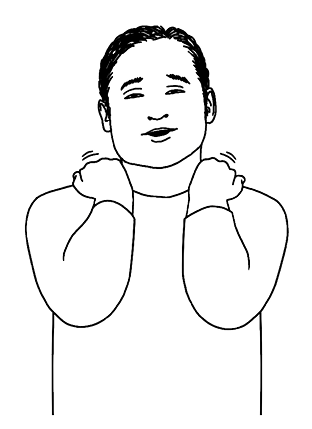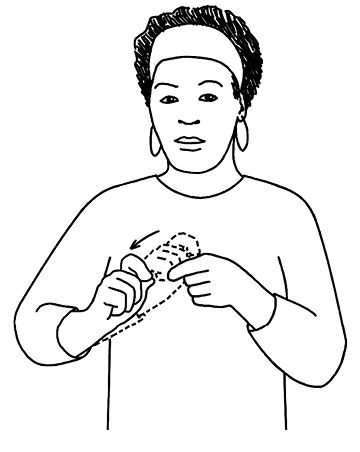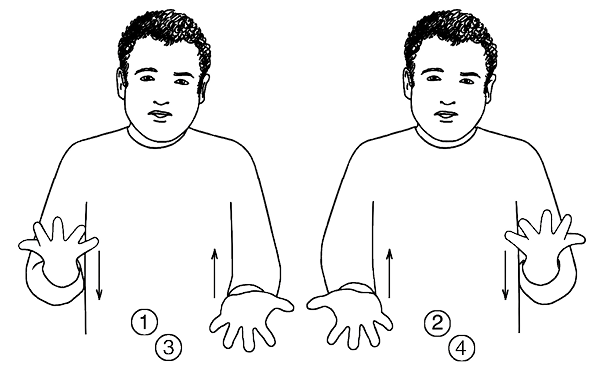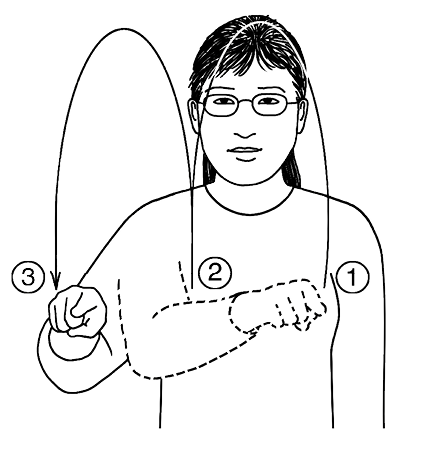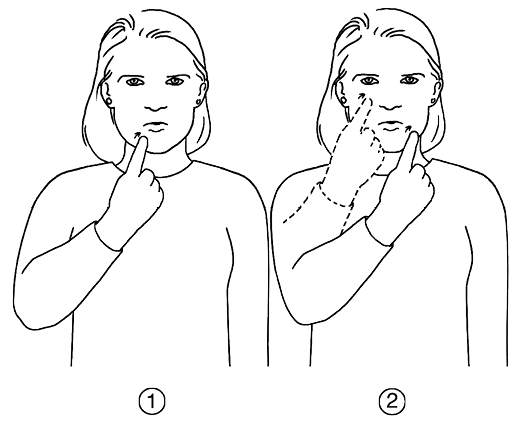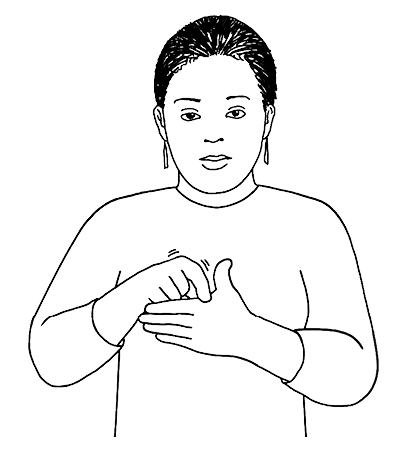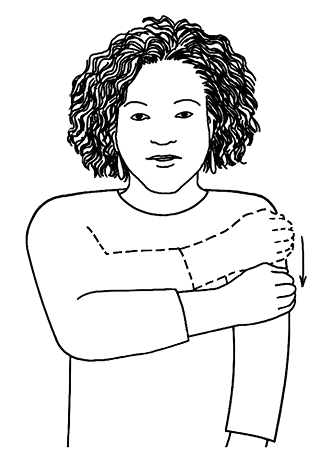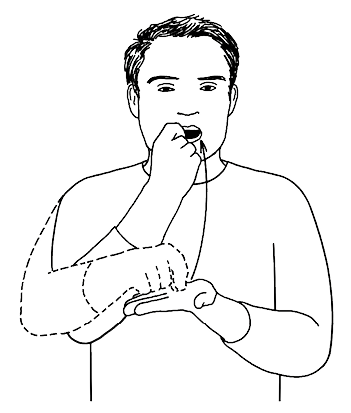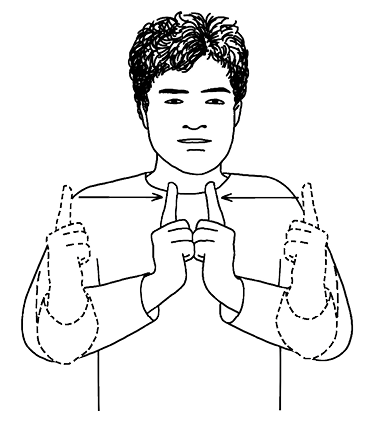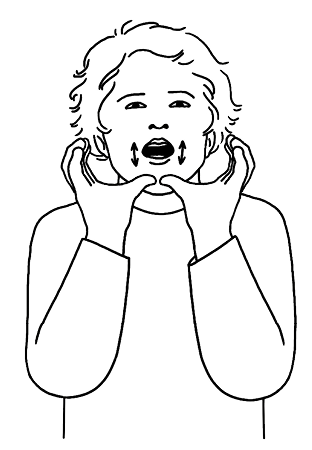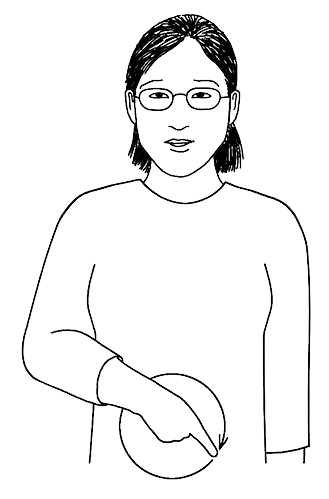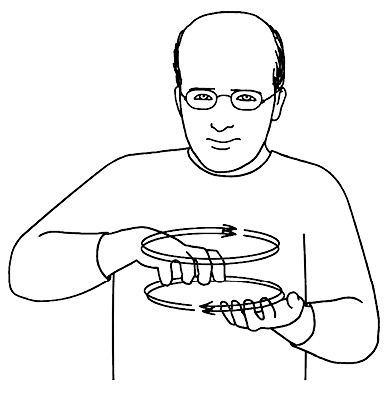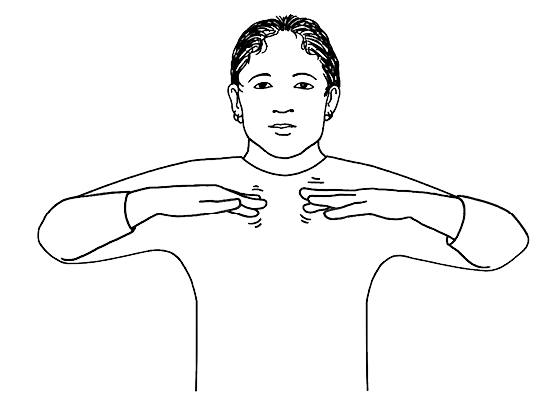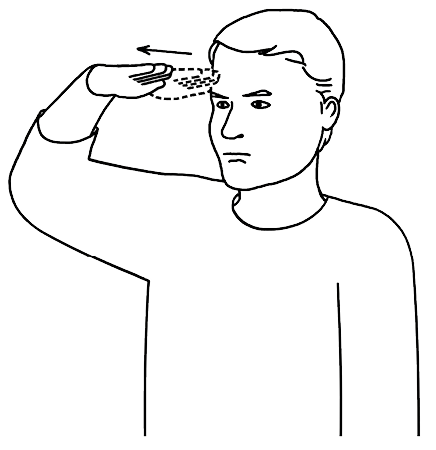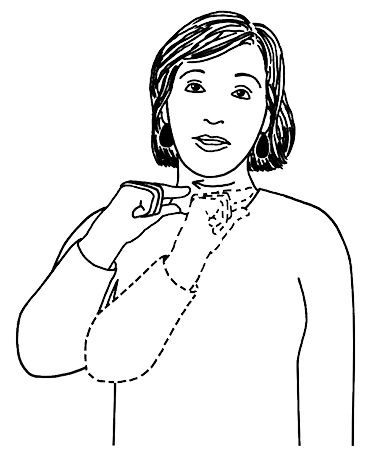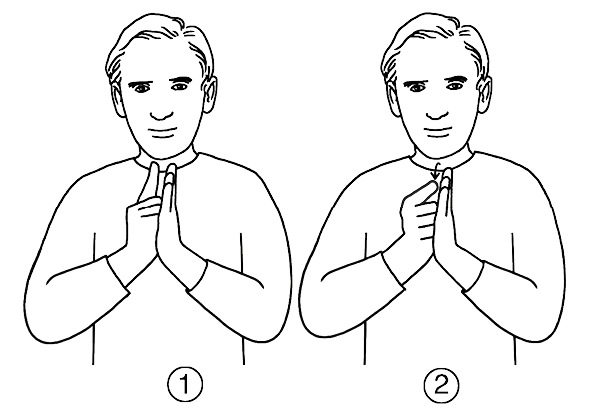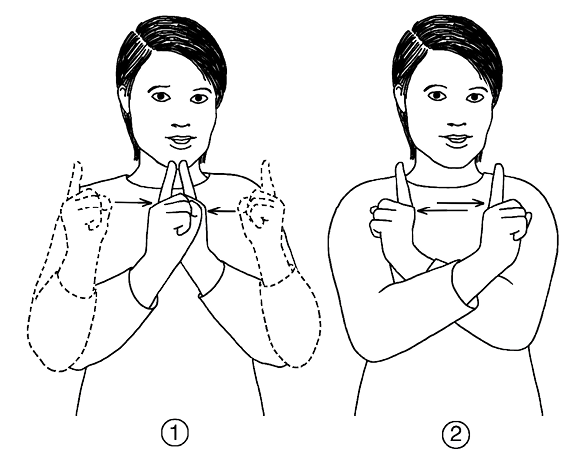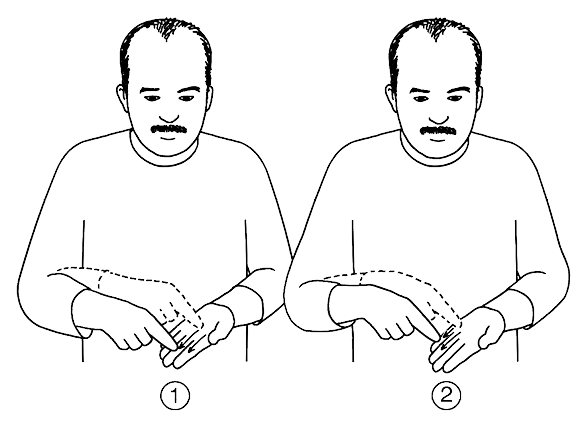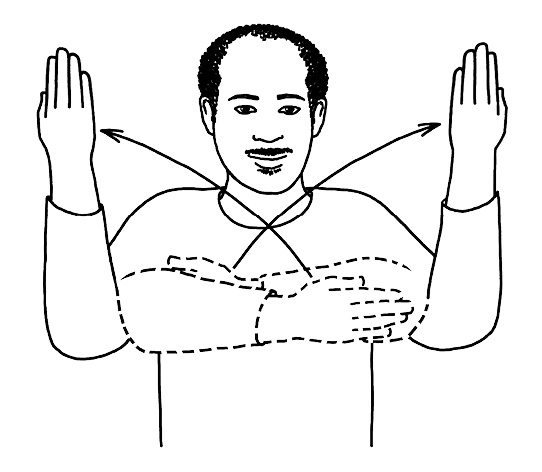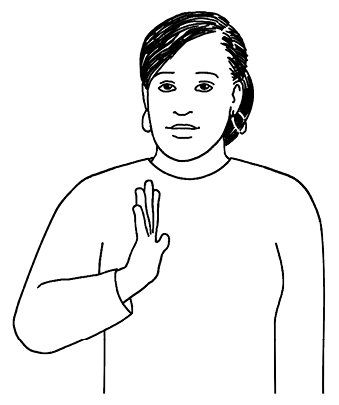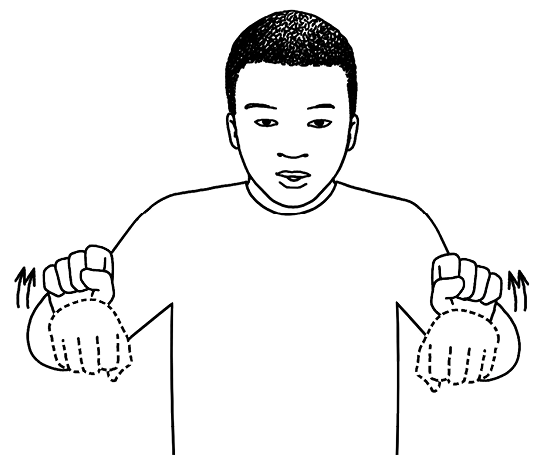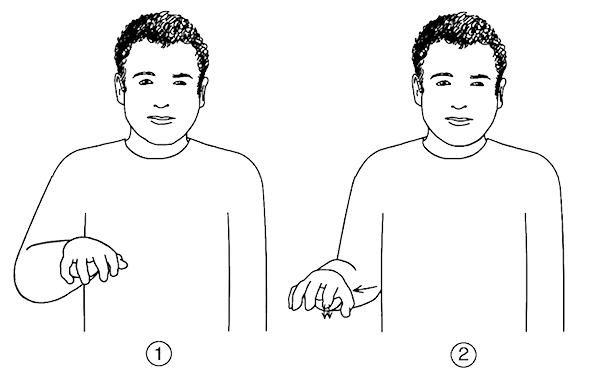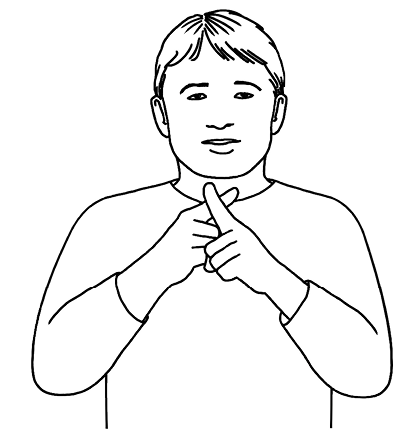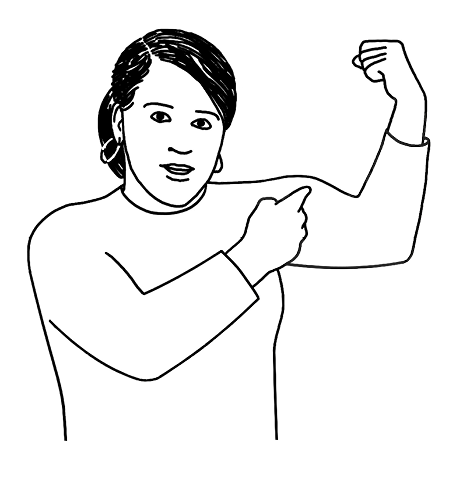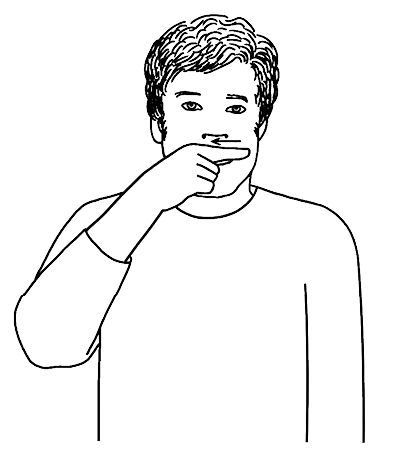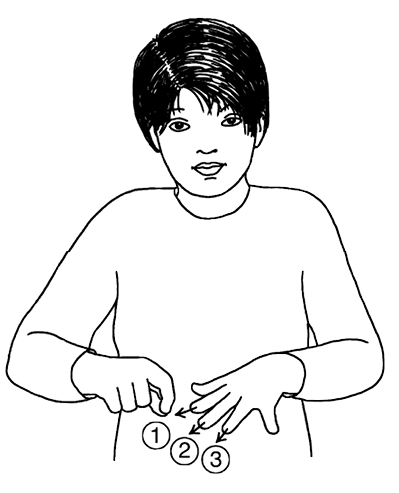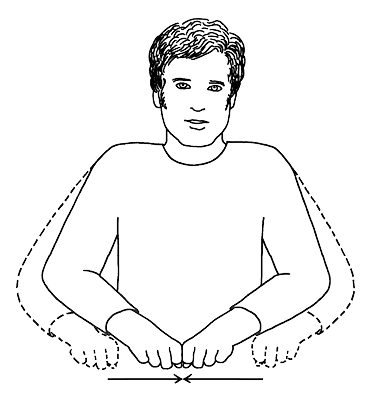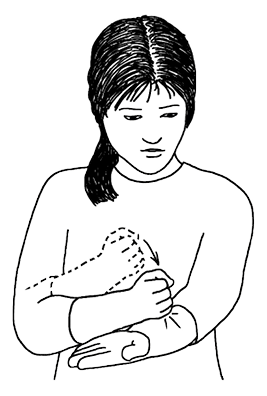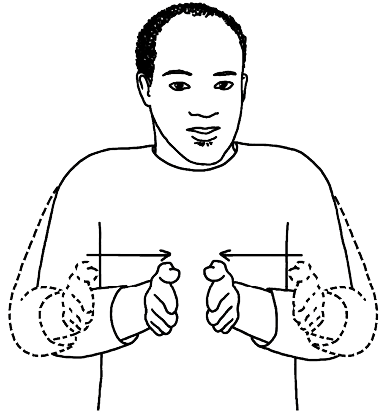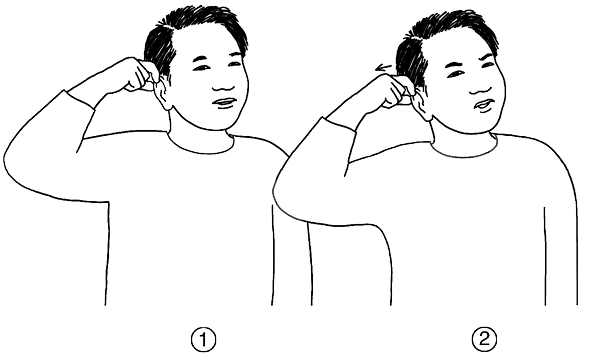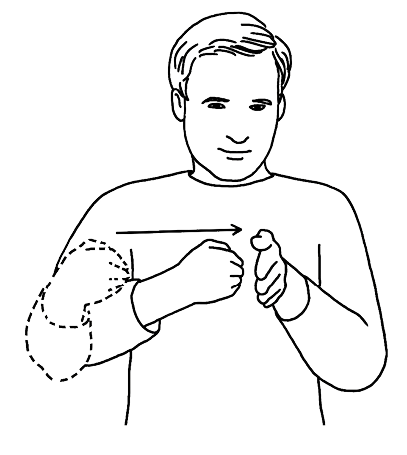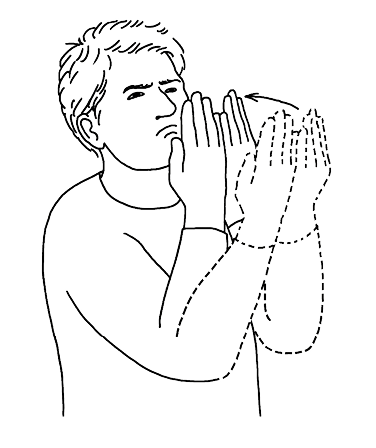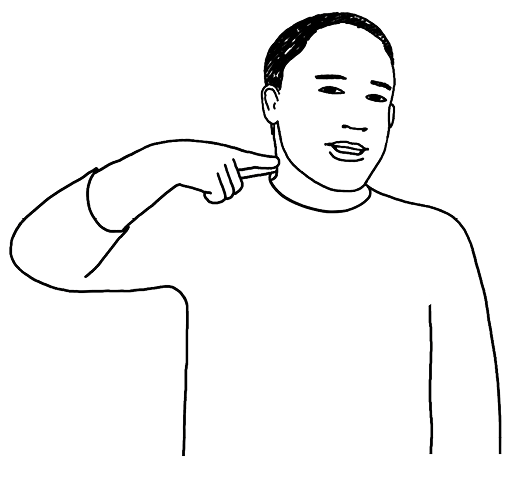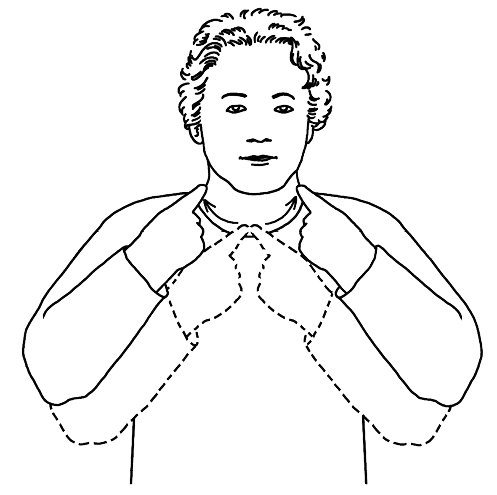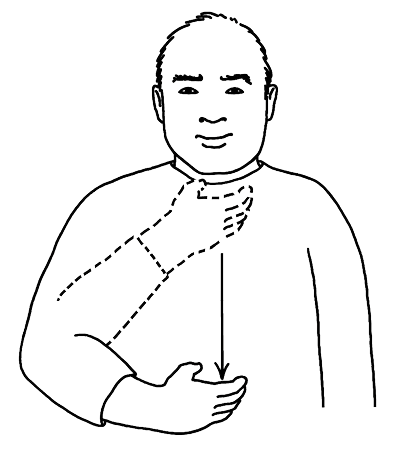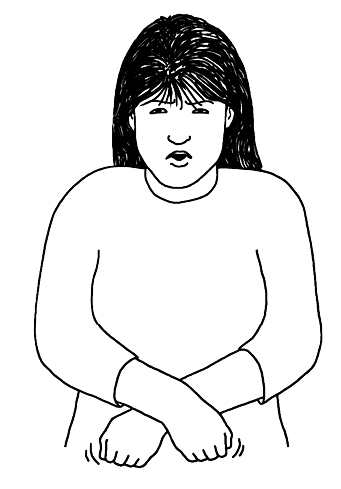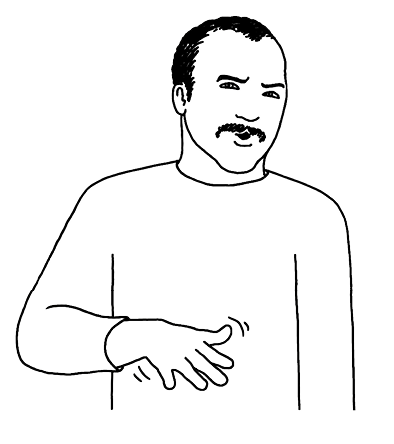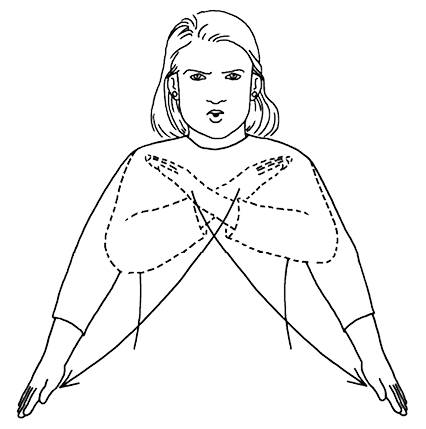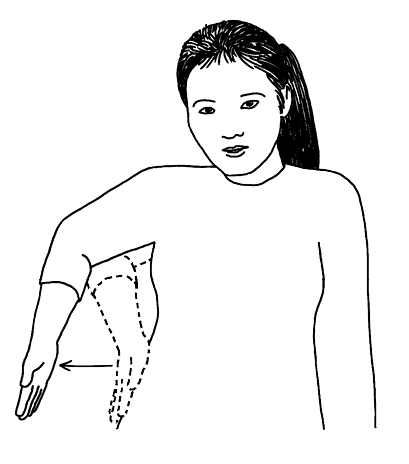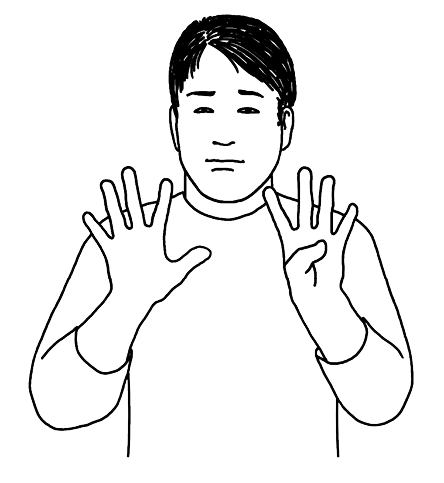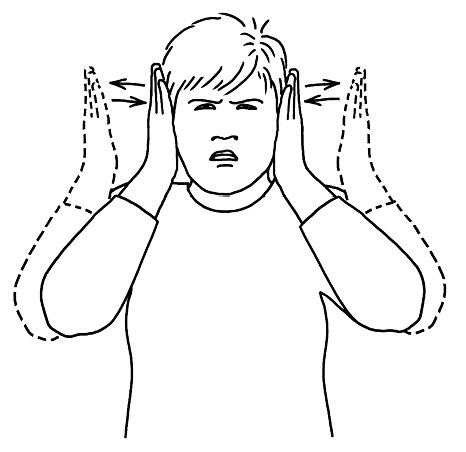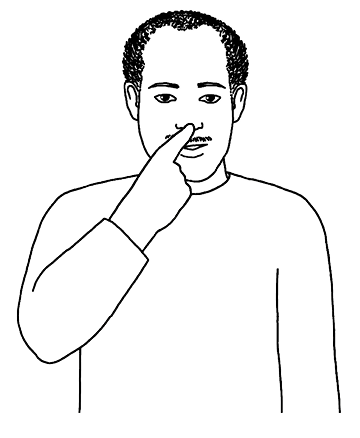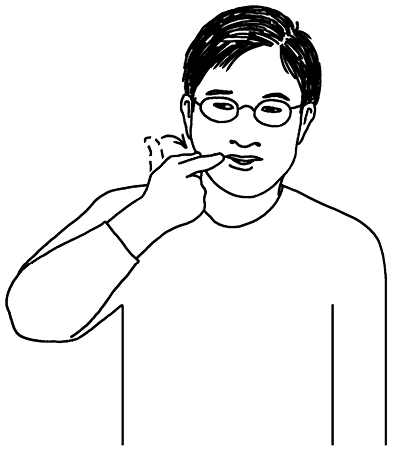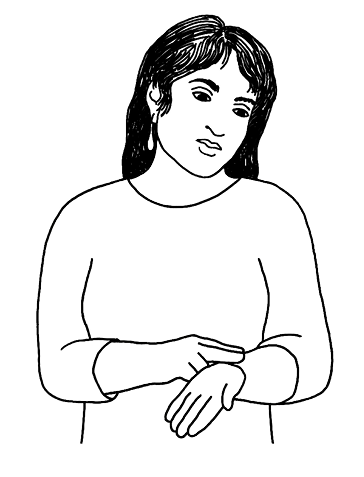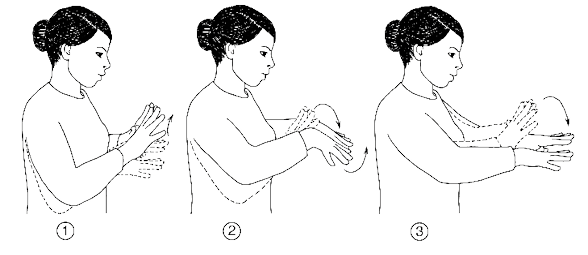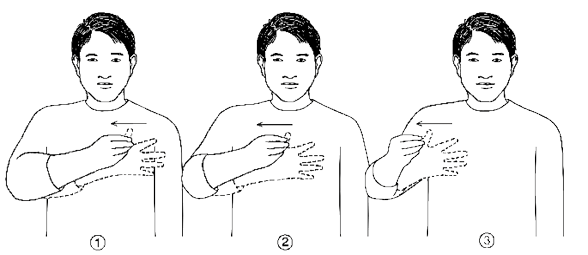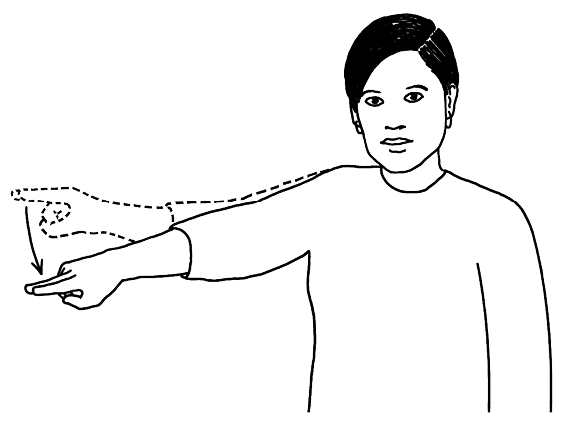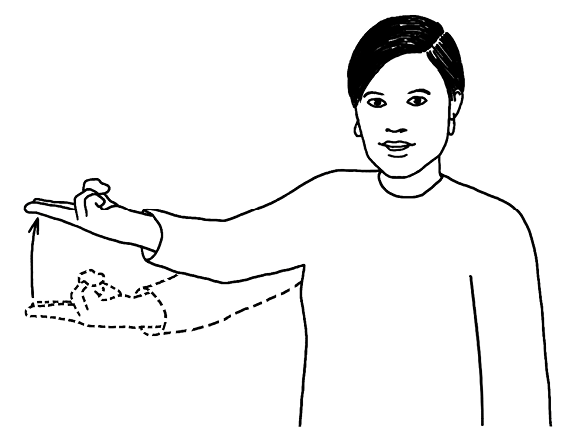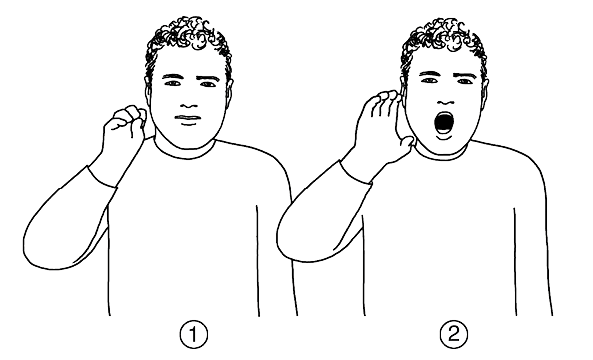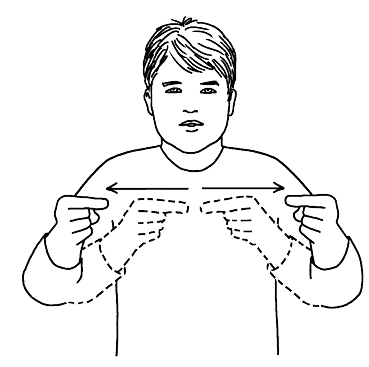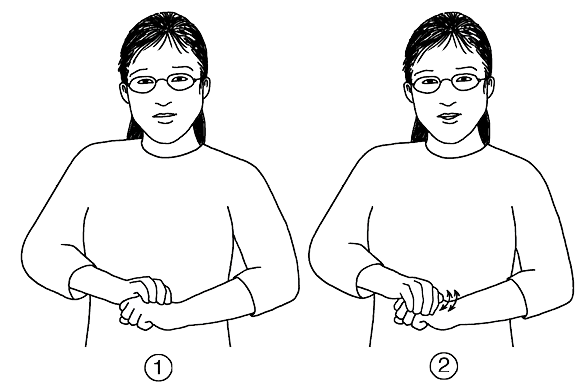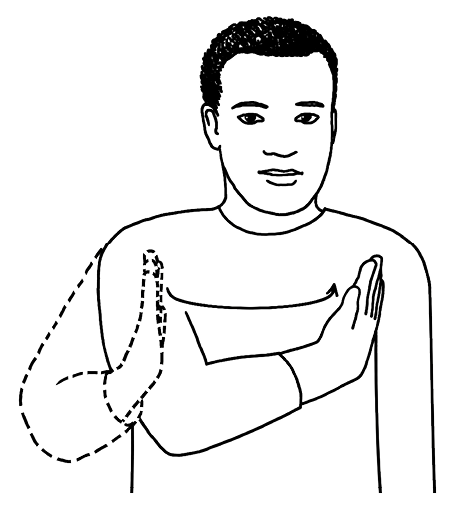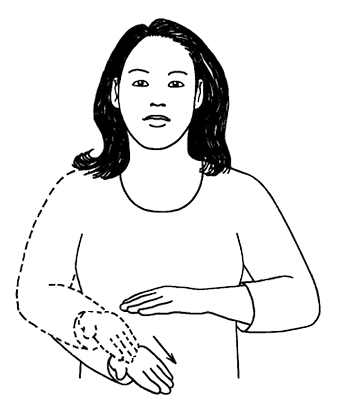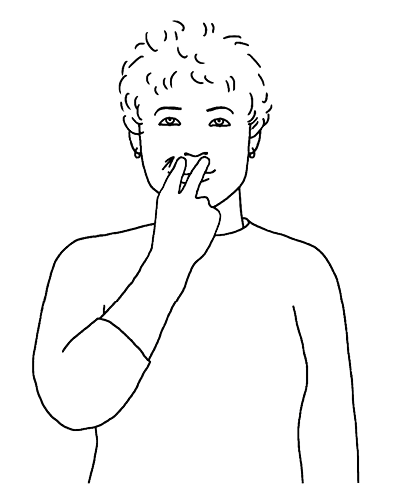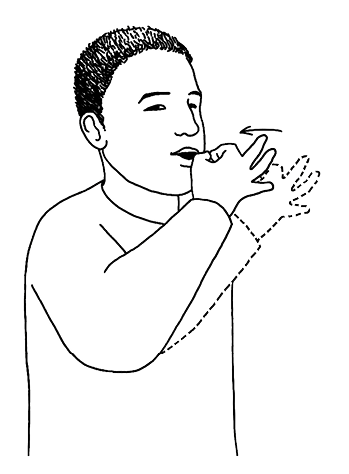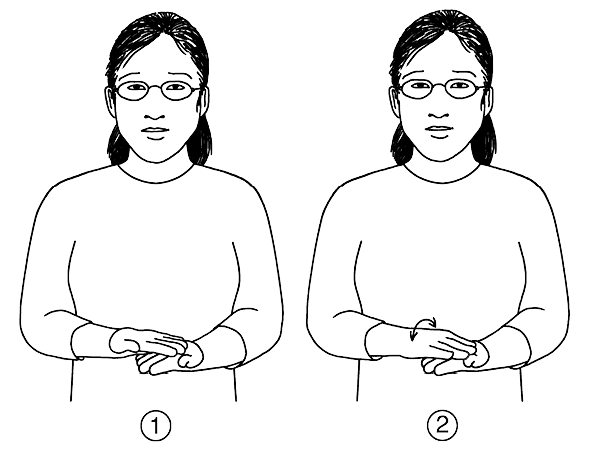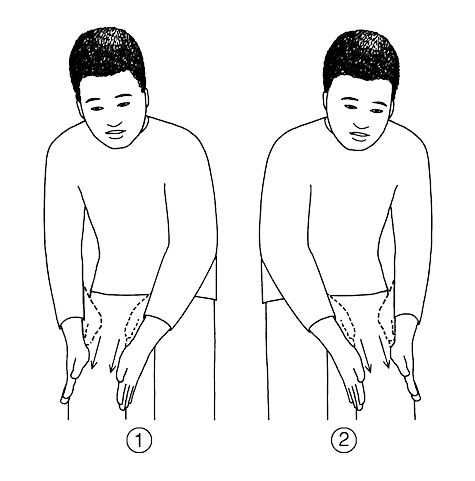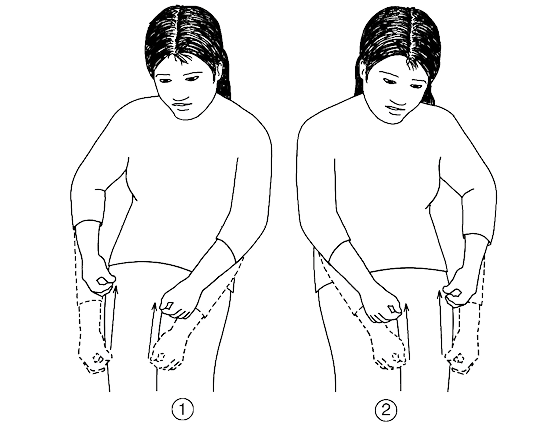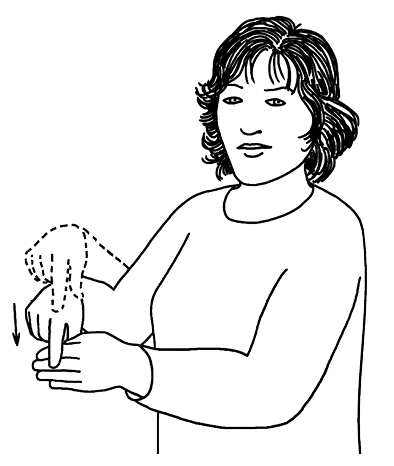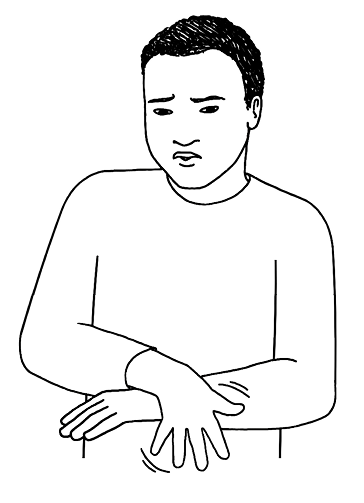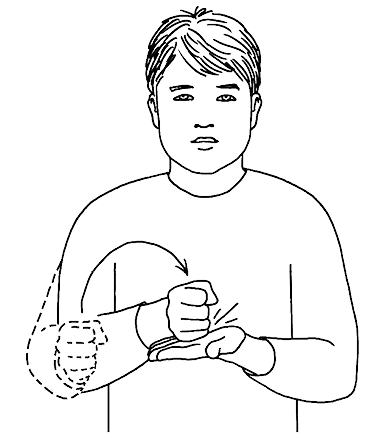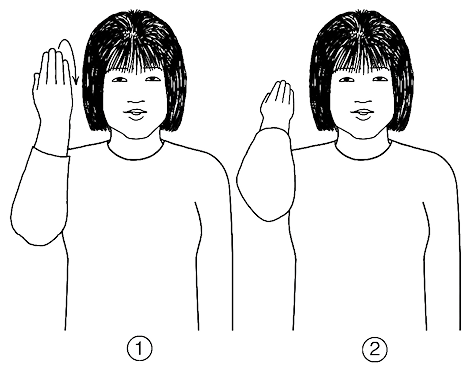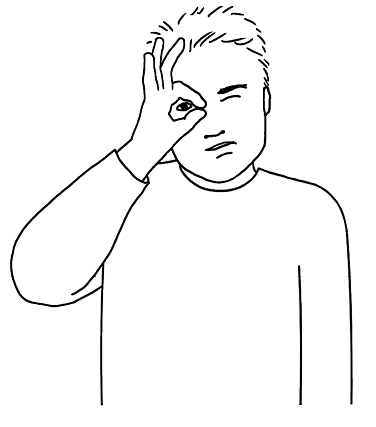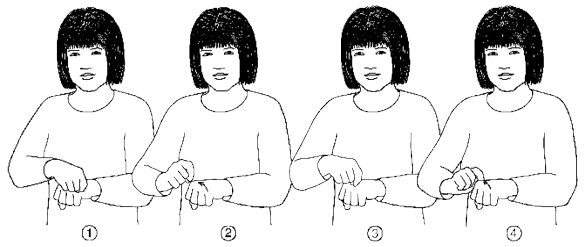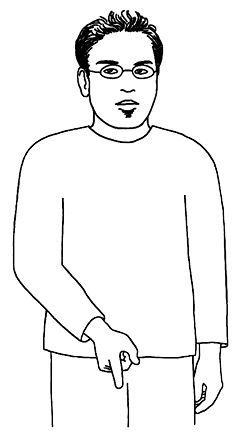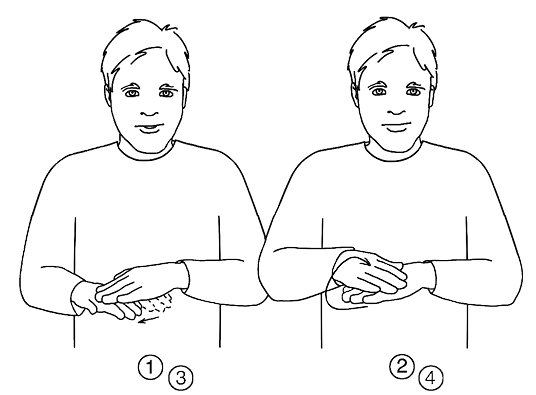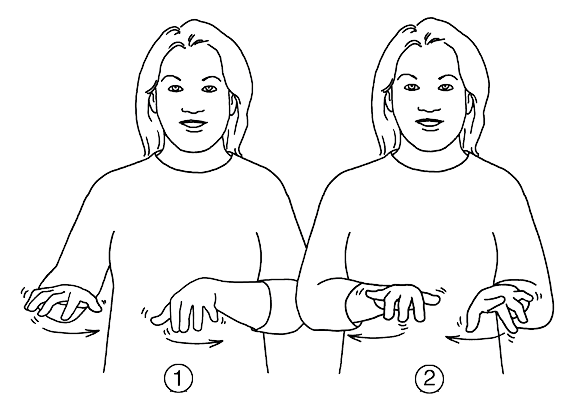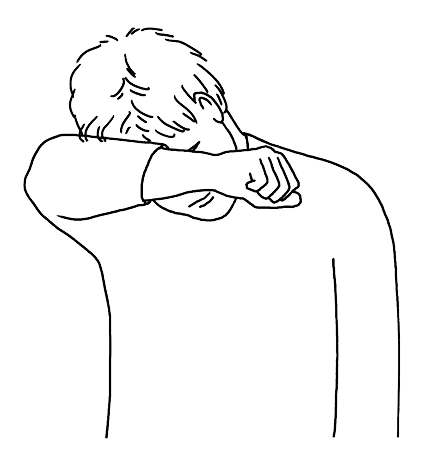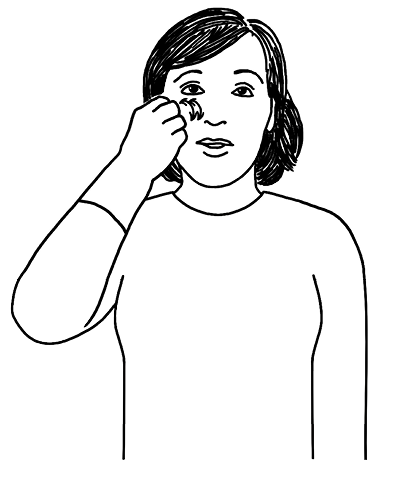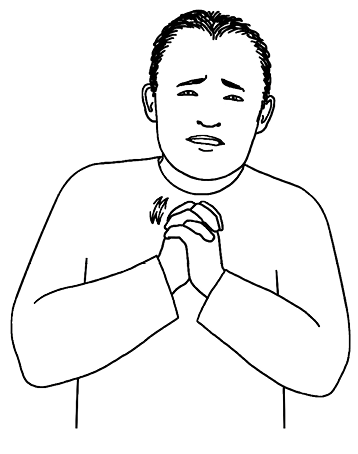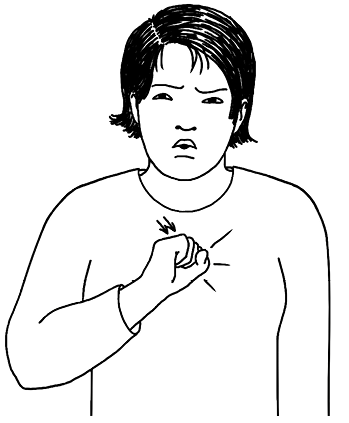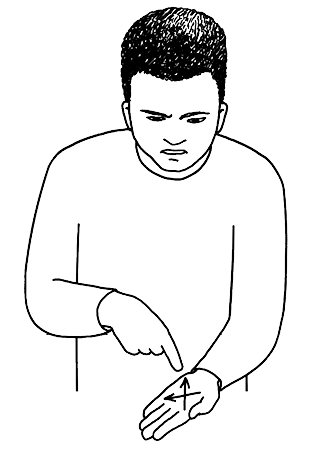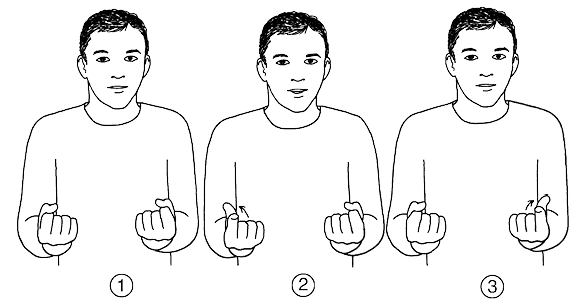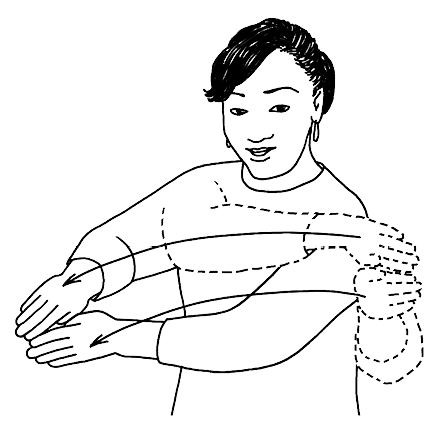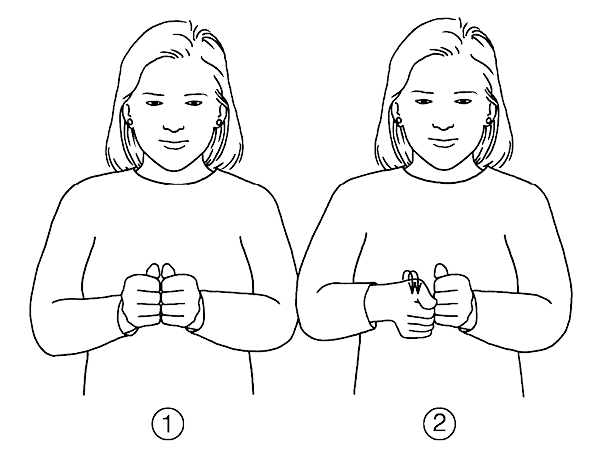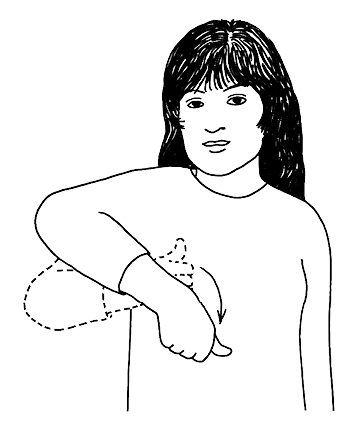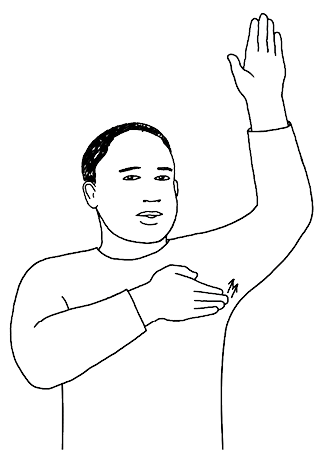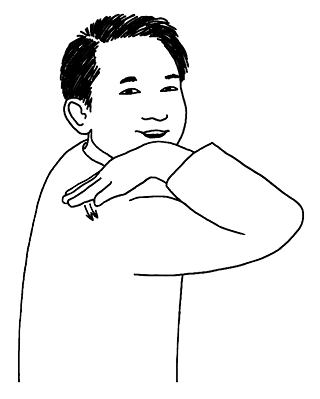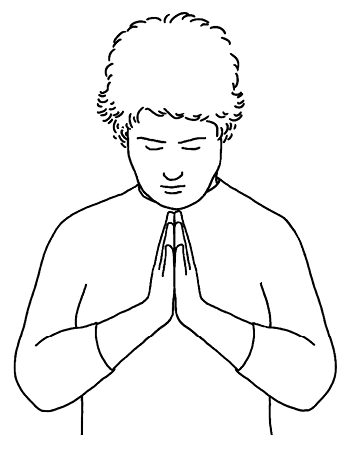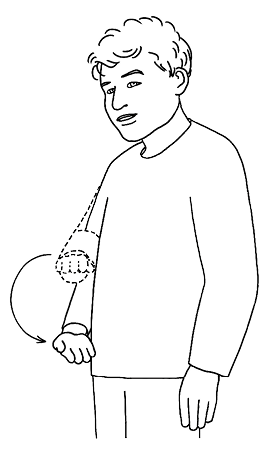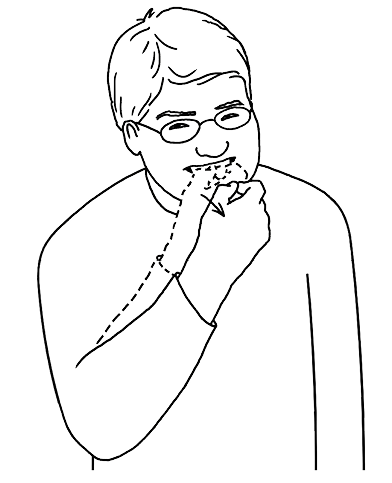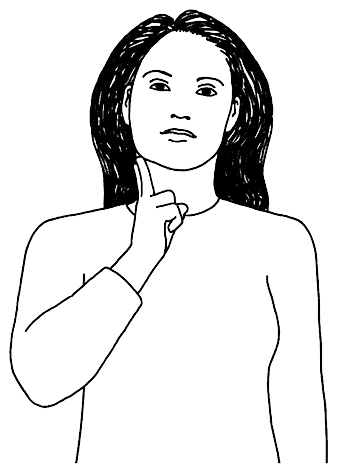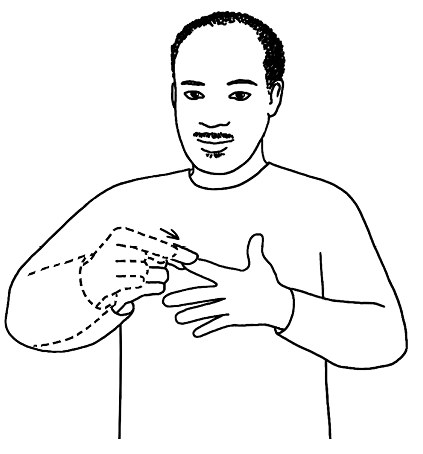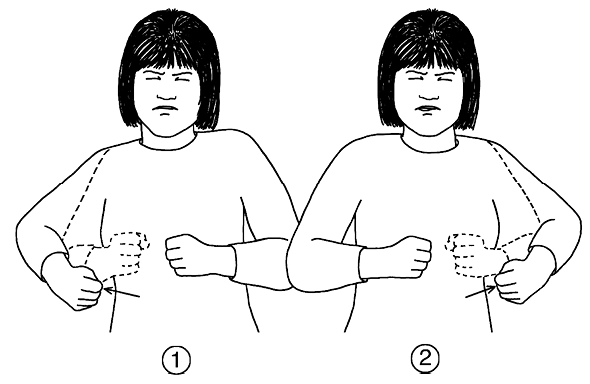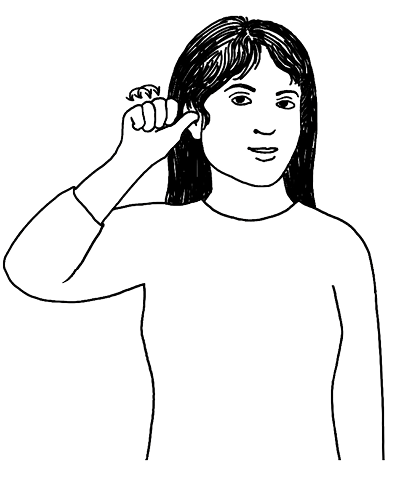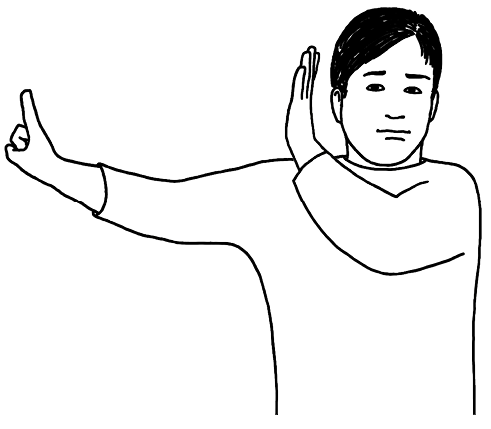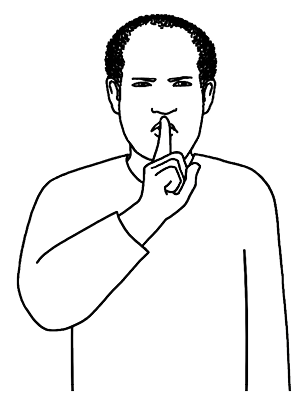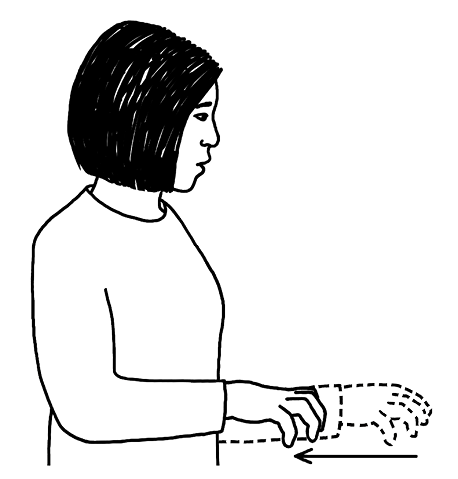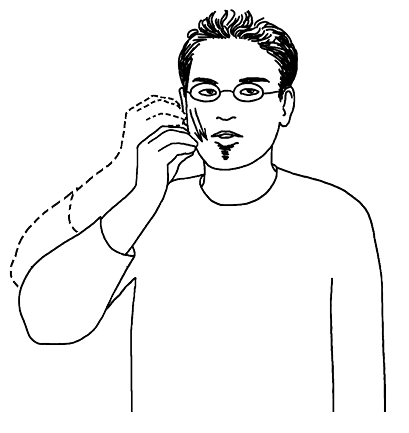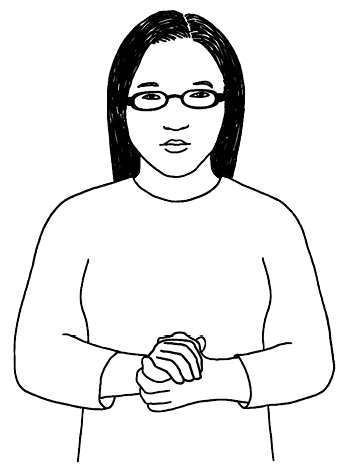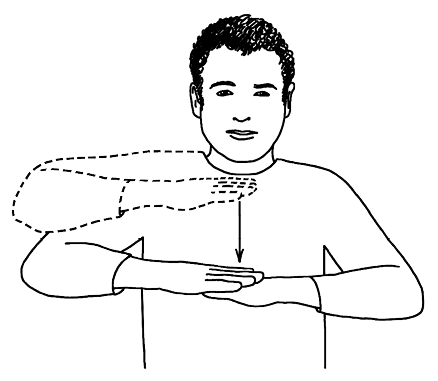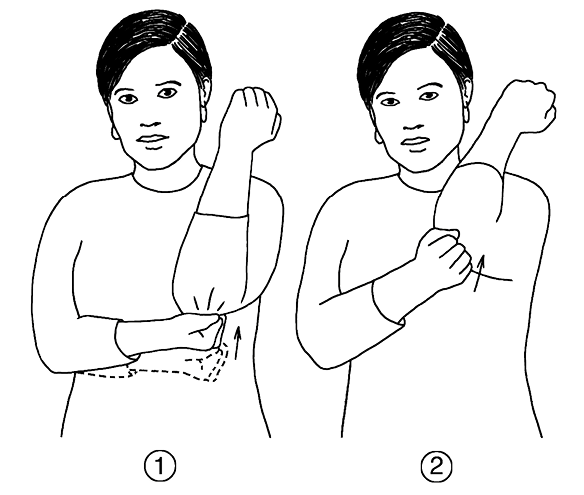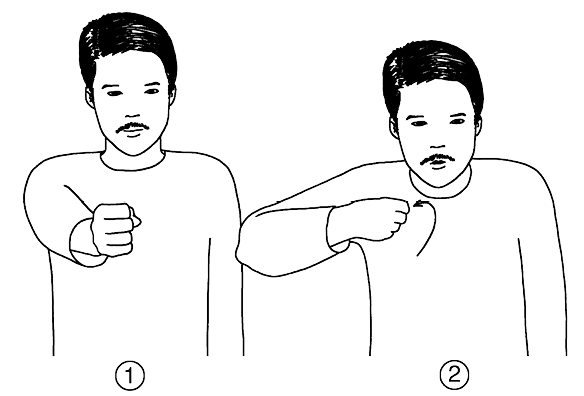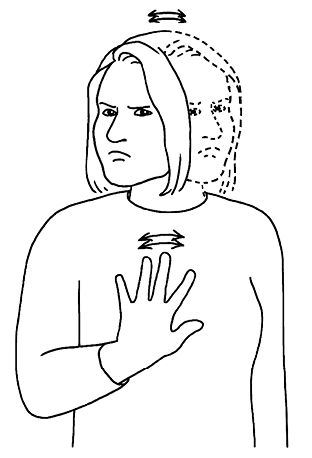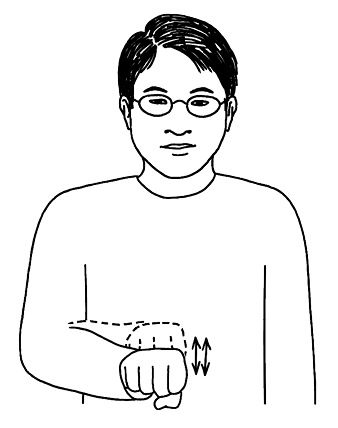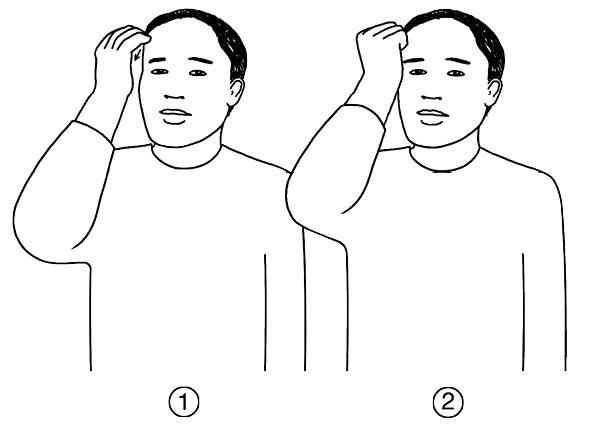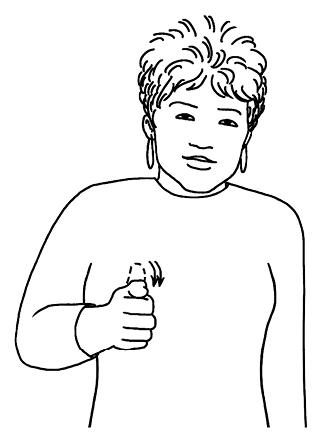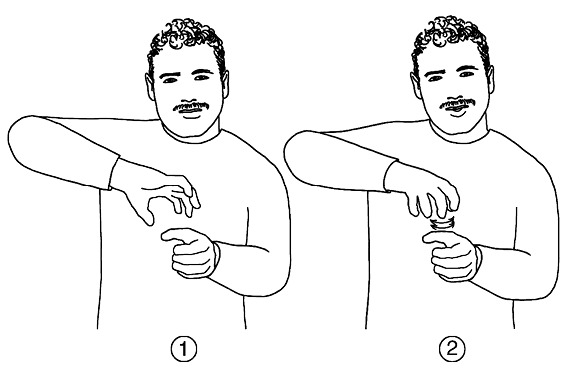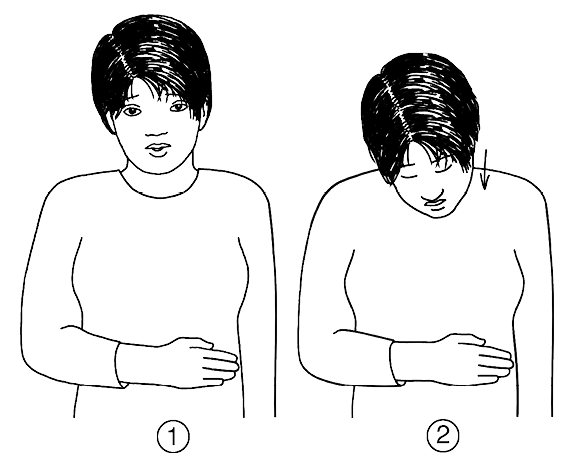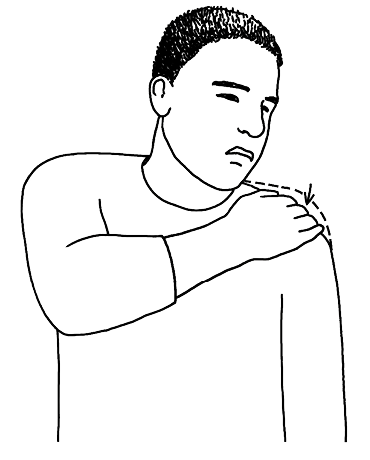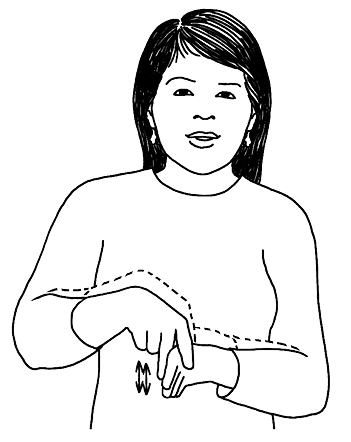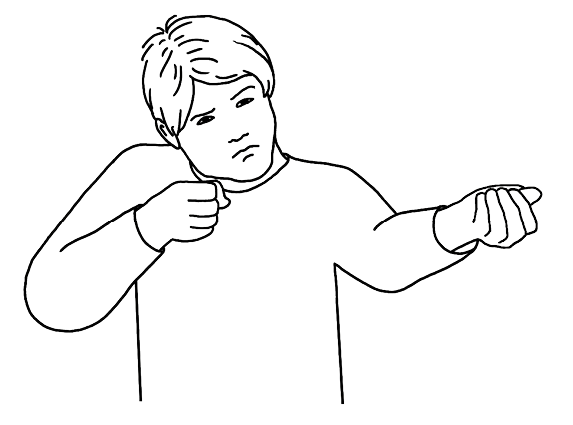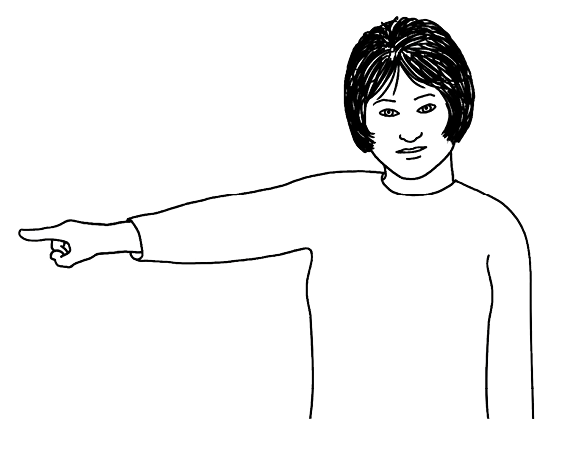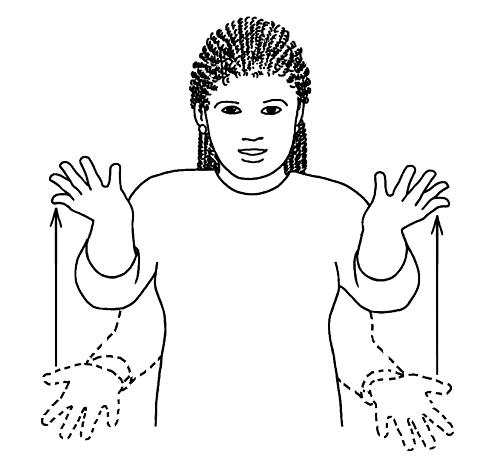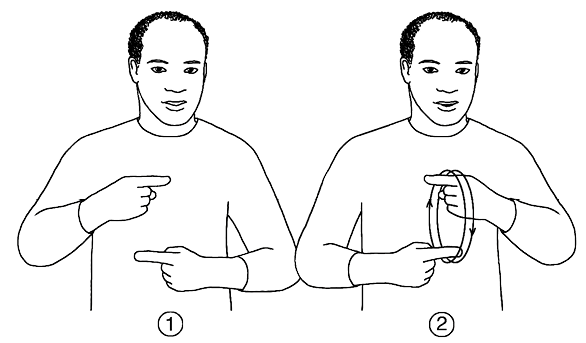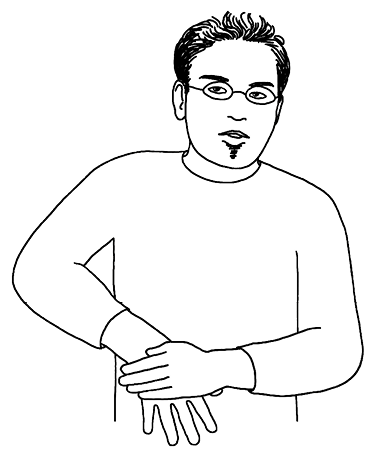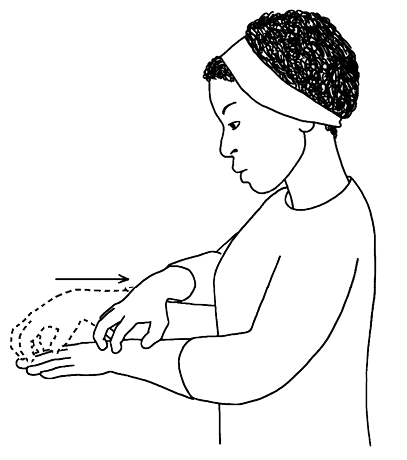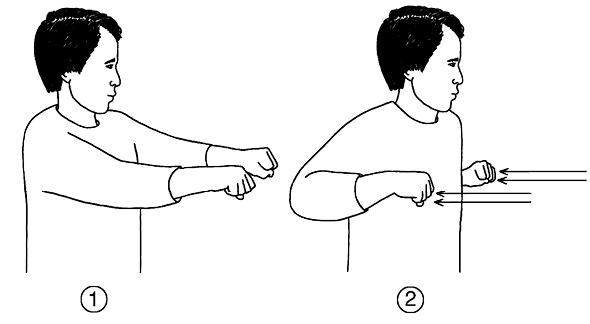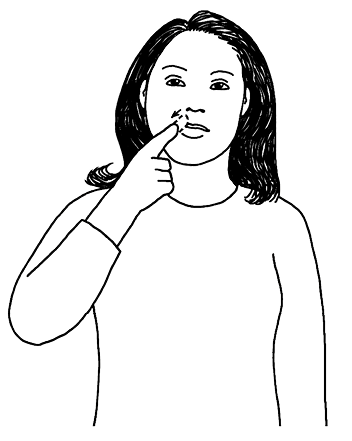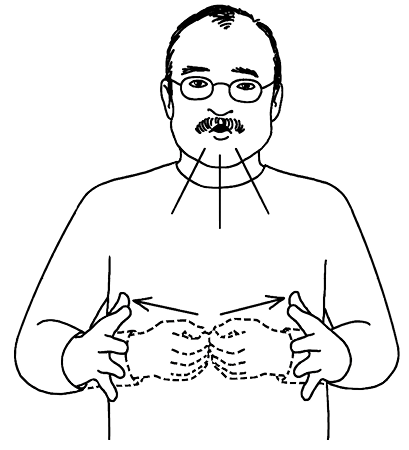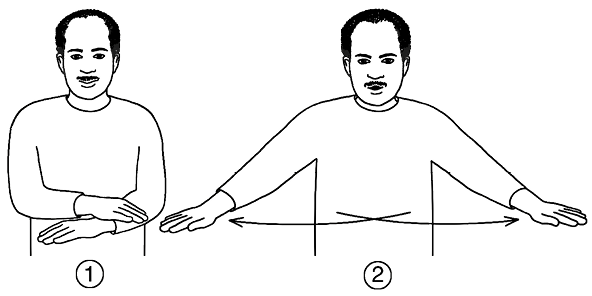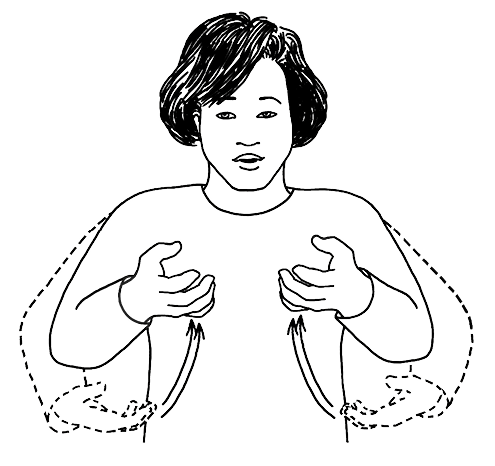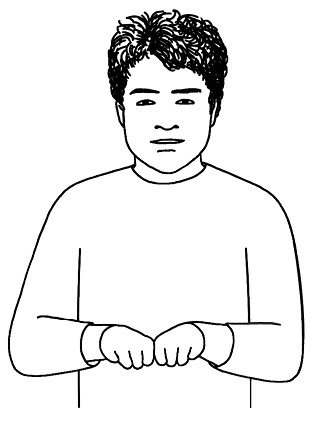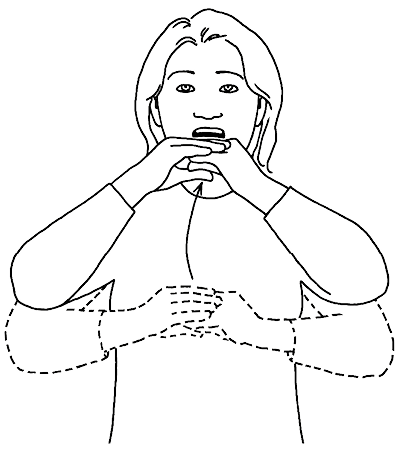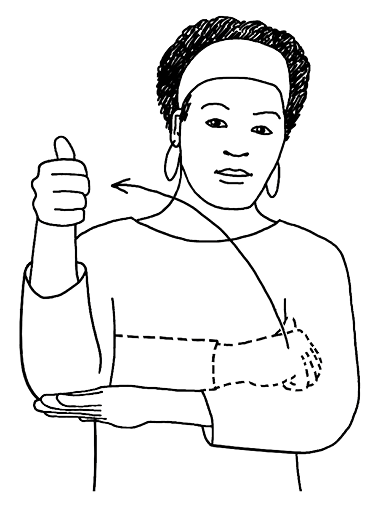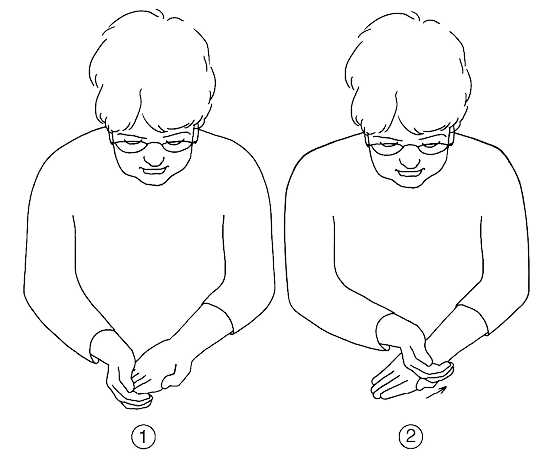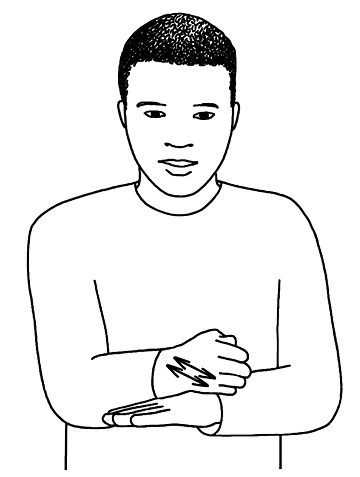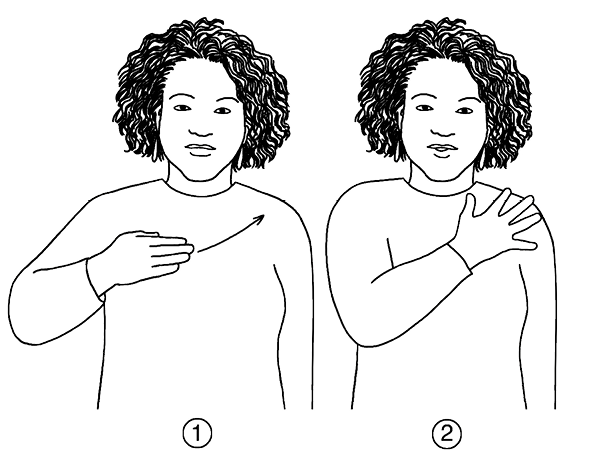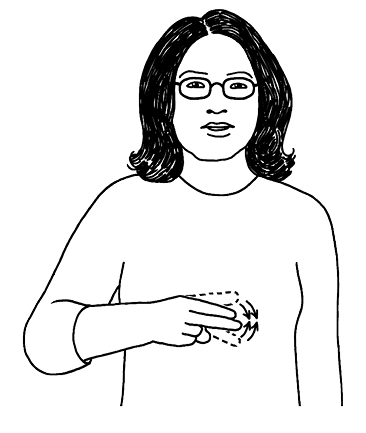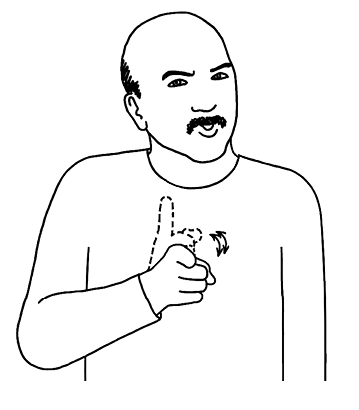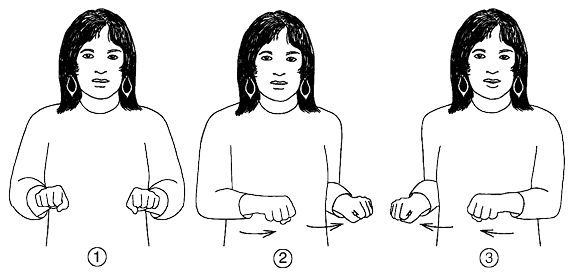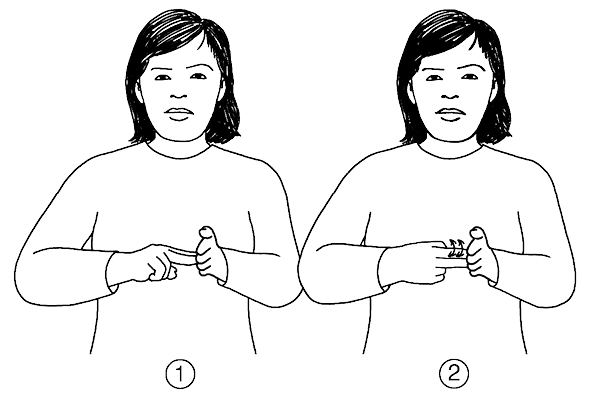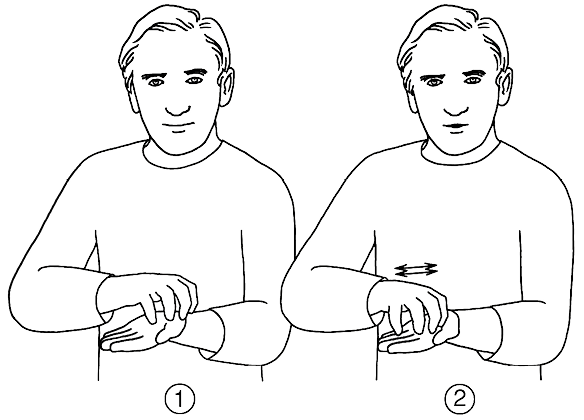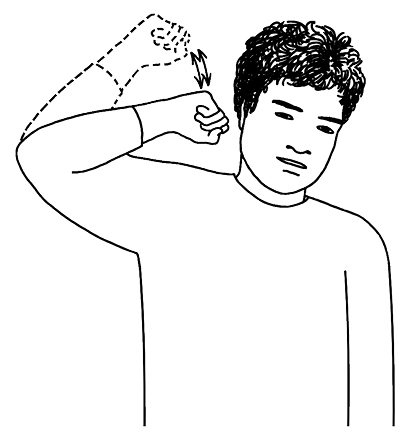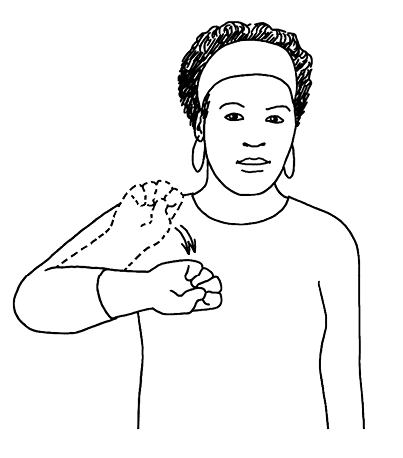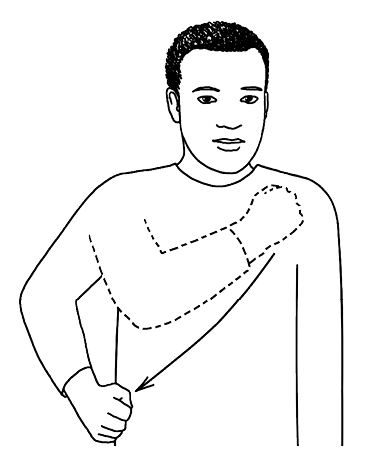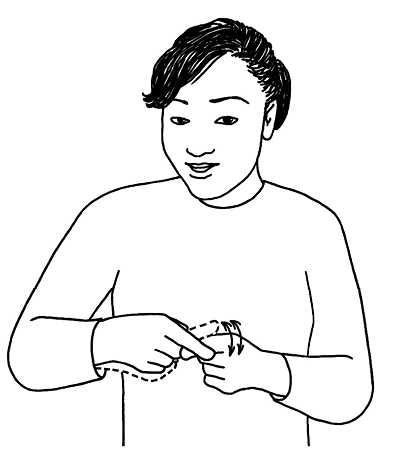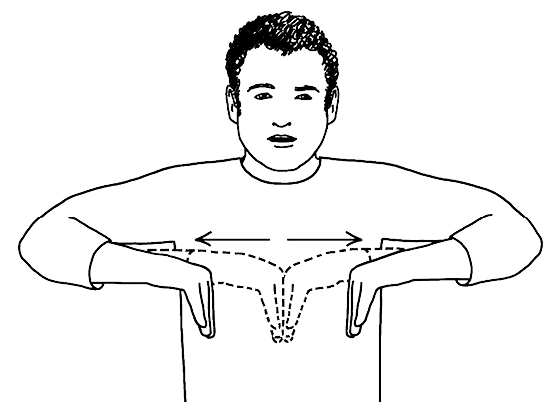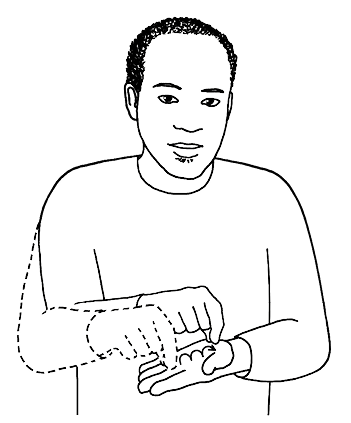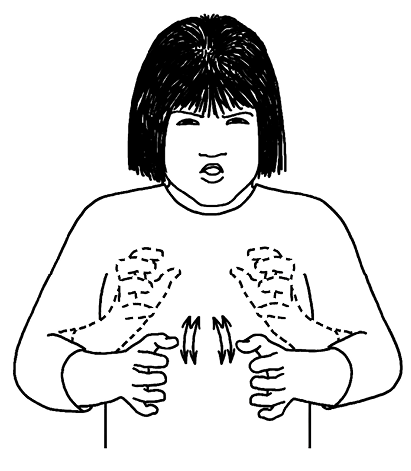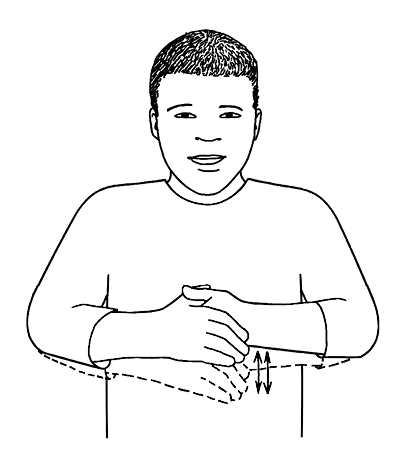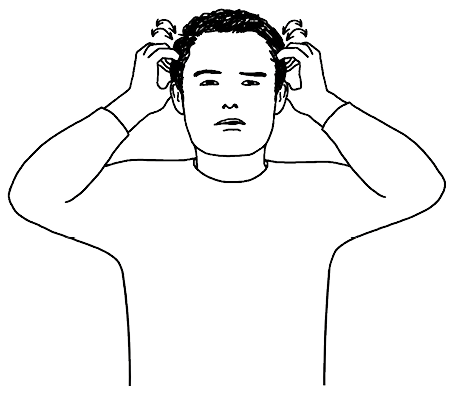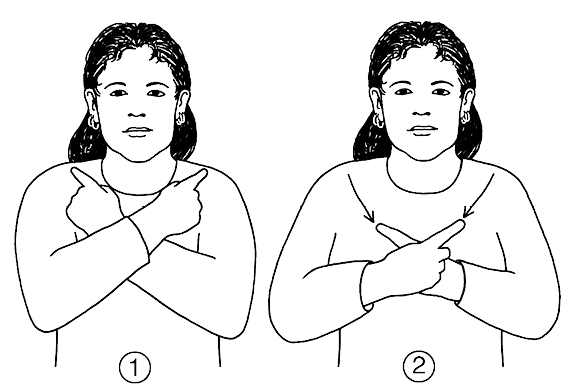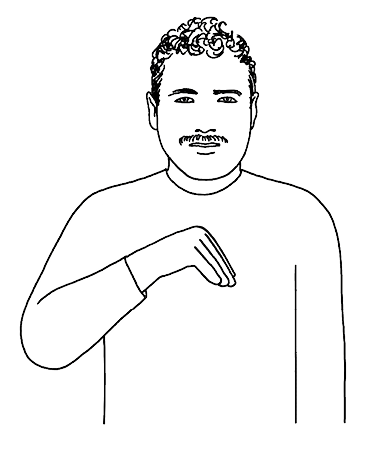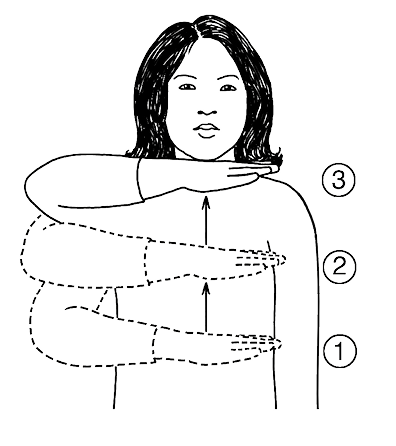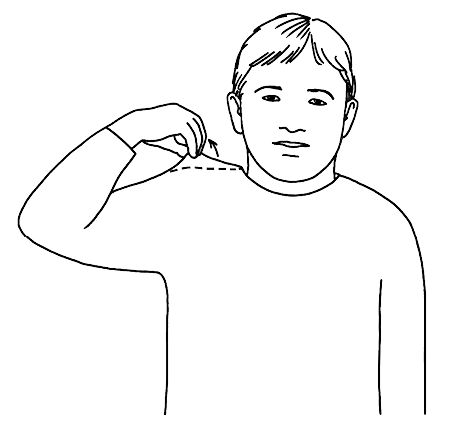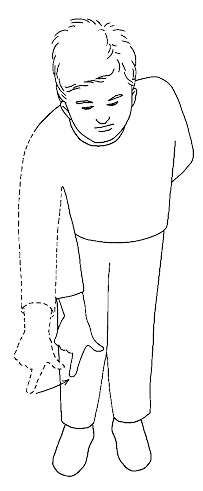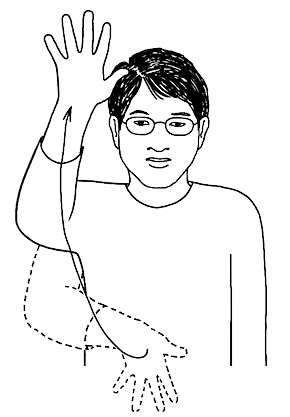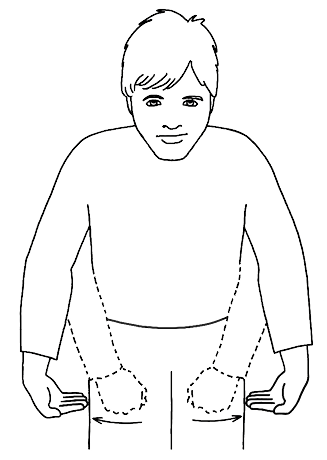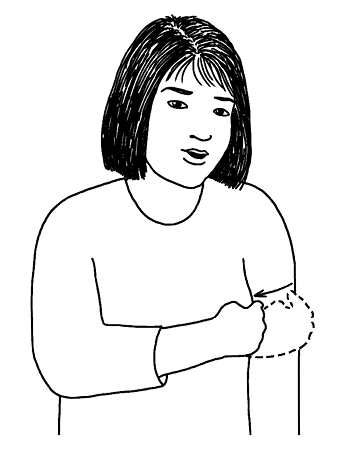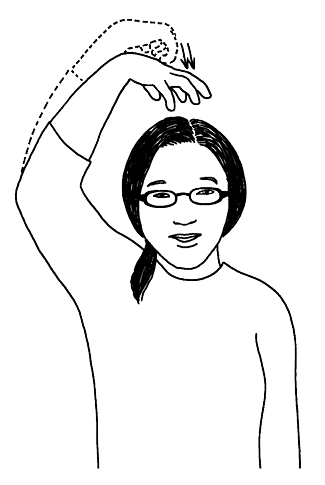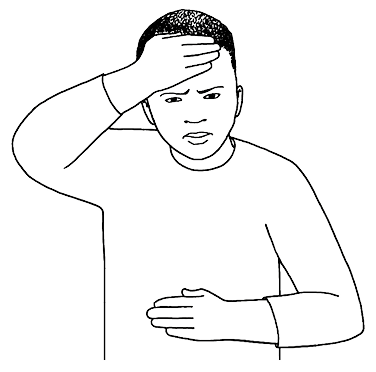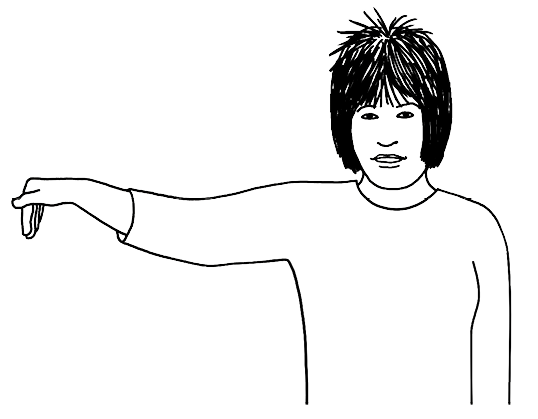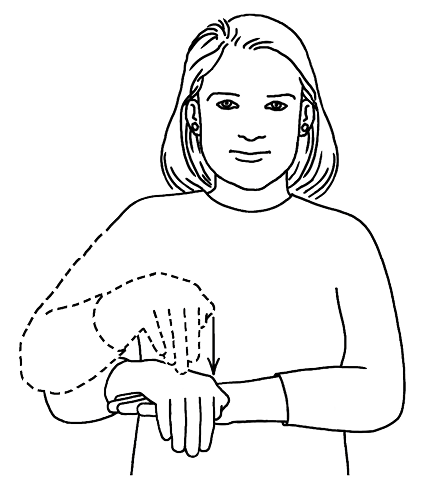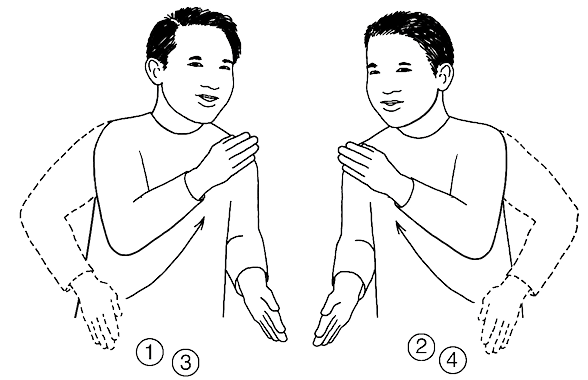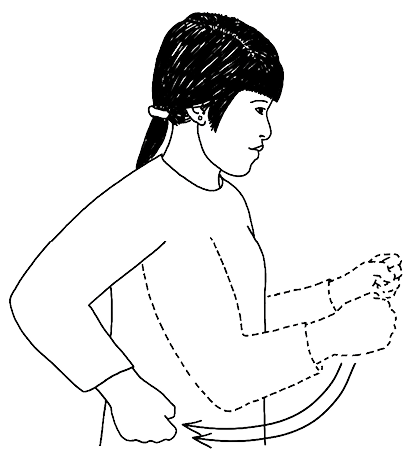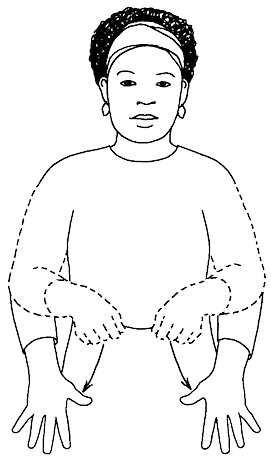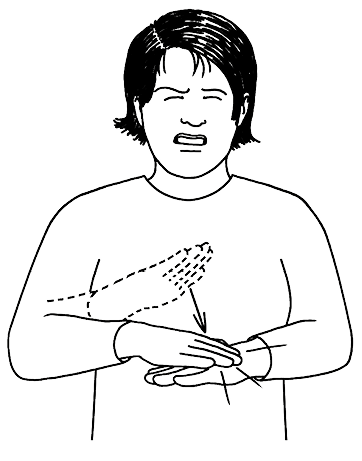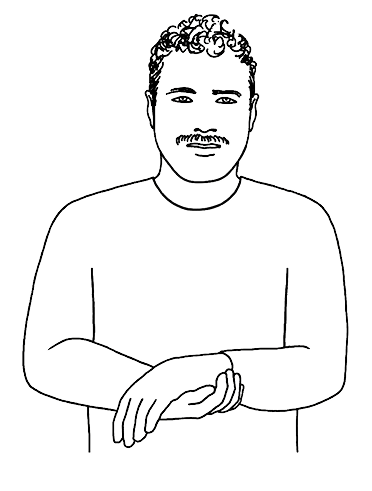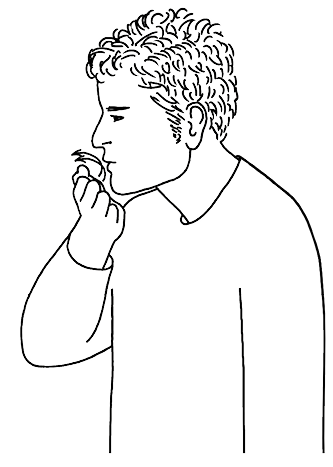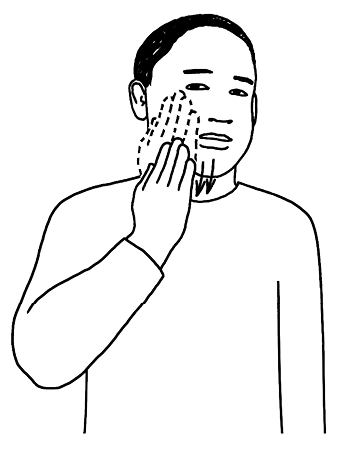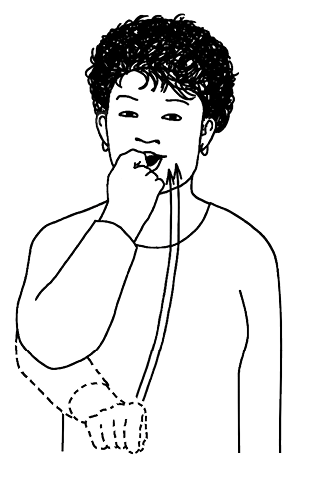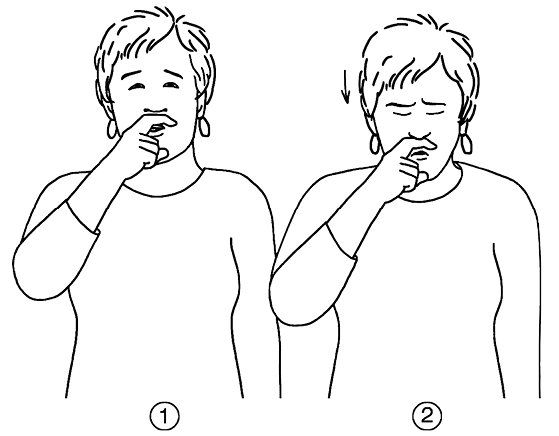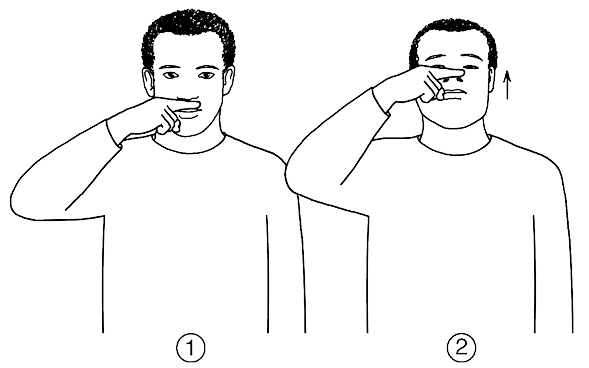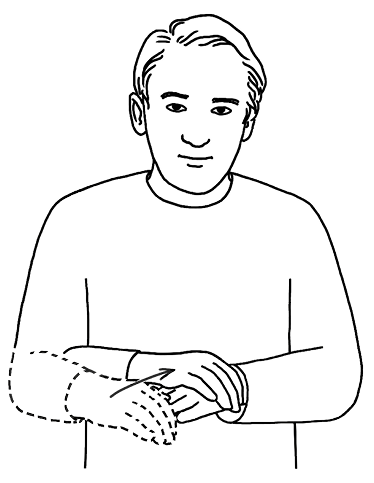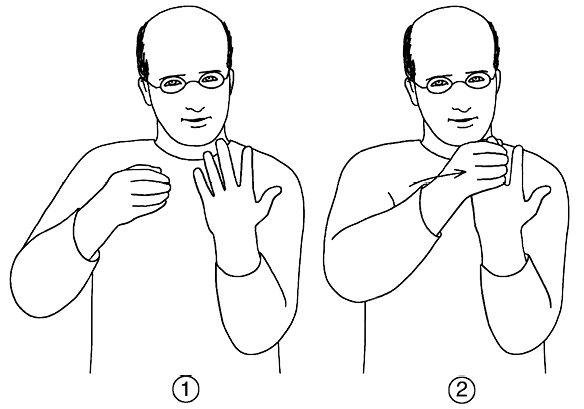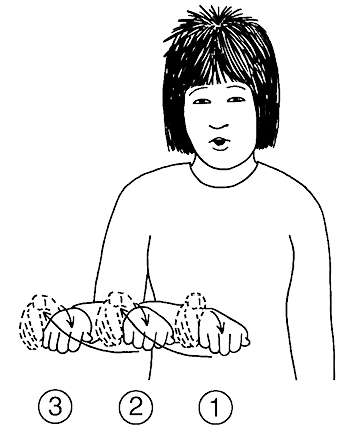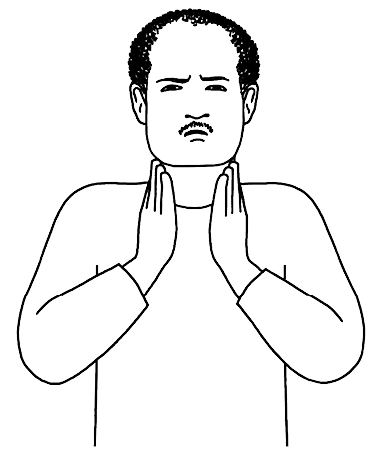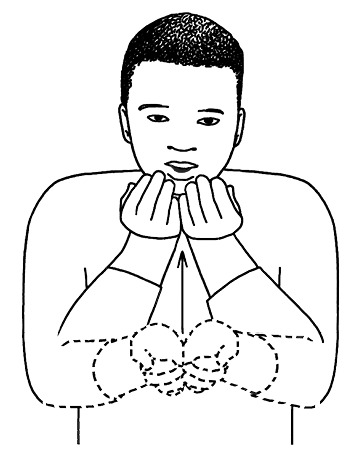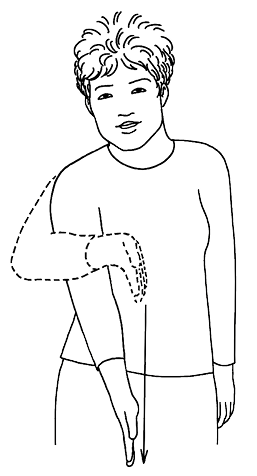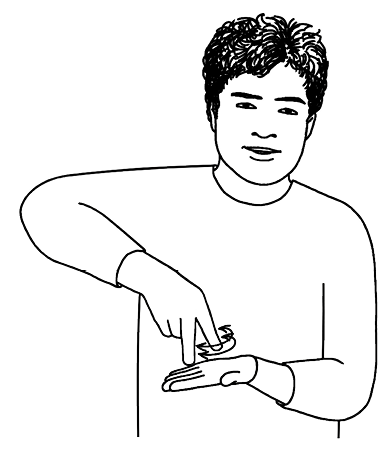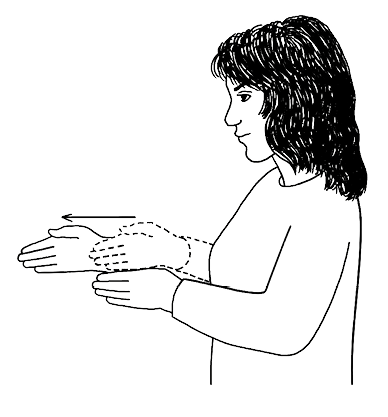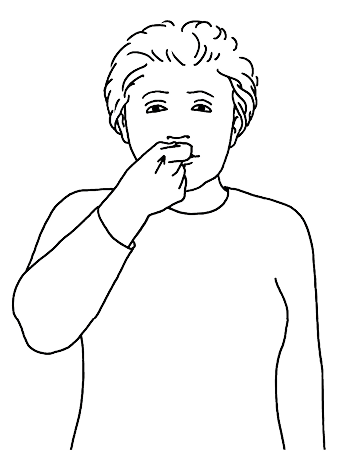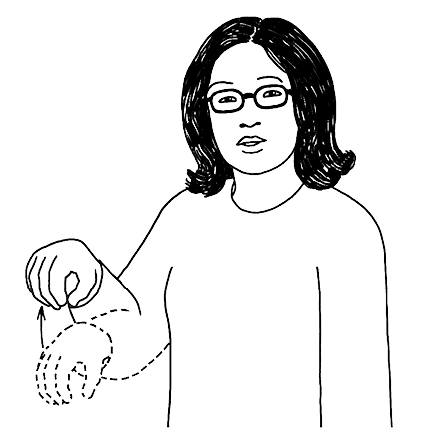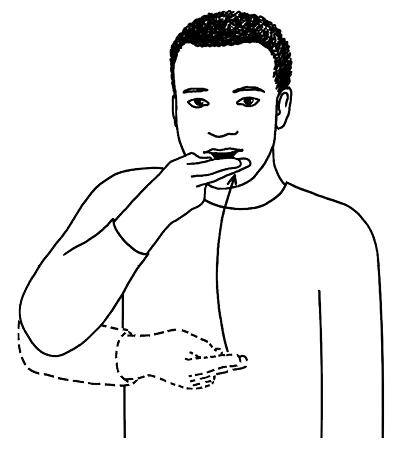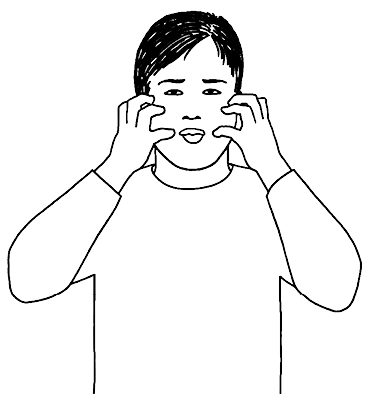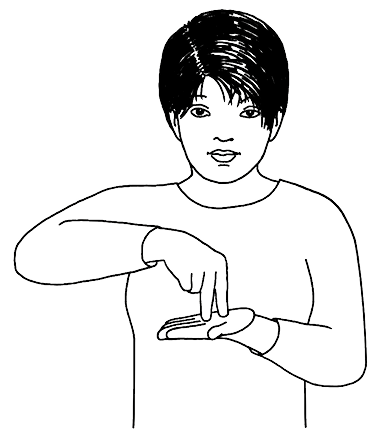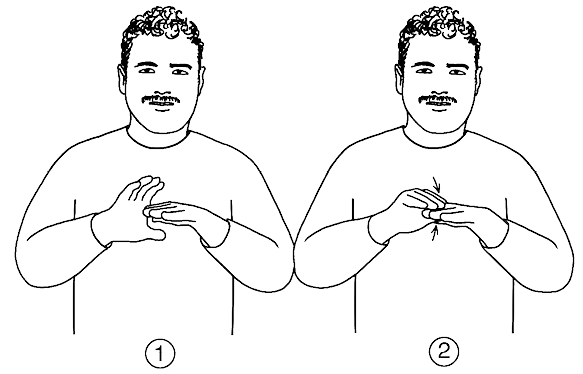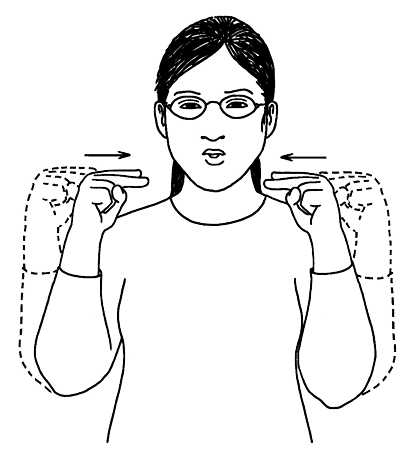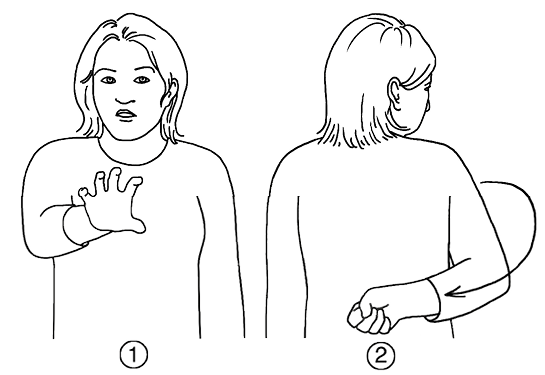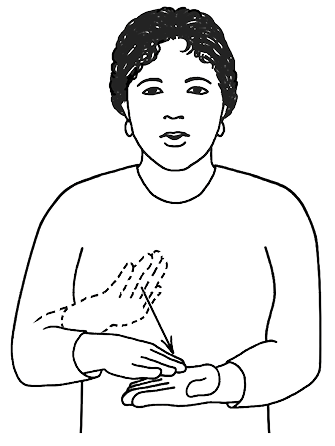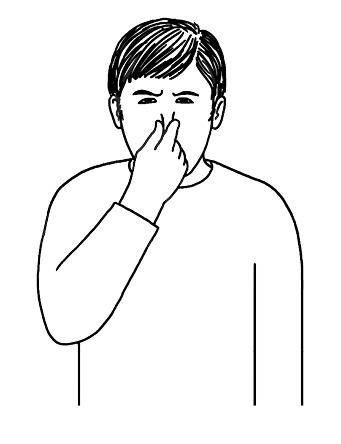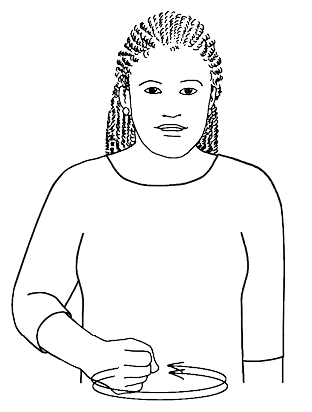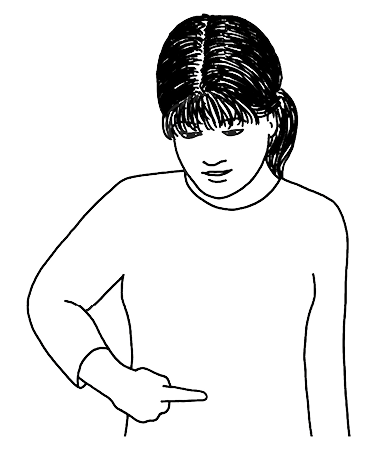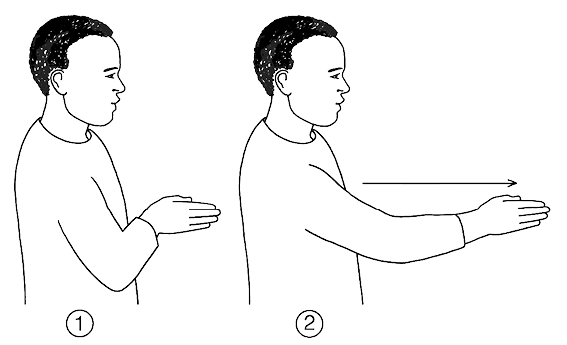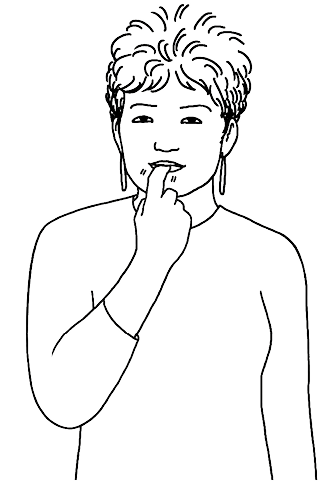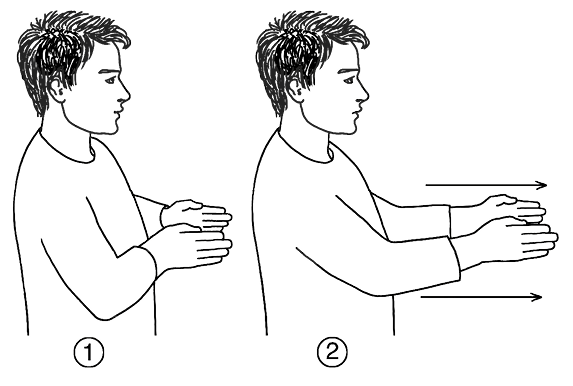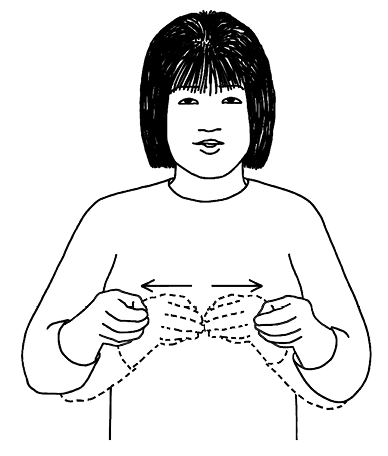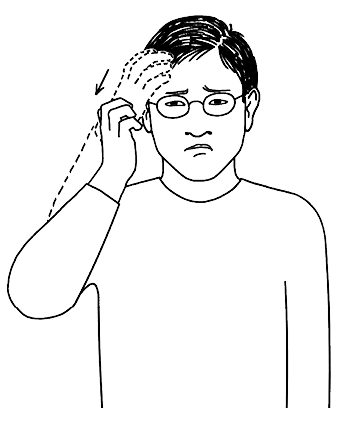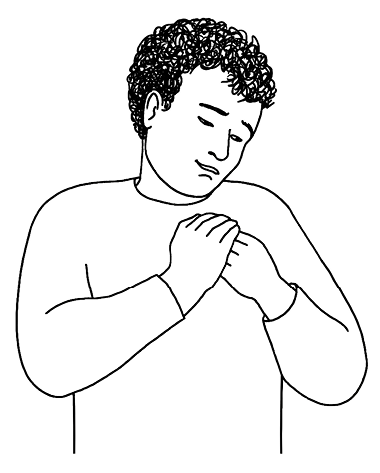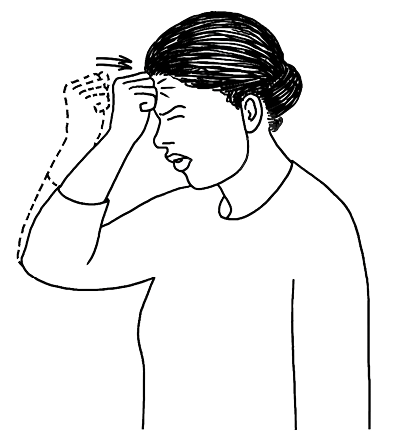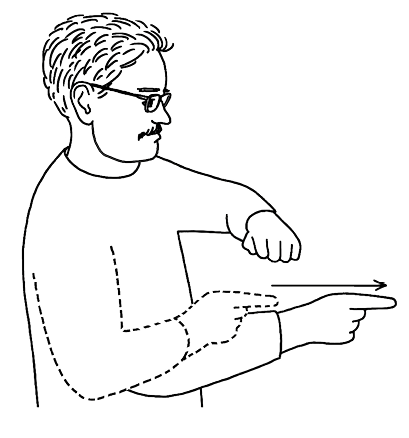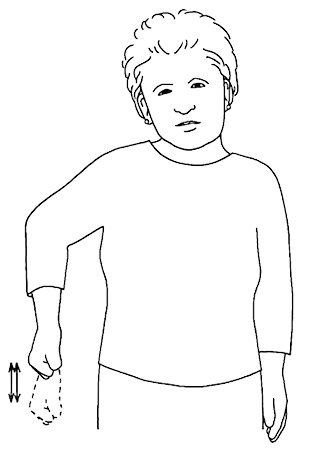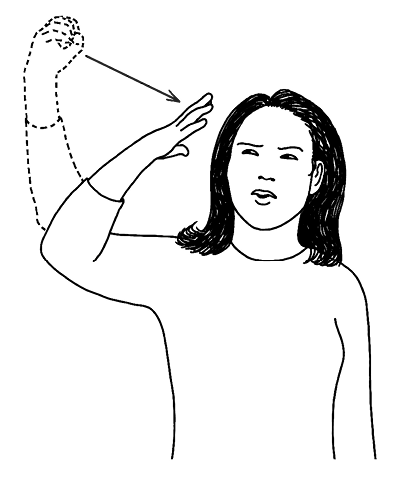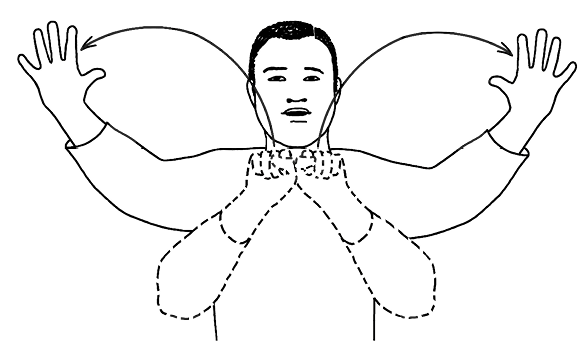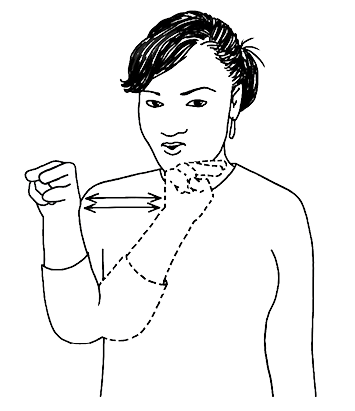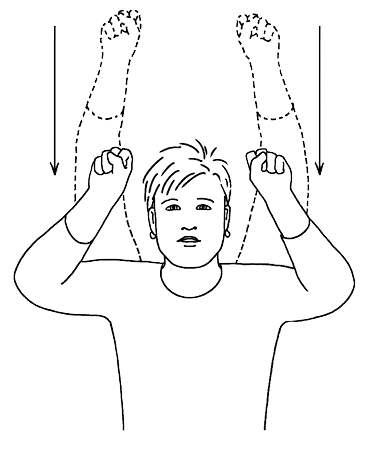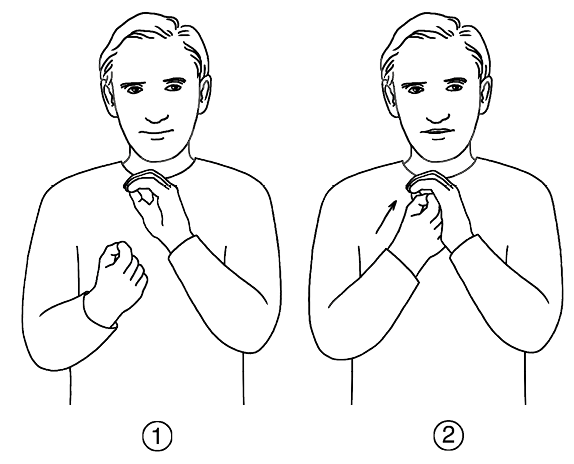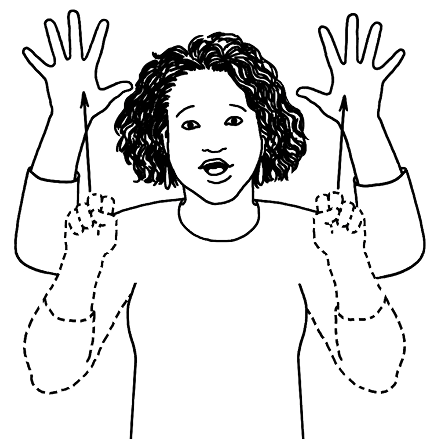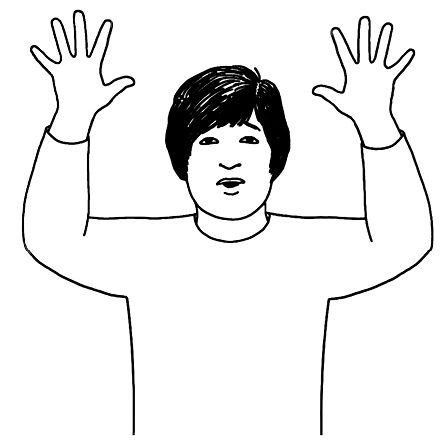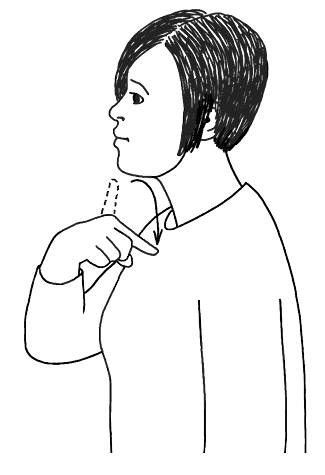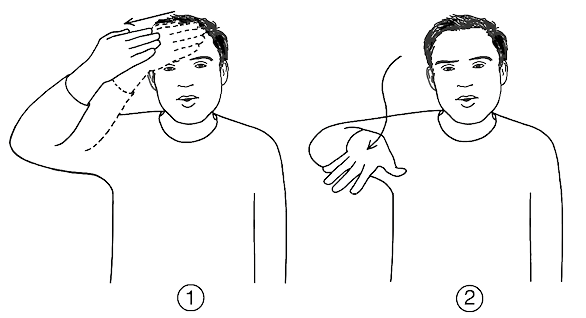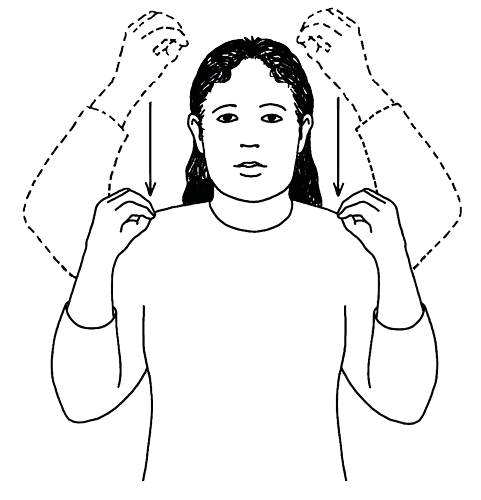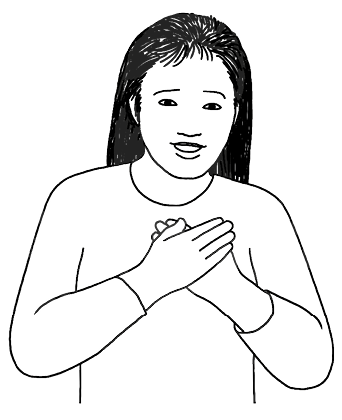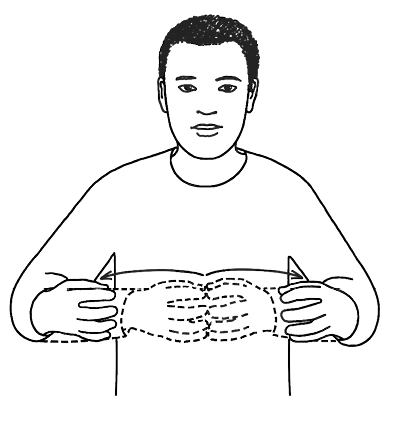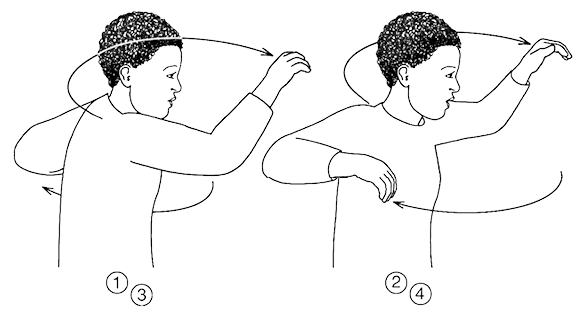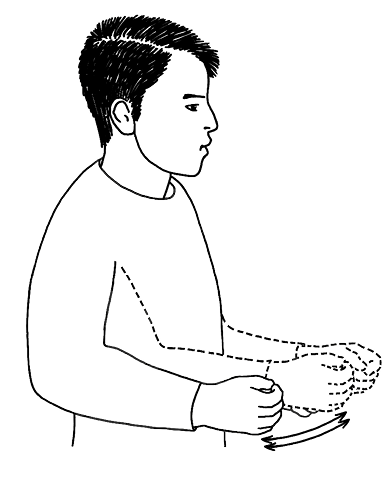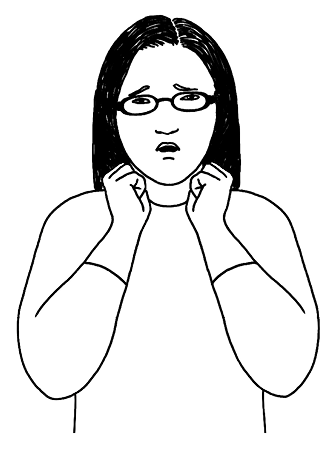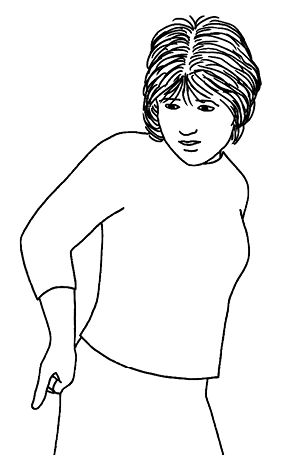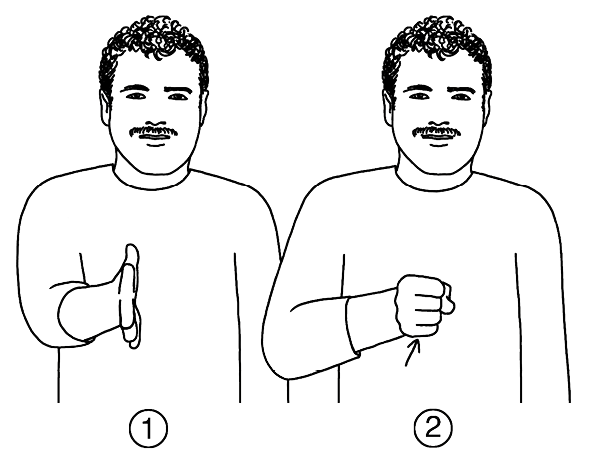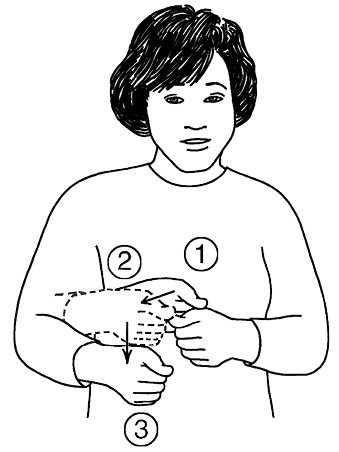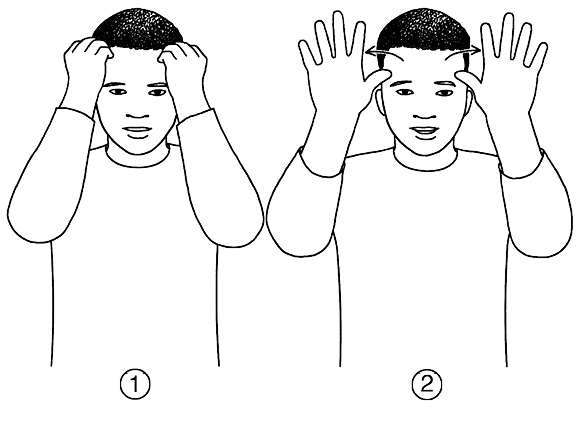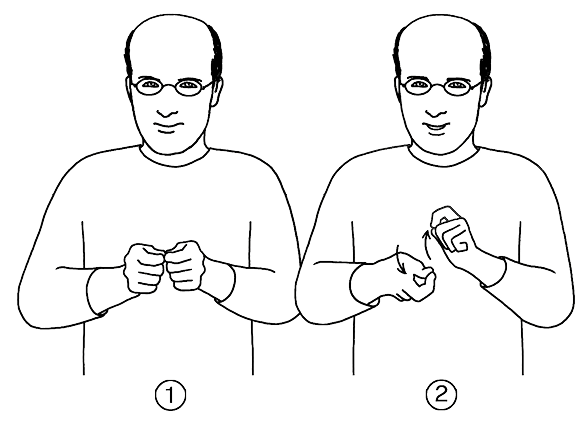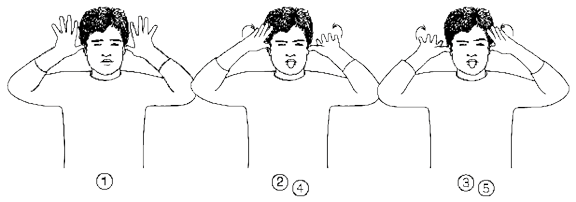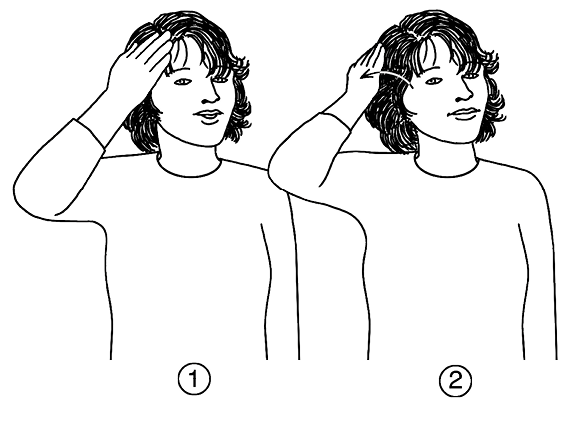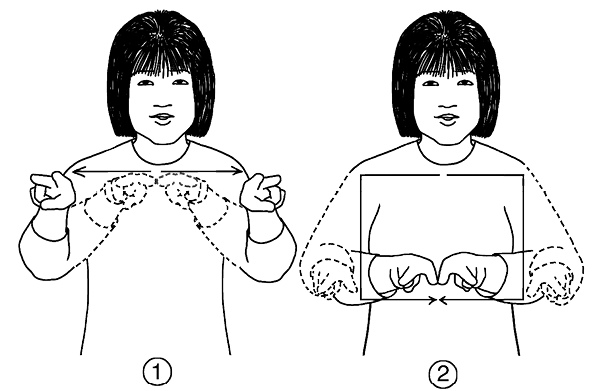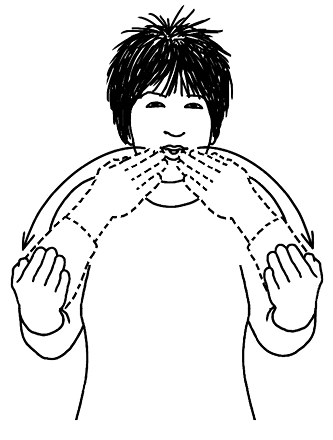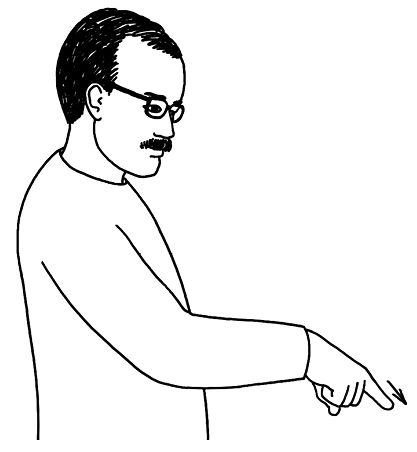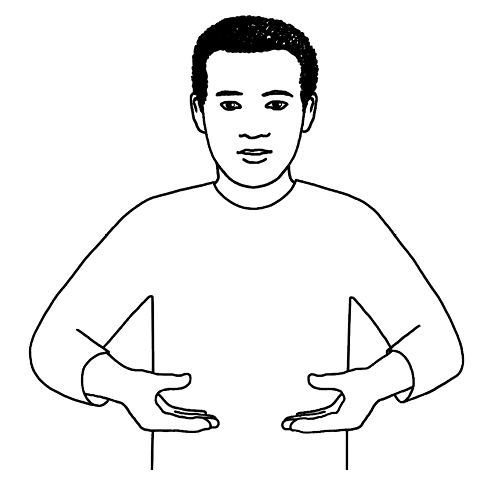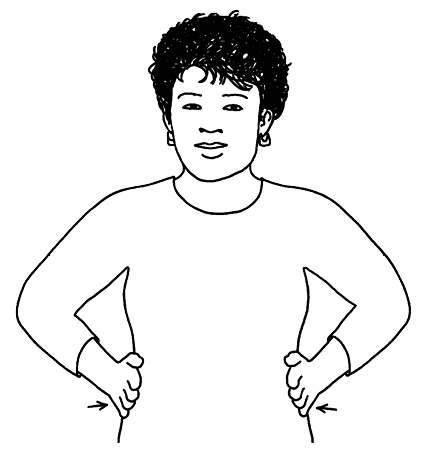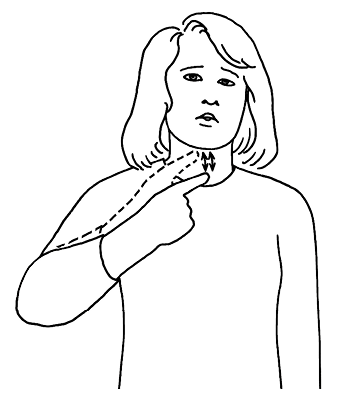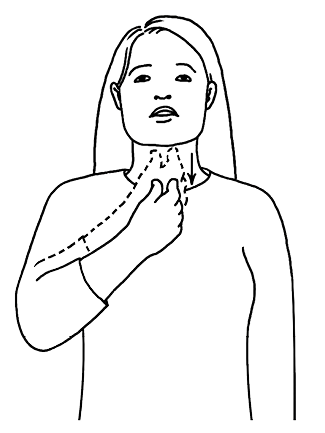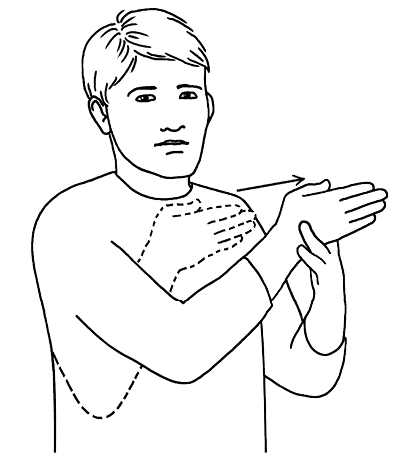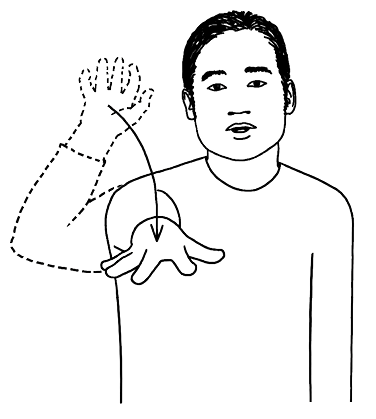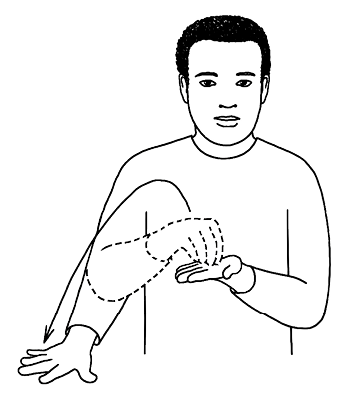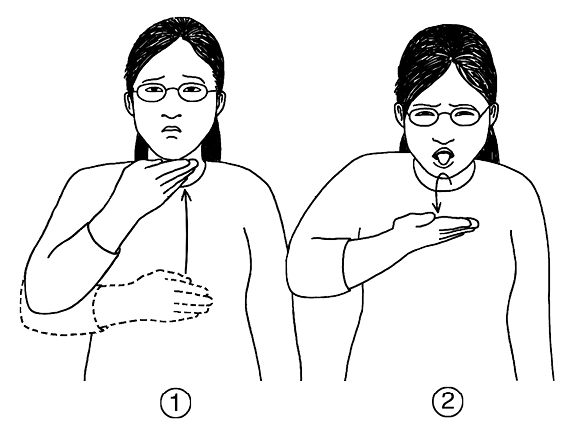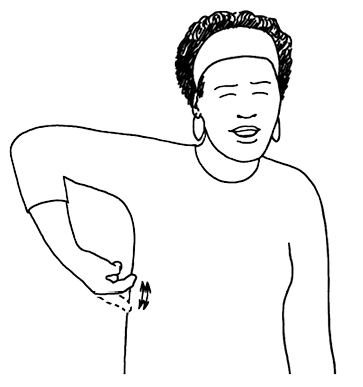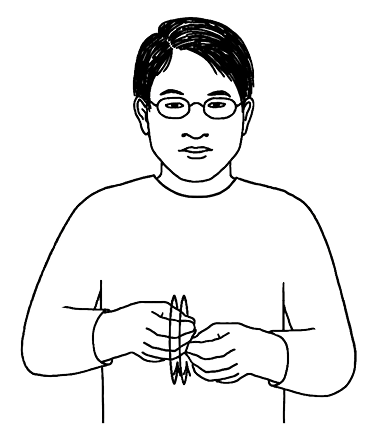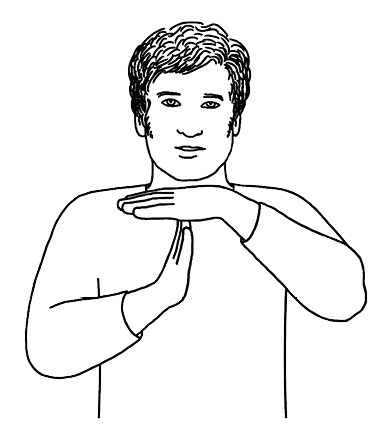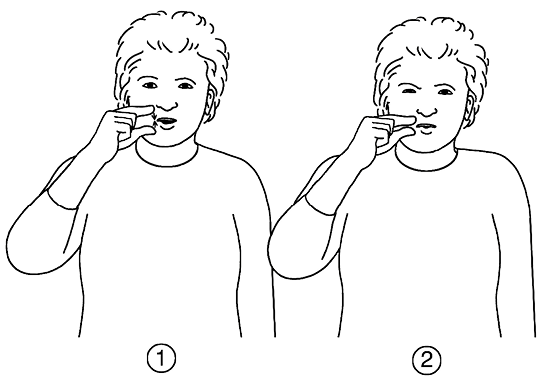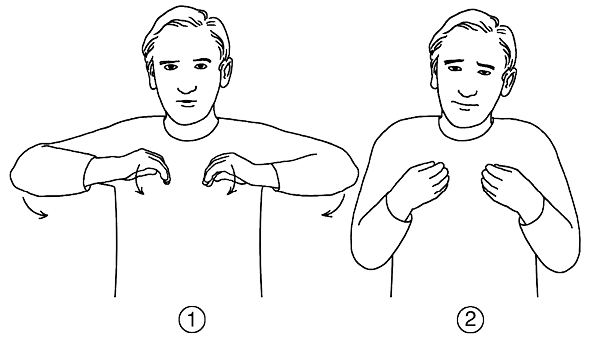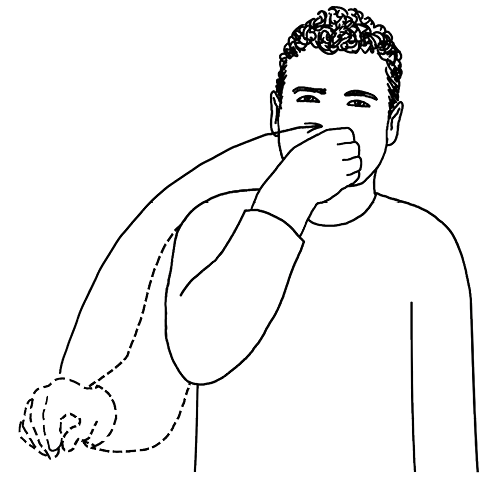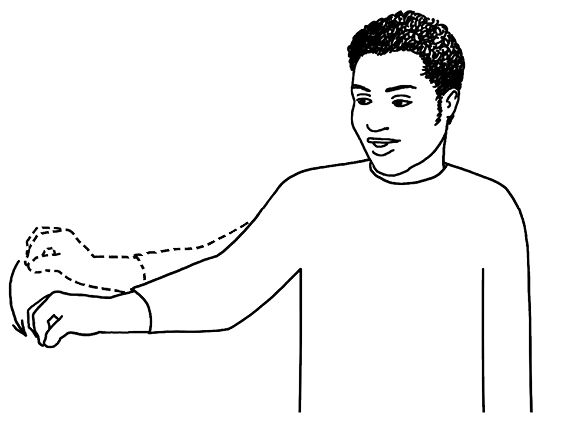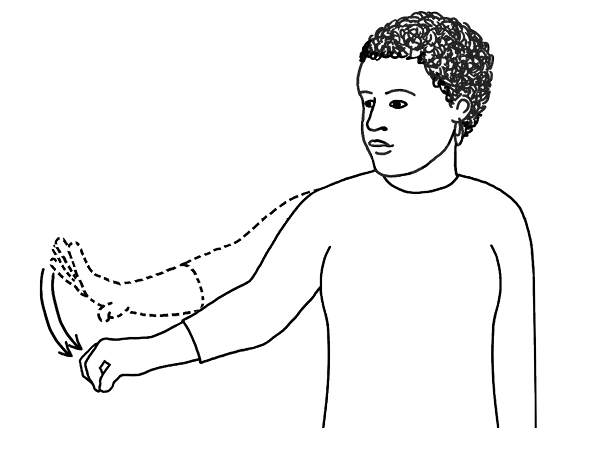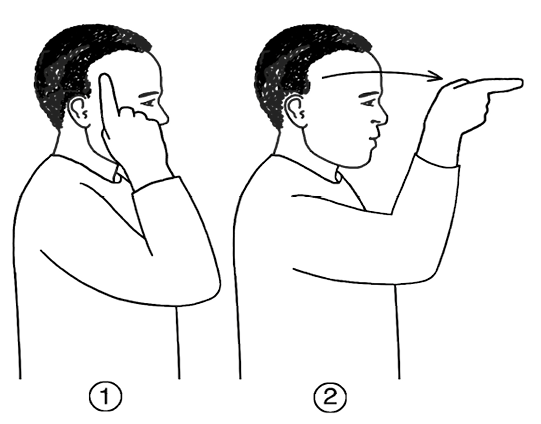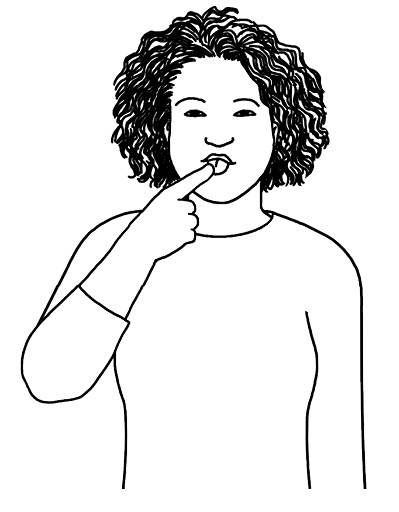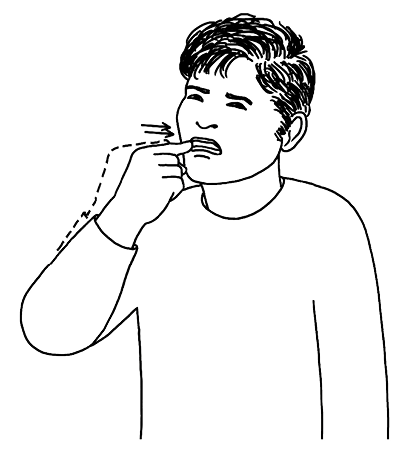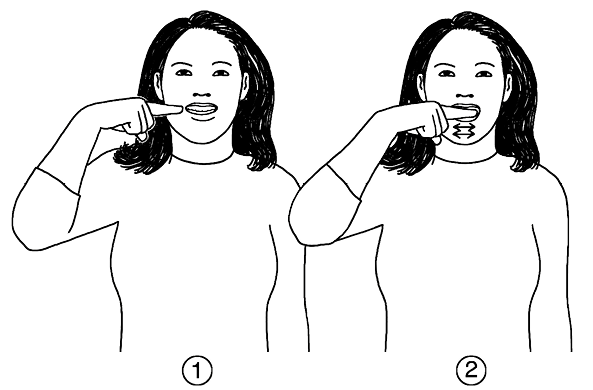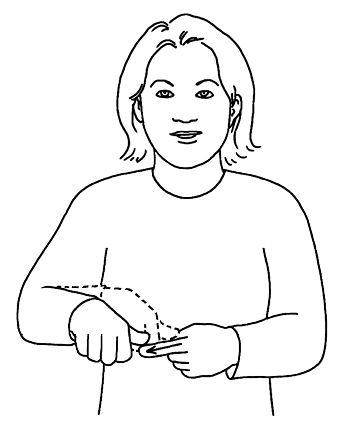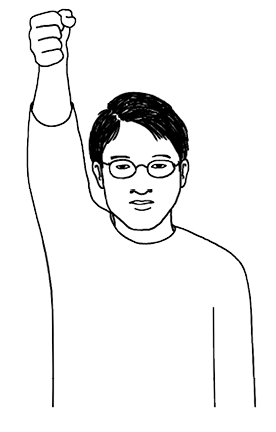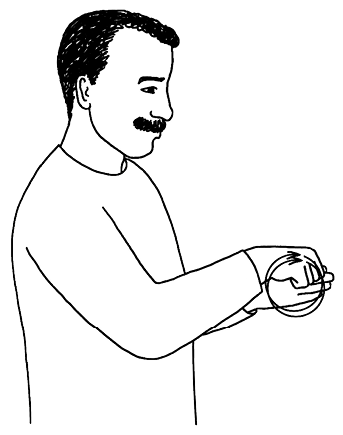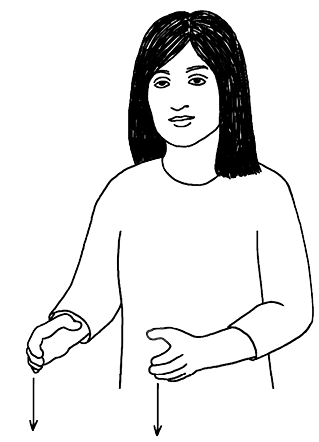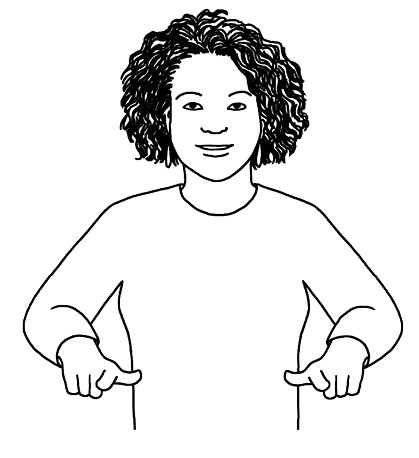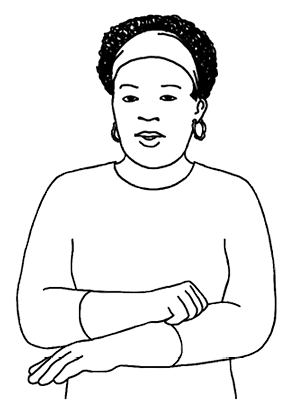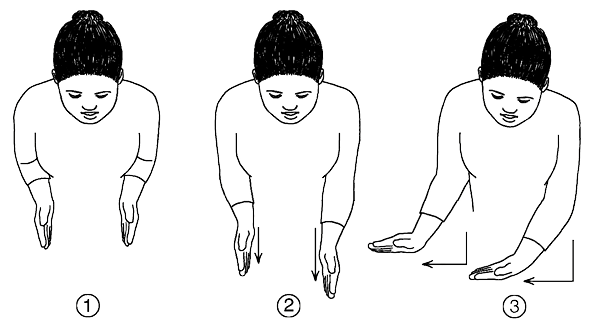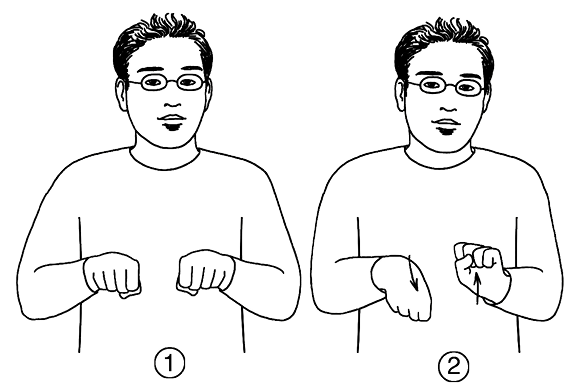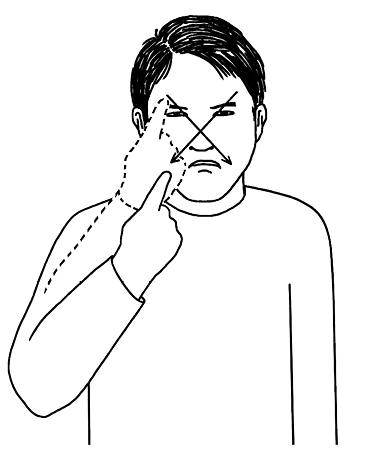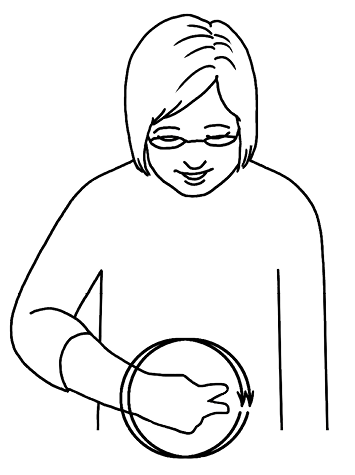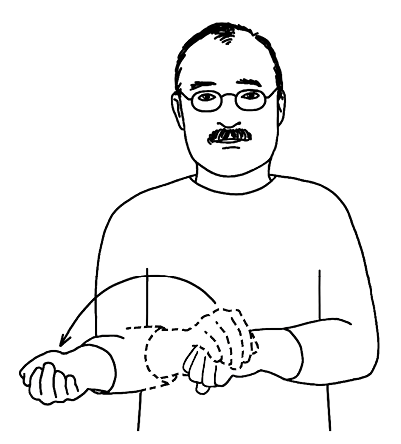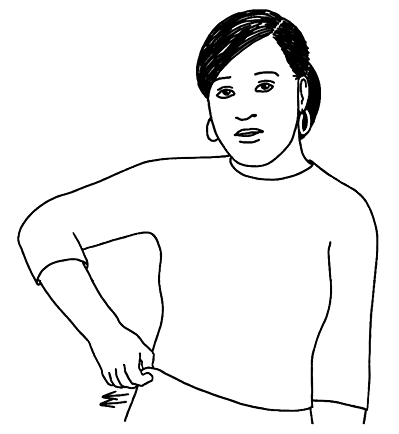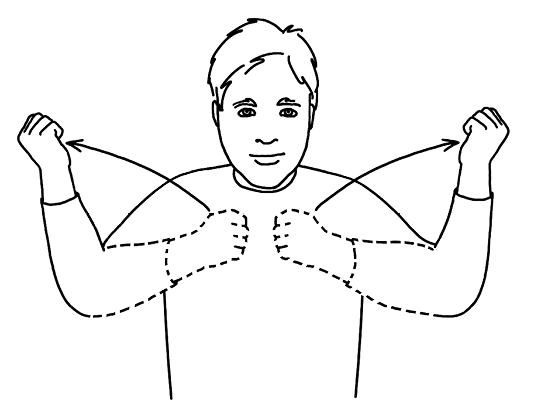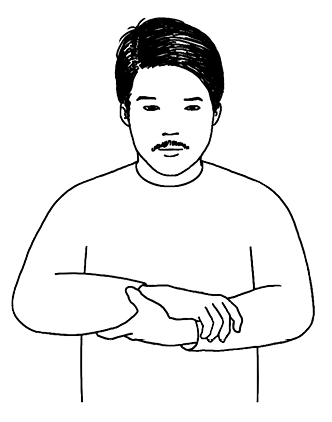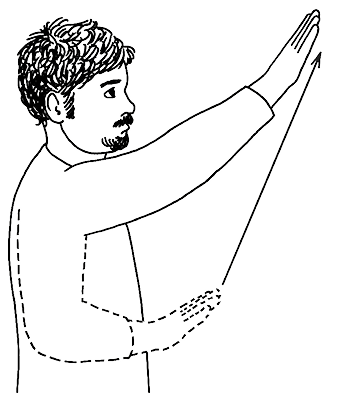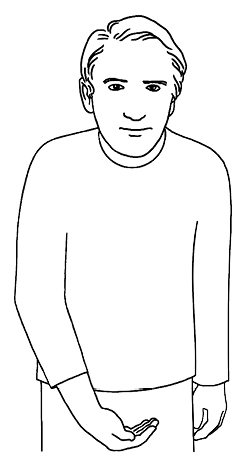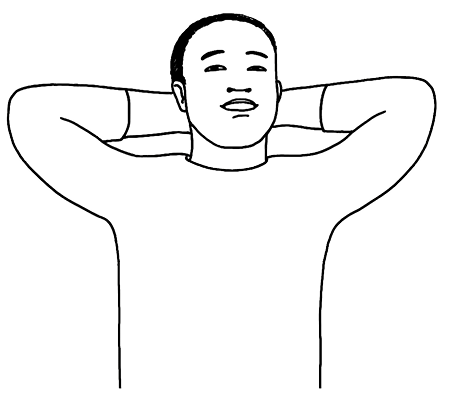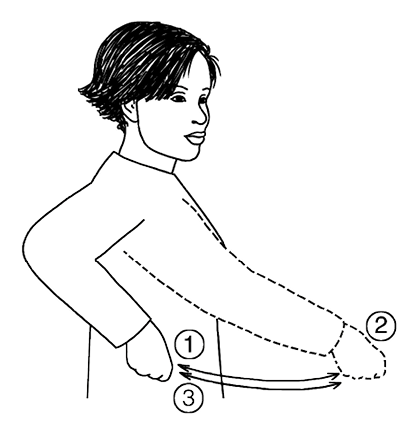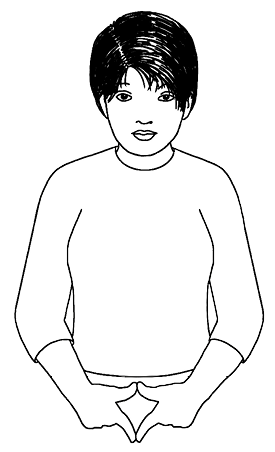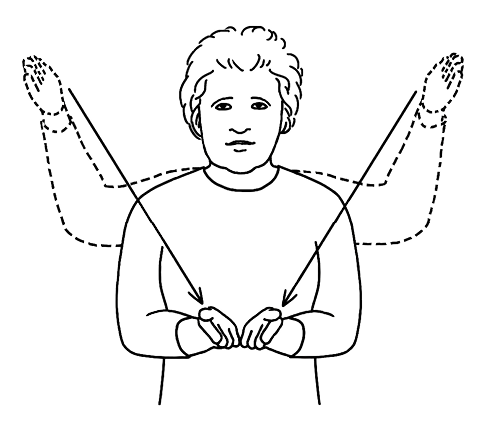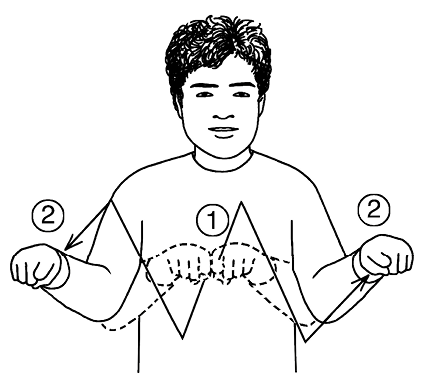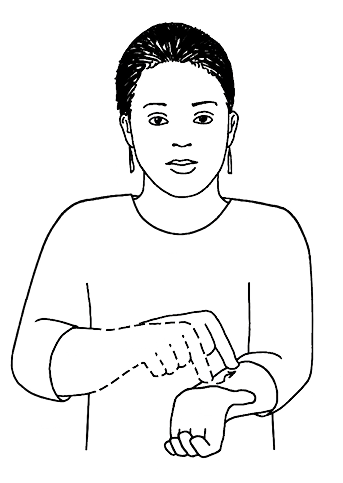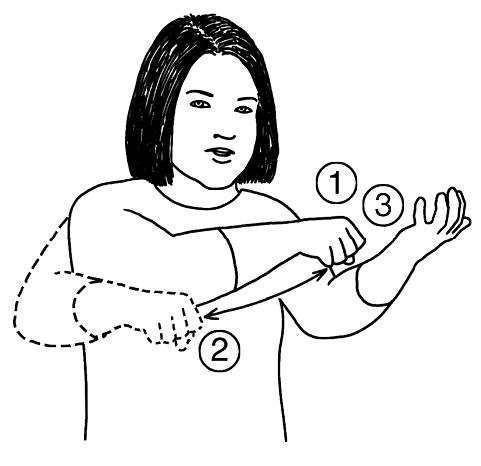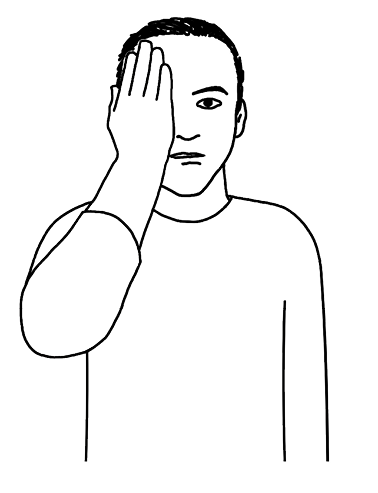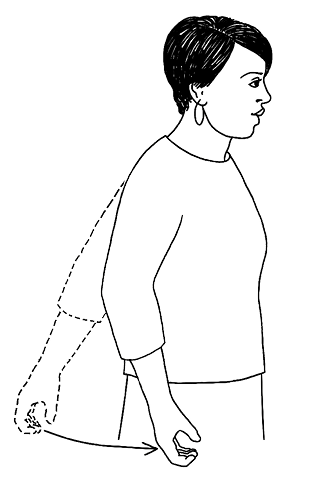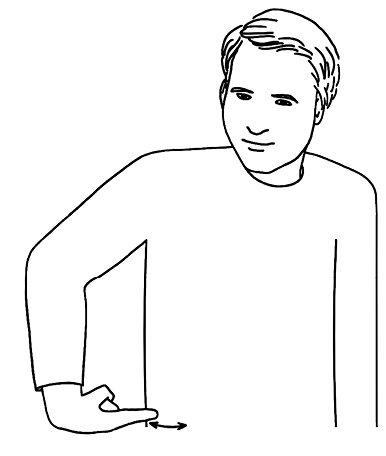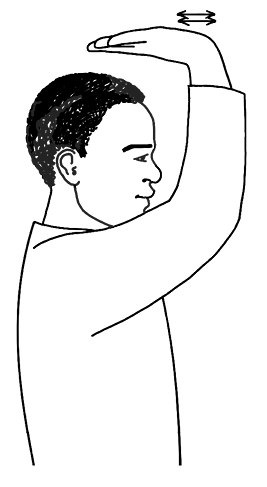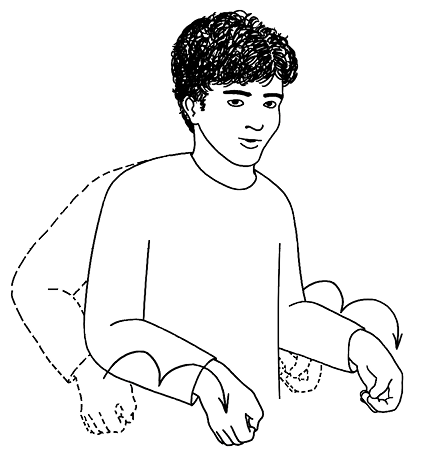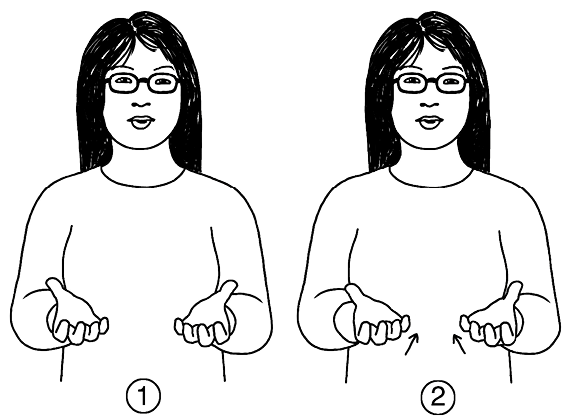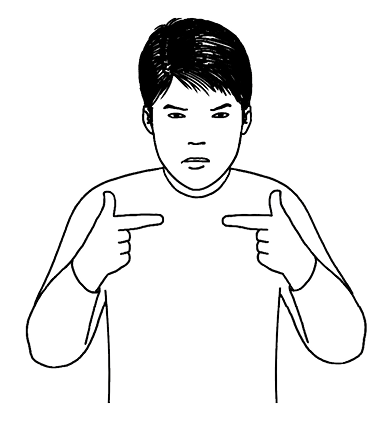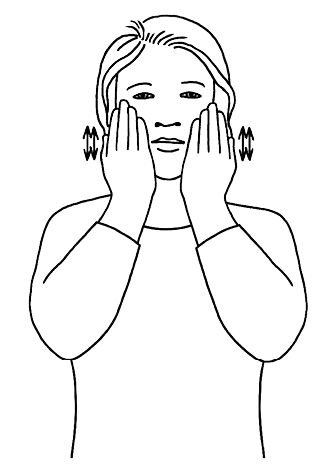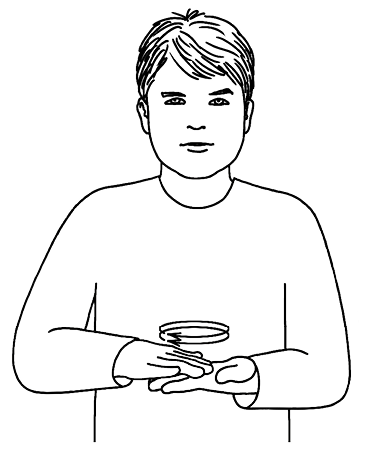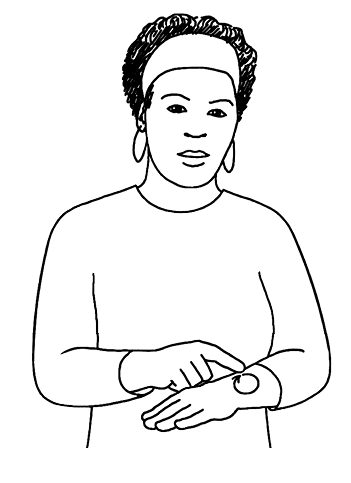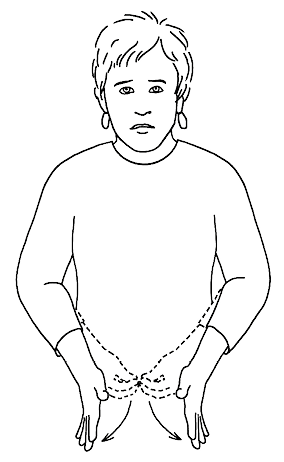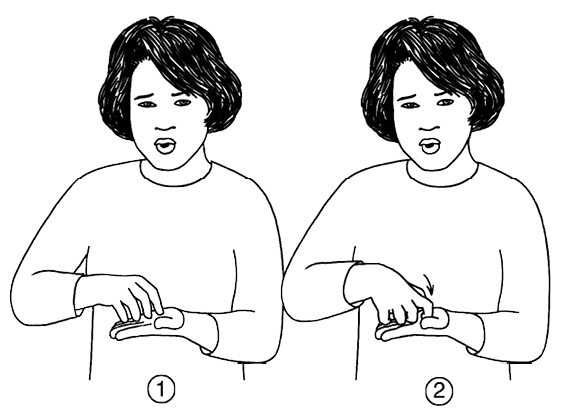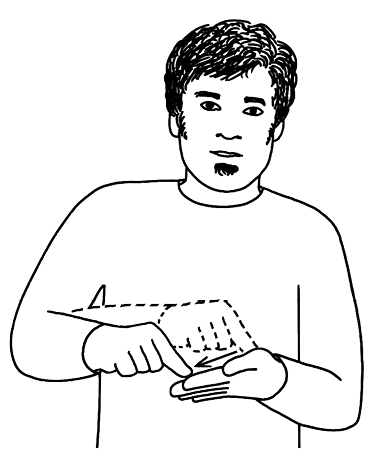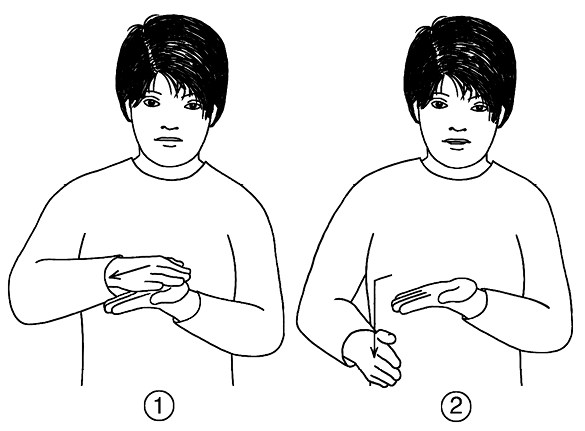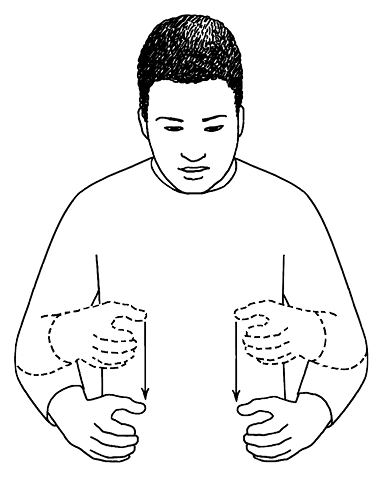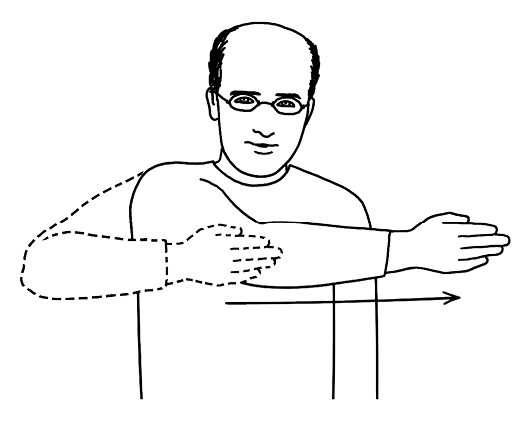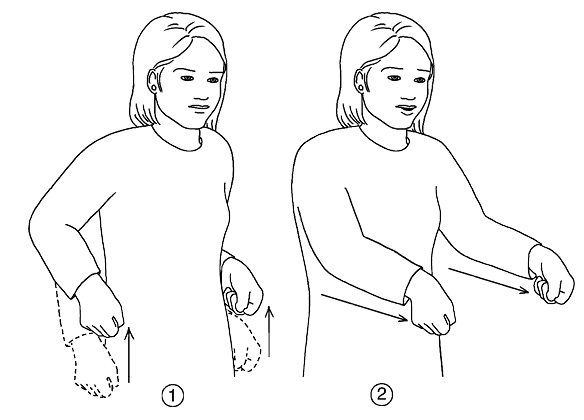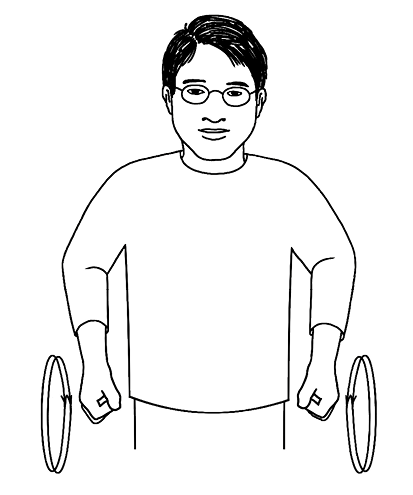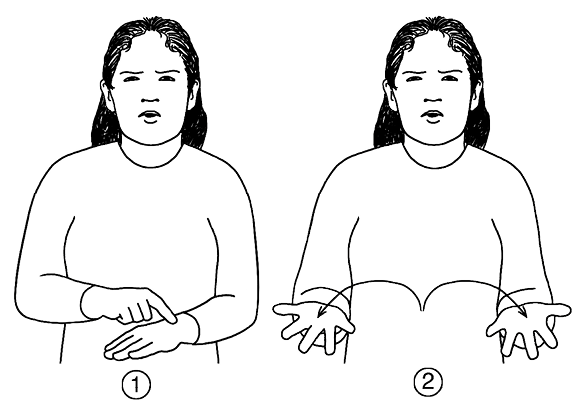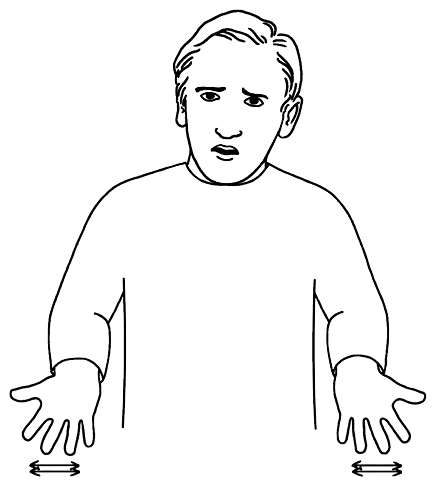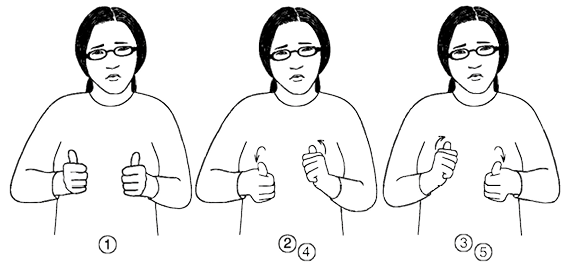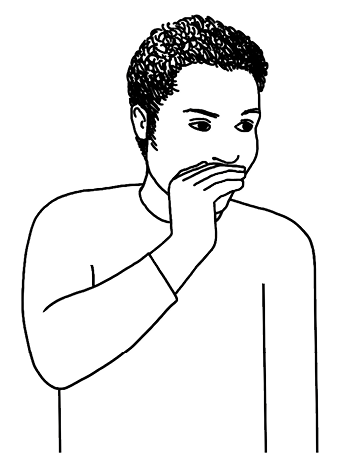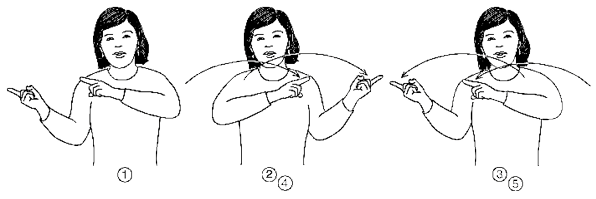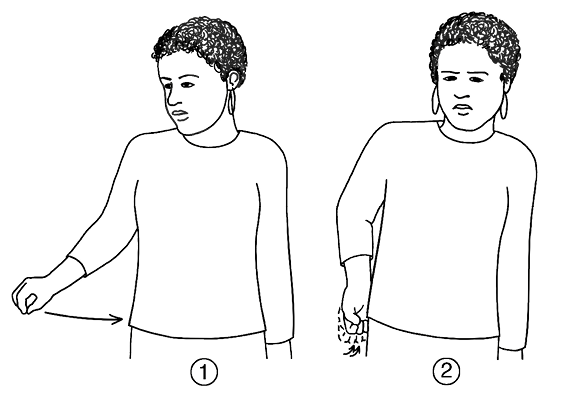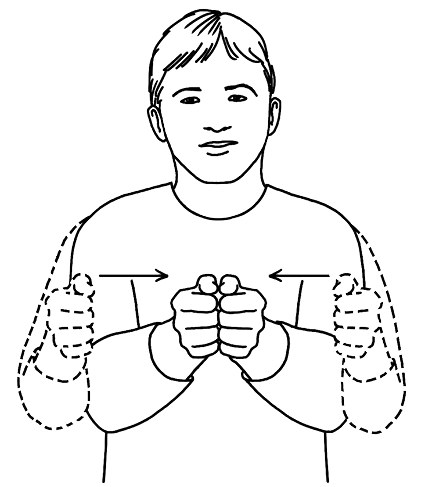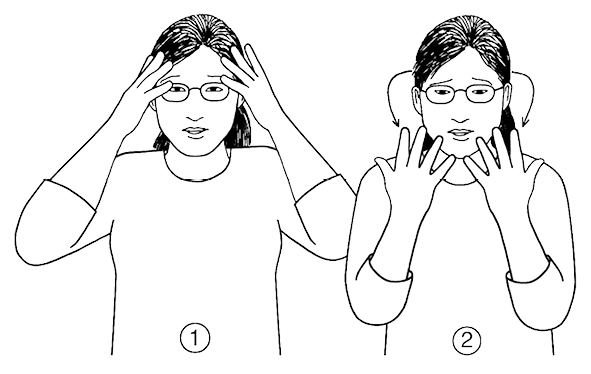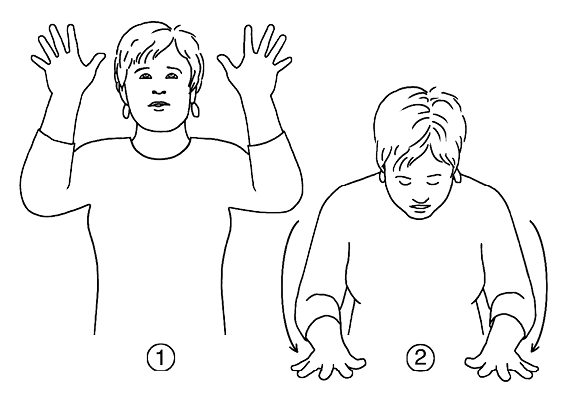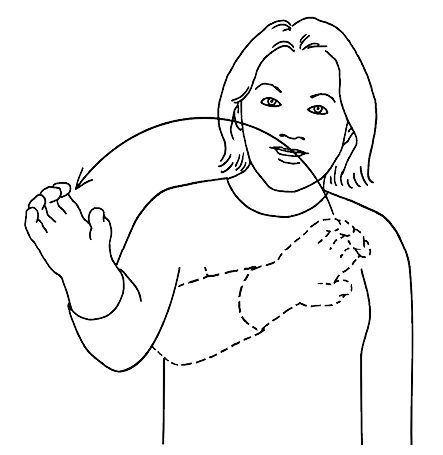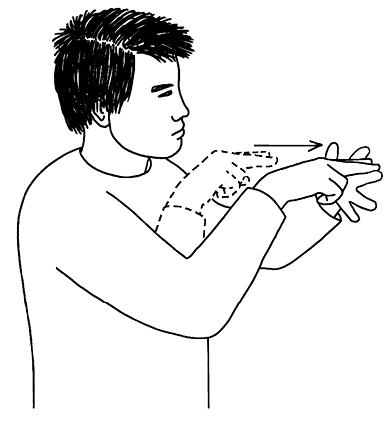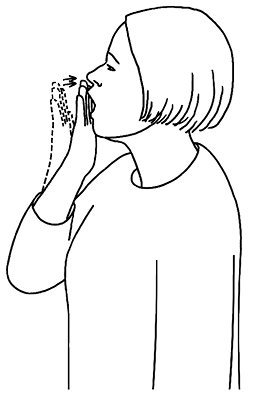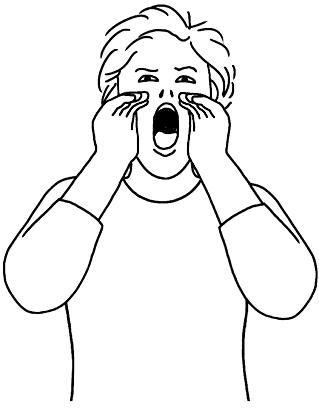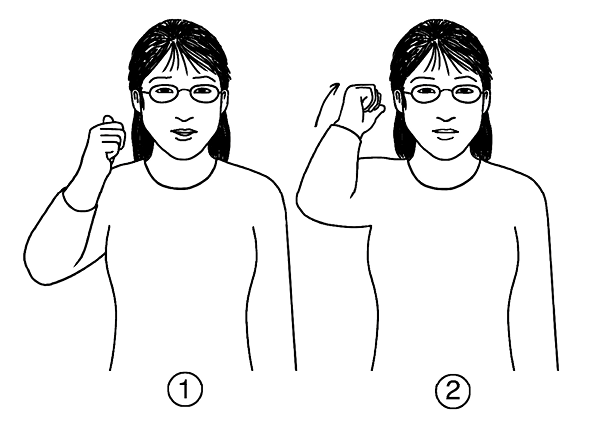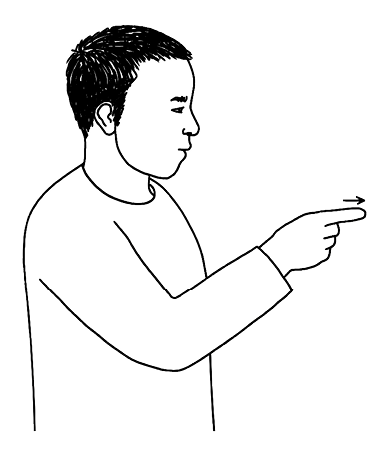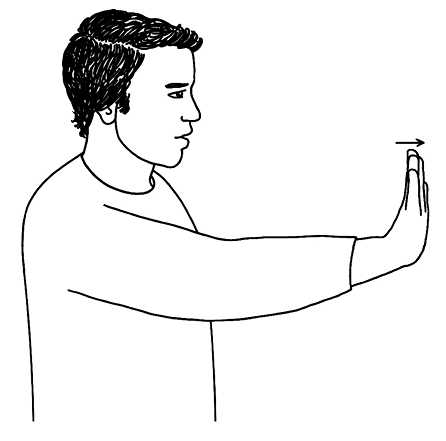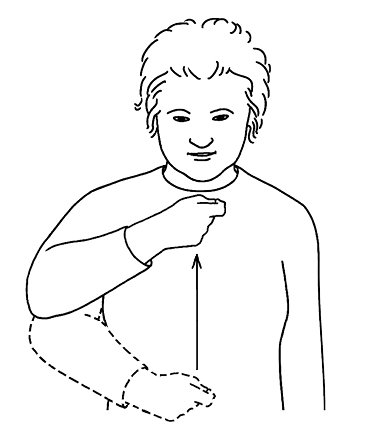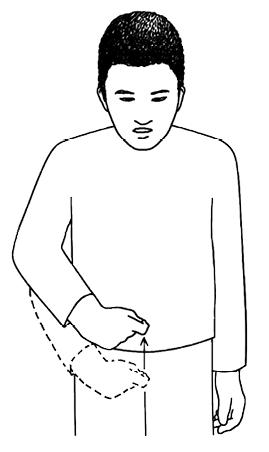11. The Simplified Sign System Lexicon
© Bonvillian, Kissane Lee, Dooley & Loncke, CC BY 4.0 https://doi.org/10.11647/OBP.0220.02
In the pages that follow, we provide a line drawing together with a written description of how each sign in the Simplified Sign System (SSS) is formed. Although we anticipate that most people will find each drawing sufficiently clear for them to produce a particular sign accurately, we hope that the written description will help resolve any remaining questions about a sign’s formation. (Please see the preceding chapter for a more detailed discussion of the handshapes, palm orientations, and finger/knuckle orientations that we use to describe our signs, as well as information on how to interpret the sign drawings.)
Accompanying each sign description is a short sentence that ties a particular sign’s formation to its underlying concept. We believe that these short sentences will serve as effective memory aids in the learning and recall of the signs. We have also included a more detailed explanation of the relationship between a sign’s formation (its handshape, location, and/or movement) and its meaning. These longer memory aids help to make the connection between the form, location, or action of a sign and its meaning clearer or even more explicit. For users whose first language is not English, we have often provided a definition of the main gloss or concept. Finally, we have listed synonyms for most entries in the lexicon so that users can quickly see the range of meanings that a sign may represent.
|
ABOVESynonyms: Aboveground, Over (above), Upper |
The active spread- or 5-hand (the hand is flat with fingers spread apart and extended), palm facing down and fingers pointing to the side, initially is held about six inches above the stationary spread- or 5-hand, palm facing down and fingers pointing to the opposite side. Both hands are in front of the body at chest level. The upper, active hand then circles horizontally above the lower, stationary hand. The act of showing the area over or above the lower hand. The active hand represents one space, area, or location that is positioned at a higher level than another space, area, or location (represented by the stationary hand). Above means that something is in a higher place or on a higher floor. This sign may also be used to indicate an area that is located aboveground or above the surface of a body of water (represented by the stationary forearm). |
|
ACUPUNCTURESynonyms: Acupuncture Needles, Acupuncturist |
The tips of the index finger and thumb of the active baby O-hand (the index finger and thumb are curved and touch at their tips from an otherwise closed hand), palm facing down and knuckles pointing diagonally forward, initially touch the lower part of the stationary forearm, palm facing down. Both hands are in front of the body at lower chest level. The active hand then slowly moves up the forearm in a series of small hops. The act of inserting acupuncture needles into one’s skin. The active hand grasps imaginary acupuncture needles and inserts them into different parts of a person’s stationary arm. Acupuncture is a medical practice from China in which thin needles are used to block or release pain in specific areas of the body. |
|
ADDITION (MATH)Synonyms: Add To, Additional, Add Up, Augment, Bonus, Extra, Sum, Summation (total), Supplement, Total (math) |
The active tapered- or O-hand (the fingers are together and curved, with the finger tips touching the thumb tip), palm facing up and knuckles pointing forward, initially is held in front of and to the side of the body near waist level. The stationary flat-hand (the hand is flat with fingers together and extended), palm facing up and fingers pointing diagonally forward, is held in front of the body at chest level. The active hand then arcs up and to the side, rotating so that the palm faces down and knuckles point diagonally forward as the tips of the fingers and thumb touch the upturned palm of the stationary hand. The act of adding the contents of one hand to the contents of another hand. The active hand represents an extra amount of something that is added to and supplements, augments, or increases the amount that one already has (represented by the stationary hand). This sign is also used to represent the mathematical process of addition. Addition is a calculation in which numbers are combined together to form a sum or total amount. |
|
ADDRESSSynonyms: Label, Nameplate, Tag |
The C-hand (the fingers are together and curved, with the thumb opposite the fingers), palm facing out and fingers pointing mostly up, initially is held in front of the opposite side of the body at chin level. The hand then moves to the other side. The act of placing a nameplate on the door to one’s office. A person who works in an office building often has a nameplate attached to the door or the wall outside of his or her office. The fingers trace the upper edge and the thumb traces the lower edge of such a nameplate. This sign may also be used to represent the rectangular shape of a large address label. An address indicates where a person or organization is located. |
|
AFRAIDSynonyms: Apprehensive, Cowardly, Craven, Faint-Hearted, Fear, Fearful, Fright, Frightened, Panic, Phobia, Pusillanimous, Scared, Terrified, Timid, Timorous |
Spread- or 5-hands (each hand is flat with fingers spread apart and extended), palms facing in and fingers pointing diagonally up to opposite sides, initially are held in front of the sides of the body at chest level. The hands then crisscross as they move diagonally up to opposite sides. The action is repeated. A fearful or scared facial expression is appropriate. The act of covering one’s heart when one is scared or frightened. When a person is afraid, his or her hands often move to cover or protect his or her heart (represented by the final position). To be afraid means that a person is scared, frightened, or full of fear. Fear is a natural response to a dangerous, shocking, or uncertain situation. |
|
AFTERNOONSynonym: P.M. |
The elbow of the active flat-hand (the hand is flat with fingers together and extended), palm facing out and fingers pointing up, rests on the back of the stationary flat-hand, palm facing down and fingers pointing to the side. The stationary hand is in front of the body at lower chest level. The active hand then arcs several inches out to the side of the body. The act of the hour hand of a wall clock moving past 12:00 (noon). The active hand and forearm represent the hour hand of a clock. Initially, the hand points straight up (indicating noon or 12:00 pm), but then the hand moves out to the side as the afternoon progresses. Afternoon is the period of a day lasting from noon to evening. The active hand may also represent the sun as it moves beyond its highest point in the sky (during the day at noon) to indicate the afternoon. Related to the sign for Noon. |
|
AGAINSynonyms: Accustomed To, Frequently, Habit, Habitually, Often, On a Regular Basis, Once More, Practice, Recurrent, Regularly, Repeat, Repeatedly, Repetition, Reiterate, Routine, Time After Time, Typically, Usually |
The tip of the index finger of the active pointing-hand (the index finger is extended from an otherwise closed hand), palm facing down and finger pointing diagonally forward and down, initially touches the lower part of the stationary forearm, palm facing down. Both hands are in front of the body at lower chest level. The active index finger then moves up the stationary forearm in a series of small hops. The act of repeating the same action multiple times (again and again). The active index finger represents something happening at more than one point along an imaginary timeline (represented by the stationary forearm). Again means to happen once more or that an action or event is repeated. |
|
AGAINSTSynonyms: Blocked, Hamper (hinder), Hinder, Impede, Inhibit, Obstruct, Obstruction of Justice |
The active flat-hand (the hand is flat with fingers together and extended), palm facing in and fingers pointing to the side, initially is held about six inches to the side of the stationary flat-hand, palm facing to the side and fingers pointing forward. Both hands are in front of the body at lower chest level. The active hand then moves to the side until the tips of the fingers contact the stationary palm. The act of one hand striking against or coming into direct contact with the other hand. The active hand represents a moving object that is blocked or obstructed by a wall or other immobile object (represented by the stationary hand). Against means to come into contact with or be in opposition to something. To block or impede means to inhibit the forward movement or progress of someone or something. Obstruction of justice is a criminal charge in which a person corruptly inhibits or attempts to inhibit prosecutors or officials from carrying out their duties. |
|
AIRPLANESynonyms: Aircraft, Flight, Fly (plane), Glider, Hang Gliding, Jet (passenger), Pilot, Plane, Soar, Wings (plane) |
Flat-hands (each hand is flat with fingers together and extended), palms facing down and fingers pointing out to opposite sides, initially are fully extended out to the sides of the body at shoulder level. One arm then tilts up slightly as the other arm tilts down slightly. The action is repeated by tilting to the opposite side. The act of an airplane adjusting its position as it flies. The body or torso represents the cabin or fuselage of an airplane and the arms represent the plane’s wings as the plane adjusts position and flies through the air. An airplane, plane, or aircraft is a vehicle for transporting people and/or cargo via flight. A pilot is a person who operates and flies aircraft. |
|
AIRPORTSynonyms: Air Base, Airfield, Airstrip, Landing Field, Landing Strip, Runway (airport), Tarmac (runway) |
The active horns-hand (the little finger and thumb are extended from an otherwise closed hand), palm facing down and knuckles pointing diagonally forward, initially is held in front of one shoulder, about a foot above and closer to the body than the stationary flat-hand (the hand is flat with fingers together and extended), palm facing up and fingers pointing diagonally forward to the opposite side. The stationary hand is in front of the body at lower chest level. The active hand then arcs down and forward, ending on the palm and fingers of the stationary hand. (This sign can also be made without the little finger of the active hand extended.) The act of a plane landing on a runway at an airport. The thumb and little finger of the active hand represent the wings of a plane and the rest of the hand represents the body (or fuselage) of the plane. Initially, the plane is in the air, but then it descends and lands on the flat surface of the ground or an airport runway (represented by the stationary hand). An airport is the location from which airplanes operate. |
|
ALARMSynonyms: Alarm Bell, Alert (warning), Warning (alarm) |
The active pointing-hand (the index finger is extended from an otherwise closed hand), palm facing diagonally out and finger pointing up, initially is held a few inches to the side of the palm of the stationary spread- or 5-hand (the hand is flat with fingers spread apart and extended), palm facing to the side and fingers pointing up. Both hands are in front of the body at chest level. The index finger of the active hand then repeatedly arcs to the side to strike the lower half of the stationary palm. The act of striking the side of a metal alarm bell. The index finger of the active hand represents the tongue or clapper repeatedly striking the metal side of an old-fashioned alarm bell (represented by the stationary hand). An alarm is a device that emits a loud, repeated sound (or spoken message) that warns or alerts people of impending danger (e.g., fire, tornado, tsunami, or prisoner escape). |
|
ALLSynonyms: All-Encompassing, Entire, Every, Everybody, Everyone, Inclusive, Whole (entire) |
The curved-hand (the fingers and thumb are together and curved), palm facing to the side and fingers pointing mostly forward, initially is held in front of one side of the body at chest level. The hand then arcs forward and to the other side, ending with the palm facing to the opposite side and fingers pointing mostly in. The act of using one’s arm to encircle everyone who is present. The active hand moves to include all of the people or everybody located in the immediate area. All means everyone or that no one is excluded or left out. |
|
ALPHABETSynonyms: Fingerspell, Letters (alphabet), Spell, Spelling |
The spread- or 5-hand (the hand is flat with fingers spread apart and extended), palm facing diagonally down and fingers pointing forward, initially is held in front of one side of the body at chest level. The fingers then wiggle. The act of using one’s fingers to manually spell out the letters of the alphabet. The letters of the written alphabet can be manually represented by various configurations of the hand and fingers. The movement of the fingers represents the consecutive production of individual letters of the alphabet when spelling (or fingerspelling) a word. An alphabet is a set of letters from which certain languages may be written. |
|
ALZHEIMER’S DISEASESynonyms: Dementia, Senile |
The tip of the index finger of the pointing-hand (the index finger is extended from an otherwise closed hand), palm facing diagonally in and finger pointing diagonally up, initially touches the temple (the side of the forehead). The hand then rotates so that the index finger points down as the hand moves straight down to below waist level. The act of one’s ability to think declining or going downhill. The initial position of the hand by the temple represents a person’s thought processes and the downward movement represents a decline in such thinking. Alzheimer’s disease or dementia is a condition in which a person’s ability to think clearly or to remember things deteriorates. A combination of the signs for Think and Down. |
|
AMBULANCESynonyms: Emergency Vehicle, Fire Truck, Police Car, Siren (vehicle) |
The spread curved-hand (the fingers are spread apart and curved), palm facing out and fingers pointing mostly up, initially is held just above the head. The hand then twists so that the palm faces to the side. The action is repeated. The act of lights twirling on an ambulance. The hand represents the rotating or twirling light(s) on the roof of an ambulance or other emergency vehicle (represented by the body) that is responding to a call for help. An ambulance is a vehicle that is used to treat and safely transport injured or sick persons to a hospital. Fire trucks and police cars also have rotating or flashing lights on their roofs. |
|
AMPUTATESynonyms: Amputation, Amputee, Cut Off (body part), Sever |
The edge of the active flat-hand (the hand is flat with fingers together and extended), palm facing up and fingers pointing to the side, slides back and forth across the stationary arm just above the elbow. The stationary arm is extended downward. (To indicate the amputation of another limb, make the sign on the area to be severed. If that is not possible, make this sign and then point to the appropriate limb.) The act of cutting off or amputating part of a person’s arm. The active hand represents a scalpel or medical saw that is used to amputate or remove part of a patient’s stationary arm (or to sever another limb). To amputate means to sever or cut off a body part. A limb may be cut off or amputated if it is severely injured, diseased, or contains too much dead tissue or infection to be saved. |
|
ANDSynonyms: Also, In Addition, Too |
The spread- or 5-hand (the hand is flat with fingers spread apart and extended), palm facing in and fingers pointing to the side, initially is held in front of the opposite side of the body at chest level. The hand then becomes a tapered- or O-hand (the fingers are together and curved, with the finger tips touching the thumb tip), palm facing to the side and knuckles pointing forward, as it moves to the other side of the body. Each finger represents one thing that is associated with and connected with the others. The fingers of the 5-hand initially represent separate strands or things that later come together to form one unit (represented by the O-hand). And is a conjunction (a grammatical part of speech that connects or joins words, sentences, clauses, or phrases). Also and too mean in addition to something else. |
|
ANGELSynonyms: Cherub, Halo, Saint |
The pointing-hand (the index finger is extended from an otherwise closed hand), palm facing down and finger pointing diagonally down and to the side, initially is held a short distance above one side of the head. The hand then makes a small horizontal circle over the head. The act of drawing a halo above an angel’s head. The index finger points to or indicates the circular shape of an angel’s halo. An angel is a heavenly being that many people believe protects or watches over the living. A halo is a ring of light above the head of an angel that represents the angel’s goodness and heavenly nature. |
|
ANGRYSynonyms: Anger, Belligerent, Cantankerous, Cross (angry), Enrage, Furious, Fury, Hostile, Irate, Mad, Outrage, Rage, Wrath |
The fist (the hand forms a fist), palm facing in and knuckles pointing up, initially is held in front of the side of the body at head level. The fist then shakes slightly. A frown or angry facial expression is appropriate. The act of clenching one’s fist and shaking it in anger. When a person is angry, irate, or mad, he or she may clench a fist and get ready to physically attack someone. Anger, fury, or rage is a feeling of strong displeasure about a situation or hostility toward another person or group. |
|
ANIMALSynonyms: Beast, Creature, Mammal, Paws |
Spread curved-hands (the fingers are spread apart and curved), palms facing down and fingers pointing mostly forward, initially are held about six inches apart in front of the body at lower chest level. The hands then alternately arc forward and slightly down. The act of an animal’s paws moving forward. The hands represent the front paws of an animal and the fingers represent the animal’s toes and/or claws as the animal walks. Animals are creatures that exist in a variety of shapes, colors, and sizes. Many land-based animals have four legs — two in front and two in back. Paws are the padded feet of certain animals (such as felines, canines, and bears). |
|
ANNOUNCEMENTSynonyms: Advertise, Advertisement, Announce, Broadcast, Commercial (ad), Disclose (to the public), Inform, Make Public, Notify, Proclaim, Proclamation, Promulgate, Public, Publicity, Publicize, Spread News |
The tips of the index fingers of pointing-hands (the index fingers are extended from otherwise closed hands), palms facing each other and to opposite sides and fingers pointing up, initially touch the face near the corners of the mouth. The hands then arc forward and to opposite sides, rotating slightly so that the palms face out and fingers point diagonally up and out to opposite sides. The act of making an announcement or broadcasting news to the public. The index fingers represent a spoken announcement that is made to a large group of people (represented by the movement). The index fingers may also represent words that are widely disseminated or that spread to other locations (represented by the final position of the hands). An announcement is a public statement or declaration meant to provide others with news or important information. |
|
ANSWERSynonyms: Reply, Respond, Response |
The tip of the index finger of the pointing-hand (the index finger is extended from an otherwise closed hand), palm facing to the side and finger pointing up, initially touches the face just below the mouth. The hand then arcs forward and down until the finger points forward. The act of providing an answer or response. The index finger represents an answer or reply coming out of one person’s mouth that is aimed in the direction of another person (represented by the final position) who has asked a question. To answer means to reply or say something in response to another person’s question. |
|
APPLAUDSynonyms: Acclaim (applause), Applause, Clap, Plaudits |
The palms of the hands, one facing diagonally out and down and the other facing diagonally in and up, strike each other repeatedly in front of the body at chest level. (Alternatively, this sign can be made with the palms facing each other and to opposite sides.) The act of applauding or clapping. When a person likes or enjoys a performance or something that has been said, he or she often expresses approval by applauding or clapping his or her hands together. To applaud means to show appreciation for someone or something by hitting the hands together (typically palm-to-palm) so that they make a clapping noise. |
|
APPOINTMENTSynonyms: Choose a Time, Make a Reservation, Reservation |
The active baby O-hand (the index finger and thumb are curved and touch at their tips from an otherwise closed hand), palm facing down and knuckles pointing diagonally forward, initially is located a few inches to the side of the stationary hand, palm facing down. Both hands are in front of the body at lower chest level. The active hand then arcs up and to the side until the tips of its index finger and thumb touch the back of the stationary wrist. The act of choosing a specific time for an appointment or reservation. The active hand selectively picks a time (represented by the final position, a common location to wear a watch) and a date on a calendar (represented by the stationary hand) to make a reservation or appointment. An appointment is a scheduled meeting. A reservation is the setting aside of something for a particular use at a specific time in the future. A combination of the signs for Choose and Time. |
|
APRONSynonym: Apron Strings |
The edges of the tips of the index fingers and thumbs of baby O-hands (the index fingers and thumbs are curved and touch at their tips from otherwise closed hands), palms facing down and knuckles pointing forward, initially touch just in front of the body near waist level. The hands then separate and move to opposite sides and behind the back. The act of tying the strings of an apron behind one’s back. The fingers grasp the strings on an apron and then tie them behind a person’s back near waist level. An apron is a cloth garment that is often worn over the front of a person’s clothes while he or she is cleaning or cooking. Aprons help to protect a person’s clothes from getting dirty. |
|
ARGUESynonyms: Argument, Argumentative, Conflict (quarrel), Contentious, Controversial, Debate, Disagreement (argument), Discord, Dispute, Dissension (discord), Divisive, Quarrel, Spat (argument), Squabble, Strife |
Pointing-hands (the index fingers are extended from otherwise closed hands), palms facing diagonally in and fingers pointing to opposite sides, initially are held about a foot apart in front of the body with one hand at shoulder level and the other hand at lower chest level. The lower hand then arcs up as the upper hand arcs down. This alternating action is repeated rapidly several times. A frown or angry facial expression is appropriate. The act of two people wagging their fingers at each other during an argument. When two people are involved in an argument or dispute, they may point their fingers at each other and try to blame the other person for what has happened. An argument is a dispute, disagreement, or quarrel about someone or something. A debate typically is a discussion of the merits and failings of a policy, proposal, or position on an issue. Debates between political opponents are often held before a scheduled election. |
|
ARITHMETICSynonyms: Census, Count, Math, Mathematics |
The tip of the index finger of the active pointing-hand (the index finger is extended from an otherwise closed hand), palm facing down and finger pointing diagonally forward, touches and then bends down the tip of the little finger of the stationary spread- or 5-hand (the hand is flat with fingers spread apart and extended), palm facing in and fingers pointing diagonally up to the opposite side. Both hands are in front of the body at chest level. The action is then repeated on the tip of the stationary ring finger. The act of using one’s fingers to count or do arithmetic. When a person is doing math, he or she may use his or her fingers to keep track of the result. Arithmetic is the branch of mathematics that involves such basic functions as the addition, subtraction, multiplication, and division of numbers. Math is a discipline involving the use of numbers and equations to quantify and describe aspects of the world. |
|
ARMSynonyms: Brachial, Forearm |
The index finger of the active pointing-hand (the index finger is extended from an otherwise closed hand), palm facing down and finger pointing diagonally forward and down, points to the middle of the stationary forearm, palm facing diagonally down. The stationary forearm is partially extended in front of the body below chest level. The act of showing the location of one’s arm. The active index finger points to or indicates the location of a person’s stationary arm or forearm. Arms are the upper appendages or limbs of a human or primate; arms extend from the shoulders to the hands. The forearm is the part of the arm that extends from the elbow to the hand. |
|
AROUNDSynonyms: Carousel, Encircle, Merry-Go-Round, Surround |
The active pointing-hand (the index finger is extended from an otherwise closed hand), palm and finger pointing down and knuckles pointing to the side, initially is held a few inches away from the top of the stationary flat-hand (the hand is flat with fingers together and extended), palm facing to the side and fingers pointing up. Both hands are in front of the body near upper chest level. The active hand then circles horizontally around the top of the stationary hand. The act of fully encircling or going around an object. The active index finger represents a path around a central object (represented by the stationary hand). Around refers to the area surrounding, encompassing, encircling, or on all sides of an object. A merry-go-round is a playground device that rotates around a central point. A carousel is a similar, but larger, machine that allows individuals to ride on play horses and animals as the riding platform spins around a central hub. |
|
ARRESTSynonyms: Apprehend (arrest), Cuffs, Handcuffs, Manacles, Shackles, Suspect (criminal), Take Into Custody |
The active C-hand (the fingers are together and curved, with the thumb opposite the fingers), palm facing diagonally down and fingers pointing mostly diagonally forward, initially is held several inches above the stationary hand, palm facing down. Both hands are in front of the body at chest level. The active hand then arcs down and grabs the back of the stationary wrist. The act of arresting and putting handcuffs on someone. The active hand represents handcuffs or shackles that are put on the wrists of a person who has been arrested (represented by the stationary arm). To arrest means to take a person suspected of a crime into legal custody. Handcuffs are connected metal bracelets used to restrain a suspected criminal’s hands and prevent that person from harming others while in police custody. |
|
ARRIVESynonyms: Arrival, AttendAntonyms: Depart, Departure, Evacuate, Exit, Flee, Leave |
The active pointing-hand (the index finger is extended from an otherwise closed hand), palm facing to the side and finger pointing up, initially is held about six inches to the side of the stationary flat-hand (the hand is flat with fingers together and extended), palm facing to the opposite side and fingers pointing forward. Both hands are in front of the body at chest level. The active hand then moves to contact the stationary palm. (To indicate the meanings Depart, Departure, Evacuate, Exit, Flee, or Leave, reverse the action of the sign.) The act of a person arriving at a specific location. The active index finger represents a person, animal, or object arriving at a certain location (represented by the stationary hand). To arrive means to reach one’s destination or get to a specific location. To attend means to go to a meeting or be present at an event. |
|
ASCENDSynonyms: Go Straight Up, Launch (rocket), Launch Pad, Lift-Off, Missile, Pop-Up, Rocket |
The edge of the tip of the index finger of the active pointing-hand (the index finger is extended from an otherwise closed hand), palm facing out and finger pointing up, initially touches the edge of the index finger of the stationary flat-hand (the hand is flat with fingers together and extended), palm facing down and fingers pointing forward. Both hands are in front of the body at chest level. The active hand then moves straight up about six inches. The act of a rocket or missile ascending or being launched into the air. The index finger of the active hand represents a rocket as it lifts off from the ground or a launch pad (represented by the stationary hand) and ascends into the sky (represented by the final position). To ascend means to go up or rise to a higher point or level. A rocket is a fuel-powered device typically used to propel and launch satellites, shuttles, and cargo into space. A missile is a fuel-powered, explosive projectile used as a weapon. |
|
ATTICSynonyms: Garret, Loft, Top Floor |
The active spread- or 5-hand (the hand is flat with fingers spread apart and extended), palm facing down and fingers pointing diagonally forward, initially is held just below the stationary bent-hand (the fingers are together and extended at a right angle with respect to the palm), palm and fingers pointing diagonally down to the opposite side and knuckles pointing up. Both hands are in front of the body at upper chest level. The lower, active hand then circles horizontally below the upper, stationary hand. The act of showing the area of an attic below the roof of a house. The active hand represents and shows the location of an attic below the peaked roof of a house (represented by the stationary hand). An attic is the floor, space, or area that is positioned just below the roof of a house or building. Attics often are used for storage. This sign may also be used to refer to the top floor of a house or building. |
|
AWAKESynonyms: Conscious, Open One’s Eyes, Wake Up |
The tips of the index fingers and thumbs of baby O-hands (the index fingers and thumbs are curved and touch at their tips from otherwise closed hands), palms facing each other and to opposite sides and knuckles pointing up, initially are held near the outer corners of the eyes. The fingers and thumbs then move apart. The act of opening one’s eyes or waking up. The index fingers and thumbs represent a person’s upper and lower eyelids. Initially, the eyelids are together or closed (representing that the person is asleep) but then the eyelids separate as the eyes open (representing that the person is now awake). To be awake means that a person is conscious and aware of his or her surroundings. |
|
BABYSynonyms: Babyhood, Cradle, Crèche, Crib (baby), Infancy, Infant, Neonatal, Neonate, Newborn, Rock (a baby) |
One forearm initially rests on top of the other forearm, palms facing up and fingers pointing to opposite sides. Both forearms are in front of the body at lower chest level. The arms then swing gently from side to side. The act of cradling and rocking a baby in one’s arms. This sign represents a person holding a baby in his or her arms and comforting or rocking the baby to sleep. A baby is an infant or very young child. The forearms may also represent the bottom of a cradle and the gentle movement represents the rocking of that cradle. A cradle is a small bed or basket for holding a baby and rocking it to sleep. |
|
BACKSynonyms: Backbone, Cervical Spine, Chiropractics, Spinal Column, Spine, Vertebra, Vertebral Column |
The tip of the index finger of the pointing-hand (the index finger is extended from an otherwise closed hand), palm and finger pointing down and knuckles pointing to the side, reaches over the shoulder (on the same side of the body) and touches the upper back. (To indicate the meanings Backbone, Cervical Spine, Chiropractics, Spinal Column, Spine, Vertebra, or Vertebral Column, the tip of the index finger of the pointing-hand, palm facing forward and finger pointing diagonally down, slides up and down the back of the neck.) The act of showing the location of one’s back. The index finger points to or indicates the location of a person’s upper back. The back of a person is the rear side of the body. The spine or backbone is a series of interconnected bones (vertebrae) running from the base of the skull down the center of a person’s back to the tailbone. The spine protects the spinal cord (part of the central nervous system). |
|
BACKACHESynonyms: Lower Back Pain, Lumbago |
The palm of the spread- or 5-hand (the hand is flat with fingers spread apart and extended), palm facing to the side and slightly forward and fingers pointing down, initially touches the side of the lower back. The body should lean forward slightly. The hand then slides a short distance up and down. The action is repeated a couple of times. A frown or pained facial expression is appropriate. The act of feeling or rubbing one’s aching back. A person may rub his or her back in an attempt to relieve aches or painful spasms. The pained facial expression and the placement of the hand indicate that the lower back is the source of discomfort. A backache is a pain in a person’s back, especially the lower back. |
|
BACKPACKSynonyms: Knapsack, Rucksack |
Fists (each hand forms a fist), palms facing in and knuckles pointing at each other and to opposite sides, initially are held on the chest under each shoulder. The arms and elbows then rock back and forth slightly a few times. The act of holding the straps on a backpack while on a hike. The hands grasp and hold on to the front straps of a backpack. A backpack is a sack carried on a person’s back and secured by straps over and below the shoulders. Backpacks are often made of canvas or nylon and are used by students to carry books and school supplies. Backpacks also are commonly used to carry food, water, and other provisions while hiking and camping. |
|
BADSynonyms: Defective, Detrimental, Downside, Inadequate, Lose (game), Negative (bad), No Good, Poor Quality, Unfavorable, Unsatisfactory |
The fist (the hand forms a fist), palm facing out and knuckles pointing to the side with the thumb extended and pointing down, initially is held in front of the body at chest level. The fist then moves down slightly. A frown or unhappy facial expression is appropriate. The act of giving someone or something one thumb down for a bad job. A thumb pointing down often conveys disapproval or that something is bad. Bad means defective, inadequate, being of low or poor quality, or having a negative, unfavorable, or unsatisfactory result. This sign may also be used to refer to losing a game or contest. |
|
BALANCESynonyms: Equilibrium, Justice, Libra (astrology), Scales |
Flat-hands (each hand is flat with fingers together and extended), palms facing down and fingers pointing forward, initially are held about a foot apart in front of the body near waist level. One hand then moves down a few inches as the other hand moves up a few inches. If possible, one should lean slightly to the side with the downward movement of each hand (lean right when the right hand moves down; lean left when the left hand moves down). The act of one’s balance shifting from one side to the other. The hands represent a person’s feet as that person tries to gain his or her balance or equilibrium. Balance refers to a person’s ability to maintain poise and control over the positioning of his or her body. The hands may also represent the metaphorical scales of justice involved in weighing evidence. Scales are two matched plates that are suspended from each side of a center beam. Scales are used to measure and compare the weights of items placed on those plates. |
|
BALL |
The tips of the fingers and thumbs of spread curved-hands (the fingers are spread apart and curved), palms facing each other and to opposite sides and fingers pointing mostly forward, touch as the hands are held in front of the body at chest level. (Alternatively, the fingers can point mostly up.) The act of showing the round shape of a ball. The fingers and hands represent the rounded outer edge of a ball. A ball is a spherical or round object that is often thrown, rolled, hit, or kicked in games. Examples of balls include baseballs, softballs, soccer balls, basketballs, tennis balls, and ping pong balls. |
|
BALL CAPSynonyms: Brim, Cap, Visor |
The edges of the index finger and thumb of the curved-hand (the fingers and thumb are together and curved), palm facing down and fingers pointing mostly to the side, rest against the top of the forehead. The hand resembles the brim of a ball cap. The hand and fingers represent the front extension or brim of a cap or visor. A ball cap is a covering for the crown of the head that has a brim projecting forward to help shield the face and eyes from the sun. A visor is a brim that connects to the head by means of an encircling strap. |
|
BALLOONSynonym: Inflate (a balloon) |
The edges of the index finger and thumb of the tapered- or O-hand (the fingers are together and curved, with the finger tips touching the thumb tip), palm facing to the side and knuckles pointing up, initially touch the lips. The hand then moves a short distance to the side and slightly forward as it slowly opens into the spread curved-hand (the fingers are spread apart and curved), palm facing to the side and fingers pointing mostly up. Puckering the lips and blowing air are appropriate. The act of blowing up a balloon. The hand represents a balloon. Initially, the balloon is flat or deflated (represented by the O-hand) but then it expands as a person blows air into it (represented by the spread curved-hand). A balloon is an inflatable rubber bag that may float in the air. Balloons are often used as decorations at birthday parties and other celebrations. |
|
BANANASynonyms: Banana Peel, Peel (banana), Plantain |
The tips of the index finger and thumb of the active baby O-hand (the index finger and thumb are curved and touch at their tips from an otherwise closed hand), palm facing to the side and knuckles pointing up, initially touch the tip of the index finger of the stationary pointing-hand (the index finger is extended from an otherwise closed hand), palm facing to the opposite side and finger pointing up. Both hands are in front of the body at upper chest level. The baby O-hand then arcs down and back toward the signer. The action is repeated with the baby O-hand ending slightly to the side of its previous position. The act of peeling a banana. The active hand grasps and removes the skin or peel of a banana (represented by the stationary index finger). A banana is a fruit, long and slender in shape, that is enclosed in a yellowish covering or rind. A plantain is a type of banana that is usually fried or baked before eating. |
|
BAND-AID™ |
The index and middle fingers of the active H-hand (the index and middle fingers are together and extended from an otherwise closed hand), palm facing down and fingers pointing diagonally forward and down, initially touch the back of the stationary hand, palm facing down and fingers pointing diagonally forward to the opposite side. Both hands are in front of the body at lower chest level. The active hand then slides across the back of the stationary hand. The act of putting a band-aid over a small cut. The index and middle fingers of the active hand represent a rectangular band-aid as it is applied over a small cut or injury on the back of a person’s stationary hand. A band-aid is a relatively small strip of sterile material that is put over cuts or wounds to stop bleeding and prevent contamination. |
|
BANKSynonyms: Deposit, Invest, Safe (money), Safety Deposit Box, Stow AwayAntonyms: ATM, Withdraw (money), Withdrawal (money) |
The active tapered- or O-hand (the fingers are together and curved, with the finger tips touching the thumb tip), palm facing diagonally out and knuckles pointing up, initially is held several inches behind and slightly above the stationary C-hand (the fingers are together and curved, with the thumb opposite the fingers), palm facing diagonally out to the opposite side and fingers pointing mostly up. Both hands are in front of the body at chest level. The active hand then moves diagonally forward and down until it is between the fingers and thumb of the stationary hand. (To indicate the meanings ATM, Withdraw (money), or Withdrawal (money), reverse the action of the sign.) The act of putting money into a bank. The active hand represents money or a check as it is deposited or placed into a safe in a bank (represented by the stationary hand). A bank is an institution for the borrowing, lending, and safekeeping of money. A deposit is money or funds added to one’s bank account. |
|
BARSSynonyms: Banister, Bedside Commode, Commode, Handrails, Railings, Rehabilitation Bars |
C-hands (the fingers are together and curved, with the thumbs opposite the fingers), palms facing down and fingers pointing mostly diagonally down and out to opposite sides, initially are held in front of and to the sides of the body below chest level. The hands then move down slightly. (To indicate a single bar or railing, use only one hand. To indicate the meanings Bedside Commode or Commode, make the sign at waist level.) The act of grasping support bars or railings as one walks. The hands grasp imaginary bars or railings to help a person steady his or her balance while walking or standing. Bars typically are wooden or metal railings that may be grasped for support. A banister is a handrail on one or both sides of a staircase that a person may grasp as he or she goes up and down steps in a building or house. Some bedside commodes (portable toilets) have support bars to assist a patient while sitting and standing. |
|
BASEBALLSynonyms: Baseball Bat, Batter (baseball), Cricket (game), Softball, Sports, Swing (bat) |
One fist (the hand forms a fist), palm facing to the side and knuckles pointing forward, rests on top of the other fist, palm facing back and knuckles pointing out to the side. Initially, the fists are held in front of one shoulder. The hands then swing forward and to the opposite side until the arms are almost fully extended and pointing diagonally forward. The act of swinging a baseball bat. The hands grasp the handle of an imaginary baseball bat (a long, wooden or metal rod used to hit baseballs) and then the arms swing forward in an attempt to hit a thrown ball. Baseball and softball are games in which players use a bat to hit a ball before running toward set points on a field (bases). |
|
BASEMENTSynonyms: Bottom Floor, Cellar, Lower Level |
The active spread- or 5-hand (the hand is flat with fingers spread apart and extended), palm facing down and fingers pointing diagonally forward, initially is held about a foot below the stationary bent-hand (the fingers are together and extended at a right angle with respect to the palm), palm and fingers pointing diagonally down and to the opposite side and knuckles pointing up. The stationary hand is in front of the body at upper chest level. The lower, active hand then circles horizontally below the upper, stationary hand. The act of showing the area of a basement far below the roof of a house. The active hand represents and shows the location of a basement or cellar far below the peaked roof of a house (represented by the stationary hand). A basement is the lowest floor, space, or area of a building, typically located partially or fully underground. |
|
BASKETSynonyms: Enmeshed, Interwoven, Thatched |
The fingers of the upper C-hand (the fingers are together and curved, with the thumb opposite the fingers), palm and fingers pointing to the side and knuckles pointing down, rest on top of the fingers of the lower C-hand, palm and fingers pointing to the opposite side and knuckles pointing down. The tips of the thumbs also touch and are held above the palms. Both hands are in front of the body near waist level. (This sign can also be made by interlocking the fingers. To indicate the meanings Enmeshed, Interwoven, or Thatched, rotate that sign so that the bottoms of the interlocked fingers face forward.) The hands resemble the general shape of a basket. The thumbs represent the handle on a basket and the hands and fingers represent the sides and bottom of the basket. A basket is a container that is made of interwoven materials. A basket often has one or two handles that allow a person to safely carry it around. |
|
BASKETBALLSynonym: Pass the Ball |
Spread curved-hands (the fingers are spread apart and curved), palms facing out and slightly up and fingers pointing mostly up, initially are held just in front of the body at upper chest or chin level. The hands then arc up and forward. The act of passing a basketball to another person. The hands initially lightly grasp a basketball and then pass it to another person or throw it toward a hoop. Basketball is a game played on a court by two teams of players who try to toss an inflated ball through an elevated hoop (called a basket) at each end of the court. |
|
BATHSynonyms: Bathe, Take a Bath, Wash One’s Body |
The flat-hand (the hand is flat with fingers together and extended), palm facing in and fingers pointing to the side, initially rests on one side of the body at upper chest level. The hand then moves up and down slightly as it slides across the chest. The act of cleaning oneself by taking a bath. The hand represents a washcloth or sponge used by a person to bathe or wash his or her chest. A bath involves the cleaning of a person’s body, usually with water and some type of soap. |
|
BATTERYSynonyms: Battery Terminal, Sparks |
The tips of the index finger and thumb of the active baby O-hand (the index finger and thumb are curved and touch at their tips from an otherwise closed hand), palm facing down and knuckles pointing diagonally forward, initially touch the tip of the thumb of the stationary fist (the hand forms a fist), palm facing in and knuckles pointing diagonally forward to the opposite side with the thumb partially extended and pointing up. Both hands are in front of the body at chest level. The active hand then opens quickly into an L-hand (the index finger and thumb are extended from an otherwise closed hand and form a right angle), palm facing down and index finger pointing diagonally forward with the thumb pointing to the side. This action is repeated. The act of sparks flying from a battery terminal. The index finger and thumb of the active hand represent sparks flying from a vehicle battery terminal or connection point (represented by the stationary thumb). A battery is a source of electric current. Batteries come in various sizes and may be used to power the electronics in vehicles, handheld devices, flashlights, and radios. |
|
|
Claw-hands (the fingers are spread apart and bent), palms facing in and knuckles pointing diagonally up to opposite sides, initially are crisscrossed over the chest. The hands then make small scratching movements on the shoulders. An accompanying growl or scowl is appropriate. The act of getting a bear hug. The fingers represent a bear’s claws as they scratch an object or vertical surface such as a tree (represented by the person’s body). A bear is a large, ursine mammal with thick fur (often black, brown, or white) and big claws. A bear hug is a tight embrace. |
|
BEARDSynonyms: Facial Hair, Whiskers (beard) |
The C-hand (the fingers are together and curved, with the thumb opposite the fingers), palm facing in and slightly up and fingers pointing mostly to the side, initially cups the chin with the fingers on one side and the thumb on the other. The fingers and thumb then slide down the sides of the chin until they touch and close into a tapered- or O-hand (the fingers are together and curved, with the finger tips touching the thumb tip), palm facing in and slightly up and knuckles pointing diagonally up. The act of stroking the whiskers of one’s beard. The fingers and thumb feel the whiskers of a beard on a man’s chin. A beard is the hair that grows on a man’s face, especially around the chin and lower jaw. Whiskers are the individual hairs in a person’s beard. |
|
BEAUTIFULSynonyms: Attractive, Beauty, Good-Looking, Gorgeous, Handsome, Lovely, Pretty |
The flat-hand (the hand is flat with fingers together and extended), palm facing in and fingers pointing diagonally up, initially is held just in front of and to the side of the face. The hand then circles around the edge of the face. A smile or happy facial expression is appropriate. The act of showing off or being thankful for one’s beautiful face. A person may show off a beautiful or attractive face by circling or framing it with his or her hand. Something that is beautiful or lovely is very attractive, pretty, or extremely pleasing to look at. Handsome and good-looking are words generally used to describe attractive men. |
|
BEDSynonyms: Bedroom, Bedtime |
The head tilts to the side as it rests on the palm of the flat-hand (the hand is flat with fingers together and extended), palm facing to the side and fingers pointing diagonally up and out to the side. (Alternatively, this sign can be made with two hands, palms touching, with the head resting on the back of the upper hand.) The act of resting one’s head while lying in bed. The hand represents the upper portion of a bed on which one is resting. A bed is a piece of furniture on which a person may lie down and sleep. |
|
BEDPAN |
The curved-hand (the fingers and thumb are together and curved), palm facing up and fingers pointing mostly forward, initially is held just behind and to the side of one buttock. The hand then moves about nine inches diagonally forward and slightly up, ending with the fingers pointing mostly diagonally forward and out to the side. The act of removing a bedpan from beneath a person’s buttocks. The active hand represents a bedpan that initially is positioned underneath a person’s buttocks but is then removed. A bedpan is a shallow vessel or receptacle in which a bed-ridden person or patient may urinate or defecate. |
|
BEFORESynonyms: Early, Opening Remarks, Preceding, Preface, Premature, Pre- (prefix), Previous, Prior To, Sooner |
Flat-hands (each hand is flat with fingers together and extended), palms facing in and fingers pointing to opposite sides, are held in front of the body at chest level. The fingers of the back, active hand initially touch the fingers of the front, stationary hand. The active hand then moves about six inches straight back toward the body. The act of showing an earlier time frame. The stationary hand represents the present time frame and the active hand shows an earlier, preceding, or previous time frame — the time prior to or before the present. Before means earlier in time, sooner, prior to the present time, or in advance of something. |
|
BEG (FOR CHARITY)Synonyms: Alms, Beggar, Collection Plate, Panhandle, Solicit |
The curved-hand (the fingers and thumb are together and curved), palm facing up and fingers pointing mostly forward, initially is held in front of and to the side of the body at lower chest level. The hand then slowly swings inward until it touches the body, ending with the fingers pointing mostly to the side. The act of holding out one’s hand to beg for money. The hand represents a pan or collection plate that a person holds out or passes around to beg for charity or to request money or alms. To beg means to solicit or earnestly ask for charity or assistance for the needy. |
|
BEHIND (POSITION)Synonyms: Aft, Background, In Back Of, Rear (position) |
Spread- or 5-hands (each hand is flat with fingers spread apart and extended), palms facing out and fingers pointing up, initially are held in front of the body at chest level. The active hand, located about six inches behind the stationary hand, then moves slightly from side to side. The act of showing the area behind someone. The active hand represents an object, group of people, or area that is positioned behind or in back of another object, group of people, or area (represented by the stationary hand). Behind means in back of or toward the rear. Aft is a nautical term designating the direction toward the back, rear, or stern of a vessel (when a person is on that vessel). |
|
BELLSynonyms: Chime, Ring (bell) |
The tapered- or O-hand (the fingers are together and curved, with the finger tips touching the thumb tip), palm facing down and knuckles pointing forward, initially is held in front of the body near lower chest level. The hand then rotates vigorously from side to side several times. The act of ringing a bell to summon someone. The hand holds a small, imaginary bell and causes it to ring by moving it back and forth. A bell typically is a hollow metallic device that emits a ringing sound when struck or when the clapper inside hits the sides of the bell. Bells or chimes may be used to get a person’s attention, to summon someone, to denote the passage of time (in certain clocks), and for musical enjoyment. |
|
BELOWSynonyms: Beneath, Lower, Sub- (prefix), Under, Underground, Underneath |
The active spread- or 5-hand (the hand is flat with fingers spread apart and extended), palm facing down and fingers pointing to the side, initially is held about six inches below the stationary spread- or 5-hand, palm facing down and fingers pointing to the opposite side. Both hands are in front of the body at chest level. The lower, active hand then circles horizontally below the upper, stationary hand. The act of showing the area below or under the upper hand. The active hand represents one space, area, or location that is positioned at a lower level than another space, area, or location (represented by the stationary hand). Below means that something is under something else or is in a lower place or on a lower floor. This sign may also be used to indicate an area that is located underground or beneath the surface of a body of water (represented by the stationary forearm). |
|
BELTSynonym: Girth |
The tips of the index fingers and thumbs of G-hands (the index fingers and thumbs are extended from otherwise closed hands and are parallel), palms and fingers pointing at each other and to opposite sides and knuckles pointing down, initially touch the sides of the waist. The hands then slide toward each other until the tips of the fingers touch in front of the body. The act of putting on a belt. The distance between the index fingers and thumbs represents the approximate width of a belt as it is put around a person’s waist. A belt is a band or strap that is worn around a person’s waist and is often used to hold up a person’s pants. |
|
BENDSynonyms: Bent, Flex (an object) |
The tips of the thumbs of fists (each hand forms a fist), palms facing out and knuckles pointing up with the thumbs extended and pointing at each other and to opposite sides, initially touch in front of the body at chest level. The fists then slowly arc a short distance forward and down, ending with the palms facing diagonally down and out to opposite sides and knuckles pointing mostly forward. The act of bending an object. The hands grasp and then bend or flex an imaginary rod or object. To bend means to make something curved by applying pressure or force to it. Something that is bent has been changed from its typical shape into a different, often nonlinear, shape or form. |
|
BERRIESSynonyms: Blackberries, Blueberries, Cranberries, Currants, Gooseberries, Kiwi (fruit), Raspberries, Strawberries |
The tips of the fingers and thumb of the active tapered- or O-hand (the fingers are together and curved, with the finger tips touching the thumb tip), palm facing diagonally out and knuckles pointing up, initially touch the tip of a finger on the stationary claw-hand (the fingers are spread apart and bent), palm facing diagonally in and knuckles pointing up. Both hands are in front of the body at shoulder level. The active hand then moves to touch the mouth, rotating so that the palm faces in and knuckles point diagonally up. The action is repeated on one or more stationary fingers. Opening the mouth is appropriate. The act of picking berries from a bush or vine. The active hand picks berries (represented by the tips of the fingers of the stationary hand) from a vine or bush (represented by the stationary hand) and then brings the berries to a person’s mouth to be eaten. A berry is a small, edible fruit that typically grows on a vine, small plant, or bush. Examples of berries include blackberries, blueberries, raspberries, and strawberries. |
|
BETTERSynonyms: Ameliorate, Improve, ImprovementAntonyms: Deteriorate, Get Worse, Worse |
The fist (the hand forms a fist), palm facing down and thumb extended and pointing to the side, initially is held in front of the body at chest level. The fist then slowly rotates until the palm faces to the side and the thumb points up. A smile or happy facial expression is appropriate. (To indicate the meanings Deteriorate, Get Worse, or Worse, the fist, palm facing down and thumb extended and pointing to the side, slowly rotates until the palm faces out to the side and the thumb points down. A frown or unhappy facial expression is appropriate.) The thumb moves from the neutral position to thumb pointing up, signaling an improvement or a better situation. When the thumb points to the side, a neutral position or situation is indicated. When the thumb moves to point up, a better or more positive situation is indicated. Better means to improve, ameliorate, or to make greater in some quality. |
|
BETWEENSynonyms: Amid, Amidst, Among, Inter- (prefix) |
The lower edge of the active flat-hand (the hand is flat with fingers together and extended), palm facing to the side and fingers pointing diagonally forward and slightly up, initially rests on the bases of the index finger and extended thumb of the stationary flat-hand, palm facing in and fingers pointing diagonally up. Both hands are in front of the body at chest level. The active hand then slides from side to side between the stationary index finger and thumb. The act of showing the area between the stationary thumb and index finger. The active hand shows or moves around in the area between the stationary thumb and index finger. Between means in the location or space that separates two things. Between may also refer to a period, span, or stretch of time that separates two moments in time. |
|
BIBLESynonyms: Holy Book, Koran, Sacred Writings, Scripture, Sutra, Tanakh, Torah |
The edges of the little fingers of flat-hands (each hand is flat with fingers together and extended), palms facing up and fingers pointing forward, initially touch in front of the body at upper chest level. The hands then arc up until they are above the head with the palms facing in and fingers pointing up. The act of raising a holy book to the heavens. The hands represent the pages of an open book that is raised on high in an act of reverence. The Bible is a holy book that contains the sacred writings of the Christian faith. The Torah typically refers to the first five books of the Hebrew Bible or scriptures (known as the Tanakh, the core text of Judaism). The Koran (or Quran) is the central religious text of Islam, the Muslim faith. |
|
BICYCLESynonyms: Bicycle Pedals, Bike, Cycling (sport), Exercise Bike, Pedal (a bike), Tricycle |
Fists (each hand forms a fist), palms facing down and knuckles pointing forward, initially are held a few inches apart in front of the body at chest level. The fists then make several vertical circles. The hands are offset so that one fist arcs forward and down as the other arcs back and up. The act of pedaling a bike. The fists represent a person’s feet as they move the pedals of a bicycle. A bicycle or bike is a two-wheeled vehicle that is propelled by pedals that are moved by a person’s feet. A tricycle is a three-wheeled vehicle (one wheel in front, two in back) often used by young children because it is more stable than a bicycle. |
|
BIGSynonyms: Amount (large), Colossal, Enormous, Gargantuan, Gigantic, Huge, Immense, Large, Lots, Major (big), Majority, Massive, Most, Much, Oversized, Too Much, Vast, Very |
Spread- or 5-hands (each hand is flat with fingers spread apart and extended), palms facing each other and to opposite sides and fingers pointing forward, initially are held about a foot apart in front of the body at chest level. The hands then move away from each other in a gentle arc until they are about three feet apart. The act of showing the size of a big or large object. The hands initially represent the outer edges of a standard-sized object but then move apart to show that a different object is much bigger or more massive in comparison. The greater the distance between the hands, the larger the object. Big means large, huge, enormous, above average in size, or to a great extent. |
|
BILL (INVOICE)Synonyms: Amount Due, Cost, Debt, Fee, Fine (fee), Invoice, Owe, Price, Taxes, Total (bill) |
The active tapered- or O-hand (the fingers are together and curved, with the finger tips touching the thumb tip), palm facing down and knuckles pointing forward, initially is held a few inches above the stationary flat-hand (the hand is flat with fingers together and extended), palm facing up and fingers pointing diagonally forward. Both hands are in front of the body at chest level. The active hand then moves down until the tips of the fingers and thumb touch the stationary palm. The act of putting money down to pay a bill. The active hand represents money that is owed or needs to be put into the hand of another person (represented by the stationary hand). The active hand may also indicate the total cost, price, or amount due on a bill or invoice (represented by the stationary hand). A bill is the amount owed for products or services that must be paid to another person or a company. |
|
BIRDSynonyms: Avian, Flap (wings), Fly (bird), Wings (bird) |
Flat-hands (each hand is flat with fingers together and extended), palms facing down and fingers pointing out to opposite sides, initially are held out to the sides of the body at chest level with the arms bent at the elbows. The forearms and hands then move up and down together in small flapping movements. The act of a bird flapping its wings and flying. The arms and hands represent the wings of a bird as they flap up and down while the bird is flying. A bird is a feathered, egg-laying animal with wings. Most birds are able to use their wings to fly or soar in the air. |
|
BIRTHSynonyms: Born, Childbirth, Date of Birth, Delivery (baby), Give Birth, Labor (birth), Nativity, Parturition |
The flat-hand (the hand is flat with fingers together and extended), palm facing in and fingers pointing to the side, initially rests on the belly. The hand then slides down the abdomen and then forward, ending with the palm facing down and fingers pointing diagonally forward in front of the body below waist level. The act of a baby being born. The hand represents a baby that is originally inside its mother’s womb (represented by the initial position) but then moves through and out of the mother’s birth canal to be born (represented by the final position). A birth is the bringing forth of a new life into the world. Labor is the process of giving birth. |
|
BIRTHDAYSynonyms: Anniversary, Birthday Cake, Birthday Candles |
Spread- or 5-hands (each hand is flat with fingers spread apart and extended), palms facing in and fingers pointing up, initially are held in front of the chin with the edges of the tips of the pinkies touching. As the signer blows air over them, the hands then close into fists (each hand forms a fist), palms facing in and knuckles pointing up. The act of blowing out the candles on a birthday cake. The fingers represent candles on a birthday cake (represented by the rest of the hands). Initially, the fingers are extended (indicating that the candles are lit) but then they close as the candles are blown out. One’s birthday is the day on which one was born. The anniversary of that event is often celebrated with a cake decorated with the same number of candles as that person’s age in years. |
|
BITE |
The mouth, with teeth bared and showing, opens wide and then closes. The action may be repeated. The act of biting down with one’s teeth. When biting, a person opens his or her mouth and then closes his or her teeth around something. To bite means to grip, seize, or tear something using one’s teeth. |
|
BLACKSynonyms: Dark (color), Ebony |
The tip of the index finger of the pointing-hand (the index finger is extended from an otherwise closed hand), palm facing down and finger pointing to the side, grazes one eyebrow as it moves to the side of the brow or forehead. The act of showing the blackness of an eyebrow. The index finger points to or indicates the darkness or blackness of one of a person’s eyebrows. Many people have dark eyebrows. Black is very dark, as it has neither brightness nor color. |
|
BLACKBOARDSynonyms: Board (writing), Canvas, Chalkboard, Movie Screen, Projection Screen, Whiteboard |
The flat-hand (the hand is flat with fingers together and extended), palm facing diagonally out and fingers pointing up, initially is held in front of the opposite side of the body near chin level. The hand then moves to the other side. The act of feeling the smooth surface of a blackboard or screen. The hand represents the flat surface of a blackboard or projection screen. A blackboard is a large, dark, flat surface that is often written upon with chalk in classrooms. A whiteboard is a white, slick surface that is often written upon with erasable markers. A movie screen or projection screen is a light-colored surface onto which images are projected. |
|
BLANKETSynonyms: Bedspread, Comforter, Duvet, Quilt |
Fists (each hand forms a fist), palms facing down and knuckles pointing forward, initially are held about a foot apart just in front of the body above waist level. The fists then move up to chest level. The act of covering oneself with a blanket. The hands grasp the top edge of an imaginary blanket or quilt and then pull it up to cover a person’s body. A blanket is a large piece of fabric that serves as a covering for a person while he or she is in bed. Blankets, quilts, and bedspreads are often used to keep a person’s body warm. |
|
BLINDSynonyms: Blindfold, Cannot See, Cataracts, Sightless, Visually Impaired |
Flat-hands (each hand is flat with fingers together and extended), palms facing in and fingers pointing at each other and to opposite sides, cover the eyes. The act of blocking the eyes or being unable to see. The hands represent a blindfold or fabric mask that is used to cover a person’s eyes so that he or she is blind or cannot see his or her surroundings. Being blind means being unable to see or having impaired or very limited vision. |
|
BLINDS (WINDOW)Synonyms: Close the Blinds, Louver, Slats (blinds), Venetian BlindsAntonym: Open the Blinds |
Flat-hands (each hand is flat with fingers together and extended), palms facing down and fingers pointing to opposite sides, initially are held in front of the body at chest level with the wrist of one hand a few inches above the wrist of the other hand. The forearms and hands then rotate until the palms face in. The upper forearm and hand should rest on top of the lower forearm and hand. (This sign also means Close the Blinds. To indicate the meaning Open the Blinds, reverse the action of the sign. That is, the forearms and hands initially are palms in and then rotate until the palms face down.) The act of closing the blinds on a window. The forearms represent the slats on Venetian blinds. Initially, the slats are seen edge-on, indicating that the blinds are open. The forearms are then rotated to indicate that the blinds are closed. Window blinds are a flexible screen for windows that can be opened or closed to control the amount of sunlight that comes into a room (or for privacy). |
|
BLOCKSSynonym: Building Blocks |
Fists (each hand forms a fist), palms facing in and knuckles pointing to opposite sides, initially are held one on top of the other in front of the body at lower chest level. The lower fist then arcs up until it is on top of the other fist. The action is repeated as the fists alternately move upward. The act of stacking blocks on top of each other. Each fist represents a block that is placed on top of another block. A block is a solid piece of material, such as wood, metal, stone, or plastic, that is often used in building structures. Many children also play with toy blocks. |
|
BLOODSynonyms: Bleed, Blood Loss, Hemorrhage, Plasma (blood) |
The active spread- or 5-hand (the hand is flat with fingers spread apart and extended), palm facing down and fingers pointing diagonally forward, initially touches the crook of the stationary arm, palm facing up. Both hands are in front of the body above waist level. The active hand then slides down the stationary forearm to the wrist. The act of blood running down one’s forearm. The fingers of the active hand represent streams of blood running down a person’s stationary forearm from a large cut. Blood is a fluid that circulates through a person’s or animal’s arteries, veins, and capillaries. Blood transports oxygen, minerals, and other important substances to organs throughout the body. To bleed means to hemorrhage or lose blood from the body, often from a cut or injury. Losing too much blood may put a person’s life in danger. |
|
BLOOD PRESSURESynonyms: Blood Pressure Cuff, BP (blood pressure), Sphygmomanometer |
The active C-hand (the fingers are together and curved, with the thumb opposite the fingers), palm facing in and fingers pointing mostly to the side, initially grasps the upper part of the stationary arm. The active hand then slowly moves forward a few inches. The act of inflating a blood pressure cuff. The active hand represents the cuff on a blood pressure device (or sphygmomanometer) as it is inflated around a person’s stationary arm. Blood pressure is the force that flowing blood exerts on the walls of the arteries. Blood pressure is an indicator of a person’s health and is measured by putting and inflating a cuff on a person’s arm. |
|
BOATSynonyms: Boating (sport), Bow (of a ship), Cruise, Nautical, Naval Vessel, Navy, Prow, Ship, Vessel (boat), Voyage |
The tips of the fingers of flat-hands (each hand is flat with fingers together and extended), palms facing each other and to opposite sides and fingers pointing diagonally forward to opposite sides, initially touch in front of the body at lower chest level. The hands then move forward about six inches. The act of a boat moving through water. The fingers and hands represent the bow, prow, or front of a ship or boat as it moves through water. A boat is a vessel, typically powered by an engine, that is designed for travel through water. The bow is the forward part of a ship’s hull. The navy is the branch of a country’s armed forces that is responsible for waterborne military vessels and marine operations. |
|
BODYSynonyms: Anatomy, Contours, Figure, Form (shape), Physical, Physique, Shape |
Flat-hands (each hand is flat with fingers together and extended), palms facing each other and to opposite sides and fingers pointing forward, initially are held about a foot apart in front of the body at upper chest level. The hands then move down to waist level, swerving toward and then away from each other. The act of tracing the contours of a person’s body. The hands follow the general shape or figure of a human’s body: wider at the top (which represents a person’s shoulders), slimmer in the middle (which represents a person’s waist), and wider again at the bottom (which represents a person’s hips). The body is the main portion of a human being or animal. Anatomy refers to the different parts that make up a person’s or animal’s body. |
|
BONE(S) |
The tip of the index finger of the active pointing-hand (the index finger is extended from an otherwise closed hand), palm facing down and finger pointing diagonally forward and down, touches a few knuckles (or joints) on the back of the stationary hand, palm facing down. Both hands are in front of the body at lower chest level. (To indicate the meaning Bone, touch only one knuckle.) The act of showing the location of some of the bones in one’s hand. The index finger of the active hand points to or indicates the location of some of the bones of the stationary hand. Bones are composed of hard, dense, whitish material; bones make up the skeleton or underlying structure of a person’s or animal’s body. |
|
BOOKSynonyms: Bookstore, Library, Literature, Notebook, Novel, Open One’s Book, Textbook, Volume (book)Antonym: Close One’s Book |
Flat-hands (each hand is flat with fingers together and extended), palms touching and facing to opposite sides and fingers pointing forward, initially are held in front of the body at chest level. The hands then rotate apart so that the palms face diagonally up to opposite sides and the edges of the little fingers touch. (To indicate the meaning Close One’s Book, reverse the action of the sign.) The act of opening a book. The hands represent the front and back covers of a book that is initially closed. The book is then opened as a person prepares to read the text inside. A book is made up of written material printed on sheets of paper that are bound together to form a volume. Books are written on a variety of topics and may be used for teaching or instruction (e.g., textbooks, history books, nonfiction books), as well as for pleasure reading (e.g., novels, fictional stories). A library is a building or room in a house for storing and displaying books. |
|
BOOTSSynonyms: Galoshes, Leggings |
C-hands (the fingers are together and curved, with the thumbs opposite the fingers), palms facing in and fingers pointing mostly diagonally down and out to opposite sides, initially grasp the legs below the knees. The hands then move slightly up and down. The act of feeling the top of a pair of boots. The hands feel or show the location of the top of a pair of boots or leggings worn on a person’s lower legs. Boots and galoshes are protective coverings for the feet and lower legs that are often made of leather or rubber. Galoshes are typically worn on rainy days to protect a person’s feet from getting wet and/or muddy. |
|
BOREDSynonyms: Bore, Boredom, Boring, Dull (boring), Insipid, Tedious, Unexciting, Uninteresting |
The chin and cheek rest on the palm of the curved-hand (the fingers and thumb are together and curved), palm facing to the side and fingers pointing mostly up. A frown or bored facial expression is appropriate. The act of propping up one’s head as a result of boredom. When someone is suffering from boredom, that person may use his or her hand to prop up his or her head. An individual who is bored feels that life is dull, tedious, or unexciting, that there is nothing of interest happening, or that there is nothing to do. |
|
BOTTLESynonyms: Ale, Beer, Beer Bottle, Canteen (drinking), Flask, Thermos |
The fist (the hand forms a fist), palm facing to the side and knuckles pointing forward with the thumb extended and pointing up, initially is held in front of the body at chest level. The fist then arcs up until the knuckles point up and the thumb points in toward the open mouth. The act of drinking from a bottle. The fist represents the body of a bottle, flask, or canteen and the thumb represents the neck or drinking cap as it is brought toward a person’s mouth. A bottle or flask is a container, often made of glass, metal, or plastic, for holding or storing liquids. A bottle typically has a narrow neck with an opening at its top from which a person may drink the liquid inside. Beer and ale are popular alcoholic drinks often sold and served in bottles. |
|
BOTTLE OPENERSynonyms: Bottle Cap, Open a Bottle or Can |
The tip of the thumb of the active fist (the hand forms a fist), palm facing in and slightly down and knuckles pointing diagonally forward with the thumb extended and pointing diagonally up, initially touches the tip of the thumb of the stationary fist, palm facing in and knuckles pointing diagonally forward to the opposite side with the thumb extended and pointing up. Both hands are in front of the body at chest level. The active fist then arcs up until the palm faces diagonally out and the thumb points diagonally down. The tips of the thumbs should remain in contact with each other. The act of using a bottle opener to remove the cap from a bottle. The active fist and thumb represent a bottle opener that bends and pops off the cap from the top of a bottle (represented by the stationary thumb and fist). A bottle opener is a device for removing the metal cap or top from a bottle. |
|
BOUNCE (A BALL)Synonym: Dribble |
The spread curved-hand (the fingers are spread apart and curved), palm facing down and fingers pointing mostly forward, initially is held in front of and to the side of the body near waist level. The hand then arcs a short distance up and down a few times. (This sign can also be made by moving the hand and the forearm.) The act of dribbling or bouncing a basketball on the ground. The hand bounces an imaginary basketball on the ground or floor. In basketball, the player in possession of the ball must bounce or dribble it as he or she moves up and down the court. A bounce is a rebound, recoil, or reflection of something from a surface. |
|
BOWEL MOVEMENTSynonyms: BM, Defecate, Defecation, Excrement, Feces, Fertilizer, Poop, Solid Waste, Stool (feces) |
Fists (each hand forms a fist), palms facing in and knuckles pointing to opposite sides, initially are held one on top of the other with the upper, stationary fist grasping the extended thumb of the lower, active fist. Both hands are in front of the body at chest level. The lower, active fist then slowly moves down several inches. The act of expelling solid waste from one’s rectum. The active fist and thumb represent solid waste being discharged from the large intestine and rectum (represented by the stationary fist). Defecation or a bowel movement involves the elimination of waste, feces, excrement, or fecal material from a person’s or animal’s body. |
|
BOWLSynonyms: Basin (bowl), Bird’s Nest, Nest (bird’s) |
The edges of the little fingers of curved-hands (the fingers and thumbs are together and curved), palms facing diagonally up to opposite sides and fingers pointing mostly forward, touch as the hands are held in front of the body at lower chest level. The hands resemble the curved shape of a bowl. The hands represent the bottom and sides of a bowl or small basin. A bowl is a hemispherical vessel or container that is larger than a cup. Bowls are often used to hold soups, salads, cereal, and ice cream while a person is eating. The hands may also represent the approximate shape of a bird’s nest in which a bird lays its eggs and raises its young. |
|
BOWLINGSynonyms: Bowling Alley, Bowling Ball |
The spread curved-hand (the fingers are spread apart and curved), palm facing out and fingers pointing mostly down, initially is held at the side of the body below waist level. The hand then swings back about a foot and then swings forward until it is about a foot in front of the body. The act of holding and swinging a bowling ball. The hand holds an imaginary bowling ball and then swings and releases the ball. Bowling is a game that involves rolling a ball down a long, relatively narrow wooden lane (or alley) to knock down a grouping of ten pins. A bowling ball is a heavy ball with three finger holes that are used for grasping and maneuvering the ball. |
|
BOXSynonyms: Bin, Carton, Case, Crate, Dimensions, Package, Parcel |
One flat-hand (the hand is flat with fingers together and extended), palm facing down and fingers pointing forward, initially is held about six inches above the other flat-hand, palm facing up and fingers pointing forward. Both hands are in front of the body at chest level. The hands then move to opposite sides, rotate, and then move a short distance so that the palms face each other. The act of showing the shape and dimensions of a box. The hands represent the top, bottom, and then sides of a small box, parcel, or package. A box is a container (often rectangular in shape) that typically is made of wood, cardboard, or metal. A bin or crate often is used for long-term storage. The dimensions or size of an object include the length, width, and height of its sides. |
|
BOYSynonyms: Son, Youngster (male), Youth (male) |
The edges of the index finger and thumb of the tapered- or O-hand (the fingers are together and curved, with the finger tips touching the thumb tip), palm facing to the side and knuckles pointing up, initially touch the forehead above the eyebrow. The hand then moves up slightly. The act of adjusting the hat on a boy’s head. A boy may grasp the brim of his hat and then tip it up slightly when greeting another person. A boy is a male child (a son) or young person. |
|
BRASynonym: Brassiere |
The tips of the fingers of curved-hands (the fingers and thumbs are together and curved), palms facing up and fingers pointing mostly at each other and to opposite sides, touch as the edges of the little fingers rest on the chest below the breasts. The act of wearing a bra. The hands represent the cups on the front of a bra. A bra or brassiere is an undergarment that is worn around a woman’s chest to provide support for her breasts. A typical bra has cups in the front to hold the breasts, a strap that goes around the woman’s back to secure the bra in place, and shoulder straps that provide additional support. |
|
BRACELETSynonyms: Carpal, Carpus, Wrist |
The tip of the index finger of the active pointing-hand (the index finger is extended from an otherwise closed hand), palm and finger pointing down and knuckles pointing diagonally forward, initially is held close to or touching the wrist of the stationary hand, palm facing down. Both hands are in front of the body at chest level. The active index finger then circles most of the way around the stationary wrist. The act of showing the location of a bracelet on one’s wrist. The index finger of the active hand points to or indicates the location of a bracelet worn on a person’s stationary wrist. A bracelet is an ornamental band or chain that is worn around a person’s wrist. The wrist (carpus) is the joint that connects a person’s forearm with the hand. |
|
BRACES (TEETH)Synonym: Orthodontics |
The index finger of the pointing-hand (the index finger is extended from an otherwise closed hand), palm facing in and finger pointing up, is bent slightly as the tip of the finger initially touches an upper tooth on one side of the mouth. The finger then slides across the upper teeth to the other side of the mouth. The lips should be drawn back with the teeth exposed. The act of showing the location of braces worn on one’s teeth. The index finger points to or indicates the location of braces worn on a person’s teeth. Braces are wires that are fastened to misaligned teeth for the purpose of straightening them. Orthodontics is the branch of dentistry that specializes in the correction of crooked teeth and teeth irregularities. |
|
BREADSynonyms: Loaf, Slice Bread, Toast (bread) |
The lower edge of the active flat-hand (the hand is flat with fingers together and extended), palm facing to the side and fingers pointing forward, initially rests on the upturned palm of the stationary flat-hand, palm facing up and fingers pointing to the side. Both hands are in front of the body at lower chest level. The active hand then slides back and forth a few times on the stationary palm. The act of slicing bread. The active hand represents a large knife as it is used to slice a loaf of fresh bread (represented by the stationary hand). Bread is a food typically made with flour and baked in the shape of a rectangular or oval loaf. Pieces of toast are slices of bread that have been browned in a toaster or under the broiler of an oven. |
|
BREAK (FRACTURE)Synonyms: Breakdown, Broken, Fracture, Snap |
Fists (each hand forms a fist), palms facing down and knuckles pointing forward, initially are held several inches apart in front of the body at chest level. The fists then quickly rotate so that the palms face each other and to opposite sides. The act of breaking an object in half. The fists hold an imaginary object and then break or snap it into two pieces. To break means to suddenly snap or separate an object into parts. Something is considered broken if it contains a fracture or no longer works as designed. |
|
BREAKFASTSynonyms: Brunch, Morning Meal |
The tapered- or O-hand (the fingers are together and curved, with the finger tips touching the thumb tip), palm facing out and knuckles pointing up, initially is extended forward and diagonally up in front of the body at head level. The hand then rotates so that the palm faces in as the tips of the fingers and thumb move to touch the lips. The act of eating a piece of fruit for breakfast. The hand reaches out to grasp a piece of fruit (or other food) and then brings it to a person’s mouth. Breakfast is the morning meal or the meal eaten at the top or beginning of the day. Fruit is often eaten for breakfast. Related to the signs for Lunch and Dinner. (The hand in this sign reaches out to a higher location than in those two signs.) |
|
BREATHESynonyms: Alive, Breath, Breathing, Exhale, Inhale, Life, Live, Pant, Respiration, Respiratory, Survive |
Spread- or 5-hands (each hand is flat with fingers spread apart and extended), palms facing in and fingers pointing to opposite sides, initially are held one above the other with the upper hand touching the upper chest and the lower hand touching the lower chest. The hands then slowly move forward a few inches, and then return to the chest. The action may be repeated. The act of a person breathing in and out. The position of the hands away from the chest represents the expanded chest cavity as a person breathes air into his or her lungs. The position of the hands close to the chest represents a deflated chest cavity as a person breathes air out. To breathe means to inhale and exhale air. Respiration typically refers to the process of breathing in oxygen and breathing out carbon dioxide. |
|
BRIDGESynonym: Span |
The tips of the fingers of curved-hands (the fingers and thumbs are together and curved), palms and fingers pointing at each other and to opposite sides and knuckles pointing up, touch as the hands are held in front of the body at upper chest level. (Alternatively, this sign can be made with the tips of the fingers of bent-hands (the fingers are together and extended at right angles with respect to the palms), palms and fingers pointing at each other and to opposite sides and knuckles pointing up, touching in front of the body.) The hands resemble the shape of a bridge. The fingers and hands represent a bridge and its supporting girders. A bridge is a structure that enables people to cross or travel over a river, stream, or ravine. |
|
BROOMSynonym: Sweep |
The spread- or 5-hand (the hand is flat with fingers spread apart and extended), palm facing to the side and fingers pointing diagonally down, initially is held in front of and to the side of the body at waist level. The hand then swings from side to side a couple of times. The act of sweeping the floor with a broom. The arm represents the handle of a broom and the hand and fingers represent the bristles as a person uses the broom to sweep dirt or crumbs from the floor (represented by the location). A broom is a large brush connected to a long handle. Brooms are often used to clean or sweep up dust, dirt, and other debris from the floor. |
|
BROTHERSynonyms: Brotherhood, Fraternity |
The fist (the hand forms a fist), palm facing to the side and knuckles pointing forward, initially is extended straight out in front of and to the side of the body at upper chest level. The arm then arcs in until the fist rests on the chest over the heart, palm facing in and knuckles pointing to the side. The act of taking a pledge of brotherhood. The movement of the fist represents the taking of a pledge of togetherness in a person’s heart (represented by the final position): brothers forever. A brother is a male sibling (someone who has the same parents as another person). A fraternity is a college social club and/or service organization composed of male students. |
|
BRUISESynonyms: Birthmark, Blemish, Blister, Bump(s), Contusion, Discoloration, Flaw (blemish), Hematoma, Spot, Stain (on clothing) |
The tip of the index finger of the active pointing-hand (the index finger is extended from an otherwise closed hand), palm facing down and finger pointing diagonally forward and down, traces a small circle on the back of the stationary forearm, palm facing down. Both hands are in front of the body near lower chest level. The act of outlining a bruise or discoloration on one’s arm. The index finger of the active hand points to or indicates the location of a bruise or blemish on the stationary forearm. A bruise is an injury that results in the discoloration, but not the breaking, of a person’s skin. A birthmark is a patch of discolored skin present from birth onward. |
|
BUCKETSynonyms: Aquarius (astrology), Pail |
The fist (the hand forms a fist), palm facing out and knuckles pointing down, initially is held next to the body at knee level. (If possible, the signer should bend over slightly in that direction.) The fist then moves up to waist level as the signer straightens. The act of lifting a bucket or pail by its handle. A person bends over and grasps the handle of an imaginary bucket and then uses it to lift the bucket. A bucket or pail is a cylindrical container with a handle. Buckets are typically used to carry and transport liquids such as water or milk, but may also be used to convey other items. |
|
BUFFETSynonyms: Banquet, Cafeteria, Feast, Picnic, Smorgasbord |
The active tapered- or O-hand (the fingers are together and curved, with the finger tips touching the thumb tip), palm facing down and knuckles pointing diagonally forward, initially is extended diagonally forward in front of the body just above waist level. The active hand then moves back until the tips of the fingers and thumb touch the upturned palm of the stationary flat-hand (the hand is flat with fingers together and extended), fingers pointing diagonally forward to the opposite side. The action is repeated a couple of times with the active hand moving forward and then moving diagonally forward to the other side. The act of getting food from a buffet. The active hand reaches out and picks up multiple food items from a buffet and then puts the food on a plate (represented by the stationary hand). A buffet is an arrangement of different foods, snacks, and/or refreshments on a table or counter from which a person typically serves himself or herself. A banquet or feast is an abundant meal in celebration of a person or event. |
|
BUGSynonyms: Brush Off (insect), Insect |
The tips of the fingers of the active bent-hand (the fingers are together and extended at a right angle with respect to the palm), palm and fingers pointing down and knuckles pointing diagonally forward, initially touch the middle of the stationary forearm, palm facing down. Both hands are in front of the body at lower chest level. The fingers of the active hand then brush diagonally forward until the hand becomes a flat-hand (the hand is flat with fingers together and extended), palm facing down and fingers pointing diagonally forward. The act of brushing an insect or bug off one’s arm. The active hand flicks or brushes an imaginary bug or insect off a person’s stationary forearm. A bug often refers to an insect or small pest. |
|
BUILDSynonyms: Construct, Construction, Engineering, Erect (build), Make |
Flat-hands (each hand is flat with fingers together and extended), palms facing down and fingers pointing to opposite sides, initially are held one a few inches above the other in front of the body above waist level. The upper hand then moves down to cover the lower hand. The hands alternately cover each other as they move up to upper chest level. The act of placing one layer of bricks on top of another to build something. The hands represent bricks or other materials that are placed on top of each other to build or increase the height of a structure. To build means to construct, make, or erect something by using materials such as bricks or wood. Construction is the process of building, erecting, and/or creating a structure. |
|
BUILDING (LARGE)Synonyms: Barn, Stable (barn), Store, Structure (building), Warehouse |
The edges of the index fingers and thumbs of flat-hands (each hand is flat with fingers together and extended), palms facing diagonally down to opposite sides and fingers pointing diagonally up, initially touch in front of the body just above head level. The hands then move about eighteen inches diagonally down to opposite sides, rotate so that the palms face each other and to opposite sides and fingers point forward, and then move straight down another eighteen inches. The act of showing the roof and sides of a large building. The hands show or outline the shape of a pitched roof and then the sides of a large building or barn. A building is a structure with a lot of internal space and that usually has multiple rooms. A barn or stable is a farm structure that typically is used to house animals or equipment. A warehouse is a building that is used to store supplies. |
|
BUSSynonyms: Bus Driver, Mobile Home, Motor Coach, Steering Wheel (large) |
Fists (each hand forms a fist), palms facing up and knuckles pointing diagonally forward to opposite sides, initially are held about a foot apart in front of the body at waist level. The fists then alternately arc back and forth a few times. The act of turning the large steering wheel of a bus. The hands grasp the large steering wheel of an imaginary bus and then move it back and forth while driving. A bus is a large motor vehicle designed to carry a number of passengers along a route. Buses often have large steering wheels that move mostly in the horizontal plane. |
|
BUSHSynonyms: Hedge, Shrub |
The wrist of the spread- or 5-hand (the hand is flat with fingers spread apart and extended), palm facing out and fingers pointing up, rests against the palm of the flat-hand (the hand is flat with fingers together and extended), palm facing in and fingers pointing to the side. Both hands are in front of the body at chest level. (To indicate the meaning Hedge, make this sign and then move the arms a short distance to the side.) The upper hand resembles the shape of a bush. The upper hand represents the branches and leaves of a bush growing above the ground (represented by the lower hand). A bush or shrub is a plant that grows out of the ground and is between grass and a tree in its height. A hedge is a row of bushes or shrubs. |
|
BUTTERSynonyms: Margarine, Mayonnaise, Shortening |
The index and middle fingers of the active H-hand (the index and middle fingers are together and extended from an otherwise closed hand), palm facing down and fingers pointing diagonally forward, initially touch the upturned palm of the stationary flat-hand (the hand is flat with fingers together and extended), fingers pointing diagonally forward to the opposite side. Both hands are in front of the body at lower chest level. The active hand then slides back and forth on the stationary palm. The act of spreading butter onto a slice of bread. The index and middle fingers of the active hand represent a knife as it spreads butter or margarine on a piece of bread or toast (represented by the stationary hand). Butter is a yellowish substance that is made from the fat of milk. Butter is often used as a seasoning, to flavor and moisten bread for eating, or as a substitute for oil when frying food. |
|
BUTTERFLYSynonym: Moth |
The thumbs of spread- or 5-hands (each hand is flat with fingers spread apart and extended), palms facing out and fingers pointing diagonally up and out to opposite sides, initially are crossed as they touch in front of the body near shoulder level. The hands then partially close and open (the fingers arc diagonally down and back up) a few times. The hands may move forward slightly. The act of a butterfly moving or fluttering its wings. The hands represent the fluttering wings of a butterfly or moth as it flies around. A butterfly is an insect with large, delicate, and often colorful wings. A moth is a similar flying insect, but with smaller, less colorful wings. |
|
BUTTOCKSSynonyms: Anal, Anus, Behind (buttocks), Bottom (buttocks), Butt, Gluteus Maximus, Rear End (buttocks), Rectal, Rectum, Rump |
The pointing-hand (the index finger is extended from an otherwise closed hand), palm facing diagonally up and finger pointing diagonally forward, initially is held near the buttocks. The hand then moves forward until the tip of the index finger touches one buttock. The act of showing the location of one’s buttocks or rear end. The index finger points to or indicates the location of a person’s buttocks or rear end. The buttocks are the backs of a person’s hips and rump and are composed of fat and muscle tissue. A person’s rump or rear end is used for sitting. |
|
BUTTON(S) (CLOTHING) |
The edges of the index finger and thumb of the baby O-hand (the index finger and thumb are curved and touch at their tips from an otherwise closed hand), palm facing to the side and knuckles pointing up, initially rest on the center of the chest. The hand then arcs down slightly. The action may be repeated on lower positions. The act of showing the location of two shirt buttons. The curved index finger and thumb represent the round shape of two (or more) buttons located on the front of a person’s shirt. A button is a small disk sewn onto a garment or piece of clothing that is often used to fasten together the sides of the garment. |
|
CABINETSynonyms: Cupboard, Hutch, Locker, Pantry, Storage Area |
Baby O-hands (the index fingers and thumbs are curved and touch at their tips from otherwise closed hands), palms facing out and knuckles pointing up, initially are held a few inches apart and about twelve to fifteen inches in front of the body at chest level. The hands then arc in toward the body, rotating so that the palms face each other and to opposite sides and are about twelve to eighteen inches apart. The act of opening the doors of a cabinet or cupboard. The hands grasp the handles of an imaginary cabinet’s doors and then pull them open. A cabinet or cupboard is a boxed enclosure for storing kitchen plates and supplies; bathrooms often have storage cabinets as well. A pantry typically is a closet or large cabinet with shelving that is used to store non-perishable food items. |
|
CAKESynonyms: Coffee Cake, Cupcake, Muffin, Rise (cake), Scone, Yeast |
The tips of the fingers and thumb of the active claw-hand (the fingers are spread apart and bent), palm facing down and knuckles pointing diagonally forward, initially touch the back of the stationary flat-hand (the hand is flat with fingers together and extended), palm facing down and fingers pointing diagonally forward to the opposite side. Both hands are in front of the body at chest level. The active hand then slowly moves up a few inches. The act of a cake or muffin rising while baking. The active hand represents cake batter or dough in a pan (represented by the stationary hand). When put into an oven and heated, the batter or dough rises. A cake is a sweet, bread-like dessert, often served with icing. A cupcake is a smaller version of a cake. Coffee cakes, muffins, and scones are baked goods that are typically eaten for breakfast. |
|
CALENDARSynonyms: Appointment Book, Datebook, Graph Paper, Schedule, Timetable |
The tips of the fingers of the active spread- or 5-hand (the hand is flat with fingers spread apart and extended), palm facing in and fingers pointing diagonally forward, brush along the palm and fingers of the stationary flat-hand (the hand is flat with fingers together and extended), palm facing in and fingers pointing diagonally forward to the opposite side. Both hands are in front of the body at lower chest level. The active hand then rotates so that the palm faces down as the tips of the fingers brush down the stationary palm. The act of tracing the lines in a calendar or schedule book. The fingers of the active hand trace the horizontal rows (weeks) and then the vertical columns (days of the week) on a page in a calendar (represented by the stationary hand). A calendar is a system for dividing a year into time periods, such as months, weeks, and days. The active fingers may also represent the dividing lines in a schedule, datebook, timetable, or appointment book. |
|
CALM DOWNSynonyms: Allay (calm), Appease, Assuage (pacify), Be Patient, Calm, Conciliatory, Mollify, Pacify, Passive, Patience, Patient (calm), Peace, Peaceful, Placate, Quell (pacify), Serene, Settle Down (calm down), Slow Down, Still, Tranquil |
Flat-hands (each hand is flat with fingers together and extended), palms facing each other and to opposite sides and fingers pointing up, initially are held about a foot apart in front of the body at shoulder level. The hands then slowly arc down to lower chest level and out to the sides, ending with palms facing down and fingers pointing forward. The act of motioning to someone to calm down and be still. The hands arc down slowly until they are flat, horizontal, and motionless, which represents a peaceful or calm state of being. To calm down means that a person or situation transforms from being agitated to becoming peaceful, tranquil, serene, and still. To be patient means to calmly wait or endure a situation. |
|
CAMELSynonym: Humps (camel) |
The flat-hand (the hand is flat with fingers together and extended), palm facing to the side and fingers pointing mostly forward with the thumb closest to the ground, initially is located in front of the opposite side of the body at upper chest level. The hand then makes two vertical arcs in front of the body as it moves to the other side, ending with the palm facing to the opposite side and fingers pointing forward with the little finger closest to the ground. The act of showing the humps of a two-humped camel. The hand shows or outlines the two prominent humps of a camel. A camel is a large, tan, long-necked animal that is often used for transportation in Africa and the Middle East. Camels may have one or two humps (rounded swellings on the back). |
|
CAMERASynonyms: Photographer, Photographs, Photography, Pictures, Snapshot |
The index fingers and thumbs of L-hands (the index fingers and thumbs are extended from otherwise closed hands and form right angles), palms facing each other and to opposite sides and fingers pointing up, are bent slightly as the hands are held near the eyes. The active index finger then bends down an additional short distance and back up. The action is repeated. The act of taking pictures or snapping photos with a camera. The index fingers and thumbs represent the sides of an imaginary camera. The active index finger then clicks a button on the camera that opens the camera’s shutter and takes a photograph. A camera is a device for taking pictures, snapshots, or photographs and recording them onto film or as digital files. |
|
CAN (ABLE)Synonyms: Able, Barbell, Capable, Doable, Enable, Hand Weight |
The fist (the hand forms a fist), palm facing up and knuckles pointing forward, initially is held in front of the side of the body at lower chest level. The fist then arcs up to just in front of the shoulder, ending with the palm facing in and knuckles pointing up. The action is repeated. The act of successfully lifting a hand weight. A person’s hand grasps an imaginary barbell or hand weight and then is able to lift it to shoulder level. Can means to be able to do something. A capable person is someone who can get things done. A barbell is a weight that can be grasped and lifted with a person’s hand; barbells are used for exercising and building muscle mass. |
|
CANDLESynonyms: Flame (candle), Flare |
The tip of the index finger of the stationary pointing-hand (the index finger is extended from an otherwise closed hand), palm facing to the side and finger pointing up, touches the base of the active spread- or 5-hand (the hand is flat with fingers spread apart and extended), palm facing to the opposite side and fingers pointing up. Both hands are in front of the body at chest level. The active hand then arcs back and forth slightly. (Alternatively, one can wiggle the fingers.) The act of a candle’s flame flickering or burning unsteadily. The index finger of the stationary hand represents a tall, slender wax candle and the active hand represents the candle’s flickering flame. A candle is a waxed form that encases a cloth-like flammable wick. When lit, a candle provides light to a room. A flare is a flammable chemical stick often used near traffic accidents to denote that drivers should proceed with caution. A flare may also be a projectile shot into the air to signal that a person needs help. |
|
CANDY BARSynonyms: Chocolate Bar, Energy Bar, Granola Bar, Snack Bar (food product) |
The H-hand (the index and middle fingers are together and extended from an otherwise closed hand), palm and fingers pointing diagonally in and knuckles pointing up, initially is held in front of and to the side of the lower face. The hand then moves a short distance in until the tips of the index and middle fingers touch the lips. An open mouth is appropriate. The act of eating a candy bar or granola bar. The index and middle fingers represent the approximate size and rectangular shape of a candy bar, energy bar, granola bar, or a bar of chocolate. A candy bar typically is a small bar or block of sweet and chewy foodstuffs that may be covered in a layer of chocolate. |
|
CANESynonym: Walking Stick |
The fist (the hand forms a fist), palm facing to the side and knuckles pointing diagonally down, initially is held just in front of and to the side of the body at waist level. The fist then arcs forward several inches at a time. The act of holding and using a cane while walking. The hand grasps an imaginary cane and then walks with it. A cane is a slender, sturdy, wooden or metal walking stick. A cane helps a person keep his or her balance by maintaining contact with the ground or floor while the person is on foot. |
|
CANNOTSynonyms: Incapable, Powerless, Unable |
The fist (the hand forms a fist), palm facing out and knuckles pointing down, initially is held straight down at the side of the body. The fist then gradually moves up until it is parallel to the floor with the palm facing up and knuckles pointing forward. The fist wavers and then moves back to its original position. The act of being unable to fully lift a hand weight. A person’s hand grasps an imaginary barbell or hand weight and then is unable to lift it to shoulder level. Cannot means to be unable to do something. An incapable person is someone who is largely powerless and cannot get things done. |
|
CANOESynonyms: Canoeing (sport), Paddle |
Fists (each hand forms a fist), knuckles pointing forward, initially are located in front of one side of the body with the upper hand, palm facing down, at shoulder level and about twelve to fifteen inches above the lower hand, palm facing to the side. The upper hand then moves down and slightly back as the lower hand arcs back and down until it is even with the side of the body. The action is repeated. The act of paddling a canoe. The hands grasp an imaginary paddle and then use it to displace water and propel a canoe. A canoe is a small, slender vessel for traveling on the surface of water. A paddle is a type of oar with a short handle and a broad, rectangular end or blade used by a person to displace water and move a canoe. |
|
CARDSSynonyms: Blackjack, Bridge (game), Card Games, Deal Cards, Deck of Cards, Play Cards, Poker |
The active tapered- or O-hand (the fingers are together and curved, with the finger tips touching the thumb tip), palm facing in and knuckles pointing diagonally forward, initially is held just above or touching the stationary curved-hand (the fingers and thumb are together and curved), palm facing up and fingers pointing mostly diagonally forward to the opposite side. (The thumb of the curved-hand may stick out and point forward.) Both hands are in front of the body at lower chest level. The active hand then arcs forward several inches and slightly down. The sign is repeated a couple of times as the active hand moves to the side. The act of dealing cards to several people. The active hand grasps the top card of an imaginary deck of playing cards that is held in a person’s stationary hand and then distributes individual cards to multiple people. Playing cards often are rectangular pieces of paperboard or thin cardboard with different numerical values that are used in many card games. Card games such as poker, bridge, or blackjack are popular ways for people to pass the time. |
|
CAREFULSynonyms: Carefully, Cautious, Cautiously, Tightrope, Tightrope Walker |
The tip of the index finger of the active pointing-hand (the index finger is extended from an otherwise closed hand), palm and finger pointing down and knuckles pointing diagonally forward, initially touches the base of the index finger of the stationary pointing-hand, palm facing in and finger pointing diagonally forward to the opposite side. Both hands are in front of the body at chest level. The active index finger then moves slowly down the edge of the stationary index finger. The act of moving carefully or cautiously. The index finger of the active hand represents a person who is moving carefully along a tightrope or narrow ledge (represented by the stationary index finger). Someone who is careful is paying attention and moving with appropriate caution. |
|
CARPETSynonyms: Even (flat), Flat (even), Flatten (smooth out), Floor, Flooring, Level (flat), Mat, Rug, Smooth Out, Surface |
The edges of the index fingers and thumbs of flat-hands (each hand is flat with fingers together and extended), palms facing down and fingers pointing forward, initially touch in front of the body below waist level. The hands then move to opposite sides until they are about two feet apart. The act of showing the location of a carpet or rug on the floor. The hands represent a carpet or rug lying on the floor (represented by the location below waist level). A decorative rug or mat is a piece of moveable material that partially covers the floor. A carpet frequently is stationary and often covers the entire floor in a room. This sign may also be used to refer to a surface that is flat, even, or level. |
|
CARROTSynonyms: Grate (vegetables), Pare, Peel (vegetables), Vegetable, Vegetable Peeler |
The tip of the index finger of the active pointing-hand (the index finger is extended from an otherwise closed hand), palm facing down and finger pointing diagonally forward and down, grazes the upper edge of the index finger of the stationary pointing-hand, palm facing in and finger pointing diagonally forward to the opposite side and down. Both hands are in front of the body at lower chest level. The action is repeated a couple of times. The act of peeling a carrot. The index finger of the active hand represents a knife or vegetable peeler in the process of removing the skin of a carrot (represented by the stationary index finger). A carrot is an orange root vegetable that is typically long and slender. A vegetable peeler is a small kitchen device used to pare or remove the outer skin or peel of carrots, potatoes, cucumbers, and other firm vegetables. |
|
CARRYSynonyms: Bring, Convey (transport), Deliver, Portable, Transport |
Curved-hands (the fingers and thumbs are together and curved), palms facing up and fingers pointing mostly diagonally forward and out to the side, initially are held about a foot apart in front of one side of the body at lower chest level. The hands then arc to the other side of the body, ending with the fingers pointing mostly diagonally forward to the opposite side. The act of carrying or transporting something. The hands and forearms hold an imaginary object at one location (represented by the initial position) and then carry or transport it to a different location (represented by the final position). To carry means to bring, transport, convey, or deliver something from one place to another. Something that is portable is able to be moved. |
|
CARTSynonyms: Dolly, Grocery Cart, Handcart, Lawn Mower, Pram, Pushcart, Stroller |
Tapered- or O-hands (the fingers are together and curved, with the finger tips touching the thumb tips), palms facing down and knuckles pointing forward, initially are held about a foot apart in front of the body at lower chest level. The hands then move forward several inches. The act of pushing a grocery cart or stroller. The hands grasp the bar at the rear of an imaginary grocery cart or stroller and then push it forward. A grocery cart is a rectangular basket on wheels that is used to store and carry items while shopping. A stroller or pram is a wheeled seat for safely transporting babies and young children. A lawn mower typically is a fuel-powered mechanical device or vehicle that uses a large, sharp, whirling blade to cut grass. |
|
CAST (MEDICAL)Synonyms: Brace (leg), Brace (medical), Leg Brace, Splint |
Claw-hands (the fingers are spread apart and bent), palms facing each other and to opposite sides and knuckles pointing down, initially touch the sides of one upper leg. The hands then slide down toward the knee. (To indicate a cast on another part of the body, make this sign and then point to the part of the body affected.) The act of showing the location of a cast or brace worn on one’s leg. The hands represent the sides of a cast or brace worn on a person’s leg (or on another part of a person’s body). A medical cast is a structure surrounding an injured limb that is meant to stabilize broken bones during the healing process. A splint typically consists of two temporary braces (sticks, rods, or plastic molds) that are placed on the sides of an injured limb and then wrapped with bandages. |
|
CATSynonyms: Feline, Kitten, Whiskers (animal) |
The tips of the fingers of spread- or 5-hands (each hand is flat with fingers spread apart and extended), palms facing in and fingers pointing at each other and to opposite sides, initially rest on the face near the sides of the mouth. The hands then move slightly out to the sides. The act of showing the location of a cat’s whiskers. The fingers represent the long whiskers on the sides of a cat’s nose and mouth. A cat typically is a small, furry, domesticated feline that is known for purring. Many people keep cats as pets or for catching mice. A kitten is a young or baby cat. |
|
CATCH (A THROWN OBJECT) |
Spread curved-hands (the fingers are spread apart and curved), palms mostly facing each other and to opposite sides and fingers pointing mostly diagonally up, initially are held in front of the body at chest level. The hands then reach up to near shoulder level as they move closer together to form a rough spherical shape, ending with palms facing diagonally out. The act of reaching out and up with one’s hands to catch a large ball. The hands represent the approximate configuration needed to catch an object or a large ball (such as a basketball or football). In many sports, balls are thrown to a nearby player on the same team. When people catch a ball or another thrown object, they typically use their hands to take in the ball or object and gain control of it. |
|
CATERPILLARSynonym: Wiggle |
The pointing-hand (the index finger is extended from an otherwise closed hand), palm facing to the side and finger pointing up, initially is held in front of one side of the body at shoulder level. The index finger then bends and straightens (wiggles) several times as the hand moves to the other side. The act of a caterpillar moving. The index finger represents a caterpillar as it wiggles or crawls along a branch or leaf in an imaginary tree (represented by the location at shoulder level). A caterpillar is a multi-legged, often fuzzy, worm-like insect that typically later transforms itself into a butterfly or moth. |
|
CATHETER (URINARY) |
The tip of the index finger of the pointing-hand (the index finger is extended from an otherwise closed hand), palm facing in and finger pointing down, initially touches the groin. The hand then rotates so that the palm faces out and the finger points diagonally down as the hand moves out to the side. The act of showing the location of a urinary catheter and tube. The index finger represents a urinary catheter and the longer tube to which it is attached. A catheter is a thin, flexible tube that is inserted into the urethra to assist in the removal of urine from a patient’s bladder. A catheter is often attached to a longer tube that drains the urine into a disposable bag. |
|
CDSynonyms: CD Player, DVD, DVD Player |
The tips of the fingers and thumb of the active claw-hand (the fingers are spread apart and bent), palm facing down and knuckles pointing diagonally forward, initially touch the upturned palm and fingers of the stationary flat-hand (the hand is flat with fingers together and extended), fingers pointing diagonally forward to the opposite side. Both hands are in front of the body at lower chest level. The active hand then moves a short distance to the side and then down slightly. The act of putting a disc into a CD player. The active hand picks up an imaginary CD or DVD by its edges from its initial location inside a plastic case (represented by the stationary hand). The disc is then inserted into an imaginary CD or DVD player. A CD or DVD is a round disc that electronically stores information (data, music, movies). |
|
CEILING |
The spread- or 5-hand (the hand is flat with fingers spread apart and extended), palm facing up and fingers pointing diagonally back, initially is held several inches above the head. The hand then moves up and down slightly. The act of showing the location of the ceiling. A person may use his or her hand to reach above his or her head and try to touch or feel the ceiling. A ceiling is the top or overhead part of a room. |
|
CELEBRATESynonyms: Celebration, Festival, Gala, Hooray!, Hurrah, Party, Rally |
Pointing-hands (the index fingers are extended from otherwise closed hands), palms facing each other and to opposite sides and fingers pointing up, initially are held to the sides of the head. The hands then move in small horizontal circles. (The hands may also move up slightly.) An enthusiastic smile or happy facial expression is appropriate. The act of waving party favors at a celebration. The index fingers represent party favors being waved at a party or in celebration of an event. A party is a social gathering of people. To celebrate means to have a good time, often in honor of an accomplishment or successful endeavor. |
|
CEREALSynonyms: Oatmeal, Porridge |
The active H-hand (the index and middle fingers are together and extended from an otherwise closed hand), palm facing up and fingers pointing to the side, initially touches or is held just above the upturned palm of the stationary curved-hand (the fingers and thumb are together and curved), fingers mostly pointing to the opposite side. Both hands are in front of the body at lower chest level. The active hand then arcs up to the mouth. The action may be repeated. An open mouth is appropriate. The act of eating cereal from a bowl. The index and middle fingers of the active hand represent a spoon used to scoop up cereal or oatmeal from a bowl (represented by the stationary hand) and bring it to a person’s mouth. Cereal is a common breakfast meal made from grains or corn and often served with milk. |
|
CHAINSynonyms: Affiliated With, Affiliation, Annex, Associated With, Attach, Attached To, Connect, Connection, Correlation, Join, Liaison (contact person), Link, Membership, Relationship |
The index fingers and thumbs of baby O-hands (the index fingers and thumbs are curved and touch at their tips from otherwise closed hands), palms facing each other and to opposite sides and slightly down, interlock as the hands are held in front of the body at chest level. The fingers resemble the connected links in a chain. The interlocked index fingers and thumbs represent two links in a chain. A chain is a series of joined metal loops often used to lock gates, pull or tow heavy items, or lift and drop boat anchors. To attach means to connect or join one thing to another. This sign may also be used to indicate that two people, groups, or entities (represented by the hands) share an affiliation, relationship, or are associated with each other in some way. |
|
CHAIRSynonyms: Car Seat (for a baby), Furniture, Seat |
The tips of the fingers of the bent-hand (the fingers are together and extended at a right angle with respect to the palm), palm and fingers pointing to the side and knuckles pointing up, touch the palm of the flat-hand (the hand is flat with fingers together and extended), palm facing to the opposite side and fingers pointing up. Both hands are in front of the body at chest level. The hands resemble the shape of a typical chair or seat. The flat-hand represents the back and back legs of a chair, the fingers of the bent-hand represent the chair’s seat, and the rest of the bent-hand represents the front legs of the chair. A chair or seat is a piece of furniture used for sitting. A car seat is a protective cradle used to transport infants and young children while traveling by vehicle. |
|
CHANGESynonyms: Adapt, Adaptation, Alter, Amend, Become, Convert, Metamorphosis, Modification, Modify, Mutate, Remodel, Revise, Segue, Transform, Transition, Transmutation, Turn Into, Update |
The fists (each hand forms a fist) rest one on top of the other in front of the body at lower chest level. The upper fist initially is palm down with knuckles pointing diagonally forward and the lower fist is palm up with knuckles pointing diagonally forward to the opposite side. The fists then twist or rotate in opposite directions until their positions are reversed. The act of undergoing a change in position or orientation. The initial arrangement of the fists represents one position or state of being and the final arrangement represents a different position or state of being. To change means to adapt, transform, modify, or become different in some way. A transition is the process and related period of time needed to undergo a change (often in leadership) or to implement new rules or policies. |
|
CHECK (PAYMENT)Synonyms: Checkbook, Money Order, Paycheck, Traveler’s Checks |
The active L-hand (the index finger and thumb are extended from an otherwise closed hand and form a right angle), palm facing down and index finger pointing diagonally forward and thumb pointing diagonally in, initially rests on the wrist and base of the stationary flat-hand (the hand is flat with fingers together and extended), palm facing up and fingers pointing diagonally forward to the opposite side. Both hands are in front of the body at lower chest level. The active hand then slides down the stationary palm and fingers. The act of outlining the rectangular shape of a paycheck or money order. The thumb and index finger of the active hand represent two of the four edges of a check located in a checkbook (represented by the stationary hand). A check or money order is a piece of paper that authorizes the transfer of funds from one bank account to another. |
|
CHEEKSynonym: Pinch One’s Cheek |
The tips of the index finger and thumb of the baby O-hand (the index finger and thumb are curved and touch at their tips from an otherwise closed hand), palm facing to the side and knuckles pointing up, lightly pinch the cheek. The act of lightly pinching one’s cheek. The fingers pinch or grasp the loose flesh or skin of a person’s cheek. Cheeks are the flesh located on each side of a person’s face below the eyes. |
|
CHEESESynonym: Wedge |
The tips of the fingers and thumbs of flat-hands (each hand is flat with fingers together and extended), palms and thumbs facing each other and fingers pointing diagonally forward to opposite sides, touch in front of the body at lower chest level. The act of outlining the triangular shape of a wedge of cheese. The fingers and thumbs represent the three sides of a triangular wedge of cheese. Cheese is a solidified milk product often sold in blocks, rounds, or wedge form. Many cheeses are made from cow’s milk, but cheese may also be made from goat’s milk or sheep’s milk. |
|
CHEMISTRYSynonyms: Chemicals, Chemist, Mix (chemicals), Solution (chemical), Synthesize |
C-hands (the fingers are together and curved, with the thumbs opposite the fingers), palms facing out and fingers pointing mostly up, initially are held about eighteen inches apart in front of and to the sides of the body above shoulder level. The hands then alternately arc toward each other and down to chest level a couple of times. (This sign may also be made with the fingers slightly apart.) The act of preparing a chemical solution. The hands grasp imaginary beakers full of chemicals that a chemist then mixes together to form a solution. Chemistry is the scientific study of atoms and molecules and how various elements or substances interact. Chemists study the properties of substances and the transformations they may undergo. |
|
CHEST (BODY)Synonyms: Pectoral, Torso (upper), Upper Torso |
Flat-hands (each hand is flat with fingers together and extended), palms facing in and fingers pointing at each other and to opposite sides, initially rest on the upper chest. The hands then slide down a few inches. The act of showing the location of one’s chest. The hands indicate or show the location of a person’s chest. The chest is the upper part of a person’s torso. The chest extends approximately from below the shoulders to the lower edge of a person’s ribcage. |
|
CHICKENSynonyms: Fowl, Poultry |
The thumbs of spread- or 5-hands (each hand is flat with fingers spread apart and extended), palms facing in and fingers pointing at each other and to opposite sides, are held under the armpits. The arms then flap up and down. The act of a chicken flapping its wings. The arms represent the wings of a chicken as they are flapped up and down. A chicken is a domesticated fowl (or bird) that lays eggs. Chicken is a popular meat and major source of protein in many countries. Chicken eggs are often eaten for breakfast and used as an ingredient in many baked dishes and desserts. Poultry refers to domesticated birds such as chicken or turkey. |
|
CHILDSynonyms: Childhood, Juvenile (child), Kid, Minor (child), Young |
The flat-hand (the hand is flat with fingers together and extended), palm facing down and fingers pointing forward, initially is held in front of one side of the body at lower chest level. The hand then makes a small hop to the side. The act of patting a child on the top of his or her head. The hand indicates or shows the approximate height of a young child or kid. A child is the offspring of two parents. A minor or juvenile is a young person who has not yet reached adulthood or the legal age of independence. |
|
CHIN |
The tip of the index finger of the pointing-hand (the index finger is extended from an otherwise closed hand), palm facing in and finger pointing diagonally up, touches the chin. The act of showing the location of one’s chin. The index finger points to or indicates the location of a person’s chin. The chin is the bony projection below a person’s mouth that adjoins or connects the lower jaws. |
|
CHIPS (POTATO)Synonyms: Corn Chips, M&Ms™, Potato Chips |
The tips of the index finger and thumb of the active baby O-hand (the index finger and thumb are curved and touch at their tips from an otherwise closed hand), palm and fingers pointing down and knuckles pointing forward, initially are held just inside the top of the stationary tapered- or O-hand (the fingers are together and curved, with the finger tips touching the thumb tip), palm facing to the side and knuckles pointing forward. Both hands are in front of the body at lower chest level. The active hand then arcs up to the mouth, rotating so that the palm faces in and knuckles point diagonally up. An open mouth is appropriate. The action is repeated. The act of eating chips from a bag. The active hand grasps and removes chips from a bag (represented by the stationary hand) and then brings them to the mouth. Chips are a thin, salty snack food often made from potatoes or corn. This sign may also be used to refer to various chocolate and sugared candies that are often packaged and sold in small bags and boxes. |
|
CHOKESynonyms: Allergic Reaction (choking), Asphyxiate, Cannot Breathe, Not Breathing, Strangle |
The C-hand (the fingers are together and curved, with the thumb opposite the fingers), palm facing in and fingers pointing mostly to the side, grasps the front of the neck. A scared or fearful facial expression is appropriate. The act of using one’s hand to choke or strangle another person. The placement of a person’s hand on the neck indicates that he or she is being choked and cannot breathe. To choke, asphyxiate, or strangle means to block or inhibit the passage of air through a person’s windpipe to the lungs. A person may also choke on a piece of food lodged in the throat or when suffering from an acute allergic reaction that causes swelling in the throat and/or windpipe. |
|
CHOOSESynonyms: Choice, Discover, Find, Locate (find), Options, Pick Up (small objects), Recover (find), Retrieve, Select, Selection |
The G-hand (the index finger and thumb are extended from an otherwise closed hand and are parallel), palm and fingers pointing down and knuckles pointing diagonally forward, initially is held in front of the opposite side of the body at chest level. The index finger and thumb then close into a baby O-hand (the index finger and thumb are curved and touch at their tips from an otherwise closed hand) as the hand reaches down and then moves back up. The action is or may be repeated a couple of times as the hand moves to the other side. The act of choosing or selecting several things. The active hand picks up a series of small or lightweight objects displayed on an imaginary table (represented by the lower position). To choose means to select from among multiple options. To find means to discover something new or to locate something that was previously lost or hidden. |
|
CHOPSynonyms: Butcher, Cleaver, Hack Off, Lop Off |
The active flat-hand (the hand is flat with fingers together and extended), palm facing in and fingers pointing diagonally forward and slightly up, initially is held several inches above the wrist of the stationary flat-hand, palm facing in and fingers pointing diagonally forward to the opposite side. Both hands are in front of the body at chest level. The active hand then arcs down until the edge of the little finger strikes the stationary wrist. The act of chopping up something. The active hand represents the head of a cleaver as it splits apart a piece of meat (represented by the stationary forearm). To chop means to break up into smaller pieces. A cleaver is a large, heavy knife used mainly by butchers to chop up meat for consumption. |
|
CHRISTIANSynonym: Cross |
The flat-hand (the hand is flat with fingers together and extended), palm facing out and fingers pointing up, initially is held in front of the body at upper chest level. The hand then moves down about a foot, arcs slightly up and to the left, and finally moves about a foot to the right. (Alternatively, the hand may move down, arc slightly up and to the right, and then move to the left.) The act of drawing the shape of a large cross. The hand represents the approximate width of a large cross as the hand draws the length of the vertical and horizontal beams of the cross. A Christian is a person who professes faith in the divinity of Jesus, who died on a cross. |
|
CHURCHSynonyms: Belfry, Cathedral, Chapel, Holy Place, Minaret, Mosque, Place of Worship, Prayer House, Sanctuary, Spire, Steeple, Synagogue, Tabernacle, Temple (religious) |
The tips of the index fingers and knuckles of pointing-hands (the index fingers are extended from otherwise closed hands), palms facing each other and to opposite sides and fingers pointing diagonally up to opposite sides, touch as the hands are held in front of the body at upper chest level. The hands and index fingers resemble the shape of a church and its steeple. The hands represent a church, chapel, or cathedral and the index fingers represent the church’s steeple. A church, mosque, synagogue, or temple is a holy place for worship, prayer, religious study, and spiritual contemplation. A steeple is a short tower attached to a church. |
|
CIGARETTESynonyms: Smoke (tobacco), Smoker, Smoking, Tobacco |
The V-hand (the index and middle fingers are spread apart and extended from an otherwise closed hand in the shape of a “V”), palm facing in and fingers pointing diagonally up, is held just in front of or touching the mouth. The hand may move forward slightly. The act of smoking a cigarette. The hand holds an imaginary cigarette between its index and middle fingers as a person smokes it. A cigarette is a rolled paper filled with dried tobacco that is lit and smoked. Tobacco is a leafy plant containing nicotine whose leaves may be dried and smoked in cigarettes, cigars, and pipes. |
|
CIRCLESynonyms: Circular (shape), Circumference, Form a Circle, Loop, Round |
The pointing-hand (the index finger is extended from an otherwise closed hand), palm facing down and finger pointing forward, initially is held in front of the body at chest level. The hand then draws a vertical circle. The act of drawing the round shape of a circle. The index finger traces or draws the round shape of a circle. A circle is a loop or perfectly round geometric figure. The circumference of a circle is a measurement of the distance around the circle’s perimeter. The circumference is calculated by multiplying twice the radius of the circle by the value of pi (C = 2πr). |
|
CIRCUSSynonyms: Circus Tent, Tent (circus) |
The tips of the index and middle fingers of H-hands (the index and middle fingers are together and extended from otherwise closed hands), palms facing each other and to opposite sides and fingers pointing diagonally up to opposite sides, initially touch in front of one side of the body near shoulder level. The hands then arc down and away from each other. The action is repeated a couple of times as the hands move to be in front of the other side of the body. The act of drawing three peaks of a large circus tent. The index and middle fingers outline or draw the approximate shape of the peaks of a large, three-ring circus tent. A circus is a traveling group of performers and entertainers who often work with animals. A circus typically erects a large tent under which main events take place in different areas or rings. |
|
CLEANSynonyms: Antiseptic, Disinfected, Germ-Free, Hygienic, Pure, Sanitary, Spotless, Sterile, Tidy Up, Uncontaminated, Wipe |
The active flat-hand (the hand is flat with fingers together and extended), palm facing down and fingers pointing diagonally forward, initially rests on the base of the upturned palm of the stationary flat-hand, fingers pointing diagonally forward to the opposite side. Both hands are in front of the body at lower chest level. The active hand then slides down the stationary palm and fingers. The act of cleaning or wiping dirt off a surface. The active hand represents a cloth, rag, or sponge that is used to wipe off or clean a surface (represented by the stationary hand). To clean means to remove dirt or germs from something. Sterile means that something has been disinfected or is germ-free, hygienic, sanitary, or uncontaminated. |
|
CLEAN ONE’S FINGERNAILSSynonym: Manicure |
The tip of the thumb of the active fist (the hand forms a fist), palm facing down and knuckles pointing forward with the thumb extended and pointing to the side, initially touches the tip of a finger on the stationary spread- or 5-hand (the hand is flat with fingers spread apart and extended), palm facing down and fingers pointing diagonally forward. Both hands are in front of the body at lower chest level. The tip of the active thumb then slides along the tip of the stationary finger. The action is repeated on one or more stationary fingers. The act of cleaning one’s fingernails. The thumb of the active hand represents the tip of a nail file that is used to clean out dirt or debris from underneath a person’s fingernails (the hard protective coating on top of the ends of each finger). A manicure is the process of cleaning and grooming a person’s fingernails. |
|
CLIMB (A LADDER)Synonyms: Go Up a Ladder, Ladder, Rungs (ladder) |
C-hands (the fingers are together and curved, with the thumbs opposite the fingers), palms facing out and fingers pointing mostly up, initially are held several inches apart in front of the body at chest level. The hands then alternately arc up until they are above the head. The act of climbing a ladder. The hands alternately grasp the rungs of an imaginary ladder as a person climbs up the ladder. To climb means to move from a lower level to a higher level. A ladder typically is a moveable, vertical structure with cross pieces (rungs) on which one may step and climb up to access high places. Ladders may also be used to descend or access low places. |
|
CLIP ONE’S FINGERNAILSSynonyms: Cut One’s Fingernails, Fingernail Clippers, Nail Clippers |
The tips of the index finger and thumb of the active baby O-hand (the index finger and thumb are curved and touch at their tips from an otherwise closed hand), palm facing in and knuckles pointing diagonally forward and down, pinch the tips of the thumb and then two others fingers of the stationary spread- or 5-hand (the hand is flat with fingers spread apart and extended), palm facing down and fingers pointing diagonally forward to the opposite side. Both hands are in front of the body at lower chest level. The act of cutting or clipping one’s fingernails. The index finger and thumb of the active hand represent a nail clipper that is used to cut or trim the fingernails on the stationary hand. A person may clip his or her nails when they have grown too long or when they have broken. A nail clipper is a small device with pincers that cut through fingernails. |
|
CLOSE (SHUT)Synonyms: Airtight, Closed, Seal (close), Shut, Sliding Doors |
Flat-hands (each hand is flat with fingers together and extended), palms facing in and fingers pointing at each other and to opposite sides, initially are held a few inches apart in front of the body at chest level. The hands then move toward each other until the tips of the fingers touch. (To indicate the meaning Sliding Doors, repeat the sign.) The act of two doors closing or being shut. Each hand represents one side of a pair of sliding doors. Initially, the doors are open (with space in between them), but then they close as the hands come together or touch. To close means to shut or seal something so that it is no longer open. Sliding doors are doors that open by sliding apart to opposite sides and that close by reversing this action. |
|
CLOTHESSynonyms: Apparel, Attire, Clothing, Dressed, Garments, Outfit (clothes), Pajamas, Suit, Uniform, Wardrobe (clothing), Wear (clothes) |
Flat-hands (each hand is flat with fingers together and extended), palms facing in and fingers pointing at each other and to opposite sides, initially rest on the upper chest. The hands then slide down the body to the upper thighs, rotating so that the fingers point down. The act of smoothing out the clothes that one is wearing. The hands touch and smooth out the wrinkles in a person’s clothing. Clothes are the apparel, attire, garments, or wardrobe (shirts, slacks, dresses, etc.) that a person wears to cover parts of his or her body. A uniform is a common outfit that is worn by employees while working or by students at certain schools. |
|
CLOUDSSynonyms: Cloudy, Overcast |
Spread curved-hands (the fingers are spread apart and curved), palms facing up and fingers pointing mostly back, initially are held above the head. The hands then make small horizontal circles. The action may be repeated. The act of clouds moving in the sky above. The hands represent clouds rolling by or floating in the sky (represented by the location above head level). Clouds are visible groupings of gas, dust, and water vapor in the atmosphere. Clouds are the source of rain, sleet, and snow. Overcast refers to a cloudy day or a day in which clouds fill much of the sky and block out a considerable amount of the sun’s light. |
|
CLOWNSynonyms: Clown Nose, Jester |
The claw-hand (the fingers are spread apart and bent), palm facing in and knuckles pointing diagonally up, is placed over the nose with the fingers on one side and the thumb on the other. The hand resembles the large nose of a clown. The hand represents the large, round, red nose seen on many clowns. Clowns are comedic entertainers who dress up in colorful garments and often wear large, fake noses. Clowns frequently perform at birthday parties for young children and at circuses, fairs, festivals, and other public events. |
|
COATSynonyms: Bathrobe, Housecoat, Jacket, Overcoat, Put On One’s Coat or Jacket, Raincoat, Robe |
Fists (each hand forms a fist), palms facing in and knuckles pointing diagonally up to opposite sides, initially are held on or near the shoulders. The fists then slide diagonally down to the center of the chest, ending with the knuckles pointing at each other and to opposite sides. The act of putting on a coat or jacket. The fists grasp the edges of an imaginary coat or jacket and then slide it over a person’s shoulders and upper body. A coat or jacket is an outerwear garment (mostly for the upper body) that helps provide warmth and/or protection from the weather. A robe typically is a long housecoat worn over one’s pajamas or sleeping clothes while relaxing at home. |
|
COCHLEAR IMPLANT |
The tips of the index and middle fingers of the H-hand (the index and middle fingers are together and extended from an otherwise closed hand), palm facing to the side and fingers pointing up, are bent slightly as they touch the side of the head just above and behind the ear. The act of showing the location of one’s cochlear implant. The tips of the index and middle fingers indicate the approximate location of a cochlear implant. A cochlear implant is a hearing device inserted behind the ear that allows a person with a hearing impairment to better detect sounds. |
|
COFFEESynonyms: Coffee Beans, Coffee Grinder, Coffee Maker, Coffee Pot, Grind (coffee) |
Fists (each hand forms a fist), palms facing in and knuckles pointing to opposite sides, initially are held one on top of the other in front of the body at chest level. The upper, active fist then makes small horizontal circles on top of the lower, stationary fist. The act of grinding up coffee beans. The active fist represents the handle of an old-fashioned coffee grinder that is turned to pulverize coffee beans and deposit the resulting powder into a cup or receptacle (represented by the stationary fist). Coffee is a brewed, caffeinated drink typically served hot. A coffee maker is a kitchen device that brews and prepares coffee. |
|
COLD (COMMON COLD)Synonyms: Allergy (environmental), Hay Fever, Sniffle, Wipe One’s Nose |
The index finger and thumb of the fist (the hand forms a fist), palm facing in and knuckles pointing diagonally up, are bent slightly as they touch the ridge of the nose. The hand then slides down the nose a couple of times. The act of a person with a cold wiping his or her nose. The hand grasps an imaginary tissue and then uses it to wipe a person’s runny nose. A person suffering from environmental allergies (hay fever) or a cold virus often has the sniffles or a runny nose. A common cold typically is ill health brought about by a virus in the upper respiratory tract. |
|
COLD (TEMPERATURE)Synonyms: Air Conditioning, Brrrr!, Chills, Chilly, Cool, Freezing (cold), Hypothermia, Shiver, Winter |
Fists (each hand forms a fist), palms facing in and knuckles pointing at each other and to opposite sides, initially are held just in front of the chest. The fists then vibrate slightly several times. The act of a person shivering because he or she feels cold. Cold or low temperatures often cause an inadequately dressed person to be uncomfortable and to shiver or have chills. Winter is the season of cold and snowy weather. Hypothermia is a medical condition in which a person’s body temperature drops to a dangerously low level. An air conditioner is a machine that cools the air inside of a vehicle or building during hot weather. |
|
COLLAPSESynonyms: Demolish, Demolition, Destroy, Destruction, Fall Down (structure), Raze (a building), Reduce to Rubble, Ruins |
The tips of the fingers of flat-hands (each hand is flat with fingers together and extended), palms facing each other and to opposite sides and fingers pointing diagonally up, initially touch in front of the body at upper chest level. The fingers then bend down until the knuckles and the backs of the fingers touch and the palms and fingers point down. The act of a building collapsing or falling down. The hands represent the roof and sides of a building or other structure. Initially, the building is upright, but then it collapses or falls down into a pile of rubble (represented by the final position). To collapse means to cave in, give way, or fall down. Demolition is the process of knocking down, destroying, or getting rid of unwanted or failing structures. |
|
COLLAR |
The tips of the index finger and thumb of the baby O-hand (the index finger and thumb are curved and touch at their tips from an otherwise closed hand), palm facing in and knuckles pointing diagonally up, initially grasp the front of the shirt collar. The hand then pulls gently forward. The action may be repeated. The act of pulling on the front of one’s shirt collar. The fingers grasp or show the location of the collar on a person’s shirt. A collar typically is a folded-down piece of material at the top of a shirt or the sewn area of a garment around or near a person’s neck. |
|
COLONOSCOPYSynonyms: Proctology, Proctoscope, Prostate Exam, Sigmoidoscopy |
The V-hand (the index and middle fingers are spread apart and extended from an otherwise closed hand in the shape of a “V”), palm facing in and fingers pointing up to the eyes, initially is held just in front of the face. The hand then arcs down and back, rotating so that the palm faces diagonally up and the fingers are close to and pointing to the buttocks. The act of looking at one’s colon or large intestine. The tips of the index and middle fingers represent a person’s eyes or the lens of a camera while examining the colon (represented by the final position). A colonoscopy is a medical procedure in which a tube with a camera is inserted into a person’s anus and large intestine to search for physical abnormalities. |
|
COMBSynonyms: Comb One’s Hair, Hair Pick |
The tips of the fingers of the claw-hand (the fingers are spread apart and bent), palm facing to the side and knuckles pointing diagonally up, initially touch the hair near the top of the head. The hand then moves a short distance down the hair and side of the head. The action is repeated. The act of combing one’s hair. The fingers represent the teeth on a comb or hair pick. A comb or hair pick is a device, typically made of plastic, wood, or metal, that is used to untangle or smooth out a person’s hair. |
|
COMESynonyms: Beckon, Come Back (request), Come Here, Direct Traffic, Recruit, Summon |
The flat-hand (the hand is flat with fingers together and extended), palm facing in and fingers pointing diagonally up and forward, initially is held about eighteen inches in front of the body at shoulder level. The hand then arcs in toward the body. The act of beckoning someone to come closer. The hand is used to summon, beckon, or gesturally request that someone at another location (represented by the initial position) come close to the signer’s location (represented by the final position). Come means to approach or move toward a person. This sign may also be used in the process of directing traffic to indicate that a vehicle may proceed. |
|
COMFORTSynonyms: Caress, Comfortable, Consolation, Console, Solace, Soothe, Stroke (caress) |
The active spread curved-hand (the fingers are spread apart and curved), palm facing in and fingers pointing mostly diagonally up, initially rests on the stationary (opposite) shoulder and upper arm. The active hand then rubs up and down slightly. The act of soothing or comforting someone using touch. When an individual is in distress, another person may soothe, comfort, or console him or her by touching, caressing, stroking, or rubbing that person’s shoulder or upper arm. To comfort means to console or provide assistance, solace, and support to someone. |
|
COMMANDSynonyms: Compulsory, Have To, Mandatory, Must, Necessary, Obey, Obligatory, Order (command), Required, Should |
The pointing-hand (the index finger is extended from an otherwise closed hand), palm facing diagonally out and finger pointing up, initially is held to the side of the head. The hand then forcefully moves diagonally down to waist level near the center of the body, ending with the palm facing down and finger pointing diagonally forward and down. The act of giving a forceful command that one must obey. A person may forcefully point or gesture with his or her arm and hand while using a position of authority to command or order someone to act. If you must do something, then you are required to obey and should do it. A command is an order to perform a task or do something. |
|
COMPARESynonyms: Analogy (comparison), Comparison, Contrast (compare), Juxtapose, Juxtaposition, Liken (compare), Simile |
C-hands (the fingers are together and curved, with the thumbs opposite the fingers), palms facing each other and to opposite sides and fingers pointing mostly up, initially are held about a foot apart in front of the body at chest level. The hands then alternately move up and down a few inches. The act of comparing two different objects. A person holds an imaginary item in each hand and then compares and contrasts their features (represented by the movement up and down). A careful examination of the items may reveal their benefits and shortcomings. A comparison involves an examination of two or more things to determine their similarities and differences. |
|
COMPLAINSynonyms: Complaint, Grievance, Gripe, Grumble, Objection |
The tips of the fingers and thumb of the claw-hand (the fingers are spread apart and bent), palm facing in and knuckles pointing to the side, initially touch the chest. The hand then arcs up slightly. The action is repeated. A frown or unhappy facial expression is appropriate. The act of complaining or griping about something. The hand represents the guttural sound of displeasure that a person often makes when grumbling or complaining about something. A complaint or objection is a grievance or an expression of dissatisfaction, discontentment, or unhappiness. |
|
COMPUTERSynonyms: Code (programming), Computer Science, Email, Internet, Keyboard (computer), Programming (computer), Secretary, Technology, Terminal (computer), Type, Typewriter |
Claw-hands (the fingers are spread apart and bent), palms facing down and knuckles pointing forward, initially are held next to each other in front of the body at lower chest level. The fingers then wiggle. The act of typing on a computer’s keyboard. The movement of the fingers represents a person typing on the keyboard of a computer or typewriter. A computer is an electronic device often used for composing emails, letters, or other documents and for accessing the internet. A keyboard typically is a rectangular board with an arrangement of alphanumeric and function keys. |
|
CONCENTRATESynonyms: Attention, Blinders, Block Out, Concentration, Focus, Look Straight Ahead, Pay Attention, Tunnel Vision |
Flat-hands (each hand is flat with fingers together and extended), palms facing each other and to opposite sides and fingers pointing up, initially are held to the sides of the face. The hands then move straight forward about six inches. The act of concentrating or focusing one’s attention. A person who is trying to concentrate or focus may look straight ahead while blocking everything else out with his or her hands. To concentrate means to focus one’s attention on a particular objective. Blinders are small pieces of material that are placed on the sides of a horse’s bridle (by the eyes) to prevent a horse from being distracted. |
|
CONCUSSIONSynonyms: Brain Injury, Head Injury, Head Trauma, Skull Fracture |
The fist (the hand forms a fist), palm facing down and knuckles pointing to the side, initially is held to one side of the head. The fist then gently taps the side of the head. The act of receiving a concussion or head injury. The fist represents a blow to the side of a person’s head that may cause a skull fracture or injury to the brain. A concussion is a brain injury often caused by head trauma that results in headaches, memory problems, difficulty concentrating, or issues with balance and coordination. |
|
CONFESSSynonyms: Admit (confess), Come Clean, Confession, Disclosure (confession), Divulge (confess), Express, Get Off One’s Chest, Open Up About Oneself, Plead Guilty |
Spread- or 5-hands (each hand is flat with fingers spread apart and extended), palms facing in and fingers pointing at each other and to opposite sides, initially rest on the chest. The hands then arc forward and about a foot apart, rotating to end with palms facing up and fingers pointing forward. The act of confessing or getting something off one’s chest. The hands represent an ethical or moral burden that initially puts weight on a person’s chest and over his or her heart (which represents the center of a person’s feelings). The weight is then lifted and placed out in the open (represented by the final position) as a person comes clean and confesses. A confession is an expression or admission of guilt. |
|
CONFUSEDSynonyms: Addlepated, Baffled, Bamboozled, Befuddled, Bemused, Bewildered, Confusion, Dazed, Discombobulated, Disoriented, Flummoxed, Mixed-Up, Mystified, Perplexed |
Spread curved-hands (the fingers are spread apart and curved), palms facing diagonally in and fingers pointing mostly diagonally up to opposite sides, initially are held near the temples (the sides of the forehead). The hands then make small, alternating, vertical circles. A confused or dazed facial expression is appropriate. The act of one’s mind being confused or mixed up. The fingers represent ideas or thoughts that are mixed up inside a person’s head, often resulting in confusion or disorientation. A person who is bewildered, confused, or disoriented may not know where he or she is or what is happening. |
|
CONSTIPATEDSynonym: Constipation |
The upper fist (the hand forms a fist), palm facing in and knuckles pointing to the side, initially grasps the extended thumb of the lower flat-hand (the hand is flat with fingers together and extended), palm facing in and fingers pointing to the opposite side. Both hands are in front of the body at chest level. The hands then move slightly up and down as the lower hand struggles to move down. A frown or unhappy facial expression is appropriate. The act of being constipated or unable to expel solid waste from one’s rectum. The lower hand and thumb represent solid waste that is stuck in the large intestine and rectum (represented by the upper fist) and cannot be passed or expelled. A person who is constipated has difficulty eliminating solid waste or fecal matter from his or her body. Related to the sign for Bowel Movement. |
|
CONTACT LENSSynonym: Contacts |
The tip of the index finger of the active pointing-hand (the index finger is extended from an otherwise closed hand), palm facing down and finger pointing diagonally forward, initially touches the upturned palm of the stationary curved-hand (the fingers and thumb are together and curved), fingers pointing mostly diagonally forward to the opposite side. Both hands are in front of the body at chest level. The active hand then arcs up until the tip of the index finger touches or nearly touches the face near one eye, rotating to end with palm facing in and finger pointing diagonally up. The act of putting a contact lens in one’s eye. The tip of the index finger of the active hand touches and picks up an imaginary contact lens from a container (represented by the stationary hand) and then puts it in a person’s eye. Contacts are small plastic lenses worn on the front of a person’s eyeballs. Contacts help to correct a person’s vision and allow him or her to see more clearly. |
|
CONTINUESynonyms: Always, Constant, Continual, Continuous, Cycle, Ongoing, Perpetual, Persistence, Persistent, Tumbleweed |
The pointing-hand (the index finger is extended from an otherwise closed hand), palm facing down and finger pointing forward, initially is held in front of the body at chest level. The hand then makes several vertical circles as it moves out to the side. The act of continuing or keeping the same motion going. The path of the index finger represents a continuous circle that keeps rolling along and does not stop. To continue means to persist or keep an action going. Always means that something exists for all time and has no end. A tumbleweed is a mass of dried plant material that may be blown around by the wind in desert climates. |
|
CONVERSATIONSynonyms: Communicate, Communication, Confer (discuss), Consult, Converse, Dialogue, Discuss, Discussion, Interlocutor |
Tapered- or O-hands (the fingers are together and curved, with the finger tips touching the thumb tips), palms facing each other and to opposite sides and knuckles pointing up, initially are held to the sides of the jaw. The hands then open into C-hands (the fingers are together and curved, with the thumbs opposite the fingers), palms facing each other and to opposite sides and fingers pointing mostly up. The action is repeated several times. (Alternatively, one may start the sign with C-hands.) The act of two mouths opening and closing during a conversation. The fingers represent a person’s upper lip and mouth and the thumb represents a person’s lower lip and jaw. The O-hand represents a closed mouth and the C-hand represents an open mouth. The hands open and close while two people converse or have a discussion. When people communicate or have a conversation, they often informally exchange ideas and thoughts on a topic through words (or signs). |
|
COOKIESynonyms: Biscuit, Cookie Cutter, Cracker |
The active claw-hand (the fingers are spread apart and bent), palm facing down and knuckles pointing diagonally forward, initially is held slightly above the stationary hand, palm facing down. Both hands are in front of the body at chest level. The active hand then moves down until the tips of the fingers and thumb touch the back of the stationary hand. The act of using a cookie cutter to shape a cookie or biscuit. The active hand represents a cookie cutter that is used to cut shapes into cookie dough or bread dough (represented by the stationary hand). A cookie is a relatively thin baked sweet often containing flour and sugar. A biscuit typically is a dense, round, salty and buttery piece of bread made with flour and milk; biscuits are often eaten for breakfast. |
|
CORNSynonyms: Corn on the Cob, Maize |
Partially closed C-hands (the fingers are together and curved, with the thumbs opposite the fingers), palms and fingers pointing at each other and to opposite sides and knuckles pointing up, initially are held about six inches apart in front of the mouth. The hands then slowly move a few inches from side to side. The action may be repeated. Chewing or opening and closing the mouth are appropriate. The act of holding and eating a piece of corn on the cob. The hands grasp the ends of an ear of corn on the cob and then move it back and forth as a person eats it. Corn or maize is a yellowish, starchy vegetable composed of kernels that grow together on a cob (a thick stem). Corn is also used to feed livestock in many countries. |
|
CORNERSynonym: Angle |
The tips of the fingers of flat-hands (each hand is flat with fingers together and extended), palms facing in and fingers pointing diagonally forward to opposite sides, touch at a 90° angle. Both hands are in front of the body at chest level. The act of forming an angle or a corner with one’s hands. The hands represent two walls that touch to form a corner or a 90° angle. A corner is the spot where two walls come together. An angle is the measurement of distance (typically in degrees) between two lines or surfaces that connect or intersect. |
|
CORRECTSynonyms: Accurate (correct), Check (mark), Check Mark, Right (correct) |
The pointing-hand (the index finger is extended from an otherwise closed hand), palm facing down and finger pointing diagonally forward, initially is held in front of the body at chest level. The hand then moves a few inches diagonally down and out to the side and then about a foot diagonally up (and out to the same side), ending with the palm facing out and the index finger pointing diagonally up and out to the side. A smile or happy facial expression is appropriate. The act of drawing a check mark to show that an answer is correct. The index finger draws a check mark in the air to show that a student has given the right answer. A check mark is a form of punctuation often used by a teacher when grading a student’s work to show that the student’s answer is correct. Something that is correct is accurate or right. |
|
COUGHSynonyms: Cover One’s Mouth, Croup, Laryngotracheobronchitis, Pertussis, Whooping Cough |
The fist (the hand forms a fist), palm facing to the side and knuckles pointing diagonally up, initially is held just in front of the upper chest. The fist then moves up slightly toward the mouth as the head bends forward to meet it. Coughing is appropriate. The act of covering one’s mouth while coughing. When a sick person coughs, he or she may cover his or her mouth with a hand to prevent germs from spreading. Also, when a person chokes on food, he or she may cough in an attempt to dislodge the material stuck in his or her throat. A cough is a short, forceful, voluntary or involuntary exhalation of air from the lungs. Croup (also known as laryngotracheobronchitis) and whooping cough (also known as pertussis) are both infections of the airway that are common in children and are associated with prolonged episodes of coughing. |
|
COWSynonyms: Beef, Bovine, Calf (cow), Cattle, Horns (animal), Livestock, Steer (cow) |
The tips of the thumbs of horns-hands (the little fingers and thumbs are extended from otherwise closed hands), palms facing out and knuckles pointing up, touch the temples (the sides of the forehead). (This sign can also be made without the little fingers extended.) The hands resemble the horns of a cow. The hands represent the approximate shape of the horns located on the sides of a cow’s head. A cow is a bovine animal often raised as livestock on farms for its milk or meat. Multiple cows or groups of cows are often referred to as cattle. A cow’s meat is known as beef. |
|
CPRSynonyms: Cardiopulmonary Resuscitation, Chest Compressions |
The fingers of flat-hands (each hand is flat with fingers together and extended), palms facing down and fingers pointing diagonally forward to opposite sides, initially are held on top of each other in front of the body at chest level. The hands then move down and back up. The action is repeated. The act of doing chest compressions or CPR. The movement of the hands represents the performance of chest compressions or CPR (pressing down on a person’s chest to pump blood through the heart and body). Cardiopulmonary resuscitation (CPR) is a life-saving technique for keeping oxygen flowing throughout the body to vital organs after a person has suffered a heart attack. |
|
CRAMPEDSynonyms: Boxed In, Budget Section, Coach (travel), Confined, Crowded, Economy Class, Enclosed (in a small space), Sardines, Squeezed Together |
Flat-hands (each hand is flat with fingers together and extended), palms facing each other and to opposite sides and fingers pointing down, initially are held straight down at the sides of the legs. The hands then press tightly against the legs. Pressing one’s lips together is appropriate. The act of being cramped or squeezed into a very tight space. If a person is cramped or boxed in, he or she is confined to a small or limited space. In economy class (the budget or coach section of a mode of transportation), the passengers may be crowded or squeezed together. This sign may also be used to refer to sardines (small, oily fish that are typically sold packaged tightly together in tin cans). |
|
CRASHSynonyms: Accident (vehicle), Collide, Collision, Impact (collision) |
Fists (each hand forms a fist), palms facing in and knuckles pointing at each other and to opposite sides, initially are held in front of the sides of the body at lower chest level. The fists then arc up and toward each other, touch at the knuckles, and then arc up and away to opposite sides. The act of two vehicles crashing into each other. The fists represent two objects or vehicles initially on the same course (represented by the initial position), then colliding or crashing into one another (represented by the intermediate position), and then being pushed off course in different directions (represented by the final position). A vehicular accident is an unplanned impact or collision of a vehicle with another object. To crash means to collide with the ground, another vehicle, or an object. |
|
CRAZYSynonyms: Insane, Loony, Mental Asylum, Mentally Disordered, Sanitarium |
The pointing-hand (the index finger is extended from an otherwise closed hand), palm facing down and finger pointing to the side, initially is held next to the head. The hand then makes a few vertical circles. A look of bewilderment is appropriate. The act of showing that a crazy person’s head is turned upside down or mixed-up. The movement of the index finger indicates or shows that a person’s head is mixed-up, out of order, or turned upside down. A crazy or insane person may not be able to think clearly or tell the difference between reality and fantasy. Persons with mental disorders may be confined in a mental asylum or sanitarium for their safety and well-being. |
|
CREDIT CARDSynonyms: Charge Account, Charge Card, Credit Card Machine, Credit Card Number, Debit Card, Imprint (credit card) |
The active fist (the hand forms a fist), palm facing down and knuckles pointing diagonally forward, initially rests on the back of the wrist of the stationary flat-hand (the hand is flat with fingers together and extended), palm facing down and fingers pointing diagonally forward to the opposite side. Both hands are in front of the body at lower chest level. The active fist then slides forward along the back of the stationary hand and fingers and then returns to its original position. The act of swiping a credit card or debit card through an automatic reader. The active fist represents a charge card as it slides through an automatic card reader (represented by the stationary hand). This sign may also represent the fist grasping the moveable top of an older manual credit card machine (represented by the stationary hand) and then sliding the handle forward and back to make an imprint of a credit card number onto a piece of carbon paper. A credit card is a plastic card that is used to charge purchases to a person’s account. A debit card is a plastic card that is used to automatically deduct the cost of purchases from a person’s bank account. |
|
CROCODILESynonyms: Alligator, Cayman/Caiman, Jaws (large), Jaws (shark), Reptile |
The tips of the fingers and thumbs of claw-hands (the fingers are spread apart and bent), one palm facing down and one palm facing up and knuckles pointing forward, initially touch in front of the body at chest level with the arms extended forward. The hands then vertically move about six inches apart and then back together. The action may be repeated. The act of a crocodile opening and closing its large mouth. The hands represent the large jaws and the fingers represent the multiple teeth of a crocodile or alligator as it opens and closes its mouth. A crocodile or alligator is a large amphibious reptile with a long body, relatively short legs, a long snout, and many sharp teeth. Crocodiles and alligators often live in or near bodies of water in warm, tropical climates. |
|
CROOKEDSynonyms: Indirect (path), Irregular, Jagged, Ragged |
The flat-hand (the hand is flat with fingers together and extended), palm facing to the side and fingers pointing forward, initially is held just in front of one side of the body. The wrist then bends and straightens as the hand zigzags forward. The act of following a crooked path. The hand follows or shows the indirect path of a crooked or jagged line. Crooked or jagged means that something is irregular, not straight, or does not have smooth edges. Jagged is a term often used to refer to pieces of broken glass (such as shards of glass from a broken mirror). |
|
CROWNSynonyms: Coronation, Coronet, Diadem, King, Prince, Princess, Queen, Royalty, Tiara |
Spread- or 5-hands (each hand is flat with fingers spread apart and extended), palms facing each other and to opposite sides and fingers pointing up, initially are held just above the sides of the head. The hands then slide down until the bases of the hands touch the top of the ears. The act of putting a crown or tiara on a person’s head. The hands represent the sides of a crown and the fingers represent its high points as the crown is placed on a person’s head. A crown is a decorative, jeweled headpiece often made of precious metal. Crowns are typically worn by royalty (kings, queens, princes, princesses) on special occasions. A crown or tiara may also be awarded to the winner of a beauty pageant. |
|
CRUSHSynonyms: Mash, Press Together, Smash, Squash (crush), Squashed |
Spread- or 5-hands (each hand is flat with fingers spread apart and extended), palms touching with one facing up and the other facing down and fingers pointing diagonally forward to opposite sides, initially are firmly pressed together. Both hands are in front of the body at lower chest level. The hands then twist back and forth a couple of times. The act of crushing something between one’s hands. The hands are pressed together as they crush an imaginary object flat. To crush means to smash, squash, or press something together until it is flattened or mostly flattened. |
|
CRUTCHES |
Fists (each hand forms a fist), palms facing each other and to opposite sides and knuckles pointing down, initially are held at the sides of the body near waist level. Each arm is bent at the elbow. The hands may then move slightly up and down or slightly forward. The act of using crutches to support oneself. The fists grasp and hold the handles of a pair of imaginary crutches. Crutches are tall, wooden or metal devices with padded tops that fit under a person’s armpits. Crutches help to support the weight of an injured person’s body while standing or walking. Crutches are often used by someone who has a broken or injured leg, knee, ankle, or foot. |
|
CRYSynonyms: Mourn, Mourning, Tears, Weep |
The tip of the index finger of the pointing-hand (the index finger is extended from an otherwise closed hand), palm facing in and finger pointing diagonally up, initially touches the face near the corner of one eye. The finger then slides a short distance down the cheek. The action may be repeated. A frown or unhappy facial expression is appropriate. The act of a tear rolling down one’s cheek while crying. The tip of the index finger represents a tear streaming out of a person’s eye and rolling down his or her cheek while crying. To cry or weep means to produce tears (a salty, clear liquid) from the tear ducts in the eyes. Crying and tears often are an indication of mourning or great sadness. |
|
CURLSynonyms: Curling Iron, Curly Hair, Perm, Permanent (hair treatment) |
The tip of the index finger of the pointing-hand (the index finger is extended from an otherwise closed hand), palm facing to the side and finger pointing diagonally up, initially touches the temple (the side of the forehead). The hand then twirls diagonally down about six inches. The act of tracing the length of a strand of curly hair. The index finger represents a long strand of hair that is twisted or curly (represented by the movement). A curl is a portion of hair that is coiled or wavy. A curling iron is a device with a rod or brush that grasps a section of hair, rolls the hair, and then heats it until the hair is curled. A permanent is a hair treatment in which chemicals and rollers are applied to a person’s hair to create long-lasting curls. |
|
CURTAINSSynonym: Drapes |
C-hands (the fingers are together and curved, with the thumbs opposite the fingers), palms facing out and fingers pointing mostly out to the sides, initially are held in front of the sides of the body near eye level. The hands then move down about two feet. The act of showing the length of a pair of curtains or drapes. The hands represent curtains or drapes hanging at the sides of an imaginary window (represented by the body). Curtains or drapes are large pieces or panels of fabric that are used as decorative coverings for windows. Curtains or drapes are typically used to block or reduce the amount of sunlight in a room or to protect a person’s privacy. |
|
CUT (WOUND)Synonyms: Gash, Injury (cut), Laceration, Wound |
The thumb of the active fist (the hand forms a fist), palm facing down and knuckles pointing to the side with the thumb extended and pointing in and diagonally down, initially is held just above the stationary forearm, palm facing down. Both hands are in front of the body at lower chest level. The fist then moves diagonally forward and down as the tip of the thumb grazes the stationary forearm. The act of getting a cut on one’s forearm. The thumb of the active hand represents a sharp object or knife that makes a small cut, gash, or laceration on a person’s stationary forearm. A cut is a wound or injury that penetrates a person’s skin and causes bleeding. |
|
DANCESynonyms: Dancer, Prom, Sway (dance) |
The active V-hand (the index and middle fingers are spread apart and extended from an otherwise closed hand in the shape of a “V”), palm and fingers pointing down and knuckles pointing diagonally forward, initially is held just over the upturned palm and fingers of the stationary flat-hand (the hand is flat with fingers together and extended), fingers pointing diagonally forward to the opposite side. Both hands are in front of the body at lower chest level. The active hand then swings back and forth over the stationary palm. The act of swaying back and forth while dancing. The index and middle fingers of the active hand represent the moving legs of a person as he or she dances on a floor or flat surface (represented by the stationary hand). Dance involves the rhythmic movement or swaying of the body and legs, typically to music. A prom is a special dance for high school students (usually juniors and seniors). |
|
DANGERSynonyms: Dangerous, Hazardous, Menacing, Perilous, Threatening, Unsafe, Watch Out |
Spread- or 5-hands (each hand is flat with fingers spread apart and extended), palms facing diagonally out and fingers pointing up, initially are held in front of one side of the body at shoulder level. The signer’s body and face should lean away to the opposite side. An open mouth and a scared or fearful facial expression are appropriate. The act of using one’s hands to protect oneself from danger. When a person is in danger, he or she may raise both hands in a defensive position in front of the face and upper body in an attempt to ward off a blow. Dangerous means that something is hazardous, perilous, or unsafe. A person may cry “Watch out!” to warn someone else of immediate danger or of a threatening situation. |
|
DAYSynonyms: Daytime, Diurnal (activity), Twenty-Four HoursAntonyms: Night, Nighttime, Nocturnal, Tonight |
The active flat-hand (the hand is flat with fingers together and extended), palm facing down and fingers pointing to the side, initially rests on top of the elbow of the stationary arm, palm facing down and fingers pointing to the opposite side. Both hands are in front of the body at lower chest level. The active hand then arcs up to just above shoulder level as the palm rotates out and fingers point up. (To indicate the meanings Night, Nighttime, Nocturnal, or Tonight, reverse the action of the sign.) The act of the sun rising in the sky during the day. The active hand represents the path or course of the sun as it rises above the horizon (represented by the stationary forearm). Day is the time between dawn (sunrise) and dusk (sunset). A day may also refer to a twenty-four-hour time period. Diurnal is used to describe animals that are active during the day or flowers that bloom during the day. |
|
DEAFSynonyms: Cannot Hear, Hard-of-Hearing, Hearing Impaired, Hearing Impairment |
The palm of the flat-hand (the hand is flat with fingers together and extended), palm facing to the side and fingers pointing up, covers the ear. The act of covering one’s ear to show that one is deaf. The hand covers the ear to show that little to no sound is able to enter the ear and be heard. Someone who is deaf or has a hearing impairment is unable to hear or has a decreased ability to hear sounds. People who are deaf often communicate through the use of signs. |
|
DEEPSynonyms: Depth, Fathom (measurement) |
The active flat-hand (the hand is flat with fingers together and extended), palm facing down and fingers pointing to the side, initially rests against the bottom of the stationary flat-hand, palm facing down and fingers pointing to the opposite side. Both hands are in front of the body near upper chest level. The lower, active hand then moves down about twelve to eighteen inches. The act of showing how deep something is. The active hand shows the depth of something located beneath the surface of a body of water or below the surface of the ground (represented by the stationary hand and forearm). Deep means that something is far below the surface. Depth is a measurement of vertical extension beneath a surface. |
|
DEERSynonyms: Antlers, Caribou, Elk, Moose, Reindeer |
The tips of the thumbs of spread- or 5-hands (each hand is flat with fingers spread apart and extended), palms facing out and fingers pointing up, touch the temples (the sides of the forehead). The hands and fingers resemble a deer’s antlers. The hands and fingers represent the antlers of a deer or moose. Members of the deer family (deer, elk, moose, caribou, and reindeer) often are brown in color, with the males typically having antlers. Antlers are bony, skin-covered projections from the sides of the head; unlike horns, antlers may be shed and regrown. |
|
DELICIOUSSynonyms: Tasty, Yummy |
The flat-hand (the hand is flat with fingers together and extended), palm facing in and fingers pointing to the side, initially rests on the stomach. The hand then makes a few small circles. A smile or happy facial expression is appropriate. The act of rubbing one’s stomach after a delicious meal. When a person enjoys or is satisfied with a meal, he or she may rub his or her stomach in appreciation of how delicious or tasty the food was. Something that is delicious tastes very good or is extremely pleasant or appealing. |
|
DENTURESSynonyms: Bit (bridle), Bridge (dental), Bridle, False Teeth, Mouthpiece (dental), Retainer (dental) |
The index finger and thumb of the L-hand (the index finger and thumb are extended from an otherwise closed hand and form a right angle), palm and fingers pointing in and knuckles pointing to the side, initially are bent slightly as the hand is held a few inches in front of the lower face. The hand then moves toward the open mouth. The act of putting dentures or a retainer in one’s mouth. The index finger and thumb represent a set of dentures or a retainer that is put in a person’s mouth. Dentures and dental bridges are sets of artificial or false teeth. A retainer or mouthpiece is a dental device that helps to straighten or keep teeth in alignment. The index finger and thumb may also represent the bit (the metal bar inserted into a horse’s mouth) of a bridle. A bridle is a leather headpiece with reins attached to it that are used to control a horse while riding. |
|
DEPRESSION (CLINICAL)Synonyms: Depressed, Despondent, Gloomy (melancholy), Glum, Melancholy, Morose, Withdrawn |
The tips of the fingers of spread- or 5-hands (each hand is flat with fingers spread apart and extended), palms facing diagonally in and fingers pointing up, touch the temples (the sides of the forehead) as the head tilts forward and down. A frown or unhappy facial expression is appropriate. The act of experiencing negative or depressing thoughts. When a person feels depressed or despondent, that person may put his or her head in his or her hands and withdraw from others. A clinically depressed person often is inactive, glum, melancholic, or in very low spirits. Such a person may be withdrawn, have difficulty concentrating, be unable to act, and appear to be without hope. |
|
DESCENDSynonym: Go Straight Down |
The edge of the tip of the index finger of the active pointing-hand (the index finger is extended from an otherwise closed hand), palm and finger pointing down and knuckles pointing forward, initially touches the edge of the index finger of the stationary flat-hand (the hand is flat with fingers together and extended), palm facing down and fingers pointing forward. Both hands are in front of the body at chest level. The active hand then moves straight down about six to nine inches. The act of someone or something descending or going straight down. The index finger of the active hand represents an object as it descends or moves straight down from its current location (represented by the initial position) to a lower location (represented by the final position). To descend means to go down or move to a lower point or level. |
|
DEVILSynonyms: Demon, Evil, Hateful, Horns (devil), Immoral (wicked), Malevolent, Malicious, Nefarious, Reprobate, Satan, Villain, Wicked |
The lower edges of the index fingers of pointing-hands (the index fingers are extended from otherwise closed hands), palms facing out and fingers pointing up, rest on the temples (the sides of the forehead). A fierce or mean facial expression is appropriate. The act of showing the horns of a devil or evil person. The index fingers represent the horns of a devil. A devil is a demon, evil spirit, or very wicked, immoral, hateful, or malevolent person. In art, devils and demons are often depicted as having horns growing out of the sides of their foreheads. |
|
DIABETESSynonyms: Blood-Glucose Monitoring, Blood-Glucose Level, Blood-Sugar Level, Blood-Sugar Test, Lancet, Pin Prick, Prick One’s Finger |
The index finger of the active pointing-hand (the index finger is extended from an otherwise closed hand), palm facing down and finger pointing diagonally forward, is bent slightly as it is initially held an inch or two above the index finger of the stationary pointing-hand, palm facing up and finger pointing diagonally forward to the opposite side. Both hands are in front of the body at chest level. The tip of the active index finger then quickly arcs down to touch the tip of the stationary index finger and then arcs back up to its original position. The act of a person with diabetes pricking his finger to obtain a small blood sample. The index finger of the active hand represents the tip of a needle or lancet that is used by a person with diabetes to prick his or her stationary finger for a drop of blood. Diabetes is a medical condition associated with excessive amounts of sugar in the blood and urine. People with diabetes often check their blood-sugar or blood-glucose levels by taking a sample of blood and inserting it into a medical device that provides their test results. |
|
DIAPERSynonyms: Safety Pin, Velcro |
The tips of the thumbs of L-hands (the index fingers and thumbs are extended from otherwise closed hands and form right angles), palms facing down and index fingers pointing forward with the thumbs pointing at each other and to opposite sides, initially touch the sides of the waist. The L-hands then close into baby O-hands (the index fingers and thumbs are curved and touch at their tips from otherwise closed hands), palms facing down and knuckles pointing forward. The act of closing the sides of a diaper. The index fingers and thumbs represent safety pins or Velcro strips on the sides of a diaper. Initially, the safety pins are open, but then they are closed and secured (represented by the final position). A safety pin is a small, metal device with a sharp point that can penetrate and hold layers of fabric together. A diaper typically is a folded and/or padded cloth worn between an infant’s legs to absorb urine and waste. |
|
DIARRHEASynonyms: Droppings (animal), Droppings (loose), Loose Stool |
The back of the active fist (the hand forms a fist), palm facing down and knuckles pointing diagonally forward, initially rests against the downturned palm of the stationary flat-hand (the hand is flat with fingers together and extended), fingers pointing diagonally forward to the opposite side. Both hands are in front of the body at lower chest level. The active fist then moves down about six to nine inches as it opens into a spread- or 5-hand (the hand is flat with fingers spread apart and extended), palm facing down and fingers pointing diagonally forward. The action is repeated. A frown or unhappy facial expression is appropriate. The act of having diarrhea or loose stool. The active hand represents loose droppings or feces repeatedly coming out of a person’s or animal’s buttocks (represented by the stationary hand) as he or she suffers diarrhea. Diarrhea is a medical condition in which someone experiences abnormally frequent and loose, watery stools. Related to the signs for Bowel Movement and Constipated. |
|
DIESynonyms: Dead, Death, Deceased, Expire, Extinct, Pass Away, Perish, Succumb |
Flat-hands (each hand is flat with fingers together and extended), right palm facing down and left palm facing up and fingers pointing forward, initially are held about six inches apart in front of the body at lower chest level. The hands then flip so that the right palm faces up and the left palm faces down. The act of passing from life unto death. The movement of the hands represents a person passing from life and the land of the living (represented by the initial position) over to death and the other side (represented by the final position). To die means to pass away, expire, perish, succumb, or cease to live. |
|
DIETSynonyms: Abstain (from food), Fasting, Ramadan, Seal One’s Lips |
The tips of the index finger and thumb of the baby O-hand (the index finger and thumb are curved and touch at their tips from an otherwise closed hand), palm facing in and knuckles pointing diagonally up, initially touch the far corner of the mouth. The hand then slides to the other corner of the mouth. The act of zipping one’s lips together to show that one is on a diet. The tips of the index finger and thumb grip an imaginary zipper and then use it to close or seal a person’s mouth so that no food can enter. A diet often refers to eating less or sparingly. Fasting refers to a person’s commitment to abstain from (or not eat) food during a certain time period. |
|
DIFFERENTSynonyms: Difference, Dissimilar, Unequal, Unalike, Unlike |
Flat-hands (each hand is flat with fingers together and extended), one palm facing up and one palm facing down and fingers pointing forward, are held next to each other in front of the body at lower chest level. The edges of the hands may touch. The act of showing that the hands have different orientations. The hands have different or dissimilar orientations — one hand faces up and the other hand faces down. Something that is different is unlike something else. |
|
DIG (PERSON)Synonyms: Excavate, Shovel, Spade (large) |
One fist (the hand forms a fist), palm facing up and knuckles pointing diagonally forward, initially is held about nine inches in front of the other fist, palm facing diagonally in and knuckles pointing diagonally down to the opposite side. Both fists are in front of one side of the body near waist level with the arms bent at the elbows. The fists then swing diagonally forward and down about a foot, and then arc up and diagonally back toward the opposite shoulder. The act of digging with a large spade or shovel. The fists grasp the long handle of an imaginary shovel or spade and then use the shovel to dig into the ground (represented by the intermediate position below waist level). To dig means to break up and remove or excavate a section of soil or earth. A shovel or spade is a long-handled garden tool with a sturdy, typically metal, head that is used to penetrate the soil. |
|
DINNERSynonyms: Evening Meal, Supper |
The tapered- or O-hand (the fingers are together and curved, with the finger tips touching the thumb tip), palm facing down and knuckles pointing forward, initially is extended forward and diagonally down in front of the body just below waist level. The hand then rotates so that the palm faces in and knuckles point up as the tips of the fingers and thumb move to touch the lips. The act of eating a piece of bread with dinner. The hand reaches down to grasp a roll or piece of bread sitting on an imaginary table (represented by the location below waist level) and then brings the bread to a person’s mouth. Dinner is the evening meal, the last meal, or the meal eaten at the bottom of the day. Bread is often eaten with dinner. Related to the signs for Breakfast and Lunch. (The hand in this sign reaches out to a lower location than in those signs.) |
|
DINOSAUR |
The partially closed C-hand (the fingers are together and curved, with the thumb opposite the fingers), palm and fingers pointing forward and knuckles pointing up, initially is held to the side of the head. The hand then arcs up and forward, ending slightly above and in front of the head. The act of a dinosaur raising its head and neck. The forearm, hand, fingers, and thumb represent a dinosaur’s neck, head, and upper and lower jaws. A dinosaur is an extinct, often very large, reptile that lived millions of years ago. There were many types of dinosaurs, including those that ate meat, plants, or both and those that walked (on two or four legs), flew, or swam in the water or oceans. |
|
DIRTSynonyms: Brown, Dust, Earth (soil), Ground, Soil |
The tapered- or O-hand (the fingers are together and curved, with the finger tips touching the thumb tip), palm facing down and knuckles pointing diagonally forward and out to the side, initially is held in front of and to the side of the body near waist level. The tips of the fingers and thumb then rub each other a few times. The act of feeling a small amount of soil or dirt with one’s fingers. The fingers grasp and feel a small amount of dirt held in a person’s hand, perhaps to determine whether the soil or ground is good for plants. Dirt often refers to loose earth or soil. Dirt is typically brown in color but may vary greatly in its makeup and composition depending on a number of environmental factors. |
|
DIRTYSynonyms: Contaminated, Filthy, Germs, Grimy, Gross, Impure, Polluted, Soiled, Tainted, Unclean, Unhygienic, Unsanitary |
The tapered- or O-hand (the fingers are together and curved, with the finger tips touching the thumb tip), palm facing down and knuckles pointing diagonally forward and out to the side, is extended in front of and out to the side of the body at upper chest level. A frown or look of disgust is appropriate. The act of holding something dirty away from the body. The hand holds something dirty, unclean, or gross away from a person’s body at arm’s length in an attempt to avoid being contaminated by it. Something that is dirty is unclean, soiled, impure, polluted, or unsanitary. Extremely dirty or filthy clothes often have a foul or unpleasant odor. |
|
DISMOUNTSynonyms: Deplane, Disembark, Get Down (off of something), Get Off OfAntonyms: Board (a vehicle), Embark, Get On, Mount |
The active V-hand (the index and middle fingers are spread apart and extended from an otherwise closed hand in the shape of a “V”), palm and fingers pointing down and knuckles pointing forward, initially straddles the edge of the stationary flat-hand (the hand is flat with fingers together and extended), palm facing to the side and fingers pointing forward. Both hands are in front of the body at chest level. The active hand then arcs slightly up and then down to the side. (To indicate the meanings Board (a vehicle), Embark, Get On, or Mount, reverse the action of the sign.) The act of dismounting or getting off the back of a horse. The index and middle fingers of the active hand represent a person’s legs as he or she initially sits on the back of a horse (represented by the stationary hand). The person then dismounts or gets down (represented by the final position). To dismount means to get down from or get off of something, such as the back of a horse or pony. To deplane means to disembark or get off a plane. |
|
DIVESynonyms: Diving (pool sport), Diving Board, Headfirst, Plunge, Springboard |
Flat-hands (each hand is flat with fingers together and extended), palms touching and facing to opposite sides and fingers pointing up, initially are held just in front of the body at chest level. The hands then arc up, forward, and down as the upper body bends forward. The act of diving into a body of water. The position of the hands together in front of the body and the movement of the hands, arms, and upper body resemble a frequently produced dive into a body of water. A dive typically refers to plunging or going into water headfirst. Springboard and platform diving are popular aquatic sports. |
|
DIZZYSynonyms: Dizziness, Lightheaded, Motion Sickness, Reeling, Seasick(ness), Vertiginous, Vertigo |
Spread- or 5-hands (each hand is flat with fingers spread apart and extended), palms facing in and fingers pointing diagonally up to opposite sides, initially are held just in front of the face. The hands then make small, alternating vertical circles. A sick or nauseated facial expression is appropriate. The act of one’s head spinning from feeling dizzy or having motion sickness. The movement of the hands represents the spinning or reeling sensation that a person feels in his or her head when dizzy, lightheaded, or suffering from vertigo or motion sickness. Motion sickness is a condition in which a person’s sense of balance is disturbed, often resulting in dizziness and nausea. |
|
DOCTORSynonyms: Emergency Medical Technician, EMT, Medic, Medical, Paramedic, Physician |
The tips of the fingers of the active flat-hand (the hand is flat with fingers together and extended), palm facing down and fingers pointing diagonally forward, touch the wrist of the stationary hand, palm facing up. Both hands are in front of the body at lower chest level. The act of a doctor feeling a person’s wrist for a pulse. The active hand represents the hand of a doctor or paramedic as he or she takes a patient’s pulse from the stationary wrist. A doctor or physician is a person with an advanced degree who practices medicine. Medics, paramedics, and EMTs (emergency medical technicians) are trained personnel that frequently work with rescue squads to stabilize patients in the field and transport them to a hospital for further treatment. |
|
DOGSynonyms: Canine, Puppy |
The flat-hand (the hand is flat with fingers together and extended), palm facing to the side and fingers pointing down, initially is held just to the side of the thigh. The hand then repeatedly slaps the thigh. The act of slapping one’s thigh to beckon a dog. When a person wants a dog to approach or come close, he or she will often slap the side of his or her upper leg or thigh a few times. A dog is a four-legged, domesticated canine related to the grey wolf. A puppy is a young dog. |
|
DOLLSynonyms: Baby Doll, Rag Doll |
The active flat-hand (the hand is flat with fingers together and extended), palm facing in and fingers pointing diagonally up, initially rests on the back of the stationary fist (the hand forms a fist), palm facing in and knuckles pointing diagonally up to the opposite side. Both hands are in front of the body at upper chest level. The active hand then strokes the stationary fist a couple of times. The act of stroking a doll. The active hand strokes or caresses a doll (represented by the stationary hand and forearm) as the doll is held close to a person’s heart. A doll is a child’s toy, typically made from cloth or plastic, that resembles a miniature-sized, clothed human being. |
|
DOLLARSynonyms: Bill (paper money), Buck (dollar), Paper Money |
The tips of the fingers and thumb of the active tapered- or O-hand (the fingers are together and curved, with the finger tips touching the thumb tip), palm facing down and knuckles pointing forward, initially touch the upper edge of the stationary flat-hand (the hand is flat with fingers together and extended), palm facing in and fingers pointing to the side. Both hands are in front of the body at chest level. The active hand then arcs up slightly and out to the side. The act of removing a dollar bill from one’s wallet. The active hand removes an imaginary dollar bill or other paper money from a wallet or purse (represented by the stationary hand). A dollar bill is a unit of paper money accepted in many countries, including the United States and Canada. |
|
DOLPHINSynonyms: Dorsal Fin, Fin (dorsal), Killer Whale, Orca, Porpoise |
The flat-hand (the hand is flat with fingers together and extended), palm facing in and fingers pointing to the side with the thumb extended and pointing up, initially is held in front of and to the side of the body at chest level. The hand then arcs up and down a few times as it moves to the other side. The act of a dolphin leaping out of the water. The hand represents the body of a dolphin and the thumb represents its dorsal fin (located on its back) as the dolphin swims in and leaps out of the water. A dolphin or porpoise is a highly intelligent marine mammal that often leaps or propels itself out of the water while swimming and playing. |
|
DONKEYSynonyms: Adamant, Burro, Democrat (politics), Hard-Headed, Mule, Obdurate, Obstinate, Stubborn |
The tips of the thumbs of flat-hands (each hand is flat with fingers together and extended), palms facing out and fingers pointing up with the thumbs extended and pointing at each other and to opposite sides, touch the ears. The hands resemble the large ears of a donkey or mule. The hands represent the large ears of a donkey or mule. A donkey or burro is a four-legged mammal that resembles a horse. A mule is the offspring of a male donkey and a female horse. Donkeys are often portrayed as obstinate, hard-headed, obdurate, or very stubborn. |
|
DO NOT UNDERSTANDSynonyms: Go Over One’s Head, Missed It, Overlooked |
The pointing-hand (the index finger is extended from an otherwise closed hand), palm facing in and finger pointing up, initially is held in front of and to the side of the face. The hand then arcs up and back, passing several inches to the side and slightly above the head. The act of missing the point or not understanding something. The index finger represents information that goes by or over a person’s head and therefore is not processed in the brain or understood. If information is presented too quickly or is too complicated, it may not be understood or comprehended. Overlooked refers to information that is missed or that goes unnoticed. |
|
DO NOT WANTSynonyms: Do Not Need, Unwanted |
Curved-hands (the fingers and thumbs are together and curved), palms facing out and fingers pointing mostly up, initially are held about six to nine inches apart just in front of the body at lower chest level. The hands then move forward about six inches. Shaking the head “No” at the same time is appropriate. The act of pushing away something that is not wanted. The hands push away an imaginary object that is unwanted or not needed. If a person does not want something, then he or she does not wish to have it or possess it. If a person does not need something, then he or she does not have any use for it. |
|
DOORSynonyms: Double Doors, Entrance, Entryway, French Doors, Open the DoorAntonyms: Close the Door, Shut the Door |
The edges of flat-hands (each hand is flat with fingers together and extended), palms facing out and fingers pointing up, initially touch in front of the body at upper chest level. The hands then arc in until the palms face each other and to opposite sides. (To indicate the meanings Close the Door or Shut the Door, reverse the action of the sign.) The act of opening a set of double doors. The hands represent double doors or French doors that are originally closed or shut (represented by the initial position) but are then opened (represented by the final position). A door is an entrance, entryway, or means of access to a room, house, or building. Most doors swing open on hinges. |
|
DOORBELLSynonyms: Buzzer, Call Button, Ring the Doorbell |
The fist (the hand forms a fist), palm facing to the side and knuckles pointing forward with the thumb extended and pointing up, initially is held in front of the body at chest level. The fist then arcs slightly forward and down. The act of using one’s thumb to ring a doorbell or push a call button. The thumb presses down on an imaginary doorbell to alert others of a person’s arrival. A doorbell is a bell, buzzer, or set of chimes that typically is rung by pushing a button located near the entrance door. A call button is a button that is pushed that alerts others that a person needs assistance. |
|
DOWNSynonyms: Downstairs, Downward |
The pointing-hand (the index finger is extended from an otherwise closed hand), palm and finger pointing down and knuckles pointing forward, initially is held in front of the body at lower chest level. The hand then moves down several inches. The act of pointing down. The index finger points to or indicates the direction of down. Down is the opposite direction of up. Downward means toward a lower position. Downstairs refers to the level(s) in a house or building below the level on which a person is currently located. |
|
DRAIN (OPENING)Synonyms: Colander, Filter, Grate (drain), Sieve, Strainer |
The fingers of spread- or 5-hands (each hand is flat with fingers spread apart and extended), palms facing down and fingers pointing diagonally forward to opposite sides, are crisscrossed as the hands are held in front of the body at waist level. The fingers resemble the mesh of a drain or sieve. The fingers represent the mesh on a drain or sieve and the small openings between the fingers represent the holes through which liquids can flow. A drain or grate is a filter or cover on the top of a pipe or culvert that allows water (or other liquids) to gradually empty from a sink or container or off a road. A colander or strainer is a kitchen container or device with holes that are used to drain water away from foods such as cooked pasta. |
|
DRAWSynonyms: Art (drawing), Art Class, Artist, Design, Doodle, Drawing, Illustrate (draw), Illustration, Sketch |
The tapered- or O-hand (the fingers are together and curved, with the finger tips touching the thumb tip), palm facing diagonally out and knuckles pointing up, initially is held in front of the opposite side of the body at upper chest level. The hand then arcs up and down as it moves to the other side. The act of drawing or sketching a picture. The hand grasps an imaginary drawing instrument (e.g., pencil, pen, crayon, or piece of charcoal) and then uses it to doodle or sketch on an imaginary canvas. When a person draws something, he or she typically makes an illustration, representation, or rendering of that thing on a surface. |
|
DRAW BLOODSynonyms: Blood Sample, Donate (blood), Give Blood, Take One’s Blood |
The active fist (the hand forms a fist), palm facing up and knuckles pointing to the side, initially touches the crook of the stationary forearm, palm facing up and fingers pointing diagonally forward. Both hands are in front of the body at lower chest level. The active fist then slides down the stationary forearm toward the wrist. The act of drawing or taking blood from a person’s arm. The active hand holds an imaginary syringe (a hollow plastic tube connected to a needle) and then uses it to withdraw blood from a person’s stationary arm. A blood sample is often taken to perform laboratory tests and determine if a person has certain health problems. Healthy people may also donate blood to a hospital to help treat patients who have suffered injuries that resulted in blood loss. |
|
DRAWERSynonyms: Handles (drawer), Open the DrawerAntonym: Close the Drawer |
Fists (each hand forms a fist), palms facing up and knuckles pointing forward, initially are held about six to nine inches apart with the arms extended straight out in front of the body at lower chest level. The fists then move straight back toward the body. (This sign can also be made with the thumbs extended out to opposite sides.) (To indicate the meaning Close the Drawer, reverse the action of the sign.) The act of opening a drawer. The fists grasp the handles of an imaginary drawer and then pull on the handles to open the drawer. A drawer is a sliding, box-like storage receptacle that is often located in a desk, chest, or cabinet. |
|
DREAMSynonyms: Daydream, Dreamer, Envision, Fairy Tale, Fantasy, Fiction, Illusory, Imaginary, Imagination, Imagine, Pretend, Simulation, Unreal, Virtual, Whimsical |
The tip of the index finger of the pointing-hand (the index finger is extended from an otherwise closed hand), palm facing in and finger pointing diagonally up, initially touches the temple (the side of the forehead). The hand then twirls diagonally up and forward. The act of dreaming about imaginary things. The index finger traces the path of a fleeting, whimsical thought wandering away from a person’s head. (The initial position on the forehead represents the area where cognitive processes occur.) Dreams are often thoughts or images that a person has while sleeping that disappear when he or she wakes up. Something that is pretend or imaginary is based on fantasy and does not exist in the real world. |
|
DRESSSynonyms: Gown, Jumper (clothing) |
Spread- or 5-hands (each hand is flat with fingers spread apart and extended), palms facing in and fingers pointing at each other and to opposite sides, initially rest on the upper chest. The hands then slide down the body to the thighs, rotating so that the fingers point down. The hands also move slightly forward and away from the body. The act of showing the general shape of a dress. The hands show the approximate location, shape, and length of a short dress or gown that a person wears. A dress is a piece of clothing, typically for women or girls, that extends from the shoulders or upper chest to the legs. The lower portion of a dress resembles a skirt. A gown often refers to a wedding dress, evening dress, or other fancy dress worn on a special occasion. |
|
DRESS ONESELFSynonyms: Get Dressed, Pull Up One’s Pants, Put On One’s Clothes, Put On One’s PantsAntonyms: Lower One’s Pants, Take Off One’s Pants |
The tips of the fingers and thumbs of tapered- or O-hands (the fingers are together and curved, with the finger tips touching the thumb tips), palms facing in and knuckles pointing down, initially touch the upper thighs. The hands then slide up to the waist. (To indicate the meanings Lower One’s Pants or Take Off One’s Pants, reverse the action of the sign.) The act of getting dressed or putting on one’s pants. The hands grasp and then pull up a person’s pants or trousers. To dress oneself means to put on clothing or get dressed. |
|
DRINKSynonyms: Beverage, Cola, Drinkable, Potable, Soda, Soda Pop, Soft Drink |
The C-hand (the fingers are together and curved, with the thumb opposite the fingers), palm facing to the side and fingers pointing mostly forward, initially is held in front of the body at chest level. The hand then arcs up toward the open mouth, rotating so that the fingers point mostly up. The act of drinking from a cup or glass. The hand represents a glass or cup filled with a beverage as a person moves it up to his or her mouth to take a drink. To drink means to take a liquid into one’s mouth and swallow it. A soft drink, cola, or soda is a type of sweetened, carbonated, and often caffeinated beverage. |
|
DRIVESynonyms: Auto, Automobile, Car, Chauffeur, Driver, Motor Vehicle, Steer (a vehicle), Steering Wheel, Van, Vehicle |
Fists (each hand forms a fist), palms facing to opposite sides and knuckles pointing forward, initially are held about a foot apart with one fist slightly higher than the other. Both fists are in front of the body at upper chest level. The upper fist then arcs down slightly as the lower fist arcs up slightly. The action is repeated. The act of driving or steering a vehicle. The fists grasp and then move the steering wheel of a car in order to control the vehicle’s direction of movement. To drive means to take a trip in an automobile or to operate a motor vehicle. A chauffeur is a person who drives others from one location to another. A van typically is a large motor vehicle with long seats used to transport groups of people. |
|
DROOLSynonyms: Saliva, Slobber |
The tip of the index finger of the pointing-hand (the index finger is extended from an otherwise closed hand), palm facing in and finger pointing up, initially touches the corner of the mouth. The finger then slowly moves down to the edge of the chin. The act of drool or saliva running down one’s chin. The index finger represents saliva dripping from the corner of a person’s mouth. Drool or saliva is liquid that oozes or trickles down from a person’s mouth. |
|
DROP (LET GO OF)Synonyms: Let Go of Something, Lose One’s Grip On, Release One’s Hold |
Fists (each hand forms a fist), palms facing down and knuckles pointing forward, initially are held about six inches apart in front of the body at chest level. The fists then move down about six to nine inches as they open into spread- or 5-hands (each hand is flat with fingers spread apart and extended), palms facing down and fingers pointing forward. The act of dropping or letting go of something. The fists initially hold an imaginary object and then drop it or let it go (represented by the downward movement and the opening of the fists). To drop means to lose or release one’s grip on something and let it fall. |
|
DRUMSynonyms: Beat a Drum, Beat (rhythm), Bongos, Drumbeat, Rhythm, Tempo, Tympani (drums) |
Flat-hands (each hand is flat with fingers together and extended), palms facing down and fingers pointing diagonally forward to opposite sides, initially are held in front of the body near waist level. The hands then alternately flip up and down a few times. The act of beating a drum with one’s hands. A person may use his or her hands to beat or tap on drums, especially bongos. A drum is a hollow percussion instrument, often in the shape of a cylinder, whose top end is covered with a stretched membrane or skin that is beaten by hand, with drumsticks, or with another object. |
|
DRUMSTICK (MEAT) |
The fist (the hand forms a fist), palm facing down and knuckles pointing forward, is held about six inches to the side of the mouth with the arm raised to shoulder level. The mouth then opens and closes. The act of holding and chewing on a large drumstick. A person grasps the bony portion of a large, imaginary drumstick of meat (such as a turkey leg or a chicken leg) as he or she chews on the meat (the muscular portion of the leg). A drumstick is a portion of the leg of such a bird. |
|
DRUNKSynonyms: Alcoholic, Drunken, Inebriated, Intoxicated |
The C-hand (the fingers are together and curved, with the thumb opposite the fingers), palm facing to the side and fingers pointing mostly forward, initially is held in front of the body at chest level. The hand then arcs up toward the mouth, ending with the fingers pointing mostly up and the back of the hand resting against the opposite cheek (the left cheek for right-handed signers; the right cheek for left-handed signers). An open mouth and droopy eyelids or a sleepy facial expression are appropriate. The act of being so drunk that one misses one’s mouth while drinking. The hand represents a glass or cup (like in the sign for Drink) filled with an alcoholic beverage. The person then tries to drink from the cup, but he is so drunk that he misses his mouth (represented by the final position). A person who is drunk, inebriated, or intoxicated has consumed too much alcohol and consequently is both cognitively and physically impaired. |
|
DRYSynonyms: Arid, Drought, Wipe One’s Mouth |
The fingers of the flat-hand (the hand is flat with fingers together and extended), palm facing in and fingers pointing up, initially touch one corner of the mouth. The hand then slides to the other corner of the mouth. The act of wiping or drying off one’s mouth. The hand represents a cloth or napkin that is used to wipe a person’s mouth until the lips and the area surrounding the mouth are clean and dry. Dry or arid means that something is not wet or does not contain any moisture. A drought is a prolonged period without rain. |
|
EAGERSynonyms: Avid, Energetic, Energy, Enthusiasm, Enthusiastic, Excited, Fervent, Keen (eager), Lively (eager), Motivated, Rub One’s Hands Together, Verve, Vigor, Zealous |
Flat-hands (each hand is flat with fingers together and extended), palms touching and facing to opposite sides and fingers pointing forward, initially are held in front of the body at chest level. The hands then rub back and forth several times. A smile or happy facial expression is appropriate. The act of rubbing one’s hands together with enthusiasm or eagerness. A person who is very excited, keen, or eager to receive a gift, to go somewhere, or to do something may rub his or her hands together in anticipation. Eager means fervent, enthusiastic, excited, ready, or motivated to start a task. |
|
EAR(S)Synonym: Otology |
The tip of the index finger of the pointing-hand (the index finger is extended from an otherwise closed hand), palm facing down and finger pointing to the side, touches the ear (near the top). The act of showing the location of one’s ear. The index finger points to or indicates the location of a person’s ear. The ear is an organ for hearing; it senses and collects sounds (auditory vibrations) in the outer ear and then conveys them through the middle ear and inner ear to the auditory nerve. The auditory nerve then transmits the signals to the brain for interpretation. Otology is the branch of medicine that specializes in the diagnosis and treatment of ear-related conditions, diseases, and abnormalities. |
|
EARACHESynonyms: Inflammation of the Ear, Otalgia, Otitis Media |
The tip of the index finger of the pointing-hand (the index finger is extended from an otherwise closed hand), palm facing to the side and finger pointing up, taps the middle of the outer ear several times. A frown or pained facial expression is appropriate. The act of one’s ear throbbing in pain. The movement of the index finger represents the painful throbbing or pangs often associated with an earache. An earache (also known as otalgia) is a pain in the ear. Otitis media (inflammation of the middle ear) is one of the common causes of ear pain. |
|
EARRINGSSynonyms: Gold, Wear Earrings |
The knuckles of the index fingers of pointing-hands (the index fingers are extended from otherwise closed hands), palms and fingers pointing down and knuckles pointing at each other and to opposite sides, touch the base of the ears. Wiggling the index fingers is appropriate. The index fingers resemble long earrings. Each index finger represents an earring dangling or hanging down from a person’s earlobe. Earrings are ornamental jewelry that are usually attached to the earlobes by clips or inserted through the earlobes (if the ears are pierced). Earrings are typically worn by females, but males also may wear them. Many earrings are made with gold, a precious metal. |
|
EASTSynonyms: Eastern, Oriental (eastern) |
The flat-hand (the hand is flat with fingers together and extended), palm facing in and fingers pointing to the side, initially is held in front of the body at chest level. The hand then swings forward and to the side until it is fully extended to the right with the palm facing out and fingers pointing to the right. (If the person is left-handed or can move only the left arm, then the left hand, palm facing in and fingers pointing to the side, initially is held in front of the body at chest level. The hand is then extended to the right of the body.) The act of showing the direction of east. The hand and arm are extended to the right of the body to show or indicate the direction of east. On most geographical maps, east is located on the right. East is the direction from which the sun rises. |
|
EASTERSynonyms: Reincarnation, Resurrection |
The active V-hand (the index and middle fingers are spread apart and extended from an otherwise closed hand in the shape of a “V”), palm facing down and fingers pointing diagonally forward, initially is held a couple of inches below the stationary flat-hand (the hand is flat with fingers together and extended), palm facing down and fingers pointing diagonally forward to the opposite side. Both hands are in front of the body at lower chest level. The active hand then arcs up and over the stationary hand, rotating so that the palm and fingers point down and knuckles point diagonally forward as the tips of the index and middle fingers touch the back of the stationary hand. The act of Jesus rising from the grave on Easter. The index and middle fingers of the active hand represent the legs of a person who is initially deceased and buried under the ground (represented by the stationary hand). The person then rises to stand on his or her legs once again after being resurrected or brought back to life. Easter is a Christian holiday celebrating the resurrection of Jesus. |
|
EASYSynonyms: Facile, Insignificant, Simple, Simplified, Uncomplicated |
The signer blows air (or mimics blowing air) over the upturned palm of the flat-hand (the hand is flat with fingers together and extended), fingers pointing forward. The hand is held in front of the chin. The act of easily blowing something away. Whatever imaginary obstacles there may be on a person’s hand are insignificant and easily removed by a small puff of air. It’s a breeze to get something done. A task that is easy or simple is uncomplicated and requires little effort or trouble to accomplish. |
|
EATSynonyms: Comestible, Consume, Dine, Edible, Food, Groceries (food), Meal, Nourishment |
The tapered- or O-hand (the fingers are together and curved, with the finger tips touching the thumb tip), palm facing in and knuckles pointing up, initially is held about twelve to eighteen inches in front of the body at upper chest level. The hand then arcs up to just in front of (or with the tips of the fingers and thumb touching) the mouth. The mouth may be open. The act of putting food into one’s mouth while eating. The hand represents food that is brought to a person’s mouth to be eaten. Eating involves taking in nourishment through the mouth. Consuming food (such as meat, vegetables, salad, and fruit) provides vital nutrients to the body’s organs and helps to power the body’s various processes. |
|
EDGESynonyms: Border, Boundary, Coast (shore), Coastline, Horizon, Rim, Shore, Shoreline |
The fingers of the active flat-hand (the hand is flat with fingers together and extended), palm facing in and fingers pointing up, initially touch the forward-facing edge of the stationary flat-hand, palm facing down and fingers pointing to the side. Both hands are in front of the body at chest level. The active hand then slides down the stationary hand and forearm about six to nine inches. The act of feeling the outer edge of one’s forearm. The active hand shows or moves along the outer edge of a surface (represented by the stationary hand and forearm). An edge is the rim, border, or boundary of something. The horizon is the farthest point of the landscape that a person can see from his or her current location; it is the place where the sky meets the ground or sea. The stationary forearm may also represent the shoreline or coast (the outer edge of a piece of land that abuts a body of water). |
|
EEGSynonyms: Brain Waves, Brain Wave Pattern, Electroencephalogram |
The tip of the index finger of the pointing-hand (the index finger is extended from an otherwise closed hand), palm facing in and slightly down and finger pointing to the side, initially touches the temple (the side of the forehead) on the opposite side of the head. The finger then arcs up and down as it slides across the forehead to the other side. The act of tracing the brain wave pattern of an EEG. The index finger represents the needle on an EEG machine as it moves and documents electrical activity in a person’s brain (represented by the location on the forehead). An electroencephalogram (EEG) is a means of studying the brain by recording changes in electrical potential (brain waves). An EEG is often used to help diagnose epilepsy, seizures, head injuries, brain tumors, sleep disorders, or brain death. |
|
EGGSynonyms: Break an Egg, Crack Open an Egg |
Partially closed C-hands (the fingers are together and curved, with the thumbs opposite the fingers), palms and fingers pointing at each other and diagonally forward to opposite sides and knuckles pointing forward, initially are held about an inch apart in front of the body at lower chest level. The hands then rotate down as they open into spread- or 5-hands (each hand is flat with fingers spread apart and extended), palms facing down and fingers pointing forward and slightly down. The act of cracking open an egg so that its contents run out. The hands initially hold an egg and then break the egg shell open on the side of an imaginary bowl. The liquid contents or yolk of the egg (represented by the fingers of the 5-hand), then flow into the bowl. An egg is the casing that surrounds the developing embryo of a bird. Eggs are often eaten for breakfast and also are a common ingredient in many baked goods such as cakes, pies, muffins, brownies, cookies, and bread. |
|
EIGHTSynonym: Eighth |
The hands, palms facing out and fingers pointing up, are held next to each other in front of the body at shoulder level. One hand is the spread- or 5-hand (the hand is flat with fingers spread apart and extended) and on the other hand the thumb, index finger, and middle finger are spread apart and extended from an otherwise closed hand. Eight fingers or digits are held up; 5 + 3 = 8. Eight fingers or digits are extended and should be counted — five on one hand and three on the other. Eight is the whole number or integer between seven and nine. Related to the signs for Five and Three. |
|
EITHERSynonyms: Alternate (back and forth), Alternative, Elective, Optional, Or |
The tip of the index finger of the active pointing-hand (the index finger is extended from an otherwise closed hand), palm facing down and finger pointing diagonally forward, alternately touches the tips of the index and middle fingers of the stationary V-hand (the index and middle fingers are spread apart and extended from an otherwise closed hand in the shape of a “V”), palm facing diagonally in and fingers pointing up. Both hands are in front of the body at upper chest level. The action may be repeated. The act of trying to pick between two alternatives. The index finger of the active hand alternately points to one of two possibilities (represented by the stationary index and middle fingers). The person tries to decide which one to pick — either one or the other, but not both. To alternate means to switch back and forth between two options. |
|
EKGSynonyms: Cardiac (Sinus) Rhythm, ECG, EKG Machine, Electrocardiogram, Electrocardiograph, Heart Monitor |
The tip of the index finger of the pointing-hand (the index finger is extended from an otherwise closed hand), palm and finger pointing in and knuckles pointing to the side, initially touches the upper chest on the opposite side of the body. The finger then arcs up and down as it slides to the other side. The act of tracing the cardiac wave pattern of an EKG. The index finger represents the needle on an EKG machine as it moves and documents electrical activity in a person’s heart (represented by the location on the chest). An electrocardiogram (EKG or ECG) is a means of studying the heart by recording changes in electrical potential during the heartbeat. An EKG is often used to help diagnose heart attacks, cardiac arrhythmias, or other heart conditions. |
|
ELBOWSynonym: Funny Bone |
The tip of the index finger of the active pointing-hand (the index finger is extended from an otherwise closed hand), palm facing in and finger pointing to the side, touches the opposite elbow, whose forearm extends upward and diagonally back at about a 45° angle. The act of showing the location of one’s elbow. The active index finger points to or indicates the location of a person’s elbow (the joint between the upper arm and the forearm). If the ulnar nerve that runs close to this joint is hit, this often causes a tingling sensation (an act that is referred to as “hitting one’s funny bone”). |
|
ELEPHANTSynonyms: Republican (politics), Trunk (elephant) |
The fist (the hand forms a fist), palm facing to the side and knuckles pointing up, initially rests on the tip of the nose. The fist then arcs forward and down until it is in front of the body at waist level with knuckles pointing diagonally forward. The act of showing the length of an elephant’s trunk. The fist represents the approximate shape, width, and length of an elephant’s long, flexible trunk (or snout). An elephant is a very large, thick-skinned, nearly hairless land mammal native to Africa and Asia. An elephant’s trunk is used to bring or lift food and water to its mouth, to manipulate objects, and for breathing. |
|
ELEVATE ONE’S FEET OR LEGSSynonyms: Footrest, Footstool, Hassock |
The V-hand (the index and middle fingers are spread apart and extended from an otherwise closed hand in the shape of a “V”), palm facing up and fingers pointing diagonally forward, initially rests on the fingers and upturned palm of the flat-hand (the hand is flat with fingers together and extended), fingers pointing diagonally forward to the opposite side. Both hands are in front of the body at lower chest level. The flat-hand then rotates up a short distance until the fingers of the V-hand point diagonally up. The act of elevating or propping up one’s legs and feet. The index and middle fingers of the V-hand represent a person’s legs and feet as they rest on a footstool or mattress (represented by the flat-hand). The flat-hand is then raised to represent the elevation (lifting up) of the person’s legs and feet. The top and bottom of many hospital beds can be independently lowered and raised for the comfort and well-being of a patient. |
|
ELEVATORSynonym: Pneumatic Lift |
The edges of the index finger and thumb of the active flat-hand (the hand is flat with fingers together and extended), palm facing down and fingers pointing forward, initially rest against the bottom of the palm of the stationary flat-hand, palm facing to the side and fingers pointing up. Both hands are in front of the body at chest level. The active hand then slides up the stationary palm and fingers. The act of an elevator rising in a building. The active hand represents an elevator rising in an elevator shaft of a building (represented by the stationary hand). An elevator is a moveable platform or lift that typically carries people and/or cargo up and down to different floors in a building. |
|
EMBARRASSEDSynonyms: Ashamed, Bashful, Cover One’s Face, Hide One’s Face, Shame, Shy |
The fingers of the flat-hand (the hand is flat with fingers together and extended), palm facing in and fingers pointing diagonally up, cover the eye as the palm rests on the cheek. The head bends forward and to the side. The act of covering one’s face in shame or embarrassment. A person who is embarrassed typically is uncomfortable, self-conscious, or ashamed about something. The person may therefore try to hide his or her identity by using one or both hands to cover up his or her face. A person who is shy, bashful, or not accustomed to attention may also try to hide his or her face. |
|
EMPTYSynonyms: All Gone, Bare, Blank, Run Out Of, Vacancy, Vacant |
The active bent-hand (the fingers are together and extended at a right angle with respect to the palm), palm and fingers pointing in and knuckles pointing to the side with the thumb pointing up, initially rests against the base of the stationary flat-hand (the hand is flat with fingers together and extended), palm facing to the side and fingers pointing forward with the thumb pointing up. Both hands are in front of the body at lower chest level. The bent-hand then brushes down the length of the stationary palm and fingers as it flips open into a flat-hand, palm facing to the opposite side and fingers pointing forward. The sign is then repeated using the other hand. The act of showing that one’s hands are empty. The active hand represents a brush and the active fingers represent the bristles of the brush as they sweep away the contents of the other (stationary) hand. Both hands are swept clean to show that the hands are empty, bare, or blank and do not hold anything. Something that is empty or vacant contains nothing. |
|
ENTERSynonyms: Access, Admission, Admit (let in), Admittance, Come In, Guest, Introduce, Invite, Invite Inside, Visitor (guest), Welcome (greeting) |
Flat-hands (each hand is flat with fingers together and extended), palms facing up and fingers pointing diagonally forward, up, and out to the same side, initially are held in front of one side of the body at upper chest level. The hands then arc down to waist level on the opposite side of the body, ending with the fingers pointing diagonally forward, slightly down, and out to that side. The act of motioning someone to enter or come in. When an invited guest or visitor arrives at a person’s house, it is customary to welcome that individual and to motion that it is okay for him or her to enter the house or come in the door. When a person is granted access or admission to a place, he or she is invited inside or allowed to enter and go in. |
|
ENVELOPESynonyms: Enclosed (in an envelope), File (document), Folder, Paper Sleeve (CD, DVD, media), Slipcover (media) |
The tips of the fingers of the active bent-hand (the fingers are together and extended at a right angle with respect to the palm), palm and fingers pointing down and knuckles pointing forward with the thumb extended and pointing to the side, initially rest against the inner edge of the index finger of the stationary flat-hand (the hand is flat with fingers together and extended), palm facing in and fingers pointing to the side with the thumb extended apart from and parallel to the index finger. Both hands are in front of the body at chest level. The active hand then slides down until its fingers are between the stationary fingers and thumb. The act of putting a piece of paper into an envelope. The active hand represents a sheet of paper that is inserted into an envelope or folder (represented by the stationary hand). An envelope is a thin, rectangular paper container often used for holding and/or sending letters, memos, or other important documents. |
|
EPINEPHRINE SHOTSynonym: Epi-Pen™ |
The fist (the hand forms a fist), palm facing out and knuckles pointing down with the thumb extended and pointing out to the side, initially is held about six inches to the side of the upper leg. The fist then moves to the side until the base of the fist hits the outer thigh. The act of injecting oneself with a shot of life-saving epinephrine. The fist represents a syringe used to inject a shot of epinephrine into a person’s thigh to combat an acute allergic reaction or anaphylactic shock. Epinephrine (also known as adrenaline) is a hormone produced by the adrenal glands. In emergencies, it may be administered as a medication to persons suffering a heart attack, a severe episode of asthma, or a life-threatening allergic reaction. |
|
EQUALS SIGNSynonym: Equals (math) |
The edges of the index fingers of pointing-hands (the index fingers are extended from otherwise closed hands), palms facing down and fingers pointing forward, touch as the hands are held in front of the body at lower chest level. The equals sign (=) denotes that two things are equivalent or the same amount. The index fingers represent the two short, parallel lines of a mathematical equals sign (=). In mathematical equations, the equals sign is used to indicate that the expression on one side of the equals sign is equivalent to the expression or amount on the other side. |
|
EXERCISESynonyms: Aerobics, Body Building (sport), Fitness Center, Gym, Lift Weights, Occupational Therapy, Physical Education, Physical Therapy, Physiotherapy, Sports Club, Weightlifting (sport), Workout |
Fists (each hand forms a fist), palms facing out and knuckles pointing up, initially are held just above and to the sides of the shoulders. The fists then move up above head level and then back down to their initial position. (The hands may move slightly out to the sides as they move up.) The action may be repeated. The act of lifting weights or exercising. The fists grasp imaginary weights and then lift them above a person’s head while he or she exercises. Exercise often refers to aerobic or physical activity that improves a person’s muscular and/or cardiovascular conditioning. During a workout at a gym or fitness center, a person may perform multiple repetitions of various weightlifting exercises. Physical therapy or physiotherapy consists of exercises and stretches that help a person to regain muscle strength and physical abilities that have declined or been lost because of an accident, injury, or medical condition. |
|
EXPELSynonyms: Banish, Cast Out, Deport, Eject, Evict, Extradite, Force Out, Oust, Remove from Office, Umpire, You Are Out |
The fist (the hand forms a fist), palm facing in and knuckles pointing to the side with the thumb extended and pointing up, initially is held in front of the body at chest level. The fist then forcefully arcs up to near the side of the head, ending with the palm facing diagonally in and knuckles pointing up with the thumb pointing diagonally back. The act of an umpire ejecting or expelling a player from a game. The fist represents a person who is originally playing in a game (represented by the initial position), but is then expelled or ejected (represented by the final position) by an umpire because of a serious rule violation or infraction. To expel means to banish, cast out, eject, or oust someone from a location. This sign may also be used to represent that a baseball player has struck out at home plate or is out at one of the bases. An umpire is a referee at a baseball or softball game (or other sporting events). |
|
EYE(S)Synonyms: Eyeball(s), Iris (eye), Ocular, Pupil (eye) |
The pointing-hand (the index finger is extended from an otherwise closed hand), palm facing in and finger pointing up, is held close to and points to the eye. The act of showing the location of one’s eye. The index finger points to or indicates the location of a person’s eye or eyeball. The eye is an organ for vision; it allows a person to see and distinguish objects in the surrounding world. Ocular means of or pertaining to the eye(s) or to vision. |
|
EYE DROPSSynonyms: Eye Dropper, Saline (eye drops) |
The baby O-hand (the index finger and thumb are curved and touch at their tips from an otherwise closed hand), palm facing down and knuckles pointing to the side, initially is held a few inches above the inner corner of one eye. The hand then moves down until the tips of the index finger and thumb nearly touch the eye. The head should lean back. The act of putting eye drops in one’s eye. The index finger and thumb grasp an imaginary eye dropper and then use it to deliver eye drops or saline into a person’s eye. Eye drops are medicated solutions or liquids that are put in a person’s eyes to relieve the symptoms of various medical conditions (such as dry eyes or environmental allergies). |
|
EYE EXAMSynonyms: Eye Scan, Ophthalmology, Optometry, Retinal Exam, Retinal Identification, Retinal Scan |
The pointing-hand (the index finger is extended from an otherwise closed hand), palm and finger pointing in and knuckles pointing up, initially is held in front of one eye. The hand then zigzags slightly from side to side. The act of examining one’s eye. The index finger represents a light that is used by ophthalmologists or optometrists (eye doctors) to look carefully at or examine a person’s eyes for medical abnormalities. The index finger may also represent the light of a laser used by some security systems to scan a person’s retina (the back part of the eye) for the purpose of identification. |
|
EYEGLASSESSynonyms: Eyewear, Glasses, Spectacles, Sunglasses |
Tapered- or O-hands (the fingers are together and curved, with the finger tips touching the thumb tips), palms facing each other and to opposite sides and knuckles pointing up, rest against the face as they frame the eyes. The act of looking through the lenses of a pair of glasses. The tips of the fingers and thumbs form circular shapes that represent the lenses or frames of a pair of glasses or spectacles. Eyeglasses are a pair of lenses mounted in a frame that aid in focusing or sharpening a person’s vision. Glasses help to compensate for a person’s visual impairments or declining eyesight. Sunglasses are glasses with shaded lenses that help to filter out bright sunlight and protect one’s eyes. |
|
EYE PATCHSynonym: Pirate |
The fist (the hand forms a fist), palm facing in and knuckles pointing up, covers one eye. The act of covering one’s eye with a patch. The fist represents a medical eye patch. An eye patch is a bandage or piece of material used to cover and prevent further injury to a damaged eye. Pirates are often depicted as wearing a leather eye patch over a missing eye; such a patch is typically held in place by a cord looped around the head. |
|
FACESynonyms: Countenance (face), Facial, Features (facial), Look (appearance), Visage |
The pointing-hand (the index finger is extended from an otherwise closed hand), palm facing in and finger pointing up, circles around the edge of the face. The act of showing the edge of one’s face. The index finger outlines, points to, or indicates the location of the edge or border of a person’s face. The human face extends vertically from the top of the forehead to the bottom of the chin and horizontally from ear to ear. The features of a person’s face include his or her eyebrows, eyes, nose, and mouth. |
|
FAILSynonyms: Awful, Defeat, Failure, Flunk, Nix (veto), Thumbs Down, Unsuccessful, Veto |
The fists (each hand forms a fist), palms facing out and knuckles pointing at each other and to opposite sides with the thumbs extended and pointing down, initially are held in front of the body at chest level. The fists then move down a short distance. A frown or unhappy facial expression is appropriate. The act of giving someone or something two thumbs down for a major failure. One thumb pointing down often conveys disapproval or that something is bad. The greater emphasis of two thumbs pointing down indicates failure or defeat. To fail means to prove inadequate or unsuccessful at a task, to flunk a test, or to suffer a defeat. Awful means that something is very bad. Related to the sign for Bad. |
|
FAINTSynonyms: Black Out, Pass Out, Swoon, Syncope, Unconscious |
The back of the spread- or 5-hand (the hand is flat with fingers spread apart and extended), palm facing out and fingers pointing diagonally up, initially rests against the forehead. The head then tips back slightly. Closing one’s eyes as if fainting is appropriate. The act of fainting or passing out. The back of the hand on the forehead represents that a person feels weak or faint. As the head moves back and the eyes close, that person faints, swoons, or blacks out. To faint means to lose consciousness or pass out, often because of a sudden drop in a person’s blood pressure. |
|
FALL DOWN (PERSON)Synonyms: Fall (person), Lose One’s Balance, Stumble (trip), Trip (stumble) |
The tips of the index and middle fingers of the active V-hand (the index and middle fingers are spread apart and extended from an otherwise closed hand in the shape of a “V”), palm and fingers pointing down and knuckles pointing diagonally forward, initially rest on the upturned palm of the stationary flat-hand (the hand is flat with fingers together and extended), fingers pointing diagonally forward to the opposite side. Both hands are in front of the body at chest level. The active hand then arcs down a few inches, rotating so that the palm and fingers point mostly up. The act of a person falling down. The index and middle fingers of the active hand represent the legs of a person who is initially standing on the ground or a flat surface (represented by the stationary hand). The person then falls down and his or her legs go up in the air (represented by the final position). To fall down means to suddenly move from an erect position to a lower position (such as on the ground) often after tripping, stumbling, or losing one’s balance. |
|
FAMILYSynonyms: Kin, Relatives |
Spread- or 5-hands (each hand is flat with fingers spread apart and extended), palms facing each other and to opposite sides and fingers pointing forward, initially are held just in front of and to the sides of the body at lower chest level. The hands then arc forward and toward each other until the arms are near full extension and the fingers are interlocked in front of the body at chest level, palms facing in and fingers pointing to opposite sides. The act of gathering one’s arms around family members or relatives. A person’s arms may form an inclusive family circle around loved ones. A family is a group of relatives connected by blood (kin) or by marriage. The term family may also be applied to those persons living together in a household, often parents and their children. |
|
FAN (FLOOR)Synonyms: Blades (fan), Floor Fan, Ventilation Fan |
The flat-hand (the hand is flat with fingers together and extended), palm facing out and fingers pointing up, initially is extended upward at head level. The forearm then makes large, vertical circles as the arm bends and rotates at the elbow. The act of a fan’s blades moving air around a room. The active forearm and hand represent the large blades of a rotary floor fan as the blades rotate around a central hub (represented by the elbow). A fan is a machine fitted with blades that stirs or circulates air around a room, often improving ventilation and cooling the area. |
|
FARSynonyms: Away, Distance, Distant, Move Away, Remote (distant), Remote Area |
The active flat-hand (the hand is flat with fingers together and extended), palm facing to the side and fingers pointing forward, initially touches the knuckles of the stationary fist (the hand forms a fist), palm facing in and knuckles pointing to the side. Both hands are in front of the body at chest level. The active hand then moves away until it is fully extended out to the side of the body. The act of showing an area far away from oneself. The stationary fist represents a person’s current location and the active hand moves as far away as the extended arm allows in order to denote a remote area (represented by the final position). Something that is far is remote or a great distance away from the present location. Distance is a length of measurement between two points or locations. |
|
FARMSynonyms: Agriculture, Farmer, Plant Seeds, Plant (sow), Seed, Sow (seeds) |
The tips of the index finger and thumb of the active baby O-hand (the index finger and thumb are curved and touch at their tips from an otherwise closed hand), palm facing down and knuckles pointing diagonally forward, initially touch the upturned palm of the stationary curved-hand (the fingers and thumb are together and curved), fingers pointing mostly diagonally forward to the opposite side. Both hands are in front of the body at lower chest level. The active hand then moves diagonally forward about six inches and then down several more inches. The act of planting a seed in the ground on a farm. The active hand picks up an imaginary seed from a bag or container (represented by the stationary hand) and then plants or sows the seed in the ground (represented by the final position). A farm is a tract of land that is devoted to the growing or cultivation of plants (crops) and/or the raising of livestock or other animals. |
|
FARSIGHTED(NESS)Synonyms: Hypermetropia, Hyperopia |
Slightly bent flat-hands (each hand is flat with fingers together and extended), palms facing in and fingers pointing up, are extended forward in front of the body at upper chest level with the edges of the little fingers touching. Squinting is appropriate. The act of a farsighted person reading a book from a distance. The hands represent the covers of a book (or other type of reading material) as the book is held far away from the body. A person with farsightedness (also known as hyperopia or hypermetropia) often sees things more clearly at a distance rather than closer to the body. |
|
FASTSynonyms: Abrupt, Abruptly, Hasty, Quick, Quickly, Rapid, Speed, Speedy, Sudden, Suddenly |
Flat-hands (each hand is flat with fingers together and extended), palms facing each other and to opposite sides and fingers pointing forward, initially are held in front of the sides of the body at lower chest level. The hands are then clapped together, followed by one hand quickly moving forward and slightly up. The act of moving rapidly or very fast. The hand that moves forward represents someone or something getting off to a fast or rapid start. In a race, a runner takes off quickly after hearing the shot of a starter’s pistol (represented by the clap of the hands). Fast refers to quick or rapid movement or high speed. |
|
FATSynonyms: Corpulent, Gain Weight, Obese, Obesity, Overweight, Plump |
The tips of the fingers and thumbs of C-hands (the fingers are together and curved, with the thumbs opposite the fingers), palms facing each other and to opposite sides and fingers pointing mostly down, initially touch the sides of the body at waist level. The hands then close slightly and squeeze some of the flesh. The action may be repeated. The act of feeling the fat along one’s waistline. When a person gains a lot of weight or is plump, fat often accumulates around the middle of his or her body and can be felt or squeezed. Fat is a type of bodily tissue that stores energy and helps insulate the body. Obese means that someone is significantly overweight for his or her height. |
|
FATHERSynonyms: Dad, Daddy, Fatherhood, Papa, Paternal, Paternity, Patriarch |
The tip of the thumb of the spread- or 5-hand (the hand is flat with fingers spread apart and extended), palm facing to the side and fingers pointing up, touches the temple (the side of the forehead). Father is often the tallest person in a family. The tip of the thumb is held near the top of the head because a person’s father is frequently the tallest person in a family. Fathers may also be older and wiser. A father is a male figure who has helped produce and/or rear a child. Dad, Daddy, and Papa are common terms of endearment for a person’s own father. |
|
FAUCET(S)Synonyms: Spigot, Tap (faucet), Valve |
Claw-hands (the fingers are spread apart and bent), palms facing down and knuckles pointing forward, initially are held a few inches apart in front of the body at lower chest level. The hands then twist to opposite sides. The action is repeated. (To indicate the meanings Spigot, Tap (faucet), or Valve, use only one hand.) The act of turning the handles of a faucet. The hands grasp the handles for hot and cold water on a faucet and then turn them on to allow the water to flow. A faucet, valve, or spigot is a mechanical fixture that can be turned to control the flow of a liquid (or a gas) inside a pipe or coming out of the pipe. Faucets are commonly found in kitchens and bathrooms. |
|
FEELINGSSynonyms: Emotions, Feel (sense), Have a Feeling, Mood, Sensation, Sense (feel), Sensitive (feelings), Sensory, Suspect (feel) |
The flat-hand (the hand is flat with fingers together and extended), palm facing in and fingers pointing to the side, touches or taps the center of the chest a few times. The act of showing the location of one’s feelings in one’s heart. The hand represents a person’s heart as it beats quickly or races with strong feelings; the heart goes pit-a-pat. The heart has long been viewed as the location or center of a person’s emotions or feelings. Feelings are emotional or subjective mental responses to another person or a situation. |
|
FENCESynonyms: Corral, Enclosure (fenced), Paddock, Picket Fence, Slats (fence) |
The edges of the tips of the little fingers of spread- or 5-hands (each hand is flat with fingers spread apart and extended), palms facing in and fingers pointing up, initially touch in front of the body at upper chest level. The hands then move to opposite sides until they are about two feet apart. The act of showing the length of a fence. Each finger represents a slat or board in a picket fence. The hands are extended to the sides to emphasize the role of a fence as a barrier or enclosure. A fence is a barrier, usually made of wood or wire, that encloses a space or marks the limits of a person’s property. A paddock typically is a relatively small, fenced-in field or area for grazing and/or exercising horses. |
|
FIELDSynonyms: Countryside, Expanse, Land, Lawn, Meadow, Open Area, Park (nature), Pasture, Plain (field), Playing Field, Prairie, Rural, Steppe (prairie), Yard (lawn) |
The flat-hand (the hand is flat with fingers together and extended), palm facing down and fingers pointing to the side and slightly forward, initially is held in front of the opposite side of the body near waist level. The hand then arcs forward and to the side until the fingers point out to the other side. The act of showing an open area or field. The free and uninhibited movement of the hand shows or represents an open area, expanse, field, or countryside. A field, meadow, pasture, or prairie is a relatively level piece of land cleared (or largely devoid) of trees. A lawn or yard is an area of mown or manicured grass surrounding a house or near the front of a building. A park is land set aside or designated for public recreational use. |
|
FIGHT (PHYSICAL)Synonyms: Altercation (physical), Boxer, Boxing (sport), Brawl, Combative, Come to Blows, Fracas, Fray, Pugilist, Pugnacious, Punching Bag, Spar |
The fists (each hand forms a fist), palms facing each other and to opposite sides and knuckles pointing diagonally up to opposite sides, initially are held a few inches apart in front of the body at shoulder level. The fists then make alternating vertical circles (one arcs forward and down as the other arcs backward and up). The act of fighting another person or boxing. The hands are bunched together into fists as a person tries to physically strike or hit another person or a punching bag. A fight is a hostile exchange that often involves physical combat. A brawl or fracas is a violent physical fight or altercation usually involving multiple people. Boxing is a sport in which two opponents try to hit or knock each other out with their fists or boxing gloves. |
|
FINGERSynonyms: Digit (finger), Index Finger |
The index finger of the active pointing-hand (the index finger is extended from an otherwise closed hand), palm facing down and finger pointing diagonally forward, points to the top half of the index finger of the stationary pointing-hand, palm facing down and finger pointing diagonally forward to the opposite side. Both hands are in front of the body at lower chest level. The act of showing the location of one’s finger. The index finger of the active hand points to or indicates the location of the index finger of a person’s stationary hand. A finger is one of the terminating digits of a hand. Fingers are used to hold and manipulate objects. |
|
FINGERNAIL |
The tip of the index finger of the active pointing-hand (the index finger is extended from an otherwise closed hand), palm facing down and finger pointing diagonally forward, is bent slightly as it taps the fingernail of the index finger of the stationary pointing-hand, palm facing down and finger pointing diagonally forward to the opposite side. Both hands are in front of the body at chest level. The act of showing the location of one’s fingernail. The index finger of the active hand points to or indicates the location of the fingernail on the index finger of a person’s stationary hand. A fingernail is the hard, claw-like material on the upper surface of the end of each finger. |
|
FINGERPRINT |
The tip of the index finger of the active pointing-hand (the index finger is extended from an otherwise closed hand), palm facing down and finger pointing diagonally forward, initially touches the upturned palm of the stationary flat-hand (the hand is flat with fingers together and extended), fingers pointing diagonally forward to the opposite side. Both hands are in front of the body at lower chest level. The active index finger then slowly rotates back and forth. The act of taking a person’s fingerprint. The tip of a person’s active index finger is inked and pressed onto a fingerprint card or a scanner (represented by the stationary hand). A fingerprint is the oily impression of a fingertip on a surface. The patterns of each fingerprint are unique to an individual and may be used for identification purposes. |
|
FINISH (END)Synonyms: Bring to a Close, Come to an End, Completed, Concluded, Conclusion, Curtail, Cut Off (ended), Cut Short, Discharge (from a job), End, Ending, Finale, Fire (terminate), Terminate, Truncate |
The flat-hand (the hand is flat with fingers together and extended), palm facing down and fingers pointing forward, initially is held in front of the body at chest level. The hand then moves about six to nine inches to the side, sharply rotates so that the palm faces to the side, and then moves down about six inches. The act of cutting off an action or finishing something. The horizontal movement of the hand represents an ongoing action and the vertical movement represents the termination or conclusion of that action. To finish something means to complete, conclude, or bring an activity to an end. This sign may also be used to refer to firing or discharging someone from a job or terminating a person’s employment with a company. |
|
FIRESynonyms: Blaze, Bonfire, Burn, Campfire, Combustion, Conflagration, Cremate, Flammable, Flames, Hell, Incinerate, Inferno, Set Fire To |
Spread- or 5-hands (each hand is flat with fingers spread apart and extended), palms facing in and fingers pointing up, initially are held in front of the body at lower chest level. The fingers then wiggle as the hands move up. The act of a fire burning. The wiggling fingers represent the rising flames of a fire as something burns. A fire is a form of combustion that typically includes heat, flames, and light. A blaze, conflagration, bonfire, or inferno is a large fire. Hell is often depicted as a fiery place where a person is punished for his or her sins. |
|
FIRSTSynonyms: First Place, Initial, Original |
The active flat-hand (the hand is flat with fingers together and extended), palm facing to the side and fingers pointing diagonally forward and slightly up, initially is held a few inches to the side of the thumb of the stationary spread- or 5-hand (the hand is flat with fingers spread apart and extended), palm facing in and fingers pointing diagonally forward to the opposite side and slightly up. Both hands are in front of the body at chest level. The active hand then moves to the side until the tips of the fingers tap the tip of the stationary thumb. The act of showing the first digit on one’s stationary hand. The active hand indicates the first digit or thumb on a person’s stationary hand. Something that is the first is the original or initial thing that precedes or is before all others in time, location, and/or position. First may also refer to a person’s ranking in a competition; taking first place means that someone has won the competition. Related to the sign for Last. |
|
FISHSynonyms: Goldfish, Pisces (astrology), Salmon, Seafood, Tuna |
The flat-hand (the hand is flat with fingers together and extended), palm facing in and fingers pointing to the side, initially is held in front of and to the side of the body at lower chest level. The hand then swerves back and forth several times as it moves to the other side. The thumb should not be extended. The act of a fish swimming through the water. The hand represents a fish as it wiggles its body from side to side and swims through the water. A fish is an animal with gills that lives in fresh or salt water; goldfish are a popular pet fish for children. Seafood refers to fish, crabs, lobsters, shrimp, scallops, mussels, clams, and other creatures that live in the ocean that are edible or fit for human consumption. |
|
FISHINGSynonyms: Fisherman, Fishing Pole, Fishing Rod, Reel (fishing) |
Fists (each hand forms a fist), palms facing to opposite sides and knuckles pointing diagonally down, initially rest one on top of the other in front of the body at waist level. The fists then quickly arc up and back toward the upper chest, ending with the knuckles pointing up or diagonally up. The act of pulling up a fishing rod. The hands grasp an imaginary fishing rod (a long, slender pole with a fishing line attached to it) and then pull the rod up to bring in a fish that a person has caught. Fishing involves the catching of fish, typically using a baited hook attached to a line and controlled with a reel and pole. |
|
FIVESynonym: Fifth |
The spread- or 5-hand (the hand is flat with fingers spread apart and extended), palm facing out and fingers pointing up, is held in front of the body at shoulder level. Five fingers or digits are held up. Five fingers or digits are extended and should be counted. Five is the whole number or integer between four and six. |
|
FLAGSynonyms: Flagpole, Pennant, Wave (flag) |
The active flat-hand (the hand is flat with fingers together and extended), palm facing to the side and fingers pointing forward and slightly up, initially is held in front of one side of the body at head level as the elbow rests on the upturned palm of the stationary curved-hand (the fingers and thumb are together and curved), fingers pointing mostly to the side. The active hand then waves from side to side a couple of times. The act of a flag waving in the wind. The upright forearm represents a flagpole and the active hand represents a flag or pennant waving in the wind. The stationary hand represents the base of the flagpole. A flag is a piece of fabric, often with a distinctive design, that symbolizes or designates a nation, state, team, or other organization. |
|
FLASHLIGHTSynonym: Searchlight |
The tapered- or O-hand (the fingers are together and curved, with the finger tips touching the thumb tip), palm facing to the side and knuckles pointing diagonally down, initially is extended forward and diagonally down in front of the body at waist level. The hand then slowly moves from side to side. The act of using a flashlight to see one’s path. The hand holds a small, imaginary flashlight and then moves it from side to side to illuminate the way or path in front of a person. A flashlight is a portable device that provides a beam of artificial light. Flashlights are used to help a person see at night or in dark, poorly lit areas. |
|
FLOWER |
The tapered- or O-hand (the fingers are together and curved, with the finger tips touching the thumb tip), palm facing in and knuckles pointing up, initially is held just under the nose. The hand then rotates slightly from side to side. A smile or happy facial expression is appropriate. The act of smelling a flower. The hand represents a flower that is placed under a person’s nose so that he or she can smell its sweet scent. A flower is a plant with a cluster of colorful petals. |
|
FOGSynonyms: Ambiguous, Amblyopia, Blur, Blurry, Foggy, Fuzzy (vision), Grey, Haze, Indistinct, Mist (fog), Out of Focus, Smog, Unclear, Vague |
The fingers of spread- or 5-hands (each hand is flat with fingers spread apart and extended), palms facing in and fingers pointing diagonally up to opposite sides, are crisscrossed as the hands are held in front of the lower face. Squinting is appropriate. The act of fog making it hard to see. The crisscrossed fingers and hands represent the thick water vapor of fog (or smog) that is not easy to see through (represented by the squinting of the eyes). Fog is condensed water vapor that often occurs in lower altitudes and results in hazy conditions that can block a person’s view of his or her surroundings. Blurry and fuzzy are terms that often refer to an image that is unclear, indistinct, or out of focus. |
|
FOLLOWSynonyms: Parade, Procession, Track (follow) |
The fists (each hand forms a fist), palms facing to opposite sides and knuckles pointing forward with the thumbs extended and pointing up, initially are held about six inches apart, one in front of the other. Both fists are in front of the body at lower chest level. The fists then move forward about six inches. The act of following someone. The back fist and thumb represent a person, animal, or object following in the same path as another person, animal, or object (represented by the front fist and thumb). To follow means to track, go behind, or come after someone or something. A parade often is a moving procession of decorated vehicles, marching bands, and other performers. |
|
FOOTSynonyms: Chiropody, Feet, Podiatry |
The pointing-hand (the index finger is extended from an otherwise closed hand), palm facing in and finger pointing down, is held below waist level as the index finger points at one or both feet. (The signer may need to bend at the waist to clearly indicate the feet.) The act of showing the location of one’s foot. The index finger points to or indicates the location of a person’s foot (or both feet). The foot is the ending portion of a person’s leg; people stand and walk on their feet. Podiatry or chiropody is the branch of medicine that specializes in the diagnosis and treatment of disorders and conditions involving the feet and ankles. |
|
FOOTBALLSynonyms: Quarterback, Pass a Football, Throw a Football |
The active spread curved-hand (the fingers are spread apart and curved), palm facing to the side and fingers pointing mostly up with the thumb opposite the index finger, initially is held about six inches to the side of the head. The stationary spread- or 5-hand (the hand is flat with fingers spread apart and extended), palm facing down and fingers pointing diagonally forward, is extended forward and slightly to the side at upper chest level. The active hand then quickly arcs forward about two feet. The act of throwing a football. The active hand grasps an imaginary football and then throws it in a forward pass as the stationary arm helps to maintain the thrower’s balance. In the United States and Canada, football is a game played on a large field in which two teams try to score points by running, throwing, or kicking a ball to a designated area. |
|
FOREHEADSynonyms: Brow, Febrile, Fever, Have a Temperature |
The flat-hand (the hand is flat with fingers together and extended), palm facing in and fingers pointing to the side, is placed on the forehead. The act of showing the location of one’s forehead. The hand rests on or indicates the location of a person’s forehead or brow. The forehead is the part of the face that extends from the eyebrows to the hair line. A caregiver may put his or her hand on a person’s forehead to help determine if that person has a fever or a high temperature. |
|
FORGETSynonyms: Absentminded, Amnesia, Forgetful, Memory Loss |
The tips of the fingers and thumb of the tapered- or O-hand (the fingers are together and curved, with the finger tips touching the thumb tip), palm facing in and knuckles pointing up, initially rest on the forehead. The hand then rotates forward and down as it opens into a spread- or 5-hand (the hand is flat with fingers spread apart and extended), palm facing down and fingers pointing forward. The act of forgetting something or losing one’s memories. The hand represents knowledge or memories that are taken out of a person’s mind or brain (represented by the initial position) and then discarded or forgotten (represented by the openness of the 5-hand). To forget means to fail to remember or be unable to recall something that was previously known. Amnesia is memory loss often caused by brain injury or shock. |
|
FORKSynonyms: Prongs (utensil), Tines |
The V-hand (the index and middle fingers are spread apart and extended from an otherwise closed hand in the shape of a “V”), palm and fingers pointing down and knuckles pointing diagonally forward, initially is held in front of the body above waist level. The hand then arcs up to the mouth, rotating so that the palm and fingers point diagonally up and in. The act of using a fork to eat something. The index and middle fingers represent the tines of a fork that are used to pick up food from an imaginary plate on a table (represented by the initial position) and then bring the food up to a person’s mouth. A fork is a utensil or implement that has two or more prongs (tines) that are often used to spear morsels of food. |
|
FOURSynonym: Fourth |
The thumb is tucked into the palm of the spread- or 5-hand (the hand is flat with fingers spread apart and extended), palm facing out and fingers pointing up, as the hand is held in front of the body at shoulder level. Four fingers or digits are held up. Four fingers or digits are extended and should be counted. Four is the whole number or integer between three and five. |
|
FREEZERSynonyms: Chest (storage), Cooler, Storage Bin, Storage Chest, Trunk (storage chest) |
Fists (each hand forms a fist), palms facing down and knuckles pointing forward, initially are held about nine inches apart in front of the body at lower chest level. The fists then arc up to near shoulder level and forward as the head bends forward slightly. The act of raising the lid of a large freezer. The hands grasp and raise the lid of a large, imaginary, horizontal storage freezer or cooler and then the person looks inside for something to eat. A freezer is a device used to preserve food by storing it at low temperatures (below freezing). This sign may also be used to refer to large storage bins, trunks, and storage chests. |
|
FRENCH FRIES |
The tips of the index finger and thumb of the active baby O-hand (the index finger and thumb are curved and touch at their tips from an otherwise closed hand), palm facing diagonally out and knuckles pointing up, initially touch the tip of a finger on the stationary flat-hand (the hand is flat with fingers together and extended), palm facing in and fingers pointing up. Both hands are in front of the body at chest level. The active hand then arcs up, rotating so that the palm faces in and the tips of the index finger and thumb touch the mouth. The action is repeated on another stationary finger. The act of eating French fries. The thumb and index finger of the active hand grab imaginary French fries from a container (represented by the stationary hand) and then bring them to a person’s mouth. French fries are sliced potato strips that are often cooked by frying them in hot oil or baking them in an oven. |
|
FRIDAY |
The active spread- or 5-hand (the hand is flat with fingers spread apart and extended), palm facing down and fingers pointing to the side, initially rests on top of the elbow of the stationary arm, palm facing down and fingers pointing to the opposite side. Both hands are in front of the body at lower chest level. The active hand then arcs up to just above shoulder level as the palm rotates out and fingers point up. Friday is the fifth day of the workweek. The active hand represents the path or course of the sun as it rises above the horizon (represented by the stationary forearm) on Friday, the fifth day of the workweek (in many countries). The sign for Five superimposed on the sign for Day. |
|
FRIENDSynonyms: Ally, Buddy, Companion, Friendship, Hold Hands, Pal, Partner, Partnership |
The hands, palms facing each other and to opposite sides, are firmly clasped in front of the heart. A smile or happy facial expression is appropriate. The act of holding hands with a friend. The hands represent the hands of two different people who are bonded in friendship and who hold each other near and dear to their hearts (represented by the location). A friend, buddy, pal, or companion is a person one knows and likes. |
|
FROGSynonym: Toad |
The tapered- or O-hand (the fingers are together and curved, with the finger tips touching the thumb tip), palm facing down and knuckles pointing forward, initially is held in front of and to the side of the body near waist level. The hand then hops forward a few times. The act of a frog hopping on the ground. The hand represents a frog or toad as it hops along the ground (represented by the location near waist level). A frog or toad is a small amphibian with large rear legs that are used to move around by hopping or leaping from place to place. |
|
FROWNSynonyms: Grimace, Pout |
The tips of the index fingers of pointing-hands (the index fingers are extended from otherwise closed hands), palms facing in and fingers pointing diagonally up to opposite sides, initially touch the center of the lower lip. The index fingers then arc away from each other to the sides of the mouth and down to near the lower edge of the jaw. A frown or unhappy facial expression is appropriate. The act of turning one’s lips down into a frown. The index fingers draw the lips as they turn downward into a frown. A frown, pout, or grimace is a facial expression of displeasure or unhappiness in which the brow is usually contracted and the corners of the mouth are turned down. A person may frown when he or she is angry, feels sad, is in pain, or has received bad news. |
|
FRUIT (TREE)Synonyms: Apple, Apricot, Fruit Tree, Kumquat (fruit), Mango, Nectarine, Orchard, Persimmon (fruit), Pick Fruit, Pomegranate |
The claw-hand (the fingers are spread apart and bent), palm facing out and knuckles pointing up, initially is extended forward and diagonally up in front of the body at head level. The hand then arcs to the mouth, rotating so that the palm faces in. An open mouth is appropriate. The act of picking a piece of fruit from a tree. The hand reaches out to grasp and pick or remove a piece of fruit (such as an apple) from an imaginary tree and then brings the fruit to a person’s mouth. Fruit is an edible, often sweet, fleshy plant growth that surrounds the seeds of trees. Fruits that grow on trees include apples, apricots, mangos, and nectarines. |
|
FRUSTRATEDSynonyms: Annoyed, Exasperated, Irked, Irritated, Peeved |
The slightly curved spread- or 5-hand (the hand is flat with fingers spread apart and extended), palm facing in and fingers pointing up, initially is held in front of the side of the body at head level. The hand and forearm then shake slightly. A frown or unhappy facial expression is appropriate. The act of shaking one’s hand in frustration or annoyance. When a person is frustrated, he or she may become discouraged and shake his or her hand in exasperation. Frustration is a feeling of annoyance or irritation because a person’s persistent efforts have been thwarted or are ineffective. |
|
FULL (OF FOOD)Synonyms: Enough, Fed Up (with something), Plenty, Stuffed (food) |
The flat-hand (the hand is flat with fingers together and extended), palm facing down and fingers pointing to the side with the arm raised to shoulder level, initially is held just in front of the base of the neck. The hand then moves straight up until the back of the hand touches the bottom of the chin. The act of showing that one is full of food. The level of the hand represents the amount of food that a person has eaten. Stopping at the chin indicates that there is no more room in the body for additional food: a person is full, has had enough to eat, or is no longer hungry. Full means that someone contains as much of something as is possible and can no longer handle any more. |
|
FUTURESynonyms: Shall, Will (do) |
The spread- or 5-hand (the hand is flat with fingers spread apart and extended), palm facing to the side and fingers pointing up, initially is held to the side of the head. The hand then arcs forward until the arm is fully extended and the fingers point forward. The act of showing the direction of the future. The path of the hand represents an imaginary timeline that extends from the current time (located near the front of a person’s body) to some distance into the future (located forward or in front of a person’s body). The future refers to a time that has not yet come or arrived. When a person says that he or she will do something, that individual has made a pledge or promise to accomplish a task or get something done in the future. |
|
GAMESynonyms: Bet, Board Game, Dice (gaming), Gamble, Shake Dice, Throw Dice, Wager |
The fist (the hand forms a fist), palm facing to the side and knuckles pointing forward, initially is held in front of one side of the body at lower chest level. The fist then shakes from side-to-side a couple of times. On the final “throw,” the hand moves a short distance toward the center of the body as it opens into a spread- or 5-hand (the hand is flat with fingers spread apart and extended), palm facing to the side and slightly down and fingers pointing forward. The act of shaking and throwing dice while playing a board game. The fist grasps imaginary dice, shakes them back and forth, and then throws the dice on an imaginary table. A game is an activity performed for amusement. Many board games involve throwing dice to determine how far a person may advance. A die (plural = dice) typically is a small cube with its sides marked with spots ranging in number from one to six. |
|
GARDENINGSynonyms: Garden, Hoe, Horticulture, Landscaping |
Fists (each hand forms a fist), one palm facing diagonally out and the other palm facing diagonally in and knuckles pointing mostly down, initially are held in front of the body at waist level with one fist about six inches behind and a few inches above the other fist. The fists then move diagonally back and forth a couple of times. The act of using a hoe to break up soil in a garden. The fists grip the long handle of an imaginary hoe and then use the hoe to break up or turn over the soil while gardening or landscaping. A garden is a piece of land where plants, such as flowers and vegetables, are grown. Horticulture is the science and practice of growing and cultivating flowers, trees, fruits, vegetables, and grasses. |
|
GARGLESynonyms: Mouthwash, Rinse One’s Mouth |
The C-hand (the fingers are together and curved, with the thumb opposite the fingers), palm facing to the side and fingers pointing mostly forward, initially is held in front of the body at chest level. The hand then arcs up to the open mouth, rotating so that the fingers point mostly up. The head then bends or arcs back slightly. The act of gargling or rinsing one’s mouth. The hand grasps an imaginary cup of mouthwash, moves it up to the mouth, and then the person tilts his or her head back to gargle. Gargling involves the rinsing of a person’s mouth and upper throat with a liquid solution to remove food debris and excess bacteria. |
|
GASOLINESynonyms: Fuel, Fuel Tank, Gas, Gas Station, Nozzle, Petrol, Petrol Station, Pump Gas |
The index finger of the active pointing-hand (the index finger is extended from an otherwise closed hand), palm facing to the side and slightly out and finger pointing up, is bent slightly as it is initially held a few inches below and to the side of the stationary tapered- or O-hand (the fingers are together and curved, with the finger tips touching the thumb tip), palm facing diagonally out to the opposite side and knuckles pointing up. Both hands are in front of the body at chest level. The index finger then arcs up to rest on the edge of the stationary thumb. The act of inserting a gasoline nozzle into a fuel tank. The bent index finger of the active hand represents the nozzle of a gas pump that is put into the opening of a fuel tank or container (represented by the stationary hand) as a person pumps gas. Gasoline is a liquid made from petroleum that is used as a fuel to power engines in motor vehicles and certain equipment. |
|
GATESynonyms: Open, Open a GateAntonym: Close a Gate |
The tips of the fingers of flat-hands (each hand is flat with fingers together and extended), palms facing in and fingers pointing at each other and to opposite sides, initially touch in front of the body at chest level. The hands then swing apart so that the palms face each other and to opposite sides and the fingers point forward. (To indicate the meaning Close a Gate, reverse the action of the sign.) The act of a gate opening. The hands represent the double entrance (or exit) gates that control access to a large enclosure, such as a field, arena, farm, fairgrounds, or housing community. Originally, the gates are closed to traffic with no space in between them (represented by the initial position), but then they open to traffic as the hands move apart (represented by the final position). Open means that passage is unobstructed and that pedestrians and/or vehicles may proceed. |
|
GATHER (OBJECTS)Synonyms: Accumulate, Amass, Collect, Compile, Harvest, Hoard (things), Reap, Stockpile |
Curved-hands (the fingers and thumbs are together and curved), palms facing in and fingers pointing mostly at each other and to opposite sides, initially are extended forward in front of and to the sides of the body at chest level. The hands then simultaneously arc in toward the center of the body until they are next to each other with the tips of the fingers touching the chest. The sign may be repeated. (This sign can also be made with a shorter diagonally inward movement that does not contact the body). The act of gathering items together in one place. The forearms and hands gather or collect imaginary things or people from different places or from across a wide area (represented by the initial position) and then bring them close together at a person’s current location (represented by the final position). To gather means to collect, amass, accumulate, or meet in one place. A harvest is the gathering of fruits, vegetables, grains, and/or grasses at the end of a crop’s growing season. |
|
GETSynonyms: Acquire, Attain, Capture, Catch (a person or animal), Obtain, Procure, Take Control, Takeover |
The active claw-hand (the fingers are spread apart and bent), palm facing to the side and knuckles pointing forward, initially is held about six to nine inches away from the stationary pointing-hand (the index finger is extended from an otherwise closed hand), palm facing to the opposite side and finger pointing up. Both hands are in front of the body at upper chest level. The active hand then moves to the side and closes around the stationary index finger. The act of getting or capturing something. The active hand represents someone or something moving to get an object or catch an animal or person (represented by the stationary index finger). To get means to acquire, obtain, procure, or take control or possession of something. To capture often means to catch or lay hands on an escaped convict or person wanted for a crime. |
|
GIRAFFE |
The C-hand (the fingers are together and curved, with the thumb opposite the fingers), palm facing in and fingers pointing mostly to the side, initially is held in front of (or with the tips of the fingers touching) the base of the neck. The hand then arcs up and forward until it is above head level. The act of showing the long neck of a giraffe. The path of the hand represents the long, arched neck of a giraffe. A giraffe is a tall, four-legged mammal native to Africa that uses its long neck to reach leaves on trees. Giraffes are typically tan in color with large, brown splotches or patches on their coats. |
|
GIRLSynonyms: Daughter, Earlobe, Pierced Ears, Youngster (female), Youth (female) |
The tips of the index finger and thumb of the baby O-hand (the index finger and thumb are curved and touch at their tips from an otherwise closed hand), palm facing to the side and knuckles pointing up, pinch an earlobe. The act of showing the location of a girl’s pierced ear. The tips of the index finger and thumb represent an earring that is worn on a person’s earlobe. In many societies, girls pierce their ears and wear earrings. A girl is a female child (a daughter) or young person. The earlobe is the piece of flesh on the lower part of a person’s outer ear. |
|
GIVESynonyms: Bestow, Charity, Confer (give), Contribute, Donation (goods), Donor, Gift, Hand Over (give), Motion (procedural), Nominate, Offer, Present (gift), Proposal, Propose, Provide, Recommend, Recommendation, Sacrifice, Serve, Submission, Submit (give), Suggest, Suggestion |
Flat-hands (each hand is flat with fingers together and extended), palms facing up and fingers pointing forward, initially are held a few inches apart in front of the body above waist level. The hands then arc up and forward about a foot. The act of giving or offering something to another person. A person holds an imaginary gift or present in his or her hands and then offers it to someone else (represented by the movement forward). To give means to take what one has and provide, bestow, or offer it to another person free of charge. A donation is a charitable contribution or gift of time, labor, money, clothing, financial assets, materials, or other belongings to a person or organization. |
|
GLASSSynonyms: Can (drink), Cup, Mug |
The active C-hand (the fingers are together and curved, with the thumb opposite the fingers), palm facing to the side and fingers pointing mostly forward, initially is held a few inches above the stationary flat-hand (the hand is flat with fingers together and extended), palm facing up and fingers pointing diagonally forward. Both hands are in front of the body at chest level. The active hand then moves down to contact the stationary palm. The act of putting a glass or cup down on a table. The active hand holds an imaginary glass or cup and then puts it down on a table or flat surface (represented by the stationary hand). Cups, mugs, and glasses are handheld vessels or containers used for drinking. |
|
GLOVE(S) |
The tips of the fingers and thumb of the active tapered- or O-hand (the fingers are together and curved, with the finger tips touching the thumb tip), palm facing down and knuckles pointing slightly diagonally forward, initially touch the middle finger of the stationary spread- or 5-hand (the hand is flat with fingers spread apart and extended), palm facing down and fingers pointing diagonally forward to the opposite side. Both hands are in front of the body at lower chest level. The active hand then slides down the back of the stationary hand to the wrist. The act of putting a glove on one’s hand. The active hand grasps an imaginary glove and then pulls it onto a person’s stationary hand. Gloves are leather or knitted coverings for the hands with separate sections for each finger. Gloves help to protect the hands from cold weather, contamination, hazardous materials, or cuts and scrapes. |
|
GOSynonym: Go There |
The fist (the hand forms a fist), palm facing in and knuckles pointing diagonally forward, initially is held in front of one side of the body at chest level. The fist then opens into a pointing-hand (the index finger is extended from an otherwise closed hand) as it forcefully moves about a foot diagonally forward. A serious or stern facial expression is appropriate. (Alternatively, one may start this sign with the pointing-hand.) The act of emphatically directing someone to go. When someone wants another person to leave the area, he or she may forcefully point in the direction of where that person should go. To go means to move or proceed away from a certain location. |
|
GO OVERSynonyms: Across, Cross Over, Jump (barrier), Jump Over (animal), Show Jumping (equine), Vault (jump) |
The active curved-hand (the fingers and thumb are together and curved), palm facing out and fingers pointing mostly up, initially is held a few inches behind the stationary flat-hand (the hand is flat with fingers together and extended), palm facing in and fingers pointing to the side. Both hands are in front of the body at lower chest level. The active hand then arcs up and over the stationary hand until the palm faces in and slightly down and the fingers point mostly down. The act of jumping or going over a barrier. The active hand represents an animal, such as a horse, jumping or going over a fence, obstacle, or barrier (represented by the stationary hand). To go over something means to pass above or across the top of that thing. |
|
GO UNDERSynonym: Crawl Under |
The active flat-hand (the hand is flat with fingers together and extended), palm facing down and fingers pointing forward and diagonally down, initially is held slightly behind the stationary flat-hand, palm facing in and fingers pointing to the side. Both hands are in front of the body at lower chest level. The active hand then arcs under the stationary hand until the palm faces out and the fingers point forward and diagonally up. The act of crawling or going under a barrier. The active hand represents a person or animal crawling or going under a fence, obstacle, or barrier (represented by the stationary hand). To go under something means to pass underneath or below the bottom of that thing. |
|
GOATSynonyms: Billy Goat, Capricorn (astrology) |
The back of the wrist of the flat-hand (the hand is flat with fingers together and extended), palm facing diagonally in and fingers pointing down, touches the chin. The act of showing the location of a goat’s beard. The hand represents the beard that hangs down from a goat’s jaw. A goat is a sure-footed mammal, related to sheep, with horns on its head and long hair or a beard on its chin. Goats may be raised domestically for their milk. |
|
GODSynonyms: Deity, Divine Being, Goddess, Holy Being |
Spread curved-hands (the fingers are spread apart and curved), palms facing diagonally up and fingers pointing mostly diagonally back, initially are held near the sides of the body just above head level. The head then tilts back and the signer looks up. The hands may also arc slightly back. The act of looking up at God. A person may look up or gaze into the heavens while raising his or her hands in appeal to or in recognition of God’s great power. God is a deity or holy, divine, or supreme being that many religions depict as being exalted and living on high or up in the heavens. |
|
GOLFSynonyms: Golf Club, Swing (golf club) |
Fists (each hand forms a fist), palms facing to opposite sides and knuckles pointing mostly forward, initially are held one on top of the other in front of one side of the body at shoulder level. The fists then swing down to waist level and then up to in front of the opposite shoulder. The act of swinging a golf club. The hands grip the handle of an imaginary golf club and then swing the club at an imaginary golf ball. Golf is a game played outside on a grass course in which a small ball is hit with a club that has a metal or wooden head. The goal of golf is to hit the ball into a small hole in as few strokes as possible. |
|
GOODSynonyms: Advantage, Beneficial, Benefit, Favorable, Fine (good), Good Job, Good Quality, Positive (good), Satisfactory, Upside, Well (good), Well Done (compliment) |
The fist (the hand forms a fist), palm facing in and knuckles pointing to the side with the thumb extended and pointing up, initially is held in front of the body at chest level. The fist then moves up slightly. A smile or happy facial expression is appropriate. The act of giving someone or something one thumb up for a good job. A thumb pointing up often conveys approval or that something is good. Good means beneficial, well done, being of fine or satisfactory quality, or having a positive result. |
|
GOOD-BYESynonyms: Farewell, Good Night, Wave (good-bye) |
The spread- or 5-hand (the hand is flat with fingers spread apart and extended), palm facing out and fingers pointing up, initially is held about a foot to the side of the head. The forearm then arcs forward and back a few times. The act of waving good-bye. When a person departs or leaves a location, he or she may wave good-bye (or farewell) to the people that are there. The forward movement of the hand represents that person as he or she leaves or goes away. |
|
GOOD-BYE (ALTERNATE)Synonyms: Farewell, Good Night, Wave (good-bye) |
The flat-hand (the hand is flat with fingers together and extended), palm facing out and fingers pointing up, initially is held about a foot to the side of the head. The fingers then bend down and back up a few times. The act of giving a little wave good-bye. When a person departs or leaves a location, he or she may wave good-bye (or farewell) to the people that are there. The forward movement of the fingers represents that person as he or she leaves or goes away. |
|
GOOD FRIDAYSynonyms: Crucifix, Crucifixion, Crucify |
Flat-hands (each hand is flat with fingers together and extended), palms facing out and fingers pointing out to opposite sides, are fully extended out to the sides of the body at shoulder level. The head may sag to one side. The act of Jesus being hung on a cross on Good Friday. The placement of the arms and hands resembles those of Jesus when he was nailed to the cross or crucified. Good Friday (the Friday before Easter) is a commemoration of the crucifixion and resulting death of Jesus. |
|
GORILLASynonym: Beat One’s Chest |
Fists (each hand forms a fist), palms facing in and knuckles pointing at each other and to opposite sides, initially are held a few inches away from the chest. The fists then alternately arc in to hit the chest. The action is repeated a few times. The act of a gorilla beating on its chest. The fists represent the large hands of a gorilla as it beats or pounds on its chest. A gorilla is the largest and most powerful ape; it may beat on its chest to intimidate and/or assert dominance over others. |
|
GRANDFATHERSynonyms: Granddad, Grandpa |
The tip of the thumb of the spread- or 5-hand (the hand is flat with fingers spread apart and extended), palm facing to the side and fingers pointing up, initially touches the temple (the side of the forehead). The hand then arcs forward about a foot. Grandfather is one step or generation away from Father. The tip of the thumb is initially held near the top of the head because the father is frequently the tallest person in a family. The hand then arcs forward to indicate that the fatherly figure is located one step or generation away. A person’s grandfather is the father of that person’s mother or father. Granddad and Grandpa are common terms of endearment for a person’s own grandfather. Related to the sign for Father. |
|
GRANDMOTHERSynonyms: Grandma, Granny |
The tip of the thumb of the spread- or 5-hand (the hand is flat with fingers spread apart and extended), palm facing to the side and fingers pointing up, initially touches the upper chest near or above the breast. The hand then arcs forward about a foot. Grandmother is one step or generation away from Mother. The tip of the thumb is initially held near the breast because the mother often is the one who breastfeeds or nourishes an infant. The hand then arcs forward to indicate that the motherly figure is located one step or generation away. A person’s grandmother is the mother of that person’s mother or father. Grandma and Granny are common terms of endearment for a person’s own grandmother. Related to the sign for Mother. |
|
GRAPESSynonyms: Hand Feed, Raisins |
The tapered- or O-hand (the fingers are together and curved, with the finger tips touching the thumb tip), palm facing down and knuckles pointing back, is held a few inches above the open mouth as the head tilts back. The act of being hand-fed grapes. The hand holds an imaginary bunch of grapes above a person’s mouth in preparation for eating them. Grapes are green or purple berries that grow in bunches and are eaten as fresh fruit. Raisins are dehydrated grapes or grapes that have been dried before consumption. |
|
GRASSSynonyms: Blades (grass), Grain (wheat), Green, Hay, Seedling, Spring (season), Sprout, Verdant, Wheat |
The fingers of the active spread- or 5-hand (the hand is flat with fingers spread apart and extended), palm facing out and fingers pointing up, initially rest against the palm and fingers of the stationary flat-hand (the hand is flat with fingers together and extended), palm facing in and fingers pointing to the side. Both hands are in front of the body at chest level. The active hand then slides up a few inches. The act of grass or wheat growing or sprouting. The fingers of the active hand represent blades of grass growing out of the soil and above the ground (represented by the stationary hand). Grass consists of the often green blades or stalks that grow on the surface of the ground. Spring is the season in which many plants, flowers, and grasses sprout and start to grow. |
|
GRIPPERSynonyms: Grabber, Pick-Up Tool, Reacher |
The L-hand (the index finger and thumb are extended from an otherwise closed hand and form a right angle), palm facing diagonally down and index finger pointing forward and diagonally down with the thumb pointing to the side, initially is held in front of one side of the body at waist level. The hand then moves forward and diagonally down about six to nine inches as it closes into a baby O-hand (the index finger and thumb are curved and touch at their tips from an otherwise closed hand), palm facing down and knuckles pointing forward. The forearm then moves up several inches. The act of picking something up with a gripper or reaching tool. The index finger and thumb represent the jaws of a gripper or reaching device (represented by the rest of the hand and arm). Initially, the jaws are open, but then they move down and close around an item (represented by the intermediate position), and then pick up the item (represented by the final position). A gripper, grabber, or reacher is a mechanical device often used by older individuals to pick something up from the ground or floor without having to bend over. |
|
GROUPSynonyms: Assembly (gathering), Batch, Belong (to a group), Category, Class, Classmates, Cohort, Committee, Community (of people), Department, Discussion Group, Flock (herd), Gathering, Herd (group), Quorum, Seminar, Small Group, Team |
Curved-hands (the fingers and thumbs are together and curved), palms facing out and fingers pointing mostly up, initially are held next to each other just in front of the body at upper chest level. (The edges of the index fingers and thumbs may touch). The hands then arc to opposite sides, forward, and back together again, rotating so that the palms face in and the edges of the little fingers touch. The act of grouping together several things or people. The hands represent the boundary of a collection of items or a group of people. The hands may also represent classmates seated in a circle. A class is a study group to which a person belongs. A group is a gathering of people, animals, or objects in a defined location. A team is a group of people who work together to accomplish a goal. |
|
GROW (PERSON OR ANIMAL)Synonyms: Growth, Grow Up, Mature, Maturity, Raise Kids, Rear (raise), Upbringing |
The flat-hand (the hand is flat with fingers together and extended), palm facing down and fingers pointing forward, initially is held to the side of the body at waist level. The hand then moves up to head level. The act of a person growing up. The initial position of the hand represents the short height of a young child. As that child grows through adolescence into adulthood (represented by the final position), the hand moves up to represent the increase in his or her height. To grow means to increase in size or height. To mature means for a person to become adult-like, often referring to a person’s emotional growth as well as his or her assumption of work, financial, and familial responsibilities. |
|
GUESSSynonyms: Assume, Assumption, Conjecture, Estimate, Speculate, Speculation, Speculative, Surmise |
The spread- or 5-hand (the hand is flat with fingers spread apart and extended), palm facing to the side and fingers pointing up, initially is held in front of one side of the body at lower face level. The hand then closes into a fist (the hand forms a fist), palm facing to the side and knuckles pointing up, as it moves quickly to the other side of the face. (To indicate the meaning Estimate, make this sign at forehead level.) The act of trying to grasp at something or make a guess. The movement of the hand represents a person’s attempt to grasp at a response. A guess, assumption, conjecture, or speculation is an answer based on little evidence or serious thinking, represented by the closeness to the mouth. An estimate is an answer based on evidence or cogent thought, represented by the closeness to the brain. |
|
GUITARSynonyms: Banjo, Lute, Mandolin, Play a Guitar, Strum (guitar), Ukulele |
The claw-hand (the fingers are spread apart and bent), palm facing in and knuckles pointing to the side, initially is held just in front of the body above waist level. The hand then arcs a short distance up and down. (The tips of the fingers may graze the body.) The action is repeated a couple of times. The act of playing a guitar. The fingers are used to strum or graze the strings of an imaginary guitar or banjo that is held in front of a person’s body. A guitar is a musical instrument with strings that are plucked or strummed. Banjos and ukuleles are similar, but often smaller, instruments. |
|
GUNSynonyms: Firearm, Handgun, Pistol, Revolver, Shoot |
The L-hand (the index finger and thumb are extended from an otherwise closed hand and form a right angle), palm facing to the side and index finger pointing forward with the thumb pointing up, is held in front of one side of the body at chest level. (To indicate the meaning Shoot, move the hand slightly up and down.) The hand resembles the shape of a handgun. The index finger and thumb represent the barrel and hammer of a handgun, pistol, or revolver; the rest of the hand represents the gun’s grip. A gun or firearm is a weapon that shoots bullets (small metal projectiles) at high speed. Moving the hand slightly represents the expulsion of bullets and the resulting recoil as the gun is used to shoot at someone or something. |
|
HAIRSynonym: Mane (horse) |
The tips of the index finger and thumb of the baby O-hand (the index finger and thumb are curved and touch at their tips from an otherwise closed hand), palm facing to the side and knuckles pointing up, pinch a small clump of hair on the side of the head. The hand may wiggle slightly. The act of pinching a small amount of hair. The index finger and thumb grasp some strands of hair on a person’s head. Hair is the threadlike material that grows out of a person’s skin (especially referring to the hair on the top and sides of a person’s head). A mane is the longer hair on the top ridge of a horse’s or pony’s neck and head. |
|
HAIRCUTSynonyms: Barber, Barber Shop, Beauty Salon, Cut One’s Hair, Hairdresser, Hair Scissors, Trim One’s Hair |
The index and middle fingers of the V-hand (the index and middle fingers are spread apart and extended from an otherwise closed hand in the shape of a “V”), palm facing down and fingers pointing to the side and slightly up, initially are held next to the side of the head near temple level. The index and middle fingers then close and open a few times. The act of trimming or cutting off some of one’s hair. The index and middle fingers represent the blades of a barber’s or hairdresser’s scissors as they open and close while cutting or trimming a person’s hair. A haircut refers to the act of cutting off some of the length of the hair on a person’s head. A barber or hairdresser is a person who cuts and styles hair for a living. |
|
HAIR DRYERSynonyms: Blow Dryer, Blow-Dry One’s Hair |
The C-hand (the fingers are together and curved, with the thumb opposite the fingers), palm facing to the side and fingers pointing mostly diagonally up, initially is held just above and to one side of the head. The hand then arcs back and forth. Puffing one’s cheeks and blowing out air are appropriate. The act of using a blow dryer to dry one’s hair. The hand represents the rounded barrel of a handheld electric hair dryer as it blows out warm air and dries a person’s wet hair. A hair dryer or blow dryer is a mechanical device that heats air and then blows out that air to dry and help to style a person’s hair. |
|
HALLOWEENSynonyms: Costume, Disguise, Face Mask, Halloween Mask, Mask (face), Mask (Halloween), Masquerade, Raccoon |
V-hands (the index and middle fingers are spread apart and extended from otherwise closed hands in the shape of a “V”), palms facing in and fingers pointing at each other and to opposite sides, touch the face with the index fingers above the eyes and the middle fingers below. The act of looking through the eyeholes of a mask on Halloween. The index and middle fingers outline the eyeholes of a Halloween mask or costume. Halloween is a holiday in which many people dress up in costumes or disguises; it is celebrated on October 31. The fingers may also represent the dark markings around a raccoon’s eyes. A raccoon is a medium-sized, often nocturnal mammal with grayish fur, a long tail with rings or bands of darker fur, and dark mask-like markings around its eyes. |
|
HALLUCINATIONSynonyms: Delirious, Delirium, Delusion, Psychosis, Psychotic |
The tips of the fingers of spread- or 5-hands (each hand is flat with fingers spread apart and extended), palms facing each other and to opposite sides and fingers pointing up, initially touch the temples (the sides of the forehead). The hands then move a short distance away to opposite sides as the fingers wiggle. The act of one’s thoughts racing wildly during a hallucination. The wiggling fingers represent disordered thoughts or delusional notions coming out of a person’s mind (represented by the location near the head) during a hallucination. A hallucination or delusion is a visual and/or auditory perception that exists in a person’s mind but does not exist in external reality. Persons taking illicit drugs, suffering from sleep deprivation, delirious from a severe fever, or who have certain mental disorders or psychosis may experience hallucinations. |
|
HALLWAYSynonyms: Aisle, Alley, Chute (livestock), Corridor, Gangway, Hall, Passageway |
Flat-hands (each hand is flat with fingers together and extended), palms facing each other and to opposite sides and fingers pointing up, initially are held about six inches apart just in front of the body at chest level. The hands then move forward about a foot (until the arms are almost fully extended). The act of showing the walls of a hallway. The hands represent the walls of a hallway, corridor, or enclosed livestock chute. A hallway is a relatively narrow passageway leading to different rooms in a building. An alley typically is a constricted space between the walls of two adjacent buildings. Alleys are often used to store garbage cans and trash bins, but they may also allow the passage of pedestrian and/or vehicular traffic. |
|
HALTSynonyms: Block Someone’s Way, Desist, Stay, Stop Sign |
The flat-hand (the hand is flat with fingers together and extended), palm facing out and fingers pointing up, is extended forward in front of the body at upper chest level. The act of using one’s hand to halt or stop a person’s forward movement. The hand represents a stop sign that signals that a vehicle or person should first cease movement before proceeding through an intersection. An individual also may use his or her hand to block another person’s path and convey that that person should halt or stay in his or her current location. Halt means to come to a complete stop or to cease movement. |
|
HAMBURGERSynonym: Burger |
Partially closed C-hands (the fingers are together and curved, with the thumbs opposite the fingers), palms and fingers pointing diagonally in and slightly up to opposite sides and knuckles pointing up, initially are held a short distance in front of and below the chin. The hands then move toward the mouth as the mouth opens. The act of eating a hamburger. The hands hold an imaginary hamburger in a bun and then bring it toward a person’s mouth for a bite (represented by the open mouth). A hamburger or burger is an extremely popular sandwich made with a cooked ground beef patty typically served in a round roll with various toppings. |
|
HAMMERSynonyms: Iron (metal), Mallet (hammer), Metalworking, Pound Away At, Swing (hammer) |
The fist (the hand forms a fist), palm facing to the side and knuckles pointing diagonally up, initially is held in front of one side of the body near upper chest level. The fist then arcs forward and down to near waist level. The action is repeated. The act of swinging a hammer. The hand grasps the handle of an imaginary hammer or mallet and then swings the hammer to hit a nail. A hammer is a handheld tool with a solid (typically metal) head that is used to drive nails into a surface. Hammers are also used to pound away at and mold metals (such as iron) into various forms. |
|
HAND |
The index finger of the active pointing-hand (the index finger is extended from an otherwise closed hand), palm and index finger pointing diagonally down and knuckles pointing diagonally forward, is held close to and points to the back of the stationary hand, palm facing down. Both hands are in front of the body at chest level. The act of showing the location of one’s hand. The index finger of the upper hand points to or indicates the location of the back of a person’s lower hand. The hand, in primates, is the appendage located at the end of the forearm that is used for grasping and manipulating objects. |
|
HANGER (CLOTHES)Synonyms: Clothes Hanger, Hang (clothes), Suspend (hang) |
The index finger of the active pointing-hand (the index finger is extended from an otherwise closed hand), palm facing diagonally out and finger pointing up, is bent slightly as it is initially held a short distance away from the stationary pointing-hand, palm facing in and finger pointing diagonally forward to the opposite side. Both hands are in front of the body at chest level. The active index finger then moves to rest on the middle of the stationary index finger. The act of putting a clothes hanger on a rod. The bent index finger of the active hand represents the hook of a clothes hanger as it is placed on a horizontal rod or bar (represented by the index finger of the stationary hand). A clothes hanger is a wire or plastic frame upon which a garment may be suspended; clothes hangers are typically placed on a rod or bar located inside a closet. To hang means to support or suspend something from above. |
|
HAPPYSynonyms: Blissful, Cheer (happy), Cheerful, Content, Delighted, Ecstatic, Elated, Euphoric, Exult, Glad, Happiness, Jolly, Jovial, Joy, Joyful, Jubilant, Merry, Overjoyed, Rejoice, Satisfied, Thrilled |
The flat-hand (the hand is flat with fingers together and extended), palm facing in and fingers pointing to the side, initially is held against the lower chest. The hand then arcs up and slightly forward. The action is repeated. A smile or happy facial expression is appropriate. The act of one’s heart leaping for joy and happiness. The hand represents positive emotions, joy, or happiness flowing up and out of the depths of a person’s heart (represented by the initial position). The heart is frequently depicted as the source of human emotions. A person who is happy is cheerful, content, blissful, delighted, glad, merry, or filled with a sense of well-being and satisfaction. |
|
HAT |
The flat-hand (the hand is flat with fingers together and extended), palm facing down and fingers pointing to the side, initially is held just above the head. The hand then moves down to rest on top of the head. The act of putting a hat on top of one’s head. The hand represents a hat that is placed on top of a person’s head. A hat is a covering for the head that helps to protect a person’s head from the sun and keep the head dry in bad weather (such as rain, sleet, or snow). |
|
HAVESynonyms: Belong (possession), Belongings, Claim (as one’s own), Own, Owner, Possess, Possessions, Property (belongings) |
Bent-hands (the fingers are together and extended at right angles with respect to the palms), palms and fingers pointing in and knuckles pointing at each other and to opposite sides, initially are held about six inches apart and about four to six inches in front of the body at chest level. The hands then move in until the tips of the fingers touch the chest. The act of bringing what one has toward one’s body. The hands represent a person’s belongings, property, or possessions as they are brought close to one’s body. To have something means to own or be in possession of it. |
|
HAZARD LIGHTSSynonyms: Blinkers, Blinking Lights, Flashing Lights |
Tapered- or O-hands (the fingers are together and curved, with the finger tips touching the thumb tips), palms facing out and knuckles pointing up, initially are held in front of the sides of the body at chest level. The hands then open into spread curved-hands (the fingers are spread apart and curved), palms facing out and fingers pointing mostly up. The action is repeated several times. The act of a vehicle’s hazard lights blinking on and off. The hands represent a vehicle’s blinking hazard or emergency lights. As the lights flash on, the hands open and the extended fingers represent beams of light. As the lights flash off, the hands close. Hazard lights are blinking or flashing lights that warn of danger or potential risk and indicate to drivers and pedestrians to slow down and proceed with caution. |
|
HEADSynonyms: Cephalic, Cranium, Skull |
The pointing-hand (the index finger is extended from an otherwise closed hand), palm facing down and finger pointing to the side, is held close to and points to the side of the head. The act of showing the location of one’s head. The index finger points to or indicates the location of a person’s head, which rests on top of the spinal column and contains the brain. The head is located in the front or top portion of a person or animal. The cranium, or skull, is the bony structure of the head that surrounds and protects the brain. |
|
HEADACHESynonym: Migraine |
The curved-hand (the fingers and thumb are together and curved), palm facing diagonally in and fingers pointing mostly up, initially is held a couple of inches away from the temple (the side of the forehead). The tips of the fingers then tap the temple a couple of times. A squint, frown, or pained facial expression is appropriate. The act of one’s head throbbing in pain. The tapping movement of the hand on the temple represents a throbbing pain in a person’s head (represented by the location). Squinting and frowning convey that a headache or migraine is a painful experience. |
|
HEADPHONESSynonyms: Audiological Test, Audiology, Earmuffs, Headset, Hearing Test |
The tips of the fingers and thumbs of C-hands (the fingers are together and curved, with the thumbs opposite the fingers), palms facing each other and to opposite sides and fingers pointing mostly up, touch the sides of the head with the palms over the ears. (This sign may also be made with the fingers slightly apart.) The act of putting on headphones or earmuffs. The hands represent the large headphones that were often used in the past to listen to music or when a person got his or her hearing tested. Headphones and headsets are private listening devices that cover the ears. The hands may also represent earmuffs worn over a person’s ears to keep his or her ears warm in winter or cold weather. Audiology is the branch of medicine that specializes in the diagnosis and treatment of hearing, auditory, and balance disorders. |
|
HEALTHYSynonyms: Cure, Cured, Fit (healthy), Good Health, Good Shape, Health, Recover (health), Recover One’s Health, Vitality (health)Antonyms: Poor Health, Unhealthy |
The tips of the fingers of flat-hands (each hand is flat with fingers together and extended), palms facing in and fingers pointing at each other and to opposite sides, initially touch the upper chest near the shoulders. The hands then move forward about six to nine inches as they close into fists (each hand forms a fist), palms facing in and knuckles pointing at each other and to opposite sides with the thumbs extended and pointing up. A smile or happy facial expression is appropriate. (To indicate the meanings Poor Health or Unhealthy, make this sign but rotate the fists so that the palms face out and thumbs point down. An unhappy facial expression is appropriate.) The act of giving two thumbs up about the good health of one’s body. Each hand initially touches the chest to draw attention to the body and then makes the sign for Good (thumbs up) to signify that a person’s body is in good shape and that the individual is healthy. Healthy means to be fit and not show signs of disease. |
|
HEAPSynonyms: Dome, Dune, Igloo, Lump (mound), Mound, Pile, Pile Up |
Curved-hands (the fingers and thumbs are together and curved), palms facing each other and to opposite sides and fingers pointing mostly forward, initially are held in front of the sides of the body at lower chest level. The hands then arc up to upper chest level and toward each other, touch along the edges of the thumbs, and then return to their original position. The action may be repeated. The act of showing the top and sides of a pile or heap of material. The hands outline the approximate shape of a mound of dirt or a heap of stuff piled up on a surface. A heap, mound, or pile is a large collection of things thrown together in one place. The hands may also represent the rounded sides and top of a dome or igloo. An igloo is a small, rounded shelter made from ice and/or snow. |
|
HEARING AID |
The index finger of the pointing-hand (the index finger is extended from an otherwise closed hand), palm facing out and finger pointing up, is bent slightly as the edge of the index finger rests against the side of the head above and behind the ear. The hand resembles the general shape and location of a hearing aid. The bent index finger represents an external hearing aid that is worn behind a person’s ear. A hearing aid is a portable device worn by hearing-impaired persons to improve their hearing or enhance their ability to perceive sounds. |
|
HEARTSynonyms: Cardiac, Cardiology, Valentine, Valentine’s Day |
The tips of the index fingers of pointing-hands (the index fingers are extended from otherwise closed hands), palms facing in and fingers pointing diagonally down to opposite sides, initially touch on the center of the upper chest. The fingers then draw the shape of a heart by arcing apart, down, and then back together again. The act of drawing the symbolic shape of one’s heart. The index fingers draw the symbolic shape of a person’s heart. The heart is the key organ for pumping blood throughout the body and is located near the center of the chest. Cardiology is the branch of medicine dedicated to the study of the heart and the treatment of its ailments. Valentine’s Day is a holiday celebrating love; it is observed on February 14. |
|
HEART ATTACKSynonyms: Cardiac Arrest, Coronary, Myocardial Infarction (MI), Tightness in the Chest |
The spread- or 5-hand (the hand is flat with fingers spread apart and extended), palm facing in and fingers pointing to the side, initially is held on the center of the chest. The hand then closes into a fist (the hand forms a fist). The action may be repeated. A frown, unhappy, or pained facial expression is appropriate. The act of feeling one’s chest tighten during a heart attack. The fingers of the 5-hand represent blood flowing through a person’s heart and body and the fist represents a blockage or stoppage of that blood flow near the heart (represented by the location). In a heart attack or cardiac arrest, there is an insufficient supply of blood to the heart, often resulting in acute pain. A person may feel his or her chest tighten as the heart contracts in a painful spasm (represented by the hand closing into a fist). |
|
HEARTBURNSynonyms: Acid Reflux, Gastroesophageal Reflux Disease (GERD) |
The spread- or 5-hand (the hand is flat with fingers spread apart and extended), palm facing in and fingers pointing diagonally up, initially is held on the center of the chest. The hand then moves up a short distance as the fingers wiggle. A frown, unhappy, or pained facial expression is appropriate. The act of feeling heartburn rising in one’s chest. The wiggling fingers, which resemble the flames of a fire, represent a burning sensation rising in a person’s chest during an episode of heartburn or acid reflux. Heartburn is a burning sensation or discomfort in the chest often caused by acid rising from the stomach up into a person’s throat or esophagus. |
|
HEATERSynonyms: Fireplace, Radiator (heater), Warm One’s Hands |
Flat-hands (each hand is flat with fingers together and extended), palms facing down and fingers pointing forward and diagonally up, initially are held in front of the sides of the body above waist level. The hands then move slightly from side to side. The act of warming one’s hands at a fireplace or heater. A person who is cold may warm his or her hands near a fireplace or heater. A heater is an electric or fuel-powered device that produces and imparts heat to the air around it. A radiator is a series of pipes through which hot water flows to disperse heat and warmth. |
|
HEAVYSynonyms: Bulky, Encumbered, Heaviness, Hefty, Laden, Weigh, Weight, Weighted Down |
Curved-hands (the fingers and thumbs are together and curved), palms facing up and fingers pointing mostly forward, initially are held just in front of and to the sides of the body above waist level. The hands then slowly move down about six to nine inches as the signer bends forward slightly. The act of holding a heavy object. A person holds an imaginary object that is so heavy that it causes him or her to bend over. Something that is heavy has great weight and often is hard to lift or carry. Weight is a measurement of the heft of a person, animal, or object and is usually expressed in pounds and ounces, kilograms and grams, or tons. |
|
HELLOSynonyms: Good Afternoon, Good Morning, Greet, Greetings, Hi, Wave (hello) |
The spread- or 5-hand (the hand is flat with fingers spread apart and extended), palm facing out and fingers pointing up, initially is held next to the head. The hand then arcs from side to side a few times. The act of waving hello. Saying hi or hello is a common expression of greeting. Waving one hand from side to side is a traditional way to greet another person’s arrival. |
|
HELLO (ALTERNATE)Synonyms: Good Afternoon, Good Morning, Greet, Greetings, Hi, Wave (hello) |
The edges of the index finger and thumb of the flat-hand (the hand is flat with fingers together and extended), palm facing out and fingers pointing diagonally up, initially rest against the temple (the side of the forehead). The hand then arcs about six inches diagonally forward and slightly up. The act of waving hello. Saying hi or hello is a common expression of greeting. Moving one hand from the temple out to the side is a gestural way to greet another person’s arrival. |
|
HELMETSynonyms: Football Helmet, Hard Hat, Headdress, Headgear |
Fists (each hand forms a fist), palms facing each other and to opposite sides and knuckles pointing up, initially are held slightly above the sides of the head. The fists then slide down to the tops of the ears. The act of putting a helmet or hard hat on one’s head. The hands grasp an imaginary helmet or hard hat and then pull it down over a person’s head. A helmet is a covering used to protect the head from damaging blows. Helmets are typically made of hard external material with padding inside. Football players, horseback riders, and construction workers often wear helmets or hard hats. |
|
HELPSynonyms: Aid, Aide, Assist, Assistance, Assistant, Auxiliary, Facilitate, Helpful, Therapy |
Curved-hands (the fingers and thumbs are together and curved), palms facing up and fingers pointing mostly diagonally forward to opposite sides, initially rest one on top of the other in front of the body just above waist level. The lower hand then pushes the upper hand straight up about six to nine inches. The act of helping someone to raise or lift up an object. The lower hand represents the hand of one person helping to lift the weight of an object held in the hand of another person (represented by the upper hand). To help means to provide assistance or aid to someone in performing a task or doing something. |
|
HERESynonyms: Right Here, Stay Here |
Pointing-hands (the index fingers are extended from otherwise closed hands), palms and fingers pointing down and knuckles pointing forward, initially are held about six inches apart in front of the body at chest level. The hands then move down a short distance. The act of showing that one is here. The index fingers point to or indicate a person’s current location: right here. Here means in or at this particular or specific place. This sign may also be used to represent that someone should stay in his or her current location. |
|
HICCUPS |
Fists (each hand forms a fist), palms facing in and knuckles pointing at each other and to opposite sides, initially are held about six inches apart on the upper chest. The fists then abruptly move up and down a short distance at the same time that the shoulders are raised and lowered. Breathing in and out with the movement of the fists and shoulders is appropriate. The act of suffering a spasmodic inhalation or hiccup. The quick movement of the fists and shoulders represents the sharp inhalation and exhalation of a hiccup. Hiccups involve a sudden, spasmodic contraction of the diaphragm as a person takes in air. |
|
HIDESynonyms: Absence, Absent, Clandestine, Conceal, Covert, Cover-Up, Disappear, Disappearance, Gone, Hidden, Lost (person), Missing, Vanish |
The pointing-hand (the index finger is extended from an otherwise closed hand), palm facing out and finger pointing up, initially is held in front of the body at upper chest level. The hand then moves to behind the lower back, rotating so that the palm faces back and the finger points to the side. The act of a person hiding or disappearing from sight. The index finger represents a person who is originally present and visible (represented by the initial position), but then disappears, is hidden from sight, or is no longer present (represented by the final position). To hide means to conceal or put someone or something out of sight. When a person is missing or lost, his or her current location is unknown. |
|
HIKESynonyms: Footprints, Footsteps, Trek |
Flat-hands (each hand is flat with fingers together and extended), palms facing down and fingers pointing forward, initially are held a few inches apart in front of the body above waist level. The hands then alternately arc forward a few times (several inches at a time). The act of moving one’s feet forward while on a hike. The hands represent a person’s feet moving forward while hiking. A hike or trek is a walk of considerable distance, often over uneven terrain. The hands may also represent footprints (the impressions made by a person’s feet or shoes in soil or on the ground). |
|
HIPSynonyms: Pelvis, Thigh |
The tip of the index finger of the pointing-hand (the index finger is extended from an otherwise closed hand), palm facing in and finger pointing diagonally down, touches the front of the hip (near the side of the body). The act of showing the location of one’s hip. The index finger points to or indicates the location of one of a person’s hips. Hips are the projections of the upper femur bones and the side of the pelvic bones. Hips are located near the sides of a person’s waist. The pelvis is the region of a person’s body between the abdomen and thighs. The term pelvis also refers to the pelvic bones of the lower spine together with the various bones of the hip. |
|
HITSynonyms: Beat (hit), Blow (punch), Moment of Impact, Punch (hit), Strike (hit) |
The active fist (the hand forms a fist), palm facing in and knuckles pointing to the side, initially is held about six to nine inches to the side of the stationary flat-hand (the hand is flat with fingers together and extended), palm facing to the side and fingers pointing forward. Both hands are in front of the body at chest level. The fist then moves forcefully to contact the stationary palm. The act of hitting or punching someone. A person may use his or her fist to hit or punch another person or an object (represented by the stationary hand). To hit means to strike or beat someone or something forcefully. The moment of impact is the time at which an object collides with something else (e.g., another object, a target, or the ground). |
|
HOLDSynonyms: Cling To, Clutch (hold), Constrain, Grasp, Grip, Restrain |
The active C-hand (the fingers are together and curved, with the thumb opposite the fingers), palm facing in and fingers pointing mostly to the side, initially is held about six inches to the side of the upright stationary forearm, palm facing out. Both hands are in front of one side of the body near upper chest level. The active hand then moves to grasp the stationary wrist and holds it for a short time. The act of grasping or holding something. The active hand reaches out to hold or grasp someone or something (represented by the upright stationary forearm). To hold means to keep in a person’s arms or to grip, grasp, or clutch a person, animal, or object with one or both hands. |
|
HOLESynonyms: Aperture, Eyelet, Opening |
The index finger of the active pointing-hand (the index finger is extended from an otherwise closed hand), palm facing in and finger pointing to the side, is held close to and points to the opening of the stationary tapered- or O-hand (the fingers are together and curved, with the finger tips touching the thumb tip), palm facing down and slightly to the side and knuckles pointing forward. Both hands are in front of the body at lower chest level. The act of pointing to a hole. The index finger of the active hand points to or indicates the hole or circular opening between the index finger and thumb of the stationary hand. A hole is an opening or aperture into something. |
|
HOLSTERSynonyms: Belt Clip, Colostomy Bag or Pouch, Fanny Pack, Ostomy/Urostomy Bag or Pouch, Utility Belt |
The base of the flat-hand (the hand is flat with fingers together and extended), palm facing diagonally in and fingers pointing down and slightly out to the side, rests against the side of the waist. The act of showing the location of a holster or colostomy bag. The hand represents the approximate size and location of a holster. A holster is a leather or fabric case that is used to hold a handgun and is often worn on a person’s hip. The hand may also represent a fanny pack, utility belt, or colostomy bag or pouch hanging around the waist. A colostomy bag is a sterile pouch that collects a person’s waste through an opening in the abdominal wall. |
|
HOOKSynonym: Clasp (fastener) |
The index finger of the pointing-hand (the index finger is extended from an otherwise closed hand), palm facing to the side and finger pointing forward, is bent as it is initially held about six to nine inches in front of the body near chest level. The hand then moves a short distance toward the signer. The act of pulling something with a hook. The bent index finger represents a hook that is used to drag or pull an imaginary object toward a person’s body. A hook is a metal, wood, or plastic device that is curved or bent at one end and may be used to drag, lift, or hold up items. |
|
HORIZONTALSynonyms: Bar (horizontal), Pole (horizontal), Rod |
The fist (the hand forms a fist), palm facing down and knuckles pointing forward, initially is held in front of the opposite side of the body at upper chest level. The fist then moves horizontally to the other side. The act of showing the length of a horizontal rod. The fist grasps and slides down the length of an imaginary horizontal bar or rod. Horizontal means level or parallel to the ground or floor. A rod or bar is a pole, typically made of metal, that is used in the construction of support railings, fencing, cages, jail cells, and other structures. |
|
HORN (MUSICAL)Synonyms: Brass Instrument, Bugle, Euphonium (tuba), Flugelhorn, French Horn, Kazoo, Mouthpiece (musical), Party Favors (blowouts, noisemakers), Sousaphone, Tuba |
The edges of the index finger and thumb of the tapered- or O-hand (the fingers are together and curved, with the finger tips touching the thumb tip), palm facing to the side and knuckles pointing up, rest against the lips and mouth area. Blowing air through the hand is appropriate. The act of playing a bugle or horn. The hand represents the round or oval mouthpiece through which a person blows air to play a musical horn or instrument (such as a bugle, kazoo, or tuba). A musical horn is a brass instrument that a person blows into to produce sound. The hand may also represent the mouthpiece of noisemakers, blowouts, and other such party favors. |
|
HOSPITALSynonyms: Assisted Living Facility, Clinic, Doctor’s Office, Emergency Room, Infirmary, Medical Insignia, Nursing Home, Red Cross |
The tips of the index and middle fingers of the H-hand (the index and middle fingers are together and extended from an otherwise closed hand), palm facing in and fingers pointing to the side, trace the shape of a cross on the upper part of the stationary arm. (The fingers first move a short distance horizontally from the outer edge of the stationary arm to the inner edge. The fingers are then repositioned above the center of the initial line and move a short distance down.) The act of drawing a common hospital or medical insignia. The index and middle fingers draw the shape of the plus-sign insignia of a hospital, infirmary, or of the Red Cross (an international medical relief agency). A hospital is an institution that provides medical care to the injured and sick. Emergency medical technicians and relief personnel often wear a patch on the upper arm to denote their medical agency affiliation. |
|
HOSPITAL GOWNSynonyms: Bib, Smock |
The tips of the index fingers and thumbs of baby O-hands (the index fingers and thumbs are curved and touch at their tips from otherwise closed hands), palms facing each other and to opposite sides and knuckles pointing up, initially touch in front of the lower neck. The hands then move apart and behind the back of the neck. The act of tying the strings of a hospital gown. The index fingers and thumbs grasp the upper strings of an imaginary hospital gown (after first putting the gown over the front of a person’s body) and then tie the strings behind that person’s neck. A hospital gown is a garment worn by patients in a hospital. A bib is a piece of cloth worn on the front of a person’s chest to protect his or her clothes from food. A smock is a loose-fitting garment worn over one’s clothes to prevent them from getting dirty while working. |
|
HOTSynonyms: Fan (handheld), Heat, Heating Pad, Hot Flash, Hyperthermia, Stuffy (hot), Summer, Warm |
The spread- or 5-hand (the hand is flat with fingers spread apart and extended), palm facing in and fingers pointing diagonally up, initially is held in front of and to the side of the lower face and upper chest. The hand then arcs back and forth several times. A slightly open mouth is appropriate. (To indicate the meaning Heating Pad, make this sign and then place the hand on the lower back, palm facing forward and fingers pointing diagonally down.) The act of fanning oneself because one feels hot. The hand represents a handheld fan that a person uses to stir the air and cool off in the summer or when he or she is feeling hot. Something that is hot has a high degree of heat or warmth. Summer is the season of hot weather. Hyperthermia is a medical condition in which a person’s body temperature rises to a dangerously high level. A heating pad is an electrical device with a rectangular pad that transmits heat and warmth when applied to areas of a person’s body. |
|
HOT DOGSynonyms: Frankfurter, Hot Dog Bun, Wiener |
The index finger of the active pointing-hand (the index finger is extended from an otherwise closed hand), palm facing down and finger pointing diagonally forward, initially is held a few inches above the stationary curved-hand (the fingers and thumbs are together and curved), palm facing up and fingers pointing mostly diagonally forward to the opposite side. Both hands are in front of the body at lower chest level. The active hand then arcs down until the index finger rests on the stationary palm. The act of putting a hot dog in a bun. The index finger of the active hand represents a hot dog or wiener as it is placed inside of a hot dog bun (represented by the stationary hand). A hot dog is a cooked frankfurter or wiener that is often served in a split bun with various toppings. |
|
HOURSynonyms: Clock, Clockwise |
The active pointing-hand (the index finger is extended from an otherwise closed hand), palm facing to the side and finger pointing up, initially is held just to the side of or touching the fingers and upper palm of the stationary flat-hand (the hand is flat with fingers together and extended), palm facing to the opposite side and fingers pointing up. Both hands are in front of the body near upper chest or shoulder level. The active hand then circles in a clockwise direction around the stationary hand until it is back in its initial position. The act of an hour passing on a clock. The index finger of the active hand represents the minute hand on a clock’s face (represented by the stationary hand). When the active hand completes a full revolution, it means an hour (a time period of sixty minutes) has passed. A clock is a device for keeping track of time. |
|
HOUSESynonyms: Abode, Apartment, Cabin, Domicile, Dwelling, Flat (apartment), Home, Residence, Roof |
The tips of the fingers of flat-hands (each hand is flat with fingers together and extended), palms facing each other and to opposite sides and fingers pointing diagonally up to opposite sides, touch in front of the body just below chin level and form about a 60° angle. The hands may move a short distance diagonally down to opposite sides. The hands resemble the roof of a house. The hands represent the sides of a pitched or gabled roof on a house. A house, domicile, dwelling, or home is a residence or building intended primarily for humans to live in. A roof is the top covering of a house or other building. An apartment or flat is one of a number of independent dwellings located inside of a single building. |
|
HOW?Synonyms: Do Not Know, How Much?, Shrug, Unknown |
Flat-hands (each hand is flat with fingers together and extended), palms facing up and fingers pointing forward, initially are held next to the sides of the body at chest level. The hands and shoulders then move a short distance up and back down (in a shrug). A questioning facial expression is appropriate. The act of shrugging one’s shoulders to ask how something will be done. The questioning facial expression, shrugging of the shoulders, and the hands facing palm up depict someone who does not know something or who wants more information. How is an expression that asks in what manner or way something will be done. |
|
HUGSynonyms: Cuddle, Embrace |
Fists (each hand forms a fist), palms facing in and knuckles pointing diagonally up to opposite sides, initially are extended forward at chest level with the arms crossed at the wrists. The arms then move a few inches toward the body. The act of hugging or embracing someone. An individual puts his or her arms around an imaginary person and then brings the arms closer to his or her body to mimic the action of giving that person a hug. A hug is an affectionate embrace with a person’s arms. |
|
HUNGRYSynonyms: Appetite, Empty Stomach, Famine, Growling Stomach, Hunger |
The tips of the fingers and thumb of the tapered- or O-hand (the fingers are together and curved, with the finger tips touching the thumb tip), palm facing in and knuckles pointing to the side, initially touch the stomach area. The wrist and forearm then rotate up and down a short distance. A frown or unhappy facial expression is appropriate. The act of one’s stomach growling with hunger pangs. The O-hand represents the concept of Zero or emptiness as it is held near the location of a person’s stomach. The movement of the hand represents the hunger pangs of an empty or growling stomach. When a person is hungry, his or her body is in need of food or nourishment. |
|
HURRYSynonyms: Encourage, Encouragement, Faster, Goad (urge), Hasten, Hustle (hurry), Make Haste, Rush, Speed Up, Urge |
Flat-hands (each hand is flat with fingers together and extended), palms facing out and fingers pointing down, initially are held to the sides of the body near waist level. The hands then flip up as the arms move forward a short distance, ending with the palms facing mostly up and fingers pointing forward. The action is repeated. The act of encouraging someone to hurry or speed up. The hands arc forward in a motion to urge or encourage someone to hurry, speed up, hustle, or move faster. To hurry or hasten means to move rapidly or to cause to move more rapidly. To urge means to encourage, persuade, or prompt someone to take action. |
|
HYPNOSISSynonyms: Hypnotherapy, Hypnotism, Hypnotize, Spellbound, Trance, Transfixed |
The pointing-hand (the index finger is extended from an otherwise closed hand), palm facing down and finger pointing to the side and diagonally down, initially is held several inches in front of the forehead with the tip of the index finger at or near eye level. The index finger then slowly swings from side to side in a shallow arc or U-shape. (This sign can also be made by swinging the entire hand from side to side.) Droopy eyelids and a sleepy facial expression are appropriate. The act of putting someone under hypnosis. The index finger represents the chain on a pocket watch, necklace, or other object that is swung back and forth in front of a person’s eyes to induce a trance or hypnotic state in that individual. Hypnosis is an altered, trance-like state of consciousness. |
|
ICESynonyms: Freeze, Frigid, Frost, Frozen, Ice Cubes, Icy, Solidify |
Spread- or 5-hands (each hand is flat with fingers spread apart and extended), palms facing down and fingers pointing forward, initially are held about six inches apart in front of the body at lower chest level. The hands then become claw-hands (the fingers are spread apart and bent) as they move a short distance toward the body and come to an abrupt stop. The act of water freezing into ice. The fingers initially represent free-flowing water, but then the fingers bend and become motionless as the water freezes and hardens into ice. Ice is water (or another liquid) that has been frozen and solidified. The fingers may also represent the treads on a vehicle’s tires as the tires try to grip the surface of a slippery, icy road. Frost is a coating of ice that may form on a surface when the temperature drops below freezing. |
|
ICE CREAMSynonyms: Frozen Yoghurt, Ice Cream Cone, Popsicle, Sherbet |
The fist (the hand forms a fist), palm facing to the side and knuckles pointing diagonally up, initially is held in front of the open mouth. The fist then arcs or rotates back until the knuckles point up. The action is repeated. The act of eating an ice cream cone. The hand holds an imaginary ice cream cone or popsicle as a person licks it. Ice cream is a cold, semi-solid, sweetened food made with cream and butterfat. Ice cream is often served in an edible cone. A popsicle is an ice cream or frozen flavored water treat served on a stick. |
|
ID BRACELETSynonyms: Medical Bracelet, Medic Alert Bracelet |
The tips of the index finger and thumb of the active G-hand (the index finger and thumb are extended from an otherwise closed hand and are parallel), palm and fingers pointing diagonally forward and down and knuckles pointing forward, initially touch the far side of the stationary wrist, palm facing down. Both hands are in front of the body at lower chest level. The active index finger and thumb then slide across the top of the stationary wrist to the near side. The act of showing the location of an ID bracelet on one’s wrist. The thumb and index finger of the active hand outline the approximate width of an ID bracelet or band worn on a patient’s wrist in a medical facility. ID bracelets often contain a person’s name and important medical information. This sign may also be used to refer to the medic alert bracelets that a person with severe drug allergies, diabetes, or other medical conditions may wear to inform others in case of a medical emergency. |
|
IDEASynonyms: Abstract (theoretical), Apprehend (understand), Comprehend, Concept, Conceptual, Fathom (understand), Hypothetical, Hypothesize, Intangible (abstract), Notion, Philosophy, Principle, Realization, Realize, Theoretical, Theory, Understand |
The tip of the index finger of the pointing-hand (the index finger is extended from an otherwise closed hand), palm facing to the side and finger pointing diagonally up, initially touches the temple (the side of the forehead). The hand then moves about six inches diagonally up, forward, and out to the side. The act of thinking up an idea. The index finger represents an idea coming out of or emerging from the area of a person’s brain or mind associated with thinking (represented by the initial position). An idea is a mental representation or concept that is formed in a person’s mind. To comprehend means to understand something or realize how something works. |
|
IGNORESynonyms: Brush Off (ignore), Disregard, Neglect, Negligence, Negligent, Shirk, Turn Away From |
The flat-hand (the hand is flat with fingers together and extended), palm facing down and fingers pointing diagonally back, initially touches the top of the opposite shoulder as the signer looks in the other direction. The hand then brushes several inches out to the side. The action is repeated. A neutral facial expression is appropriate. The act of ignoring or brushing off something. The hand brushes off an imaginary burden or duty from a person’s shoulder as that person ignores the burden or duty by turning away and looking in the opposite direction. To ignore means to not pay attention to someone or to disregard something that is going on. To neglect means to allow a situation to decline or to disregard, shirk, or ignore the needs or requirements of a person, animal, object, or job. |
|
IMMIGRATIONSynonyms: Immigration and Customs Enforcement (ICE), Immigration and Naturalization Services (INS), Immigration Control, Step Forward |
Flat-hands (each hand is flat with fingers together and extended), palms facing in and fingers pointing at each other and to opposite sides, initially are held about nine inches apart and a foot above the shoulders with the forearms upright. The hands then bend until the fingers point back. The action is repeated. The act of an immigration agent beckoning someone to step forward. At an immigration office, people often wait in a line near a counter. An immigration agent then motions to the next person to step forward for processing. Immigration refers to the process of people entering a foreign country with the plan of settling and living there. |
|
IMPORTANTSynonyms: Critical (significant), Crucial (essential), Essential, Monument, Paramount (vital), Priority, Prominent, Significant, Statue, Trophy, Valuable, Vital |
The active fist (the hand forms a fist), palm facing in and knuckles pointing to the side with the thumb extended upward, rests on the back of the stationary flat-hand (the hand is flat with fingers together and extended), palm facing down and fingers pointing to the side. Both hands are in front of the body at upper chest level. The act of displaying an important statue in a prominent place. The fist represents a statue, monument, trophy, or other important object that is held up high, displayed in a prominent position, or placed on a platform or shelf (represented by the stationary forearm). Important means someone or something is of significant worth, value, or influence. |
|
INSynonyms: Endo- (prefix), Implant, Inborn, Include, Indoors, Inherent, Innate, Inner, Input, Insert, Inside, Interior, Internal, Into, Intra- (prefix), Intrinsic, Involve, Within |
The active tapered- or O-hand (the fingers are together and curved, with the finger tips touching the thumb tip), palm facing down and knuckles pointing forward, initially is held several inches above the stationary tapered- or O-hand, palm facing to the side and knuckles pointing forward. Both hands are in front of the body at chest level. The active hand then moves down until the tips of the fingers are just inside the top of the stationary hand. The act of putting one thing inside of another thing. The active hand represents an object that is inserted, implanted, or placed inside of something else (represented by the stationary hand). Something that is in is located inside or within the interior area of something else. |
|
INCH |
The tips of the index finger and thumb of the active G-hand (the index finger and thumb are extended from an otherwise closed hand and are parallel), palm and fingers pointing to the side and knuckles pointing forward, touch the knuckle and tip of the thumb of the stationary fist (the hand forms a fist), palm facing to the opposite side, knuckles pointing forward with the thumb on top of the index finger. Both hands are in front of the body at lower chest level. The act of showing an inch in length. The thumb and index finger of the active hand mark off about an inch in length on the stationary thumb. The distance between the tip of the thumb and first knuckle is about an inch long in many adults. An inch is a measure of length equal to 2.54 centimeters or one-twelfth of a foot. |
|
INDIGESTIONSynonyms: Belly Ache, Bloating (intestinal), Colic, Dyspepsia, Gas (intestinal), Gastritis, Gastroenterology, Gastrointestinal, Queasy, Stomach Ache, Stomach Acid, Upset Stomach |
The tips of the fingers of claw-hands (the fingers are spread apart and bent), palms facing in and knuckles pointing at each other and to opposite sides, initially touch the stomach. The hands then make mirror image circles (one hand circles clockwise as the other hand circles counter-clockwise). A frown or unhappy facial expression is appropriate. The act of having indigestion or an upset stomach. The hands represent gas and stomach acid moving and churning in the stomach and/or intestines as a person experiences the pain and discomfort of indigestion or a belly ache. Indigestion refers to an upset stomach or bloating and discomfort in the upper abdomen. Gastroenterology is the branch of medicine that specializes in the diagnosis and treatment of disorders related to the digestive tract (including the esophagus, stomach, liver, gall bladder, pancreas, and intestines). |
|
IN FAVOR OFSynonyms: Approval, Approve, Endorse, Endorsement, Sanction (endorse), Thumbs Up |
Fists (each hand forms a fist), palms facing each other and to opposite sides and knuckles pointing forward with the thumbs extended and pointing up, initially are held about six to nine inches apart in front of the body at lower chest level. The fists then move up several inches. A smile or happy facial expression is appropriate. The act of giving approval to someone or being in favor of something. One thumb pointing up often represents that something is good; two thumbs moving up represents a strong endorsement or approval. To approve means that one has a positive opinion of something and is in favor of it. An endorsement typically is a show of support or approval of a candidate for political office, a job applicant, or a product. Related to the sign for Good. |
|
INFORMATIONSynonyms: Advice, Advise, Counsel, Information Office, News, Open Mind(ed)Antonym: Closed Mind(ed) |
The tips of the fingers of flat-hands (each hand is flat with fingers together and extended), palms facing in and fingers pointing at each other and to opposite sides, initially touch the temples (the sides of the forehead). The hands then rotate so that the palms face each other and to opposite sides and the fingers point forward. (To indicate the meaning Closed Mind(ed), reverse the action of the sign.) The act of opening one’s mind to provide information to others. The hands represent imaginary gates to a person’s mind and brain (represented by the initial position). At first, the gates are closed, but then they swing open and a person’s mind is able to provide information and advice. Information consists of facts, data, and knowledge about something. This sign may also be used to refer to opening a person’s mind to receive information from others. Related to the sign for Gate. |
|
IN FRONT OFSynonyms: Ahead, Fore, Forefront, Forward (position) |
Spread- or 5-hands (each hand is flat with fingers spread apart and extended), palms facing out and fingers pointing up, initially are held in front of the body at chest level. The active hand, located about six inches in front of the stationary hand, then moves slightly from side to side. The act of showing the area in front of someone. The active hand represents an object, group of people, or area that is positioned in front of or ahead of another object, group of people, or area (represented by the stationary hand). In front of means ahead of, more forward than, or in advance of others. Fore is a nautical term designating the front or toward the bow of a vessel (when a person is on that vessel). |
|
INHALERSynonyms: Asthma, Chronic Obstructive Pulmonary Disease (COPD), Emphysema, Inhalant |
The index finger and thumb of the L-hand (the index finger and thumb are extended from an otherwise closed hand and form a right angle), palm facing to the side and finger pointing up, are bent slightly as the hand is held just in front of the nose and mouth. The index finger then moves down a short distance toward the thumb. An open mouth is appropriate. The action may be repeated. The act of using an inhaler to improve one’s breathing. The hand holds an imaginary inhaler between the index finger and thumb and then activates it by pressing down. An inhaler is a device, often used by persons with asthma, emphysema, or COPD, that delivers breathing medication into the lungs as a person inhales. This medication helps to open up congested airways in the lungs. |
|
INSOMNIASynonyms: Cannot Sleep, Wide Awake |
The edges of the index fingers of flat-hands (each hand is flat with fingers together and extended), palms facing out and fingers pointing up, rest against the sides of the face at eye level. The backs of the thumbs, thumb tips pointing at each other and to opposite sides, rest on the face just below the eyes. The eyes should be wide open. The act of a person having insomnia or being wide awake. The wide open eyes framed by the hands represent a person with insomnia or who is unable to fall asleep. Insomnia refers to a prolonged difficulty obtaining adequate sleep. A person with insomnia is often awake for long periods of time. |
|
INSPECTSynonyms: Examine, Inspection, Inspector, Scrutinize, Scrutiny |
The tips of the index finger and thumb of the active baby O-hand (the index finger and thumb are curved and touch at their tips from an otherwise closed hand), palm facing down and knuckles pointing diagonally forward, initially touch the upturned palm of the stationary flat-hand (the hand is flat with fingers together and extended), fingers pointing diagonally forward to the opposite side. Both hands are in front of the body at lower chest level. The active hand then moves up to eye level as the signer looks closely at it. The hand may rotate slightly so that the palm faces to the side. Squinting is appropriate. The act of inspecting or examining something. The active hand grasps a small, imaginary object initially held in the stationary hand and then lifts it up to a person’s eyes for careful inspection or scrutiny. To inspect means to look over or examine something carefully. |
|
INTESTINESSynonyms: Bowels, Colon (intestines), Entrails, Guts (intestines), Innards |
The tip of the index finger of the pointing-hand (the index finger is extended from an otherwise closed hand), palm and finger pointing in and knuckles pointing to the side, initially touches the body in the center of the upper abdomen. The hand then moves from side to side as it descends to the lower abdomen. The act of showing the location of one’s intestines. The index finger points to or indicates the location of a person’s intestines in his or her abdomen. The intestines are part of the digestive system; they are involved in the absorption of nutrients (after food and liquids first pass through the stomach) and the elimination of waste. |
|
INTRAVENOUS INJECTIONSynonyms: IV, IV Fluids, IV Medication, Phlebotomy, Saline (intravenous), Transfusion, Venipuncture |
The index finger of the active pointing-hand (the index finger is extended from an otherwise closed hand), palm facing in and finger pointing in and diagonally down with the knuckles pointing down, initially touches the middle of the stationary forearm near the wrist, palm facing up and fingers pointing diagonally forward. Both hands are in front of the body at lower chest level. The active hand then slides several inches up the stationary forearm. The act of inserting an IV needle into one’s arm. The index finger of the active hand represents a needle that is inserted into a vein and secured to a person’s stationary forearm. Such a needle is often attached to a tube that connects to a bag of saline (or other liquids such as blood, medication, or nutrients) when a person is receiving emergency medical care. An IV or intravenous injection is a way to introduce or deliver fluids directly into a person’s circulatory system. |
|
IRONSynonyms: Iron One’s Clothes, Ironing Board, Press One’s Clothes |
The active fist (the hand forms a fist), palm facing in and knuckles pointing down, initially touches the back of the stationary flat-hand (the hand is flat with fingers together and extended), palm facing down and fingers pointing to the side. Both hands are in front of the body at chest level. The fist then moves from side to side as it grazes the stationary hand, wrist, and forearm. The action may be repeated. The act of using an iron to press one’s clothes. The active hand represents an iron that is used to press or smooth out a piece of imaginary clothing lying on top of an ironing board (represented by the stationary hand and forearm). An iron is a household appliance with a flat metal base that is heated and used to remove wrinkles from clothing. |
|
ITCHSynonyms: Allergic Reaction (hives), Dermatitis, Hives, Itchy, Poison Ivy, Poison Oak, Psoriasis, Rash, Scratch (verb), Urticaria |
The tips of the fingers and thumb of the active claw-hand (the fingers are spread apart and bent), palm facing down and knuckles pointing diagonally forward, initially touch the stationary forearm, palm facing down. Both hands are in front of the body at lower chest level. The active fingers then slide across the stationary forearm a couple of times. The fingers may also bend slightly. The act of scratching an itch. The active hand scratches an itch from a rash or skin disorder (such as psoriasis or dermatitis) located on the stationary forearm. An itch is a skin irritation that results in a desire to scratch it. Exposure to certain plants (such as poison ivy and poison oak) often results in a rash. A person may also break out into hives when suffering an allergic reaction to a substance. |
|
JAWSynonyms: Jawbone, Mandible |
The tips of the index fingers of pointing-hands (the index fingers are extended from otherwise closed hands), palms facing each other and to opposite sides and fingers pointing diagonally up, initially touch the sides of the face below the ears. The fingers then slide down the edges of the jaw to the chin. The act of showing the location of one’s jaw. The index fingers point to and slide down along the edges of a person’s jaw. A jaw, jawbone, or mandible is a bony structure that frames an animal’s or person’s mouth. A jaw opens to allow food to enter the mouth. |
|
JELLYSynonyms: Jam, Marmalade, Preserves |
The tips of the index and middle fingers of the active H-hand (the index and middle fingers are together and extended from an otherwise closed hand), palm facing in and fingers pointing diagonally up, initially touch the lower lip. The active hand then arcs down to lower chest level, rotating so that the palm faces down and fingers point diagonally forward as the tips of the fingers slide along the upturned palm of the stationary flat-hand (the hand is flat with fingers together and extended), fingers pointing diagonally forward to the opposite side. The act of spreading jam or jelly onto a slice of bread. The index and middle fingers of the active hand represent a knife that is used to spread jelly (or something that tastes sweet) on a piece of bread or toast (represented by the stationary hand). Jelly, jam, and preserves are semi-solid fruit products that often contain sugar. Such products provide sweetness and add extra flavor to muffins, biscuits, and other types of bread. A combination of the signs for Sweet and Butter. |
|
JOINT (BONE)Synonyms: Ball and Socket, Cartilage, Rheumatology, Socket (joint) |
The top of the active fist (the hand forms a fist), palm facing in and slightly down and knuckles pointing diagonally forward, initially rests against the bottom of the stationary curved-hand (the fingers and thumb are together and curved), palm facing down and fingers pointing mostly diagonally forward to the opposite side. Both hands are in front of the body at lower chest level. The active fist then twists back and forth a couple of times. The act of a bone moving in a joint. The active fist represents the ball shape at the top of the femur (the upper leg bone) and the stationary hand represents the hip socket or joint where the two meet. A joint is the location where parts of a skeleton come into contact. Joints are typically held together by muscles, tendons, or cartilage that allow for movement. Rheumatology is the branch of medicine that specializes in the diagnosis and treatment of musculoskeletal diseases (e.g., arthritis, joint pain) and autoimmune conditions. |
|
JUMPSynonym: Leap |
The tips of the index and middle fingers of the active H-hand (the index and middle fingers are together and extended from an otherwise closed hand), palm and fingers pointing down and knuckles pointing diagonally forward, initially touch the upturned palm of the stationary flat-hand (the hand is flat with fingers together and extended), palm facing up and fingers pointing diagonally forward. Both hands are in front of the body at lower chest level. The active hand then hops a couple of inches forward on the stationary palm. The act of jumping or leaping. The index and middle fingers of the active hand represent a person’s legs as he or she stands on the ground or floor (represented by the stationary hand). The person then jumps or leaps from his or her original location (represented by the initial position) to another location (represented by the final position). To jump means to leap or spring from a base. |
|
KEEPSynonyms: Hang On To, Retain, Safekeeping, Save, Storage |
The fist (the hand forms a fist), palm facing up and knuckles pointing forward, initially is held in front of the body at lower chest level. The fist then moves toward the body, rotating so that the palm faces in and knuckles point down, and then slides several inches down the upper hip. The act of saving or keeping something. The hand holds a small, imaginary item or object and then places that item in the front pocket of a person’s pants (represented by the final position) for safekeeping. To keep means to save, hang on to, or retain something. |
|
KETCHUPSynonyms: Catsup, Condiment (thick liquid) |
The active spread- or 5-hand (the hand is flat with fingers spread apart and extended), palm facing down and fingers pointing diagonally forward and up, initially is held a few inches above the stationary fist (the hand forms a fist), palm facing in and knuckles pointing diagonally forward to the opposite side. Both hands are in front of the body at chest level. The palm of the active hand then forcefully hits the top of the stationary fist. The action is repeated a couple of times. The act of striking the bottom of a bottle of ketchup. A person may use his or her hand to strike the bottom of a bottle of ketchup (represented by the stationary fist) to force out the thick ketchup inside. Ketchup is a seasoned sauce or condiment typically made with tomatoes. Ketchup is often put on hamburgers, hot dogs, and French fries. |
|
KEYSynonyms: Ignition (vehicle), Starter (ignition), Start One’s Car |
The baby O-hand (the index finger and thumb are curved and touch at their tips from an otherwise closed hand), palm facing out and slightly down and knuckles pointing diagonally up, initially is held in front of one side of the body at lower chest level. The hand then twists to the side, ending with palm facing to the side and knuckles pointing forward. The act of turning a key in a vehicle’s ignition. The index finger and thumb grasp an imaginary key and then twist or turn it to the side to activate the ignition in a vehicle or to start a person’s car. A key is a small, usually metal, instrument that fits inside of a lock. Keys are used to unlock doors, drawers, and other devices and to turn on the ignition switches in most vehicles. |
|
KICK |
The edges of pointing-hands (the index fingers are extended from otherwise closed hands), palms and fingers pointing down and knuckles pointing forward, initially touch as they are held in front of the body at lower chest level. One hand then rotates up until the index finger points forward. (Alternatively, one may mimic the action of kicking with one’s leg.) The act of kicking one’s leg forward. The index fingers represent a person’s legs as he or she is standing. One index finger then arcs up to represent kicking at someone or at a ball. A kick involves using a person’s foot and leg to strike out at someone or something (such as a soccer ball). |
|
KIDNEY(S)Synonyms: Renal, Urology |
Pointing-hands (the index fingers are extended from otherwise closed hands), palms facing up and fingers pointing diagonally back to opposite sides, initially are held near the sides of the body at about waist level. The hands then move several inches diagonally back until the tips of the index fingers touch the lower back. The act of showing the location of one’s kidneys. The index fingers point to or indicate the approximate location of a person’s kidneys. The kidneys are a pair of renal organs located at the back of the abdominal cavity that are involved in the separation of waste products from a person’s blood. Fluid and the waste products drain into a person’s bladder for removal from the body as urine. Urology is the branch of medicine that specializes in the diagnosis and treatment of diseases related to the kidneys, urinary tract, and male reproductive system. |
|
KILLSynonyms: Cut One’s Throat, Homicide, Lethal, Murder, Slaughter |
The tips of the fingers of the flat-hand (the hand is flat with fingers together and extended), palm facing down and fingers pointing in and slightly up, initially touch the opposite side of the neck. The tips of the fingers then move across the neck to the other side. The act of killing someone with a knife. The active hand represents the blade of a large knife that is used to cut a person’s throat and kill or murder him or her. To kill means to deprive someone or something of life. Murder or homicide is the legal term used to describe the unlawful killing of another person without just cause. |
|
KISSSynonyms: Blow a Kiss, Romance, Romantic, Throw a Kiss |
The tips of the fingers and thumb of the tapered- or O-hand (the fingers are together and curved, with the finger tips touching the thumb tip), palm facing in and knuckles pointing up, initially touch the mouth. The hand then arcs forward about a foot as it opens into a spread- or 5-hand (the hand is flat with fingers spread apart and extended), palm facing mostly up and fingers pointing forward. A smile or happy facial expression is appropriate. The act of blowing a kiss at someone. The hand represents a kiss that is taken from a person’s lips and blown or thrown in the direction of someone else (represented by the final position). A kiss is a sign of fondness between two friends or between two people who know and like each other in a romantic sense. |
|
KNEESynonyms: Kneecap, Patella |
The tip of the index finger of the pointing-hand (the index finger is extended from an otherwise closed hand), palm facing in and finger pointing down, is held close to and touches or points to the kneecap. The act of showing the location of one’s knee. The index finger points to or indicates the location of a person’s knee or kneecap. The knee is the joint between the femur (the thigh or upper leg bone) and the tibia (the lower leg bone). The kneecap or patella is a thick, oval-shaped bone that covers and protects this joint. |
|
KNIFESynonyms: Blade (knife), Cut (with a knife) |
The edge of the middle finger of the active H-hand (the index and middle fingers are together and extended from an otherwise closed hand), palm facing in and fingers pointing diagonally forward, initially touches the edge of the index finger of the stationary flat-hand (the hand is flat with fingers together and extended), palm facing in and fingers pointing diagonally forward to the opposite side. Both hands are in front of the body at lower chest level. The active hand then slides a short distance forward and back across the stationary finger. The act of cutting something with a knife. The index and middle fingers of the active hand represent the blade of a knife as it is used to cut a piece of food (represented by the stationary hand). A knife is a kitchen utensil or instrument with a blade (a sharp edge) that is used for cutting. |
|
KNOBSynonyms: Doorknob, Turn a Doorknob |
The claw-hand (the fingers are spread apart and bent), palm facing out and knuckles pointing up, initially is held about a foot in front of one side of the body at lower chest level. The hand then rotates until the knuckles point out to the side. The act of turning the knob on a door. The hand grasps an imaginary doorknob and then turns it to open a door. A doorknob is often a rounded handle used to open a closed door. A knob is a piece of hardware (typically made of metal or wood) that is used to open the doors to rooms and to pull open cabinets, closets, armoires, and desk drawers. |
|
KNOCKSynonym: Doorknocker |
The fist (the hand forms a fist), palm facing out and knuckles pointing up, initially is held about a foot in front of the body at upper chest level. The fist then sharply bends a short distance forward and back. (The forearm may also move slightly.) The action is repeated a couple of times. The act of knocking or rapping on a door. When a person wishes to make his or her presence known to those inside a house or building, he or she often knocks or raps his or her knuckles on a door. A knock is a sharp blow to or striking of a surface. A doorknocker is a metal device with a moveable ring that is used to knock or strike a metal plate and make noise. A doorknocker is typically attached to the front door of a house. |
|
LAMPSynonyms: Illuminate, Lantern, Light, Shed Light On, Shine (light), Turn On the Lamp |
The tapered- or O-hand (the fingers are together and curved, with the finger tips touching the thumb tip), palm facing down and knuckles pointing forward, initially is held in front of the body at shoulder level. The hand then opens into a spread curved-hand (the fingers are spread apart and curved), palm facing down and fingers pointing mostly forward. The act of turning on the light in a lamp. The O-hand represents a light bulb in an imaginary lamp that is initially turned off. When the lamp is turned on, the hand opens and the fingers represent beams of light shining down. A lamp or lantern is a device that produces light and illuminates an area. |
|
LASTSynonyms: Final, Last Place |
The active flat-hand (the hand is flat with fingers together and extended), palm facing to the side and fingers pointing forward, initially is held a few inches to the side of the little finger of the stationary spread- or 5-hand (the hand is flat with fingers spread apart and extended), palm facing diagonally in and fingers pointing diagonally up. Both hands are in front of the body at chest level. The fingers of the active hand then tap the tip of the little finger of the stationary hand. The act of showing the last digit on one’s stationary hand. The active hand indicates the last digit or little finger on a person’s stationary hand. Something that is the last is the final one and is after all others in time, location, and/or position. Last may also refer to a person’s ranking in a competition; being in last place means that someone has finished behind all other competitors. Related to the sign for First. |
|
LATESynonyms: Delayed (late), Overdue, Tardy |
The eyes gaze down at the back of the wrist, which is tilted up slightly in front of the body at chest level. A frown or unhappy facial expression is appropriate. The act of seeing that one is late for a meeting. A person may look at a wristwatch to see what time it is and then unhappily realize that he or she is late. To be late means that a person is tardy or delayed in arriving at a meeting at the agreed upon time. Overdue means that someone is running behind schedule or that something has not happened or occurred at the expected time. |
|
LAUGHSynonyms: Amusing, Chuckle, Comedy, Comical, Funny, Giggle, Ha-Ha, Humor, Humorous, Hysterical (funny), Joke, Laughter, Mirth |
The flat-hand (the hand is flat with fingers together and extended), palm facing in and fingers pointing diagonally up, initially is held next to the mouth. The tips of the fingers then graze the side of the face as the hand arcs up slightly. The action is repeated a couple of times. A smile or happy facial expression is appropriate. The act of laughing at something. The hand represents the muscles near the upturned corners of a person’s mouth as he or she smiles and laughs at something. Laughter is a vocal expression of a person’s amusement and is often accompanied by a happy facial expression. Sounds of mirth (chuckles, giggles) mean that a person thinks something is humorous, comical, or funny. |
|
LAUNDRYSynonyms: Scrub One’s Clothes, Washboard, Wash One’s Clothes |
Tapered- or O-hands (the fingers are together and curved, with the finger tips touching the thumb tips), palms and fingers pointing in and knuckles pointing down, initially are held about six inches apart in front of the body just above waist level. The hands then move down about six inches and back up. The action is repeated a couple of times. The act of washing laundry by hand. The hands grasp a piece of imaginary clothing and then scrub the fabric clean on an imaginary, old-fashioned corrugated washboard. A washboard is a wooden and/or metal board with grooves or ridges that are used to scrub and wash laundry. Laundry typically involves the washing of clothes, linens, and towels. |
|
LEADERSynonyms: Chief, Director, Headmaster, Headmistress, Lead (the way), President, Principal |
The pointing-hand (the index finger is extended from an otherwise closed hand), palm facing out and finger pointing up, initially is held about six inches in front of the spread- or 5-hand (the hand is flat with fingers spread apart and extended), palm facing out and fingers pointing up. Both hands are in front of the body at chest level. The hands then move forward about six inches. The act of one person leading a group of other people. The index finger of the pointing-hand represents a person who is a leader and goes ahead of or in advance of other people (represented by the fingers of the 5-hand). A leader is often a person with responsibilities who directs or is in charge of the work of others. |
|
LEARNSynonyms: Ascertain, Know, Knowledge, Lesson |
The tapered- or O-hand (the fingers are together and curved, with the finger tips touching the thumb tip), palm facing down and knuckles pointing forward, initially is held in front of the body at lower chest level. The hand then moves up, rotating so that the palm faces in and knuckles point up as the tips of the fingers touch the forehead near the temple (the side of the forehead). The act of learning or putting knowledge into one’s head. The hand represents knowledge or information that is added to a person’s brain (represented by the final position) and that is retained and learned. To learn means to gain knowledge about a topic or to acquire a skill. A lesson is time spent learning information or practicing a skill. |
|
LEFT (DIRECTION)Synonyms: Leftward, Portside |
The right pointing-hand (the index finger is extended from an otherwise closed hand), palm facing down and finger pointing to the left, initially is held near the center of the body at lower chest level. The arm is then extended to the left side of the body. (This sign can also be made using the left pointing-hand, palm facing down and finger pointing to the left, extended straight out to the left side of the body near shoulder level.) The act of pointing to one’s left. The index finger points to or indicates the direction to the signer’s left. Left is a direction or side that is opposite of right. Portside is a nautical term designating the left side of a vessel or the leftward direction away from a vessel (when a person is facing forward on that vessel). |
|
LEGSynonyms: Femur, Upper Leg |
The tip of the index finger of the pointing-hand (the index finger is extended from an otherwise closed hand), palm facing to the side and finger pointing down, initially touches the leg just above the knee. The finger then slides up to the hip. The act of showing the location of one’s upper leg. The index finger points to or indicates the length of the upper part of a person’s leg. Legs are appendages that extend from the feet to the tops of the thighs. In bipeds, such as humans, legs are used to support the body while standing and are used for movement while walking or running. The femur is the large bone in the upper leg that goes from a person’s kneecap to the hip. |
|
LICENSESynonyms: Certificate, Credentials, Degree, Diploma, Driver’s License, ID, Identification, License Plate, Permit (license), Work Permit |
The tips of the thumbs of L-hands (the index fingers and thumbs are extended from otherwise closed hands and form right angles), palms facing out and index fingers pointing up with the thumbs pointing at each other and to opposite sides, touch in front of the body at upper chest level. The fingers and thumbs resemble the shape of a license. The index fingers and thumbs outline the approximate size and rectangular shape of many certificates, license plates, credentials, and forms of identification. A license is permission from a legal authority to engage in certain activities (e.g., drive a motor vehicle, marry, or operate a business). A license plate is a metal plate attached to a motor vehicle that has been embossed with letters and numbers that are used to identify that vehicle. |
|
LIDSynonyms: Overlap, Overlapping, Overlay, Put On a Lid or Top (unattached), Superimpose, Top (lid)Antonym: Remove a Lid or Top (unattached) |
The active flat-hand (the hand is flat with fingers together and extended), palm facing down and fingers pointing forward, initially is held a few inches to the side of the stationary flat-hand, palm facing down and fingers pointing forward. Both hands are in front of the body at lower chest level. The active hand then arcs up slightly and to the side until it rests on top of the stationary hand. (To indicate the meaning Remove a Lid or Top (unattached), reverse the action of the sign.) The act of placing a lid or top on something. The active hand represents a lid that is placed on top of a pot or pan (represented by the stationary hand). A lid is a moveable cover that may be placed on top of something with an interior opening. Overlapping means that one thing partially or fully covers or overlays another thing. To superimpose means to place one thing on top of another thing. |
|
LIESynonyms: Artificial, Bogus, Charlatan, Counterfeit, Deceit, Deceitful, Deceive, Deception, Dishonest, Fake, False, Fib, Forgery, Forked Tongue, Fraud, Hypocrite, Imposter, Liar, Mendacious, Misleading, Misrepresent, Not True, Perjury, Phony, Pseudo, Sham, Specious, Spurious, Untrue |
The V-hand (the index and middle fingers are spread apart and extended from an otherwise closed hand in the shape of a “V”), palm and fingers pointing diagonally forward and knuckles pointing up, initially is held in front of or touching the mouth. The hand then moves diagonally forward a short distance. The act of lying or speaking with two tongues. The index and middle fingers represent the two tongues of a dishonest person who talks out of both sides of his or her mouth and gives a false and/or conflicting statement. The fingers may also represent a snake’s forked tongue, a symbol of lies and deception. A lie is an untrue, mendacious, or intentionally false statement meant to deceive others. Perjury is when a person lies under oath in a court of law or during a legal proceeding. |
|
LIFTSynonyms: Elevate, Pick Up (large object), Raise (lift up) |
Curved-hands (the fingers and thumbs are together and curved), palms facing up and fingers pointing mostly forward, initially are held about twelve to eighteen inches apart in front of the sides of the body below waist level. The hands then slowly move up to chest level. The act of lifting or raising a large object. The hands are positioned beneath a large, imaginary object and then a person uses the strength of his or her arms and lower back to slowly lift or pick up that object. To lift or elevate means to raise something from a lower position to a higher position. |
|
LIGHTNINGSynonym: Lightning Bolt |
The pointing-hand (the index finger is extended from an otherwise closed hand), palm facing out and finger pointing diagonally up, initially is held in front of one side of the body at or above head level. The hand then quickly zigzags down to waist level, ending with the palm facing down and finger pointing forward. The act of lightning striking the ground. The index finger traces the path of a bolt of lightning descending from the sky (represented by the initial position) to the ground (represented by the final position). Lightning is a sudden, powerful discharge of electrostatic energy from a charged region within a storm cloud. |
|
LIGHT (WEIGHT)Synonyms: Lightness, Lightweight, Weightlessness, Zero Gravity |
Spread- or 5-hands (each hand is flat with fingers spread apart and extended), palms facing up and fingers pointing forward, initially are held to the sides of the body at waist level. The hands then easily move up to lower chest level and back down. The action is repeated a couple of times. The act of easily lifting a lightweight object. The hands are positioned beneath a small, imaginary, lightweight object and then a person is able to easily lift that object. Something that is light in weight has little weight, is not heavy, or does not require a lot of strength to pick up or carry. |
|
LIKESynonyms: Agreeable, Care About, Courteous, Courtesy, Enjoy, Fond Of, Gentle, Goodhearted, Gracious, Kind, Kindhearted, Manners, Nice, Pleasant, Pleasure, Polite |
The flat-hand (the hand is flat with fingers together and extended), palm facing in and fingers pointing to the side, initially rests on the chest. The hand then makes a circle. A smile or happy facial expression is appropriate. The act of feeling something pleasant or likeable. The hand represents an emotion or feeling flowing through the heart (represented by the location). The smile or happy facial expression indicates that the emotion is positive or pleasurable, or that the person has a good or kind heart. If a person likes or is fond of someone or something, then he or she enjoys and cares about that person or thing. |
|
LINE (OF PEOPLE)Synonyms: Align, Form a Line, Line Up (people), Queue |
The tip of the thumb of the spread- or 5-hand (the hand is flat with fingers spread apart and extended), palm facing to the side and fingers pointing up, initially is held just in front of or touching the upper chest. The hand then moves straight forward about a foot. The act of showing a line of people. Each finger represents a person queuing or standing in a long line that extends forward from an individual’s own location (represented by the initial position). A line is a horizontal row of people who are often waiting to gain entry to a building or event or who are waiting to check out or pay for their items at a store. |
|
LIONSynonyms: Leo (astrology), Mane (lion) |
The tips of the fingers of the spread curved-hand (the fingers are spread apart and curved), palm facing down and fingers pointing mostly forward and slightly down, initially are held just in front of or touching the forehead. The hand then arcs back over the head. The act of showing the mane of a male lion. The fingers represent the long hairs on the head of a male lion that make up part of its majestic mane. A lion is a large, tawny-colored, meat-eating feline that lives in Africa. A mane consists of the long hairs growing out of the head and around the neck of a male lion. |
|
LIP(S)Synonym: Labial |
The tip of the index finger of the pointing-hand (the index finger is extended from an otherwise closed hand), palm facing in and finger pointing diagonally up, initially touches the corner of the lower lip. The finger then slides along the lip to the other side. The act of showing the location of one’s lips. The index finger points to or indicates the length of a person’s lower lip. The lips are the two pieces of flesh that surround and help to seal a person’s mouth. Labial means of or pertaining to the lips. |
|
LIP-READSynonyms: Speech-Language Pathologist, Speechread, Speech Therapy |
The V-hand (the index and middle fingers are spread apart and extended from an otherwise closed hand in the shape of a “V”), palm facing in and fingers pointing diagonally up, initially is held just in front of the mouth. The hand then moves slightly from side to side. The act of watching or reading someone’s lips. The tips of the index and middle fingers represent a person’s eyes as they look at someone else’s lips while he or she talks. Lip-reading or speechreading is an attempt to understand or interpret speech by carefully observing the movements of the lips and face. This sign may also be used to refer to speech therapy, the practice of improving a person’s spoken language production through various exercises. |
|
LIPSTICKSynonyms: ChapStick™, Lip Balm, Lip Gloss |
The tip of the thumb of the fist (the hand forms a fist), palm facing in and knuckles pointing to the side with the thumb extended and pointing up, initially touches the corner of the lower lip. The thumb then slides along the lip to the other side. The act of putting on lipstick or lip gloss. The thumb represents a small tube of lipstick, lip balm, or lip gloss that is applied to a person’s lips. Lipstick and lip gloss are cosmetic lip balms used to color and/or moisturize the lips. |
|
LISTSynonyms: Agenda, Catalog (list), Customs Declaration, Ingredients, Instructions, Inventory, Items (list), Outline, Plan (of action), Program, Recipe, Roster |
The edge of the little finger of the active flat-hand (the hand is flat with fingers together and extended), palm facing down and fingers pointing to the side and diagonally up, initially touches the tips of the fingers of the stationary flat-hand, palm facing in and fingers pointing diagonally up to the opposite side. Both hands are in front of the body at upper chest level. The active hand then makes a series of small hops down the fingers and palm of the stationary hand. The act of going through the items on a list. Each position of the active hand represents an item listed on a page or sheet of paper (represented by the stationary hand). A list is an itemized series of things or a roster of people. Instructions are explanations of how to do something and may include a list of tasks that must be completed to accomplish a goal. |
|
LISTENSynonyms: Acoustic, Audible, Audio, Auditory, Aural, Eavesdrop, Hear, Hearing, Overhear, Sound |
The curved-hand (the fingers and thumb are together and curved), palm facing out and fingers pointing mostly up, is held near the ear. The head may be turned slightly to the side, and the edges of the index finger and thumb may touch the head behind the ear. (Alternatively, one may use a C-hand (the fingers are together and curved, with the thumb opposite the fingers), palm facing out and fingers pointing mostly up.) The act of intently listening to what is happening. If a person needs to enhance or better hear sounds, he or she may cup or put a hand near the external part of one ear. To listen means to pay attention to sounds in order to hear better. Hearing is a person’s ability to perceive sounds or acoustic information through the apparatus of the ears. Audible means that someone or something is capable of being heard. |
|
LOBSTERSynonyms: Calipers, Cancer (astrology), Claws (lobster), Crab, Crawfish, Crayfish, Forceps, Pincers (claws), Pincers (large tool), Tongs |
C-hands (the fingers are together and curved, with the thumbs opposite the fingers), palms facing each other and to opposite sides and fingers pointing mostly forward, initially are held about a foot apart in front of the sides of the body at lower chest level. The hands then snap shut into tapered- or O-hands (the fingers are together and curved, with the finger tips touching the thumb tips), palms facing each other and to opposite sides and knuckles pointing forward. The action is repeated. (To indicate the meanings Calipers, Forceps, Pincers (large tool), or Tongs, make the sign with one hand.) The act of a lobster opening and closing its claws. The fingers and thumbs represent a lobster’s large, distinctive claws closing and opening. A lobster is a large, reddish, edible crustacean that lives in the sea. Crabs are edible crustaceans with ten legs (two of which are claws). Crabs may live on land, in the sea, and in fresh water. Tongs are a kitchen utensil used to grab, hold, and move hot food items. |
|
LOCKSynonyms: Bolt (lock), Deadbolt, Latch, Locked, Padlock, Turn the KeyAntonyms: Unlock, Unlocked |
The tips of the index finger and thumb of the active baby O-hand (the index finger and thumb are curved and touch at their tips from an otherwise closed hand), palm facing to the side and knuckles pointing up, initially touch the palm of the stationary flat-hand (the hand is flat with fingers together and extended), palm facing to the opposite side and fingers pointing forward. Both hands are in front of the body at lower chest level. The active hand then twists forward so that the knuckles point forward. (To indicate the meanings Unlock or Unlocked, reverse the action of the sign.) The act of turning the lock on a door. The active hand grips or holds an imaginary key that is inserted into a lock on a door (represented by the stationary hand). The active hand then turns the key to secure the lock. A lock is a fastening device used to secure doors, desk drawers, and filing cabinets. |
|
LONGSynonym: Lengthy |
The tip of the index finger of the active pointing-hand (the index finger is extended from an otherwise closed hand), palm facing in and finger pointing to the side, initially touches the stationary arm near the shoulder. The active finger then slides down the stationary arm to the wrist. The act of showing the length of one’s arm. The index finger of the active hand traces the relatively long distance down the length of a person’s stationary arm. Something that is long extends a great distance from end to end. Long also may refer to an extended period of time. |
|
LOOK (SEE)Synonyms: Gaze, Glance (look), Optical, See, Sight, Visible, Vision (sight), Visual, Witness |
The V-hand (the index and middle fingers are spread apart and extended from an otherwise closed hand in the shape of a “V”), palm facing in and fingers close to and pointing diagonally up at the eyes, initially is held just in front of the face below the eyes. The hand then rotates so that the palm faces out and the fingers point forward. The act of looking at or seeing something. The tips of the index and middle fingers point to and represent a person’s eyes as they rotate to gaze or look forward (represented by the final position). To look means to use the eyes to see something or to direct a person’s gaze in a particular direction. Sight is a person’s ability to perceive images or visual information through the apparatus of the eyes. A witness is a person who has observed or seen something happen. |
|
LOOK BOTH WAYSSynonyms: Crossing Guard, Stop and Look Both Ways |
The flat-hand (the hand is flat with fingers together and extended), palm facing out and fingers pointing up, is extended in front of the body at upper chest level. The head then turns to one side and then to the other. The act of stopping and looking both ways before crossing a road. The extended hand represents a stop sign or the hand of a crossing guard signaling that a person or vehicle should stay in place as he or she looks both ways to check for more traffic. Crossing guards are responsible for stopping traffic so that pedestrians can safely cross the street. Looking both ways means to glance to the left and to the right to determine if there is any danger before proceeding. Related to the sign for Halt. |
|
LORD |
The L-hand (the index finger and thumb are extended from an otherwise closed hand and form a right angle), palm facing out and index finger pointing up with the thumb pointing to the side, is held above and to the side of the head. The signer may look up. The act of pointing to the Lord above. The L-hand represents the first letter of the word Lord and also points to the Lord’s location in heaven above. In Christianity, Jesus is often referred to as Lord. In other religions, God may be referred to as Lord. |
|
LOSE (OBJECT)Synonyms: Lost (object), Mislay, Misplace |
The fist (the hand forms a fist), palm facing down and knuckles pointing forward, initially is held in front of the body at waist level. The fist then moves down and slightly behind the side of the body as it opens into a spread- or 5-hand (the hand is flat with fingers spread apart and extended), palm facing down and fingers pointing diagonally forward and down. The act of misplacing or losing something. The fist initially grasps a small, imaginary object. The fist then opens and drops the object behind the signer where it cannot be seen or is out of sight (represented by the final position). To lose something means to be deprived of something, often by misplacing it, putting it in the wrong place, or not being able to find it. |
|
LOTIONSynonyms: Balm, Cream (lotion), Liniment, Moisturizer, Ointment, Salve, Smear |
The tips of the fingers of the active flat-hand (the hand is flat with fingers together and extended), palm facing down and fingers pointing diagonally forward, initially touch the back of the stationary hand, palm facing down. Both hands are in front of the body at lower chest level. The active hand then makes small circles on the back of the stationary hand. The act of rubbing lotion onto one’s skin. The active hand rubs some lotion or moisturizer into the skin on the back of a person’s stationary hand. A lotion is a liquid or cream used for soothing or moisturizing the skin. An ointment, balm, or salve is often a medicated lotion used to treat or ease the symptoms of certain skin and muscle ailments. |
|
LOUD (VOICE)Synonyms: Booming Voice, Stentorian, Talk Louder, Volume (sound) |
The fist (the hand forms a fist), palm facing in and knuckles pointing diagonally up, initially is held in front of the lower face or chin. The hand then moves about eighteen inches diagonally forward, up, and out to the side as it opens into a spread- or 5-hand (the hand is flat with fingers spread apart and extended), palm facing in and fingers pointing diagonally up. Opening the mouth wide is appropriate. The act of speaking or talking loudly. The fist represents a loud sound or words coming out of a person’s mouth and the opening of the 5-hand represents the spreading of those words and sound through the air. A booming or loud voice has great intensity or sound volume and can be heard over a large distance. |
|
LOVESynonyms: Adore (love), Affection, Affectionate, Cherish, Cherished, I Love You, In Love, Keep Near One’s Heart, Loving |
Fists (each hand forms a fist), palms facing in and knuckles pointing diagonally up to opposite sides, are crossed at the wrists as they are held against the upper chest. A smile or happy facial expression is appropriate. The act of giving a loved one a tight hug. The arms hold someone or something cherished or adored near and dear to a person’s heart (represented by the location). The heart is often depicted as the location of a person’s feelings and emotions, and a happy facial expression indicates that the emotion is positive or one of love. Love is a strong or deep affection for someone or something. |
|
LOWER THE BEDSynonyms: Bend Over, Lay Down, Prostrate, Recline, ReclinerAntonyms: Raise the Bed, Upright (seated position) |
The flat-hand (the hand is flat with fingers together and extended), palm facing down and fingers pointing to the side and diagonally up, initially is held in front of the body at shoulder level. The hand and forearm then gradually move down to chest level until the palm faces down and fingers point to the side. (To indicate the meanings Raise the Bed or Upright (seated position), reverse the action of the sign.) The act of lowering an adjustable bed. The hand and forearm represent a reclining chair or the upper portion of a hospital bed as it is lowered so that a person can lie down flat. To lower something means to reduce its height or move it down. A recliner is an adjustable chair that can be configured to allow a person to lie flat or almost flat. |
|
LUNCHSynonym: Midday Meal |
The tapered- or O-hand (the fingers are together and curved, with the finger tips touching the thumb tip), palm facing down and knuckles pointing forward, initially is extended straight out in front of the body at chest level. The hand then rotates so that the palm faces in and knuckles point up as the tips of the fingers and thumb move to touch the lips. The act of eating something for lunch. The hand reaches out to grasp a piece of food and then brings it to a person’s mouth. Lunch is the midday (noon or afternoon) meal or the meal eaten near the middle of the day. Lunch often is the second meal of the day. Related to the signs for Breakfast and Dinner. (The hand reaches out to a lower location than for Breakfast and to a higher location than for Dinner.) |
|
LUNGSSynonyms: Chest Cavity, Gills, Pulmonary, Pulmonology |
Claw-hands (the fingers are spread apart and bent), palms facing in and knuckles pointing at each other and to opposite sides, initially are held several inches apart with the tips of the fingers and thumbs touching the upper chest. The hands then slide down to lower chest level. The act of showing the location of one’s lungs. The hands represent lungs filled with air, and the movement indicates the location of the lungs within a person’s chest cavity. The lungs are two organs that are critically important to breathing in air and oxygenating the blood. Gills are the lungs of fish and sharks and are used to extract oxygen out of the surrounding water. Pulmonology is the branch of medicine that specializes in the diagnosis and treatment of diseases and conditions of the lungs and respiratory system. |
|
MACHINESynonyms: Apparatus, Engine, Equipment, Factory, Gears, Industry, Machinery, Manufacture, Mechanical, Mechanism, Motor, Moving Parts |
Claw-hands (the fingers are spread apart and bent), palms facing each other and to opposite sides and knuckles pointing forward, initially are held a few inches apart in front of the body at chest level. The hands then make several vertical circles. The hands are offset so that one arcs forward and down as the other arcs back and up. The act of gears moving in a machine. The hands and fingers represent toothed wheels or gears rotating or turning inside a machine. The hands may also represent other moving parts within an engine or motor. A machine typically is a mechanical device or apparatus that applies energy to do work and may contain an interconnected gear system. An engine or motor often is a fuel-powered machine that converts power into motion for various types of vehicles. |
|
MAKE THE BEDSynonyms: Bedding (linens), Linens, Mattress Cover, Pull Up the Sheets, Sheets (bed)Antonyms: Change the Sheets, Pull Down the Sheets, Turn Down the Bed or Sheets |
Tapered- or O-hands (the fingers are together and curved, with the finger tips touching the thumb tips), palms facing down and knuckles pointing diagonally forward to the same side, initially are held in front of one side of the body slightly above waist level with one hand about six inches in front of the other hand. The hands then move to the opposite side of the body. (To indicate the meanings Change the Sheets, Pull Down the Sheets, or Turn Down the Bed or Sheets, reverse the action of the sign.) The act of making a bed. The hands grasp an imaginary bed sheet and then pull it up to make a bed. Making a bed means to straighten the cotton or linen bed sheets and pull up the covers, bedspread, and/or blanket to make the bed neater in appearance. |
|
MAKEUPSynonyms: Blush (makeup), Cold Cream, Cosmetics, Facial Powder, Foundation (liquid makeup), Foundation (powder makeup), Put on Makeup, Rouge (makeup) |
The fingers of the flat-hand (the hand is flat with fingers together and extended), palm facing in and fingers pointing up, initially touch the cheek. The hand then makes small vertical circles on the cheek. (To indicate the meanings Facial Powder or Foundation (powder makeup), gently pat the cheek in several places.) The act of putting makeup on one’s face. The hand represents a small pad or brush used to apply makeup to a person’s face. Makeup consists of cosmetic powders, creams, and liquids that are spread on the face for beautification, entertainment, and/or disguise. Rouge or blush often is pink, red, peach, or tan colored makeup applied to the cheeks to make them stand out more. |
|
MAMMOGRAM |
The upper flat-hand (the hand is flat with fingers together and extended), palm facing down and fingers pointing to the side, initially is held above one breast and the lower flat-hand, palm facing up and fingers pointing to the opposite side, is held below that breast. The hands then move a short distance toward each other as they squeeze the breast slightly. The act of having a mammogram. The hands represent the paddles of a diagnostic X-ray machine that are positioned around a woman’s breast during a mammogram. A mammogram is an X-ray image of a woman’s breast tissue that is used to detect cancer, cysts, or other physical abnormalities. |
|
MANSynonyms: Adult (male), Gentleman, Male, Short Hair |
The tips of the fingers of curved-hands (the fingers and thumbs are together and curved), palms facing down and fingers pointing mostly at each other and to opposite sides, nearly touch on top of the head. The hands then separate and slide several inches down the sides of the head. The act of showing the length of a man’s short haircut. The fingers represent hairs on the sides of a man’s head that are several inches long (or shorter). In many cultures, men have relatively short hair compared with that of women. A man is an adult human of the male sex. Short hair often refers to hair that does not extend in length beyond a person’s neck. |
|
MANYSynonyms: A Lot, Countless, Innumerable, Multiple, Multitude, Myriad, Numerous, Plural |
The tips of the fingers and thumbs of tapered- or O-hands (the fingers are together and curved, with the finger tips touching the thumb tips), palms facing each other and to opposite sides and knuckles pointing forward, initially touch in front of the body at chest level. The hands then rotate and move diagonally up to near shoulder level on opposite sides of the body as they open and become spread- or 5-hands (each hand is flat with fingers spread apart and extended), palms facing out and fingers pointing up. The action is repeated. The act of showing many fingers. The hands open to show multiple or numerous fingers; each finger represents a separate person or object. Repeating the action one or more times signals the presence of many people or objects. Many means numerous or that there are a lot of items present or a large number of people in attendance. |
|
MAPSynonyms: Follow the Map, Navigation Chart, Plot a Course, Road Atlas, Trail (hiking) |
The tip of the index finger of the active pointing-hand (the index finger is extended from an otherwise closed hand), palm and finger pointing down and knuckles pointing diagonally forward, initially touches the base of the upturned palm of the stationary flat-hand (the hand is flat with fingers together and extended), fingers pointing diagonally forward to the opposite side. Both hands are in front of the body at chest level. The tip of the active index finger then moves diagonally forward along the stationary palm. Gazing at the hands is appropriate. The act of tracing a possible route or line on a map. The index finger of the active hand draws or traces the path of a highway or street on a roadmap (represented by the stationary hand) or the course of a ship on a navigation chart. Maps are representations of an area and may denote geographical information such as mountains and rivers, as well as man-made structures such as highways and roads. Navigation charts provide information on latitude, longitude, sea depth, sea currents, and nearby land masses so that sailors can plot a safe course. |
|
MARKERSynonyms: Crayon, Felt-Tip Pen, Highlighter, Magic Marker |
The tip of the thumb of the active fist (the hand forms a fist), palm facing diagonally out and slightly down and knuckles pointing diagonally forward with the thumb extended and pointing diagonally down, initially touches the base of the upturned palm of the stationary flat-hand (the hand is flat with fingers together and extended), fingers pointing diagonally forward to the opposite side. Both hands are in front of the body at lower chest level. The tip of the active thumb then arcs up and down along the stationary palm. The act of using a marker or crayon. The thumb of the active hand represents the thick tip of a felt pen, highlighter, or magic marker as it writes or draws on a sheet of paper (represented by the stationary hand). A marker is a writing implement with a thick felt tip that dispenses colored liquid. Crayons are colored wax sticks often used by children to draw or color pictures. |
|
MARRYSynonyms: Get Engaged, Marriage, Matrimony, Nuptial, Wedding |
The tips of the index finger and thumb of the active G-hand (the index finger and thumb are extended from an otherwise closed hand and are parallel), palm and fingers pointing down and knuckles pointing diagonally forward, initially touch the edges of the tip of the ring finger of the stationary hand, palm facing down and fingers pointing diagonally forward to the opposite side. Both hands are in front of the body at lower chest level. The active fingers then slide down to the base of the stationary ring finger. A smile or happy facial expression is appropriate. The act of sliding on a ring at a marriage ceremony. The index finger and thumb of the active hand grasp an imaginary engagement ring or wedding band and then slide it onto the ring finger of a person’s fiancée or spouse. Rings are often exchanged in a wedding or marriage ceremony as a sign of two people’s union and to show their love for and commitment to each other. To marry means to legally wed another person and become spouses. |
|
MASKSynonyms: Bandana, Bank Robber, Smother, Suffocate, Surgical Mask |
The curved-hand (the fingers and thumb are together and curved), palm facing in and fingers pointing mostly to the side, is placed over the nose and mouth. The act of covering one’s lower face with a mask or bandana. The active hand represents a mask or bandana used to cover a bank robber’s face. A mask is a cover for the face that is often worn to hide a person’s facial features and to conceal his or her identity. In old western television programs, bank robbers often wore bandanas across their lower faces during the commission of their crimes. A mask may also be worn for health or environmental reasons. |
|
MASSAGESynonyms: Back Rub, Knead (muscles), Massage Therapist, Masseuse, Rub One’s Back |
Curved-hands (the fingers and thumbs are together and curved), palms facing down and fingers pointing mostly back, squeeze or press down on the tops of the shoulders several times. A smile or happy facial expression is appropriate. The act of kneading or massaging one’s aching shoulder muscles. When a person’s muscles ache or feel tight, he or she may rub or massage them to make them feel better. A massage involves the manual manipulation, kneading, or rubbing of a person’s muscles to relieve tension or ease pain. A masseuse or massage therapist is a person who is trained and licensed to perform various types of massages. |
|
MATCH (FIRE)Synonyms: Ignite (fire), Light a Match, Matchbook, Matchstick |
The tips of the index finger and thumb of the active baby O-hand (the index finger and thumb are curved and touch at their tips from an otherwise closed hand), palm facing diagonally out and knuckles pointing up, initially touch the base of the index finger of the stationary pointing-hand (the index finger is extended from an otherwise closed hand), palm facing to the opposite side and finger pointing diagonally forward to the opposite side. Both hands are in front of the body at chest level. The active hand then slides down and off the top edge of the stationary index finger. The act of lighting a match. The active hand grips an imaginary match and then ignites it by moving its tip along the rough surface of a matchbook (represented by the stationary index finger). A match is a small wooden or cardboard stick with a combustible tip that is lit by friction. Matches are often used to start fires or light cigarettes, cigars, and smoking pipes. |
|
MAYBESynonyms: Iffy, Indefinite, May (might), Might (may), Odds, Perhaps, Possibility, Possible, Possibly, Potential, Probability, Probable, Probably |
Spread- or 5-hands (each hand is flat with fingers spread apart and extended), palms facing up and fingers pointing forward, initially are held about a foot apart in front of the sides of the body at lower chest level. One hand then moves up slightly as the other moves down slightly. This alternating up-and-down action is repeated several times. Maybe means that things are up in the air. The hands represent different possibilities or potential outcomes: first one hand is raised and favored, and then the other hand is raised and favored. The words maybe and perhaps convey the idea that something is indefinite, that things are iffy, or that the outcome is unknown. |
|
MCDONALD’S™Synonym: Fast Food Restaurant |
The pointing-hand (the index finger is extended from an otherwise closed hand), palm facing down and finger pointing slightly diagonally forward, initially is held in front of the opposite side of the body at chest level. The index finger then traces two large vertical arches as the hand moves to the other side. The act of drawing the “M” of a McDonald’s™ logo. The index finger draws or traces the shape of the golden arches and “M” of a McDonald’s™ fast food restaurant. A fast food restaurant is typically a chain-based eating establishment that quickly prepares and serves a limited menu of food (often fried) items and drinks. |
|
MESynonyms: I, Myself, Self |
The tip of the index finger of the pointing-hand (the index finger is extended from an otherwise closed hand), palm and finger pointing in and knuckles pointing to the side, touches the center of the chest. The act of pointing to myself. The active hand points to me or indicates myself. Me and I are words referring to one’s own self. |
|
MEANSynonyms: Bad Tempered, Cruel, Glare (scowl), Glower, Inconsiderate, Meanness, Scowl, Unkind, Unpleasant |
Pointing-hands (the index fingers are extended from otherwise closed hands), palms and fingers pointing diagonally down to opposite sides, are held on the forehead with the tips of the index fingers near the inner edges of the eyebrows. A frown, scowl, or unhappy facial expression is appropriate. The act of showing the scowling eyebrows of a mean person. The fingers represent the shape of the eyebrows while a person is scowling or being mean. A mean or bad-tempered person is often cruel, unkind, inconsiderate, or unpleasant to other people. To scowl means to glower, glare, or look angrily at someone or something. |
|
MEASLES (RUBEOLA)Synonyms: Chickenpox (varicella), German Measles (rubella), Rubella, Rubeola, Varicella |
The tip of the index finger of the pointing-hand (the index finger is extended from an otherwise closed hand), palm facing in and finger pointing slightly diagonally up, touches the face in several different locations. A frown or unhappy facial expression is appropriate. The act of pointing to spots on one’s face caused by measles. The index finger points to or indicates some of the small, red spots on the skin caused by various childhood diseases. Measles (rubeola), German measles (rubella), and chickenpox (varicella) are all contagious viral infections common in many areas of the world. In developed countries, these diseases are often prevented by early childhood vaccinations. |
|
MEASURESynonyms: Gauge (measure), Length, Measurement, Measuring Tape, Ruler, Size, Tape Measure, Unit (of measure), Yardstick |
The tips of the thumbs of horns-hands (the little fingers and thumbs are extended from otherwise closed hands), palms facing down and knuckles pointing forward, touch in front of the body at lower chest level. (This sign can also be made without the little fingers extended.) (To indicate the meaning Yardstick, first make this sign. The hands then move to opposite sides until they are about three feet apart, rotating to become flat-hands (each hand is flat with fingers together and extended), palms facing each other and to opposite sides and fingers pointing forward.) The act of measuring the length of something. The hands depict a unit of measure or the approximate length of a ruler. To measure means to determine the size, dimensions, or extent of something. Historically, people used the span of the hand (the distance from the tip of the extended thumb to the tip of the little finger of the spread- or 5-hand) as a unit of measurement. |
|
MEATSynonyms: Flesh, Protein, Steak |
The tips of the index finger and thumb of the active baby O-hand (the index finger and thumb are curved and touch at their tips from an otherwise closed hand), palm facing down and knuckles pointing diagonally forward, clasp the skin between the index finger and thumb of the stationary flat-hand (the hand is flat with fingers together and extended), palm facing in and fingers pointing to the side with the thumb extended and pointing up. Both hands are in front of the body at chest level. The act of pinching the meaty flesh of one’s hand. The index finger and thumb of the active hand feel the thickness of a cut of meat or steak (represented by the stationary hand). Meat is the flesh of mammals that is used as food. A steak typically refers to a quality cut of beef. |
|
MEDICATED PATCHSynonym: Nicotine Patch |
The active curved-hand (the fingers and thumb are together and curved), palm facing in and fingers pointing mostly to the side, initially rests on the upper part of the stationary arm. The hand then slides down a short distance. The act of putting on a medicated patch. The active hand represents a medicated patch that is placed on a person’s stationary upper arm. A medicated patch, such as a nicotine patch, is a piece of material that gradually delivers medication into a person’s system via absorption through the skin. |
|
MEDICATIONSynonyms: Capsule (drug), Drug (legal), Medicine, Pill, Prescription, Tablet (drug), Take Medication |
The tips of the index finger and thumb of the active baby O-hand (the index finger and thumb are curved and touch at their tips from an otherwise closed hand), palm facing down and knuckles pointing diagonally forward, initially touch the upturned palm of the stationary flat-hand (the hand is flat with fingers together and extended), fingers pointing diagonally forward to the opposite side. Both hands are in front of the body at chest level. The active hand then arcs up to touch the lips, rotating so that the palm faces in and knuckles point diagonally up. An open mouth is appropriate. The act of taking medication. The active hand grasps an imaginary pill held in a person’s stationary hand and then puts it in the mouth. Dietary supplements and prescription drugs or medication often come in the form of pills, capsules, or tablets. Medications are substances taken by a person to cure a disease, manage a chronic medical condition, or improve that person’s health. |
|
MEETSynonyms: Attraction, Date, Encounter, Meeting, Rendezvous |
Pointing-hands (the index fingers are extended from otherwise closed hands), palms facing each other and to opposite sides and fingers pointing up, initially are held about a foot apart in front of the sides of the body at upper chest level. The hands then move toward each other until the knuckles touch. The act of two people meeting. Each index finger represents a person. As the two hands come together, the two people encounter each other or meet face to face. To meet means to encounter or come into someone’s presence. A date is an engagement or rendezvous (e.g., going to dinner, a movie, or dancing) between two people who are romantically interested in or attracted to one another. |
|
MELONSynonyms: Cantaloupe, Honeydew Melon, Watermelon |
C-hands (the fingers are together and curved, with the thumbs opposite the fingers), palms facing diagonally up and fingers pointing mostly up with the tips of the thumbs close to and pointing at each other and to opposite sides, are held in front of the jaw as the mouth opens and closes. (Alternatively, the tips of the thumbs may touch.) The act of eating a slice of watermelon. The hands represent the curved shape of a slice of melon. A melon (such as cantaloupe, honeydew, or watermelon) is a large, juicy fruit of the gourd family. Melons are often eaten for breakfast, as a light snack, or at summer picnics. |
|
MENSTRUAL CYCLESynonyms: Menses, Menstruation, Ovulation, Period (female) |
The tip of the index finger of the pointing-hand (the index finger is extended from an otherwise closed hand), palm facing in and finger pointing diagonally down, initially touches the abdomen. The finger then traces a circle on the abdomen. The act of showing the area associated with menstruation. The index finger points to or indicates the area near a woman’s uterus or womb. The circular movement represents the monthly menstrual cycle: the time between the beginning of one menstrual period and the onset of the next. During menses, a nonpregnant woman discharges blood and other tissue from her uterus. This sign may also be used to refer to ovulation (the process in which an ovary releases an egg that travels down the fallopian tubes to the uterus for possible fertilization). |
|
MESSYSynonyms: Anarchy, Bedlam, Chaos, Clutter, Commotion, Disarray, Disorder, Disorganized, Havoc, Mayhem, Mess, Pandemonium, Quagmire, Riot, Tumult, Turmoil, Untidy |
The upper claw-hand (the fingers are spread apart and bent), palm facing down and knuckles pointing diagonally forward, initially is held a few inches above the lower claw-hand, palm facing up and knuckles pointing diagonally forward to the opposite side. Both hands are in front of the body at chest level. The hands then make horizontal circles. The hands are offset so that one arcs forward as the other arcs back. The act of showing how messy or disorganized something is. The movement of the hands represents the haphazard location of multiple items strewn around a messy, cluttered room. Something that is messy is untidy, in disarray, or disorganized. The hands may also represent a commotion or agitating motion that results in disorder, pandemonium, turmoil, havoc, anarchy, mayhem, bedlam, or chaos. |
|
MICROPHONESynonyms: Commentator, Correspondent (media), Emcee, Journalist, Media (press), Press (media), Press Officer, Pundit, Reporter, Spokesperson, Talking Head |
The fist (the hand forms a fist), palm facing in and knuckles pointing to the side, initially is held to the side of the body near waist level. The fist then arcs diagonally up to in front of the chin. The mouth may open and close. The act of speaking into a microphone. The hand grasps an imaginary microphone and brings it near to a person’s mouth so that he or she can speak into it. A microphone is an instrument used to transmit sound. Reporters, media correspondents, journalists, pundits, spokespeople, and emcees often speak in front of cameras or large crowds while holding and/or speaking into a microphone so that their words may be heard over ambient noise. |
|
MICROWAVESynonym: Microwave Oven |
Spread- or 5-hands (each hand is flat with fingers spread apart and extended), palms facing down and fingers pointing at each other and to opposite sides, initially are held several inches apart in front of the body at upper chest level. The fingers then wiggle vigorously. The act of microwaving food. The wiggling fingers represent the short electromagnetic waves that cook or heat up food that has been placed inside of an imaginary microwave oven. A microwave oven is a rectangular, box-like kitchen appliance that heats, warms, or cooks food more quickly than conventional ovens. |
|
MIDDLE (HORIZONTAL AXIS)Synonyms: Average (mathematical), Center (horizontal axis), Intermediate, Mean (mathematical), Median (mathematical), Median (middle), Medium, Mid-Point |
The index finger of the active pointing-hand (the index finger is extended from an otherwise closed hand), palm and finger pointing down and knuckles pointing forward, initially is held a short distance above the index finger of the stationary pointing-hand, palm facing in and finger pointing to the side. Both hands are in front of the body at chest level. The active hand then moves down until the tip of its index finger touches the middle joint of the stationary index finger. The act of showing the middle point of one’s index finger. The index finger of the active hand points to or indicates the middle or mid-point of the index finger of the stationary hand. The middle is the location at the center of an object or midway along one of its (horizontal) dimensions. In mathematics, the average or mean of a set of values is calculated by adding all the values together and then dividing by the number of values. |
|
MILITARYSynonyms: Armed Forces, Army, Authority (military), Marines, Salute (military) |
The edge of the tip of the index finger of the flat-hand (the hand is flat with fingers together and extended), palm facing down and fingers pointing to the side with the arm extended out to the side at shoulder level, initially touches the temple (the side of the forehead). The hand then moves forward a short distance. The act of saluting someone in the military. A salute is a gesture of respect that military personnel perform when greeting a higher-ranking soldier, official, or authority. Military refers to the armed forces (e.g., army, navy, air force, or marines) of a country whose duty it is to defend that country’s security and sovereignty. |
|
MILKSynonyms: Calcium, Cream (milk), Dairy, Teat (animal), Udder |
The spread- or 5-hand (the hand is flat with fingers spread apart and extended), palm facing to the side and fingers pointing forward, initially is held in front of the body at chest level. The hand then closes into a fist (the hand forms a fist), palm facing to the side and knuckles pointing forward. The action is repeated a few times. (This sign may also be made with two hands.) The act of milking a cow. The hand grasps one of the teats on an imaginary female cow’s udder and then squeezes the teat to get milk. The udder of a female cow (and other mammals) secretes and stores milk (a whitish fluid) for the nourishment of her calf or young. Cow’s milk, cream, and other dairy products are often consumed by humans as well and are a good source of calcium. |
|
MINESynonym: My |
The flat-hand (the hand is flat with fingers together and extended), palm facing in and fingers pointing to the side, initially is held a short distance in front of the body at upper chest level. The hand then moves in to rest on the upper chest. The act of pressing what is mine against my chest. The hand represents an object that is pressed against a person’s own chest to show possession. Something that is mine is something that belongs to me, is related to me, or is characteristic of me. Mine is the possessive form of the pronoun I. Related to the sign for Me. |
|
MINISTERSynonyms: Clergy, Clerical Collar, Priest |
The edges of the tips of the index finger and thumb of the G-hand (the index finger and thumb are extended from an otherwise closed hand and are parallel), palm and fingers pointing to the side and knuckles pointing up, initially touch the opposite side of the neck. The index finger and thumb then slide to the other side of the neck. The act of a minister putting on a clerical collar. The index finger and thumb represent the approximate width of a minister’s or priest’s clerical collar. Ministers or members of the clergy are persons authorized to perform religious services. Such a person often wears a clerical collar (a stiff, white band) around his or her neck. |
|
MINUTESynonyms: Brief (time), Instant, Moment, Second (unit of time), Short Time |
The active pointing-hand (the index finger is extended from an otherwise closed hand), palm facing to the side and finger pointing up, initially is held close to or resting on the stationary flat-hand (the hand is flat with fingers together and extended), palm facing to the opposite side and fingers pointing up. Both hands are in front of the body at upper chest level. The active hand then rotates forward about an inch, ending with the index finger pointing diagonally up. The act of a minute hand or second hand moving on a clock. The index finger of the active hand represents the minute hand or second hand on a clock’s face (represented by the stationary hand). When the active index finger moves a short distance, it means a minute (a time period of sixty seconds) has passed. The short distance of the movement may also indicate a brief instant or moment in time or the passing of a shorter amount of time (such as a second). Related to the sign for Hour. |
|
MIRRORSynonyms: Image (reflection), Looking Glass, Mirror Image, Reflection (mirror) |
The flat-hand (the hand is flat with fingers together and extended), palm facing in and fingers pointing up, initially is held in front of and to the side of the face. The wrist then rotates slightly from side to side. The eyes should gaze at the palm. A smile or happy facial expression is appropriate. The act of gazing at one’s reflection in a mirror. The hand represents a small, handheld mirror that a person looks into to check his or her appearance. A mirror is a smooth, polished surface (typically made of glass) that reflects images and light. A reflection is an image of a person, animal, or object that is seen in a mirror or on a shiny surface. |
|
MISSSynonyms: Fail to Meet, Pass By |
Pointing-hands (the index fingers are extended from otherwise closed hands), palms facing to opposite sides and fingers pointing up, initially are held about a foot apart in front of the sides of the body at upper chest level. The hands then move to opposite sides, passing each other along the way. (The hands should be several inches apart when they pass each other). The act of two people missing each other. Each index finger represents a person. The two people start to approach each other (represented by the initial position), but then they pass by without encountering or making face to face contact (represented by the intermediate and final positions). To miss means to fail to meet or make contact with someone. Related to the sign for Meet. |
|
MISTAKESynonyms: Accident (mistake), Accidentally, Amiss, Blunder, Botch, Bungle, By Accident, Error, Gaffe, Lapse, Mistaken, Slip-Up |
The fist (the hand forms a fist), palm facing in and knuckles pointing up, initially is held just in front of the chin. The fist then taps the chin a couple of times. A frown or unhappy facial expression is appropriate. The act of taking it on one’s chin for making a mistake. The hand represents a mistake or error that a person confronts or takes on his or her chin. The expression “taking it on the chin” means for a person to suffer the consequences or results of his or her errors, gaffes, or mistakes. A mistake is a blunder, wrong action, slip-up, lapse in judgment, or an error in understanding. |
|
MONDAY |
The active pointing-hand (the index finger is extended from an otherwise closed hand), palm facing down and finger pointing to the side, initially rests on top of the elbow of the stationary arm, palm facing down and fingers pointing to the opposite side. Both hands are in front of the body at lower chest level. The active hand then arcs up to just above shoulder level as the palm rotates out and index finger points up. Monday is the first day of the workweek. The active hand represents the path or course of the sun as it rises above the horizon (represented by the stationary forearm) on Monday, the first day of the workweek (in many countries). The sign for One superimposed on the sign for Day. |
|
MONEYSynonyms: Cash, Costly, Currency, Expensive, Financial, Legal Tender (money) |
The curved-hand (the fingers and thumb are together and curved), palm facing up and fingers pointing mostly forward, initially is held in front of the body at lower chest level. The ball of the thumb then strokes the tips of the fingers. The act of feeling money held in one’s hand. The thumb strokes imaginary cash, money, or currency held in a person’s hand. Money or currency is legal tender that is in circulation and accepted as a medium of exchange in payment for services or products. This sign may also be used to represent that something is expensive or costs a lot of money. Financial means of or pertaining to a person’s money, assets, or funds. |
|
MONKEYSynonyms: Ape, Baboon, Bonobo, Chimpanzee, Orangutan |
The tips of the fingers of the curved-hand (the fingers and thumb are together and curved), palm facing up and fingers pointing mostly to the side, initially touch the side of the body below the armpit. The fingers then arc up slightly. (This sign can also be made with two hands.) The act of a monkey scratching its side. The hand represents the hand of a monkey as it scratches its side. Chimpanzees and monkeys are often depicted as scratching themselves. Monkeys, apes, baboons, bonobos, chimps, and orangutans are hairy, non-human primates with hands and feet that are capable of grasping. |
|
MONSTERSynonyms: Ferocious, Fierce, Frankenstein, Giant, Ogre, Spooky |
Claw-hands (the fingers are spread apart and bent), palms facing out and knuckles pointing up, initially are extended out to the sides of the body at head level with the arms bent at the elbows. The hands then bend forward from the wrists a couple of times. A fierce or mean facial expression is appropriate. The act of a monster making threatening gestures. The arms and hands represent the arms (or legs) and paws of a monster. A monster or ogre is often depicted as a large, hideous creature that makes menacing, spooky, or threatening gestures. Ferocious means fierce or ready to attack. |
|
MONTHSynonym: Four Weeks |
The tip of the index finger of the active pointing-hand (the index finger is extended from an otherwise closed hand), palm facing down and finger pointing diagonally forward and down, initially touches the top of the palm of the stationary flat-hand (the hand is flat with fingers together and extended), palm facing up and slightly in and fingers pointing diagonally forward to the opposite side. Both hands are in front of the body at lower chest level. The active index finger then slides about halfway down the stationary index finger. The movement is repeated three more times on the stationary middle finger, ring finger, and little finger. The eyes should look down at the stationary hand. The act of showing the four weeks in a month. The index finger of the active hand points to or indicates each of the four horizontal rows or weeks (represented by the fingers of the stationary hand) on a page in a monthly calendar (represented by the stationary hand). A month is one twelfth of a year or about four weeks in duration. On modern calendars, a month has between twenty-eight and thirty-one days. Related to the sign for Week. |
|
MOONSynonyms: Crescent, Lunar |
The curved-hand (the fingers and thumb are together and curved), palm facing to the side and fingers pointing mostly up, initially is extended forward in front of one side of the body above head level. The hand then arcs down a short distance. The act of outlining the curve of the moon in the night sky. The hand outlines or draws the partial curve or arc of the moon that is visible in the sky (represented by the location above head level) during its crescent phase. A moon is a body in space that orbits around a planet. The crescent phase of the monthly lunar cycle is when less than half of the moon is visible; this phase occurs before and after a new moon (the time when the face of the moon is completely dark as seen from Earth). |
|
MORNINGSynonyms: A.M., Light (color), Lighten (sky)Antonyms: Dark, Darken, Darkness, Dim, Evening, Shade, Shadows |
Flat-hands (each hand is flat with fingers together and extended), palms facing in and fingers pointing to opposite sides, initially are held near the elbows in front of the body at upper chest level. The hands then arc up to opposite sides of the head, ending with the forearms vertical and fingers pointing up. (To indicate the meanings Dark, Darken, Darkness, Dim, Evening, Shade, or Shadows, reverse the action of the sign.) The act of the sky becoming brighter in the morning. The horizontal forearms represent the horizon and the hands represent light spreading throughout the sky as the sun rises in the morning (represented by the movement and the final position). Morning is the early part of the day, often referring to the time period occurring between sunrise and noon. |
|
MOTHERSynonyms: Mama, Maternal, Maternity, Matriarch, Mom, Mommy, Motherhood |
The tip of the thumb of the spread- or 5-hand (the hand is flat with fingers spread apart and extended), palm facing to the side and fingers pointing up, touches the upper chest near or above the breast. The act of a mother nourishing her infant at her breast. The tip of the thumb is held near the breast because the mother often is the one who breastfeeds or nourishes an infant. A mother is a female parent or figure who has helped produce and/or rear a child. Mom, Mommy, and Mama are common terms of endearment for a person’s own mother. |
|
MOTORCYCLESynonyms: Handlebars, Motorbike, Rev the Engine |
Fists (each hand forms a fist), palms facing down and knuckles pointing forward, initially are held about eighteen inches apart in front of and to the sides of the body at chest level. The fists then arc back by bending at the wrists. The action is repeated. The act of revving the engine on a motorcycle. The fists grasp and hold the handlebars of an imaginary motorcycle and then rev the engine (increase the number of revolutions per minute of the engine) by bending the fists back. A motorcycle or motorbike is a two-wheeled motor vehicle larger than a bicycle. A motorcycle is steered by moving its handlebars from side to side. |
|
MOUNTAINSSynonyms: Hills, Mountain Range, Peaks (mountains), Ridge |
The pointing-hand (the index finger is extended from an otherwise closed hand), palm facing down and finger pointing diagonally forward, initially is held in front of the opposite side of the body at chest level. The hand then moves diagonally up and down a couple of times as it moves to the other side. The act of drawing the shape of two mountains. The index finger outlines or draws the steep slopes and narrow, pointed summits or peaks of a pair of mountains. A mountain is one of a range of multiple elevations of the ground or of the surface of a planet; mountains are taller and reach higher elevations than hills. A hill is also an elevation of the ground but is much shorter and may exist on its own or in proximity to other hills. |
|
MOUSESynonyms: Gerbil, Rat, Rodent, Vole |
The back of the tapered- or O-hand (the fingers are together and curved, with the finger tips touching the thumb tip), palm facing out and knuckles pointing up, touches the tip of the nose. The hand resembles the pointed nose of a mouse. The hand represents the long, pointed nose of a mouse or rat. A mouse or rat is a small rodent that may proliferate in the country as well as in urban settings; rats and mice are often viewed as pests. Rodents are mammals with continuously growing front teeth (incisors) and are known for gnawing on their food, wood, or hard surfaces. |
|
MOUSE (COMPUTER)Synonyms: Click (mouse), Mouse Click |
The spread curved-hand (the fingers are spread apart and curved), palm facing down and fingers pointing mostly forward, initially is held in front of the side of the body at lower chest level. The hand then moves several inches diagonally forward and out to the side. Then, the index finger moves down slightly a couple of times. The act of using a computer mouse. The hand grips an imaginary computer mouse, moves it, and then pushes one of its buttons. A computer mouse is an often oval-shaped electronic device that allows a person to move a cursor on a computer screen and to select an item by clicking or pressing down on one of the mouse’s buttons. |
|
MOUTHSynonyms: Maw, Oral, Oral Cavity, Orifice |
The pointing-hand (the index finger is extended from an otherwise closed hand), palm facing in and finger pointing slightly diagonally up, makes a circle around the mouth. The mouth may be open. The act of showing the location of one’s mouth. The index finger points to or indicates the location of a person’s mouth or oral cavity. The mouth is the orifice or opening in a person’s face through which food and drink are consumed. Oral means of or pertaining to the mouth. |
|
MOVE (RELOCATE)Synonyms: Mobile, Moveable, Movement, Put Down (an object), Relocate, Shift Location, Transfer |
Claw-hands (the fingers are spread apart and bent), palms facing each other and to opposite sides and knuckles pointing diagonally forward, initially are held about six to nine inches apart in front of and to one side of the body near waist level. The hands then arc up and over to the other side of the body. (This sign may be altered to show the actual direction that the object is to be moved.) The act of moving an object. The hands grasp an imaginary object and then move or transfer it from its current location (represented by the initial position) to another location (represented by the final position). This sign may also be used to represent a person relocating from one residence to a home in a different area or place. To move means to change place, relocate, or shift the position of something. |
|
MOVIESynonyms: Cinema, Film, Movie Reel, Movie Theater, Projector |
The fist (the hand forms a fist), palm facing down and knuckles pointing forward, initially is held in front of and to the side of the head. The fist then makes vertical circles. The act of a movie reel turning. The fist represents a movie reel as it turns in an imaginary projector (a device that shines light through film and projects the images onto a screen). A movie is a motion picture or film. Historically, viewing movies involved the use of large rotary wheels (reels) on which film was wound. In addition, early movie cameras often involved the use of hand cranking to advance the film in the camera. |
|
MULTIPLYSynonyms: Crossed, Multiplication (math), Multiplication Symbol, Times (multiply) |
Pointing-hands (the index fingers are extended from otherwise closed hands), palms facing each other and to opposite sides and fingers pointing diagonally up to opposite sides, touch at the knuckles to form an “X.” Both hands are in front of the body at upper chest level. The “X” resembles a multiplication symbol. The crossed index fingers represent the mathematical times or multiplication symbol (x) often used in textbooks. To multiply means to increase greatly in number, often by repetition or multiples. |
|
MUSCLESynonym: Biceps |
The tip of the index finger of the active pointing-hand (the index finger is extended from an otherwise closed hand), palm and finger pointing in and knuckles pointing to the side, touches the biceps or upper part of the flexed stationary arm. The stationary arm is extended out to the side of the body at shoulder level with the forearm pointing up or diagonally up. The act of showing the location of one’s large upper arm muscle. The active index finger points to or indicates the location of the prominent upper arm muscle known as the biceps. A muscle is a type of tissue that is involved in maintaining posture, producing motion, and the exertion of force upon an object (or upon a person during a fight or in certain sports). |
|
MUSICSynonyms: Choir, Concert, Conductor, Conduct Music, Orchestra, Sing, Singer, Song, Symphony, Tune (song) |
Pointing-hands (the index fingers are extended from otherwise closed hands), palms facing down and fingers pointing mostly forward and slightly up, initially are held next to each other in front of the body at upper chest level. (The edges of the tips of the index fingers may touch.) The hands then arc apart to opposite sides and back together again a few times. (To indicate the meanings Choir, Sing, or Singer, open the mouth while performing this sign.) The act of conducting the music of an orchestra. One of the index fingers may represent a baton that is waved back and forth with a conductor’s hands as he or she leads a symphony performance of an orchestra or directs a choir (a group of people singing). Music is an ordering of sounds, often with a particular rhythm. A concert is a musical performance. |
|
MUSTACHE |
The edge of the index finger of the pointing-hand (the index finger is extended from an otherwise closed hand), palm facing down and finger pointing to the side, initially is held on the face above one side of the upper lip and below the nose. The finger then moves to be above the other side of the upper lip. The act of feeling one’s mustache. The index finger represents the approximate dimensions and location of a person’s mustache. A mustache is a growth of hair on the upper lip of humans, particularly teen and adult males. |
|
NAIL POLISHSynonym: Paint One’s Fingernails |
The tips of the index finger and thumb of the active baby O-hand (the index finger and thumb are curved and touch at their tips from an otherwise closed hand), palm facing down and knuckles pointing diagonally forward, graze or slide down a few fingernails of the stationary spread- or 5-hand (the hand is flat with fingers spread apart and extended), palm facing down and fingers pointing diagonally forward to the opposite side. Both hands are in front of the body at lower chest level. The act of brushing nail polish onto one’s fingernails. The active hand grasps a small, imaginary brush and uses it to paint or apply nail polish to some of the fingernails of the stationary hand. Nail polish is a clear or colored liquid that is applied to a person’s fingernails. Nail polish hardens to form a coating that protects and decorates the fingernails. |
|
NAPKINSynonyms: Paper Towel, Serviette |
Flat-hands (each hand is flat with fingers together and extended), palms facing down and fingers pointing forward, initially are held about a foot apart just in front of the body at waist level. The hands then move toward each other until the edges of the index fingers and/or thumbs touch. The wrists may touch the abdomen. The act of placing a napkin in one’s lap. The hands represent a napkin, cloth, or paper towel that is placed on a person’s lap to protect his or her clothes from food during meals. A napkin is also used to wipe a person’s mouth and to clean his or her hands during or after a meal. |
|
NARCOTIC(S)Synonyms: Addict (drug), Analgesic, Anesthetic, Anxiolytic, Drug Addict, Drug (illegal), Heroin, Lidocain™, Painkiller, Sedative, Tranquilizer |
The active fist (the hand forms a fist), palm facing in and knuckles pointing to the side, initially is held a few inches above the stationary forearm, palm facing up and fingers pointing diagonally forward. Both hands are in front of the body at chest level. The active fist then moves down until the base of the fist hits the stationary forearm near the crook of the arm. The act of injecting a painkiller or narcotic into one’s arm. The active hand grasps an imaginary syringe full of liquid narcotics and then injects the liquid into the bloodstream through a blood vessel in the stationary forearm. Narcotics, analgesics, and anesthetics are drugs used for the relief of pain or discomfort. This sign may also be used to indicate the taking of illegal drugs (such as heroin) by a person who is addicted to them. Lidocain™ is an anesthetic used to numb an area of the body before a surgical or medical procedure. |
|
NARROWSynonyms: Abbreviate (shorten), Abbreviation, Abridge (shorten), Abstract (summary), Acronym, Brief (legal), Concise, Contraction (grammatical), Finite, Keep it Short (brief), Limited, Précis, Restrict, Root (of a word), Short Form (abbreviation), Short (length), Succinct, Summarize, Summary, Synopsis, Temporary, Terse |
Flat-hands (each hand is flat with fingers together and extended), palms facing each other and to opposite sides and fingers pointing forward, initially are held about a foot apart in front of the sides of the body at lower chest level. The hands then move toward each other until they are only a few inches apart. The act of showing the narrow width of something. The hands initially represent the outer edges or sides of a normal-sized object. The hands then move closer together to show that the referenced object is narrower than normal. Narrow means small or limited in width. The hands may also initially represent the full length of a word and then move closer together to denote an acronym, abbreviation, contraction, root, or shortened form of that word. An abstract, brief, précis, summary, or synopsis is a short description of the contents of a larger document or an abridged version of that document. Finite means that there are a fixed, limited, or restricted number of options or answers. |
|
NAUGHTYSynonyms: Badly Behaved, Disobedient, Misbehave, Mischievous |
The tips of the index finger and thumb of the baby O-hand (the index finger and thumb are curved and touch at their tips from an otherwise closed hand), palm facing down and knuckles pointing mostly to the side of the head, initially grip the top of the ear. The index finger and thumb then pull slightly out to the side as the head leans in that direction. The act of leading away a disobedient or naughty child. A parent or caregiver may grasp or pinch a disobedient or badly behaved child’s ear and then lead him or her away (represented by the final position) to be punished. A child who is mischievous or naughty often misbehaves, is disobedient, and causes a disruption. |
|
NEARSynonyms: Almost, Approach, Close To (near), Come Close, Nearby, Nearly |
The active bent-hand (the fingers are together and extended at a right angle with respect to the palm), palm and fingers pointing in and knuckles pointing to the side, initially is held about nine inches to the side of the stationary flat-hand (the hand is flat with fingers together and extended), palm facing to the side and fingers pointing forward. Both hands are in front of the body at chest level. The active hand then moves to the side until it is about an inch away from the stationary hand. The act of one hand approaching or coming near to the other. The active hand represents one object that is initially at a distance from another object (represented by the stationary hand), but then approaches or comes close to that object. Something that is near or nearby is close to or almost at a person’s or an object’s current position or is only a short distance away. |
|
NEARSIGHTED(NESS)Synonyms: Myopia, Myopic |
Flat-hands (each hand is flat with fingers together and extended), palms facing in and fingers pointing up with the edges of the little fingers touching, initially are held about twelve inches in front of the face. The hands then slowly move in until they are about six inches away from the face. Squinting is appropriate. The act of a nearsighted person holding a book close to his or her face. The hands represent the pages of an open book. The book must be moved closer to the face because the nearsighted person is having a hard time seeing and reading the words on the pages. A person who is nearsighted or who has myopia has difficulty seeing things at a distance; such a person may move reading materials closer to his or her face. |
|
NECK |
The tip of the index finger of the pointing-hand (the index finger is extended from an otherwise closed hand), palm facing down and finger pointing to the side, touches the side of the neck. The act of showing the location of one’s neck. The index finger points to or indicates the location of a person’s neck. The neck is the part of the body that connects the head to the trunk or torso. The muscles in a person’s neck allow that person to turn his or her head from side to side, as well as look up and down. |
|
NECKLACESynonyms: Choker (necklace), Jewelry, Pearls |
The tips of the index fingers of pointing-hands (the index fingers are extended from otherwise closed hands), palms facing in and fingers pointing diagonally up to opposite sides, initially touch the center of the upper chest near the base of the neck. The hands then arc up to opposite sides of the neck. The act of showing off a necklace worn around one’s neck. The index fingers point to or indicate the location of a necklace or a string of pearls hanging around a person’s neck. A necklace is an ornament or piece of jewelry that is worn around a person’s neck. A choker typically is a short, close-fitting necklace. |
|
NECKTIESynonyms: Cravat, Neckcloth, Tie (necktie) |
The tips of the fingers and thumb of the C-hand (the fingers are together and curved, with the thumb opposite the fingers), palm facing in and fingers pointing mostly to the side, initially touch the upper chest at the base of the neck. The hand then moves straight down to near waist level. The act of showing the location of one’s necktie. The hand outlines the approximate shape and length of a necktie or cravat. A necktie is a cloth garment, typically long and narrow, that is tied in front of a person’s neck and hangs down to near waist level. Ties are typically worn by men when wearing a suit or more formal business attire. |
|
NEED TO USE THE BATHROOMSynonyms: Be Restless, Fidget, Need to Go Potty, Squirm |
Fists (each hand forms a fist), palms facing in and knuckles pointing diagonally down to opposite sides, initially are crisscrossed at the wrists as they are held on or near the waist. The fists then shake or move slightly as the signer bends forward. A frown or an unhappy facial expression is appropriate. The act of fidgeting because one needs to use the bathroom. The crossed arms represent the crossed legs of a person (especially a child) who needs to use the bathroom or toilet. The movement of the fists represents the nervous fidgeting, squirming, or restless behavior of someone who has an urgent need to urinate or defecate. |
|
NERVOUSSynonyms: Anxiety, Anxious, Hyperactive, Jittery, Rattled, Shaky, Shudder, Tremble |
The spread- or 5-hand (the hand is flat with fingers spread apart and extended), palm facing down and fingers pointing diagonally forward and down, initially is held in front of the body at lower chest level. The hand then shakes or flutters slightly. A frown or fearful facial expression is appropriate. The act of a person’s hand trembling with anxiety or nervous energy. A person who is nervous or anxious often is unable to keep still and may shake or tremble involuntarily. To be nervous means that a person is jittery, restless, or rattled and may act in an unsteady manner. |
|
NEVERSynonyms: Ban, Forbid, Forbidden, Illegal, Impossible, Prohibit, Taboo |
Flat-hands (each hand is flat with fingers together and extended), palms facing down and fingers pointing diagonally up to opposite sides, initially are crisscrossed in front of the body at chest level. The hands then forcefully move diagonally down to opposite sides of the body below waist level. Frowning and shaking the head “No” are appropriate. The act of X-ing out any possibility to show something will never happen. The crossed arms form an X-shape that represents that a person’s path is blocked and further action is prohibited, banned, or forbidden. The large, forceful movement indicates that something is never allowed. Something that is impossible will never happen or will not occur at any time or place. A taboo is a culturally prohibited or forbidden activity. |
|
NEWSynonyms: Emerge, Emergent, Fresh, Nascent |
Tapered- or O-hands (the fingers are together and curved, with the finger tips touching the thumb tips), palms facing in and knuckles pointing diagonally up, initially are held a few inches apart just in front of and below the mouth. The hands then arc forward a few inches as they swiftly open into spread- or 5-hands (each hand is flat with fingers spread apart and extended), palms facing up and fingers pointing forward. Blowing air as the hands open is appropriate. The act of something new emerging; a breath of fresh air. The O-hands represent something that is dormant or that has not yet been born, and the fingers of the 5-hands represent the emergence and spreading of that new thing. Something that is new has a quality of freshness to it as it has just been born, created, or made. |
|
NEWSPAPERSynonyms: Booklet, Brochure, Comic Book, Journal, Magazine, Menu, Pamphlet, Periodical (magazine) |
The tips of the fingers and thumbs of tapered- or O-hands (the fingers are together and curved, with the finger tips touching the thumb tips), palms facing each other and to opposite sides and knuckles pointing forward, initially touch in front of the body at chest or upper chest level. The hands then arc up slightly and to opposite sides until they are about two to three feet apart. The act of opening a newspaper or menu. The hands grasp the edges of an imaginary newspaper, booklet, brochure, or pamphlet and then pull the edges apart so that a person can read the material on its pages. A newspaper is a publication, often printed on large paper sheets, that reports news events and various matters of public interest. A magazine, journal, or periodical is typically a soft-covered publication printed on regular-sized paper and geared toward specific topics (e.g., sports, fashion, health, gardening, academics, etc.). |
|
NEXTSynonyms: After, After a While, Afterward, Later, Subsequent(ly) |
The active flat-hand (the hand is flat with fingers together and extended) initially is held behind the stationary flat-hand, palms facing in and fingers pointing to opposite sides. Both hands are in front of the body at chest level. The fingers of the back, active hand may touch the fingers of the front, stationary hand. The active hand then arcs up, forward, and over the stationary hand. The act of crossing a barrier to be next in line. The stationary hand represents a barrier separating a customer (represented by the active hand) from an imaginary checkout counter. The person then moves forward (beyond the barrier) to be the next person to receive help. Something that is next is the immediately succeeding person, event, or place. The stationary hand may also represent the present time frame and the active hand moves to show a later time frame — the time after the present. After means later in time, following the present time, or subsequent to something. |
|
NEXT TOSynonyms: Abut, Adjacent, Alongside, Beside, Neighbor, Next Door |
The flat-hand (the hand is flat with fingers together and extended), palm facing to the side and fingers pointing down, initially touches the hip. The hand then moves about six inches out to the side. The act of showing the space next to or beside one’s body. The hand initially denotes a person’s own location and then moves to the side to show the location of someone else or something in the area next to that person (represented by the final position). Next to means alongside, beside, or adjacent to something. A neighbor is someone who typically lives next to, next door, or a relatively short distance away from a person’s own house or residence. |
|
NINESynonym: Ninth |
The hands, palms facing out and fingers pointing up, are held next to each other in front of the body at shoulder level. One hand is the spread- or 5-hand (the hand is flat with fingers spread apart and extended) and the other hand is the spread- or 5-hand with its thumb tucked into the palm. Nine fingers or digits are held up; 5 + 4 = 9. Nine fingers or digits are extended and should be counted — five on one hand and four on the other. Nine is the whole number or integer between eight and ten. Related to the signs for Five and Four. |
|
NOSynonyms: Nay, Not, Shake One’s Head |
The head twists from side to side. A frown or unhappy facial expression is appropriate. The act of shaking one’s head to indicate “no.” A person frequently twists or shakes his or her head from side to side as a way of conveying negation. No is an expression of refusal (when a person does not wish to do something) or an expression of negation (when a person does not agree with something). |
|
NOISYSynonyms: Cacophony, Clamorous, Din, Earsplitting, Echo, Loud (sound), Noise, Reverberate, Thunder, Thunderous |
Flat-hands (each hand is flat with fingers together and extended), palms facing each other and to opposite sides and fingers pointing up, initially are held near to or touching the ears. The hands then abruptly move a short distance away from the head and then back to their original positions. A frown or unhappy facial expression is appropriate. The act of noisy sounds bouncing off one’s ears. The hands represent strong vibrations or loud sound waves reverberating or bouncing off a person’s eardrums. If the sound waves are powerful enough, they may rupture the eardrums and/or cause considerable pain. Noises often are loud, unpleasant, and distracting sounds. An echo is a repetition of a sound caused by that sound bouncing off a surface and subsequently being reflected back toward a listener. |
|
NOONSynonyms: Midday, Twelve o’clock (day), Zenith (sun) |
The elbow of the flat-hand (the hand is flat with fingers together and extended), palm facing out and fingers pointing up, rests on the back of the stationary flat-hand, palm facing down and fingers pointing to the side. The stationary hand is in front of the body at lower chest level. The act of the hour hand of a wall clock pointing straight up at noon. The upper hand represents the hour hand of a clock as it points straight up to indicate noon or 12:00. Noon is the middle of the day. The upper hand may also represent the sun at its highest point (zenith) in the sky relative to the horizon (represented by the stationary forearm). The sun’s zenith occurs at midday or noon. Related to the sign for Afternoon. |
|
NORTHSynonyms: Northern, Upright (object) |
The flat-hand (the hand is flat with fingers together and extended), palm facing to the side and fingers pointing up, initially is held in front of one side of the body near chest level. The hand then moves straight up to above head level. The act of showing the direction of north on a compass or map. The hand represents the upward-pointing arrow of a compass indicating the direction of due north. On most geographical maps, north is at the top and is also indicated by an upward-pointing arrow. North is the direction of Earth’s pole that is located in the Arctic region. If a person faces a sunset, north is located to his or her right. |
|
NOSESynonym: Nasal |
The tip of the index finger of the pointing-hand (the index finger is extended from an otherwise closed hand), palm facing in and finger pointing diagonally up, touches the nose. The act of showing the location of one’s nose. The index finger points to or indicates the location of a person’s nose. The nose is the organ used for smelling scents or odors. In humans, the nose is located in the center of a person’s face. In many animals, the nose is elongated and projects forward in front of the face. Nasal means of or pertaining to the nose. |
|
NOTICESynonyms: Conspicuous, Detect, Discern, Eye-Catching, Identify, Noticeable, Observe, Perceive, Recognize |
The tip of the index finger of the active pointing-hand (the index finger is extended from an otherwise closed hand), palm facing to the side and finger pointing up, initially touches the face near the eye or is held next to the eye. The stationary flat-hand (the hand is flat with fingers together and extended), palm facing in and fingers pointing diagonally up, is held about a foot in front of the lower face or upper chest. The active hand then arcs forward and down until the tip of its index finger points forward and touches the stationary palm. The act of the eyes observing or noticing something in front of them. The index finger of the active hand represents a person’s gaze, sight, or vision as that person detects, perceives, or identifies an object or another person (represented by the stationary hand). To notice means to detect, discern, observe, perceive, or take note of something. To recognize means to identify an object as something that a person has seen before. |
|
NOVOCAIN™ |
The tip of the index finger of the L-hand (the index finger and thumb are extended from an otherwise closed hand and form a right angle), palm facing in and finger pointing diagonally up with the thumb pointing up, initially touches the corner of the mouth. The thumb then arcs down to rest on the upper edge of the index finger. The act of giving someone a shot of Novocain™ before extracting a tooth. The index finger represents the needle of a syringe and the thumb represents the syringe’s plunger. The thumb then arcs down as the plunger is depressed and the medication is administered. Novocain™ is a local anesthetic or painkiller often used by dentists during dental procedures such as tooth extractions. |
|
NOWSynonyms: As Soon as Possible (ASAP), Demand, Immediately, Insist, Insistent, Stat, Urgent |
The active fist (the hand forms a fist), palm facing in and knuckles pointing diagonally forward and up, initially is held to the side of the lower face. The stationary flat-hand (the hand is flat with fingers together and extended), palm facing up and fingers pointing diagonally forward to the opposite side, is held in front of the body at lower chest level. The active fist then moves diagonally down to forcefully contact the upturned palm of the stationary hand. A frown or angry facial expression is appropriate. The act of insisting or demanding that something be done right now. A person may pound his or her fist on a desk or countertop (represented by the stationary hand) to get the full attention of other people in the room. This action also conveys the impression that a person wants something to happen immediately and insists or demands that it be done right now. Now means in the present time or at once. |
|
NUMBERSynonyms: Digit (number), Integer, Numeral |
The tip of the index finger of the active pointing-hand (the index finger is extended from an otherwise closed hand), palm facing down and finger pointing diagonally forward, initially touches the tip of the thumb of the stationary spread- or 5-hand (the hand is flat with fingers spread apart and extended), palm facing in and fingers pointing diagonally forward and up to the opposite side. Both hands are in front of the body at chest level. The active index finger then touches the tips of the other stationary fingers. The act of pointing to a number of things. The index finger of the active hand points to or indicates a number of objects (represented by the fingers of the stationary hand). Each stationary finger may also represent or stand for a numeral or integer (e.g., one, two, three, four, or five). A number is a quantity that is designated by units. |
|
NURSESynonyms: Nursing (profession), Pulse (wrist), Radial Artery |
The tips of the index and middle fingers of the active H-hand (the index and middle fingers are together and extended from an otherwise closed hand), palm facing down and fingers pointing diagonally forward, touch the wrist of the stationary hand, palm facing up. Both hands are in front of the body at lower chest level. The act of a nurse taking a patient’s pulse. The index and middle fingers of the active hand represent the fingers of a nurse as he or she checks a patient’s pulse by feeling the pulsating rhythm of blood flowing through the patient’s radial artery (located in the wrist). A nurse is a medically trained individual who cares for the sick or wounded. |
|
OATHSynonyms: Assert, Aver, Commit (to something), Commitment, Deposition, Guarantee, Pledge, Promise, Swear (an oath), Sworn, Testify, Testimony, Vow, Warranty |
The flat-hand (the hand is flat with fingers together and extended), palm facing out and fingers pointing up, is held out to the side of the body at head level. The act of swearing an oath to tell the truth. The position of the hand represents that of a witness preparing to testify under oath in a court of law in the United States. Before sitting on the witness stand, he or she must first be sworn in by an officer of the court and must solemnly pledge to tell the truth while giving testimony. An oath is a formal promise or vow to fulfill a pledge, to tell the truth, or to do one’s duty. |
|
OCEANSynonyms: Lake, Large Body of Water, Maritime, Pond, Sea, Surf (ocean waves), Undulating, Waves |
Spread- or 5-hands (each hand is flat with fingers spread apart and extended), palms facing down and fingers pointing forward, initially are held a few inches apart in front of the body at chest level. The hands then arc about six inches up and down while moving forward about a foot. The act of waves crashing upon the shore of a beach. The hands represent the rolling or undulating motion of waves moving along the surface of an ocean or as the waves crash upon an imaginary shore. The hands may also represent the choppy or rippling surface of a large pond or lake on a windy day. An ocean or sea is a very large body of salt water. |
|
OCTOPUSSynonyms: Cephalopod, Squid, Tentacles |
The spread- or 5-hand (the hand is flat with fingers spread apart and extended), palm facing in and fingers pointing to the side, initially is held in front of the opposite side of the body at chest level. The hand then closes into a tapered- or O-hand (the fingers are together and curved, with the finger tips touching the thumb tip), palm facing diagonally in and knuckles pointing forward, as it moves a short distance to the side. The action is repeated a couple of times. The act of an octopus swimming through water. The hand represents the head and body of an octopus or squid and the fingers represent its arms or tentacles. An octopus is a marine animal with a relatively large head and eight flexible tentacles that are used to grasp food and to propel the octopus through water. |
|
OFF (POWER)Synonyms: Turn the Lights Off, Turn the Power Off |
The H-hand (the index and middle fingers are together and extended from an otherwise closed hand), palm facing down and fingers pointing diagonally forward and out to the side, initially is extended out to the side of the body at upper chest level. The hand and arm then move down a few inches. The act of turning off the power. The flow of electricity to an overhead light is often turned on and off by a switch located on a wall. Moving the switch down turns the power off and turns the lights off. Off means not in operation. |
|
OLDSynonyms: Age, Elderly, Senior, Senior Citizen |
The top of the fist (the hand forms a fist), palm facing in and knuckles pointing diagonally forward, initially rests against the bottom of the chin. The fist then moves down about six inches until it is in front of the chest. The act of showing the length of an old man’s beard. The fist represents the long hair of an old man’s beard. Elderly men in different cultures often have long beards. Old means existing for a long time. Age is a measurement of how long someone or something has existed. |
|
ONSynonyms: Atop, On Top Of, Resting On |
The active fist (the hand forms a fist), palm facing down and knuckles pointing mostly forward, initially is held a few inches above the stationary flat-hand (the hand is flat with fingers together and extended), palm facing down and fingers pointing diagonally forward. Both hands are in front of the body at chest level. The active fist then moves down to rest on the back of the stationary hand. The act of putting one object on top of another. The active fist represents an object that is placed on top of a flat surface, such as a table or countertop (represented by the stationary hand). If something is on another thing, it rests on top of it. |
|
ON (POWER)Synonyms: Turn the Lights On, Turn the Power On |
The H-hand (the index and middle fingers are together and extended from an otherwise closed hand), palm facing up and fingers pointing diagonally forward and out to the side, initially is extended out to the side of the body at chest level. The hand and arm then move up a few inches. The act of turning on the power. The flow of electricity to an overhead light is often turned on and off by a switch located on a wall. Moving the switch up turns the power on and turns the lights on. On means in operation or functioning. |
|
ONESynonym: Singular (grammatical) |
The pointing-hand (the index finger is extended from an otherwise closed hand), palm facing out and finger pointing up, is held in front of the body at shoulder level. One finger or digit is held up. One finger or digit is extended and should be counted. One is the whole number or integer between zero and two. One is a single thing or unit. |
|
OPEN ONE’S MOUTHAntonym: Close One’s Mouth |
The tapered- or O-hand (the fingers are together and curved, with the finger tips touching the thumb tip), palm facing out and knuckles pointing up, initially is held next to the mouth. The hand then opens into a C-hand (the fingers are together and curved, with the thumb opposite the fingers), palm facing out and fingers pointing mostly up. The mouth opens at the same time. (To indicate the meaning Close One’s Mouth, reverse the action of the sign. The mouth closes at the same time.) The act of opening one’s mouth. The fingers represent the roof and upper lip of a person’s mouth and the thumb represents the lower lip and jaw. When the tips of the fingers and thumb touch, the hand represents a closed mouth. When the tips of the fingers and thumb are apart, the hand represents an open mouth. An open mouth is the separation of a person’s upper and lower lips and teeth. |
|
OPERATIONSynonyms: Incision, Operable, Operate (surgery), Scalpel, Surgeon, Surgery, Surgical Blade |
The tip of the thumb of the fist (the hand forms a fist), palm facing down and knuckles pointing to the side with the thumb extended and pointing in, initially touches the center of the body about halfway between the chest and the navel. The fist then slides a few inches to the side. (Alternatively, the tip of the thumb initially touches the opposite side of the body and then moves toward the center of the body.) The act of making an incision during an operation. The thumb represents a scalpel (a small, sharp, surgical blade or knife) that is used to make an incision in a patient’s body during an operation. Surgery is an operation or medical procedure in which a doctor removes tumors, repairs damage done to a person’s body, and/or inserts medical devices meant to prolong and improve that person’s quality of life. |
|
OPPOSITESynonyms: Across From, Adversary, Antagonist, Anti- (prefix), Antithesis, Antonym, At Odds, Contradict, Contradiction, Contradictory, Contrary, Counter To, Differ (disagree), Disagree (opinion), Dissent (contrary view), Enemy, Foe, Hold Opposing Views, In Contrast, Nemesis, Opponent, Oppose, Opposed, Opposition, Rival, To the Contrary, Versus |
The tips of the fingers of pointing-hands (the index fingers are extended from otherwise closed hands), palms facing diagonally in and fingers pointing at each other and to opposite sides, initially are held a short distance apart in front of the body at upper chest level. The hands then move to opposite sides until they are about a foot apart. The act of two viewpoints being opposite of each other. The index fingers represent enemies, adversaries, rivals, or opponents on opposite sides of a border or an imaginary fence. Something that is opposite is located directly across from or on the other side. The index fingers may also represent the opposing viewpoints of two people who disagree. To disagree means for two or more people to take different (or contrary) sides in an argument. |
|
ORANGE JUICESynonyms: Juice, Juicer, Orange (color) |
The active curved-hand (the fingers and thumb are together and curved), palm facing down and fingers pointing mostly diagonally forward, initially rests on the back of the stationary fist (the hand forms a fist), palm facing down and knuckles pointing diagonally forward to the opposite side. Both hands are in front of the body just above waist level. The active hand then twists back and forth a short distance as it pushes down on the stationary fist. The act of squeezing juice from a fresh orange. The palm of the active hand represents the pulp side of half of an orange and the stationary fist represents the raised center of a manual juicer. As the active hand moves back and forth, the juice or liquid contained in the pulp of the orange is extracted and flows into an imaginary cup or reservoir. Orange juice is a drink made from the pulp and liquid within oranges. Orange juice is often consumed at breakfast. |
|
OUR(S) |
The edge of the thumb of the flat-hand (the hand is flat with fingers together and extended), palm facing to the side and fingers pointing up, initially rests against the chest on one side of the body. The hand then arcs forward and to the other side, ending with the edge of the little finger touching the opposite side of the chest and the palm facing to the other side. The act of showing that our bodies are members of an inclusive circle. The hand represents the outer boundary of a partial circle that includes the bodies of several people, including the signer’s own body. Something that is ours is something that belongs to us, is related to us, or is characteristic of us. Our is the possessive form of the pronoun we. Related to the sign for We. |
|
OUTSynonyms: Ecto- (prefix), Exo- (prefix), Exterior, External, Extract, Extricate, Outdoors, Output, Outside, Remove, Take Something Out |
The tips of the fingers of the active tapered- or O-hand (the fingers are together and curved, with the finger tips touching the thumb tip), palm facing down and knuckles pointing forward, initially are held just inside the top of the stationary tapered- or O-hand, palm facing to the side and knuckles pointing forward. Both hands are in front of the body at chest level. The active hand then arcs up and a short distance away. (To indicate the meanings Exterior, External, Outdoors, or Outside, make this sign but continue the movement up and out to the side as the hand becomes a pointing-hand (the index finger is extended from an otherwise closed hand), palm facing down and finger pointing diagonally forward and out to the side.) The act of taking one thing out of another thing. The active hand represents an object that is initially located inside of a container (represented by the stationary hand). The object is then removed or taken out of the container and placed in another location (represented by the final position). Out means away from or not inside. Something that is out is located outside, outdoors, external, or to the exterior of something else. |
|
OVENSynonyms: Bake, Baker, Baking Dish or Pan, Furnace, Kiln, Range (stove), Roast, Stove, Toaster Oven |
The active flat-hand (the hand is flat with fingers together and extended), palm facing up and fingers pointing diagonally forward, initially is held just in front of the body near waist level. The hand then moves diagonally forward until it is several inches below the stationary flat-hand, palm facing down and fingers pointing to the side and slightly forward. The act of sliding a baking dish into an oven. The active hand represents a dish or pan of food that is put into an oven to bake, and the stationary hand represents the ceiling of the oven. Baking is a means of cooking food by using the dry heat of an oven (a kitchen device that generates heat). A baker is a person who makes and sells different types of bread, cake, and/or pastry. This sign may also be used to refer to baking clay products in a kiln to remove moisture and harden them. |
|
OWL |
Pointing-hands (the index fingers are extended from otherwise closed hands), palms facing in and fingers pointing diagonally up to opposite sides, initially are held just in front of and to the sides of the eyes. The index fingers then trace small circles around the eyes. The act of showing the large eyes of an owl. The index fingers point to or indicate the large eyes of an owl. Owls are predatory birds that are often awake at night or that actively hunt for prey after the sun goes down. Owls have keen nocturnal vision that allows them to see well in the dark. |
|
OXYGEN TUBESSynonyms: Nasal Cannulae, Oxygen |
The tips of the index and middle fingers of the V-hand (the index and middle fingers are spread apart and extended from an otherwise closed hand in the shape of a “V”), palm facing in and fingers pointing diagonally up, initially are held near the upper lip. The hand then moves up slightly until the tips of the fingers touch (or nearly touch) the nostrils. The act of putting oxygen tubes into a patient’s nostrils. The index and middle fingers represent the small prongs of plastic tubing that are inserted into a patient’s nose to deliver air and oxygen into his or her nasal cavity for assistance in breathing. The tubing itself is attached to a machine that generates oxygen or to a canister of compressed oxygen. Oxygen is a gas that is critically important to human and animal life. |
|
PACIFIERSynonyms: Binky, Teething Ring |
The okay-hand (the index finger and thumb are curved and touch at their tips from an otherwise open hand), palm facing in and fingers pointing to the side and slightly up, initially is held a few inches in front of the mouth. The hand then moves in until the tips of the index finger and thumb touch the lips. The act of putting a pacifier in a baby’s mouth. The tips of the index finger and thumb represent the rubber or silicone nipple of a pacifier as it is placed in a baby’s mouth. Sucking on a pacifier helps to soothe or console a crying infant. A teething ring typically is a rubber or silicone device that may be cooled and given to an infant who is experiencing pain because his or her baby teeth are starting to come in. |
|
PAINSynonyms: Ache, Harm, Hurt, Injure, Painful, Pang, Sore (painful), Suffer, Tender (painful) |
Pointing-hands (the index fingers are extended from otherwise closed hands), palms and fingers pointing at each other and to opposite sides and knuckles pointing forward, initially are held about six inches apart in front of the body at chest level. The hands then quickly move a short distance toward and away from each other a few times. A frown or pained facial expression is appropriate. (This sign can also be made near the part of the body that hurts. Alternatively, one can make this sign and then point to the source of pain.) The act of feeling a sharp, stabbing pain. The movements of the hands represent sharp, painful spasms affecting an area of a person’s body, often resulting from a physical injury or medical condition. Pain refers to physical suffering, aches and pangs, tenderness or soreness in a person’s muscles, or an unpleasant sensation that hurts. |
|
PAINTSynonyms: Bristles (paintbrush), Brush (paint), Paintbrush |
The backs of the fingers of the active bent-hand (the fingers are together and extended at a right angle with respect to the palm), palm and fingers pointing diagonally in and knuckles pointing down, initially rest on the upturned palm of the stationary flat-hand (the hand is flat with fingers together and extended), fingers pointing diagonally forward. Both hands are in front of one side of the body at chest level. The active bent-hand then brushes forward along the stationary hand, flips open into a flat-hand, palm facing down and fingers pointing forward, and then brushes back down the stationary fingers and palm. The action may be repeated. (This sign can also be made with the fingers of the active bent-hand slightly curved.) The act of painting something with a paintbrush. The fingers of the active hand represent the bristles of a paintbrush (represented by the rest of the active hand) as they spread paint on a flat surface (represented by the stationary hand). Paint is a colored liquid that is often applied to walls, furniture, vehicles, signs, and other objects for decoration and protection. |
|
PALM |
The tip of the index finger of the active pointing-hand (the index finger is extended from an otherwise closed hand), palm facing down and finger pointing diagonally forward and down, initially touches or is held slightly above where the fingers meet the palm of the stationary flat-hand (the hand is flat with fingers together and extended), palm facing up and fingers pointing diagonally forward to the opposite side. Both hands are in front of the body at chest level. The tip of the active index finger then arcs back to the base of the stationary palm (toward the signer). The act of showing the location of one’s palm. The index finger of the active hand points to or indicates the location of the palm of a person’s stationary hand. The palm is the inner surface of the hand. The palm extends from the base of the fingers to the wrist. |
|
PANSynonyms: Fry, Frying Pan, Griddle, Grill (cooking), Skillet |
The active spread- or 5-hand (the hand is flat with fingers spread apart and extended), palm facing up and fingers pointing diagonally up, initially is held a couple of inches below the stationary flat-hand (the hand is flat with fingers together and extended), palm facing up and fingers pointing diagonally forward. Both hands are in front of the body at chest level. The fingers of the active hand then wiggle. The act of heating up the bottom of a frying pan. The wiggling fingers of the active hand represent the flames of a gas burner or of a fire heating the bottom of a frying pan, griddle, or skillet (represented by the stationary hand). A pan or skillet is a relatively wide and shallow metal container used for cooking, and often frying, food. |
|
PANCAKE(S)Synonyms: Crepe(s), Flapjack(s) |
The active flat-hand (the hand is flat with fingers together and extended), palm facing up and fingers pointing diagonally forward, initially rests on the upturned palm of the stationary flat-hand, fingers pointing diagonally forward to the opposite side. Both hands are in front of the body at lower chest level. The active hand then flips over so that its palm faces down. The action may be repeated. (This sign can also be made with the active flat-hand initially palm down and then flipping over so that the palm faces up.) The act of flipping or turning over a pancake. The active hand represents a pancake being cooked in a pan (represented by the stationary hand). The pancake is then turned over (represented by the final position) so that the other side can be cooked as well. A pancake, flapjack, or crepe is a thin, flat cake often eaten for breakfast. Pancakes are made from a flour-based batter that is cooked in a frying pan or on a griddle. |
|
PANTSSynonyms: Jeans, Pant Legs, Slacks, Trousers |
Flat-hands (each hand is flat with fingers together and extended), palms facing each other and to opposite sides and fingers pointing down, initially are held on the sides of one upper leg. The hands then move down toward the knee. The sign is repeated on the other leg. The act of smoothing out the legs of one’s pants or trousers. The hands represent the relatively close-fitting fabric of a pair of pants, slacks, or jeans that cover and surround each leg. Pants and trousers are clothing or outer garments that extend from the waist to the ankles and cover each leg separately. Jeans are popular, sturdy pants made from cotton and often dyed blue. |
|
PANTYHOSESynonyms: Hose (stockings), Nylons, Sock Aid, Sock Donner, Stocking Aid, Stockings |
The tips of the fingers and thumbs of tapered- or O-hands (the fingers are together and curved, with the finger tips touching the thumb tips), palms facing each other and to opposite sides and knuckles pointing down, initially touch the sides of one leg above the knee. The hands then move up the leg about six to nine inches. The sign is repeated on the other leg. (To indicate the meanings Sock Aid, Sock Donner, or Stocking Aid, make the sign with the hands about six inches to the sides of each leg.) The act of pulling on pantyhose. The hands grasp the stretchy fabric of imaginary pantyhose or stockings that have been put on a person’s lower leg and then pull the hose up toward the thigh. The action is then repeated on the other leg. Pantyhose, stockings, and nylons are thin, tight-fitting, mesh-like coverings for the feet and legs typically worn by females. |
|
PAPERSynonyms: Notepad, Sheet (of paper), Stationery |
The flat-hand (the hand is flat with fingers together and extended), palm facing down and fingers pointing forward, is held in front of the body above waist level. The hand resembles a sheet of paper. The hand represents a flat sheet of paper, a small notepad, or a collection of stationery. Paper is a product made from pulped wood that is formed into flat sheets that are used for writing down notes, photocopying information, printing, and in the publishing of books or magazines. Stationery often is special paper that has been embossed with a logo, image, and/or contact information of a business, organization, or person. |
|
PAPER CLIPSynonyms: Bracket, Clamp (small), Clip (clamp), Clothespin |
The active G-hand (the index finger and thumb are extended from an otherwise closed hand and are parallel), palm and fingers pointing down and knuckles pointing diagonally forward, initially is held just above the stationary flat-hand (the hand is flat with fingers together and extended), palm facing in and fingers pointing diagonally forward to the opposite side. Both hands are in front of the body at chest level. The index finger and thumb of the active hand then slide down opposite sides of the stationary hand. (To indicate the meanings Bracket, Clamp (small), Clip (clamp), or Clothespin, the index finger and thumb of the G-hand should instead open slightly and then close around opposite sides of the stationary flat-hand.) The act of putting a paper clip on several sheets of paper. The thumb and index finger of the active hand represent the sides of a paper clip as it is placed around a small stack of paper (represented by the stationary hand). A paper clip is a piece of wire bent into loops that typically is used to hold sheets of paper together. |
|
PARALLEL LINESSynonyms: Equidistant, Parallel, Railroad, Railroad Tracks |
Pointing-hands (the index fingers are extended from otherwise closed hands), palms facing down and fingers pointing forward, initially are held a couple of inches apart in front of the body at chest level. The hands then move forward about six inches. The act of two lines running parallel to each other. The index fingers represent railroad tracks or two lines that are parallel to each other. Parallel lines are lines that stay the same distance apart (that is, they are equidistant from each other) and do not intersect at any point. Railroad tracks are parallel rails upon which trains travel from one location to another. |
|
PARKINGSynonyms: Park (a vehicle), Parking Space |
The active flat-hand (the hand is flat with fingers together and extended), palm facing down and fingers pointing to the side, initially is held in front of one side of the body at lower chest level. The active hand then moves horizontally about six inches, turns so that the fingers point forward, moves forward about six inches, and stops next to the stationary flat-hand, palm facing to the side and fingers pointing forward. The act of parking one’s car. The active hand represents a vehicle pulling into a parking space or coming to a stop next to a wall (represented by the stationary hand). A parking space is a designated area or location for parking or storing a vehicle when it is not in operation. |
|
PARKINSON’S DISEASESynonym: Tremor (medical) |
The bottom of the wrist of the active spread- or 5-hand (the hand is flat with fingers spread apart and extended), palm facing in and fingers pointing diagonally down, initially rests on the back of the stationary wrist, palm facing down. Both hands are in front of the body near lower chest level. The active hand then flutters or shakes slightly. The act of experiencing the uncontrolled tremors of Parkinson’s disease. The movement of the active hand represents the tremors or shaking of a person’s resting muscles that are often associated with Parkinson’s disease. Parkinson’s disease is a neurological disorder characterized by tremors, slowness of movement, and muscle weakness. |
|
PASSSynonyms: Get Ahead Of, Go By, Go Past, Overtake |
Fists (each hand forms a fist), palms facing to opposite sides and knuckles pointing forward with the thumbs extended and pointing up, initially are held in front of the body at chest level, with one fist about six inches behind the other fist. The fist that is closer to the body then moves around and about six inches in front of the other fist. The act of one object passing or going by another. The active fist represents an object, vehicle, or animal that is initially behind another object, vehicle, or animal (represented by the stationary hand). The active fist then overtakes and passes the stationary fist to be in front. To pass means to go by, get ahead of, or move beyond something. |
|
PASSPORTSynonyms: Accredit, Accreditation, Accredited, Authorize (papers), Authorization, Brand, Certification, Certify (papers), Date Stamp, Notarize, Rubber Stamp, Seal (of approval), Stamp (papers), Travel Papers, Validate (papers), Visa (travel) |
The active fist (the hand forms a fist), palm facing to the side and knuckles pointing forward, initially is held several inches to the side of the stationary flat-hand (the hand is flat with fingers together and extended), palm facing up and fingers pointing diagonally forward. Both hands are in front of the body at lower chest level. The active fist then arcs up and to the side before moving down to hit the stationary palm. The act of stamping a page in a passport. The active fist represents a stamp that is used to validate, notarize, or certify a piece of paper (represented by the stationary hand). A customs official often uses a stamp to authorize entry into (or exit from) a country. In such a case, the stationary hand represents a person’s passport, travel papers, or visa. A passport is an official document and form of identification that indicates that a person is a citizen of a particular country. |
|
PASTSynonyms: Ago (in the past), Backward, Behind (time), Earlier, Former, Formerly, Gone By, History, In the Past, Previously |
The flat-hand (the hand is flat with fingers together and extended), palm facing in and fingers pointing up, initially is held just in front of and to the side of the head. The hand then arcs back to behind the shoulder, rotating so that its palm faces down and fingers point diagonally up. The act of showing that history or the past is behind us. The path of the hand represents an imaginary timeline that extends from the current time (located near the front of a person’s body) to some distance into the past (located backward or behind a person’s body). The past means at an earlier, former, or previous time; a time that has gone by; or a time that has already ended. History is the study of past events. |
|
PAYSynonyms: Accounts Payable, Acquisition (purchase), Advance (of funds), Buy, Client (customer), Compensation, Customer, Grant (funds), Lend (money), Loan (money), Payment, Purchase, Remunerate, Shopping, StipendAntonyms: Accounts Receivable, Money Back, Rebate, Recompense, Refund, Reimburse |
The tips of the fingers and thumb of the active tapered- or O-hand (the fingers are together and curved, with the finger tips touching the thumb tip), palm facing down and knuckles pointing diagonally forward, initially touch the upturned palm of the stationary flat-hand (the hand is flat with fingers together and extended), fingers pointing diagonally forward to the opposite side. Both hands are in front of the body at lower chest level. The active hand then slides forward on and several inches beyond the stationary hand. (To indicate the meanings Accounts Receivable, Money Back, Rebate, Recompense, Refund, or Reimburse, reverse the action of the sign.) The act of paying money to another person. The active hand represents money that is initially inside a person’s billfold or purse (represented by the stationary hand). The money is then given to an imaginary person (represented by the final position) to pay for or buy an item. To pay means to compensate a person for services rendered or to give money to buy something. Shopping means to go to a store with the intent of making a purchase. |
|
PEASSynonyms: Beans, Black Beans, Black-Eyed Peas, Butter Beans, Edamame, Green Beans, Legumes, Lima Beans, Navy Beans, Pod (bean), Soy Beans |
The tips of the index finger and thumb of the active baby O-hand (the index finger and thumb are curved and touch at their tips from an otherwise closed hand), palm facing down and knuckles pointing diagonally forward, initially touch the base of the index finger of the stationary pointing-hand (the index finger is extended from an otherwise closed hand), palm facing in and finger pointing diagonally forward to the opposite side. Both hands are in front of the body at chest level. The active hand then slowly moves down the stationary index finger in a series of small hops. The act of pointing out several peas in a pod. The index finger and thumb of the active hand represent individual peas arranged in a pod (represented by the index finger of the stationary hand). Peas (e.g., green peas or black-eyed peas) and beans (e.g., butter beans or lima beans) are small, roundish legumes that typically grow inside of an outer casing or pod. |
|
PEEKSynonyms: CIA, Espionage, Glimpse, Peep (peek), Sneak a Look, Spy |
The okay-hand (the index finger and thumb are curved and touch at their tips from an otherwise open hand), palm facing to the side and fingers pointing up, is held in front of one eye. Closing the other eye is appropriate. The act of peeking or looking through a small hole. The space between the index finger and thumb represents a small hole that a person peeks through to secretly get a look at or glimpse of someone or something. To peek or peep means to furtively look at something, often through a hole or crack, for a short period. A spy is a person who covertly gathers information, often for a government agency. |
|
PEELSynonym: Rind |
The tips of the index finger and thumb of the active baby O-hand (the index finger and thumb are curved and touch at their tips from an otherwise closed hand), palm facing down and knuckles pointing diagonally forward, initially touch a knuckle of the stationary fist (the hand forms a fist), palm facing down and knuckles pointing diagonally forward to the opposite side. Both hands are in front of the body at lower chest level. The active hand then moves diagonally in toward the body. The action is repeated on another knuckle. The act of peeling a piece of fruit. The index finger and thumb of the active hand grasp the rind of a piece of fruit (represented by the stationary fist). The active hand then removes or peels the rind away to expose the edible fruit underneath. A peel is the outer casing or rind of a piece of fruit. |
|
PENSynonyms: Ballpoint Pen, Fountain Pen, Write in Ink |
The tips of the index finger and thumb of the active baby O-hand (the index finger and thumb are curved and touch at their tips from an otherwise closed hand), palm facing in and knuckles pointing diagonally up, initially touch the upper chest on one side of the body. The active hand then rotates so that the palm faces down and knuckles point diagonally forward as the tips of the index finger and thumb arc a short distance up and down along the upturned palm of the stationary flat-hand (the hand is flat with fingers together and extended), fingers pointing diagonally forward to the opposite side. Both hands are in front of the body at lower chest level. (Alternatively, one can eliminate the arcing movement on the palm.) The act of writing with a pen. The active hand grasps a pen located in the front pocket of a person’s shirt and then uses it to write in a notebook or on a piece of paper (represented by the stationary hand). A pen is a writing or drawing instrument that uses ink. |
|
PENCILSynonym: Write with a Pencil |
The tips of the index finger and thumb of the active baby O-hand (the index finger and thumb are curved and touch at their tips from an otherwise closed hand), palm facing to the side and knuckles pointing up, initially touch the head just above the ear. The active hand then rotates so that the palm faces down and knuckles point diagonally forward as the tips of the index finger and thumb arc a short distance up and down along the upturned palm of the stationary flat-hand (the hand is flat with fingers together and extended), fingers pointing diagonally forward to the opposite side. Both hands are in front of the body at lower chest level. (Alternatively, one can eliminate the arcing movement on the palm.) The act of writing with a pencil. The active hand grasps a pencil located above a person’s ear and then uses it to write in a notebook or on a piece of paper (represented by the stationary hand). A pencil is a writing or drawing instrument that typically consists of a thin strip of graphite enclosed in wood. |
|
PENGUINSynonym: Flippers (penguin) |
The arms initially are held straight down at the sides of the body with flat-hands (each hand is flat with fingers together and extended), palms and fingers pointing diagonally down to opposite sides. The body then shifts slightly from side to side. (To indicate the meaning Flippers (penguin), keep the body still but flap the hands up and down slightly.) The act of a penguin shuffling along. The arms and hands represent a penguin’s flippers, the rest of the body represents the penguin’s body, and the shifting movement mimics the penguin’s waddling or shuffling gait. A penguin is a flightless, aquatic bird with short legs that lives in the southern hemisphere. |
|
PENISSynonyms: Erectile Dysfunction, Erection, Genitalia (male), Impotence (male), Male Genitalia, Male Sexual Organ, Phallus |
The base of the pointing-hand (the index finger is extended from an otherwise closed hand), palm facing to the side and finger pointing forward and diagonally down, is held against the lower abdomen near its center. (To indicate the meanings Erectile Dysfunction or Impotence (male), make this sign and then rotate the hand until the index finger points straight down. To indicate the meaning Erection, make this sign and then rotate the hand until the index finger points diagonally up.) The index finger resembles a male’s penis. The index finger represents the approximate cylindrical shape and location of a male’s penis. (When pointing straight down, the finger represents a flaccid penis. When pointing diagonally up, the finger represents an erect penis.) A penis is the organ of sexual copulation for male humans and animals. Urine also typically leaves a male’s body through the penis. |
|
PERSONSynonyms: Human, Individual, Thorax, Torso, Trunk (body), Upper Body |
The bases of flat-hands (each hand is flat with fingers together and extended), palms facing each other and to opposite sides and fingers pointing forward, initially are held against the sides of the body at chest level. The hands then move straight down to waist level. The act of outlining a person’s upper body. The movement of the hands represents or outlines the approximate location of the sides of a person’s torso, trunk, or upper body. A person is an individual human being. |
|
PHOTOCOPYSynonyms: Copier, Copy, Duplicate, Make a Copy, Photocopier, Print Out, Printer, Scanner, Xerox™ |
The active flat-hand (the hand is flat with fingers together and extended), palm facing up and fingers pointing diagonally forward, initially rests against the downturned palm of the stationary flat-hand, fingers pointing diagonally forward to the opposite side. Both hands are in front of the body at lower chest level. The active hand then slides down the stationary palm and fingers, flips over so that its palm faces down, and gently slaps the back of the stationary hand. The action is repeated. The act of a photocopier making copies and stacking them up. The active hand represents a piece of paper that moves through a photocopier, scanner, or a computer printer (represented by the stationary hand) and then is deposited into a tray (represented by the final position). A photocopy is a photograph-like reproduction or duplicate of a document onto paper. A printer is a device that produces a paper copy of a computer document. A scanner is a device that produces a digital copy of a paper document. |
|
PIANOSynonyms: Calliope, Harpsichord, Keyboard (musical), Musician, Organ (musical), Piano Player |
Spread curved-hands (the fingers are spread apart and curved), palms facing down and fingers pointing mostly forward, initially are held several inches apart in front of the body at lower chest level. The fingers then wiggle as the hands move from side to side. The act of playing a piano or musical keyboard. The movement of the hands and fingers represents a musician as he or she pushes down multiple keys on the keyboard of an imaginary piano or organ. A piano is a large musical instrument with wire strings that are struck with felt-covered hammers when a key is depressed. An organ is a piano-like musical instrument with multiple keyboards; an organ’s sound is created by the release of compressed air through various pipes. |
|
PIESynonyms: Danish (pastry), Pastry, Quiche, Slice (of pie), Tart (pastry) |
The edge of the little finger of the active flat-hand (the hand is flat with fingers together and extended), palm facing to the side and fingers pointing forward, initially rests on the upturned palm of the stationary flat-hand, fingers pointing diagonally forward. Both hands are in front of the body at chest level. The active hand then moves down the stationary palm toward the body. Next, the active hand rotates so that the palm faces in and fingers point diagonally forward (forming an imaginary angle to its initial position), re-touches the stationary palm, and then moves across the stationary palm. The act of cutting or slicing a piece of pie. The active hand represents a knife that cuts out a triangular wedge from a pie, tart, or quiche (represented by the stationary hand). A pie, tart, or Danish is typically a sweet pastry that is filled with fruit; meat pies are also common. Quiche is a savory, baked pastry often filled with milk, cheese, eggs, and meat. |
|
PIGSynonyms: Ham, Hog, Pork, Snout, Sow (pig) |
The edges of the index finger and thumb of the tapered-or O-hand (the fingers are together and curved, with the finger tips touching the thumb tip), palm facing to the side and knuckles pointing up, touch the nose. The hand resembles a pig’s large nose. The hand represents the large snout or nose of a pig. A pig is a stout, short-legged mammal with a broad or wide snout. A sow is a female pig or hog. A pig’s meat is known as pork or ham. |
|
PILLOWSynonym: Rest One’s Head |
The head is tilted diagonally forward and down with the temple (the side of the forehead) resting on top of the forearm near the elbow, which is raised to near shoulder level. The act of resting one’s head on a pillow. The stationary forearm represents a pillow on which a person rests his or her head while sleeping. A pillow is a support for the head that is often used when a person is lying down. A pillow is filled with soft material such as cotton, feathers, or foam. |
|
PIMPLESynonyms: Acne, Mole (skin), Zit |
The tips of the fingers and thumb of the tapered- or O-hand (the fingers are together and curved, with the finger tips touching the thumb tip), palm facing diagonally in and knuckles pointing up, initially touch the side of the cheek. The hand then twists slightly from side to side. The sign may be repeated. The act of squeezing a pimple. A person with acne may squeeze or pick at pimples located on his or her face. Acne is a skin condition in which oil, bacteria, and dead skin cells cause pimples. Pimples and zits are inflammations of the skin glands or hair follicles. |
|
PIPE (TUBE)Synonyms: Conduit (tube), Culvert (pipe), Hollow, Hose (pipe), Pipeline, Tube, Tubular |
The edges of the index fingers and thumbs of tapered- or O-hands (the fingers are together and curved, with the finger tips touching the thumb tips), palms facing down and knuckles pointing forward, initially touch in front of the body at chest level. The hands then move to opposite sides until they are about a foot apart. The act of showing the shape and length of a pipe or tube. The hands represent the approximate shape of a tube, hose, conduit, or piece of pipe: round on the outside and hollow in the middle. Pipes are typically used for the delivery and/or removal of water (or other liquids) within a building. Pipes may also be used to contain the flow of various gases. Hollow means that something is empty on the inside. |
|
PIZZASynonym: Pizza Pie |
The edges of the tips of the index fingers of pointing-hands (the index fingers are extended from otherwise closed hands), palms and fingers pointing down and knuckles pointing forward, initially touch about twelve to eighteen inches in front of the body at lower chest level. The fingers then separate, trace a horizontal circle back toward the signer, and then touch again just in front of the body. The act of showing the round shape of a pizza. The index fingers trace or outline the approximate size and shape of a large, round pizza. A pizza is a baked dish made of bread dough and often covered with tomato sauce, cheese, various meats, and sliced vegetables (or some other combination of toppings). |
|
PLATESynonyms: Dish, Saucer |
The active pointing-hand (the index finger is extended from an otherwise closed hand), palm and finger pointing down and knuckles pointing diagonally forward, initially is held a few inches away from the stationary flat-hand (the hand is flat with fingers together and extended), palm facing up and fingers pointing diagonally forward to the opposite side. Both hands are in front of the body at lower chest level. The active hand then traces a horizontal circle around the stationary hand. (To indicate the meaning Saucer, trace a horizontal circle over the stationary palm.) The act of showing the round shape of a plate. The index finger of the active hand traces or draws the approximate size and round shape of a plate held in a person’s stationary hand. A plate is a shallow vessel or dish, often circular in shape, on which food is served and eaten. |
|
PLAY (FUN)Synonyms: Daycare, Have Fun, Frolic, Fun, Kindergarten, Lively (playful), Playful, Playgroup, Romp |
Flat-hands (each hand is flat with fingers together and extended), palms facing each other and to opposite sides and fingers pointing diagonally up, initially are held in front of the sides of the body near waist level. The hands then arc up toward each other, touch at the palms, and then arc up and away from each other. The action is repeated. A smile or happy facial expression is appropriate. The act of children clapping their hands while playing. The movements of the hands represent the lively, excited movements of children frolicking and having fun while playing. Play is often seen as the recreational activity of children. Play frequently is lively and amusing. |
|
PLEASESynonyms: Beg (plead), Beseech, Entreat, Implore, Plead |
The hands, palms facing each other and to opposite sides, initially are clasped together with the fingers interlocked in front of the body at upper chest level. The hands then gently arc back and forth. A pleading facial expression is appropriate. The act of pleading for something. The clasped hands represent a commonly used gesture of a person pleading or begging for help or earnestly requesting something. The word please is often used to make a polite request or to implore or beseech someone for a favor. |
|
PLEDGE OF ALLEGIANCESynonym: Citizen (American) |
The flat-hand (the hand is flat with fingers together and extended), palm facing in and fingers pointing diagonally up, is placed over the heart. The act of placing one’s hand over one’s heart while stating the Pledge of Allegiance. When reciting the Pledge of Allegiance to the American flag, a citizen often puts his or her hand on the chest area (near or over the heart). A pledge is a binding promise. A citizen of a country is a person who was born in that country or who immigrated there and became a naturalized citizen. |
|
PLIERSSynonyms: Adjust, Fix, Maintenance, Mechanic, Mend (fix), Repair, Tighten, Tool, Tune-up, Wrench |
The index and middle fingers of the active V-hand (the index and middle fingers are spread apart and extended from an otherwise closed hand in the shape of a “V”), palm facing down and fingers pointing to the side, surround and grip the thumb of the stationary fist (the hand forms a fist), palm facing to the side and knuckles pointing forward with the thumb extended and pointing up. Both hands are in front of the body at chest level. The active hand then twists or rotates back and forth a few times. The act of fixing or adjusting something with a pair of pliers. The index and middle fingers of the active hand represent the pincers of a pair of pliers or the jaws of a wrench or other tool. A person then tries to fix something by tightening or loosening a bolt or nut (represented by the thumb of the stationary hand). To fix means to adjust, repair, or mend something so that it works once again. A mechanic is a person who works on, fixes, and repairs vehicles, engines, and other machinery. |
|
PLUGSynonyms: Battery Charger, Charger (battery), Electrical Socket, Outlet (electrical), Plug In, Prongs (plug), Socket (electrical) |
The active V-hand (the index and middle fingers are spread apart and extended from an otherwise closed hand in the shape of a “V”), palm and fingers pointing to the side and knuckles pointing up, initially is held a few inches to the side of the stationary flat-hand (the hand is flat with fingers together and extended), palm facing to the opposite side and fingers pointing up. Both hands are in front of the body at chest level. The active hand then moves to the side until the tips of the index and middle fingers touch the stationary palm. The act of inserting a plug into a socket. The index and middle fingers of the active hand represent the two prongs of a plug that are inserted into an electrical socket or outlet (represented by the stationary hand). A plug is a device, usually with two metal prongs, at the end of a wire. A plug is inserted into an electrical socket to provide power to lamps, electronic devices and equipment, and various machines and appliances. |
|
PNEUMONIASynonyms: Bronchitis, Chest Cold, Lung Congestion, Phlegm, Tuberculosis |
The fist (the hand forms a fist), palm facing to the side and knuckles pointing diagonally up and to the side, initially is held just in front of the body at upper chest level. The fist then moves in to hit the center of the upper chest. The action is repeated. A cough, frown, or unhappy facial expression is appropriate. The act of hitting one’s chest to try to break up phlegm or congestion in the lungs. People suffering from pneumonia, bronchitis, or a chest cold often cough, have a fever, get mucus (phlegm) in their lungs, and have difficulty breathing. Coughing and/or hitting the chest may help a person to break up and expel the mucus from his or her lungs. |
|
Synonym: Pouch |
The flat-hand (the hand is flat with fingers together and extended), palm facing in and fingers pointing down, initially touches the side of the body near the abdomen. The hand then moves down a few inches. The act of sliding one’s hand into a pocket on the front of one’s pants. The hand represents an object that is placed into a pocket on the front of a person’s pants. A pocket or pouch is a small compartment sewn into a larger garment for the storage of items. A pocket is often located on the front (near the side) of a pair of pants, jeans, or trousers. |
|
POISONSynonyms: Allergy (drug), Crossbones, Noxious, Poisonous, Poison Symbol, Toxic, Toxin |
The tip of the index finger of the active pointing-hand (the index finger is extended from an otherwise closed hand), palm and finger pointing down and knuckles pointing diagonally forward, traces an “X” on the upturned palm of the stationary flat-hand (the hand is flat with fingers together and extended), fingers pointing diagonally forward to the opposite side. Both hands are in front of the body above waist level. Shaking the head “No” and a frown or unhappy facial expression are appropriate. The “X” resembles the crossbones of the poison symbol. The index finger of the active hand draws the X-shaped crossbones of a poison symbol that warns of danger to life. This symbol is often printed on the label (represented by the stationary hand) of a package containing something toxic. Poisonous materials are substances that should not be eaten or swallowed because they cause serious harm to a person’s body. The X-shape may also warn of an allergy to a medication or of a potentially adverse drug interaction. |
|
POLICESynonyms: Badge (police), Cop, FBI, Law Enforcement, Police Officer, Security Badge, Sheriff |
The edges of the index finger and thumb of the C-hand (the fingers are together and curved, with the thumb opposite the fingers), palm facing to the side and fingers pointing mostly up, rest on the left side of the upper chest. The act of showing the location of a police officer’s badge. The hand represents the general shape and size of a badge worn on a police or law enforcement officer’s chest. A police officer or cop is a representative of government empowered to enforce the law and maintain order. The hand may also represent an identification badge or security badge often worn by employees of hospitals, government agencies, or secured research facilities. |
|
POPCORNSynonyms: Kernels (popcorn), Pop Open |
Fists (each hand forms a fist), palms facing up and knuckles pointing forward, initially are held about six to nine inches apart in front of the body at lower chest level. The index fingers and thumbs then alternately open quickly into G-hands (the index fingers and thumbs are extended from otherwise closed hands and are parallel), palms facing up and knuckles pointing forward with the index fingers and thumbs pointing diagonally up. The action may be repeated. The act of popcorn kernels popping open. The fists represent individual kernels of dried corn that then burst open (represented by the movement of the index fingers and thumbs) into popcorn when heated up. Popcorn, a popular snack, is a type of dried corn or maize whose kernels pop open into light, fluffy forms when heated. |
|
POSTPONESynonyms: Defer, Delay (postpone), Get Out of the Way, Move Out of the Way, Procrastinate, Push Aside, Put Off (postpone), Shove Aside |
Flat-hands (each hand is flat with fingers together and extended), palms facing to the same side and fingers pointing diagonally forward with the edges of the index fingers and thumbs touching, initially are located one above the other in front of the opposite side of the body at chest level. The hands then arc to the other side. (Alternatively, this sign can be made with the hands slightly apart.) The act of postponing a task or pushing it to the side. The hands push an imaginary object off a person’s imaginary desk or out of his or her way to represent postponing or delaying a task to a later point in time. To postpone means to defer, put off, or delay a meeting or task. This sign may also be used to represent moving something from the front of the line (represented by the initial position) to the back of the line (represented by the final position). |
|
POTSynonyms: Container, Hand Basin, Sink (kitchen), Vat, Washbasin |
Flat-hands (each hand is flat with fingers together and extended), palms facing up and fingers pointing forward, initially are held next to each other in front of the body at lower chest level with the edges of the little fingers touching. The hands then move to opposite sides until they are at least six inches apart, rotate so that the palms face each other, and then move up about four to six inches. (To indicate the meanings Hand Basin, Sink (kitchen), or Washbasin, make this sign but move the hands at least twelve inches apart initially.) The act of showing the general shape of a container or pot. The hands initially represent the flat bottom of a pot, vat, or another container and then move up to represent the sides of the pot. Pots are relatively deep vessels used to cook food. Pots and containers often have separate, removable tops or lids. |
|
POTATOSynonyms: Peel (potato), Potato Skin, Sweet Potato, Yam |
Fists (each hand forms a fist), palms facing each other and to opposite sides and knuckles pointing forward, initially touch in front of the body at lower chest level. One fist then rotates forward as its knuckles and thumb graze the knuckles and thumb of the stationary fist. The action is repeated. The act of peeling off the skin of a potato. The active hand represents a peeler (a kitchen utensil) used to remove the skin or outer layer from a root vegetable such as a potato, sweet potato, or yam (represented by the stationary fist). A potato is an edible tuber that typically has a white or yellowish interior. Sweet potatoes and yams are orange in color. |
|
POURSynonyms: Carafe, Ewer, Jug, Kettle, Pitcher (jug), Syrup, Teapot, Vinegar, Watering Can, Water the Plants |
The fist (the hand forms a fist), palm facing in and knuckles pointing to the side with the thumb extended and pointing up, initially is held in front of one side of the body at chest level. The fist then arcs to the side and several inches down. The act of pouring liquid from a pitcher. The fist represents a pitcher, carafe, jug, teapot, or watering can and the extended thumb represents the spout from which a person pours out the liquid inside. The fist may also represent a bottle of vinegar, syrup, or other pourable liquid. To pour means to dispense liquid from a container in the form of a stream. |
|
POWDERSynonyms: Armpit(s), Talc, Underarm(s) |
The fingers of the active flat-hand (the hand is flat with fingers together and extended), palm facing in and fingers pointing to the side, pat the armpit of the opposite arm, which is extended upward. The action may be repeated with the other hand patting the other armpit. The act of applying powder under one’s arm. The hand represents a pad that has been sprinkled with talcum powder and is then patted on a person’s armpit. Powder consists of finely ground particles that often help to absorb sweat and to prevent odors and chafing. This sign may also be used to indicate the area of a person’s body known as the armpit or underarm. |
|
PRAISESynonyms: Acclamation (praise), Approbation (praise), Commend, Compliment, Extol, Laud, Pat on the Back |
The fingers of the flat-hand (the hand is flat with fingers together and extended), palm facing down and fingers pointing back and diagonally down, pat the back of the shoulder. A smile or happy facial expression is appropriate. The act of praising or patting someone on the back for a job well done. Patting someone on the back is a commonly used gesture of praise, acclamation, or commendation. To praise means to compliment someone on his or her success, to give a favorable judgment, or to laud, extol, or speak well of someone or something. |
|
PRAYSynonyms: Amen, Bow One’s Head, Namaste, Prayer, So Be It |
Flat-hands (each hand is flat with fingers together and extended), palms facing each other and to opposite sides and fingers pointing up, are held together just in front of (or touching) the body at upper chest level. Bending the head toward the hands and a serious facial expression are appropriate. The act of bowing one’s head in prayer. When saying a prayer, a person often holds his or her hands together to instill a sense of calm, closes his or her eyes for concentration, and bows his or her head in respect to a higher power. To pray means to address or make a request to a deity. |
|
PREGNANTSynonyms: Expecting a Child, Gestation, Obstetrics, Pregnancy |
The edges of the thumb and index finger of the flat-hand (the hand is flat with fingers together and extended), palm facing down and fingers pointing to the side, initially touch the upper abdomen. The hand then arcs forward, down, and back in until the palm faces up and the edge of the little finger touches the lower abdomen. The hand shows a pregnant woman’s belly; a baby bump. The hand shows or outlines the general size and shape of a woman’s belly during the last months of a pregnancy. Being pregnant means that a female is carrying a fetus or unborn child in her womb. Obstetrics is the branch of medicine that specializes in the female reproductive system, the care of pregnant women, and the process of childbirth or labor. |
|
PRESSURESynonyms: Bear Down, Put Pressure On, Repress, Repression, Stress, Subdue, Suppress, Suppression, Tension |
The active spread- or 5-hand (the hand is flat with fingers spread apart and extended), palm facing down and fingers pointing diagonally forward, initially rests on top of the stationary fist (the hand forms a fist), palm facing in and knuckles pointing to the side. Both hands are in front of the body at chest level. The upper, active hand then pushes down slightly on the lower, stationary hand. The act of pressure bearing down in a stressful situation. The active hand represents a substantial amount of pressure, tension, or stress pushing or bearing down on someone or something (represented by the stationary hand). Pressure often refers to the application of force on a person or an object. The stationary hand may also represent feelings that are repressed or suppressed (held back or kept deep inside a person’s body) by the other hand. |
|
PRIVACYSynonyms: Hospital Room Curtains, Personal Space, Privacy Curtains, Private |
Flat-hands (each hand is flat with fingers together and extended), palms facing each other and to opposite sides and fingers pointing up, initially are located in front of and to the sides of the body just below eye level. The hands then arc forward and toward each other until the palms face in and the edges of the little fingers touch. The act of blocking off an area to provide privacy. The hands represent curtains that are initially open and provide a view of a patient in a hospital bed. The curtains are then closed or pulled together (represented by the final position) to provide the patient with some privacy and personal space. Privacy refers to the condition of being removed from public view. In many hospitals, curtains are used to separate patients from each other while they are being evaluated and treated. |
|
PROBLEMSynonyms: Abstruse, Brainteaser, Conundrum, Difficult, Dilemma, Enigma, Hard (difficult), Mystery, Paradox, Predicament, Puzzled, Quandary, Riddle, Scratch One’s Head |
The tip of the index finger of the pointing-hand (the index finger is extended from an otherwise closed hand), palm facing to the side and finger pointing diagonally up, initially touches the temple (the side of the forehead). The finger then bends and straightens a few times. A puzzled or questioning facial expression is appropriate. The act of thinking over a problem. The index finger points to or indicates the location of a person’s temple (where thoughts occur). The finger then bends and straightens to represent multiple questions that a person has about a mystery or problem that he or she is trying to solve or figure out. A problem is a predicament, a riddle, a conundrum, a puzzling question, an unsettled issue, a dilemma, or a source of difficulty. A person may scratch his or her head when puzzled by a problem. |
|
PROGRESSSynonyms: Advance (move ahead), Make Progress, Move Ahead, Move Forward, ProceedAntonyms: Move Back, Move Backward, Pull Back, Regress, Regression, Regressive, Retreat, Retrogress, Withdraw (retreat) |
Bent-hands (the fingers are together and extended at right angles with respect to the palms), palms and fingers pointing at each other and to opposite sides and knuckles pointing forward, initially are held about six to nine inches apart just in front of the body at chest level. The hands then move forward about a foot. (To indicate the meanings Move Back, Move Backward, Pull Back, Regress, Regression, Regressive, Retreat, Retrogress, or Withdraw (retreat), reverse the action of the sign.) The act of moving forward or making progress. The hands initially represent a person’s current location (near the body) and then move forward to represent that person’s future location (in front of the body). Moving forward shows that a person has made headway or progress on a project. To make progress means to advance, proceed, or come closer to a goal. |
|
PULLSynonyms: Drag, Haul, Rope, Tug, Tug-of-War |
Fists (each hand forms a fist), knuckles pointing diagonally forward and down, initially are located in front of one side of the body near waist level. One fist, palm facing diagonally out, is held about nine to twelve inches in front of the other fist, palm facing diagonally in. The arms and hands then gradually move diagonally back toward the body. The act of pulling a heavy object with a rope. The hands grasp an imaginary rope and then use it to pull, haul, or drag a heavy, imaginary object from one location (represented by the initial position) to another location (represented by the final position). To pull means to apply force to move something closer to or in the same direction as the person (or thing) exerting the force. Tug-of-war is a game in which people grasp opposite ends of a rope and then pull to see which side is stronger. |
|
PULL A TOOTHSynonyms: Dentist, Extract (a tooth), Tooth Extraction |
The tips of the index finger and thumb of the baby O-hand (the index finger and thumb are curved and touch at their tips from an otherwise closed hand), palm facing in and knuckles pointing diagonally up, initially are held near or touching a tooth. The mouth should be open. The hand then forcefully moves forward a short distance. The act of pulling or removing a tooth. The index finger and thumb represent the pincers or special pliers used by dentists to pull or extract a damaged or infected tooth from a patient’s mouth. A dentist is a medical professional that specializes in the care of a person’s teeth and gums. |
|
PULSE (NECK)Synonyms: Heartbeat, Heart Rate |
The tips of the index and middle fingers of the H-hand (the index and middle fingers are together and extended from an otherwise closed hand), palm facing to the side and fingers pointing up and slightly back, rest on the side of the upper neck. The act of feeling for a pulse on the carotid artery of one’s neck. A person may check his or her pulse by using the tips of his or her index and middle fingers to feel the pulsating rhythm of blood flowing through the carotid artery (located in the neck). A pulse reflects the rhythmic beating of a person’s heart or his or her heart rate. A person’s pulse may often be felt by touching the skin above one of his or her arteries. |
|
PULSE OXYGEN LEVELSynonyms: Blood Oxygen Level, Pulse Oximeter |
The tips of the index finger and thumb of the active G-hand (the index finger and thumb are extended from an otherwise closed hand and are parallel), palm and fingers pointing to the side and knuckles pointing forward, grasp or close around the tip of the index finger of the stationary spread- or 5-hand (the hand is flat with fingers spread apart and extended), palm facing in and fingers pointing to the opposite side. Both hands are in front of the body at chest level. The act of measuring the level of oxygen in a patient’s blood. The index finger and thumb of the active hand represent the probe sensor of a pulse oximeter device that is placed around the tip of a patient’s stationary finger to measure and/or monitor the level of oxygen in his or her blood. The oxygen saturation level or pulse oxygen level in a person’s blood is an important indicator of the functioning of his or her lungs. |
|
PURPLESynonyms: Black Eye, Violet |
The tip of the index finger of the pointing-hand (the index finger is extended from an otherwise closed hand), palm facing in and finger pointing diagonally up, initially touches the face below the inner corner of one eye. The finger then arcs toward the outer corner of the eye. The act of pointing out the light purple color below one’s eyes. The index finger points to or indicates the purplish discoloration below a person’s eyes that is often present when he or she is extremely tired, has had little sleep, or has been punched near the eye. The discoloration results from the leakage of blood from small capillaries under the skin. Purple is a color formed by mixing red and blue. |
|
PUSHSynonyms: Propel, Shove, Thrust |
Flat-hands (each hand is flat with fingers together and extended), palms facing out and fingers pointing up, initially are held about a foot apart in front of the body at upper chest level. The hands then forcefully move straight forward until the arms are fully or almost fully extended. The act of pushing something away with one’s hands and arms. The hands represent the location of someone or something initially near to or uncomfortably close to a person’s body. The hands then push, thrust, or shove that person or object away to a new location (represented by the final position). To push means to apply force to move something away from or in the opposite direction as the person (or thing) exerting the force. |
|
PUSHYSynonyms: Elbow Aside, Nudge, Prod |
Fists (each hand forms a fist), palms facing in and knuckles pointing at each other and to opposite sides, initially are held a few inches apart in front of the body at lower chest level with the elbows extended out to the sides. One elbow then arcs or moves diagonally back in a forceful manner. The action is repeated with the other elbow. A scowl or angry facial expression is appropriate. The act of a pushy person elbowing someone aside in order to get ahead. A pushy person may rudely elbow, nudge, or poke someone in the side or in the ribs to get ahead. Pushy means aggressively impatient. A nudge is a gentle touch, often a physical poke or prod, to get another person to act or do something. |
|
PUZZLE (JIGSAW)Synonyms: Assemble (put together), Assembly (of pieces), Interlocking, Jigsaw Puzzle, Put Together (assemble), Puzzle Piece |
The active tapered- or O-hand (the fingers are together and curved, with the finger tips touching the thumb tip), palm facing to the side and knuckles pointing forward, initially is held a few inches to the side of the stationary C-hand (the fingers are together and curved, with the thumb opposite the fingers), palm facing to the opposite side and fingers pointing mostly forward. Both hands are in front of the body at lower chest level. The active hand then moves until its fingers and thumbs are between the fingers and thumb of the stationary hand (the fingers and thumbs of both hands should touch). The act of fitting two puzzle pieces together. The active hand represents one piece of a jigsaw puzzle that fits together with another puzzle piece (represented by the stationary hand). A jigsaw puzzle is a game or task that a person must solve by putting together or assembling interlocking, irregular pieces of paperboard into a cohesive whole. |
|
Q-TIP™Synonyms: Clean One’s Ears, Cotton Swab |
The tip of the thumb of the fist (the hand forms a fist), palm facing out and knuckles pointing up with the thumb extended and pointing to the side, initially touches the opening of the outer ear. The fist then rotates forward and back slightly. The act of cleaning one’s outer ear with a Q-tip™. The thumb represents a Q-tip™ or cotton swab being used to clean one of a person’s ears. A Q-tip™ is a small, cotton-tipped swab that often is used to clean wax and dead skin cells out of a person’s outer ear. |
|
QUARANTINESynonyms: Exclude, Exile, Hermit, Isolated, Isolation, Ostracize, Recluse, Reclusive, Seclusion |
The pointing-hand (the index finger is extended from an otherwise closed hand), palm facing out to the side and finger pointing up, is fully extended out to the side of the body at or above shoulder level. The flat-hand (the hand is flat with fingers together and extended), palm facing out to the same side and fingers pointing up, is located next to the head on the same side of the body. The act of keeping a person in quarantine or isolation. The index finger represents a person who is quarantined, isolated, separated, exiled, or kept far away from other people for a time period. The flat-hand represents a wall or barrier that helps to enforce that isolation, seclusion, or medical quarantine. This procedure of enforced separation is often done to prevent the spread of a contagious disease. To exclude means to keep out of a location or leave out of an activity. |
|
QUESTIONSynonyms: Ask, Inquire, Pose a Question, Query, Question Mark, Request |
The pointing-hand (the index finger is extended from an otherwise closed hand), palm facing down and finger pointing forward, initially is held in front of the body near shoulder level. The hand then draws a large vertical question mark, ending near waist level. A questioning or inquiring facial expression is appropriate. The act of drawing a large question mark. The index finger outlines or draws the approximate shape of a large question mark. A question mark (?) is a commonly used symbol that indicates uncertainty or that a person does not know something. A person inquires, asks, or poses a question when he or she wants to know the answer. |
|
QUIETSynonyms: Be Quiet, Be Silent, Hush, Shhh!, Shut Up, Silence, Silent, Stay Quiet, Stop Talking |
The edge of the index finger of the pointing-hand (the index finger is extended from an otherwise closed hand), palm facing to the side and finger pointing up, is held against the lips. The act of using one’s finger to hush or quiet someone; “Shhh!” Putting the index finger on a person’s closed lips is a common gesture used to indicate that others in the area should stay quiet, should stop talking, and should not make any noise. Being quiet means to be silent or make little or no noise. A person may need to be quiet when around a sleeping infant, when in danger of being discovered, when another person is speaking, or while watching a movie. |
|
QUOTE(S)Synonyms: Citation, Cite, Idiom (turn of phrase), Idiomatic Expression, Quotation, Quotation Marks |
The index and middle fingers of V-hands (the index and middle fingers are spread apart and extended from otherwise closed hands in the shape of a “V”), palms facing out and fingers pointing up, initially are held in front of and to the sides of the body near shoulder level. The fingers then bend down slightly. The action may be repeated. The act of drawing quotation marks in the air. The tips of the index and middle fingers draw the short pairs of lines known as quotes or quotation marks. Quotation marks (“quotes”) are symbols that are placed in a text around a direct quote, reproduction, or citation of a person’s exact words. An idiom or idiomatic expression is a phrase or saying that cannot be fully understood by a literal translation of each of its words; instead, its meaning is determined by cultural usage and tradition. |
|
RABBITSynonyms: Bunny, Easter Bunny, Hare |
The edges of the index fingers of H-hands (the index and middle fingers are together and extended from otherwise closed hands), palms facing out and fingers pointing up, initially rest on the sides of the head just above the ears. The hands then move up and down slightly at the same time. The action is repeated. The act of a rabbit wiggling its long ears. The index and middle fingers represent the long ears of a rabbit that are used to detect sounds of danger. A rabbit, bunny, or hare is a small, furry mammal with long ears and long hind legs that help the rabbit to hop or run away at high speed. Rabbits typically eat grass, lettuce, clover, and carrots. The Easter bunny is a magical rabbit that brings baskets full of candy to good boys and girls on Easter Sunday. |
|
RAINSynonyms: Cyclone, Freezing Rain, Hail, Hurricane, Monsoon, Precipitation, Rainfall, Rainstorm, Sleet, Storm, Thunderstorm, Tropical Storm, Typhoon |
Spread- or 5-hands (each hand is flat with fingers spread apart and extended), palms facing down and fingers pointing forward, initially are held in front of and toward one side of the body at shoulder level. The hands then move diagonally down to waist level toward the other side of the body. The action is repeated. (The heavier the rain or the bigger the storm, the more forceful the movement.) The act of rain falling from the sky during a storm. The fingers represent drops of rain initially high up in the sky (represented by the initial position) that then fall down to the ground (represented by the final position). Rain is liquid water that falls from the sky in the form of drops during a storm, hurricane, monsoon, or typhoon. Sleet is winter precipitation in the form of small balls or pellets of ice. Hail stones are frozen balls or chunks of ice that may form in the updraft of a severe thunderstorm. |
|
RAINBOWSynonyms: Colors, Colorful, Color Spectrum |
The spread- or 5-hand (the hand is flat with fingers spread apart and extended), palm facing out and fingers pointing to the side with the thumb pointing down, initially is held in front of the opposite side of the body at chest level. The hand then arcs up, crosses in front of the lower face, and arcs down to near shoulder level, ending with the fingers pointing diagonally up and out to the other side. The act of showing the curve of a rainbow in the sky. Each finger represents a different color in a rainbow that arches across the sky (represented by the location). A rainbow may be seen after a storm when light refracts off of small droplets of water suspended in the lower atmosphere. Rainbows display the different colors of the visual spectrum (red, orange, yellow, green, blue, indigo, violet). |
|
RAKESynonyms: Prongs (rake), Rake the Yard, Teeth (rake) |
The claw-hand (the fingers are spread apart and bent), palm facing down and knuckles pointing forward, initially is held about a foot in front of the body at or above waist level. The hand then moves straight back toward the body. The action may be repeated. The act of raking material together into a pile. The fingers represent the prongs or teeth of a rake as a person uses the rake to collect yard debris. A rake is a yard or garden tool with a long handle and prongs at one end. Rakes are used to gather together leaves (and other relatively lightweight debris) that have fallen onto the ground. |
|
RAZORSynonyms: Razor Blade, Shave, Shave One’s Legs, Shave One’s Underarms, Shaver |
The tips of the fingers and thumb of the tapered- or O-hand (the fingers are together and curved, with the finger tips touching the thumb tip), palm facing to the side and knuckles pointing up, initially touch the upper cheek near the ear. The hand then slides diagonally down the cheek a couple of inches. The action is repeated. (To indicate the meaning Shave One’s Legs, make this sign and then point to one upper leg. To indicate the meaning Shave One’s Underarms, make this sign and then point to one armpit.) The act of shaving one’s face with a razor. The tips of the fingers represent the sharp blade(s) of a razor as it is used to shave a man’s beard. A razor is a cutting implement with a sharp edge that is used to remove hair from parts of the body such as the face, chest, legs, and underarms. |
|
REACHSynonym: Extend One’s Arms |
Spread- or 5-hands (each hand is flat with fingers spread apart and extended), palms facing each other and to opposite sides and fingers pointing diagonally up, initially are held about nine inches apart just in front of the body at chest level. The hands then reach forward and diagonally up to above head level as they become claw-hands (the fingers are spread apart and bent), palms facing each other and to opposite sides and knuckles pointing diagonally up. The hands should get slightly closer together in final position. The act of reaching out and grasping the sides of an object. When a person reaches for an imaginary object, his or her arms and hands are stretched out or extended toward it. The hands often get closer together (represented by the final position) as the person grasps the sides of the object with his or her hands. |
|
READSynonyms: Browse Through (a book), Peruse, Reading, Reading Material, Scan (read), Skim (read), Speed-Read, Text (reading material) |
The active V-hand (the index and middle fingers are spread apart and extended from an otherwise closed hand in the shape of a “V”), palm facing down and fingers pointing diagonally forward and slightly down, initially is held just above the upturned palm of the stationary flat-hand (the hand is flat with fingers together and extended), fingers pointing diagonally forward to the opposite side. (The palm of the stationary flat-hand may be tilted slightly in toward the signer so that the thumb and index finger are higher than the ring and little fingers.) Both hands are in front of the body at chest level. The active hand then moves from side to side over the stationary palm and fingers. (Alternatively, the active hand may move down the stationary palm as if one is reading vertically arranged characters.) The act of reading the lines of text in a book. The tips of the index and middle fingers of the active hand represent a person’s eyes as they scan, browse, skim, or read the writing on a piece of paper or the words on a page in a book (represented by the stationary hand). To read means to take in the meaning of written text, characters, or symbols using the eyes. |
|
READYSynonyms: Ready Position, Safe Hands |
The hands, palms facing each other and to opposite sides, are clasped together (palm to palm) in front of the body at lower chest level. The act of calming one’s hands and being ready to learn. A student who is ready to learn may stop moving, clasp his or her hands together, and look straight ahead at the teacher. To be ready means that a person is alert or prepared for mental or physical activity. |
|
RECTANGLESynonyms: Four-sided Figure, Quadrangle, Quadrilateral |
The edges of the index fingers of pointing-hands (the index fingers are extended from otherwise closed hands), palms facing down and fingers pointing forward, initially touch in front of the body at upper chest level. The hands then move to opposite sides until they are about a foot apart, then move down several inches, and finally move toward each other until the edges of the index fingers touch once again. The act of drawing a rectangle. The index fingers draw or outline the general oblong shape of a standard rectangle. A rectangle is a four-sided geometric figure with four right angles. Many rectangles have two long sides and two shorter sides. (Rectangles with sides of equal length are known as squares.) A quadrilateral or quadrangle is any geometric figure or polygon with four sides and four angles (the sides may be of unequal lengths and the angles may be of unequal sizes). |
|
REDSynonyms: Burgundy, Crimson, Maroon (color), Pink, Ruby (color), Scarlet |
The middle finger is crossed over the index finger, palm facing to the side and fingers pointing up, as the edges of the tips of the fingers touch the lower lip. The act of touching one’s reddish or pink lip. The tips of the index and middle fingers touch or indicate the lower lip, which is often reddish in color. The index and middle fingers also form the letter “R” of the manual alphabet, which is the first letter of the word Red. Red is a color that closely resembles the color of blood or that of a ruby. Burgundy, crimson, maroon, and scarlet are various shades of red. |
|
REDUCESynonyms: Abate (reduce), Alleviate (lessen), Decrease, Deflate, Deplete, Diminish, Lessen, Minimize, Reduction, Shrink, Subside (abate), WaneAntonyms: Enhance, Enlarge, Increase, Maximize |
Flat-hands (each hand is flat with fingers together and extended), palms facing down and fingers pointing to opposite sides, initially are held in front of the body at chest level with one hand about six inches above the other. The forearms should be raised and parallel to the ground. The active, upper hand then slowly moves down until it rests on top of the stationary, lower hand. (To indicate the meanings Enhance, Enlarge, Increase, or Maximize, reverse the action of the sign.) The act of reducing the amount of something. The initial distance between the hands represents a fixed amount or quantity of something. As the upper hand moves down, the amount decreases until it is reduced to nothing (represented by the final position). To reduce means to diminish, decrease, deplete, shrink, minimize, or make less in amount or size. |
|
REFLEXSynonyms: Involuntary Movement, Reaction, Reflex Hammer |
The active fist (the hand forms a fist), palm facing up and knuckles pointing to the side, initially is held a short distance below the elbow of the stationary arm, which has its forearm extended upward in front of the side of the body. The fist then swings up until the knuckles strike the bottom of the stationary elbow. The forearm then moves up slightly in response. The act of testing one’s reflexes by tapping the nerves at one’s elbow. The active fist represents a reflex hammer that a physician taps against the nerve at a patient’s joint (such as at the elbow or knee) to test his or her reflexes. The upward movement of the other arm indicates that a person’s reflexes are intact and that the nervous system is functioning properly. A reflex is an automatic or involuntary movement or reaction in response to a stimulus. |
|
REFRIGERATORSynonyms: Cold Storage, Fridge |
The fist (the hand forms a fist), palm facing to the side and knuckles pointing forward, initially is extended forward in front of the body at chest level. The fist then arcs in and toward the side of the chest, ending with the palm facing in and knuckles pointing to the side. The head should bend forward slightly at the same time. The act of opening the door of a refrigerator and looking inside. The fist grasps the handle on the door of an imaginary refrigerator and then pulls the door toward the signer to open it. A refrigerator or fridge is an appliance that helps to preserve food and drinks by storing them at a cool temperature. |
|
REFUSESynonyms: Abstain (from an activity), Abstinence, Decline (refuse), Rebuff, Refusal, Reject (refuse), Rejection, Turn Down, Uncomfortable With |
The spread- or 5-hand (the hand is flat with fingers spread apart and extended), palm facing out and fingers pointing up, initially is held in front of the body at chest level. The hand then shakes slightly from side to side as the head also shakes “No.” Leaning backward and making a frown or unhappy facial expression are appropriate. The act of refusing to hold or take an object into one’s hand. When a person turns down or refuses something, that person may shake his or her head and hand from side to side. To refuse means to reject, rebuff, or turn down an offer or decline to accept, permit, or do something. This sign may also be used to show that a person is uncomfortable with another person, an animal, or a task. |
|
REINSSynonym: Hold the Reins |
The fist (the hand forms a fist), palm facing down and knuckles pointing forward, initially is held in front of the body at or above waist level. The fist then moves slightly up and down several times. The act of holding the reins of a bridle while riding a horse. The fist grasps and moves the reins on an imaginary bridle that is worn around a horse’s head. Reins are straps connected to a bridle that help to control a horse’s speed and direction of movement while a person is horseback riding. |
|
REMEMBERSynonyms: Memorize, Memory, Recall, Recollect, Remind |
The tips of the fingers of the curved-hand (the fingers and thumb are together and curved), palm facing diagonally in and fingers pointing mostly up, initially touch the temple (the side of the forehead). The hand then closes into a fist (the hand forms a fist), palm facing diagonally in and knuckles pointing up. The act of remembering or keeping thoughts and memories in one’s mind. The fingers represent thoughts coming together and solidifying (represented by the fist) in a person’s mind as he or she remembers or recollects something. The location at the temple is an area close to the forebrain, which is associated with higher cognitive processing. To memorize means to remember information so that it can be recalled at a later time. |
|
REMOTE CONTROLSynonyms: Adjust the Volume, Buttons (on a device), Change the Channel, Channel (television), Garage Door Opener (remote), Gate Opener (remote), Key Fob |
The fist (the hand forms a fist), palm facing to the side and knuckles pointing forward with the thumb extended and pointing up, initially is held in front of one side of the body at chest level. The thumb then bends forward and presses down on the edge of the index finger. The action is repeated. The act of pressing the buttons on a remote control. The active hand grasps an imaginary remote-control device as the person uses his or her thumb to press its buttons. Remote controls are devices that enable a person to operate something from a distance by using radio signals. Remote controls are used to adjust channels, volume, and other settings on televisions, stereos, and other media devices. They may also be used to open vehicle doors (or trunks), garage doors, or gates. |
|
REMOVE A LID OR TOP (ATTACHED)Synonyms: Jar, Screw It On, Tighten a Lid or Top, Twist Off, Unscrew |
The active claw-hand (the fingers are spread apart and bent), palm facing down and knuckles pointing to the side, initially is held just above the stationary C-hand (the fingers are together and curved, with the thumb opposite the fingers), palm facing to the side and fingers pointing mostly forward. Both hands are in front of the body at chest level. The active hand then twists slightly a couple of times. The act of twisting and removing the lid from a jar. The active hand grips and then turns the imaginary lid on a jar (represented by the stationary hand) to unscrew and remove the lid. Turning the lid either loosens the lid (allowing a person to twist it off and access the jar’s contents) or tightens the lid (forming an airtight seal). A jar is a cylindrical storage vessel, often made of glass, that has a wide opening at its top. |
|
RESPECTSynonyms: Bow (of respect), Condolences, Excuse Me, Honor, Loyal, Pardon Me |
The forearm and flat-hand (the hand is flat with fingers together and extended), palm facing in and fingers pointing to the side, are held against the body near lower chest level. The signer then bends forward slightly. The act of bowing in respect. In certain cultures, bowing is a sign of respect. To respect means to admire or honor someone or hold him or her in high esteem. To bow means for a person to bend his or her head and often his or her torso in the direction of another person. This sign may also be used to convey a person’s condolences or sympathy to an individual who has suffered a loss. |
|
RESPONSIBILITYSynonyms: Accountability, Burden, Duty, Fault, Liability, Obligation, Onus, Responsible |
The flat-hand (the hand is flat with fingers together and extended), palm facing down and fingers pointing diagonally back, presses down on the opposite shoulder. Leaning one’s head slightly to that side is appropriate. The act of carrying a responsibility or burden on one’s shoulder. The hand represents the onus or burden of responsibility carried on a person’s shoulder. The heavy weight of responsibilities and obligations and the duties associated with them may be difficult to bear. To be responsible for something means to be accountable or liable for it. |
|
RESTAURANTSynonyms: Bistro, Café, Diner, Dining Hall, Dining Room, Eatery, Mess Hall, Refectory |
The bent-hand (the fingers are together and extended at a right angle with respect to the palm), palm and fingers pointing diagonally down and to the side and knuckles pointing up, initially is held just in front of and to the side of the jaw. The hand then moves to the other side of the jaw. Opening and closing the mouth are appropriate. The act of eating under the roof of a restaurant. The hand represents the roof of a restaurant, building, or sheltered area where a person can eat (represented by the location near the mouth). A restaurant, bistro, café, or diner is a commercial establishment where meals are purchased and served. A dining room is often a formal area of a house set aside for eating meals. A refectory, mess hall, or dining hall is a special room in a building (especially at a school or on a military base) for eating meals. A combination of the signs for Shelter and Bite. |
|
RETURNSynonyms: Come Back (return), Revisit (return), Roundtrip |
The active pointing-hand (the index finger is extended from an otherwise closed hand), palm facing to the side and finger pointing up, initially is held against the palm of the stationary flat-hand (the hand is flat with fingers together and extended), palm facing to the opposite side and fingers pointing forward. Both hands are in front of the body at chest level. The active hand then moves about six to nine inches out to the side and then back to the stationary palm. The act of a person leaving and then coming back or returning to the same location. The index finger represents a person departing from a certain location (represented by the stationary hand), going to another place (represented by the intermediate position), and then returning to the initial location. To return means to revisit or come back to a previous place or location. A roundtrip refers to both legs of a journey or excursion — the outgoing portion (from where one leaves) and the incoming portion (to where one goes back). Related to the sign for Arrive. |
|
RICE |
The tips of the index and middle fingers of the active H-hand (the index and middle fingers are together and extended from an otherwise closed hand), palm and fingers pointing down and knuckles pointing diagonally forward, initially touch the upturned palm of the stationary curved-hand (the fingers and thumb are together and curved), fingers pointing mostly diagonally forward to the opposite side. Both hands are about six inches in front of the body at chest level. The active hand then rotates so that the palm and fingers point up and diagonally in as the tips of the index and middle fingers move up to touch the lower lip. The action is repeated. An open mouth is appropriate. The act of eating rice from a small bowl. The index and middle fingers of the active hand represent a pair of chopsticks used to eat from a bowl of rice (represented by the stationary hand). Rice, a cereal grain, is the seed of certain types of grass native to Asia and Africa. Rice is a daily source of nutrition for a large portion of the world’s population. |
|
RIDESynonyms: Equestrian, Equine, Horse, Horseback Riding, Sit Astride, Steed, Straddle, Pony |
The V-hand (the index and middle fingers are spread apart and extended from an otherwise closed hand in the shape of a “V”), palm and fingers pointing down and knuckles pointing mostly forward, initially straddles the edge of the flat-hand (the hand is flat with fingers together and extended), palm facing to the side and fingers pointing forward. Both hands are in front of the body at lower chest level. The hands then move slightly up and down a few times. The act of riding a horse or pony. The index and middle fingers of the upper hand represent the legs of a person as he or she sits on or straddles the back of a moving horse or pony (represented by the lower hand). To ride often refers to sitting on the back of an animal as a person is transported from one location to another. A horse is an equine mammal with four legs, a relatively long neck, and an elongated head and face. |
|
RIFLESynonyms: Aim (gun), Hunt, Hunting (gun), Shooting (sport) |
The fist (the hand forms a fist), palm facing in and knuckles pointing diagonally forward, is held near the lower face as the C-hand (the fingers are together and curved, with the thumb opposite the fingers), palm facing up and fingers pointing mostly diagonally forward to the opposite side, is held about eighteen inches diagonally away from the fist. Both hands are near shoulder level. Leaning one’s head toward the fist is appropriate. The act of holding and aiming a rifle. The fist grasps the handle (or stock) of an imaginary rifle and the C-hand balances the rifle’s barrel as a person aims at something while hunting or shooting at a target. A rifle is a firearm with a long barrel (a metal tube through which bullets travel). A rifle is often fired from a person’s shoulder because the shoulder helps to brace and provide stability to the gun as it fires and produces a recoil. |
|
RIGHT (DIRECTION)Synonyms: Rightward, Starboard |
The right pointing-hand (the index finger is extended from an otherwise closed hand), palm facing down and finger pointing to the right, is extended straight out to the right side of the body near shoulder level. (The sign can also be made using the left pointing-hand, palm facing down and finger pointing to the right, initially held near the center of the body at chest level. The arm is then extended to the right side of the body.) The act of pointing to one’s right. The index finger points to or indicates the direction to the signer’s right. Right is a direction or side that is opposite of left. Starboard is a nautical term designating the right side of a vessel or the rightward direction away from a vessel (when a person is facing forward on that vessel). |
|
RINGSynonyms: Diamond, Engaged, Engagement Ring, Husband, Married, Wedding Band, Wedding Ring, Wife |
The tip of the index finger of the active pointing-hand (the index finger is extended from an otherwise closed hand), palm facing in and finger pointing to the side and slightly diagonally down, touches the base of the ring finger of the stationary hand, palm facing down with the fingers spread apart and pointing diagonally down. Both hands are in front of the body at lower chest level. The act of pointing to a ring worn on one’s finger. The index finger of the active hand points to or indicates the location of an imaginary ring located on a person’s stationary ring finger. A ring is a circular band of precious metal that is worn on a finger and that may also contain jewels (such as diamonds). Wearing a band on the ring finger of the left hand typically indicates that a person is married and has a husband or wife. |
|
RISESynonyms: Arise, Get Up (stand), Stand Up (plural)Antonyms: Be Seated (plural), Get Down (lower), Sit Down (plural) |
Spread- or 5-hands (each hand is flat with fingers spread apart and extended), palms facing up and fingers pointing forward, initially are held in front of and to the sides of the body at waist level. The hands then move up to upper chest or shoulder level. (To indicate the meanings Be Seated (plural), Get Down (lower), or Sit Down (plural), reverse the action of the sign with the palms facing down.) The act of motioning to a crowd to rise or stand up. The fingers represent people that are originally seated (represented by the initial position at waist level). The people then get up or rise so that the heights of their heads are increased (represented by the final position at shoulder level). To rise means to get up, move upward, or stand upright. |
|
RIVERSynonyms: Brook, Creek, Rivulet, Stream |
Pointing-hands (the index fingers are extended from otherwise closed hands), palms facing down and fingers pointing forward, initially are held a few inches apart in front of the body at lower chest level. The hands then arc up and down slightly while moving forward about six inches. The act of water moving or flowing in a river or stream. The index fingers represent water flowing between the imaginary banks of a stream or river. A river is a large body of moving water that flows from mountains down toward the sea. A creek, brook, rivulet, or stream is a smaller body of moving water that flows from a lake, is fed by an underground spring, or branches off from a river. |
|
ROCKSynonyms: Boulder, Paperweight, Stone |
The fist (the hand forms a fist), palm facing down and knuckles pointing forward, is held in front of the body above waist level. The fist resembles the shape of a rock or stone. The fist represents the approximate size and shape of a large stone or rock. A rock is a hard form of matter; rocks are composed of hard substances found in Earth’s crust. A boulder is a very large, heavy rock that cannot be easily moved by hand. A paperweight is an object that is typically placed on top of sheets of paper on a person’s desk so that the papers do not fall onto the floor or get blown away. |
|
ROLLSynonyms: Calisthenics, Cartwheel, Forward Roll, Gymnastics, Head-Over-Heels, Somersault, Tumbling |
Pointing-hands (the index fingers are extended from otherwise closed hands), palms facing in and fingers pointing to opposite sides, initially are held one several inches above the other in front of the body at chest level. The hands then vertically circle around each other. The act of rolling or tumbling over. The index fingers represent two points on an imaginary object as it revolves or rolls over multiple times. To roll means to move forward by turning round and round or in a circular manner. The index fingers may also represent the head and lower body of a person as he or she performs a somersault or cartwheel. Gymnastics is a sport that includes exercises such as tumbling, balance beam, pommel horse, vaulting, and uneven and parallel bars. |
|
ROOMSynonyms: Booth (sales), Chamber, Classroom, Compartment, Cubicle, Enclosure (walled), Office, Sales Booth, Stall (barn), Stall (vendor) |
Flat-hands (each hand is flat with fingers together and extended), palms facing each other and to opposite sides and fingers pointing forward, initially are held about a foot apart in front of the body at lower chest level. The hands then flip so that the palms face in and fingers point to opposite sides, with one hand about six inches in front of the other. The act of showing the four walls of a room. The hands represent the four walls of a rectangular-shaped room, sales booth, or barn stall. A room is a chamber, compartment, or defined space, typically with a specific purpose, that exists within a larger structure. A classroom is an area primarily used for the education and instruction of students. This sign may also be used to refer to a walled-in enclosure with no roof. |
|
ROOTS (PLANT) |
The palm of the flat-hand (the hand is flat with fingers together and extended), palm facing in and fingers pointing to the side, rests against the back of the spread- or 5-hand (the hand is flat with fingers spread apart and extended), palm facing in and fingers pointing down and slightly to the opposite side. The fingers of the spread- or 5-hand extend below the bottom edge of the flat-hand. Both hands are in front of the body at lower chest level. The lower fingers resemble the roots of a plant. The fingers of the 5-hand represent a plant’s roots growing in the ground or soil (represented by the flat-hand). Roots are the underground portion of a plant. In addition to providing structural support, roots help a plant to absorb moisture and nutrients from the soil. Related to the sign for Grass. |
|
ROUGHSynonyms: Abrasion, Bumpy, Coarse, Not Smooth, Scabby, Scaly, Uneven |
The tips of the fingers of the active claw-hand (the fingers are spread apart and bent), palm facing down and knuckles pointing forward, initially touch the backs of the fingers of the stationary flat-hand (the hand is flat with fingers together and extended), palm facing down and fingers pointing forward. Both hands are in front of the body at lower chest level. The active hand then moves down the back of the stationary hand to the wrist. The back of one’s hand is often coarse or rough. The fingers of the active hand are unable to smoothly feel the surface of an object (represented by the stationary hand). Instead, the fingers snag and may get caught on the object’s rough spots. Something that is rough is often coarse, uneven, scabby, scaly, or bumpy in its physical attributes. |
|
ROW A BOATSynonyms: Crew (rowing), Dinghy, Oars, Rowboat, Rowing (sport), Rowing Machine, Sculls, Skiff (small boat) |
Fists (each hand forms a fist), palms facing down and knuckles pointing forward, initially are extended straight out in front of the body at chest level. The fists then move straight back toward the body. The action is repeated. The act of using oars to row or propel a boat. The fists grasp and move imaginary oars while rowing a small boat, dinghy, or skiff. A rowboat is a boat that is propelled through the water by the use of oars (paddles with long handles that are used by a person to displace water). Rowing or crew is a sport in which one or more teammates use oars or sculls to propel a light vessel across the surface of a body of water while racing opponents to the finish line. |
|
RULESSynonyms: Code (of conduct), Criteria, Guidelines, Laws, Legal, Policies, Regulations, Requirements |
The tip of the index finger of the active pointing-hand (the index finger is extended from an otherwise closed hand), palm and finger pointing to the side and knuckles pointing up, initially touches the tip of the index finger of the stationary flat-hand (the hand is flat with fingers together and extended), palm facing to the opposite side and fingers pointing up. Both hands are in front of the body at upper chest level. The active index finger then hops down the stationary finger and palm a few times. The act of pointing out the rules or laws that one must follow. The index finger of the active hand points to or indicates multiple rules, laws, or policies listed on a piece of paper, a sign, or a wall (represented by the stationary hand). Rules are a set of guidelines, requirements, or regulations for behavior or conduct. |
|
RUNSynonyms: Go Jogging, Jog, Marathon, Race, Runner, Running (sport), Sprints (track and field) |
Fists (each hand forms a fist), palms facing in and knuckles pointing diagonally forward to opposite sides, initially are held in front of the sides of the body at chest level. The fists then make small, alternating vertical circles (one arcs forward and down as the other arcs backward and up). The act of moving one’s arms and hands while running or jogging. A person will often use his or her arms for balance while jogging or running. To run means to race or move faster than a walk. When a person runs, both feet may be off the ground at times. During a sprint (a very fast run over a short distance), a person’s arms also help to propel the runner forward. A marathon is a foot race that occurs over a distance of approximately 26.2 miles. |
|
RUNNY NOSESynonyms: Bloody Nose, Epistaxis, Mucus, Nasal Discharge, Nasal Drip, Nosebleed |
The tip of the index finger of the pointing-hand (the index finger is extended from an otherwise closed hand), palm facing in and finger pointing diagonally up, initially touches the area just below one nostril. The finger then slowly moves a short distance down or diagonally down. The act of fluid dripping or running from one’s nose. The index finger points to or indicates the path of fluid dripping from a person’s nose. A runny nose is a condition in which the nose secretes or discharges fluid-like mucus through one or both nostrils. A person suffering from a cold or allergies often has a runny nose. This sign may also be used to indicate that a person has a bloody nose or a nosebleed (epistaxis). |
|
RUPTURESynonym: Burst |
The tips of the fingers and thumbs of tapered- or O-hands (the fingers are together and curved, with the finger tips touching the thumb tips), palms facing each other and to opposite sides and knuckles pointing forward, initially touch in front of the body at lower chest level. The hands then move apart as they open into spread- or 5-hands (each hand is flat with fingers spread apart and extended), palms facing each other and to opposite sides and fingers pointing forward. (The larger the rupture, the farther apart the hands should move.) Opening one’s mouth or puffing out one’s cheeks as the hands separate is appropriate. The act of an object rupturing or bursting apart. The O-hands represent an object (such as a water pipe) that is initially whole or held together but then ruptures or bursts apart into pieces (represented by the fingers of the 5-hands). To rupture means to break or burst apart into pieces, often from excessive internal pressure. |
|
SADSynonyms: Crestfallen, Dejected, Disconsolate, Downcast, Forlorn, Grief, Sadness, Sorrow, Unhappy |
Spread- or 5-hands (each hand is flat with fingers spread apart and extended), palms facing in and fingers pointing up and slightly to opposite sides, initially are held next to each other a short distance in front of the face below eye level. The hands then move down a few inches as the head droops or leans forward. A frown or unhappy facial expression is appropriate. The act of one’s face drooping in sorrow or sadness. The hands represent the muscles in a person’s face that often reveal that person’s emotional state. Initially, the hands are at their usual level (representing that a person’s mood is stable), but then the hands move down (representing that a person’s mood has declined). When a person is sad or unhappy, he or she feels sorrow and is grief-stricken, crestfallen, downcast, in low spirits, or in a dejected mood. |
|
SAFE (ON BASE) |
Flat-hands (each hand is flat with fingers together and extended), palms facing down and fingers pointing diagonally forward to opposite sides, initially are held in front of the body above waist level with one wrist a couple of inches above the other wrist. The hands then move to opposite sides until they are a few feet apart, with the fingers pointing diagonally out to opposite sides. The act of an umpire calling a baseball player “safe” on base or at home plate. When a baseball or softball player is batting, he or she hits the ball and then runs to first base. If the ball is not caught by the opposing team before the ball hits the ground, then the runner must arrive at first base before a player from the opposing team catches the ball and touches the base or tags the runner. If the runner arrives first, the umpire declares him or her “safe” on base, often using this gesture. |
|
SALADSynonyms: Greens (salad), Kale, Lettuce, Spinach, Tossed Salad |
Spread curved-hands (the fingers are spread apart and curved), palms facing up and fingers pointing mostly at each other and to opposite sides, initially are held in front of and to the sides of the body above waist level. The hands then arc toward each other and several inches up. The action is repeated. (Alternatively, one may use claw-hands (the fingers are spread apart and bent), palms facing up and knuckles pointing at each other and to opposite sides.) The act of tossing or mixing together the ingredients of a salad. The hands and fingers represent the tines of large forks or other kitchen utensils that are used to mix together or toss the ingredients in an imaginary salad. A tossed salad is a dish that often consists of lettuce or greens (e.g., kale or spinach) combined with other vegetables such as tomatoes, cucumbers, and carrots. |
|
SAMESynonyms: Alike, Egalitarian, Equal, Equality, Equivalent, Fair (even-handed), Fairness, Identical, Matching, Parity, Similar, Synonym, Tied (score) |
Flat-hands (each hand is flat with fingers together and extended), palms facing down and fingers pointing forward, are held next to each other in front of the body at lower chest level with the edges of the index fingers and thumbs touching. The act of showing that the hands have the same shape and orientation. The hands have the same or matching shape and orientation — both are flat-hands that face down. Something that is the same is alike, identical to, highly similar to, or equivalent to something else. |
|
SANDWICHSynonyms: Burrito, Gyro, Hoagie, Sub (sandwich) |
The fingers of flat-hands (each hand is flat with fingers together and extended), palms facing down and fingers pointing to opposite sides, initially rest on top of each other with the thumbs underneath the fingers of the lower hand. Both hands are in front of the body at chest level. The hands then arc up to near the open mouth. (This sign can also be made using bent-hands (the fingers are together and extended at right angles with respect to the palms), palms and fingers pointing at each other and to opposite sides and knuckles pointing up with the thumbs underneath the fingers of the lower hand.) The act of holding and eating a sandwich. The fingers represent the upper half or layers of a sandwich and the thumbs represent the lower half or layers of the sandwich as it is brought to a person’s mouth for eating. A sandwich is a food item typically made with two pieces of bread and a filling (such as sliced meat, cheese, and/or vegetables) in-between. A hoagie or submarine (sub) sandwich is a large sandwich served on a long piece of bread or roll that has been split down the middle. |
|
SATURDAY |
The active fist (the hand forms a fist), palm facing down and knuckles pointing to the side with the thumb extended and pointing in, initially rests on top of the elbow of the stationary arm, palm facing down and fingers pointing to the opposite side. Both hands are in front of the body at lower chest level. The active fist then arcs up to just above shoulder level as the palm faces to the side, the knuckles rotate forward, and the thumb points up. Saturday is a great day; thumbs up for Saturday. The active hand represents the path or course of the sun as it rises above the horizon (represented by the stationary forearm) on Saturday, a great day of the week. In many countries and cultures, Saturday is not a workday. The sign for Good (one thumb pointing up) superimposed on the sign for Day. |
|
SAUSAGESynonyms: Bologna, Bratwurst, Kielbasa, Sausage Links |
Fists (each hand forms a fist), palms facing down and knuckles pointing forward, initially are located next to each other in front of the body at chest level. The fists then open and close slightly a few times as they move to opposite sides until they are about a foot apart. The act of showing the shape of sausage links. The hands represent the segments or links in a chain of sausage. Sausage typically consists of seasoned chopped meat in an edible casing. In the United States, sausage is often eaten for breakfast, added as a topping to pizza, or cooked into sauces. Sausage (e.g., bratwurst, kielbasa) is also a main ingredient in many German food dishes. |
|
SAVE (MONEY)Synonyms: Allowance (money), Deserve, Earn, Earnings, Income, Nest Egg, Preservation, Preserve, Proceeds, Profits, Reserves (money), Retain (money), Revenue, Salary, Savings, Wages |
The edge of the little finger of the active curved-hand (the fingers and thumb are together and curved), palm facing to the side and fingers pointing mostly forward, initially rests on the tips of the fingers of the stationary flat-hand (the hand is flat with fingers together and extended), palm facing up and fingers pointing diagonally forward to the opposite side. Both hands are in front of the body at lower chest level. The curved-hand then slides down the stationary fingers and palm (toward the signer). The act of collecting and saving one’s money. When a person wishes to save money (represented by the active hand), he or she may collect or gather it together in one place (represented by the stationary hand). To save means to preserve or put aside money, earnings, or assets for future use. Income is money, revenue, salary, wages, or proceeds that a person earns for work that he or she has performed. |
|
SAWSynonym: Chainsaw |
The edge of the little finger of the active flat-hand (the hand is flat with fingers together and extended), palm facing to the side and fingers pointing diagonally forward, initially rests on the back of the wrist of the stationary flat-hand, palm facing down and fingers pointing diagonally forward to the opposite side. Both hands are in front of the body at lower chest level. The active hand then slides back and forth on the back of the stationary wrist a few times. The act of sawing an object into separate pieces. The active hand and forearm represent the blade of a saw as it is used to cut a piece of wood (represented by the stationary forearm). A saw is a tool with a sharp blade that is often used to cut wood. A chainsaw is a motorized saw that uses a fast moving, sharp-toothed chain to cut through hard materials. |
|
SCARFSynonyms: Fringe, Muffler (scarf) |
The flat-hand (the hand is flat with fingers together and extended), palm facing in and fingers pointing to the side, initially is held below the base of the neck on one side of the body. The hand then slides to the opposite shoulder as it becomes a spread- or 5-hand (the hand is flat with fingers spread apart and extended), palm facing in and fingers pointing diagonally up. The act of putting on a scarf. The hand represents a scarf as it is placed around a person’s neck and the fingers of the 5-hand represent the fringed ends of the scarf. A scarf is a band of cloth that is often wrapped or worn around a person’s neck, shoulders, and/or upper chest for warmth or fashion. Some scarves have fringed edges or ends. |
|
SCHOOLSynonyms: Academic, Academy, College, Educational Institution, High School, Think Tank, University |
The tips of the fingers of flat-hands (each hand is flat with fingers together and extended), palms facing each other and to opposite sides and fingers pointing diagonally up to opposite sides, initially touch above the head. The hands then move diagonally down until the tips of the fingers touch the temples (the sides of the forehead). The act of a school’s roof providing protection for a student’s thinking and learning. The hands resemble the peak and sides of a roof (represented by the initial position) of a school under which students learn and think (represented by the final position near the temples and brain). A school is an educational or academic institution that primarily focuses on the teaching of children, adolescents (e.g., high school or a private academy), and young adults (e.g., college or a university). |
|
SCISSORSSynonyms: Clip (cut), Clippers (garden), Cut with Scissors, Snip (cut) |
The V-hand (the index and middle fingers are spread apart and extended from an otherwise closed hand in the shape of a “V”), palm facing in and fingers pointing to the side, initially is held in front of the body at lower chest level. The index and middle fingers then open and close a few times. (To indicate the meanings Clip (cut), Cut with Scissors, or Snip (cut), open and close the fingers as the hand moves to the side.) The act of opening and closing the blades of a pair of scissors. The index and middle fingers represent the blades of a pair of scissors as they cut an imaginary piece of paper. Scissors are cutting instruments with two blades and handles or grips. This sign may also be used to refer to a small pair of garden clippers used for pruning. |
|
SCOLDSynonyms: Admonish, Berate, Castigate, Censure, Chastise, Chide, Condemn, Criticize, Give a Warning, Intimidate, Rebuke, Reprimand, Reprove, Shame on You, Threaten, Upbraid, Vituperate, Wag One’s Finger, Warning (rebuke) |
The pointing-hand (the index finger is extended from an otherwise closed hand), palm facing to the side and finger pointing diagonally up, initially is held in front of the body at chest level. The hand then sharply arcs a few inches down and then back up to initial position. The action is repeated several times. A frown, scowl, or angry facial expression is appropriate. The act of scolding or wagging one’s finger at someone. When an individual has done or is about to do something wrong, another person may get angry and rebuke, admonish, or scold that individual by wagging a finger at him or her. To scold means to criticize, reprimand, berate, castigate, chastise, condemn, or find fault with another person’s conduct. This sign may also be used to refer to the act of threatening, intimidating, or giving someone a warning about something. |
|
SCOOTERSynonym: Motor Scooter |
Fists (each hand forms a fist), palms facing down and knuckles pointing forward, initially are held about a foot apart in front of the body just above waist level. One hand then arcs forward a few inches as the other hand arcs back. The movement is repeated with the other hand leading. The act of steering a scooter. The hands grip the handlebars on an imaginary scooter as a person steers it from side to side. A child’s scooter is a foot-operated vehicle with handlebars for steering. A motor scooter is a small two- or three-wheeled vehicle that is powered by an engine or battery; a motorized scooter often has a seat. |
|
SCREEN (MESH)Synonyms: Mosquito Netting, Net, Wire Mesh |
The fingers of spread- or 5-hands (each hand is flat with fingers spread apart and extended), palms facing in and fingers pointing diagonally up to opposite sides, are crisscrossed as the hands are held in front of the body at upper chest level. The overlapping fingers resemble the wire mesh of a screen. The gaps between the fingers represent the small openings or gaps present in a wire mesh or screen (represented by the fingers). A window screen is a permeable barrier that often consists of wire mesh that keeps out insects, but allows air to flow in and out. Mosquito netting is also an air-permeable barrier that typically is placed around a person’s bed in hot and tropical climates to prevent the spread of malaria through infected mosquitoes. A net is a conjoined series of ropes that may be used to catch fish or other seafood. Nets are also used as a safety feature to protect people from harming themselves in case of a fall from a substantial height. |
|
SCREWDRIVER |
The tips of the index and middle fingers of the active H-hand (the index and middle fingers are together and extended from an otherwise closed hand), palm facing down and fingers pointing to the side, initially touch the palm of the stationary flat-hand (the hand is flat with fingers together and extended), palm facing to the side and fingers pointing forward. Both hands are in front of the body at chest level. The active hand then twists forward and back a few times. The act of tightening a screw with a screwdriver. The index and middle fingers of the active hand represent the shank and blade (or tip) of a screwdriver as it is used to tighten a screw in an object (represented by the stationary hand). A screwdriver is a handheld tool with a tip that fits into a notch or slot on top of a screw (a nail-shaped fastening device). Turning the screwdriver in opposite directions either tightens or loosens the screw. |
|
SCRUBSynonyms: Brush (scrub), Scour, Scrub Brush |
The tips of the fingers and thumb of the active claw-hand (the fingers are spread apart and bent), palm facing down and knuckles pointing diagonally forward, initially touch the wrist and upturned palm of the stationary flat-hand (the hand is flat with fingers together and extended), fingers pointing diagonally forward to the opposite side. Both hands are in front of the body at lower chest level. The active hand then moves back and forth along the stationary wrist and palm a few times. The act of using a brush to scrub something clean. The active hand represents a scrub brush and the active fingers represent the bristles of that brush as it is used to clean an object or the floor (represented by the stationary hand). To scrub means to clean something by scouring or rubbing it vigorously, often using a brush. |
|
SCRUB ONE’S BACKSynonyms: Back Scratcher, Back Scrubber, Loofah, Scratch One’s Back, Wash One’s Back |
The fist (the hand forms a fist), palm facing out and knuckles pointing diagonally up, initially is held above the shoulder and near the back of the neck. The fist then arcs a few inches up and down. The action is repeated a couple of times. The act of using a large brush or sponge to scrub one’s back. The hand grasps the long handle on an imaginary back scrubber and uses it to wash a person’s back. A back scrubber is a relatively stiff brush or sponge that is attached to a long handle. The scrubber is moistened, soap is applied to it, and then it is used to clean parts of a person’s back that cannot be easily reached by hand. A back scratcher is a device with a long handle and prongs or finger-like extensions at the end that are used to scratch a person’s back. |
|
SEARCHSynonyms: Explore, Look For, Reconnaissance, Scan One’s Surroundings, Scout (explore), Seek, Shade One’s Eyes, Survey |
The edges of the index finger and thumb of the curved-hand (the fingers and thumb are together and curved), palm facing down and fingers pointing mostly to the side, initially rest on the forehead and temple (the side of the forehead) above one eye. The head then slowly turns to the other side. (This sign can also be made with a bent-hand (the fingers are together and extended at a right angle with respect to the palm), palm and fingers pointing to the side and knuckles pointing up. One may also make this sign using two hands, one hand above each eye.) The act of scanning the area in search of something. When an individual is searching for something, that person may shield or shade his or her eyes from the sun while scanning the distant horizon. To search means to thoroughly, intently, or carefully look for or seek out someone or something. This sign may also be used to refer to reconnaissance, the act of scouting out a location, exploring the landscape, or surveying an area. |
|
SEASONINGSynonyms: Condiment, Herbs, Shake (seasoning) |
The tapered- or O-hand (the fingers are together and curved, with the finger tips touching the thumb tip), palm facing out and knuckles pointing diagonally up, initially is held in front of one side of the body near shoulder level. The hand then arcs a few inches diagonally down and back up. The action is repeated a couple of times. The act of shaking seasoning or herbs onto one’s food. The hand represents a small container of seasoning that a person uses to add flavor to his or her meal. Seasoning is an ingredient or substance (such as a condiment, spice, or herb) that is added to food to make it tastier or more flavorful. |
|
SEATBELTSynonyms: Buckle Up, Put On One’s Seatbelt, Shoulder Strap |
The fist (the hand forms a fist), palm facing in and knuckles pointing diagonally up, initially rests on the body just below the opposite shoulder. The fist then slides diagonally down across the body to the hip or waist level, ending with the knuckles pointing diagonally down. The act of pulling on and latching the shoulder strap of a seatbelt. The hand grasps the clip on an imaginary seatbelt, slides it down, and then buckles it to an imaginary latch located near a person’s hip. A seatbelt is a strap designed to keep a person safely in his or her seat while a vehicle is in operation, especially in case of a collision or accident. |
|
SECRETSynonyms: Arcane, Classified, Codeword, Confidential, Not to Be Disclosed, Off the Record, Password |
The tips of the index finger and thumb of the baby O-hand (the index finger and thumb are curved and touch at their tips from an otherwise closed hand) palm facing in and knuckles pointing up, initially touch or are held just in front of the lips. The hand then twists to the side, ending with the knuckles pointing mostly to the side. The act of keeping a secret by locking one’s lips. When a person wishes to keep a secret, he or she may metaphorically button or lock his or her lips so that nothing is said. A secret is something that is confidential, should not be told or disclosed, or should be kept hidden from view. Classified data refers to information that has been declared secret by a government; access to such data is restricted to persons with an appropriate security clearance. A password or codeword is a word or phrase used to gain access to something, such as a computer. |
|
SEE-SAWSynonyms: Playground, Teeter-Totter |
The lower edge of the index finger of the active pointing-hand (the index finger is extended from an otherwise closed hand), palm facing to the side and finger pointing diagonally forward, initially rests on the upper edge of the index finger of the stationary pointing-hand, palm facing to the opposite side and finger pointing diagonally forward to the opposite side. Both hands are in front of the body at lower chest level. The active hand then rotates a short distance up and down while its index finger stays in contact with the stationary index finger. The action is repeated. The act of a see-saw alternately moving up and down. The index finger of the active hand represents the moveable plank of a see-saw and the index finger of the stationary hand represents the fixed structure at its center. A see-saw or teeter-totter is a piece of playground equipment in which children sit on opposite ends of a plank that is balanced in the middle. As one end of the plank goes down, the other end goes up. |
|
SEPARATESynonyms: Apart, Bifurcate (separate), Divide, Division (math), Move Apart, Split Apart |
The backs of the fingers of bent-hands (the fingers are together and extended at right angles with respect to the palms), palms and fingers pointing down and knuckles pointing at each other and to opposite sides, initially touch in front of the body at chest level. The hands then move to opposite sides until they are about a foot apart. The act of separating one’s hands or moving them apart. The hands represent two objects that are initially in contact with each other, but are then separated or moved apart (represented by the final position). To separate means to divide or split something into parts and keep those parts away from each other. This sign may also be used to represent the mathematical process of division. |
|
SEVENSynonym: Seventh |
The hands, palms facing out and fingers pointing up, are held next to each other in front of the body at shoulder level. One hand is the spread- or 5-hand (the hand is flat with fingers spread apart and extended) and the other hand is the V-hand (the index and middle fingers are spread apart and extended from an otherwise closed hand in the shape of a “V”). Seven fingers or digits are held up; 5 + 2 = 7. Seven fingers or digits are extended and should be counted — five on one hand and two on the other. Seven is the whole number or integer between six and eight. Related to the signs for Five and Two. |
|
SEWSynonyms: Baste (sew), Darn (sew), Embroidery, Mend (clothing), Needlepoint, Needlework, Quilting, Seam (stitched), Sewing, Stitch, Stitches, Suture |
The tips of the index finger and thumb of the active baby O-hand (the index finger and thumb are curved and touch at their tips from an otherwise closed hand), palm facing down and knuckles pointing diagonally forward, initially touch the upturned palm near the base of the fingers of the stationary flat-hand (the hand is flat with fingers together and extended), fingers pointing diagonally forward to the opposite side. Both hands are in front of the body at lower chest level. The active hand then makes small hops down the stationary hand to the base of the palm. The act of sewing or mending a piece of cloth. The tips of the index finger and thumb of the active hand represent the tip of a needle as it is moved through a piece of cloth (represented by the stationary hand). Sewing involves the use of a needle and thread to stitch together fabric or to make, darn, or mend clothes. Embroidery is the needlework or stitched pattern of threads sewn onto a garment or canvas. This sign may also be used to refer to medical stitches and sutures. |
|
SHAKESynonyms: Agitate (shake), Joggle, Vibrate |
Claw-hands (the fingers are spread apart and bent), palms facing each other and to opposite sides and knuckles pointing forward, initially are held several inches apart in front of the body at chest level. The hands then forcefully arc about six inches up and down. The action is repeated a couple of times. The act of shaking or joggling an object. The hands hold an imaginary object and then shake it or move it up and down. To shake means to hold and vigorously move something up and down (or back and forth). To vibrate means to pulsate, tremor, or shudder slightly. |
|
SHAKE HANDSSynonyms: Accept (agree), Accord (agreement), Agreed, Agreement, Congratulate, Congratulations, Deal, It’s Agreed |
Flat-hands (each hand is flat with fingers together and extended), palms facing in and fingers pointing to opposite sides and slightly down, initially are clasped in front of the body at chest level. The hands then move up and down slightly. A smile or happy facial expression is appropriate. The act of shaking hands with someone. A person often grasps and shakes another person’s hand in congratulations to acknowledge that person’s achievement. Two people may also shake hands to greet each other or to confirm that they have reached a deal or agreement. To shake hands means to grasp another person’s hand with one’s own hand and then move both hands up and down. |
|
SHAMPOOSynonyms: Conditioner (hair), Wash One’s Hair |
The tips of the fingers and thumbs of spread curved-hands (the fingers are spread apart and curved), palms facing each other and to opposite sides and fingers pointing mostly up, rub the sides of the head. The act of washing one’s hair with shampoo. The fingers rub imaginary shampoo into a person’s hair and scalp. Shampoo is a soap-like liquid that is combined with water to wash or cleanse a person’s hair and head. Conditioner is a hair product used to help repair damaged, dry, or frizzy hair. |
|
SHARESynonyms: Allocate, Allocation, Allotment, Apportion, Dispense, Distribute, Distribution, Hand Out, Ration |
The tapered- or O-hand (the fingers are together and curved, with the finger tips touching the thumb tip), palm facing down and knuckles pointing diagonally forward, initially is held just in front of the body at waist level. The hand then moves about nine to twelve inches diagonally forward to one side of the body. The action is repeated a couple of times with the hand moving forward and then moving diagonally forward to the other side of the body. The act of sharing one’s things with other people. The hand holds a portion of something (such as food, money, toys, or supplies) and then distributes, dispenses, or hands out that portion to several people (represented by the different positions). To share means to allot, allocate, or apportion resources within a group or to allow another person to have some of what one owns or possesses. |
|
SHARK |
The base of the thumb of the flat-hand (the hand is flat with fingers together and extended), palm facing to the side and fingers pointing up, rests against the top of the forehead (near the center). The hand resembles the large fin on a shark’s back. The hand represents the large dorsal fin located on the back of a shark. A shark is a medium to large size marine predator with sharp teeth and a large fin on its back. The fin often protrudes out of the water when the shark is near the water’s surface. |
|
SHARPSynonyms: Barb (thorn), Pointed, Prickly, Thorns |
The palm of the active flat-hand (the hand is flat with fingers together and extended), palm facing to the side and fingers pointing forward, initially touches the tips of the index and middle fingers of the stationary H-hand (the index and middle fingers are together and extended from an otherwise closed hand), palm facing in and fingers pointing to the side. Both hands are in front of the body at chest level. The active hand then abruptly moves a short distance away to the side. A pained facial expression or mouthing the word “Ow” is appropriate. The act of touching the tip of a sharp knife is painful. The tips of the index and middle fingers of the stationary hand represent the sharp (or pointed) tip of a knife’s blade. A person who touches something sharp (represented by the initial position) or that has a keen edge often results in pain and an attempt by that person to rapidly move his or her hand away (represented by the final position). Thorns are pointed or prickly extensions or barbs found on certain bushes, vines, and plants. |
|
SHAWLSynonym: Stole |
Pointing-hands (the index fingers are extended from otherwise closed hands), palms facing in and fingers pointing diagonally up to opposite sides, initially rest against the opposite shoulders. (The wrists are crossed on the upper chest.) The hands then slide several inches diagonally down toward the center of the chest. The act of showing the location of a shawl. The index fingers point to or indicate the location of a shawl wrapped around a person’s shoulders. A shawl is a square or rectangular piece of fabric that is typically worn around a person’s shoulders, upper body, and/or arms for warmth. A stole is a relatively narrow length of fabric worn over a student’s or professor’s shoulders to denote academic achievement at a graduation ceremony. A stole may also be worn by a minister as a liturgical vestment during religious services. A stole may also refer to a fur or set of furs. |
|
SHEEPSynonyms: Fleece, Lamb, Mutton, Shears (sheep), Sheepskin, Wool |
The active V-hand (the index and middle fingers are spread apart and extended from an otherwise closed hand in the shape of a “V”), palm facing up and fingers pointing diagonally forward, initially rests on the wrist of the stationary forearm, palm facing up and forearm extended diagonally forward to the opposite side. Both hands are in front of the body at lower chest level. The active hand then slides up the stationary forearm to the elbow. The act of cutting a sheep’s wool. The index and middle fingers of the active hand represent the blades of shears as they are used to remove the wool or fleece off the back of a sheep (represented by the stationary forearm.) A sheep is a domesticated animal bred for its wool and meat. A lamb is a sheep under one year of age. An adult sheep’s meat is known as mutton. Shears are a cutting instrument similar to, but often sturdier than, a pair of scissors. |
|
SHELTERSynonyms: Carport, Garage, Gazebo, Hovel, Hut, Lean-To, Pavilion, Porch, Shack, Shed (shelter) |
The bent-hand (the fingers are together and extended at a right angle with respect to the palm), palm and fingers pointing diagonally down and to the side and knuckles pointing up, is held just in front of the body at chest level. The edge of the thumb may touch the chest. The hand resembles the roof of a small shed or shelter. The fingers and back of the hand represent the sides of a pitched roof on a shed, shelter, pavilion, porch, or gazebo. A shelter, shed, or shack is a building or covered location that provides protection (often from the weather) to anyone or anything inside it. A garage typically is a fully enclosed area or large structure used to park vehicles. A carport is an area for parking vehicles that has a roof and one or more open sides. |
|
SHELVESSynonyms: Bookcase, Bookshelf, Shelf |
The flat-hand (the hand is flat with fingers together and extended), palm facing down and fingers pointing to the side with the forearm raised and parallel to the ground, initially is held in front of the body slightly above waist level. The hand and forearm then move up to chest level, pause, and then move up to just below chin level. The act of showing the location of three shelves in a bookcase. The hand and forearm consecutively represent three different shelves in a bookcase or that are attached to a wall (represented by the torso). A shelf is a horizontal board, typically made of wood or metal, that is used to store items or display objects. A bookcase is a piece of furniture that often contains two or more shelves for housing books. |
|
SHIELDSynonyms: Aegis (protection), Armor, Fortified (against attack), Guard Against, Insurance, Out of Harm’s Way, Protect, Safe (from harm), Safeguard, Secure, Security |
The fist (the hand forms a fist), palm facing in and knuckles pointing to the side with the forearm raised and parallel to the ground, is held about six to nine inches in front of the body at chest level. The act of holding a shield on one’s arm. The fist grips the handle on an imaginary shield and uses it to keep a person out of harm’s way or to guard against a potentially lethal blow. A shield is a piece of defensive equipment or armor designed to protect, to keep a soldier (or police officer) safe from harm, or to block or blunt a physical attack from a hostile opponent. Insurance is money paid to a company or into a fund to help pay for damages to life, health, and property that may occur in the future. |
|
SHIRTSynonyms: Blouse, Chemise, Jersey, Top (shirt), Tunic |
The tips of the fingers and thumb of the tapered- or O-hand (the fingers are together and curved, with the finger tips touching the thumb tip), palm facing down and knuckles pointing to the side, initially grasp the shirt near one shoulder. The hand then pulls slightly on the shirt. The act of showing the location of one’s shirt. The hand grasps and pulls on some of the fabric at the top of a person’s shirt. A shirt, blouse, or top is a garment for the upper body; a shirt typically has sleeves and a collar or an opening for the neck. A blouse or chemise is often a dressy, classy, or stylish shirt worn by a woman. A jersey is an athletic or sport shirt that may identify the name of a player on a team and his or her number. |
|
SHOE(S)Synonyms: Slippers, Sneakers, Tennis Shoes |
The L-hand (the index finger and thumb are extended from an otherwise closed hand and form a right angle), palm facing in and finger and thumb pointing diagonally down to opposite sides, initially extends downward toward the tip of one foot. The hand then moves several inches back toward the body. The act of showing the location of a shoe worn on one’s foot. The index finger points to or indicates the location of a shoe or slipper worn on a person’s foot. The hand then moves back to indicate that shoe’s length or to represent sliding the shoe onto the foot. A shoe is a covering for the foot that is often made from leather and/or fabric. Sneakers and tennis shoes are casual footwear that may also be used by athletes in sports such as basketball, tennis, and running. |
|
SHOO AWAYSynonyms: Chase Away, Dismiss, Drive Away, Go Away, Leave Me Alone, Mind Your Own Business, Send Away, Shoo |
The spread- or 5-hand (the hand is flat with fingers spread apart and extended), palm facing in and fingers pointing down, initially is held in front of the body near waist level. The hand then arcs forward and up to about head level until the palm faces out and fingers point up. The act of shooing or sending someone or something away. When an individual does not wish to be bothered, that person may signal that he or she wishes to be left alone by shooing or sending away any distracting parties. “Shoo” is an expression often uttered when trying to drive away unwanted animals or deter interruptions. To dismiss means to send someone away or allow him or her to go. |
|
SHORT (HEIGHT)Synonyms: Dwarf, Little Person, Low |
The flat-hand (the hand is flat with fingers together and extended), palm facing down and fingers pointing forward, is held to the side of one leg at mid-thigh level. (To indicate the meaning Low, the hand is held to the side of one leg at or near knee level, if possible. Bending slightly at the waist is appropriate.) The act of showing the height of a very short person. The hand represents the top of the head of a very short person. Short means of relatively little height or below average height. When performed even lower, this sign may also be used to represent a low-lying area or a location near to the ground. |
|
SHORTSSynonyms: Bermuda Shorts, Swimming Trunks, Trunks (swimming) |
The tips of the fingers of bent-hands (the fingers are together and extended at right angles with respect to the palms), palms and fingers pointing in and knuckles pointing down, initially rest on the front of each leg at thigh level. The hands then slide to the outer edges of the legs, rotating so that the palms and fingers point at each other and to opposite sides. The act of showing the length of one’s shorts. The hands indicate the approximate length or lower edge of a pair of shorts worn on a person’s legs. Shorts are pants that are knee length or less. Shorts are often worn during the summer or in hot and tropical regions. Swimming trunks are shorts made of special fabric that are often worn by males while swimming. |
|
SHORT-SLEEVEDSynonyms: Tee Shirt, T-Shirt |
The tip of the index finger of the active pointing-hand (the index finger is extended from an otherwise closed hand), palm and finger pointing in and knuckles pointing to the side, initially touches the far side of the stationary arm several inches below the shoulder. The active index finger then slides across the front of the stationary upper arm. The act of showing the length of a sleeve on a short-sleeved shirt. The index finger points to or indicates the approximate length or lower edge of a sleeve on a short-sleeved shirt or tee shirt. A short-sleeved garment is a piece of clothing with sleeves that extend only partially down the arm (typically about midway down the upper arm). |
|
SHOT (INJECTION)Synonyms: Booster Shot, Hypodermic Needle, Immunization, Inject, Injection, Inoculation, Syringe, Vaccination |
The tip of the index finger of the active L-hand (the index finger and thumb are extended from an otherwise closed hand and form a right angle), palm facing in and finger pointing to the side with the thumb initially extended and pointing up, touches the stationary arm a few inches below the shoulder. The thumb then arcs down to rest on top of the index finger. The act of giving someone a shot or injection in the upper arm. The index finger represents the barrel and hollow needle of a syringe and the thumb represents the syringe’s plunger. When depressed, the plunger injects liquid into a person’s body. A shot is an injection of a liquid substance (such as medication or vitamins) through a hypodermic needle or syringe into a person’s body. Shots are often given in the upper arm. A vaccination is an inoculation that helps a person to develop immunity to or protection against certain diseases. |
|
SHOULDER |
The tip of the index finger of the active pointing-hand (the index finger is extended from an otherwise closed hand), palm facing in and finger pointing diagonally up, touches or is held just in front of the opposite shoulder. The act of showing the location of one’s shoulder. The index finger points to or indicates the location of a person’s shoulder. The shoulder is the area of the body where the arm connects to the trunk or torso. |
|
SHOWSynonyms: Demonstrate, Demonstration (show), Evince, Example, Illustrate (show), Make Clear, Model (example), Point Out, Portray, Present (show), Presentation, Reveal, Sample, Symbol |
The tip of the index finger of the pointing-hand (the index finger is extended from an otherwise closed hand), palm facing in and finger pointing diagonally up, initially touches the base of the palm of the spread- or 5-hand (the hand is flat with fingers spread apart and extended), palm facing out and fingers pointing up. Both hands are in front of one side of the body at chest level. The hands then slowly move to the other side of the body. The act of showing or pointing out something to others. The index finger of the pointing-hand indicates or shows something, such as a photograph (represented by the 5-hand), to people in multiple locations in a room (represented by the movement). To show means to reveal, demonstrate, point out, present, or allow something to be seen by others. A sample is a model, illustration, or example of a product. |
|
SHOWERSynonyms: Christen, Moisture, Showerhead, Spray (from a shower), Sprinkler(s) (overhead), Take a Shower, Wet |
The tapered- or O-hand (the fingers are together and curved, with the finger tips touching the thumb tip), palm facing down and knuckles pointing to the side, initially is held a few inches above the head. The hand then moves down slightly as it opens into a spread curved-hand (the fingers are spread apart and curved), palm facing down and fingers pointing mostly diagonally down and to the side. The action is repeated. The act of taking a shower or getting wet. The fingers represent streams of water shooting out of or spraying from a showerhead (represented by the rest of the hand). A shower is a form of bathing in which water is sprayed on the body from an overhead nozzle or showerhead. A sprinkler is a safety device in many buildings and schools that sprays water in case of a fire. This sign may also be used to refer to a priest christening an infant by sprinkling holy water on the infant’s head. |
|
SICKSynonyms: Ailing, Ailment, Disease, Disorder (illness), Do Not Feel Well, Feel Bad, Flu, Ill, Illness, Influenza, Malady, Patient (sick person), Under the Weather, Unwell |
One flat-hand (the hand is flat with fingers together and extended), palm facing in and fingers pointing to the side, is held on the forehead as the other flat-hand, palm facing in and fingers pointing to the opposite side, is held on the body near the stomach. A frown or unhappy facial expression is appropriate. The act of one’s head and stomach hurting when one is sick. If an individual is sick or has the flu, then that person may touch his or her forehead to indicate having a fever and touch his or her stomach to indicate having nausea or an upset stomach. Sick means that a person or animal feels bad, is ill or unwell, or has a disease. A patient is a person who is being seen and/or treated by doctors, nurses, or other medical personnel at an office, clinic, or hospital. Related to the sign for Forehead. |
|
SIDESynonym: Lateral |
The tip of the index finger of the pointing-hand (the index finger is extended from an otherwise closed hand), palm facing up and finger pointing to the side, initially touches the same side of the body at chest level. The hand then moves down about six inches. The act of showing the location of one’s side. The index finger points to or indicates part of the side of a person’s body or ribcage. A person’s side is often viewed as the lateral part of the trunk or torso. |
|
SIGNSynonyms: Gesture(s), Language (signed), Manual Communication, Signing, Sign Language, Sign System, Simplified Sign System (SSS) |
Spread- or 5-hands (each hand is flat with fingers spread apart and extended), palms facing each other and to opposite sides and fingers pointing diagonally up, initially are held about six to nine inches apart in front of the body at chest level. The hands then make several vertical circles. The hands are offset so that one arcs forward and down as the other arcs back and up. The act of using one’s hands to sign or communicate gesturally. A person may communicate with others by using manual signs or hand gestures. Signing is a visual-gestural means of linguistic expression often used by Deaf persons, non-speaking or minimally verbal individuals, and those persons who care for and interact with them. This sign may also be used to represent the Simplified Sign System. |
|
SIGNATURESynonyms: Autograph, Enroll, Name, Nickname, Nomenclature, Register (sign up), Sign One’s Name, Sign Up For |
The tips of the index finger and thumb of the active baby O-hand (the index finger and thumb are curved and touch at their tips from an otherwise closed hand), palm facing down and knuckles pointing diagonally forward, initially touch the base of the upturned palm of the stationary flat-hand (the hand is flat with fingers together and extended), fingers pointing diagonally forward to the opposite side. Both hands are in front of the body at chest level. The active hand then arcs up and down slightly along the stationary palm to the base of the stationary fingers. The act of signing one’s name on a piece of paper. The active hand grasps an imaginary pen or pencil and then uses it to autograph or sign a person’s name on a piece of paper (represented by the stationary hand). A person’s name is the word or phrase that identifies or designates him or her. A signature is a handwritten instance of a person’s full name in cursive writing. Signatures are often used to make documents legally binding or when enrolling, registering, or signing up for a class, course, club, or activity. |
|
SISTERSynonyms: Sisterhood, Sorority |
The bent-hand (the fingers are together and extended at a right angle with respect to the palm), palm and fingers pointing down and knuckles pointing to the side, is extended out to the side of the body at shoulder level. The arm is bent slightly at the elbow. The act of putting an arm around a sister’s shoulder. A person may put his or her arm around a sister’s shoulder in a show of support and affection. A sister is a female sibling (someone who has the same parents as another person). A sorority is a college social club and/or service organization composed of female students. |
|
SIT (SINGULAR)Synonyms: Perch, Sit Down (singular), Take a Seat |
The active bent-hand (the fingers are together and extended at a right angle with respect to the palm), palm and fingers pointing down and knuckles pointing forward, initially is held several inches above the stationary flat-hand (the hand is flat with fingers together and extended), palm facing down and fingers pointing to the side. Both hands are in front of the body at chest level. The active hand then moves down until its palm rests on the back of the stationary hand. The act of sitting on a surface. The active palm represents a person’s buttocks and the active fingers represents a person’s legs as he or she sits down on a surface or bench (represented by the stationary hand). To sit means for a person or animal to take a seat, perch, or rest his or her buttocks or rear end on a supporting surface, such as a chair, a bench, or the ground. |
|
SIXSynonym: Sixth |
The hands, palms facing out and fingers pointing up, are held next to each other in front of the body at shoulder level. One hand is the spread- or 5-hand (the hand is flat with fingers spread apart and extended) and the other hand is the pointing-hand (the index finger is extended from an otherwise closed hand). Six fingers or digits are held up; 5 + 1 = 6. Six fingers or digits are extended and should be counted — five on one hand and one on the other. Six is the whole number or integer between five and seven. Related to the signs for Five and One. |
|
SKATESynonyms: Ice Skating, Rollerblading, Roller-Skating, Skating (sport) |
Flat-hands (each hand is flat with fingers together and extended), palms facing each other and to opposite sides and fingers pointing diagonally down, initially are held near the sides of the body at waist level. The right hand then swings diagonally forward (to the left) and up to near shoulder level. As the right hand moves back down to its initial position, the left hand swings diagonally forward (to the right) and up to near shoulder level. This alternating action is repeated. The act of propelling oneself forward on skates. The arms and hands represent a person’s limbs alternately moving forward as he or she gains momentum while ice skating or rollerblading. Ice skating is a way of gliding on ice by using a metal blade attached to a boot. Roller-skating or rollerblading is a way of moving along a floor or paved surface by using small wheels attached to a boot. |
|
SKISynonyms: Skiing (sport), Ski Poles, Skis |
Fists (each hand forms a fist), palms facing each other and to opposite sides and knuckles pointing forward, initially are held in front of and to the sides of the body at lower chest level. The fists then arc down and back until they are at the sides of the body with the knuckles pointing diagonally down. The action is repeated. The act of using ski poles to propel oneself over snow. The hands grasp, push off with, and maneuver imaginary ski poles while a person is skiing. Skiing is a way of gliding over snow and ice using long, flat runners (skis) attached to boots. Ski poles may be used to help a skier gain momentum or speed and to help maintain his or her balance. |
|
SKINSynonyms: Dermatology, Dermis, Epidermis |
The tips of the index finger and thumb of the active baby O-hand (the index finger and thumb are curved and touch at their tips from an otherwise closed hand), palm facing down and knuckles pointing diagonally forward, pinch the back of the stationary flat-hand (the hand is flat with fingers together and extended), palm facing down and fingers pointing diagonally forward to the opposite side. Both hands are in front of the body at lower chest level. The act of pinching some of the skin on one’s hand. The index finger and thumb of the active hand indicate the skin of a person’s stationary hand by pinching it. Skin is the outer layer or external tissue of an animal or person. The epidermis and dermis are the top layers of the skin. Dermatology is the branch of medicine that specializes in the diagnosis and treatment of skin conditions. |
|
SKIRTSynonyms: Kilt, Sarong, Slip (clothing) |
Fists (each hand forms a fist), palms facing in and knuckles pointing down, initially are held a few inches apart in front of the body at waist level. The fists then arc about six to nine inches down and slightly forward as they separate and open into spread- or 5-hands (each hand is flat with fingers spread apart and extended), palms facing in and fingers pointing down and slightly forward. The act of showing the general shape of a skirt. The fists represent the top edge of a skirt as it rests around a person’s waist and the 5-hands represent the approximate shape and length of the body of the skirt. A skirt is a piece of clothing (typically worn by women) that extends from the waist down. A slip is a light and often silky lining worn under a skirt or dress. |
|
SKYSynonym: Atmosphere |
The tips of the thumbs of spread- or 5-hands (each hand is flat with fingers spread apart and extended), palms facing up and fingers pointing back, initially touch as the hands are held a few inches above the head. The hands then move to opposite sides until they are about eighteen inches apart. The signer should gaze up. The act of reaching up to touch the sky. The hands show the location of the sky above a person’s head. The sky is the air and layers of atmosphere (composed of various gases) that surround Earth. Earth’s atmosphere helps to screen out deadly radiation from the sun as well as hold in moisture and warmth. Other planets and some moons may also have atmospheres of varying densities and gaseous compositions. |
|
SLAPSynonyms: Discipline (punishment), Punish, Punishment, Punitive, Smack, Spank |
The active flat-hand (the hand is flat with fingers together and extended), palm facing down and fingers pointing diagonally forward and up, initially is held several inches above the stationary flat-hand, palm facing down and fingers pointing diagonally forward to the opposite side. Both hands are in front of the body at chest level. The active hand then arcs down to slap the back of the stationary hand. A pained facial expression or mouthing of the word “Ow” is appropriate. The act of slapping or smacking someone’s hand as punishment. The active hand represents a ruler or a person’s own hand as it is used to strike another person’s hand (represented by the stationary hand). A slap, smack, or spanking is a sharp strike with the open hand; a slap may be painful and is often used as a form of punishment. To punish means to discipline or produce negative consequences for a person who has done something wrong. |
|
SLEEPSynonyms: Asleep, Close One’s Eyes, Coma, Comatose, Doze, Doze Off, Fall Asleep, Nap, Rest, Siesta, Slumber, Snooze |
The flat-hand (the hand is flat with fingers together and extended), palm facing in and fingers pointing diagonally up, initially is held in front of the forehead or upper face. The hand then moves down about six inches. Closing one’s eyes and/or lowering one’s head at the same time are appropriate. The act of closing one’s eyes and falling asleep. The initial position of the hand represents that a person’s head is up, his or her eyes are open, and he or she is awake. The final position of the hand represents that a person’s head is lowered, his or her eyes are closed, and he or she is resting, dozing, asleep, or taking a nap. Sleep is a period of rest or inactivity in which a person’s eyes are closed and he or she is not consciously aware of the surrounding environment. |
|
SLIDESynonyms: Chute (slide), Playground Slide, Skid, Slip (slide), Slippery |
The active flat-hand (the hand is flat with fingers together and extended), palm facing down and fingers pointing diagonally forward and down, initially is held just above and in front of one shoulder as the stationary flat-hand, palm facing up and fingers pointing diagonally forward to the opposite side, is held about a foot in front of the body at lower chest level. The active hand then arcs down and forward, grazing the palm and fingers of the stationary hand. The act of going down a slide or a chute on a playground. The active hand represents a person as he or she goes down an imaginary slide or chute. A slide is a piece of playground equipment that is higher or elevated on one end. Children often climb stairs to get to the top of the slide, then sit and slide down its slippery surface to the ground (represented by the stationary hand). |
|
SLING (MEDICAL) |
The active curved-hand (the fingers and thumb are together and curved), palm facing up and fingers pointing mostly diagonally forward, clasps the bottom of the stationary wrist or forearm, palm facing down and forearm pointing diagonally forward to the opposite side. Both hands are in front of the body at lower chest level. The act of supporting an injured arm with a sling. The lower hand represents the fabric of a sling that is worn under a person’s stationary forearm to give it support. A sling is a bandage or strap that often is placed below a person’s injured arm and looped around his or her neck and shoulder for support. |
|
SLOWSynonyms: Dilatory (slow), Gradual, Gradually, Languid, Leisurely, Slow Motion, Slow-Paced, Slowly, Sluggish, Unhurried |
The active flat-hand (the hand is flat with fingers together and extended), palm facing down and fingers pointing diagonally forward, initially rests on top of the stationary flat-hand, palm facing down and fingers pointing diagonally forward to the opposite side. Both hands are in front of the body at lower chest level. The active hand then slowly slides up the back of the stationary hand and wrist. The act of one hand moving slowly up the other. The active hand represents an animal, person, or vehicle traveling slowly along a path (represented by the stationary hand and forearm). Slow means to move sluggishly, at a low rate of speed, at a languid or leisurely pace, or very gradually. Slow motion is when the speed of a video has been artificially decreased so that an action onscreen can be seen in greater detail and more slowly than initially perceived. |
|
SMALLSynonyms: Diminutive, Little, Miniature, Minor (small), Minority, Petite |
Flat-hands (each hand is flat with fingers together and extended), palms facing each other and to opposite sides and fingers pointing up, initially are held about a foot apart in front of the body near upper chest level. The hands then move toward each other until they are only a few inches apart. The act of showing the size of a small object. The hands initially represent the outer edges of a standard-sized object but then move closer together to show that a different object is smaller in comparison. The lesser the distance between the hands, the smaller the object. Small means little, petite, below average or diminutive in size, or to a slight extent. |
|
SMARTSynonyms: Become Smarter, Brainy, Clever, Intelligence, Intelligent, Quick Witted, Wise |
The curved-hand (the fingers and thumb are together and curved), palm facing in and fingers pointing mostly to the side, initially touches or rests on the forehead. The hand then moves forward a few inches. The act of a smart person’s brain overflowing with knowledge. The initial position of the hand represents the knowledge of a typical person and the final position of the hand represents the knowledge of a much smarter or more intelligent person. Smart means that a person knows a lot of things and that his or her brain is mentally quick or adept. |
|
SMELLSynonyms: Aroma, Fragrance, Odor, Olfaction, Olfactory, Scent, Sense of Smell, Sniff |
The flat-hand (the hand is flat with fingers together and extended), palm facing diagonally up and fingers pointing to the side and slightly up, initially is held just in front of the chin. The hand then arcs up toward the nose. The action is repeated. The act of smelling something. The hand represents odors wafting up to a person’s nose as he or she sniffs or smells something. To smell means to use the nose to perceive odors, scents, or fragrances. A scent is an aroma or odor produced by someone or something. |
|
SMILESynonyms: Affable, Amiable, Amicable, Beam (smile), Cordial, Friendly, Genial, Good-Natured, Grin, Sociable |
The tips of the index fingers of pointing-hands (the index fingers are extended from otherwise closed hands), palms facing in and fingers pointing diagonally up to opposite sides, initially touch the center of the lower lip. The index fingers then arc to the sides of the mouth and up to the cheeks. A smile or happy facial expression is appropriate. The act of turning one’s lips up into a smile. The index fingers draw a person’s lips as they turn upward into a smile. A smile or grin is a facial expression of pleasure in which the corners of the mouth are turned up. A person may smile when he or she is happy, feels well, is amused about something, or has received good news. A friendly, sociable, cordial, affable, amiable, genial, or good-natured person often smiles. |
|
SMOOTHSynonym: Silky |
The fingers of the flat-hand (the hand is flat with fingers together and extended), palm facing in and fingers pointing up, initially touch the upper cheek. The hand then slowly moves down a couple of inches. The action is repeated. The act of feeling the smooth skin of one’s cheek. The skin on a person’s upper cheek often is relatively smooth or silky in comparison to the skin on other parts of the body. Smooth refers to a surface that is even or without appreciable irregularities. |
|
SNACKSynonyms: Appetizers, Morsel, Munch, Nibble (snacking), Snacks |
The baby O-hand (the index finger and thumb are curved and touch at their tips from an otherwise closed hand), palm facing down and knuckles pointing forward, initially is held in front of the body near waist level. The hand then moves up to the mouth, rotating so that the palm faces in and knuckles point diagonally up as the tips of the index finger and thumb touch the lips. The action is repeated. Opening the mouth as the hand moves toward the lips is appropriate. The act of snacking or munching on small amounts of food. The index finger and thumb grasp and pick up a small amount of imaginary food and then bring it up to the mouth to eat. A snack is a very small or light meal that is eaten between regular meals. Appetizers are morsels or small amounts of food that often can be eaten by hand. Appetizers may be served at parties, receptions, or as a prelude to a meal. |
|
SNAKESynonyms: Adder, Boa, Eel, Lamprey, Moray (eel), Python, Serpent, Slither, Viper |
The pointing-hand (the index finger is extended from an otherwise closed hand), palm facing to the side and finger pointing forward, initially is held just in front of one side of the body near waist level. The hand then arcs from side to side as it moves forward about a foot. The act of a snake slithering along the ground. The index finger represents a snake’s body as it slithers or glides from side to side along the ground (represented by the location near waist level). A snake or serpent is a legless reptile with a long, relatively thin body. A python or boa is a large, thicker snake that often wraps its body around its prey while constricting or crushing the prey to death. A moray or eel is a snake-like aquatic creature; a lamprey is a long, thin, jawless fish. |
|
SNEEZE |
The index finger of the pointing-hand (the index finger is extended from an otherwise closed hand), palm and finger pointing to the side and knuckles pointing up, is bent slightly as it is held just below the nose. The head then tilts forward and the eyes close. The index finger may touch the bottom of the nose. The act of lowering one’s head while sneezing. A person may put his or her index finger below the nose in an attempt to prevent a sneeze or while sneezing. A sneeze is a sudden, involuntary, audible expulsion of air (and often mucus) from the nose and mouth. Sneezing often signifies that a person has a cold or suffers from allergies. |
|
SNOBSynonyms: Conceited, Exclusive, Haughty, Look Down On, Pride, Proud, Snobbish, Snooty, Stuck-Up, Vain (conceited) |
The upper edge of the index finger of the pointing-hand (the index finger is extended from an otherwise closed hand), palm facing down and finger pointing to the side, initially touches the bottom of the nose. The finger then moves up a very short distance as the head leans back slightly. Raising one’s eyebrows is appropriate. The act of a snob turning up his nose at something. A snobbish, vain, haughty, snooty, stuck-up, or conceited person may raise his or her nose in an attitude of superiority. A snob is a person who acts as if he or she is better than other people and who has an overbearing attitude toward others. |
|
SNOWSynonyms: Blizzard, Flurries, Snowfall, Snowflakes, Snowstorm |
The fingers of spread- or 5-hands (each hand is flat with fingers spread apart and extended), palms facing down and fingers pointing forward, initially are held in front of the sides of the body at head level. The fingers then wiggle as the hands move down to near waist level. (To indicate the meanings Blizzard or Snowstorm, make the sign multiple times using strong downward movements.) The act of snowflakes fluttering down from the sky. The fingers represent snowflakes or flurries that are originally high in the sky (represented by the initial position) but then flutter or fall down to the ground (represented by the final position). Snow is water vapor in the air that falls to the ground in the form of small ice crystals. A blizzard is a strong or heavy snowstorm with high winds. |
|
SOAPSynonyms: Detergent, Hand Soap, Lather, Soap Suds |
The fingers of the active flat-hand (the hand is flat with fingers together and extended), palm facing down and fingers pointing diagonally forward, initially touch the upturned palm of the stationary flat-hand, fingers pointing diagonally forward to the opposite side. Both hands are in front of the body at lower chest level. The active fingers then make small circles on the stationary palm. The act of lathering up soap in one’s hands. The active hand lathers up a small amount of liquid soap in the palm of the stationary hand. Soap is a cleansing agent often used when a person washes his or her hands and body. When soap and water are mixed together, they typically form a lather or foam. Detergent is a cleansing agent used to wash clothes or dishes. |
|
SOCCERSynonyms: Kickball, Kickoff, Punt, Soccer Ball |
The active flat-hand (the hand is flat with fingers together and extended), palm facing in and fingers pointing diagonally down, initially is held a couple of inches behind and to the side of the stationary fist (the hand forms a fist), palm facing in and knuckles pointing diagonally forward. Both hands are in front of the body near lower chest level. The active hand then arcs diagonally forward until the edge of the index finger forcefully contacts the bottom of the stationary fist. The act of kicking a soccer ball. The active forearm and hand represent a person’s lower leg and foot as he or she kicks a soccer ball, kickball, or football (represented by the stationary fist). Soccer is a popular sport played by two teams on a field in which players primarily use their feet to try to propel a round ball into the opponent’s net. This sign may also be used to refer to a football player punting a field goal or at kickoff time. |
|
SOCKS |
The active curved-hand (the fingers and thumb are together and curved), palm facing down and fingers pointing mostly diagonally forward, initially lightly grasps the tips of the fingers of the stationary flat-hand (the hand is flat with fingers together and extended), palm facing down and fingers pointing diagonally forward to the opposite side. Both hands are in front of the body at lower chest level. The active hand then slides over the stationary fingers and back of the stationary hand to the wrist. The act of putting a sock on one’s foot. The active hand represents a sock that a person pulls over his or her foot (represented by the stationary hand). Socks are cloth coverings for the feet that help to keep a person’s feet warm and protected. Socks are often worn inside shoes and boots. |
|
SOFASynonyms: Bench, Booth (seating), Chaise Lounge, Couch, Davenport (sofa), Daybed, Den (room in house), Divan (sofa), Futon, Living Room, Lounge (sofa), Pew, Settee, Sitting Room |
The edges of the index finger and thumb of one flat-hand (the hand is flat with fingers together and extended), palm facing down and fingers pointing forward, rest against the palm and the ring and little fingers of the other flat-hand, palm facing to the side and fingers pointing forward. Both hands are in front of the body at lower chest level. The hands resemble the shape of a sofa or couch. The vertical hand represents the back and the horizontal hand represents the seat of a sofa, couch, chaise lounge, settee, or bench. A sofa or couch is a wide seat that has a back and is typically upholstered. A den, living room, or sitting room is a room in a house for gathering that typically is furnished with a sofa and armchairs. A bench is a long, often wooden seat that may or may not have a back. A pew is a long bench with a back; pews are usually found in churches. |
|
SOMESynonyms: Few, Handful, Portion (small), Several |
The active curved-hand (the fingers and thumb are together and curved), palm facing in and fingers pointing mostly to the side, initially is held just to the side of the stationary spread- or 5-hand (the hand is flat with fingers spread apart and extended), palm facing in and fingers pointing slightly diagonally up. Both hands are in front of the body at upper chest level. The active hand then moves to close around the middle, ring, and little fingers of the stationary hand. The act of grasping some of the fingers on one’s stationary hand. The active hand grasps a few, some, or several of the fingers on a person’s stationary hand. Some means an indefinite or unspecified number, quantity, handful, or portion of something. Some means that the amount is greater than none or zero but less than all. |
|
SOMETIMESSynonyms: Every Now and Then, Every So Often, From Time to Time, Intermittent, Intermittently, Occasionally, Off and On (occasionally), Once in a While, Periodically, Sporadically |
The flat-hand (the hand is flat with fingers together and extended), palm facing to the side and fingers pointing forward, initially is centered in front of the body at lower chest level. The hand then moves about twelve to eighteen inches to the side as the wrist rotates several times so that the palm alternately faces down or faces to the side. Sometimes things are up, and sometimes things are down. The vertical orientation of the hand represents the occurrence of something and the horizontal orientation of the hand represents that thing’s disappearance. The repetition signifies that the occurrence and disappearance happen more than once. Sometimes refers to things or events that occur occasionally, intermittently, periodically, sporadically, or part of the time and that do not happen at other times. |
|
SORE THROATSynonyms: Laryngitis, Pharyngitis, Strep Throat |
The fingers of flat-hands (each hand is flat with fingers together and extended), palms facing each other and to opposite sides and fingers pointing up, touch the sides of the neck. A frown or pained facial expression is appropriate. The act of feeling one’s sore throat. When a person has a sore throat, that person may touch or feel the swollen lymph nodes located on the sides of his or her neck. A sore throat is a feeling of pain in a person’s throat or pharynx that is often attributable to inflammation caused by a virus or by a bacterial infection (such as strep throat). Laryngitis is an inflammation of the vocal cords that may cause a person to sound raspy or temporarily lose his or her voice. |
|
SOUPSynonyms: Bisque, Bouillabaisse, Bouillon, Broth, Consommé, Potage |
The edges of the little fingers of curved-hands (the fingers and thumbs are together and curved), palms facing diagonally up to opposite sides and fingers pointing mostly forward, initially touch in front of the body at lower chest level. The hands then move up until they are just in front of the chin. Opening the mouth is appropriate. The act of sipping broth or soup from a bowl. The hands represent the bottom and sides of a bowl filled with soup or broth as the bowl is brought up to a person’s mouth. Soup is a mostly liquid food often served in a bowl. Bouillon or consommé is a flavored broth typically made by boiling beef or poultry bones, vegetables, shrimp, and/or herbs in water. Bouillon flavoring also comes in powdered or cubed form that can be added to water to form a broth. Bisque, bouillabaisse, and potage are all types of soup. |
|
SOUTHSynonym: Southern |
The flat-hand (the hand is flat with fingers together and extended), palm facing to the side and fingers pointing diagonally down, initially is centered in front of the body at chest level. The hand then moves straight down to below waist level as the fingers rotate to point down. The act of showing the direction of south on a compass or map. The hand represents the downward-pointing arrow of a compass indicating the direction of due south. On most geographical maps, south is at the bottom and may be indicated by a downward-pointing arrow. South is the direction of Earth’s pole that is located in the Antarctic region. If a person faces a sunset, south is located to his or her left. |
|
SPAGHETTISynonyms: Noodles, Pasta |
The active V-hand (the index and middle fingers are spread apart and extended from an otherwise closed hand in the shape of a “V”), palm and fingers pointing down and knuckles pointing diagonally forward, initially is held a short distance above the upturned palm of the stationary flat-hand (the hand is flat with fingers together and extended), fingers pointing diagonally forward to the opposite side. Both hands are in front of the body at chest level. The active hand then twists back and forth a few times. The act of twirling spaghetti noodles onto a fork. The index and middle fingers of the active hand represent the tines of a fork that a person uses to twirl and then eat imaginary spaghetti from a plate (represented by the stationary hand). Spaghetti is a popular dish made with long, cord-like pasta or noodles and often topped with a tomato or meat sauce. |
|
SPECIALTYSynonyms: Ability, Aptitude, Career Path, Course of Study, Expertise (specialty), Field of Study, Major (academic), Qualifications, Skill, Specialize, Talent |
Flat-hands (each hand is flat with fingers together and extended), palms facing to opposite sides and fingers pointing forward, initially are held in front of the body at chest level with one hand on top of the other hand. The little finger of the active, upper hand then slides several inches forward along the index finger of the stationary, lower hand. The act of following a narrow path or field of study. The active hand represents a person’s career as he or she progresses along a rather narrow path or specialty (represented by the upper edge of the stationary hand). A specialty often refers to a distinct or particular occupation, field of study, career path, area of expertise, ability, or skill. |
|
SPEECH (LECTURE)Synonyms: Address (speech), Homily, Lecture, Oration, Pastor, Preach, Preacher, Remarks, Sermon, Talk (lecture) |
The flat-hand (the hand is flat with fingers together and extended), palm facing to the side and fingers pointing up, initially is held above and to the side of the head. The hand and forearm then arc slightly forward and back. The action is repeated a couple of times. The act of a person gesturing while giving a lecture or speech. When giving a speech or lecture, a person may gesture to emphasize important parts of the presentation. A charismatic pastor or preacher also may move his or her hands while delivering a sermon or homily. A speech, lecture, oration, or sermon often is a talk or oral address given by one person to others. |
|
SPICE |
The tips of the index finger and thumb of the baby O-hand (the index finger and thumb are curved and touch at their tips from an otherwise closed hand), palm facing in and knuckles pointing to the side and slightly up, touch the area just below the nose. Sniffing is appropriate. The act of smelling a pinch of an aromatic spice. The hand grasps a small amount of a spice and brings it to a person’s nose so that he or she can smell it. Spices (such as cinnamon and pepper) are aromatic seeds, roots, powders, or other vegetable substances that are used to flavor and/or preserve food. |
|
SPIDERSynonym: Arachnid |
The fingers of the active claw-hand (the fingers are spread apart and bent), palm facing down and knuckles pointing to the side, initially touch the back of the wrist of the stationary forearm, palm facing down. Both hands are in front of the body at chest level. The active hand then moves toward the stationary elbow as the fingers wiggle. The act of a spider crawling up one’s arm. The active hand and fingers represent the body and legs of a spider as it crawls along a surface (represented by the stationary forearm). Spiders are small, crawling creatures with eight legs (arachnids). |
|
SPONGESynonyms: Absorb (liquid), Absorbent Cloth, Absorption, Porous, Soak Up |
The partially closed C-hand (the fingers are together and curved, with the thumb opposite the fingers), palm and fingers pointing down and knuckles pointing forward, initially is held in front of the body at lower chest level. The hand then moves up a short distance as it closes into a tapered- or O-hand (the fingers are together and curved, with the finger tips touching the thumb tip), palm facing down and knuckles pointing forward. (This sign can also be made with the fingers initially spread apart.) The act of a sponge soaking up a liquid. The hand represents a sponge. Initially, the sponge is dry (represented by the C-hand), but then it soaks up or absorbs a liquid (represented by movement and closing into an O-hand). A sponge is a porous and absorbent product that is often used for wiping up liquids and cleaning surfaces. |
|
SPOONSynonyms: Dipper, Ladle, Scoop (with a spoon) |
The H-hand (the index and middle fingers are together and extended from an otherwise closed hand), palm facing up and fingers pointing to the side, initially is held in front of the body at lower chest level. The hand then arcs up to the mouth, ending with the palm facing diagonally in. An open mouth is appropriate. The act of eating with a spoon. The index and middle fingers represent a spoon as it scoops up food (often in liquid form) and brings it to a person’s mouth. A spoon, ladle, or dipper is an eating or cooking utensil that typically has a relatively long handle with a small curved surface or bowl at its end. |
|
SPREADSynonyms: Common (widespread), Contagious, Diffuse, Disperse, Disseminate, Endemic, Epidemic, Infection, Infectious, Metastasize, Outbreak, Pandemic, Permeate, Pervasive, Plague, Prevalent, Proliferate, Propagate, Rampant (widespread), Rife, Scatter, Standard, Standardize, Ubiquitous, Widespread |
The tips of the thumbs of spread- or 5-hands (each hand is flat with fingers spread apart and extended), palms facing down and fingers pointing forward, initially touch in front of the body at lower chest level. The hands then arc forward and to opposite sides until they are about two to three feet apart. The act of something spreading to other areas. The hands represent a substance as it spreads out or covers a large area. The fingers may also represent people or animals that are originally gathered together in one place (represented by the initial position), but then disperse or scatter to different locations (represented by the final position). To spread means to expand to cover a wide area. A plague, epidemic, or pandemic is an outbreak of a contagious disease or infection that spreads throughout a population. |
|
SQUIRRELSynonyms: Chipmunk, Guinea Pig, Hamster, Mouthful |
The tips of the fingers and thumbs of claw-hands (the fingers are spread apart and bent), palms facing diagonally in to opposite sides and knuckles pointing up, touch the cheeks next to the mouth. Puffing out one’s cheeks is appropriate. The act of a squirrel having a mouth full of nuts. The hands represent the puffy cheeks on a squirrel or chipmunk that has filled its mouth with nuts and seeds. A squirrel is a small rodent with a long, bushy tail; squirrels typically eat nuts, corn, and seeds. Guinea pigs and hamsters are small, hairy rodents that are often kept as pets by children. |
|
STAIRSSynonyms: Climb (a staircase), Flight of Stairs, Staircase, Stairway, Stairwell, Stepladder, Steps, Stepstool |
Flat-hands (each hand is flat with fingers together and extended), palms facing down and fingers pointing forward, initially are held several inches apart in front of the body at lower chest level. The hands then alternately move forward and up a few inches at a time until they are at or above shoulder level. The act of someone climbing up a flight of stairs. The hands represent a person’s feet as he or she climbs an imaginary staircase or moves up a flight of stairs. Stairs are a series of steps that are used to ascend to a higher level (or descend to a lower level). Stairs may be found both inside and outside of multi-story houses and buildings. Stairs may also be part of the landscape in hilly or mountainous areas that receive considerable foot traffic. A stepstool or a stepladder is a relatively short stool or ladder on which a person may stand when needing to access high shelves, upper cabinets, or elevated areas in a room. |
|
STAMPSynonyms: Affix (stamp), Letter, Mail, Postage, Postcard, Post Office |
The thumb extends upward from the active fist (the hand forms a fist), palm facing in and slightly down and knuckles pointing to the side, and is initially held near (or touching) the lips. The stationary flat-hand (the hand is flat with fingers together and extended), palm facing up and fingers pointing diagonally forward to the opposite side, is held in front of the body at lower chest level. The active fist then arcs down, rotating so that the knuckles point down and the thumb points diagonally forward as it touches the stationary palm. The act of licking and putting a stamp on an envelope. The thumb of the active hand represents an old-fashioned adhesive postage stamp that a person must lick before affixing it to an envelope (represented by the stationary hand). A postage stamp is a small label that is put on an envelope or postcard to indicate that a person has paid the fees required for delivery of that item of mail. A post office is a fixed location for sending and receiving mail as well as buying stamps and shipping supplies. |
|
STAND (SINGULAR)Synonyms: Erect (upright), Standing (upright), Upright (person) |
The tips of the index and middle fingers of the V-hand (the index and middle fingers are spread apart and extended from an otherwise closed hand in the shape of a “V”), palm and fingers pointing down and knuckles pointing diagonally forward, touch the upturned palm of the stationary flat-hand (the hand is flat with fingers together and extended), fingers pointing diagonally forward to the opposite side. Both hands are in front of the body at chest level. The act of a person standing upright. The index and middle fingers of the upper hand represent a person’s legs as he or she stands on a floor or flat surface (represented by the lower hand). To stand means to be in an erect, upright position while supported by the legs and feet. |
|
STAPLERSynonyms: Clamp (large), Staple, Vise |
The fingers and thumb of the active C-hand (the fingers are together and curved, with the thumb opposite the fingers), palm facing diagonally out and fingers pointing mostly up, initially are positioned above and below the index and middle fingers of the stationary flat-hand (the hand is flat with fingers together and extended), palm facing down and fingers pointing diagonally forward to the opposite side. Both hands are in front of the body at chest level. The active fingers then close firmly around the stationary fingers. The act of stapling pieces of paper together. The fingers and thumb of the active hand represent the upper and lower parts of a stapler as it is used to fasten together pieces of paper (represented by the stationary hand). A stapler is a mechanical device that uses staples (U-shaped metal fasteners) to bind, attach, or hold papers together. A clamp or vise typically is a metal device that is used to temporarily hold two things together. |
|
STARESynonym: Look at Each Other |
V-hands (the index and middle fingers are spread apart and extended from otherwise closed hands in the shape of a “V”), palms and fingers pointing at each other and to opposite sides and knuckles pointing up, initially are held about a foot apart in front of and to the sides of the body near shoulder level. The hands then move a short distance toward each other. The act of two people staring at each other. The tips of the index and middle fingers represent two sets of eyes as two people stare or look directly at each other. To stare means to look intensely at someone or something and not look away. |
|
STARTSynonyms: Begin, Commence, Starter’s Pistol, Starting Signal |
The L-hand (the index finger and thumb are extended from an otherwise closed hand and form a right angle), palm facing out and finger pointing up with the thumb initially pointing to the side, is held above and to the side of the head. The thumb then arcs up to touch the edge of the index finger. The act of firing a starter’s pistol to begin a race. The index finger and thumb represent the barrel and hammer of a starter’s pistol and the rest of the hand represents that gun’s grip. An official often fires such a pistol at a track and field race to signal that the race has begun or started. To start refers to the beginning or commencement of some event or action. |
|
STEALSynonyms: Bandit, Burglar, Burglary, Crook (thief), Defraud, Embezzle, Embezzlement, Filch, Heist, Larceny, Misappropriation (of funds), Pickpocket, Pilfer, Pillage, Rob, Robbery, Shoplifting, Snatch, Stolen, Swindle, Theft, Thief |
The claw-hand (the fingers are spread apart and bent), palm facing out and knuckles pointing up, initially is extended forward in front of the body at chest level. The hand then closes into a fist (the hand forms a fist) as it moves to behind the back, rotating so that the palm faces back and knuckles point diagonally down. The act of a thief stealing and hiding something. The hand reaches out, grabs, and steals an imaginary object and then hides that object from sight (represented by the final position). To steal means for a person to wrongfully take something that does not belong to him or her, often in a furtive manner. Burglary is a criminal act of larceny, robbery, or theft. A thief, crook, or bandit is a person who has stolen something. |
|
STICK TOSynonyms: Adhere, Apply, Decal, Post-It™, Sticker |
The active flat-hand (the hand is flat with fingers together and extended), palm facing down and fingers pointing diagonally forward and up, initially is held in front of the body at chest level. The stationary flat-hand, palm facing up and fingers pointing diagonally forward to the opposite side, is held in front of the body at lower chest level. The active hand then arcs down until the tips of its fingers touch the stationary palm. The hands remain in final position for a short time. The act of sticking an adhesive note to a sheet of paper. The active hand represents a sticker, decal, or adhesive note (such as a Post-It™) that a person attaches or applies to a notebook or stack of papers (represented by the stationary hand). To stick to means to adhere one item to another, often by means of an adhesive or glue-like substance. |
|
STINKSynonyms: Bad Smell, Cover One’s Nose, Fetid, Foul Odor, Malodorous, Putrid, Rancid, Reek, Rotten, Skunk, Smell Bad, Smelly, Stench, Stinky |
The tips of the index finger and thumb of the G-hand (the index finger and thumb are extended from an otherwise closed hand and are parallel), palm and fingers pointing in and diagonally up and knuckles pointing to the side and diagonally up, pinch the nose. A frown or disgusted facial expression is appropriate. The act of closing one’s nostrils to avoid smelling something that stinks. When a person smells something that stinks, he or she may pinch his or her nostrils together in an attempt to avoid smelling it. To stink means to smell very bad, reek, or emit a foul, fetid, rancid, putrid, or rotten odor or stench. A skunk is a small, typically black and white, mammal that sprays a foul-smelling scent when it feels in danger. |
|
STIR (BY HAND)Synonyms: Batter (cake), Blend (by hand), Chef, Cook, Incorporate (ingredients), Kitchen, Mix (by hand) |
The fist (the hand forms a fist), palm facing in and knuckles pointing to the side, initially is held in front of the body slightly above waist level. The fist then circles horizontally a couple of times. The act of stirring food in a pot. The hand grasps a large spoon and then uses it to stir the contents of an imaginary pot that is being heated. This action may also represent incorporating, mixing, or blending ingredients together by hand (such as for cake or brownie batter) in a bowl. A kitchen is the room in a house or building where a person cooks or makes meals. A chef is a person who often has received culinary training, owns and/or operates a restaurant’s kitchen, has a catering business, or who makes a living by cooking and preparing food for others. |
|
STOMACHSynonyms: Abdomen, Midriff |
The index finger of the pointing-hand (the index finger is extended from an otherwise closed hand), palm and finger pointing diagonally in and to the side and knuckles pointing forward, is close to or touches the abdomen as it points to the stomach. The act of showing the location of one’s stomach or abdomen. The index finger points to or indicates the location of a person’s stomach or abdomen. The stomach is the principal organ of digestion; in humans, the stomach is located between the esophagus and small intestine. The abdomen is the area of a person’s body between the chest and the pelvis. |
|
STOPSynonyms: Cease, Quit (stop), Stop That |
The active flat-hand (the hand is flat with fingers together and extended), palm facing to the side and fingers pointing forward, initially is held several inches above the stationary flat-hand, fingers pointing diagonally forward. Both hands are in front of the body at chest level. The active hand then moves down until the edge of the little finger strikes the stationary palm. The act of stopping an action. The active hand represents a barrier or obstacle that is lowered to the ground (represented by the stationary hand) to block or prevent someone or something from continuing to act or to make progress. To stop means to quit doing something or to cease an activity. |
|
STORYSynonyms: Account (narrative), Describe, Description, Elaborate (explain), Elucidate, Explain, Explanation, Explicate, Expository, Legend (story), Narrative, Narrator, Parable, Raconteur, Report (oral), Saga, Statement (oral), Storyteller, Tale, Yarn (story) |
The tapered- or O-hand (the fingers are together and curved, with the finger tips touching the thumb tip), palm facing out or slightly diagonally out and knuckles pointing up, initially is held next to the mouth. The hand then opens into a C-hand (the fingers are together and curved, with the thumb opposite the fingers), palm facing out and fingers pointing mostly up, before closing back into an O-hand. These actions are repeated a few times as the hand moves forward about twelve to eighteen inches. Opening and closing the mouth at the same time are appropriate. (Alternatively, one may start this sign with the C-hand and then close into an O-hand.) The act of someone telling a story. The fingers represent the roof and upper lip of a person’s mouth and the thumb represents the lower lip and jaw as a person opens and closes his or her mouth while telling a story over a period of time (represented by the forward movement). A story is a long talk, saga, legend, tale, yarn, narrative, description, explanation, or account of some event (real or imagined). A variation of the sign for Talk. |
|
STRAIGHTSynonyms: Beeline, Direct (path), In a Straight Line, Straight Ahead, Undeviating |
The flat-hand (the hand is flat with fingers together and extended), palm facing to the side and fingers pointing forward, initially is held just in front of the body at lower chest level. The hand then moves straight forward about twelve to fifteen inches. The act of moving straight ahead. The hand represents a vehicle or an object as it moves straight ahead along a direct or linear path. A straight line or road does not deviate or have curves, bends, or angles. Straight ahead means directly in front of a person’s current position. |
|
STRAW (DRINKING)Synonyms: Sip, Siphon, Suck, Suction, Suction Tube |
The tip of the index finger of the pointing-hand (the index finger is extended from an otherwise closed hand), palm facing in and finger pointing up, is bent slightly as it touches the lips. Making a sucking motion with the lips is appropriate. The act of sipping a drink through a straw. The index finger represents a straw. A straw is a thin, plastic tube often used for sipping drinks. To sip means to suck up or siphon small amounts of a liquid into a person’s mouth. The index finger may also represent a suction tube that a dentist (or other medical professional) uses to remove saliva from a person’s mouth during an oral exam or procedure. |
|
STREETSynonyms: Avenue, Boulevard, Circuitous (route), Curves (road), Curvy (road), Freeway, Highway, Lane, Path, Road, Route, Thoroughfare, Way, Winding (road), Winding (route) |
Flat-hands (each hand is flat with fingers together and extended), palms facing each other and to opposite sides and fingers pointing forward, initially are held about nine inches apart just in front of the body at lower chest level. The hands then move forward about a foot. (To indicate the meanings Circuitous (route), Curves (road), Curvy (road), Winding (road), or Winding (route), the hands simultaneously arc from side to side as they move forward.) The act of showing the edges of a street or road. The hands represent the outer edges or sides of a street, boulevard, avenue, lane, or road. A street is a paved roadway, route, or thoroughfare that typically is open for vehicle traffic. A highway or freeway is a major road that connects one or more cities or towns. A path is the route that a person, animal, or object takes from one location to another. |
|
STRETCHSynonyms: Elastic, Elongate, Extend, Rubber, Rubber Band, Stretchable, Stretchy |
The tips of the fingers and thumbs of tapered- or O-hands (the fingers are together and curved, with the finger tips touching the thumb tips), palms facing each other and to opposite sides and knuckles pointing forward, initially touch in front of the body at chest level. The hands then slowly move to opposite sides until they are about six inches apart. (To indicate the meanings Elastic, Rubber Band, Stretchable, or Stretchy, make this sign and then move the hands slightly toward and away from each other a few times.) The act of stretching out some fabric. The hands grasp some imaginary fabric and then move apart to show that the fabric is elastic or stretchable. To stretch means to extend something beyond its normal shape or boundaries or to elongate it. Rubber is an elastic substance that can be stretched and then returned to its original shape. |
|
STROKE (MEDICAL)Synonyms: Aneurysm, Blood Clot (brain), Cerebral Hemorrhage, Cerebrovascular Accident (CVA), Paralysis |
The tip of the index finger of the spread curved-hand (the fingers are spread apart and curved), palm facing to the side and fingers pointing mostly up, initially touches the temple (the side of the forehead). The fingers then bend into a claw-hand (the fingers are spread apart and bent) as the hand moves diagonally down a few inches and comes to an abrupt stop. A frown or unhappy facial expression is appropriate. The act of the blood flow in the brain stopping during a stroke. The fingers in the initial position represent the flow of blood within a person’s brain (represented by the location near the temple). Initially, blood flows naturally, but then the blockage of a blood vessel by a clot during a stroke (or cerebrovascular accident) results in an abrupt loss of movement (represented by the bent fingers in the final position). This sign may also be used to represent the bursting of a blood vessel and bleeding of an aneurysm in the brain or of a hemorrhagic stroke. |
|
STRONGSynonyms: Authority (power), Brawn, Flex One’s Muscles, Hulk, Might (power), Mighty, Muscular, Potency, Potent, Power, Powerful, Robust, Strength, Tough |
Fists (each hand forms a fist), palms facing each other and to opposite sides and knuckles pointing up, initially are extended out to the sides of the body near upper head level. The arms are raised to shoulder level and bent at the elbows so that the forearms extend upward. The forearms then arc in toward the shoulders and down until the palms face diagonally down and knuckles point at each other and to opposite sides. The action may be repeated. The act of flexing one’s muscles to show one’s physical power or strength. A person may show off his or her power or physical strength by flexing his or her arm muscles. Someone who is strong or powerful keeps in shape and has well developed muscles. Flexing the muscles may also show that a person is tough, mighty, and not easy to defeat. Authority is the power that has been granted to someone to act and make decisions. |
|
STUDENTSynonyms: Pupil (student), Raise One’s Hand, Volunteer, Vote (show of hands) |
The spread- or 5-hand (the hand is flat with fingers spread apart and extended), palm facing out and fingers pointing up, initially is extended above and to the side of the head. The hand then wiggles slightly from side to side. (To indicate the meanings Volunteer or Vote (show of hands), make the sign without the wiggling movement.) The act of a student eagerly raising his or her hand to answer a question. When a student wishes to ask or respond to a question, he or she may raise his or her hand to gain the teacher’s attention. A student or pupil is a person who attends school to study one or more subjects or topics. A volunteer may also raise his or her hand to show a willingness to help with a task or project. |
|
STUDYSynonyms: Course(s) (educational), Homework, Review |
The tips of the little and ring fingers of flat-hands (each hand is flat with fingers together and extended), palms facing in and fingers pointing diagonally up to opposite sides, touch as the hands are held about a foot in front of the body at upper chest level. The eyes should gaze at the hands. The act of carefully reading or studying a book or document. The hands represent two pages of an open book or of a document that a person studies or reads intently (represented by the eye gaze). To study means to closely review or look at something in hopes of learning or retaining important information. Homework consists of educational exercises for a course or studying that needs to be completed outside of regular school hours. |
|
STUFFED ANIMALSynonym: Teddy Bear |
Curved-hands (the fingers and thumbs are together and curved), palms facing in and fingers pointing mostly diagonally up to opposite sides, are held one on top of the other as they rest on the upper chest between the neck and shoulder. Tilting the head to that side is appropriate. The act of holding a stuffed animal close to one’s heart. The hand closer to the body represents a stuffed animal or teddy bear that a child holds against his or her chest with the other hand for comfort and security. A stuffed animal is a toy animal that is often filled with cotton or polyester and covered with plush or soft fabric. |
|
STUPIDSynonyms: Brainless, Dim-Witted, Dumb, Fool, Imbecile, Imperceptive, Knucklehead, Obtuse, Stupidity, Unintelligent, Vacuous |
The fist (the hand forms a fist), palm facing in and knuckles pointing up, initially is held a short distance in front of the forehead. The fist then knocks on or taps the forehead a couple of times. The act of knocking on one’s stupid, empty head. A person with a lack of smarts or who has trouble learning things (such as a knucklehead) may knock on his or her brainless or empty head in frustration or to see if anyone or anything is actually there. A person who is stupid, dim-witted, dumb, vacuous, imperceptive, or obtuse behaves in an unintelligent manner, is easily fooled, and lacks understanding about something. |
|
SUBWAYSynonyms: Metro, Underground Transit |
The active pointing-hand (the index finger is extended from an otherwise closed hand), palm facing to the side and finger pointing forward, initially is held a short distance below and behind the stationary flat-hand (the hand is flat with fingers together and extended), palm facing down and fingers pointing to the side. Both hands are in front of the body at chest level. The active hand then moves forward about six inches. The act of a subway train moving underground. The index finger of the active hand represents a subway train or metro moving under the surface of the ground (represented by the stationary hand and forearm). A subway is an underground train that typically transports people to and from different places in a large city. A subway train is usually powered by electricity and travels along a track through a concrete-reinforced tunnel. |
|
SUITCASESynonyms: Attaché Case, Bag (small), Baggage, Briefcase, Handbag, Luggage, Pocketbook, Purse, Sack (small), Tote Bag, Valise |
The fist (the hand forms a fist), palm facing to the side and knuckles pointing down, initially is held next to the thigh. The fist then moves up and down slightly a couple of times. The act of holding, lifting, and carrying a bag or suitcase. The active fist grasps the handle on an imaginary briefcase, purse, pocketbook, bag, or suitcase as a person carries and walks with it (represented by the movement). A suitcase or valise is a portable bag, case, or piece of luggage that is used primarily for carrying clothes, toiletries, and personal items while traveling. A briefcase or attaché is a small case typically used by attorneys and executives to hold and transport important documents from one location to another. |
|
SUNSynonyms: Solar, Star, Yellow |
The pointing-hand (the index finger is extended from an otherwise closed hand), palm facing out and finger pointing up, initially is held in front of and to the side of the body just above head level. The hand then draws a vertical circle. The act of drawing the sun up in the sky. The index finger points to and indicates the location of the sun high up in the sky (represented by the position above head level) as the finger draws the sun’s circular shape. The sun is the bright, spherical star at the center of our solar system; the sun typically appears yellow in color. The sun is Earth’s primary source of light and heat. Solar means of or pertaining to the sun. |
|
SUNBURNSynonyms: Heat Exhaustion, Heatstroke, Sunstroke |
The tapered- or O-hand (the fingers are together and curved, with the finger tips touching the thumb tip), palm facing to the side and knuckles pointing up, initially is held above and about a foot to the side of the head. The hand then slowly moves diagonally down toward the head and face as it opens into a spread- or 5-hand (the hand is flat with fingers spread apart and extended), palm facing to the side and fingers pointing diagonally up. A frown or pained facial expression is appropriate. The act of getting a painful sunburn. The O-hand represents the sun high in the sky (represented by the initial position) and the fingers of the 5-hand represent the sun’s strong rays striking a person’s head and face causing sunburn. Sunburn is redness and inflammation of a person’s skin as a result of overexposure to the sun. A heatstroke or sunstroke is a life-threatening condition in which a person’s temperature becomes dangerously elevated because of physical exertion in hot weather or because of prolonged exposure to high temperatures. |
|
SUNDAY |
The active tapered- or O-hand (the fingers are together and curved, with the finger tips touching the thumb tip), palm facing down and knuckles pointing to the side, initially rests on top of the elbow of the stationary arm, palm facing down and fingers pointing to the opposite side. Both hands are in front of the body at lower chest level. The active hand then arcs up to just above shoulder level, ending with the palm facing to the side and knuckles pointing up. Sunday is often a day when no work is done. The active hand represents the path or course of the sun as it rises above the horizon (represented by the stationary forearm) on Sunday. In many Western countries, Sunday is often a day of religious observance, rest, and freedom from work. A sun-shaped hand (or the sign for Zero) superimposed on the sign for Day. |
|
SUNNYSynonyms: Apparent, Blatant (obvious), Bright (day), Clarify, Clear, Daylight, Manifest (obvious), Obvious, Overt, Sunlight, Sunlit, Sunshine |
The edges of the index fingers and thumbs of fists (each hand forms a fist), palms facing out and knuckles pointing up, initially touch in front of the body at upper chest or neck level. The fists then arc up and to opposite sides as they open into spread- or 5-hands (each hand is flat with fingers spread apart and extended), palms facing out and fingers pointing diagonally up and out to the sides. The act of light filling the sky on a sunny day. The fists represent the sun and the fingers of the 5-hands represent the sun’s rays, sunlight, sunshine, or beams of light spreading throughout the sky (represented by the final position) on a sunny day. A day that is sunny is bright, clear of clouds, and full of daylight. This sign may also be used to refer to a situation that is clear, obvious, manifest, overt, blatant, or apparent. |
|
SUPERVISESynonyms: Babysit, Babysitter, Boss, Foreman, Lookout, Manager, Monitor (supervise), Nanny, Neighborhood Watch, Oversee, Superintendent, Supervisor, Surveillance, Watchman, Watch Over |
The V-hand (the index and middle fingers are spread apart and extended from an otherwise closed hand in the shape of a “V”), palm and fingers pointing slightly diagonally forward and knuckles pointing up, initially is held in front of the lower face or chin. The hand then moves about four to six inches out to the side and then back to initial position. The action is repeated. The act of watching over or supervising others. The tips of the index and middle fingers represent a person’s eyes as he or she looks around and supervises or monitors the work of others. To supervise means for a boss, manager, foreman, or company executive to direct or oversee their employees’ actions, work, or operations. This sign may also be used to represent the act of surveillance or to refer to someone who keeps a close, protective eye on an area (such as a lookout or a watchman). |
|
SUPPORTSynonyms: Advocate, Backup (support), Basis, Buttress, Foundation (of a building), Hold Up (support), Prop Up, Reinforce, Reinforcement (structural), Supporter, Underpinning |
The top of the fist (the hand forms a fist), palm facing to the side and knuckles pointing up, rests against the bottom of the wrist of the flat-hand (the hand is flat with fingers together and extended), palm facing down and fingers pointing to the side. Both hands are in front of the body at chest level. The act of one hand supporting or propping up the other. The fist represents a structural beam or pillar that holds up and supports a floor in a building (represented by the other hand and forearm). To support means to hold up, buttress, or structurally strengthen something, especially from underneath. A foundation typically refers to the concrete slab or cinderblock, brick, or stone base of a home or building. A foundation underpins or serves as a strong base for the construction and support of the structure above it. |
|
SUPPORT BAR (OVERHANGING)Synonym: Trapeze Bar |
Fists (each hand forms a fist), palms facing out and knuckles pointing up, initially are fully extended above and to the sides of the head. The fists then slowly move down until they are at head level. The act of a patient using a support bar to pull herself up in bed. The fists grasp and hold an imaginary support bar hanging over a patient’s head in a hospital room or at a nursing facility. A support bar is typically used by a patient to reposition his or her body while in bed. A trapeze bar is a bar attached to ropes that swings back and forth while a person in a circus performs acrobatic stunts on it. |
|
SUPPOSITORYSynonym: Enema |
The active baby O-hand (the index finger and thumb are curved and touch at their tips from an otherwise closed hand), palm facing in and knuckles pointing diagonally forward and up, initially is held a few inches away from the stationary tapered- or O-hand (the fingers are together and curved, with the finger tips touching the thumb tip), palm facing to the side and knuckles pointing up. Both hands are in front of the body at upper chest level. The tips of the index finger and thumb of the active hand are then placed between the little finger and thumb of the stationary hand. The act of inserting a suppository into one’s rectum. The active hand grasps and holds an imaginary suppository and then inserts it into a person’s anus or rectum (represented by the stationary hand). A suppository is a medication in a solid, but meltable, form that is inserted into a cavity in the body, such as the rectum. An enema is a liquid solution that is inserted into a person’s rectum to help relieve constipation and stimulate a bowel movement. |
|
SURPRISESynonyms: Startling, Surprised |
Fists (each hand forms a fist), palms facing out and knuckles pointing up, initially are held in front of the sides of the body at shoulder level. The fists then open quickly into spread- or 5-hands (each hand is flat with fingers spread apart and extended), palms facing out and fingers pointing up, as the hands move up to head level. A surprised facial expression is appropriate. The act of people throwing up their hands to surprise someone. The fingers represent people who are at first crouched down and hiding (represented by the initial position), but then jump up into view (represented by the final position) to surprise someone. The hands may also represent a person’s mouth and eyes as they pop wide open in surprise. A surprise is an unexpected and unusual event that often leaves people startled. |
|
SURRENDERSynonyms: Abdicate (give up), Capitulate, Concede, Don’t Shoot, Forfeit, Give Up, Relent, Submit (yield), Unarmed, Yield (surrender) |
Spread- or 5-hands (each hand is flat with fingers spread apart and extended), palms facing out and fingers pointing up, are held slightly above and to the sides of the head. The act of giving up or surrendering to an authority. When someone is about to be arrested, that person may surrender and raise his or her open hands to show that he or she is unarmed and does not have a weapon. To surrender means for a person to stop fleeing and turn himself or herself in to the police or another authority, to yield or forfeit possession of something to another person, or to abdicate, concede, submit, or give up power to someone else. |
|
SWALLOWSynonyms: Gulp, Ingest, Intubate, Intubation (endotracheal) |
The pointing-hand (the index finger is extended from an otherwise closed hand), palm facing in and finger pointing up, initially is held just in front of and below the chin. The index finger then arcs in toward the throat and down to near the base of the neck, rotating so that the palm faces mostly down and the finger points in and diagonally down. The act of swallowing something. The index finger represents fluid or food going down a person’s throat when he or she gulps or swallows. To swallow or ingest means to pass food or liquid from the mouth down the throat and into the stomach. This sign may also be used to refer to the medical procedure of intubation (inserting a tube into a person’s trachea or windpipe to assist in breathing). |
|
SWEATSynonyms: Perspiration, Perspire, Whew |
The tips of the fingers of the flat-hand (the hand is flat with fingers together and extended), palm facing in and fingers pointing to the side, initially touch the forehead. The fingers then wipe along the forehead as the hand moves to the side and then rotates down and away from the head in a flicking motion as it opens into a spread- or 5-hand (the hand is flat with fingers spread apart and extended), palm facing down and fingers pointing diagonally down and out to the side. The hand ends near shoulder or upper chest level. The act of wiping sweat or perspiration from one’s brow. When a person is extremely hot, that individual may use his or her hand to wipe away sweat that has collected on the forehead. That person may then flick off the sweat from his or her hand (represented by the final position). Sweat or perspiration is moisture excreted by a person’s pores, often during hot or humid weather or while exercising. |
|
SWEATERSynonyms: Pullover, Sweatshirt, Turtleneck |
Tapered- or O-hands (the fingers are together and curved, with the finger tips touching the thumb tips), palms facing each other and to opposite sides and knuckles pointing up, initially are held above and to the sides of the head. The hands then move straight down to the shoulders. The act of putting on a sweater or sweatshirt. The hands grasp the sides of an imaginary sweater, sweatshirt, or turtleneck and then pull it down over a person’s head. A sweater is a relatively heavy, knitted, often long-sleeved garment or pullover worn over a person’s torso. Sweaters are typically worn during winter or on cold, damp, or rainy days. |
|
SWEETSynonyms: Chocolate, Cute, Dessert, Dextrose, Fructose, Glucose, Honey, Lollipop, Sucker (candy), Sucrose, Sugar, Sweetener |
The tips of the index and middle fingers of the H-hand (the index and middle fingers are together and extended from an otherwise closed hand), palm facing in and fingers pointing mostly up, initially touch the lower lip. The fingers then move down slightly. The action is repeated. A smile or happy facial expression is appropriate. The act of tasting something sweet, such as a lollipop. The index and middle fingers represent a lollipop, a sucker, or something that tastes sweet (represented by the location near the mouth). Something that is sweet (such as honey, chocolate, or a dessert) is pleasing to taste and has a flavor like that of sugar. A dessert is a sweet dish often eaten after a person has finished his or her main meal. Dextrose, fructose, glucose, and sucrose are different types of sugar. |
|
SWEETHEARTSynonyms: Beau, Beloved, Boyfriend, Darling, Dear, Favorite (dearest), Girlfriend, Lover |
Flat-hands (each hand is flat with fingers together and extended), palms facing in and fingers pointing diagonally up to opposite sides, rest on the upper chest near the heart with one hand on top of the other. A smile or happy facial expression is appropriate. The act of holding a sweetheart or loved one near and dear to one’s heart. The hands represent the love and positive emotions that a person feels in his or her heart (represented by the location) for a sweetheart or someone dear. Sweetheart and darling are terms of endearment often used to refer to a person who is especially beloved (such as a boyfriend, girlfriend, beau, or spouse). |
|
SWELLSynonyms: Bloat, Bulge, Distended, Expand, Fluid Retention, Inflammation, Protuberance, Puffy, Swollen, Volume (quantity) |
The tips of the fingers and thumbs of spread curved-hands (the fingers are spread apart and curved), palms facing each other and to opposite sides and fingers pointing mostly forward, initially touch in front of the body at lower chest level. The hands then slowly move to opposite sides until they are about nine to twelve inches apart. The act of something swelling or growing in size. The hands represent the edges or outer boundaries of something at its typical size (represented by the initial position) and as it swells and bloats into a different size (represented by the final position). To swell means to gradually expand or grow in size or volume beyond an item’s normal dimensions. Swelling or inflammation in a person’s body is typically caused by a physical injury and/or the accumulation of excess fluid or blood in a delimited area. |
|
SWIMSynonyms: Aquatics, Crawl Stroke, Freestyle Swimming, Swimming |
Curved-hands (the fingers and thumbs are together and curved), palms facing down and fingers pointing mostly forward, initially are held in front of the shoulders. One hand then arcs up and forward as the other hand arcs down and back. This alternating movement is repeated a few times as the hands take turns leading the action. The act of swimming the crawl stroke. The motion of the arms represents a person as he or she swims freestyle or the crawl stroke. To swim means for a person to propel himself or herself through water by moving the arms and/or legs. Swimming is a popular way of exercising and having fun. Aquatic means of or pertaining to water. |
|
SWINGSynonyms: Playground Swing, Porch Swing, Swing Set |
Tapered- or O-hands (the fingers are together and curved, with the finger tips touching the thumb tips), palms facing each other and to opposite sides and knuckles pointing forward, initially are held to the sides of the body at or above waist level. The hands then arc forward and slightly up before returning to their initial position. The action is repeated. The act of holding the chains on a swing while moving back and forth. The hands grasp and hold on to the ropes or chains attached to the seat of an imaginary swing as a person arcs back and forth. A swing is a seat suspended from above by ropes or chains. A swing can be propelled by a person moving his or her body back and forth. A swing set is a piece of playground equipment that has one or more swings. |
|
SWOLLEN GLANDSSynonyms: Goiter, Mononucleosis, Mumps, Tonsillitis |
Fists (each hand forms a fist), palms facing each other and to opposite sides and knuckles pointing up, are placed on the sides of the upper neck. A frown or sickly facial expression is appropriate. The act of one’s tonsils or lymph nodes swelling. The fists represent the swollen glands in or near a person’s neck characteristic of certain diseases such as mononucleosis, mumps, and tonsillitis. Swollen glands are organs in the body that have increased in size; such swelling or inflammation may indicate that a person has a disease or illness. |
|
TABLESynonyms: Counter, Countertop, Credenza, Desk, Tabletop |
The edges of the index fingers and/or thumbs of flat-hands (each hand is flat with fingers together and extended), palms facing down and fingers pointing forward, initially touch in front of the body at chest level. The hands then move to opposite sides until they are about eighteen inches apart, rotate so that the palms face each other and to opposite sides, and then move straight down a few inches. The act of showing the top of a desk or table. The hands initially represent the flat upper surface of a credenza, basic desk, or table and then they show the table’s sides (represented by the final position). A table is a piece of furniture with a flat top that is supported by legs. Tables are often used as gathering places for meals, business meetings, or classroom activities. A counter or countertop is typically a flat surface in a kitchen that is used in the preparation of meals. |
|
TAIL (ANIMAL) |
The pointing-hand (the index finger is extended from an otherwise closed hand), palm facing diagonally forward and finger pointing diagonally down, is held near or against the rear of the hip. The act of showing the location of an animal’s tail. The index finger represents the tail of an animal. A tail is an extension of the rearmost portion of an animal’s body and helps to cover the animal’s anus. A tail typically is a relatively slender and flexible appendage. |
|
TAKESynonyms: Confiscate, Grab, Seize |
The spread- or 5-hand (the hand is flat with fingers spread apart and extended), palm facing to the side and fingers pointing forward, initially is extended forward in front of the body at chest level. The hand then closes into a fist (the hand forms a fist), palm facing to the side and knuckles pointing forward, as the fist moves toward the body. The act of grabbing and taking possession of something. The hand reaches forward and grabs or takes an imaginary object before bringing it toward a person’s body (represented by the final position). To take means to obtain possession of something or to get it into a person’s hands or under his or her control. To confiscate often refers to the seizure of assets or property by a legal authority. |
|
TALKSynonyms: Articulate, Comment, Enunciate, Fluent, Mention, Pronounce, Say, Speak, State (say), Tell, Utter Words |
The tapered- or O-hand (the fingers are together and curved, with the finger tips touching the thumb tip), palm facing out and knuckles pointing up, initially is held near the mouth. The hand then opens into a C-hand (the fingers are together and curved, with the thumb opposite the fingers), palm facing out and fingers pointing mostly up. The action is repeated. Opening and closing the mouth at the same time are appropriate. The act of one’s mouth opening and closing while one is talking. The fingers represent a person’s upper lip and mouth and the thumb represents a person’s lower lip and jaw. The O-hand represents a closed mouth and the C-hand represents an open mouth. A person’s mouth opens and closes as he or she talks or says something. To talk means to speak or communicate by uttering, enunciating, articulating, or pronouncing words. Related to the sign for Open One’s Mouth. |
|
TALLSynonyms: Altitude, Elevated, Elevation, Height, High, Highest, Tallest, Uppermost |
The arm is fully extended above and to the side of the head with a flat-hand (the hand is flat with fingers together and extended), palm facing down and fingers pointing forward. (This sign can also be made using a bent-hand (the fingers are together and extended at a right angle with respect to the palm), palm and fingers pointing forward and knuckles pointing up.) The act of showing the height of a tall person. The hand represents the height of a tall person or the location of something that is high up in the air. Someone who is tall is well above average in height or stature. Height refers to the vertical measurement of a person, animal, building, or object. Altitude is the vertical elevation of an object (such as a plane) relative to sea level or ground level. |
|
TAPE (ADHESIVE)Synonyms: Adhesive Tape, Cellophane Tape, Tape Dispenser |
The tip of the extended thumb of the active fist (the hand forms a fist), palm facing in and knuckles pointing diagonally forward, initially touches the base of the thumb of the stationary fist, palm facing in and knuckles pointing diagonally forward to the opposite side with the thumb resting on top of the fist. Both hands are in front of the body at chest level. The active thumb then slides down and slightly beyond the length of the stationary thumb, pauses briefly, and then moves down a few inches. The act of pulling and tearing off tape from a dispenser. The thumb of the active fist represents a strip of cellophane tape as it is pulled and removed from a tape dispenser (represented by the stationary fist). Tape is a band or strip of adhesive material that is used to fasten or bind things together. |
|
TASTES BADSynonyms: Dislike, Displeasing, Distasteful, Do Not Like, Inedible, Spit It Out, Unpalatable |
The tips of the fingers and thumb of the tapered- or O-hand (the fingers are together and curved, with the finger tips touching the thumb tip), palm facing in and knuckles pointing up, initially touch the mouth. The hand then arcs forward and down about six to nine inches, rotating as it opens into a spread- or 5-hand (the hand is flat with fingers spread apart and extended), palm facing down and fingers pointing forward. A frown or look of disgust is appropriate. The act of removing something that tastes bad from one’s mouth. The O-hand represents a piece of food that is initially inside a person’s mouth, but that then gets spit out and thrown away (represented by the openness of the 5-hand) because the food tastes bad or the person does not like it. Something that tastes bad has a displeasing flavor because the food has spoiled, is inedible, or a person simply does not like it. If an individual dislikes something, it is not pleasing and he or she wishes to avoid it. |
|
TAXISynonyms: Cab, Hail a Cab or Taxi, Taxicab |
The pointing-hand (the index finger is extended from an otherwise closed hand), palm facing out and finger pointing diagonally up, initially is held in front of one side of the body at shoulder level. The arm then moves forward and diagonally up until it is fully extended and the hand is above head level. The act of hailing or requesting a cab or taxi. When a person is standing near a street and wishes to get a ride in a taxicab, he or she often extends his or her arm upward to hail a cab or to get the taxi driver’s attention. A taxi or cab is an automobile that transports passengers from one location to another for a fee. |
|
TEASynonyms: Chai (tea), Teacup |
The base of the active baby O-hand (the index finger and thumb are curved and touch at their tips from an otherwise closed hand), palm facing to the side and knuckles pointing forward, initially rests on the upturned palm and fingers of the stationary flat-hand (the hand is flat with fingers together and extended), fingers pointing diagonally forward. Both hands are in front of the body at chest level. The active hand then arcs up to the side of the mouth, rotating so that the knuckles point diagonally up. Opening one’s mouth slightly is appropriate. The act of taking a sip from a cup of tea. The index finger and thumb of the active hand grasp the handle of an imaginary teacup as it rests on a saucer (represented by the stationary hand). The person then lifts the cup to his or her mouth for a drink. Tea or chai is a beverage that is prepared by soaking leaves from a tea plant in water. Hot tea is often served in a small cup with a handle. |
|
TEACHSynonyms: Coach (trainer), Convey (impart), Educate, Education, Educator, Impart (teach), Instruct, Instructor, Mentor, Pedagogy, Professor, Teacher, Trainer, Tutor |
The tips of the fingers and thumbs of tapered- or O-hands (the fingers are together and curved, with the finger tips touching the thumb tips), palms facing in and knuckles pointing up, initially touch the temples (the sides of the forehead). The hands then rotate and open into spread- or 5-hands (each hand is flat with fingers spread apart and extended), palms facing out and fingers pointing up, as they move forward a short distance. The act of taking what one knows and teaching or passing it on to others. The hands represent knowledge that originally is held in a person’s brain (represented by the initial position near the temples). That knowledge is then taught or passed on to other people (represented by the opening of the hands and their movement forward). Teaching means to educate, instruct, train, or impart knowledge or skills to others. An educator is a professor, teacher, or other person whose job it is to convey knowledge or information about a topic to students. |
|
TEARSynonyms: Rip, Torn |
The tips of the index fingers and thumbs of baby O-hands (the index fingers and thumbs are curved and touch at their tips from otherwise closed hands), palms facing each other and to opposite sides and knuckles pointing forward, initially touch in front of the body at lower chest level. One hand then twists (or rotates) forward and down as the other hand twists (or rotates) backward and up. The act of tearing or ripping something apart. The index fingers and thumbs grasp the edge of an imaginary piece of paper or fabric and then rip or tear it into pieces (represented by the final position). To tear means to rip or pull something apart. |
|
TEASESynonyms: Jeer, Make Fun Of, Mock, Pester, Pick On, Ridicule, Taunt, Torment |
The tips of the thumbs of spread- or 5-hands (each hand is flat with fingers spread apart and extended), palms facing out and fingers pointing up, initially touch the ears. The hands then alternately flap forward and back several times. Sticking out the tongue and making faces are appropriate. The act of teasing or making fun of someone. When someone wishes to pester, tease, or taunt another person, he or she may flap his or her hands by the sides of his or her head, stick out his or her tongue, and/or make faces at that person. To tease means to pick on, ridicule, mock, or make fun of another person, often in a childish or provocative manner. |
|
TEENAGERSynonyms: Adolescent, Pubescent, Teen, Young Adult |
The flat-hand (the hand is flat with fingers together and extended), palm facing diagonally in and fingers pointing diagonally up, initially is located near the temple (the side of the forehead). The hand then grazes the hair as it arcs back over the head. The act of a teenager flipping back a lock of hair. Many teenagers and young adults are very interested in their personal appearance and may engage in grooming behaviors, such as adjusting the position of their hair. A teenager or adolescent is a male or female person between the ages of thirteen and nineteen years old. |
|
TELEPHONESynonyms: Call (phone), Cell Phone, Mobile Phone, Phone, Phone Call, Satellite Phone |
The fist (the hand forms a fist), palm facing to the side and knuckles pointing diagonally up, rests on the side of the face and jaw just below the ear. Opening and closing the mouth are appropriate. (This sign can also be made using a horns-hand (the little finger and thumb are extended from an otherwise closed hand) with the tip of the thumb close to or touching the ear and the tip of the little finger close to or touching the corner of the mouth.) The act of holding a phone to one’s ear. The hand grasps and holds an imaginary cell phone or the handle of a regular telephone. One end of the phone is positioned near the ear (for listening to others) and the other end is positioned near the mouth (for speaking). A telephone is a device that is used to make calls and transmit speech or sounds over a substantial distance. |
|
TELESCOPESynonyms: Telescopic View, Zoom In, Zoom Lens |
The tapered- or O-hand (the fingers are together and curved, with the finger tips touching the thumb tip), palm facing to the side and knuckles pointing up, initially is held in front of one eye. The hand then moves forward about a foot and then back to its initial position. The act of looking through the lens of a telescope. The hand represents the tubular shape and the movement represents the length of a common handheld telescope. A telescope is an instrument for viewing objects at a distance by using one or more lenses to enlarge the images of those objects. To zoom in means to increase the magnification on an analog or digital camera by adjusting the lens. |
|
TELEVISIONSynonyms: Display (monitor), Monitor (computer), Screen (monitor), Television Screen, TV |
The edges of the tips of the index fingers of V-hands (the index and middle fingers are spread apart and extended from otherwise closed hands in the shape of a “V”), palms facing down and fingers pointing forward, initially touch in front of the body at upper chest level. The hands then move to opposite sides until they are about a foot apart, then move down several inches, and finally move toward each other until the edges of the tips of the index fingers touch once again. The act of drawing the shape of a television screen or monitor. The tips of the index and middle fingers represent a person’s eyes as they draw or outline the rectangular shape of a television screen or computer monitor. A television or TV is an audiovisual device that is used to transmit images onto a screen and to transmit sound over a substantial distance. A monitor is the part of a computer that displays images, videos, and visual data. |
|
TENSynonym: Tenth |
Spread- or 5-hands (each hand is flat with fingers spread apart and extended), palms facing out and fingers pointing up, are held next to each other in front of the body at shoulder level. Ten fingers or digits are held up; 5 + 5 = 10. Ten fingers or digits are extended and should be counted — five on one hand and five on the other. Ten is the whole number or integer between nine and eleven. Related to the sign for Five. |
|
TENNISSynonyms: Racquet, Racquetball, Squash (sport), Tennis Player |
The fist (the hand forms a fist), palm facing out and knuckles pointing diagonally down, initially is extended diagonally down and out to the side of the body below waist level. The fist then arcs diagonally forward and up, rotating to end near the opposite shoulder with the palm facing in and knuckles pointing diagonally up. The act of hitting a forehand shot in tennis. The hand grasps the handle of an imaginary tennis racquet and then uses it to swing at an imaginary tennis ball. Tennis is a game that involves players hitting a ball back and forth over a net on a level court. A forehand shot typically involves a player hitting a tennis ball on his or her side and then following through in an arcing manner. Squash and racquetball are sports played on an indoor court in which players use racquets to hit and bounce a rubber ball off various surfaces (such as the walls). |
|
TESTSynonyms: Exam, Questionnaire, Quiz |
The pointing-hand (the index finger is extended from an otherwise closed hand), palm facing out and finger pointing up, initially is held in front of the body at shoulder level. The index finger then bends and straightens several times as the hand moves down to lower chest level. The act of asking questions on a written exam or test. The bent index finger represents a small question mark as multiple questions are asked on a page of an imaginary written test (represented by the downward movement). A test or quiz is an examination of a person’s knowledge or skills; many tests involve a person responding to a series of questions. A questionnaire is a survey or feedback form that allows a person to give his or her opinion on various matters. |
|
THANK YOUSynonyms: Appreciate, Appreciative, Grateful, Thankful, Thanksgiving, You’re Welcome |
The tips of the fingers of flat-hands (each hand is flat with fingers together and extended), palms facing in and fingers pointing diagonally up to opposite sides, initially touch the lips. The hands then arc diagonally forward about a foot and slightly down. This sign is typically made toward the person(s) being thanked. A smile or happy facial expression is appropriate. The act of blowing kisses at someone or giving thanks. The hands represent thankful or appreciative words being spoken (represented by the initial position) or kisses being blown at someone (represented by the final position). Thank you is a polite expression indicating that a person is grateful to another for some helpful action or deed. You’re welcome is a polite expression or reply to a person who has thanked you for something. Thanksgiving is a holiday celebrated in November. |
|
THERESynonyms: Indicate, Pointing, That |
The pointing-hand (the index finger is extended from an otherwise closed hand), palm facing down and finger pointing forward and diagonally down, is extended forward in front of the body near lower chest level. This sign is typically made toward the location being referenced. The act of pointing to a specific location; there it is! The index finger points to or indicates the location of something in an area away from the signer. There means at a place or location other than here (where a person is currently located). To indicate means to point out something, often with the use of a person’s extended index finger. |
|
THERMOMETERSynonyms: Take One’s Temperature, Temperature (of a person) |
The tip of the index finger of the pointing-hand (the index finger is extended from an otherwise closed hand), palm and finger pointing diagonally down and knuckles pointing to the side, touches the corner of the mouth. The act of holding a thermometer in one’s mouth. The index finger represents an oral thermometer. A thermometer is an instrument encased in a glass or plastic tube that is typically placed in a person’s mouth to take or measure his or her temperature. When a person is sick, his or her temperature often rises and thus is an indicator that something is wrong. |
|
THICKSynonym: Dense |
Partially closed C-hands (the fingers are together and curved, with the thumbs opposite the fingers), palms and fingers pointing at each other and to opposite sides and knuckles pointing down, are held about six inches apart in front of the body at lower chest level. The act of showing the thickness of an object. The distance between the upper thumbs and the lower fingers represents the thickness of an imaginary object held in a person’s hands. If something is thick, then it has considerable depth, density, or bulk. |
|
THINSynonyms: Lean (thin), Lose Weight, Skinny, Slender, Slim |
Flat-hands (each hand is flat with fingers together and extended), palms facing each other and to opposite sides and fingers pointing forward and slightly down, initially rest on the sides of the waist. The hands then push in on the sides of the waist. Sucking in one’s cheeks is appropriate. The act of losing weight or becoming thinner. The hands represent the outer edges or sides of a person’s body. Initially, the hands represent a person at his or her normal weight, but then the hands move in to represent that person after he or she has lost weight. When a person loses weight, the distance between the sides of his or her body often decreases as the person becomes thinner. Thin means skinny, slender, slim or that someone or something is lean or of limited diameter. |
|
THINKSynonyms: Belief, Believe, Cogitate, Consider, Opinion, Perception, Perspective, Point of View, Psychiatry, Temple (side of forehead), Thought, Viewpoint |
The tip of the index finger of the pointing-hand (the index finger is extended from an otherwise closed hand), palm facing diagonally in and finger pointing diagonally up, touches the temple (the side of the forehead). The act of thinking or using one’s brain. The index finger points to or indicates the location of a person’s temple. The temple is the side of the forehead and is located near the brain, which is where thinking or cognitive processing occurs. To think or consider refers to the formation of a belief, thought, perception, viewpoint, or opinion in a person’s mind. Psychiatry is the branch of medicine that specializes in the diagnosis and treatment of mental disorders. |
|
THIRSTYSynonyms: Dehydrated, Dehydration, Dry Throat, Itchy Throat, Parched, Scratchy Throat, Thirst |
The tip of the index finger of the pointing-hand (the index finger is extended from an otherwise closed hand), palm facing in and finger pointing diagonally up, initially touches the throat. The finger then moves a short distance up and down. The act of showing the dry and irritated throat of a thirsty person. The index finger points to or indicates the location of the dry or parched throat of a person who is thirsty. When a person is thirsty, that individual has the sensation or feeling of dryness in his or her mouth and throat. This sign may also be used to represent the feeling a person has when suffering from an itchy or scratchy throat. A person who is dehydrated has lost a lot of fluids from his or her body and may be very thirsty. |
|
THIS |
The active pointing-hand (the index finger is extended from an otherwise closed hand), palm and finger pointing down and knuckles pointing diagonally forward, initially is held a few inches above the stationary flat-hand (the hand is flat with fingers together and extended), palm facing up and fingers pointing diagonally forward to the opposite side. Both hands are in front of the body at chest level. The active hand then moves down until the tip of the index finger touches the stationary palm. The act of showing or referencing a specific object — this one. The index finger of the active hand points to or indicates an imaginary object held in a person’s stationary hand, which represents the current location. This refers to a person, thing, or action that is located nearby or in the present area. |
|
THREESynonyms: Third, Threefold, Thrice, Trio, Triple |
The thumb, index finger, and middle finger are spread apart and extended from an otherwise closed hand, palm facing out and fingers pointing up, as the hand is held in front of the body at shoulder level. Three fingers or digits are held up. Three fingers or digits are extended and should be counted. Three is the whole number or integer between two and four. Thrice means that something happens or occurs three times or that something is tripled in size or amount. A trio is a grouping of three people, animals, objects, or entities. |
|
THROATSynonyms: Esophagus, Gullet, Larynx, Pharynx, Trachea, Vocal Cords, Voice Box, Windpipe |
The tips of the index finger and thumb of the G-hand (the index finger and thumb are extended from an otherwise closed hand and are parallel), palm and fingers pointing in and slightly up with the knuckles pointing to the side, initially are centered on the neck just under the jaw. The hand then slides a few inches down the neck. The act of showing the location of one’s throat, esophagus, and windpipe. The index finger and thumb indicate the location of a person’s throat (or pharynx). The throat extends from the back of a person’s mouth and nose, down the neck, and into the esophagus, which leads to the stomach. The throat is involved in the passage of food and liquid from the mouth to the stomach. This sign may also be used to indicate the location of a person’s windpipe (or trachea). The windpipe is the passageway through which air enters and exits the lungs. At the top of the windpipe is the voice box (or larynx), which houses the vocal cords that are involved in the articulation of sounds. |
|
THROUGHSynonyms: Go Between, Via |
The active flat-hand (the hand is flat with fingers together and extended), palm facing to the side and fingers pointing forward, initially is held a short distance behind the stationary spread- or 5-hand (the hand is flat with fingers spread apart and extended), palm facing in and fingers pointing diagonally up. Both hands are in front of the body at chest level. The active hand then moves forward through the gap between the middle and ring fingers of the stationary hand. (This sign can also be made by moving the active hand forward through the gap between the index and middle fingers of the stationary hand.) The act of one hand moving through or going between the fingers of the other hand. The active hand represents an object or vehicle that goes through or proceeds forward in the space between other objects or vehicles (represented by the stationary fingers). To go through something means to go from one side or surface of it to the other side. Via means by means of, by way of, or passing through a certain location. |
|
THROWSynonyms: Cast (throw), Fling, Hurl, Lob, Pitch, Pitcher (baseball), Toss |
The spread curved-hand (the fingers are spread apart and curved), palm facing out and fingers pointing mostly up, initially is held to the side of the head. The hand then arcs forward and down as it opens into a spread- or 5-hand (the hand is flat with fingers spread apart and extended), palm facing down and fingers pointing forward. (Alternatively, the hand may arc diagonally forward and down.) The act of throwing or pitching a ball. The hand initially grasps an imaginary ball and then releases it by throwing it to another location. To throw means to hurl, lob, fling, or toss something from one location to a different location, often by using the arm and hand. A pitcher is the member of a baseball or softball team who throws the ball toward the catcher when the opposing team’s batter is at home plate. |
|
THROW AWAYSynonyms: Debris, Deduct (subtract), Deduction (financial), Discard, Discount, Dispose, Dump, Garbage, Get Rid Of, Junk, Less, Litter (trash), Omit, Purge, Refuse (trash), Rubbish, Subtract, Subtraction (math), Take Away, Throw Out, Trash, Waste |
The tips of the fingers and thumb of the active tapered- or O-hand (the fingers are together and curved, with the finger tips touching the thumb tip), palm facing down and knuckles pointing diagonally forward, initially touch the upturned palm of the stationary flat-hand (the hand is flat with fingers together and extended), fingers pointing diagonally forward to the opposite side. Both hands are in front of the body at chest level. The active hand then arcs up, about a foot to the side, and then down about six inches as it opens into a spread- or 5-hand (the hand is flat with fingers spread apart and extended), palm facing down and fingers pointing diagonally forward and out to the side. The act of throwing something away. The active hand initially grasps an imaginary object held in the stationary hand and then throws the object away (represented by the opening of the active hand). To throw away means to discard, dump, get rid of, or dispose of something, often into the trash or garbage. This sign may also be used to refer to the mathematical process of subtraction. To subtract means to remove, take away, or deduct a certain number or amount of something from an existing number or amount of that thing. |
|
THROW UPSynonyms: Nausea, Regurgitate, Vomit |
The flat-hand (the hand is flat with fingers together and extended), palm facing in and fingers pointing to the side, initially rests on the upper stomach area. The hand then slides up the chest, grazes the chin, and then arcs forward as the palm rotates diagonally up. The mouth also opens and the head bends forward and slightly down. An unhappy or sickly facial expression is appropriate. The act of vomiting or throwing up. The hand represents previously consumed food or liquid that is originally in a person’s stomach (represented by the initial position) but then travels back up the throat and out of his or her mouth as it is thrown up (represented by the final position). To throw up means to vomit or regurgitate some of the contents of the stomach, often because of nausea. Throwing up may be an indicator that a person or animal is sick or has eaten something that has spoiled. |
|
THURSDAY |
The thumb of the active spread- or 5-hand (the hand is flat with fingers spread apart and extended), palm facing down and fingers pointing to the side, is tucked into the palm as the hand initially rests on top of the elbow of the stationary arm, palm facing down and fingers pointing to the opposite side. Both hands are in front of the body at lower chest level. The active hand then arcs up to just above shoulder level as the palm rotates out and fingers point up. Thursday is the fourth day of the workweek. The active hand represents the path or course of the sun as it rises above the horizon (represented by the stationary forearm) on Thursday, the fourth day of the workweek (in many countries). The sign for Four superimposed on the sign for Day. |
|
TICKETSynonyms: Boarding Pass, Hole Puncher, Punch a Ticket |
The index finger and thumb of the active G-hand (the index finger and thumb are extended from an otherwise closed hand and are parallel), palm and fingers pointing to the side and knuckles pointing down, initially are held above and below the index and middle fingers of the stationary flat-hand (the hand is flat with fingers together and extended), palm facing down and fingers pointing mostly to the opposite side. Both hands are in front of the body at lower chest level. The active index finger and thumb then close forcefully around the stationary fingers and then separate once again. The act of a train conductor punching a hole in a passenger’s ticket. The active hand represents a hole puncher that is used to make a hole in a ticket or boarding pass (represented by the stationary hand). A ticket is a card that shows that the person holding the ticket is entitled to a certain activity, such as passage on a train or admission to a theater or event. Punching a hole in a boarding pass or ticket signifies that it has now been used. |
|
TICKLESynonym: Ticklish |
The tip of the index finger of the pointing-hand (the index finger is extended from an otherwise closed hand), palm facing up and finger pointing to the side of the body, initially touches the area below the armpit. The index finger then wiggles up and down. Laughing or smiling is appropriate. The act of tickling someone. The wiggling index finger may be used to tickle an individual. To tickle means to lightly touch or poke someone in a sensitive area, often resulting in that person squirming and bursting into laughter. A person who is ticklish is someone who is especially sensitive to being tickled. |
|
TIESynonyms: Bind, Cord, Fasten, Lash Together, Shoelaces, Strand (string), String, Tether, Thread, Tie One’s Shoes, Tie Up, Twine, Wire, Yarn |
Tapered- or O-hands (the fingers are together and curved, with the finger tips touching the thumb tips), palms facing each other and to opposite sides and knuckles pointing forward, initially are held near each other in front of the body at chest level. One hand then circles around the tips of the fingers of the other hand. (To indicate the meanings Shoelaces or Tie One’s Shoes, make this sign and then point to one or both feet.) The act of one hand tying string around the other hand. The active hand grasps a piece of imaginary string and uses it to tie up the stationary hand. To tie means to fasten, bind, tether, or lash something together by using string, rope, cord, twine, or other similar materials. Yarn is a type of thread made from natural or synthetic fibers and is often used for knitting, crocheting, and weaving. |
|
TIMESynonyms: Deadline, On Time, Prompt (punctual), Punctual, Timely, What Time Is It? |
The tip of the index finger of the active pointing-hand (the index finger is extended from an otherwise closed hand), palm facing down and finger pointing diagonally forward and down, touches the back of the stationary wrist. Both hands are in front of the body at lower chest level. (To ask what time it is or to indicate the meaning What Time Is It?, make this sign with a questioning facial expression.) The act of touching one’s watch to show the time. The index finger points to or indicates the location of an imaginary watch worn on a person’s stationary wrist. A watch is used to display and keep track of time. Time is a measure of duration; for example, a day may be divided into such time units as hours, minutes, and seconds. When a person asks what time it is, he or she wants to know at what specific point of the day or night it currently is, such as 3:30 pm. Punctual means arriving on time or in a prompt and timely fashion. |
|
TIME-OUTSynonyms: Break (recess), Hiatus, Intermission, Interrupt, Interruption, Interval, Pause, Recess, Stasis, Suspend (interrupt), Take a Break |
The palm of one flat-hand (the hand is flat with fingers together and extended), palm facing down and fingers pointing to the side, rests on the tips of the fingers of the other flat-hand, palm facing to the side and fingers pointing up. Both hands are in front of the body at chest level. The act of forming a “T” for time-out. The hands form a large “T” that stands for time-out. A time-out is a brief stoppage, break, recess, or suspension of play in athletic events. A time-out also refers to the separation of a child from an activity as a disciplinary technique. This sign may also be used to indicate that a person needs to pause, take a break from work, or interrupt a speech or other activity. |
|
TINYSynonyms: Barely, Cheap (inexpensive), Inexpensive, Iota, Itsy Bitsy, Itty Bitty, Low-Priced, Meager, Microscopic, Minuscule, Modicum, Pittance, Scant, Small Amount, Teeny Weeny |
The G-hand (the index finger and thumb are extended from an otherwise closed hand and are parallel), palm and fingers pointing to the side and knuckles pointing up, initially is held in front of the lower face. The index finger and thumb then get closer together until they almost touch. Squinting is appropriate. The act of showing the size of a tiny object. The index finger and thumb represent the top and bottom of a tiny object or of something that can be held between two fingers. Something that is tiny is very small or minuscule. A person may need to squint in order to see something tiny or microscopic. Inexpensive means low-priced, cheap, or not costing a lot of money. |
|
TIREDSynonyms: Exhausted, Exhaustion, Fatigue, Lacking Energy, Lethargic, Weary, Worn Out (exhausted) |
The edges of the index fingers and thumbs of curved-hands (the fingers and thumbs are together and curved), palms facing down and fingers pointing mostly at each other and to opposite sides, initially rest on the upper chest. The elbows are raised and held out to the sides of the body near shoulder level. The elbows then drop down to the sides of the body as the hands rotate until their palms face in. A frown, unhappy, or fatigued facial expression is appropriate. The act of being too tired or weary to hold up one’s arms. The initial position of the hands and arms indicates that a person has the energy to do something, and the final position indicates that the person is too tired to lift or keep up his or her arms. Tired means that someone is fatigued, exhausted, weary, lethargic, worn out, or largely drained of energy. A tired person may need to eat, take a break, rest, or get some sleep. |
|
TISSUE (FACIAL)Synonyms: Blow One’s Nose, Facial Tissue, Kleenex™ |
The tapered- or O-hand (the fingers are together and curved, with the finger tips touching the thumb tip), palm facing down and knuckles pointing diagonally forward and out to the side, initially is held in front of and to the side of the body at lower chest level. The hand then arcs up until the tips of the fingers and thumb grip the nose, rotating so that the palm faces in and knuckles point to the side and slightly up. The act of blowing one’s nose into a facial tissue. The hand pulls a sheet of facial tissue out of an imaginary tissue box and then uses the tissue to blow a person’s nose (represented by the final position). Facial tissue is a very light absorbent paper product used to blow or wipe a person’s runny nose. |
|
TODAYSynonyms: Contemporary, Currently, Present (time) |
Flat-hands (each hand is flat with fingers together and extended), palms facing out and fingers pointing up, initially are held several inches away from the sides of the face. The hands then move straight down about a foot. The act of showing the present time frame — the area the body is currently in. The hands show the location of or very close to the front of a person’s body, which represents the current time frame or today. Today refers to the present time or the current day. Currently means at this time or moment. |
|
TOILETSynonyms: Bathroom, Flush the Toilet, Lavatory, Restroom, Urinal, Washroom, Water Closet (WC) |
The tapered- or O-hand (the fingers are together and curved, with the finger tips touching the thumb tip), palm facing out to the side and slightly down and knuckles pointing up, initially is extended out to the side of the body at chest level. The hand then bends at the wrist until the palm faces down and knuckles point out to the side. The act of flushing a toilet or urinal. The hand grasps the lever on an imaginary toilet and then pushes the lever down to activate the toilet’s flushing mechanism. A toilet is a bowl-like bathroom device that uses water to flush away urine and solid human waste. A lavatory is a bathroom, restroom, water closet (WC), or washroom located in a building or house. |
|
TOILET PAPERSynonym: Toilet Tissue |
The spread- or 5-hand (the hand is flat with fingers spread apart and extended), palm facing out to the side and slightly down and fingers pointing diagonally up, initially is extended out to the side of the body at chest level. The hand then arcs down, closing into a tapered- or O-hand (the fingers are together and curved, with the finger tips touching the thumb tip), palm facing down and knuckles pointing out to the side. The action is repeated. The act of unrolling and grasping sheets of toilet paper or tissue. The hand grasps and removes sheets of toilet paper from an imaginary dispenser located near an imaginary toilet. Toilet paper or toilet tissue is thin, absorbent paper used by persons to wipe or clean their private parts after going to the bathroom or using the toilet. |
|
TOMORROWSynonyms: In a Little While, In a Minute, In a Moment, Momentarily, Near Future, Shortly, Soon, Very Soon |
The pointing-hand (the index finger is extended from an otherwise closed hand), palm facing to the side and finger pointing up, initially is held several inches to the side of the head. The hand then rotates forward a few inches until the finger points forward. The act of showing the location of tomorrow — one day into the future. The extended index finger represents the concept of one day. The path of the hand represents an imaginary timeline that extends from the current time frame (located near the front of a person’s body) to a short distance into the future (located farther in front of a person’s body). Tomorrow refers to the near future, one day from now, or the next day that will occur. Soon means momentarily, in a little while, or in a short period of time. |
|
TONGUE |
The tip of the index finger of the pointing-hand (the index finger is extended from an otherwise closed hand), palm facing in and finger pointing diagonally up, touches or points to the tongue, which protrudes from the mouth. The act of showing the location of one’s tongue. The index finger points to or indicates the location of a person’s tongue. A tongue is a moveable organ located in the mouth of humans and many animals. The tongue is used in tasting and swallowing food, as well as in speech production. |
|
TOOTHSynonyms: Dental, Teeth, White |
The index finger of the pointing-hand (the index finger is extended from an otherwise closed hand), palm facing in and finger pointing diagonally up, is bent slightly as the tip of the finger touches a tooth. The lips should be drawn back with the teeth exposed. The act of showing the location of one’s teeth. The index finger points to or indicates the location of a tooth in a person’s mouth. Teeth are hard, whitish bony structures located in the mouth of humans and many animals. Teeth are important in the chewing of food. Dental means of or pertaining to teeth. |
|
TOOTHACHESynonyms: Abscess (tooth), Cavity (tooth), Dental Caries, Gingivitis, Periodontitis, Pyorrhea, Tooth Abscess |
The index finger of the pointing-hand (the index finger is extended from an otherwise closed hand), palm and finger pointing in and knuckles pointing diagonally up, initially is held close to and points at a tooth. The hand then moves slightly forward and back a few times. An unhappy or pained facial expression is appropriate. The act of one’s tooth throbbing in pain. The index finger points to or indicates the location of a person’s tooth. The back and forth movement represents a throbbing or pulsating pain in that tooth. A toothache is a pain in the teeth or adjacent jaw that may be caused by a cavity (dental caries), tooth abscess, infection in the gums (gingivitis, periodontitis, or pyorrhea), or nerve damage. |
|
TOOTHBRUSHSynonym: Brush One’s Teeth |
The pointing-hand (the index finger is extended from an otherwise closed hand), palm facing down and finger pointing to the side, initially is held just in front of one side of the face. The hand then moves from side to side (in front of the mouth). The lips should be drawn back with the teeth exposed. The act of brushing one’s teeth with a toothbrush. The index finger represents the handle and brush of a handheld toothbrush. A toothbrush is a small brush used for cleaning or removing food particles, stains, tartar, and bacteria from a person’s teeth. Dentists often recommend that a person brush his or her teeth twice daily. |
|
TOOTHPASTESynonyms: Adhesive, Glue, Paste |
The tip of the thumb of the active fist (the hand forms a fist), palm facing down and knuckles pointing forward with the thumb extended and pointing to the side and slightly down, initially touches the base of the index finger of the stationary pointing-hand (the index finger is extended from an otherwise closed hand), palm facing to the side and finger pointing diagonally forward. Both hands are in front of the body at lower chest level. The active thumb then slides to the tip of the stationary index finger. The act of squeezing toothpaste onto a toothbrush. The thumb of the active hand represents the tip of a tube of toothpaste (represented by the rest of the active hand) that is used to squeeze toothpaste onto a toothbrush (represented by the index finger of the stationary hand). Toothpaste is a paste-like mixture with cleansing agents that is applied to a person’s teeth with a toothbrush. The active hand can also represent a tube of glue or adhesive that binds two or more things together. |
|
TORCHSynonyms: Lady Liberty, New York City, Statue of Liberty |
The fist (the hand forms a fist), palm facing to the side and knuckles pointing forward, and arm are fully extended forward and diagonally up above head level. The act of the Statue of Liberty holding a torch to light the way. The fist grasps an imaginary torch so that a person can see his or her path. A torch is a burning stick or piece of wood held in a person’s hand for illumination. The Statue of Liberty is a tall, metal monument and symbol of freedom located on Liberty Island in New York Harbor. The Statue depicts Lady Liberty holding the torch of enlightenment to light the way to freedom in America. |
|
TOUCHSynonyms: Contact (physical), Feel (touch), Palpate, Pat, Tap (touch) |
The active flat-hand (the hand is flat with fingers together and extended), palm facing down and fingers pointing diagonally forward, initially is held above the stationary wrist or forearm, palm facing down. Both hands are in front of the body at lower chest level. The fingers of the active hand then move down to lightly pat the back of the stationary wrist or forearm. The act of touching or patting one’s stationary arm. The active hand represents a person, animal, or object that lightly touches or taps another person, animal, or object (represented by the stationary forearm). To touch means to feel, pat, or make contact with someone or something. The nerves in a person’s skin allow him or her to experience the sensation of touch. |
|
TOWELSynonyms: Bath Towel, Beach Towel, Dry One’s Back |
Fists (each hand forms a fist), palms facing out and knuckles pointing up, initially are held above the shoulders. The hands and forearms then simultaneously arc to one side and then to the other. (One hand arcs closer to the side of the neck as the other arcs down and out to the side.) The action is repeated. The act of drying one’s back with a towel. The hands grasp a large, imaginary bath towel and then move it back and forth to dry a person’s back. A towel is an absorbent cloth or paper used by a person to soak up moisture or to dry off (typically after bathing or swimming). A beach towel often is a large towel placed on the sand so that a person can lie down on top of it while sunbathing. |
|
TOWERSynonyms: Obelisk, Silo, Skyscraper, Washington DC, Washington Monument |
The bent-hand (the fingers are together and extended at a right angle with respect to the palm), palm and fingers pointing diagonally down and to the side and knuckles pointing up, initially is held in front of the body at lower chest level. The hand then moves straight up to head level. The act of showing the tall height of a tower or skyscraper. The fingers and back of the hand represent the sides of a roof on a tall building, skyscraper, or tower that rises high in the sky (represented by the final position). A tower is a tall and often relatively narrow building that typically looms above other buildings or structures in the area. A silo is a tall, cylindrical structure often used to store grain, corn, sawdust, and other dry materials. |
|
TOYSynonyms: Crank, Jack-in-the-Box |
The active fist (the hand forms a fist), palm facing down and knuckles pointing forward, initially is held next to the stationary flat-hand (the hand is flat with fingers together and extended), palm facing to the side and fingers pointing forward. Both hands are in front of the body at chest level. The active fist then makes several small vertical circles. The act of turning the crank of a jack-in-the-box toy. The active hand grasps and turns the imaginary crank or handle attached to the side of a jack-in-the-box toy (represented by the stationary hand). After turning the handle several times, the lid of a real jack-in-the-box flips open and a figure appears. A toy is an object or plaything made to amuse a child. |
|
TRADESynonyms: Bargaining, Barter, Business (profession), Commerce, Exchange, Haggle, Interchangeable, Negotiate, Negotiation, Swap, Take Turns |
Flat-hands (each hand is flat with fingers together and extended), palms facing up and fingers pointing forward, initially are held in front of the body at chest level with one hand about a foot more forward than the other hand. The nearer hand then moves forward as the other hand moves back. (The hands should be far enough apart so that they do not touch when passing each other.) The action may be repeated. The act of trading or exchanging what one has for what someone else has. The hand closer to the body represents an item in a person’s possession and the hand farther away represents an item in someone else’s possession. The positions of the hands are then reversed as one item is traded for the other. To trade means to barter, bargain, exchange, or swap items. Commerce is the process of buying and selling goods, merchandise, or commodities. |
|
TRAINSynonyms: Cable Car, Foghorn, Horn (hand-pulled), Locomotive, Tram, Trolley, Whistle (hand-pulled) |
The fist (the hand forms a fist), palm facing out and knuckles pointing up, initially is held to the side of the body at or above head level. The hand then moves slightly down. The action is repeated. The act of pulling on the chain of a train’s whistle. Toot-toot! The hand grasps the chain or cord on an imaginary train’s whistle and then pulls it to activate the whistle. A train is a locomotive with a series of attached railway cars that move along a set of tracks. Trains are often used to transport passengers, livestock, or goods over long distances. This sign may also be used to refer to a person holding onto a strap while riding in a trolley or tram (a single railway car that travels along a track in the road and is powered by electricity from above). |
|
TRASHCANSynonyms: Garbage Can, Trash Bin, Waste Basket |
C-hands (the fingers are together and curved, with the thumbs opposite the fingers), palms facing each other and to opposite sides and fingers pointing mostly forward, initially are held about a foot apart in front of one side of the body just above waist level. The hands then move down a few inches. The act of putting down a trashcan or waste basket. The hands represent the approximate size and round shape of the sides of a common household trashcan as it is placed on the floor (represented by the final position). A trashcan, garbage can, or waste basket is typically a plastic, rubber, or metal receptacle that is used to hold trash, garbage, and other unwanted materials. Trashcans are usually found in kitchens, bathrooms, and offices. |
|
TRAVELSynonyms: Excursion, Expedition, Gallivant (wander), Itinerant, Journey, Meander, Nomadic, Peripatetic, Ramble (roam), Roam, Sightsee, Tour, Tourist, Trip (journey), Visit, Wander |
The V-hand (the index and middle fingers are spread apart and extended from an otherwise closed hand in the shape of a “V”), palm and fingers pointing down and knuckles pointing slightly diagonally forward, initially is held in front of the body at waist level. The hand then zigzags forward about a foot. The hand may arc up and down slightly as it moves. The act of a person moving or traveling from place to place. The index and middle fingers represent a person’s legs as he or she travels, wanders, meanders, roams, or moves from one place to another (represented by the various positions of the hand). To travel means to go on a journey, tour, excursion, expedition, or trip to another place. A tourist is a person who travels to an area to visit or go sightseeing. |
|
TRAYSynonyms: Dinner Tray, Placemat |
L-hands (the index fingers and thumbs are extended from otherwise closed hands and form right angles), palms facing down and index fingers pointing forward with the thumbs pointing at each other and to opposite sides, are held about a foot apart in front of the body at lower chest level. The act of showing the sides or corners of a dinner tray. The thumbs and index fingers represent the approximate size and shape of the corners of a tray. A dinner tray typically is a relatively shallow, flat container used to hold and transport plates of food. Many dinner trays are rectangular in shape. A placemat is a decorative, rectangular or oval table mat placed beneath a person’s silverware and plate while he or she eats. |
|
TREESynonyms: Branches (tree), Copse, Forest, Grove, Jungle, Limbs (tree), Thicket, Trees, Woods |
The elbow of the arm with a spread- or 5-hand (the hand is flat with fingers spread apart and extended), palm facing out and fingers pointing up, rests on the back of the flat-hand (the hand is flat with fingers together and extended), palm facing down and fingers pointing to the side. The flat-hand is in front of one side of the body at chest level and the spread- or 5-hand is above shoulder level. (To indicate the meanings Copse, Forest, Grove, Jungle, Thicket, Trees, or Woods, make this sign and then move the arms a short distance to the side.) The act of showing the general shape of a tree. The vertical forearm and hand represent the trunk of a tree and the fingers represent its branches or limbs as the tree grows above ground (represented by the horizontal forearm and hand). A tree is a large plant with a wooden trunk, branches that extend outward, and leaves or needles on its extremities. |
|
TRIANGLESynonym: Three-Sided Figure |
The pointing-hand (the index finger is extended from an otherwise closed hand), palm facing down and finger pointing forward, initially is held in front of the body near upper chest level. The hand then draws a vertical triangle in front of the chest. The act of drawing the shape of a triangle. The index finger draws or outlines the three sides of a triangle. A triangle is a three-sided geometric figure. The one depicted is an equilateral triangle (a triangle whose sides are all the same length). |
|
TRUCKSynonyms: Gear Shift, Lorry, Manual Transmission, Shift Gears, Stick Shift |
The fist (the hand forms a fist), palm facing down and knuckles pointing forward, initially is held near the side of the body at waist level. The fist then moves a few inches forward and back. The action may be repeated. The act of using a gear shift in a truck. The hand grasps the gear shift in an imaginary truck and then moves the gear shift back and forth to change gears while driving. A truck or lorry is a large motor vehicle that is used to transport or carry heavy loads. Many trucks have a manual transmission that is controlled by a gear shift or stick shift located on the floor or next to the driver. |
|
TRUTHSynonyms: Absolutely, Accurate (truthful), Actually, Authentic, Certain, Fact, Factual, Genuine, Honest, Honestly, Legitimate, Real, Reality, Really, Sincere, Sure, Tell the Truth, True, Truly, Truthful, Valid, Veracity |
The back of the pointing-hand (the index finger is extended from an otherwise closed hand), palm and finger pointing forward and knuckles pointing up, initially is held just in front of (or touching) the mouth. The hand then moves straight forward about six to nine inches. The act of speaking in a straightforward or truthful manner. The index finger represents the tongue or words of a person who speaks truthfully or in a straightforward manner. The truth is straight and does not deviate. Something that is true is accurate, factual, and in accord with reality. An honest person is a person who tells the truth; is authentic, genuine, or sincere; and who deals fairly with others. |
|
TRYSynonyms: Attempt, Effort, Endeavor (try), Pull Oneself Up, Pull-Up, Strive |
Fists (each hand forms a fist), palms facing out and knuckles pointing up, initially are held to the sides of the top of the head. The fists then gradually move down until they are at chin level. The act of trying to pull oneself up. The hands grasp an imaginary bar as a person tries or makes a determined effort to complete a pull-up. To try means to strive, endeavor, or attempt to accomplish something. A pull-up is an exercise in which a person grasps and hangs from a bar while using the strength of his or her arms to raise his or her chin above the bar. |
|
TUESDAY |
The active V-hand (the index and middle fingers are spread apart and extended from an otherwise closed hand in the shape of a “V”), palm facing down and fingers pointing to the side, initially rests on top of the elbow of the stationary arm, palm facing down and fingers pointing to the opposite side. Both hands are in front of the body at lower chest level. The active hand then arcs up to just above shoulder level as the palm rotates out and fingers point up. Tuesday is the second day of the workweek. The active hand represents the path or course of the sun as it rises above the horizon (represented by the stationary forearm) on Tuesday, the second day of the workweek (in many countries). The sign for Two superimposed on the sign for Day. |
|
TUMORSynonyms: Callus, Cancer, Carcinoma, Cyst, Growth (on body), Lump (tumor), Malignancy, Malignant (cancer), Mass (tumor), Melanoma, Neoplasm, Nodule, Oncology, Polyp, Sarcoma, Wen (tumor) |
The active fist (the hand forms a fist), palm facing down and knuckles pointing to the side, is placed on the back of the stationary forearm, palm facing down. Both hands are in front of the body at lower chest level. The act of showing the location of a tumor on one’s arm. The fist represents a large growth, cyst, lump, or tumor on a person’s arm. A tumor is an abnormal growth of cells, a mass, or a swelling in a particular area of the body. A tumor may be benign (harmless) or malignant (harmful or cancerous). Oncology is the branch of medicine that specializes in the diagnosis and treatment of cancer. |
|
TURNSynonyms: Turn Left, Turn Right |
Flat-hands (each hand is flat with fingers together and extended), palms facing each other and to opposite sides and fingers pointing forward, initially are held about six inches apart in front of the body at lower chest level. The hands then move several inches straight forward and then make a 90° turn to one side. (To indicate the meaning Turn Right, turn the hands to the right. To indicate the meaning Turn Left, turn the hands to the left.) The act of making a turn or changing one’s direction. The hands represent the sides of a street. Initially, the hands move forward, representing that a vehicle or person is travelling straight down the street. The hands then turn to one side to denote that the street has veered in another direction or that a person has turned onto a different road. A turn is a change in direction or movement. |
|
TURTLESynonyms: Terrapin, Tortoise, Tortoise Shell |
The active fist (the hand forms a fist), palm facing to the side and knuckles pointing forward with the thumb extended forward, is covered by the stationary curved-hand (the fingers and thumb are together and curved), palm facing down and fingers pointing mostly to the side. Both hands are in front of the body at lower chest level. The thumb of the active fist then wiggles slightly. The act of a turtle moving its head. The thumb of the active hand represents a turtle’s head and neck peeking out from underneath its shell (represented by the stationary hand). A turtle, tortoise, or terrapin is a short, slow-moving (while on land) reptile with a hard, protective shell on its back or top. Some children keep turtles as pets. |
|
TWISTSynonyms: Charley Horse, Cramp, Pulled Ligament, Spasm, Sprain, Wring, Wringer |
Fists (each hand forms a fist), palms facing down and knuckles pointing forward, initially are held a few inches apart in front of the body at lower chest level. One hand then twists (or rotates) forward and down as the other twists back and up. (To indicate the location of a sprain or cramp, make this sign and then point to the affected area of the body. To indicate the meaning Spasm, make this sign and then return the hands to their initial position. This action may be made quickly.) The act of twisting or wringing water out of a cloth. The hands grasp an imaginary towel or cloth and then twist or turn it to wring out any liquid in it. To twist means to turn or wind something around its central axis. To wring means to twist and/or squeeze an absorbent material until it releases the liquid inside. This sign may also be used to represent the tightening of muscles that occurs during a cramp (such as a Charley Horse) or to represent the damage done by a sprain or pulled ligament. |
|
TWOSynonyms: Binary, Both, Couple, Double, Dual, Deuce, Duo, Pair, Second, Sequel, Twice, Twofold, Twosome |
The V-hand (the index and middle fingers are spread apart and extended from an otherwise closed hand in the shape of a “V”), palm facing out and fingers pointing up, is held in front of the body at shoulder level. Two fingers or digits are held up. Two fingers or digits are extended and should be counted. Two is the whole number or integer between one and three. Twice means that something happens or occurs two times or that something is doubled in size or amount. A duo, couple, or pair is a grouping of two people, animals, objects, or entities. |
|
UGLYSynonyms: Deface, Grotesque, Hideous, Repulsive, Unattractive, Unsightly |
The index finger of the pointing-hand (the index finger is extended from an otherwise closed hand), palm facing in and finger pointing diagonally up and in, draws an “X” in front of the face. A frown or unhappy facial expression is appropriate. The act of crossing out a creature’s unattractive or ugly face. The index finger draws a large “X” (a negative mark) over the face to represent that a creature’s appearance is unattractive or that it is ugly. Something that is ugly often is displeasing, unsightly, grotesque, hideous, or repulsive in its appearance to others. |
|
ULTRASOUNDSynonym: Prenatal Exam |
The tips of the index and middle fingers of the V-hand (the index and middle fingers are spread apart and extended from an otherwise closed hand in the shape of a “V”), palm and fingers pointing diagonally in and to the side and knuckles pointing forward, initially touch or are held very close to the belly. The hand then makes one or two vertical circles. Bowing one’s head to look at the belly is appropriate. The act of using an ultrasound to examine a developing fetus. The tips of the index and middle fingers represent a person’s eyes or the lens of an ultrasound device as the device is used to gain an image of a developing fetus. An ultrasound is a noninvasive technique that uses sound frequencies and vibrations to examine internal body structures and organs, as well as to gain information about the prenatal development of a fetus. |
|
UMBRELLASynonyms: Beach Umbrella, Open an Umbrella, Parasol, Sunshade, Sun Umbrella |
Fists (each hand forms a fist), palms facing in and knuckles pointing to opposite sides, initially rest one on top of the other in front of the body at chest level. The upper, active fist then moves up about a foot. The act of opening an umbrella or parasol. The active fist grasps and then raises the sliding runner on an imaginary umbrella as the stationary fist holds the umbrella’s handle. Moving the runner up opens the canopy of the umbrella. An umbrella or parasol is a collapsible and portable device with a canopy that can be opened to provide protection from the rain, sleet, or snow or to provide shade from the sun. Large umbrellas are often used as sunshades at the beach or on porches, decks, and patios. |
|
UNCOVERSynonyms: Expose, Lay Bare, Off, Remove a CoverAntonyms: Cover, Put On a Cover, Upon |
The active curved-hand (the fingers and thumb are together and curved), palm facing down and fingers pointing mostly diagonally forward, initially rests on the back of the stationary fist (the hand forms a fist), palm facing down and knuckles pointing diagonally forward to the opposite side. Both hands are in front of the body at lower chest level. The curved-hand then arcs a few inches away to the side as it rotates so that its palm faces up and fingers point mostly forward. (To indicate the meanings Cover, Put On a Cover, or Upon, reverse the action of the sign.) The act of uncovering or taking the cover off of something. The active hand represents a fabric, plastic, or other type of cover that initially is located on top of a hidden object (represented by the stationary fist). The cover is then taken off or removed (represented by the final position). To uncover means to lay bare or expose something that was previously hidden or protected from view. |
|
UNDERWEARSynonyms: Boxers (underwear), Briefs (underwear), Lingerie, Panties, Underclothes, Undergarments, Underpants |
The tips of the index finger and thumb of the baby O-hand (the index finger and thumb are curved and touch at their tips from an otherwise closed hand), palm facing in and knuckles pointing down, initially pinch the waistband. The hand then pulls slightly forward and out to the side. The action may be repeated. The act of tugging at the top of one’s underwear. The fingers grasp and tug on the top of a person’s underwear or underpants. Underwear (such as boxers, briefs, lingerie, and panties) are garments or clothing designed to be worn next to the skin (often over a person’s private parts) and under other clothing. |
|
UNDRESSSynonyms: Disrobe, Get Undressed, Naked, Nude, Take Off One’s Clothes, Take Off One’s Coat or Jacket, Take Off One’s Shirt |
Fists (each hand forms a fist), palms facing in and knuckles pointing at each other and to opposite sides, initially are held a few inches apart on the upper chest. The fists then arc up to opposite sides above shoulder level and slightly forward, ending with the palms facing diagonally in and knuckles pointing up. The act of undressing or taking off a piece of clothing. The hands grasp an imaginary shirt, blouse, coat, or jacket and then remove it from a person’s body (represented by the final position). To undress or disrobe means to take off or remove all or most of a person’s clothing. Nude means that a person is naked or not wearing any clothes. |
|
UNICORNSynonym: Horn (unicorn) |
The base of the pointing-hand (the index finger is extended from an otherwise closed hand), palm facing to the side and finger pointing up, is held against the upper forehead. The act of showing the horn on a unicorn’s head. The index finger represents the horn of a unicorn. A unicorn is an imaginary, horse-like creature that has a single horn on the front of its head. |
|
UNITESynonyms: Alliance, Bond, Coalesce, Coalition, Combine, Unification, Unified, Union, United, Unity |
Each hand grasps the wrist and forearm of the other arm, one palm facing diagonally down and one palm facing diagonally up. Both hands are held a few inches in front of the body at chest level. The act of uniting one’s arms and forming a strong bond. Each hand grasps the other hand’s wrist as the arms are united to form an unbroken bond. To unite means to join or combine multiple people or things together to form a single unit or union. A union, alliance, or coalition often has one or more shared goals in common and the various components of the union work together to achieve them. |
|
UPSynonyms: Upstairs, Upward |
The pointing-hand (the index finger is extended from an otherwise closed hand), palm facing out and finger pointing up, initially is held a few inches to the side of the head. The hand then moves straight up until the arm is fully or almost fully extended. The act of pointing up. The index finger points to or indicates the direction of up. Up is the opposite direction of down. Upward means in or toward a higher position. Upstairs refers to the level(s) in a house or building above the level on which a person is currently located. |
|
UPHILLSynonyms: Ascent, Evolution, Grade (slope), Gradient, Incline, Inflation, Ramp, Rising, Slope (upward), Steep, Upward Gradient, Upward Slope |
The flat-hand (the hand is flat with fingers together and extended), palm facing out and fingers pointing diagonally up and forward, initially is held just in front of the body at waist level. The hand then slowly moves forward and diagonally up until it is at or above head level. The act of moving up a hill or steep slope. The movement of the hand represents the upward gradient or rising slope of a hill or mountain, a very steep incline, or an upward slant. Uphill refers to an ascending slope. Steep means having a large increase in elevation over a relatively short horizontal distance. This sign may also be used to refer to the rise in prices of commodities that occurs when inflation hits an economy. |
|
URINE SAMPLESynonyms: Urinalysis, Urinate, Urine, Urine Specimen |
The curved-hand (the fingers and thumb are together and curved), palm facing up and fingers pointing mostly to the side, is held just below the lower abdomen. The act of holding a container to get a urine sample. The curved-hand represents a container that is used for the collection of urine from a patient. Urine is the liquid waste byproduct of a person’s kidneys. A patient is often asked to provide a urine sample or specimen so it can be analyzed for metabolic or other abnormalities. |
|
VACATIONSynonyms: Chill Out (relax), Headrest, Holiday, Lazy, Lean Back, Leisure Time, Relax, Retire, Retirement, Take It Easy, Unwind (relax) |
Flat-hands (each hand is flat with fingers together and extended), palms facing forward and fingers pointing to opposite sides, are located behind the lower part of the head (or back of the upper neck) as the head leans back slightly. The fingers may either rest on top of each other or be interlocked. A smile or happy facial expression is appropriate. The act of leaning back and relaxing while on vacation. The hands represent a headrest that supports the rear of a person’s head while he or she leans back and relaxes during a vacation or after retirement from a job. A vacation is leisure time or a break, holiday, or interlude in a person’s work duties or studies. A vacation often is spent in relaxation and recreation and may involve taking a trip or going on a journey. |
|
VACUUMSynonyms: Carpet Sweeper, Housekeeper, Maid (housecleaner), Steam Cleaner, Vacuum Cleaner |
The fist (the hand forms a fist), palm facing to the side and knuckles pointing down, initially is held next to the side of the body at waist level. The fist then moves forward until the arm is almost fully extended diagonally down before moving back to its initial position. The action is repeated. The act of using a vacuum to clean the floor. The hand grasps the handle on an imaginary vacuum cleaner or carpet sweeper and then moves it back and forth to clean the floor. A vacuum cleaner is an appliance that is used to suction up and remove dirt and debris from a floor or carpet. A maid or housekeeper is a person who cleans hotel rooms, houses, and/or business offices for a living. |
|
VAGINASynonyms: Cervix, Female Genitalia, Genitalia (female), Gynecology, Uterus, Vulva, Womb |
The tips of the index fingers and thumbs of L-hands (the index fingers and thumbs are extended from otherwise closed hands and form right angles), palms facing in and fingers pointing diagonally down to opposite sides with the thumbs pointing at each other and to opposite sides, touch in front of the lower abdomen. The act of showing the location of a woman’s vagina. The fingers represent the approximate shape of the vulva, the external area surrounding a woman’s vagina. The vagina is the part of the female genitalia that connects the uterus to the vulva. The uterus or womb is the area of a female’s body that supports a developing fetus when she is pregnant. Gynecology is the branch of medicine that specializes in the female reproductive system. |
|
VALLEYSynonyms: Basin (geographical), Chasm, Dale, Dell, Glen, Vale |
Flat-hands (each hand is flat with fingers together and extended), palms facing each other and to opposite sides and fingers pointing slightly diagonally up and out to opposite sides, initially are held about two to three feet apart at head level. The hands then move diagonally down to lower chest level, ending with the palms facing diagonally up to opposite sides and fingers pointing forward with the edges of the little fingers touching. The act of showing the sides of a valley. The hands represent the relatively steep sides surrounding a valley, glen, or dale. A valley is the lowland area between two hills or mountains. A chasm is a wide and deep gash, cleft, or fissure in the ground. A geographical basin is a natural depression, hollow, or dip in the surface of a planet that may contain or collect water. |
|
VARYSynonyms: Assorted, Assortment, Chart (data), Complex, Complicated, Diagram, Diverse, Diversity, Elaborate (complex), Fluctuate, Fluctuations, Graph, Heterogeneous, Hodgepodge, Manifold (diverse), Miscellaneous, Multifarious, Oscillate, Random, Sundry, Table (chart), Variable, Variation, Variety, Various |
The edges of the index fingers of pointing-hands (the index fingers are extended from otherwise closed hands), palms facing down and fingers pointing forward, initially touch in front of the body at chest level. The hands then separate, with one hand moving several inches diagonally up to one side and the other hand moving several inches diagonally down to the other side. The upper hand then moves diagonally down about ten inches as the lower hand moves diagonally up about ten inches. Finally, the lower hand moves diagonally up several inches as the upper hand moves diagonally down several inches. At this point, the hands should be at roughly the same level as when they started and about two feet apart. The act of drawing a line that varies in height. The index fingers draw a line that varies or changes in height multiple times. To vary means to modify one’s form, to change, or to fluctuate over time. This sign may also be used to represent that something is complex or complicated and thus has multiple variables or diverse components. A graph is a visual representation of data, typically drawn or shown in two (or three) dimensions. |
|
VEINSynonyms: Blood Vessel, Blue |
The tip of the index finger of the active pointing-hand (the index finger is extended from an otherwise closed hand), palm and finger pointing down and knuckles pointing diagonally forward, initially touches a vein on the wrist of the stationary forearm, palm facing up. Both hands are in front of the body at lower chest level. The index finger then traces a vein as the active hand moves a short distance down the stationary forearm. The act of showing the location of a vein in one’s arm. The index finger of the active hand points to or indicates the location of one of the veins in a person’s stationary forearm. A vein is a blood vessel or passageway that carries blood to and from a person’s extremities; veins often appear blue in color. Blue is a color on the color spectrum between green and violet. |
|
VERTICALSynonyms: Bar (vertical), Plumb Line, Pole (vertical) |
The fist (the hand forms a fist), palm facing to the side and knuckles pointing forward, initially is held in front of one side of the body at chest level. The fist then moves up about twelve inches and then back down to its initial position. The action may be repeated. The act of showing the height of a vertical rod. The fist grasps and slides up and down the height of an imaginary vertical bar or pole. Vertical means straight up and down. A pole is a post, shaft, or bar that may be used in the construction of support railings, fencing, and other structures. A plumb line is a line with a weight attached to its end that helps a person to determine the verticality of a structure. Plumb lines are also used to determine the depth of water. |
|
VIDEOSynonyms: VCR, Videocassette, Video Cassette Recorder, Videotape |
The fingers of the active, partially closed C-hand (the fingers are together and curved, with the thumb opposite the fingers), palm facing mostly up and fingers pointing slightly diagonally forward, initially clasp the edge of the stationary flat-hand (the hand is flat with fingers together and extended), palm facing down and fingers pointing diagonally forward to the opposite side. Both hands are in front of the body at lower chest level. The active hand then moves about six inches to the side, rotates so that the fingers and thumb point forward, and then moves forward a few inches. The act of putting a video into a VCR. The active hand grasps an imaginary video, removes it from its case (represented by the stationary hand), and then inserts it into an imaginary VCR (represented by the final position). A video is a taped recording that is played in a video cassette recorder (VCR), a device that reads the videotape and then transmits its visual images and sounds to a television screen or monitor. |
|
VIOLINSynonyms: Fiddle, Practice Music, Rehearse, Viola |
The active fist (the hand forms a fist), palm facing down and knuckles pointing diagonally forward, initially is held over the middle of the stationary arm, which is bent at the elbow and extended diagonally forward and out to the side near shoulder level. The stationary hand is a claw-hand (the fingers are spread apart and bent), palm facing up and knuckles pointing diagonally forward and out to the side. The active fist then arcs from side to side and slightly in over the stationary forearm. (To indicate the meanings Practice Music or Rehearse, repeat the action several times.) The act of playing a violin. The active hand holds an imaginary bow and then uses it to play the strings on a violin (represented by the stationary arm and hand). A violin or fiddle is a musical instrument with four strings and a wooden sounding box. A viola is a similar instrument with a lower, deeper sound. |
|
VISION TEST |
The flat-hand (the hand is flat with fingers together and extended), palm facing in and fingers pointing up, covers one eye. The other eye should look straight ahead. The act of covering one eye during a vision test. The hand represents a paper or plastic card that is held over a person’s eye during a vision test. A vision test is an examination of a person’s visual acuity or ability to see or resolve detail at a specified distance. The test involves using one eye to read lines of characters located on an eye chart while the other eye is covered or closed. |
|
VOICESynonyms: Vocal, Vocalize, Voiced |
The tip of the index finger of the pointing-hand (the index finger is extended from an otherwise closed hand), palm facing in and finger pointing to the side, initially touches (or is held just in front of) the center of the neck. The hand then arcs up and forward until it is several inches in front of the chin or open mouth. The act of showing the path taken by one’s voice. The index finger initially points to or indicates the location of the vocal cords in a person’s larynx (voice box). The finger then moves upward to represent the pathway of the voice up and out of the mouth. A person’s voice is the sound produced by his or her vocal organs. To vocalize means to say a word aloud. |
|
VOTESynonyms: Ballot, Cast One’s Vote, Election, Referendum |
The tapered- or O-hand (the fingers are together and curved, with the finger tips touching the thumb tip), palm facing down and knuckles pointing forward, initially is held about a foot in front of the body at chest level. The hand then moves down several inches. The act of voting or placing one’s ballot in a box. The hand grasps an imaginary paper ballot and then deposits it into an imaginary election box. To vote means for a person to express his or her will or preference in response to a proposal or in an election. An election is typically a vote to choose the leaders in an organization or in a person’s community, county, state, or country. A referendum is a vote about a specific issue. |
|
WAGONSynonyms: Pull-Cart, Pull-Toy |
The C-hand (the fingers are together and curved, with the thumb opposite the fingers), palm facing out and fingers pointing mostly down, initially is held a few inches to the side of and about a foot behind the body at thigh level. The hand then moves forward until it is next to the leg. (Alternatively, one may use a partially closed C-hand (the fingers are together and curved, with the thumb opposite the fingers), palm and fingers pointing forward and knuckles pointing down.) The act of pulling a small wagon or cart by its handle. The hand grasps the imaginary handle on a child’s toy cart, pull-toy, or small wagon and then pulls the wagon forward (represented by the final position). A wagon is a cart with four wheels that may be used for transporting things. |
|
WAISTSynonyms: Waistband, Waistline |
The tip of the index finger of the pointing-hand (the index finger is extended from an otherwise closed hand), palm facing diagonally up and finger pointing to the side, initially touches the side of the body at waist level. The hand then moves slightly back and forth. The act of showing the location of one’s waist. The tip of the index finger points to or indicates the location of a person’s waistline. The waist is the part of the human body between the hips and lower chest. The waist is typically more narrow than the hips and chest. A waistband is the strip of material (often elastic) at the very top of a person’s pants, shorts, skirt, or underwear. |
|
WAITERSynonyms: Server (wait staff), Waitress, Wait Staff |
The flat-hand (the hand is flat with fingers together and extended), palm facing up and fingers pointing back, is held just above and to the side of the head. The hand may move back and forth slightly. The act of a waiter balancing a food tray while serving patrons. The hand supports the bottom of an imaginary food tray as a waiter serves a restaurant’s patrons or customers. A waiter, waitress, or server is a food service employee who takes customers’ orders, brings food and drinks to the table, and ensures that the customers are satisfied with their meals. |
|
WALKSynonyms: Amble, Ambulatory, Boardwalk, Footpath, Gait (person), Mosey, Pedestrian, Perambulate, Promenade, Saunter, Stride, Stroll, Walkway |
The tips of the index and middle fingers of the active V-hand (the index and middle fingers are spread apart and extended from an otherwise closed hand in the shape of a “V”), palm and fingers pointing down and knuckles pointing diagonally forward, initially touch the base of the upturned palm of the stationary flat-hand (the hand is flat with fingers together and extended), fingers pointing diagonally forward to the opposite side. Both hands are in front of the body at lower chest level. The active fingers then alternately move forward until they are near the bases of the stationary fingers. The act of walking or strolling across the floor. The index and middle fingers of the active hand represent a person’s legs as he or she walks across the floor or ground (represented by the stationary hand). To walk means to progress, stride, or move along on foot. To stroll, amble, mosey, or saunter means to walk at a leisurely pace. A pedestrian is a person who is walking on foot. |
|
WALKER |
Tapered- or O-hands (the fingers are together and curved, with the finger tips touching the thumb tips), palms facing each other and to opposite sides and knuckles pointing down, initially are held to the sides of the body near waist level. The hands then move forward in small vertical arcs. The act of using a walker to move around. The hands grasp or hold the handles of an imaginary walker as a person uses the walker to carefully move forward. A walker is an assistive device designed to help an injured or elderly person keep his or her balance and stay upright while walking. |
|
WALLSynonym: Wallpaper |
The upper arm initially is extended out to the side of the body at shoulder level with the elbow bent and the forearm pointing forward. The flat-hand (the hand is flat with fingers together and extended), palm facing out to the side and fingers pointing forward with the little finger above the thumb, then moves straight down about twelve to eighteen inches. The act of feeling a wall in a room or hallway. The hand shows the location of one of the walls in a room. A wall typically is a solid, vertical structure that provides or serves as the sides of a room, hallway, or building. A wall may also be a solid structure built outdoors that serves as a barrier to entry into or exit from an area (such as a castle, fort, prison, courtyard, or pasture). Wallpaper is a decorative paper covering that may be glued or adhered to one or more walls in a room as a design feature; wallpaper comes in many different colors, patterns, and textures. |
|
WALLETSynonyms: Billfold, Take Out One’s Wallet |
The flat-hand (the hand is flat with fingers together and extended), palm facing forward and fingers pointing down, initially slides slightly down and then back up one buttock (the back of a hip). The hand then arcs forward to in front of one side of the body and up to lower chest level, rotating so that the palm faces up and fingers point forward. The act of taking a wallet or billfold out of one’s pocket. The hand reaches for and takes an imaginary wallet out of a person’s back pocket and then shows it to another person or puts it on an imaginary counter or table (represented by the final position). A wallet or billfold is a small, leather or cloth folding case that typically is used to store a person’s cash, driver’s license, and credit cards. A man often keeps his wallet in a back pocket of his pants. |
|
WANTSynonyms: Crave, Craving, Desire, Need |
Claw-hands (the fingers are spread apart and bent), palms facing up and knuckles pointing forward, initially are held a few inches apart and about a foot in front of the body at lower chest level. The hands then move a short distance back toward the signer. The act of pulling needed or wanted objects closer to one’s body. The hands reach out toward imaginary objects that a person wants or needs and then bring them back toward the body (represented by the final position). To want something means that a person has a desire, craving, or need for that thing. A need is something that a person must have or is required to have in order to live or survive. |
|
WARSynonyms: Armed Conflict, Battle, Combat, Conflict (armed), Feud, Hostilities, Shoot-Out, Warfare |
The tips of the index fingers of L-hands (the index fingers and thumbs are extended from otherwise closed hands and form right angles), palms facing in and fingers pointing at each other and to opposite sides with the thumbs pointing up, are held a few inches apart in front of the body at upper chest level. (This sign can also be made to emphasize the action of war or fighting by arcing the hands slightly, first to one side and then to the other. The hands should stay the same distance apart. This arcing movement may be repeated several times.) The act of people pointing guns at each other during a war. The index fingers and thumbs represent the barrels and hammers of two guns aimed at each other during a battle or war and the rest of the hands represent the guns’ grips. If moving, the hands represent two opposing sides fighting it out as they gain and lose ground in a land war or a shoot-out. Warfare is armed conflict, hostilities, or combat between opposing states or parties. |
|
WASHCLOTHSynonyms: Dry One’s Face, Hand Towel, Wash One’s Face |
The fingers of flat-hands (each hand is flat with fingers together and extended), palms facing in and fingers pointing up, initially touch the cheeks. The hands then move up and down a short distance. The act of cleaning one’s face with a washcloth or drying one’s face with a hand towel. The hands represent a washcloth (or a hand towel) that a person uses to clean (or dry) his or her face. A washcloth is a small cloth that is used to apply soap and water to a person’s body. A hand towel is a small cloth that is used to dry a person’s hands and/or face. |
|
WASH ONE’S HANDSSynonym: Wash (general) |
The active flat-hand (the hand is flat with fingers together and extended), palm facing down and fingers pointing diagonally forward, initially rests on top of the stationary flat-hand, palm facing up and fingers pointing diagonally forward to the opposite side. Both hands are in front of the body at lower chest level. The active, upper hand then rubs the stationary, lower hand in a circular motion. (Alternatively, both hands may rub each other.) The act of washing or cleaning one’s hands. A person uses one hand to scrub and clean the other hand. To wash one’s hands refers to the act of cleaning them, often by applying soap and water and then rubbing the hands together to remove dirt. Washing the hands helps to kill germs and bacteria and aids in the prevention and spread of many common diseases (such as cold and flu viruses). |
|
WATCH (TIMEPIECE)Synonyms: Timepiece, Wristwatch |
The tip of the index finger of the active pointing-hand (the index finger is extended from an otherwise closed hand), palm facing down and finger pointing diagonally forward and slightly down, initially touches the back of the wrist of the stationary hand, palm facing down. Both hands are in front of the body at lower chest level. The active index finger then draws a circle on the back of the stationary wrist. The act of showing the location of one’s watch. The index finger of the active hand points to or indicates the round face of a standard watch worn on a person’s stationary wrist. A watch is a small timepiece that is often worn on the wrist. |
|
WATERSynonyms: Fluid, Liquid, Scoop Up (water) |
The curved-hand (the fingers and thumb are together and curved), palm facing up and fingers pointing mostly to the side, initially is held in front of the body at chest level. The hand then arcs up to the mouth or just below the mouth. An open mouth is appropriate. The act of drinking fresh water from one’s hand. When someone is outdoors and becomes thirsty, that person may use his or her hand to scoop up fresh water from a river or lake. Water is a clear liquid or fluid that is essential for life on Earth. A water molecule consists of two atoms of hydrogen and one atom of oxygen (H2O). Fresh water falls to the ground as rain, snow, or sleet and may be found in rivers, streams, lakes, and ponds. |
|
WATER BREAKING (BIRTH)Synonyms: Incontinent, Poor Bladder Control, Urinary Incontinence, Wet Oneself |
The tips of the fingers and thumbs of tapered- or O-hands (the fingers are together and curved, with the finger tips touching the thumb tips), palms facing each other and to opposite sides and knuckles pointing down, initially touch in front of the abdomen. The hands then open into spread- or 5-hands (each hand is flat with fingers spread apart and extended), palms facing each other and to opposite sides and fingers pointing down. The act of a woman’s water breaking before giving birth to a baby. The O-hands represent amniotic fluid that initially surrounds a fetus in utero (represented by the initial position). This fluid is then released (represented by the opening of the hands and fingers) during the birth process. A woman’s water breaks when she is ready to give birth to a baby. This sign may also be used to represent a person losing control of the discharge of urine from his or her bladder and wetting himself or herself (urinary incontinence). |
|
WESynonyms: Ourselves, Us |
The edge of the pointing-hand (the index finger is extended from an otherwise closed hand), palm facing to the side and finger pointing slightly diagonally up, initially rests against the chest on one side of the body. The hand then arcs forward and to the other side, rotating so that the palm faces to the opposite side and the edge of the little finger touches the chest. The act of drawing a circle that encompasses us; we are here. The index finger represents a person, and the semicircle represents more people in the nearby area (ourselves). We refers to a group of people (us) that includes one’s own self. |
|
WEAKSynonyms: Feeble, Flimsy, Frail, Rickety, Unstable, Unsteady, Wobbly, Wobbly Knees |
The tips of the fingers and thumb of the active claw-hand (the fingers are spread apart and bent), palm facing down and knuckles pointing diagonally forward, initially touch the upturned palm of the stationary flat-hand (the hand is flat with fingers together and extended), fingers pointing diagonally forward to the opposite side. Both hands are in front of the body at lower chest level. The fingers of the active hand then bend forward slightly. A frown or fatigued facial expression is appropriate. The act of an animal’s legs collapsing from weakness. The fingers of the active hand represent the legs of an animal as it initially stands erect on the floor or ground (represented by the stationary hand). The animal’s legs then collapse or fold underneath it until the animal falls to its knees (represented by the final position). A person or animal that is weak may not be able to stand upright and may collapse to the floor or ground. Weak means feeble, frail, lacking in strength, flimsy, wobbly, unstable, unsteady, or not physically powerful. |
|
WEDNESDAY |
The thumb, index finger, and middle finger are spread apart and extended from an otherwise closed hand, palm facing down and fingers pointing to the side, as the active hand initially rests on top of the elbow of the stationary arm, palm facing down and fingers pointing to the opposite side. Both hands are in front of the body at lower chest level. The active hand then arcs up to just above shoulder level as the palm rotates out and fingers point up. Wednesday is the third day of the workweek. The active hand represents the path or course of the sun as it rises above the horizon (represented by the stationary forearm) on Wednesday, the third day of the workweek (in many countries). The sign for Three superimposed on the sign for Day. |
|
WEEKSynonyms: Seven Days, Weekly |
The tip of the index finger of the active pointing-hand (the index finger is extended from an otherwise closed hand), palm facing down and finger pointing diagonally forward and down, initially touches the base of the stationary flat-hand near the thumb (the hand is flat with fingers together and extended), palm facing in and slightly up and fingers pointing diagonally forward to the opposite side. Both hands are in front of the body at lower chest level. The active index finger then slides across the stationary palm to the tip of the stationary index finger. The act of showing the first week in a month. The index finger of the active hand points to or indicates the first week (represented by the index finger of the stationary hand) in a month on a page in a calendar (represented by the stationary hand). A week is a period of time consisting of seven consecutive days. Weekly means that something occurs once a week. |
|
WEEKEND |
The fingers of the active flat-hand (the hand is flat with fingers together and extended), palm facing down and fingers pointing diagonally forward, initially rest on the upturned palm of the stationary flat-hand, fingers pointing diagonally forward to the opposite side. Both hands are in front of the body at lower chest level. The active hand then slides down the stationary palm and fingers and slightly beyond, rotates so that the palm faces to the side, and then moves down several inches. The act of showing the end of a week in a month. The active hand first shows the passage of one week (represented by the initial movement) in a month on a page in a calendar (represented by the stationary hand). The active hand then moves down to represent the ending of that week. A weekend is the time period from the end of the work or school week until the resumption of work or classes the next week. A weekend typically extends from Friday afternoon until Monday morning. The sign for Finish (end) superimposed on the sign for Week. |
|
WELL (WATER)Synonyms: Barrel, Can (large), Hole (in ground), Shaft, Spring (water) |
C-hands (the fingers are together and curved, with the thumbs opposite the fingers), palms facing each other and to opposite sides and fingers pointing mostly forward, initially are held about six to nine inches apart in front of the body near chest level. The hands then move down about six inches until they are at or below waist level. The act of showing the sides of a well or hole in the ground. The hands represent the rounded sides of a well that extends downward into the ground. A well is a vertical shaft or hole in the ground used to obtain water from an underground source such as a water spring. A barrel is a large metal, wooden, or plastic cylinder typically used for storing chemicals, oil, water, and other liquids. |
|
WESTSynonyms: Occidental (western), Western |
The flat-hand (the hand is flat with fingers together and extended), palm facing in and fingers pointing to the side, initially is held in front of the body at chest level. The hand is then extended to the left side of the body. (If the person is left-handed or can move only the left arm, then the left hand, palm facing in and fingers pointing to the side, initially is held in front of the body at chest level. The hand then swings forward and to the side until it is fully extended to the left with the palm facing out and fingers pointing to the left.) The act of showing the direction of west. The hand and arm are extended to the left of the body to show or indicate the direction of west. On most geographical maps, west is located on the left. West is the direction in which the sun sets. |
|
WHAT? |
The index finger of the pointing-hand (the index finger is extended from an otherwise closed hand), palm facing out and finger pointing up, initially is held in front of the body at shoulder level. The index finger then bends and straightens a couple of times. A questioning facial expression is appropriate. The act of drawing a small question mark; what? The bending of the index finger represents the approximate shape of a small question mark as a person asks multiple questions (represented by the repetition). The questioning facial expression depicts someone who does not know something or who wants more information. What is a word used to ask questions about the nature, value, or identity of something. |
|
WHEELBARROW |
Fists (each hand forms a fist), palms facing each other and to opposite sides and knuckles pointing down, initially are held just in front of and to the sides of the body below waist level. The fists then move up several inches and then forward about a foot. The act of grabbing the handles of a wheelbarrow and then pushing it forward. The hands initially grasp and lift the handles of an imaginary wheelbarrow and then use them to push the wheelbarrow forward (represented by the final position). A wheelbarrow is a small vehicle or cart with one wheel in front, two rounded legs in back for stability while at rest, and handles for maneuvering. Wheelbarrows are used to transport relatively small loads of materials (such as rocks and soil). |
|
WHEELCHAIR |
Slightly open fists (each hand forms a fist), palms facing each other and to opposite sides and knuckles pointing down, initially are held at the sides of the body near waist level or upper leg level. The fists then make a couple of vertical circles. The act of grasping and moving the wheels of a wheelchair. The hands grasp and then manually turn the wheels on an imaginary wheelchair to move it forward. A wheelchair is a seat mounted between two large wheels that is used for movement by people who are sick, injured, or unable to walk. Wheelchairs also have handles in the back that can be used by others to push or maneuver them. |
|
WHEN?Synonyms: At What Time?, Whenever |
The tip of the index finger of the pointing-hand (the index finger is extended from an otherwise closed hand), palm facing down and finger pointing diagonally forward and slightly down, initially touches the back of the wrist of the other hand, palm facing down. Both hands are in front of the body at lower chest level. The hands then flip over as they move several inches apart and become spread- or 5-hands (each hand is flat with fingers spread apart and extended), palms facing up and fingers pointing forward. A questioning facial expression is appropriate. The act of indicating the time followed by a gesture of uncertainty; when will it be done? The index finger of the active hand points to or indicates the location of an imaginary watch on the stationary wrist to represent that a person is concerned about the time. The questioning facial expression and the hands facing palm up depict someone who does not know something or who wants more information. When is an expression used to inquire about the time that something happened or will occur. Related to the sign for Time. |
|
WHERE?Synonyms: Wherever, Which Direction? |
Spread- or 5-hands (each hand is flat with fingers spread apart and extended), palms facing up and fingers pointing forward and diagonally down, initially are held in front of and to the sides of the body near waist level. The hands then move slightly toward and away from each other a few times. Looking around with a questioning facial expression is appropriate. The act of showing uncertainty about which direction to go; where is it? Looking around represents that a person is concerned about the location or direction of something. The questioning facial expression and the hands facing palm up depict someone who does not know something or who wants more information. Where is an expression used to inquire about the location of a person, object, or event. |
|
WHICH?Synonyms: Which One?, Whichever |
The fists (each hand forms a fist), palms facing each other and to opposite sides and thumbs extended and pointing up, initially are held a few inches apart in front of the body at chest level. One fist then bends forward as the other fist bends back. The action is repeated a few times as the hands alternate direction. A questioning facial expression is appropriate. The act of showing uncertainty about which choice is better — the right hand or the left hand? The hands represent two different options that are being considered. The questioning facial expression and the alternating movement of the hands depict someone who does not know something or who wants more information. Which is an expression that asks which particular person, thing, or option will be selected. |
|
WHISPERSynonyms: Mumble, Mutter, Soft (voice), Speak Quietly |
The thumb of the curved-hand (the fingers and thumb are together and curved), palm and fingers pointing to the side and knuckles pointing up, touches the face next to the mouth. The lips should move and the head should be tilted or bent to one side. (Alternatively, one may use a bent-hand (the fingers are together and extended at a right angle with respect to the palm), palm and fingers pointing to the side and knuckles pointing up.) The act of whispering or quietly saying something. The active hand is used to shield or muffle the sound of a person’s voice as he or she whispers to someone else. A whisper is an effort to speak quietly or communicate in a very soft, low voice. To mutter or mumble means to speak in a low tone (especially when speaking to one’s self) in such a way that others cannot understand what is being said. |
|
WHO?Synonyms: Whoever, Whom?, Whose? |
The tips of the fingers of flat-hands (each hand is flat with fingers together and extended), palms facing in and fingers pointing diagonally up to opposite sides, initially touch the chin below the corners of the mouth. The hands then flip over so that the palms face up and the fingers point diagonally out to opposite sides. A questioning facial expression and an accompanying shrug are appropriate. The act of indicating one’s mouth followed by a gesture of uncertainty; who said that? The hands indicate the location of a person’s mouth to show that he or she is concerned about who is talking. The questioning facial expression, shrugging of the shoulders, and the hands facing palm up depict someone who does not know something or who wants more information. Who is an expression used to inquire about the identity of a person who is involved in something. |
|
WHY? |
The tips of the fingers of flat-hands (each hand is flat with fingers together and extended), palms facing each other and to opposite sides and fingers pointing diagonally up, initially touch the temples (the sides of the forehead). The hands then flip over so that the palms face up and fingers point out to opposite sides. A questioning facial expression and an accompanying shrug are appropriate. The act of indicating one’s head followed by a gesture of uncertainty; why did it happen? The hands indicate the location of a person’s head to show that he or she is concerned about another’s thoughts or reasons for doing something. The questioning facial expression, shrugging of the shoulders, and the hands facing palm up depict someone who does not know something or who wants more information. Why is an expression used to inquire about the reason that something happened or its cause. |
|
WIDESynonyms: Breadth, Broad, Distance Across, In General, Wide-Ranging, Width (object) |
Flat-hands (each hand is flat with fingers together and extended), palms facing each other and to opposite sides and fingers pointing forward, initially are held about a foot apart in front of the body at chest level. The hands then move away from each other until they are about two feet apart. The act of showing the size of a wide object. The hands initially represent the outer edges of a standard-sized object but then move apart to show that a different object is much wider in comparison. Wide means broad, above average in horizontal size, or to a major extent. Width or breadth is the horizontal (side to side) measurement, dimension, or extent of something. |
|
WINSynonyms: Achieve, Achievement, Accomplish, Accomplishment, Champion, Conquer, Goal (score)!, Prevail, Score Points (game), Succeed, Success, Successful, Triumph, Victory, Winner |
The fist (the hand forms a fist), palm facing out and knuckles pointing up, initially is held just in front of the body above shoulder level. The fist then moves up and slightly forward until it is well above head level. A smile or happy facial expression is appropriate. The act of raising a fist in triumph or because a person has won something. When a person achieves or accomplishes something, such as publishing a book, scoring points in a game, or winning an event, he or she often raises a fist in triumph. To win means to succeed, prevail, conquer, or be victorious in a competition. A winner or champion is the person or team who places first in a contest or event. |
|
WINDSynonyms: Blustery, Breeze, Drafty, Gust of Wind, Windy |
The tips of the fingers of spread- or 5-hands (each hand is flat with fingers spread apart and extended), palms facing in and fingers pointing at each other and to opposite sides, initially are held about an inch apart in front of the mouth and chin. The signer then blows air through them as the hands rotate so that the palms face each other and to opposite sides and the fingers point forward. The act of a gust of wind blowing things around. The hands represent very light objects, such as the leaves on a tree. Initially, the hands are stationary, representing that the air is still, but then the hands move as a gust of wind or a breeze blows them around (represented by the final position). Wind is the natural movement of air, usually in a mostly horizontal direction. Drafty refers to an area or room that is not sufficiently enclosed or insulated, thus allowing wind and/or cold air to get in. |
|
WINDOWSynonyms: Open the Window, Window (open)Antonyms: Close the Window, Window (closed) |
The edge of the little finger of the active, upper flat-hand (the hand is flat with fingers together and extended), palm facing in and fingers pointing to the side, initially rests on the edge of the index finger of the stationary, lower flat-hand, palm facing in and fingers pointing to the opposite side. Both hands are in front of the body at chest level. The active hand then moves straight up about six to nine inches. (To indicate the meanings Close the Window or Window (closed), reverse the action of the sign.) The act of opening a window. The active hand represents the lower sash on a window, and the stationary hand represents the window sill. Initially, the hands are together, representing that the window is closed, but then the hands separate as the window is opened. A window is an opening in a wall, often containing glass or another transparent material. Many windows can be raised to let in fresh air from outside. |
|
WINDSHIELD WIPERSSynonym: Wipers |
Pointing-hands (the index fingers are extended from otherwise closed hands), palms facing each other and to opposite sides and fingers pointing diagonally up to the same side, initially are held about a foot apart in front of one side of the body at upper chest level. The forearms then simultaneously arc from side to side a few times. The act of windshield wipers moving from side to side. The index fingers and forearms represent the blades of windshield wipers as they clear away rain from the windshield of an imaginary vehicle. A windshield is a transparent viewing screen (usually made of glass) that is located in the front of a motor vehicle. Windshield wipers are mechanical devices with rubber blades that sweep moisture and debris from a windshield so that the vehicle’s driver can see during bad weather. |
|
WINESynonyms: Cork, Corkscrew |
The active fist (the hand forms a fist), palm facing down and knuckles pointing diagonally forward, initially is held a few inches above the stationary fist, palm facing in and knuckles pointing diagonally forward to the opposite side. Both hands are in front of the body at chest level. The active fist then twists forward and back a couple of times. The act of turning a corkscrew to open a bottle of wine. The active hand grasps an imaginary corkscrew as a person uses it to remove the cork in a bottle of wine (represented by the stationary hand). Wine is the fermented juice of grapes. Wine is a popular alcoholic beverage that typically is stored in bottles and closed with a cork bottle stopper. |
|
WIPE ONE’S BUTTOCKS |
The tapered- or O-hand (the fingers are together and curved, with the finger tips touching the thumb tip), palm facing down and knuckles pointing out to the side, initially is extended out to the side of the body at waist level. The hand then moves until it is just behind the back of the hips, rotating so that the palm faces forward and knuckles point down. The hand then moves up slightly. This last action is repeated. The act of using toilet paper to clean or wipe one’s buttocks. The hand first grasps and removes sheets of toilet paper from an imaginary dispenser located near an imaginary toilet. The person then uses the paper to lightly clean or wipe his or her buttocks (represented by the final position). A person usually wipes his or her buttocks to clean away waste after having a bowel movement. |
|
WITHSynonym: Together |
Fists (each hand forms a fist), palms facing each other and to opposite sides and knuckles pointing forward, initially are held about a foot apart in front of the body at chest level. The hands then move toward each other until they touch. The act of bringing two things together; being with each other. The fists represent different objects that are originally apart or separated from each other (represented by the initial position). The fists are then brought together into the same location (represented by the final position). With means in the presence of or in the company of someone or something. Together means in concert with someone or something else. |
|
WOMANSynonyms: Adult (female), Female, Lady, Long Hair |
The tips of the fingers of curved-hands (the fingers and thumbs are together and curved), palms facing down and fingers pointing mostly at each other and to opposite sides, initially are held near each other as they touch the top of the head. The hands then separate as they slide down the sides of the head until they touch or nearly touch the shoulders. The act of showing the length of a woman’s long hair. The fingers represent hairs on the sides of a woman’s head that are about a foot long (or longer). In many cultures, women have relatively long hair compared with that of men. A woman is an adult human of the female sex. Long hair often refers to hair that extends in length beyond a person’s neck and shoulders. |
|
WORDSynonyms: Grammar, Phrase, Sentence, Syllable, Utterance, Vocabulary |
The tips of the index finger and thumb of the baby O-hand (the index finger and thumb are curved and touch at their tips from an otherwise closed hand), palm facing to the side and knuckles pointing up, initially touch the corner of the mouth. The index finger and thumb then move apart and back together again as the hand moves forward several inches. (To indicate the meanings Grammar, Phrase, Sentence, or Utterance, the tips of the index finger and thumb move apart and back together again a few times as the hand moves forward about nine inches.) The act of speaking a word. The index finger and thumb represent or draw the top and bottom of a small bubble that surrounds a word coming out of a person’s mouth (similar to one in a cartoon drawing). Multiple word bubbles represent a phrase, sentence, or longer utterance. A word is a linguistic form that can be spoken by itself or used alone. |
|
WORKSynonyms: Act (do something), Action, Active, Activity, Business (company), Chores, Company (business), Corporation (company), Deed (action), Employee, Employment, Function, Job, Labor (work), Occupation, Profession, Task, Toil, Vocation, Worker, Workplace |
The wrist of the active fist (the hand forms a fist), palm facing down and knuckles pointing diagonally forward and up, initially is held several inches above the wrist of the stationary fist, palm facing down and knuckles pointing diagonally forward to the opposite side. Both hands are in front of the body at chest level. The wrist of the active fist then repeatedly arcs down to strike the back of the stationary wrist. The act of working hard to beat something into place. The active forearm and fist represent a tool that is used to give form or shape to an object or product (represented by the stationary forearm and fist). Work is activity or labor performed to accomplish something; this work or job may involve considerable exertion or toil. An employee is a person who works for a business, company, or another person. |
|
WORLDSynonyms: Complete (whole), Earth (planet), Global, Globe, Intact (whole), International, Orb, Planet, Sphere, Universal, Whole (in one piece), Worldwide |
Flat-hands (each hand is flat with fingers together and extended), palms facing out and fingers pointing up, initially are held in front of the lower face with the edges of the index fingers and thumbs touching. The hands then arc apart and down to lower chest level, rotating to end with the palms facing up and fingers pointing forward with the edges of the little fingers touching. The act of showing the spherical shape of a world or planet. The hands represent the outer edges of a planet or world as seen from space. A world is a large, spherical planetary body; our world is known as Earth. A globe is a sphere or orb on which a map of a planet (or moon) is drawn. International, global, universal, or worldwide means of, pertaining to, or involving multiple nations or countries. |
|
WORRIEDSynonyms: Bothered, Concerned, Concerns, Troubled, Worry |
The tips of the fingers of spread- or 5-hands (each hand is flat with fingers spread apart and extended), palms facing each other and to opposite sides and fingers pointing diagonally up, initially touch the temples (the sides of the forehead). The hands then slowly arc down and forward in front of the face, rotating so that the palms face in. A serious or worried facial expression is appropriate. The act of taking worries and concerns out of one’s mind and then facing them. A person who is worried, troubled, bothered, or concerned about something may put his or her hands on the sides of his or her head in exasperation or in serious contemplation. That person may then move the concerns out of his or her head and face them directly (represented by the final position). A person who is worried is both anxious about and interested in something. |
|
WORSHIPSynonyms: Adoration (worship), Adulation, Bow Down (worship), Devotion (worship), Idolize, Pray (Muslim), Revere, Venerate |
Spread- or 5-hands (each hand is flat with fingers spread apart and extended), palms facing out and fingers pointing up, initially are held to the sides of the head. The hands then arc down to waist level, rotating so that the palms face down and fingers point forward. The head and upper body should bend forward at the same time. The act of bowing down in worship or adoration. A person who worships or adulates someone or something may bow down in an act of submission, out of respect, or in reverence or devotion to a higher power. To worship means to idolize, adore, or venerate a deity. |
|
WREATHSynonyms: Christmas, Garland (wreath), Noel, Yule |
The C-hand (the fingers are together and curved, with the thumb opposite the fingers), palm facing diagonally out and fingers pointing mostly diagonally up, initially is held in front of the opposite side of the body at upper chest level. The hand then makes a large vertical arc to in front of the other side of the body. The act of showing the curved top of a wreath. The hand outlines or shows the curved shape of the top of a wreath. Wreaths or garlands are circular displays of flowers, foliage, and other decorations that are typically placed around the home and/or outside a person’s door during holidays such as Christmas. Christmas is a holiday that celebrates the birth of Jesus. Christmas (also known as Noel or Yule) is typically observed on December 25. |
|
WRITESynonyms: Annotate, Author, Calligraphy, Compose (write), Correspond, Correspondence, Engraving (print), Fill Out (a form), Handwriting, Inscribe, Inscription, Jot Down, Memo, Note, Prose, Put in Writing, Scribe, Script, Take Notes, Transcribe, Writer |
The baby O-hand (the index finger and thumb are curved and touch at their tips from an otherwise closed hand), palm facing down and knuckles pointing diagonally forward, initially is held about nine inches in front of the body at lower chest level. The hand then arcs slightly back and forth as it moves to the side. The act of writing with a pen or pencil. The hand grasps an imaginary pen or pencil and then uses it to write something. Writing is a form of communication that involves the transcription or placement of letters, characters, or symbols on a surface. An author or writer is the person who has created or composed a poem, story, play, book, manuscript, article, report, or other written work. |
|
WRONGSynonyms: Abolish (eliminate), Abrogate, Annul, Annulment, Cancel, Cancellation, Cross Out, Delete, Discontinue, Disqualify, Eliminate, Inaccurate, Incorrect, Invalidate, Nullify, Quash (nullify), Rescind (cancel), Revoke, Void (invalidate) |
The pointing-hand (the index finger is extended from an otherwise closed hand), palm facing diagonally down and finger pointing mostly forward, initially is held in front of one side of the body at shoulder level. The hand then moves diagonally down to waist level on the opposite side of the body. The action is then repeated, starting in front of the other shoulder. (The hand makes a large “X” in front of the body.) The act of showing that an answer is wrong by crossing it out. The active hand draws a large “X” to represent that a person’s answer is wrong or incorrect. Wrong means erroneous, inaccurate, or not correct. This sign may also be used to denote the cancellation of a previously scheduled event, the deletion of material from a computer file, or the disqualification or elimination of a team or player from a competition. |
|
X-RAYSynonyms: Radiology, See Through, Sheer, Translucent, Transparent |
The active V-hand (the index and middle fingers are spread apart and extended from an otherwise closed hand in the shape of a “V”), palm and fingers pointing mostly forward and knuckles pointing up, initially is held a few inches behind the stationary spread- or 5-hand (the hand is flat with fingers spread apart and extended), palm facing in and fingers pointing to the side and slightly forward. Both hands are in front of the body near shoulder level. The active hand then moves forward until its index and middle fingers are in the space between two of the fingers of the stationary hand. The act of an X-ray seeing through one’s skin. The tips of the index and middle fingers of the active hand represent a person’s eyes or the lens of an X-ray machine as it sees through the fingers of the stationary hand. An X-ray is a picture produced by electromagnetic radiation that penetrates through a person’s or animal’s skin to the bones underneath (or through the outer layers of an object to its contents). Transparent means easily seen or viewed; a transparent, sheer, or translucent object is one that can be seen through. Radiology is the branch of medicine that specializes in the diagnosis and treatment of diseases using medical imaging techniques. |
|
YAWNSynonyms: Drowsy, Sleepy, Somnolent |
The flat-hand (the hand is flat with fingers together and extended), palm facing in and fingers pointing diagonally up, initially is held a couple of inches in front of the open mouth. The hand then moves in until the fingers gently pat the lips of the mouth. Yawning while making this sign is appropriate. The act of covering one’s mouth while yawning. When a person is sleepy or drowsy, he or she may need to cover his or her mouth with a hand while yawning. A yawn involves a person opening his or her mouth widely while taking in and expelling air. A yawn is often an indication of drowsiness or that a person needs to rest. |
|
YEARSynonyms: Annual, Once a Year, Twelve Months, Yearly |
Fists (each hand forms a fist), palms facing in and knuckles pointing to opposite sides, initially rest one on top of the other in front of the body at chest level. The active, upper fist then circles vertically around the stationary, lower fist until it rests on top once again. The act of Earth circling around the sun in a year’s time. The active fist represents the planet Earth as it circles around the sun (represented by the stationary fist). A year is the time that it takes for Earth to complete one revolution or orbit around the sun (approximately 365 ¼ days). Annual means once a year or on a yearly basis. |
|
YELLSynonyms: Bellow, Cheer (yell), Cheerleading, Holler, Howl, Loudspeaker, Megaphone, Outcry, Roar, Scream, Shout, Ululate, Wail |
The edges of the index fingers and thumbs of curved-hands (the fingers and thumbs are together and curved), palms facing each other and to opposite sides and fingers pointing mostly up, rest on the face to the sides of the mouth. The mouth then opens wide. The act of yelling or shouting at someone. When persons need to communicate with others from a distance, they may place their hands around their mouths to amplify the sound of their voices while shouting or yelling. To yell means to bellow, holler, roar, shout, or scream loudly. The hands may also represent the sides of a cheerleader’s megaphone (a curved-shape device with a small opening on one end and a larger opening on the other end that amplifies and directs sound). |
|
YESSynonyms: Nod One’s Head, Yea |
The head nods up and down slightly. A smile or happy facial expression is appropriate. The act of nodding one’s head to indicate yes. In many cultures, briefly lowering and raising the head or nodding the head is used to indicate a person’s approval or assent. Yes is a word that conveys that a person agrees with someone or something. |
|
YESTERDAYSynonyms: A Minute Ago, A Moment Ago, Just, Recent, Recently |
The fist (the hand forms a fist), palm facing to the side and knuckles pointing up with the thumb extended and pointing back, initially is held just in front of and to the side of the face. The fist then arcs back past the cheek. The act of showing the location of yesterday — one day into the past. The extended thumb represents the concept of one day. The path of the hand represents an imaginary timeline that extends from the current time frame (located near the front of a person’s body) to a short distance into the past (located just behind a person’s body). Yesterday refers to the day before today, one day ago, or the previous day. Recently means a short time ago, a moment ago, a minute ago, or at a time that just happened. |
|
YOUSynonyms: He, Her, Herself, Him, Himself, It, Itself, She, Them, Themselves, They, You (plural), Yourself, Yourselves |
The pointing-hand (the index finger is extended from an otherwise closed hand), palm facing to the side and finger pointing forward, is held in front of the body at chest level. The arm is partially extended toward the person being addressed. (To indicate the meanings He, Her, Herself, Him, Himself, It, Itself, or She, the sign is made toward the indicated person, animal, or object. To indicate the meanings Them, Themselves, They, You (plural), or Yourselves, the sign is either made toward each of the indicated persons, animals, or objects, or is made by pointing at one and then arcing in the direction of the others.) The act of pointing at a specific person — you. The index finger points to or indicates the person(s), animal(s), or object(s) that someone is talking about. You refers to the individual or individuals that a person is looking at and directly addressing. |
|
YOURSynonyms: Hers, His, Its, Their, Theirs, Your (plural), Yours |
The flat-hand (the hand is flat with fingers together and extended), palm facing out and fingers pointing up, is held straight out in front of the body at chest level toward the person being addressed. (To indicate the meanings Hers, His, or Its, the hand is extended diagonally forward toward a woman, man, animal, or object. To indicate the meanings Their, Theirs, or Your (plural), the sign is either made toward each of the indicated persons, animals, or objects, or is made toward one and then arcing in the direction of the others.) The act of pressing what is yours against your chest. The hand represents an object that is pressed against the chest of the person that the signer is looking at, indicating, or directly addressing to show possession. Something that is yours is something that belongs to you, is related to you, or is characteristic of you. Your is the possessive form of the pronoun you. Related to the sign for You. |
|
ZEROSynonyms: Naught (zero), Nil, Nobody, None, No One, Nothing, Null, Zilch |
The tapered- or O-hand (the fingers are together and curved, with the finger tips touching the thumb tip), palm facing to the side and knuckles pointing up, is held in front of the body at shoulder level. The hand resembles the number zero. The shape of the fingers and thumb form a circle that represents the number zero. Zero means none, nothing, nobody, null, zilch, or the absence of quantity. |
|
ZIP UP ONE’S JACKETAntonym: Unzip One’s Jacket |
The tips of the index finger and thumb of the baby O-hand (the index finger and thumb are curved and touch at their tips from an otherwise closed hand), palm facing in and knuckles pointing to the side and slightly down, initially are centered on the waist. The hand then slides straight up the body to near the base of the neck. (To indicate the meaning Unzip One’s Jacket, reverse the action of the sign.) The act of pulling up the zipper of one’s jacket. The hand grasps the tiny, sliding handle of a zipper and then uses it to zip up a person’s imaginary jacket. Zipping up a jacket means that the front sides of the jacket are temporarily brought or joined together by means of a zipper. |
|
ZIP UP ONE’S PANTSSynonym: ZipperAntonym: Unzip One’s Pants |
The tips of the index finger and thumb of the baby O-hand (the index finger and thumb are curved and touch at their tips from an otherwise closed hand), palm facing in and knuckles pointing to the side and slightly down, initially are centered on the lower abdomen. The hand then slides about six inches straight up to the waist. (To indicate the meaning Unzip One’s Pants, reverse the action of the sign.) The act of pulling up the zipper of one’s pants. The hand grasps the tiny, sliding handle of a zipper and then uses it to zip up a person’s imaginary pants. Zipping up pants means that the front sides at the top of the pants are temporarily brought or joined together by means of a zipper. A zipper is a fastening device that utilizes interlocking teeth. |

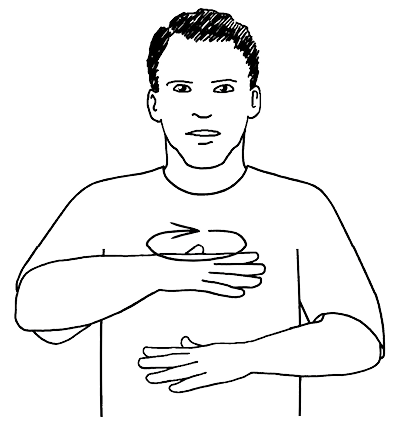
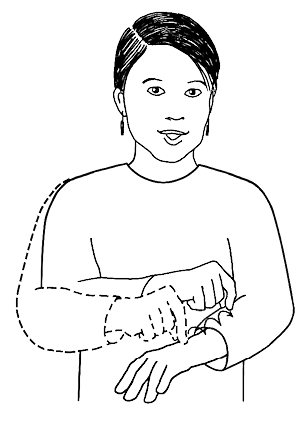
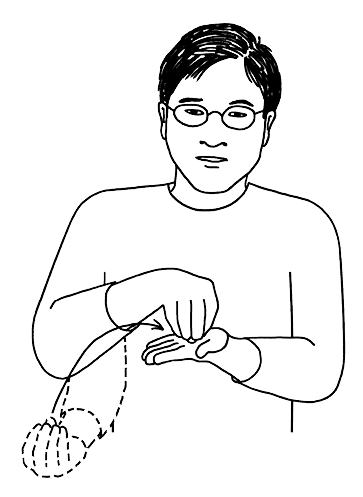

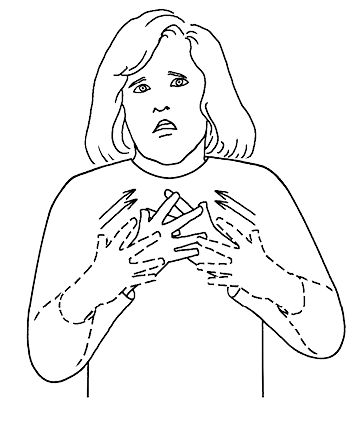
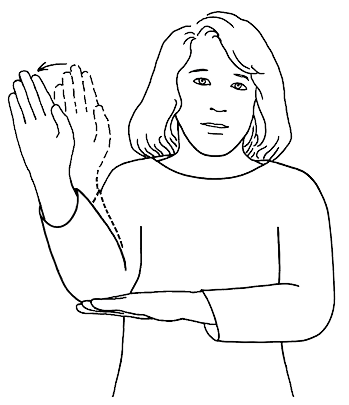

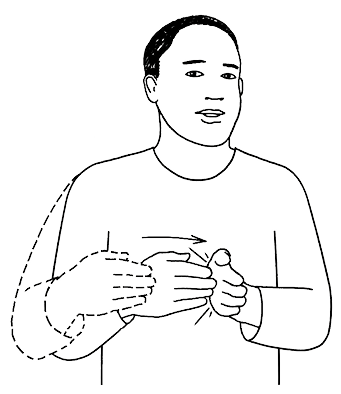
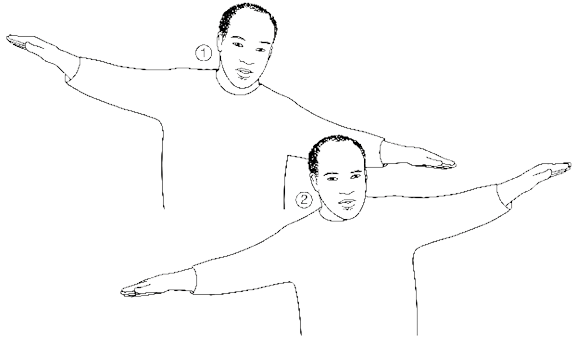

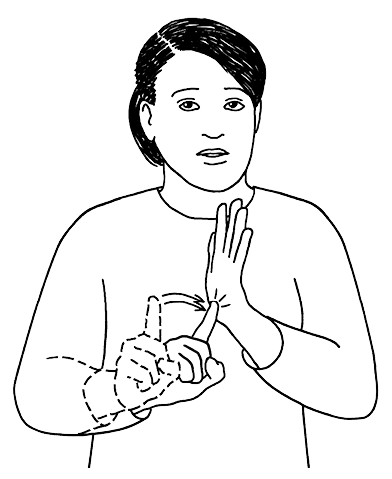


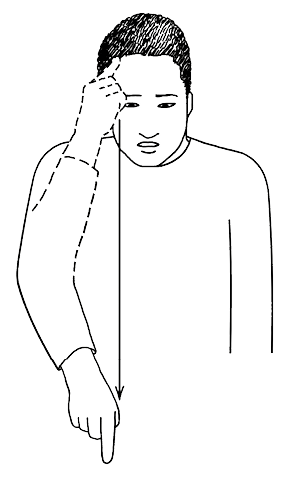
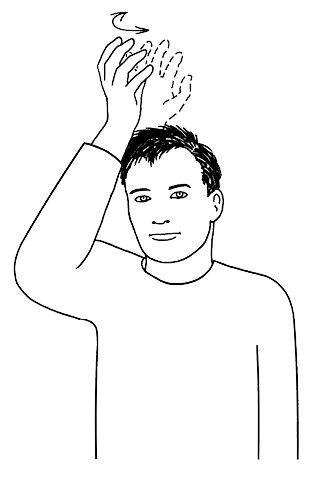
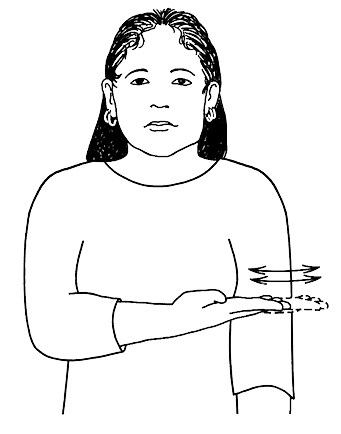




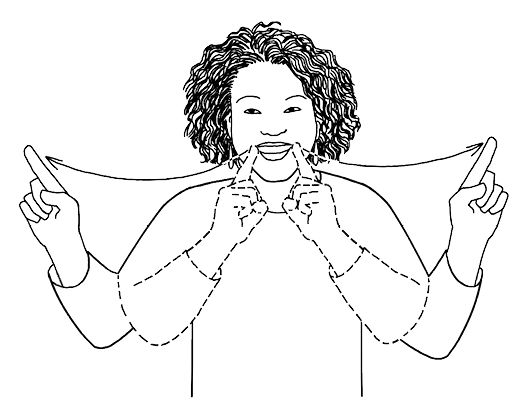
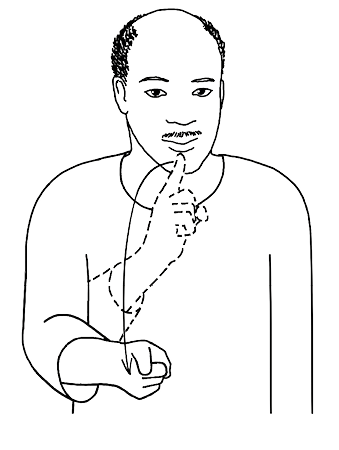
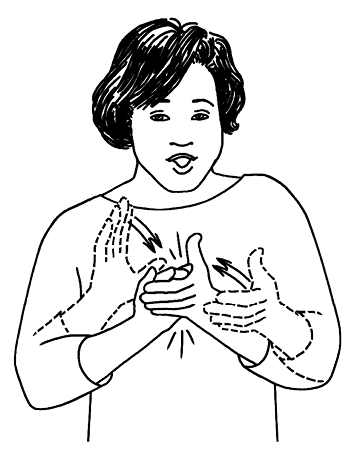
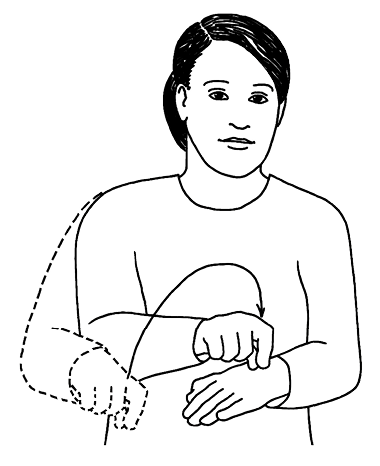
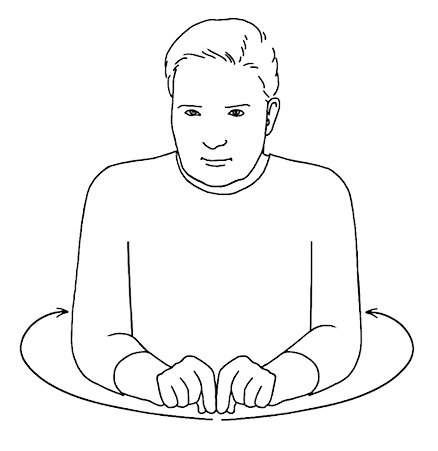
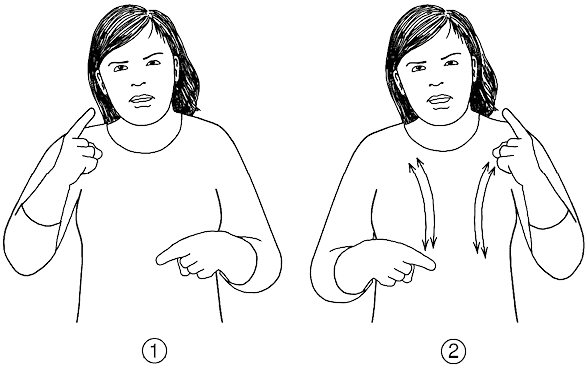


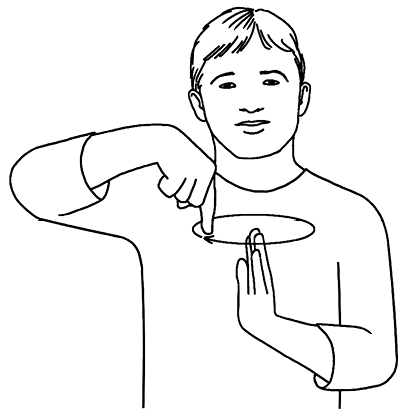
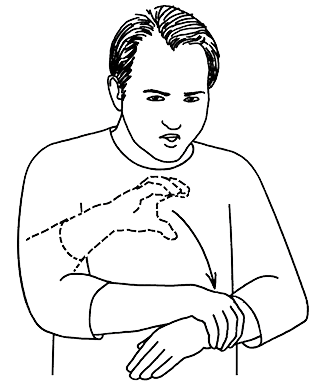
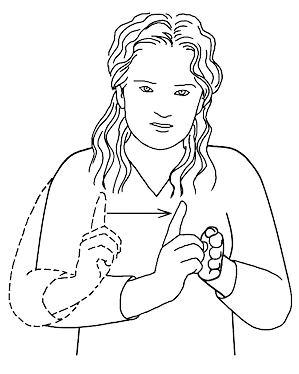
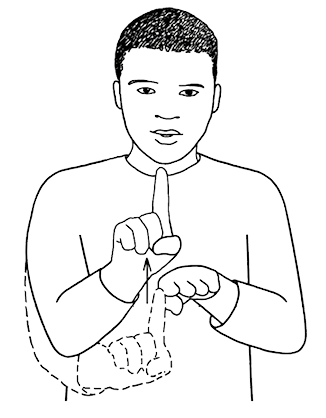
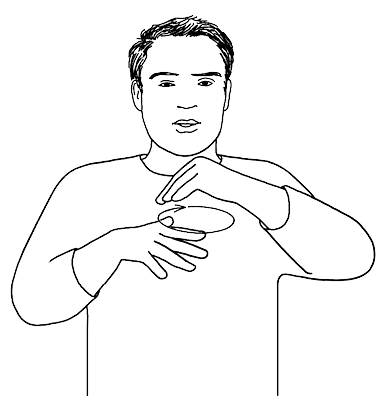
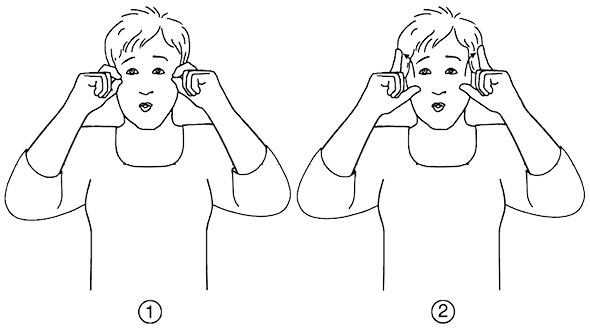


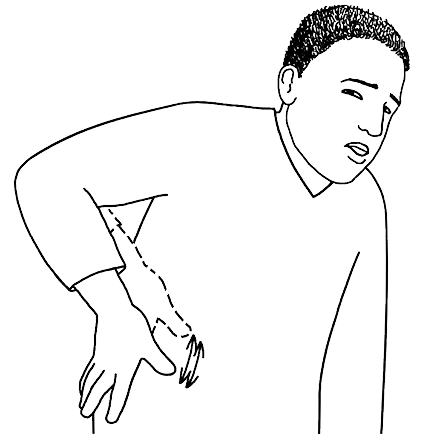




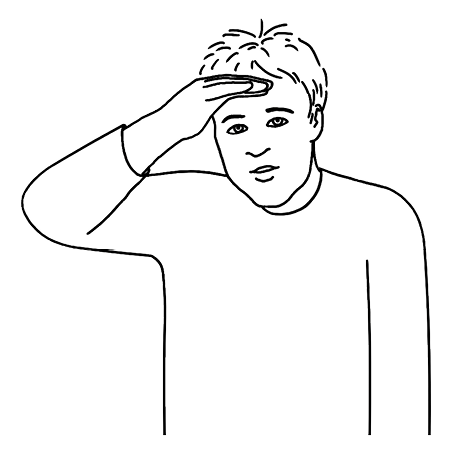


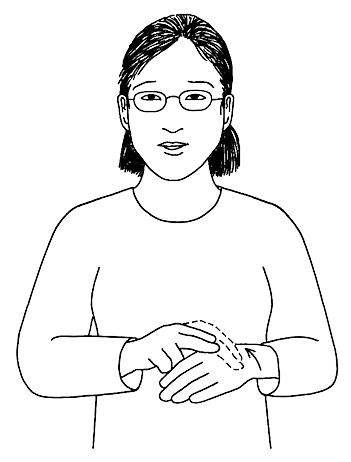


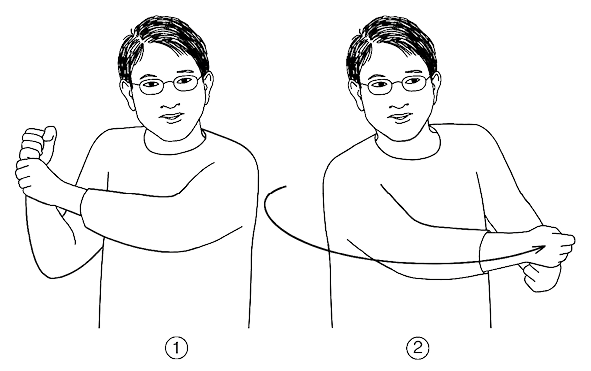
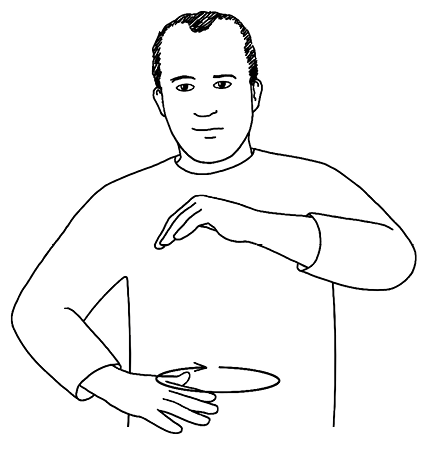

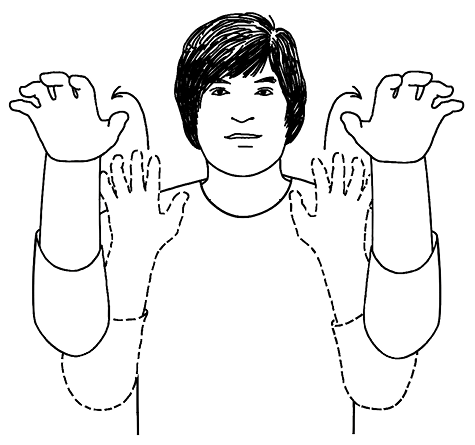
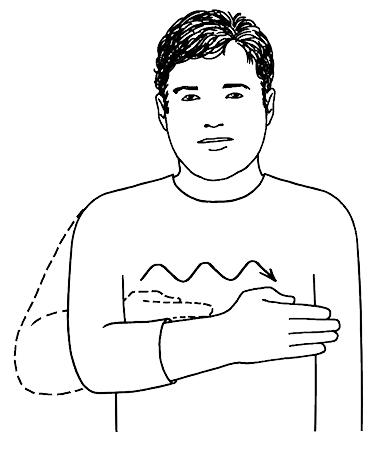


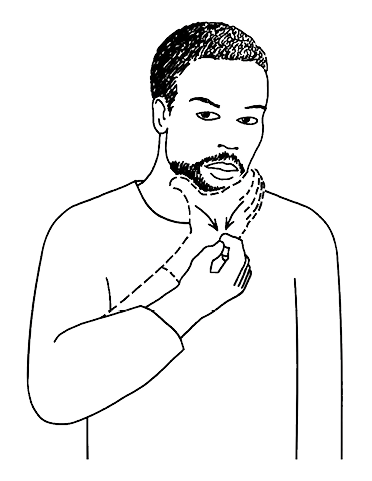
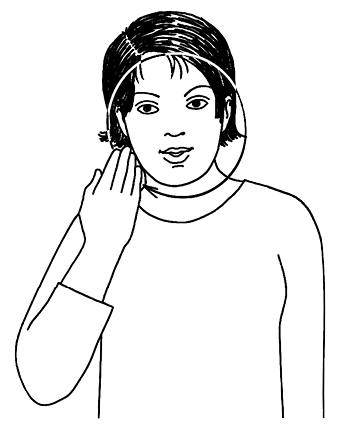

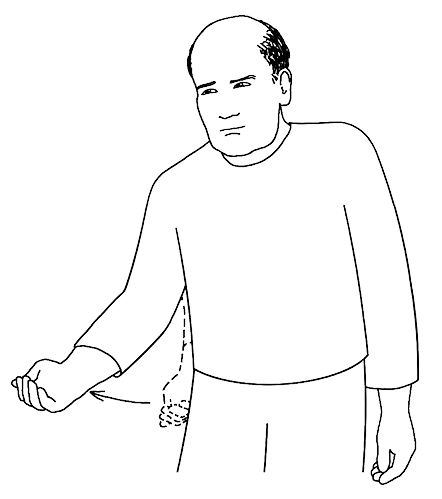

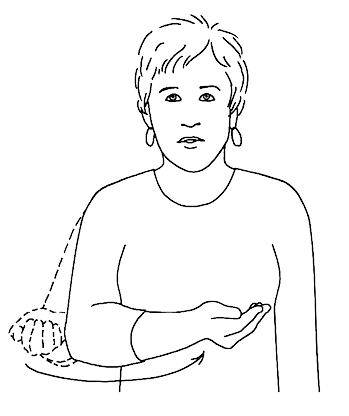
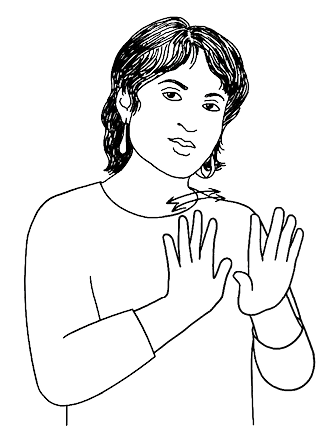

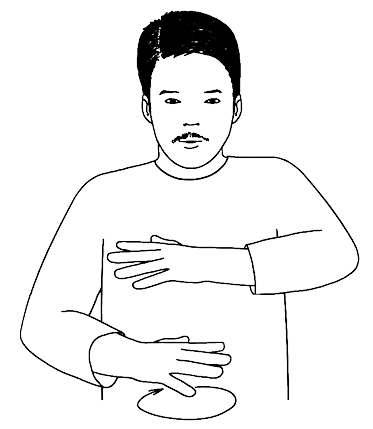
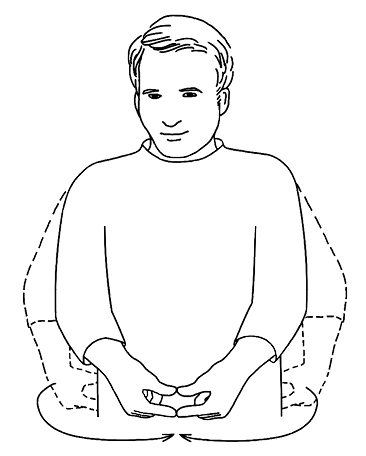
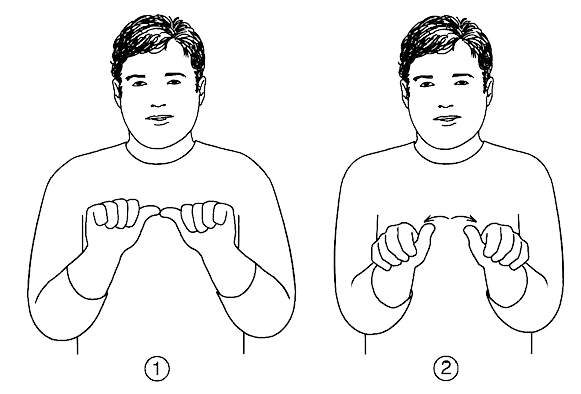
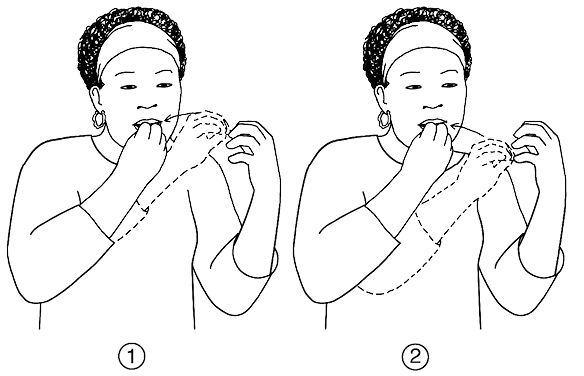
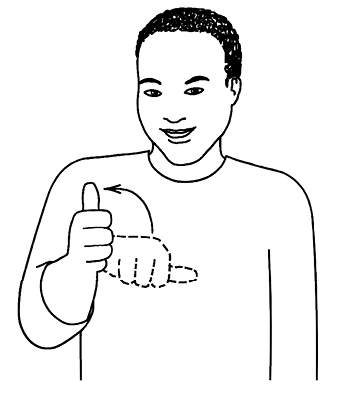
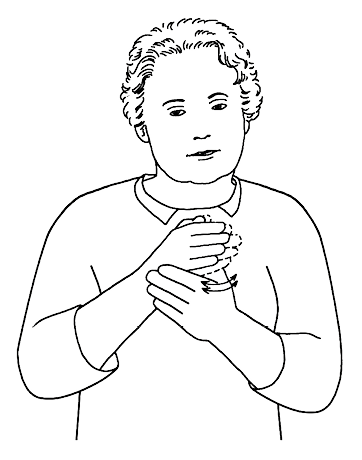

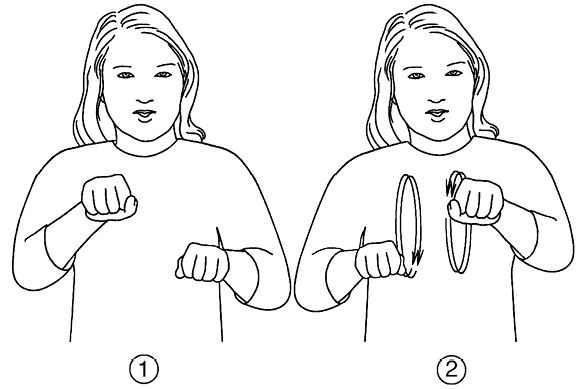



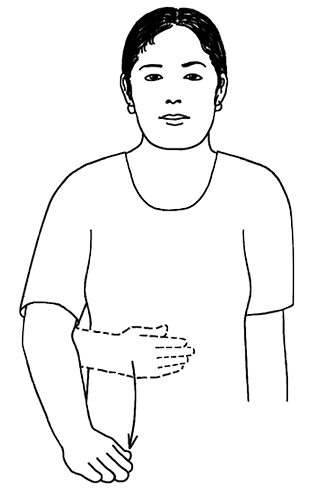

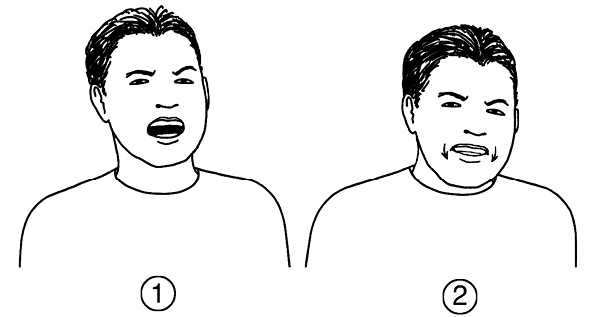

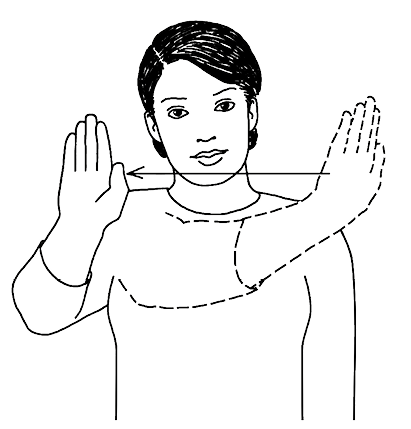
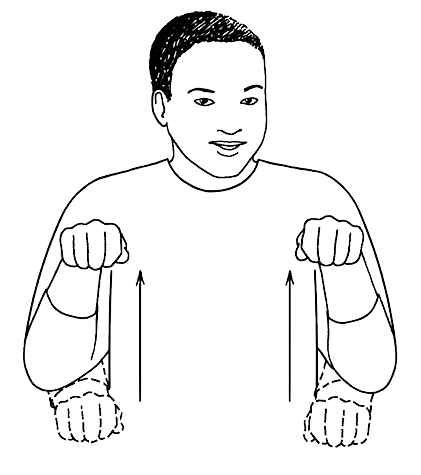
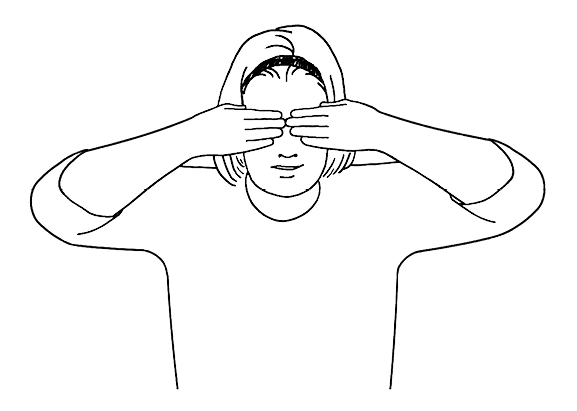
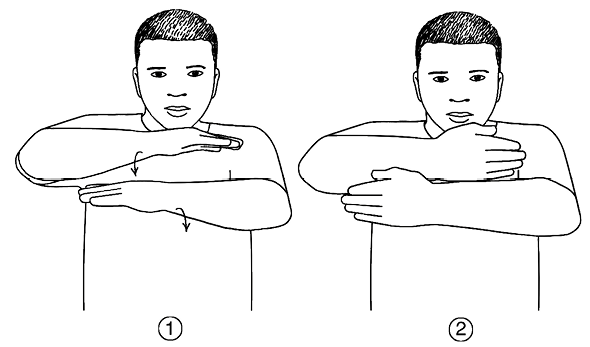


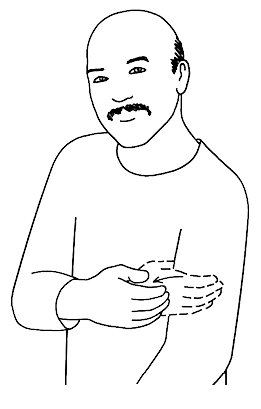


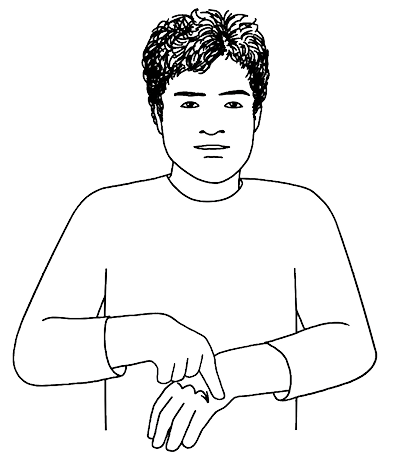

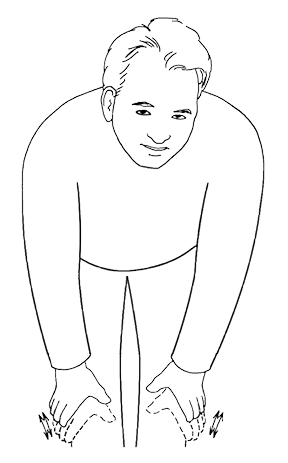


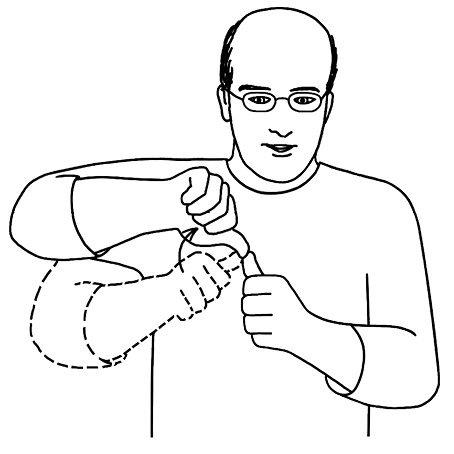

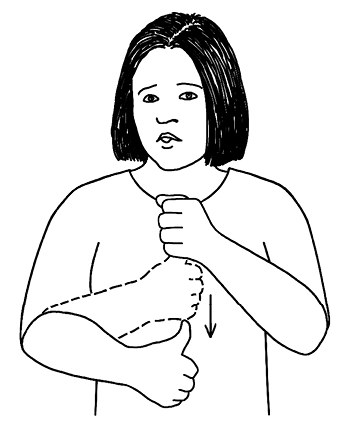
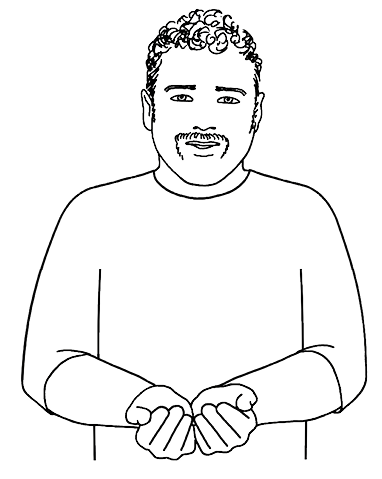
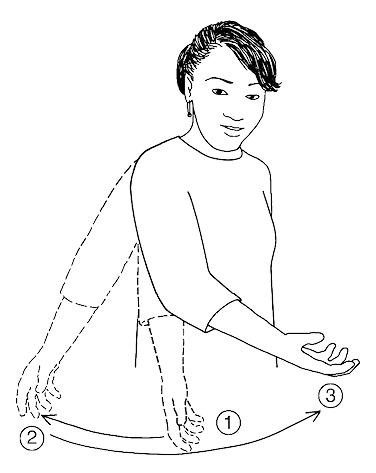


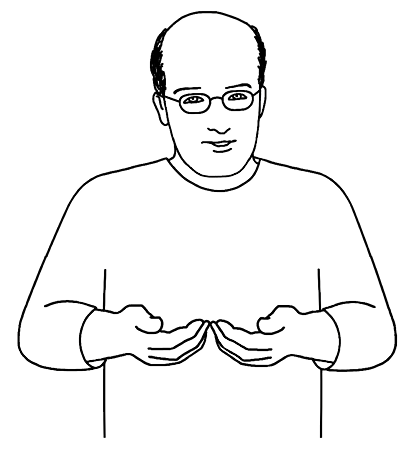
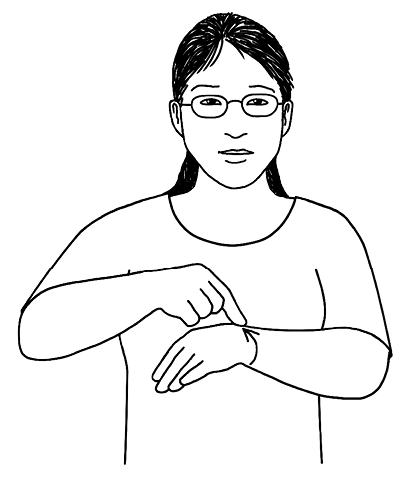
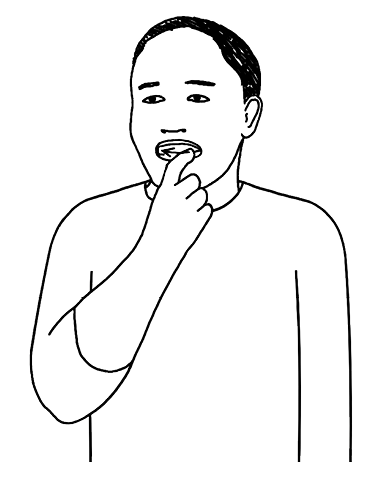


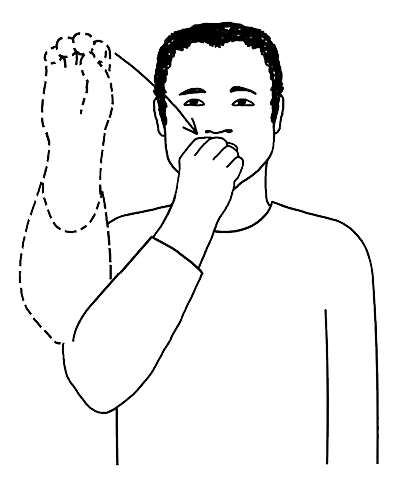
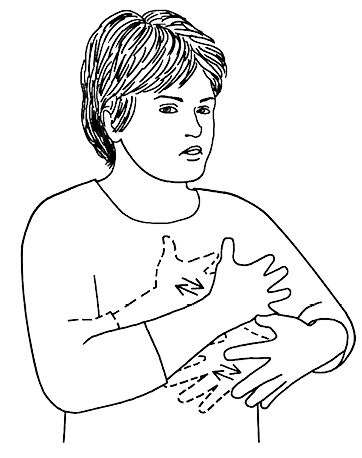

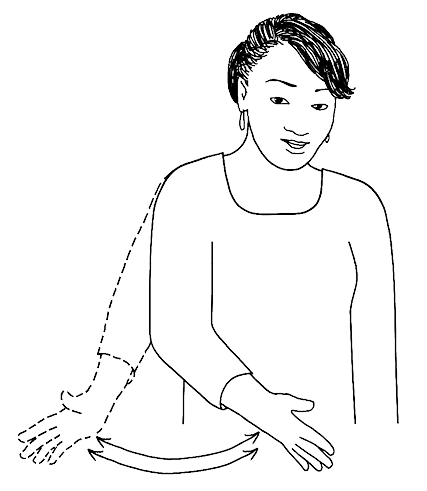
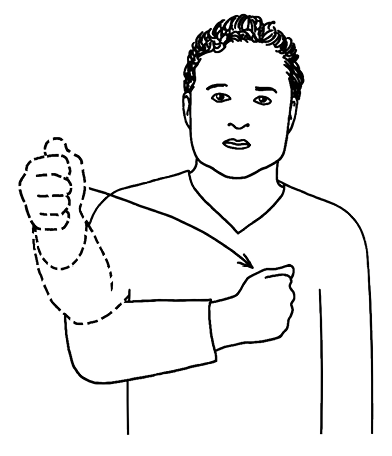
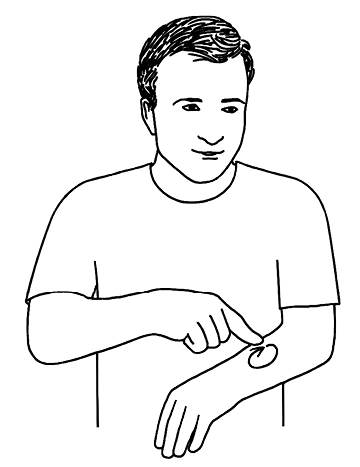

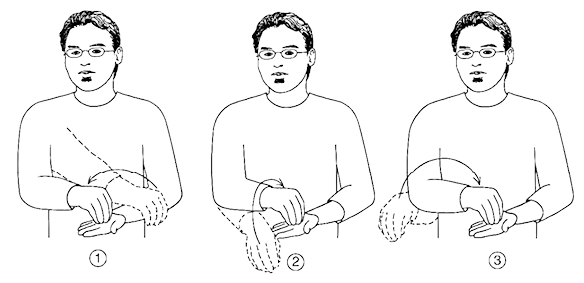


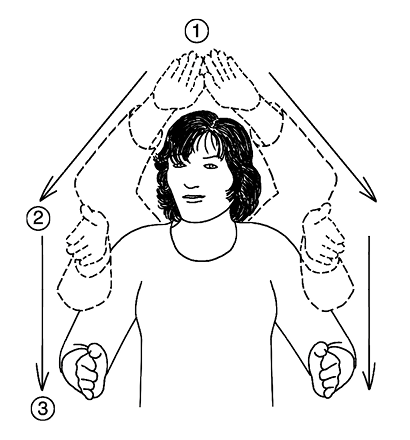

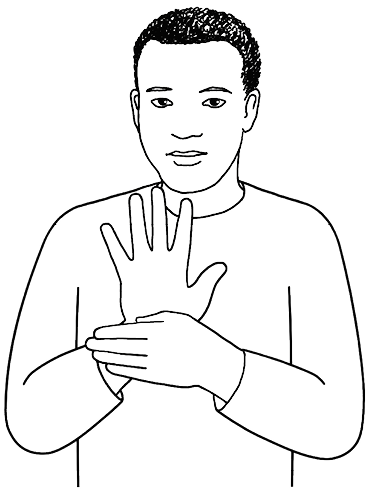
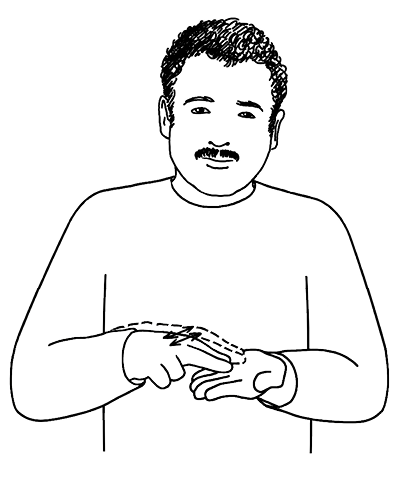

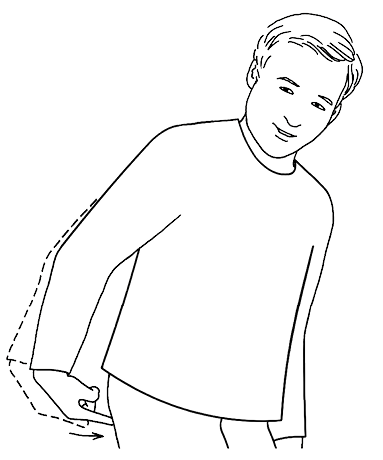
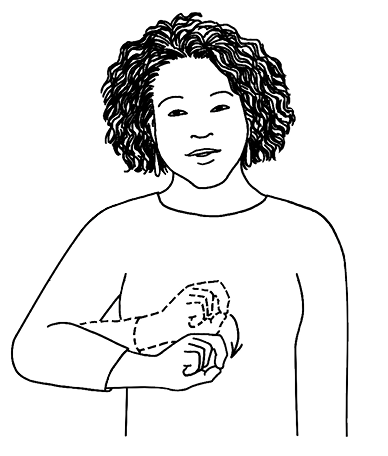
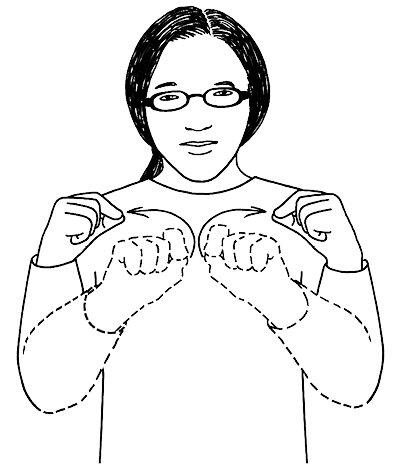


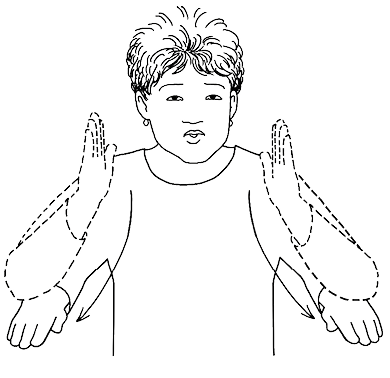
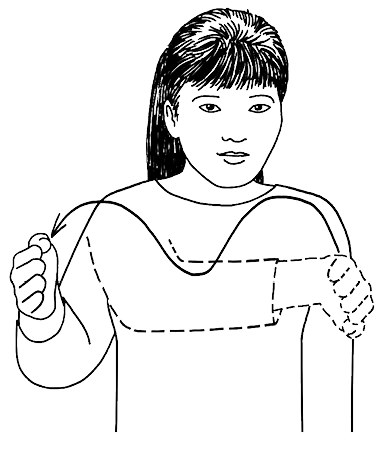



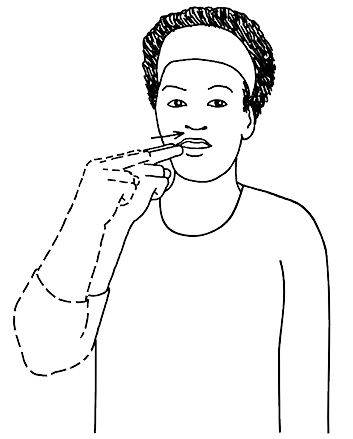
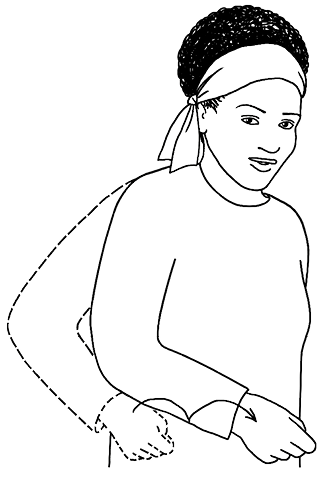
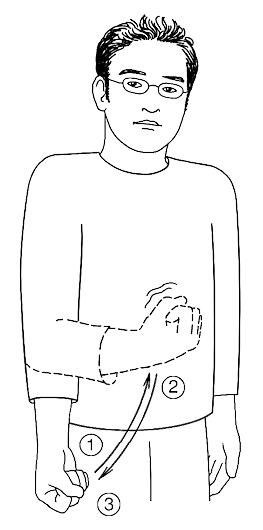
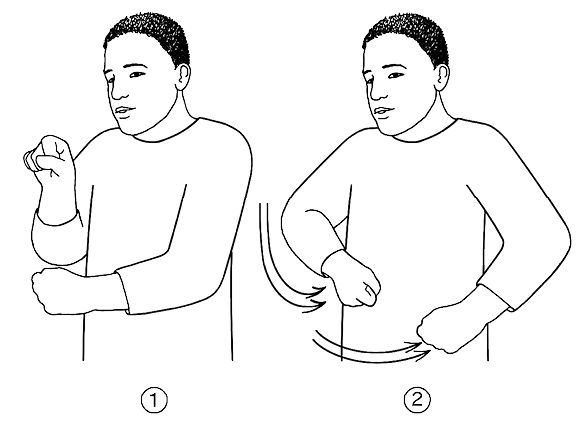

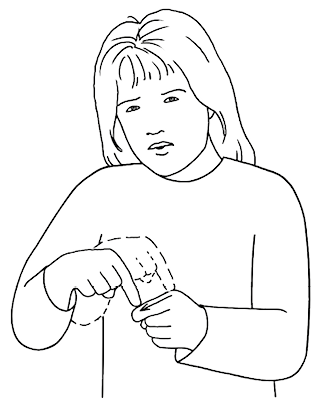
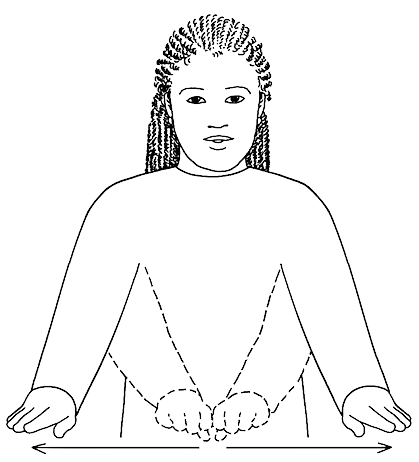

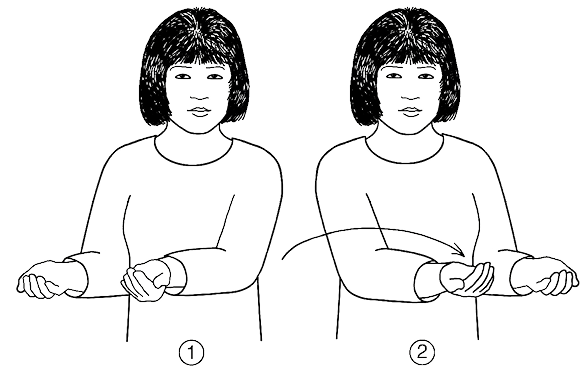

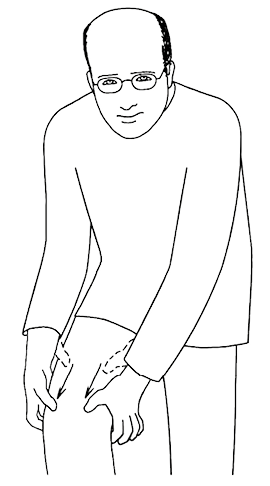

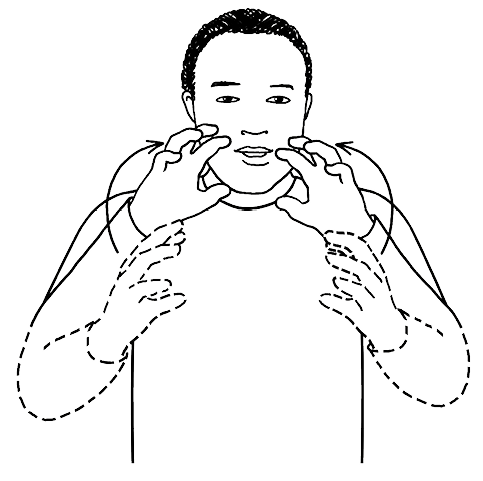
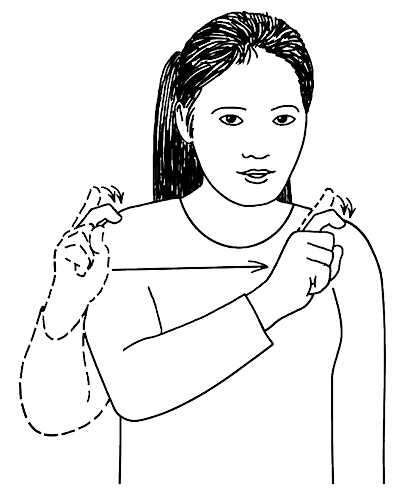
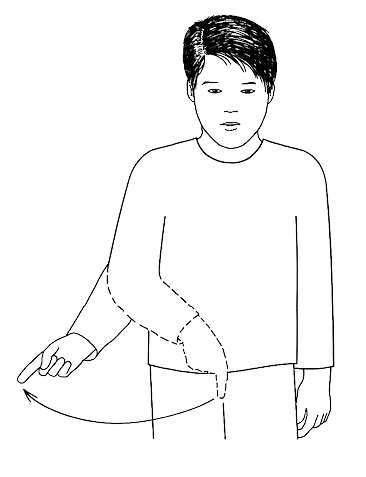

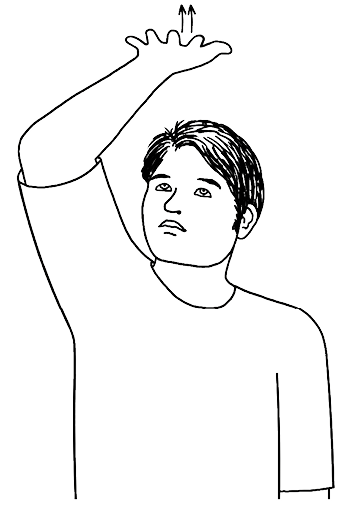
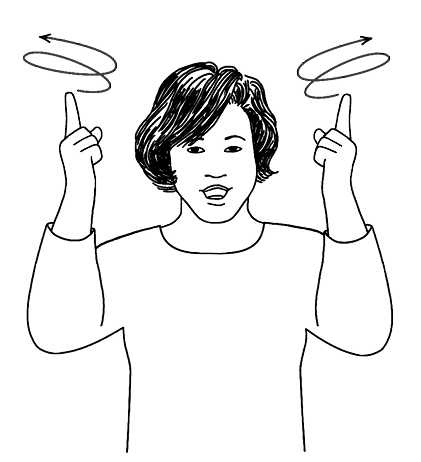
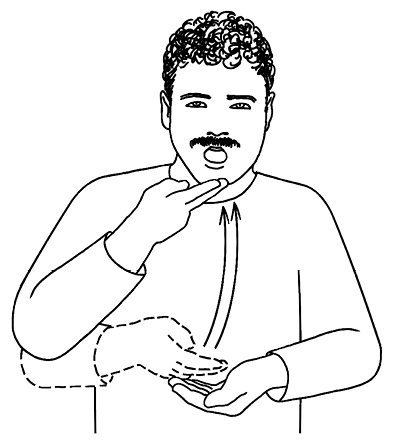




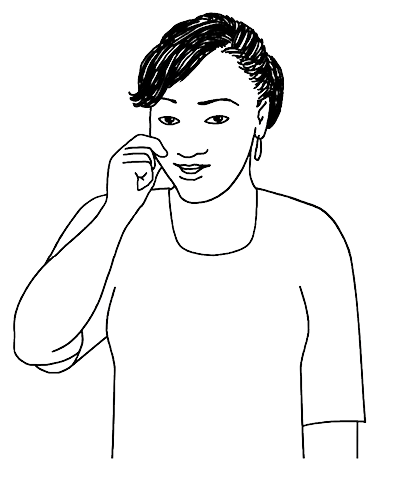





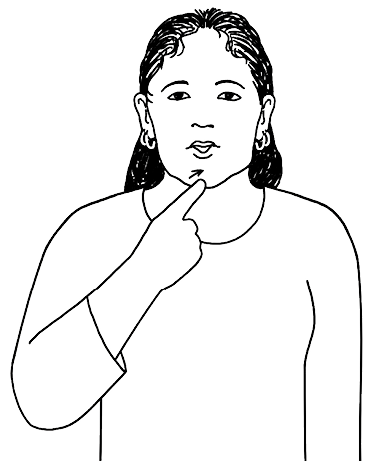

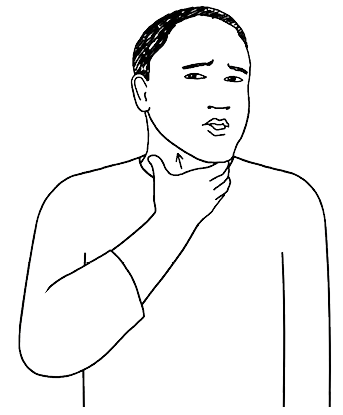

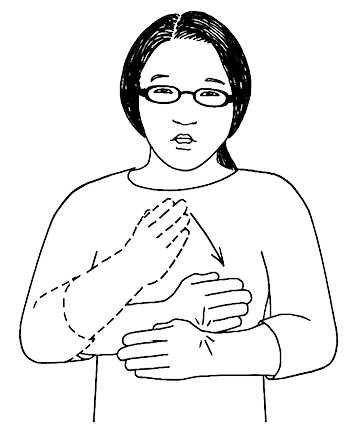
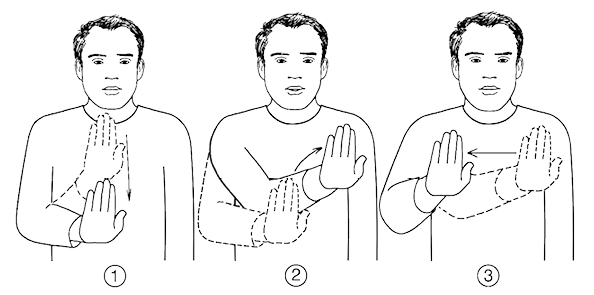

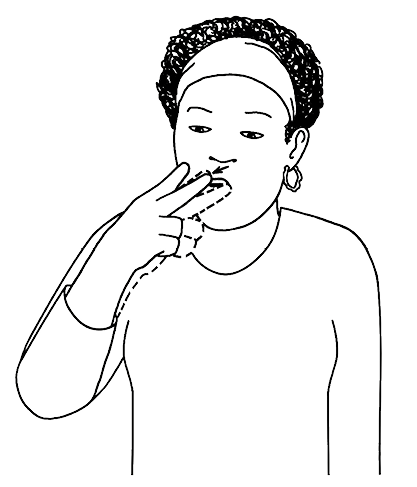

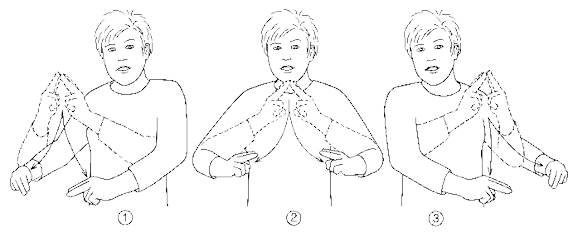

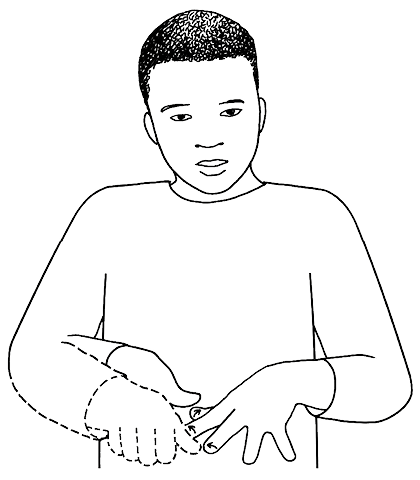
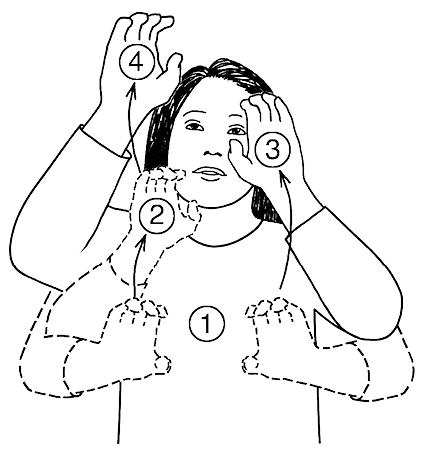
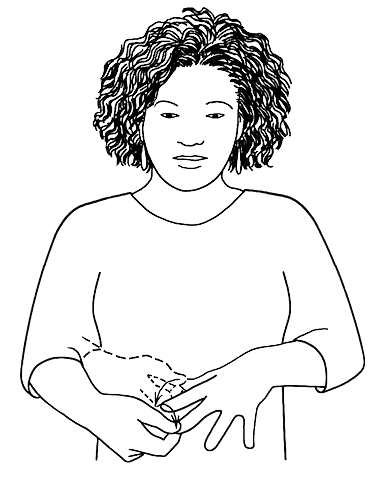

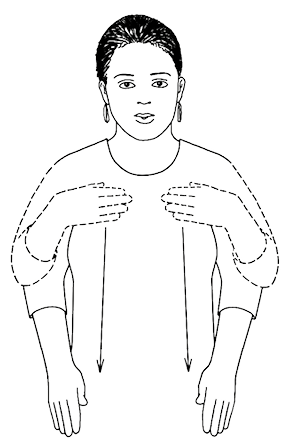

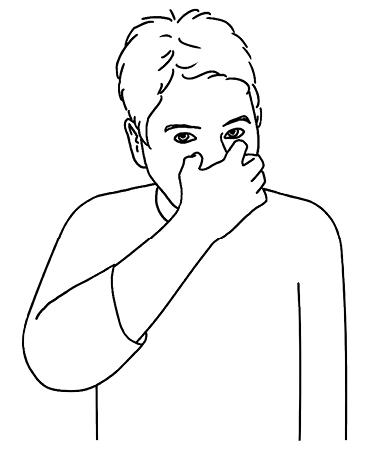
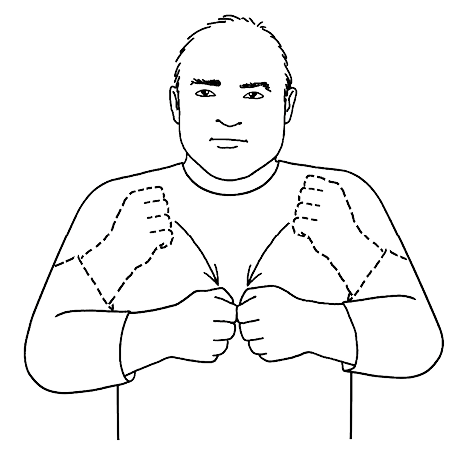
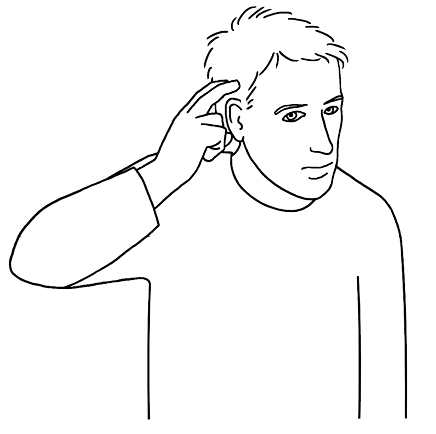

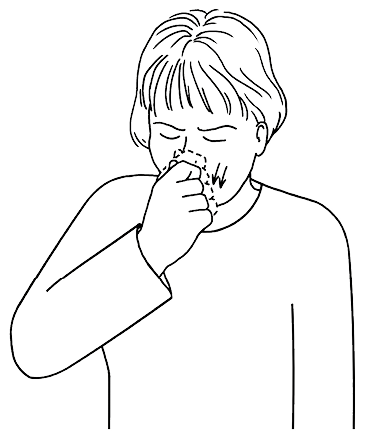
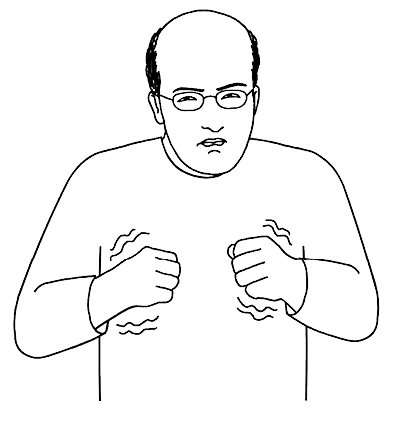

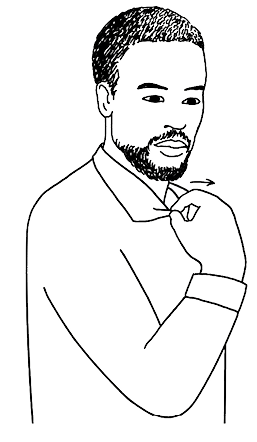
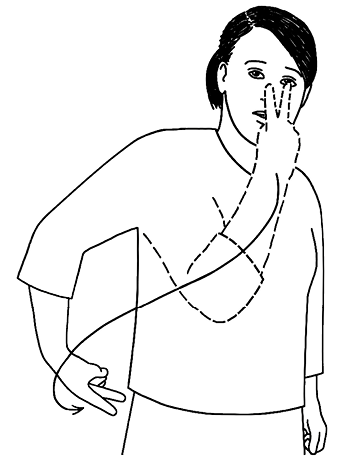
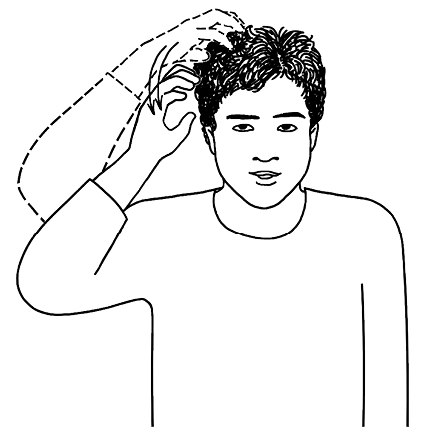
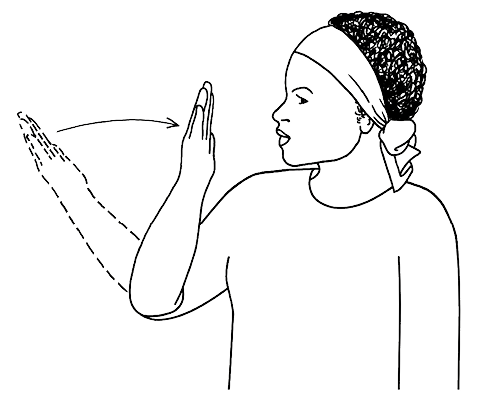
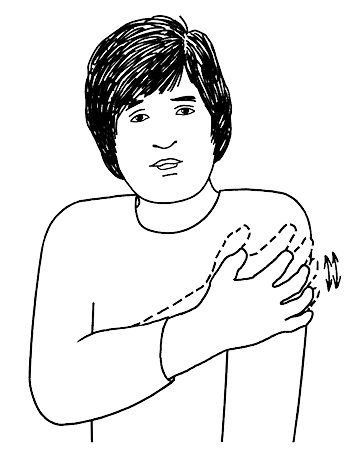
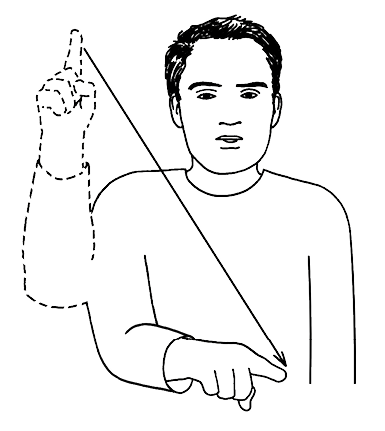

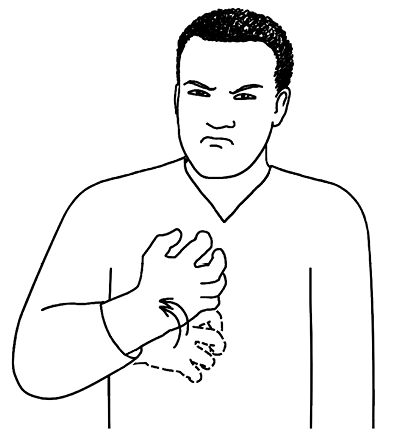

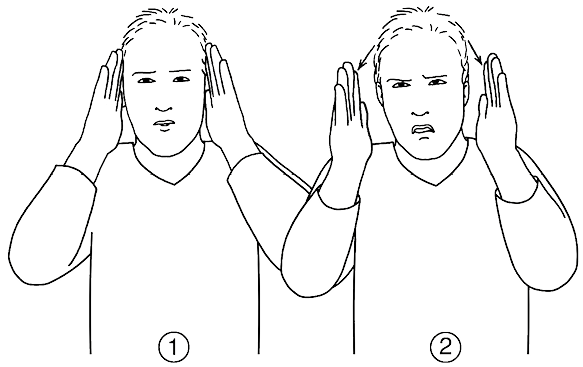
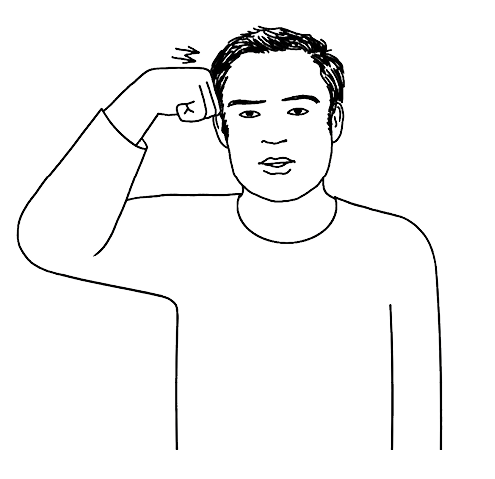
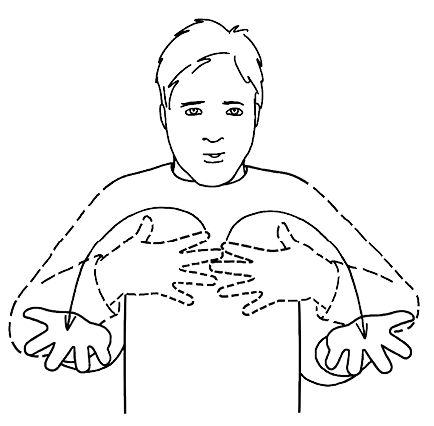
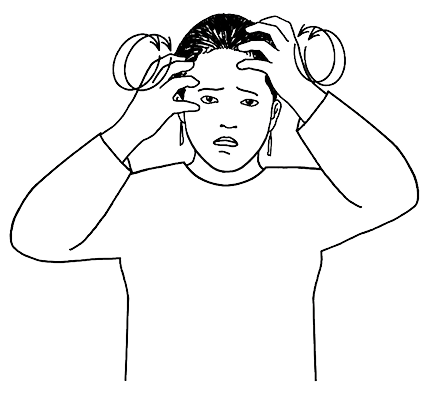
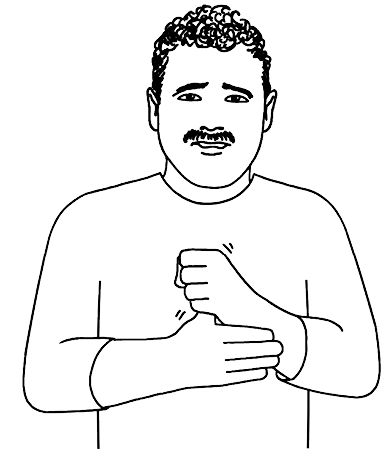
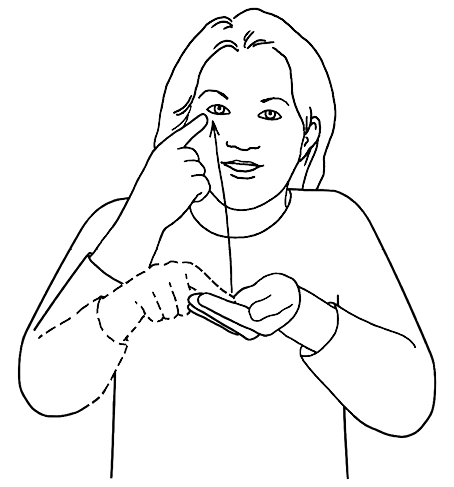





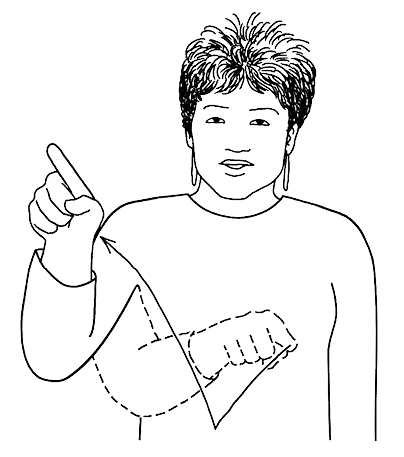


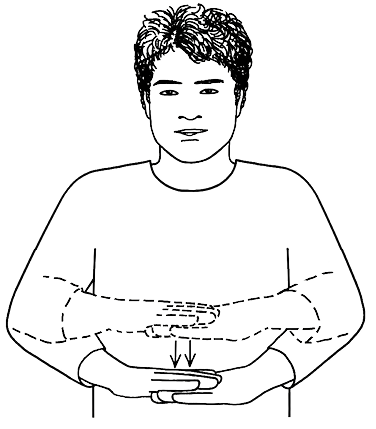
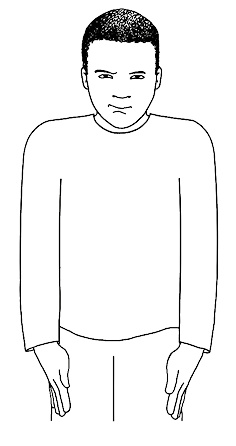


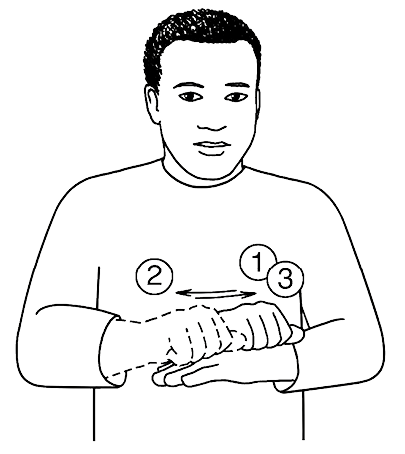
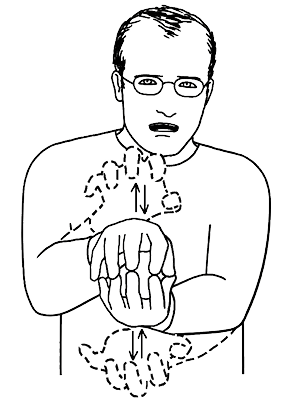
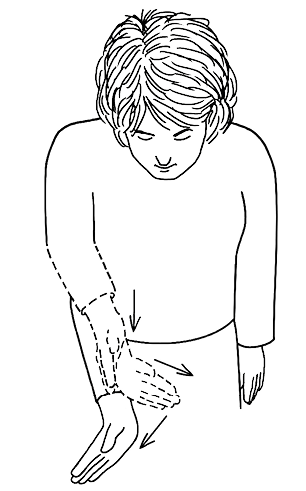

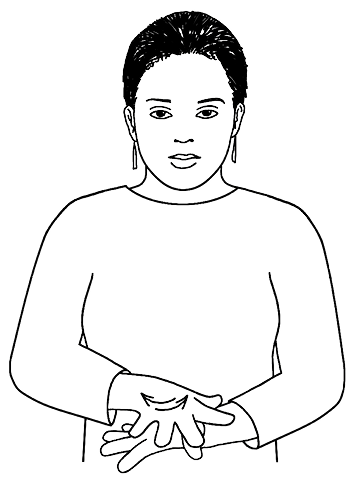
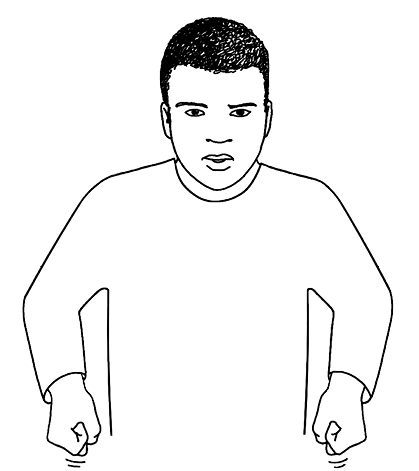



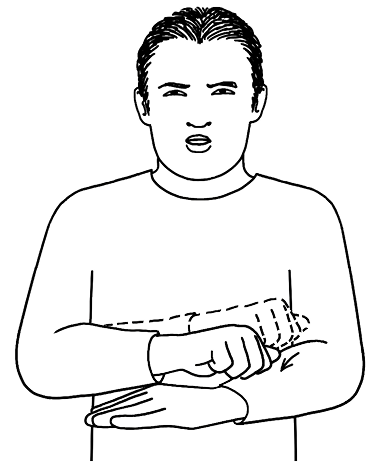
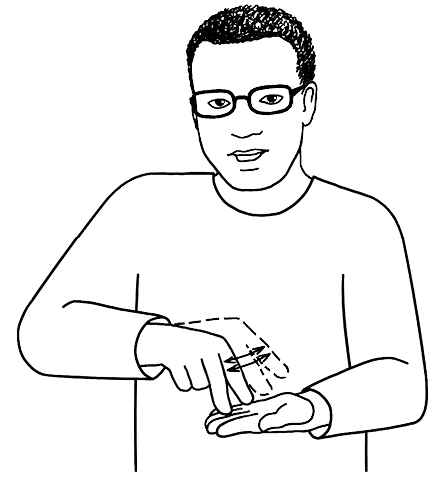
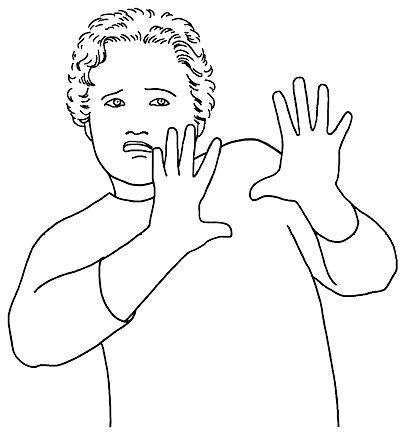
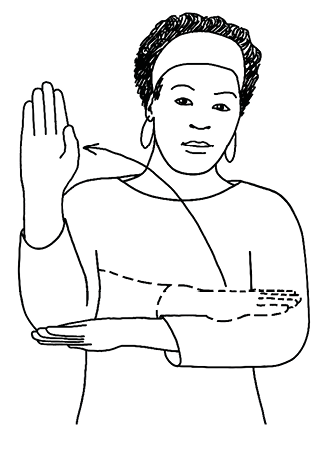
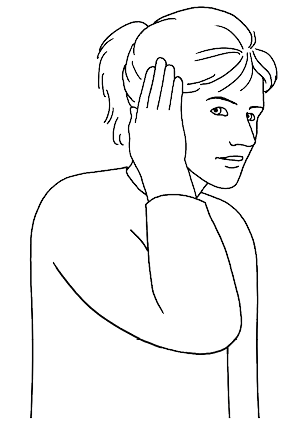


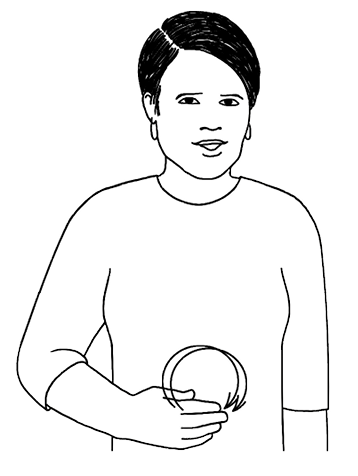
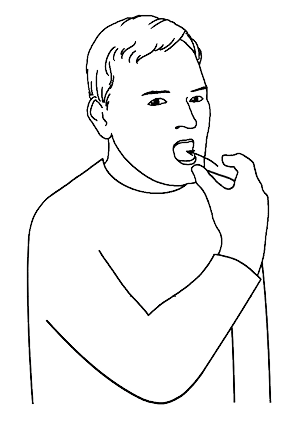

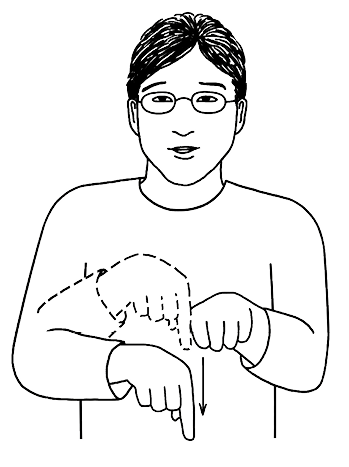
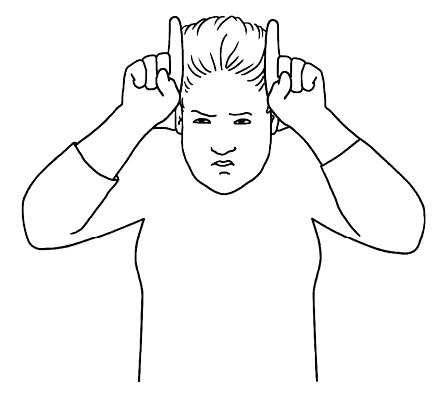

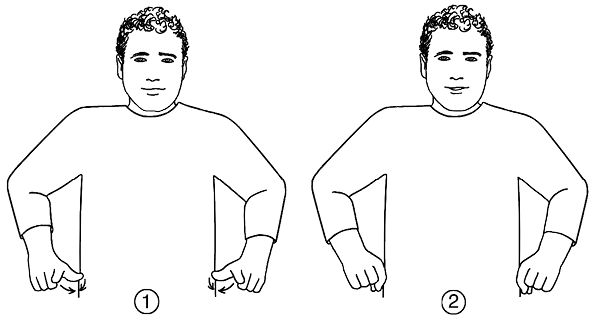
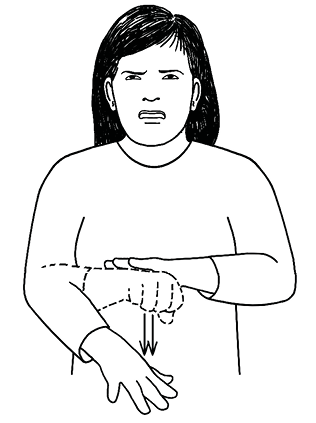
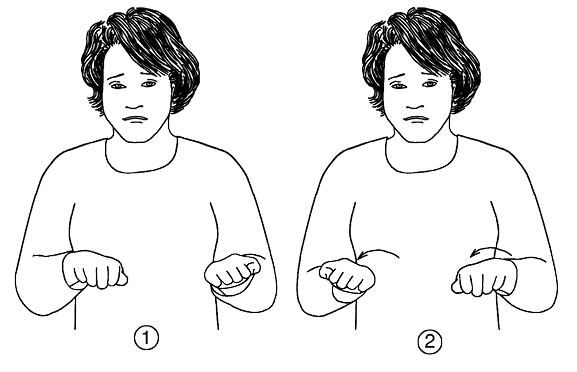

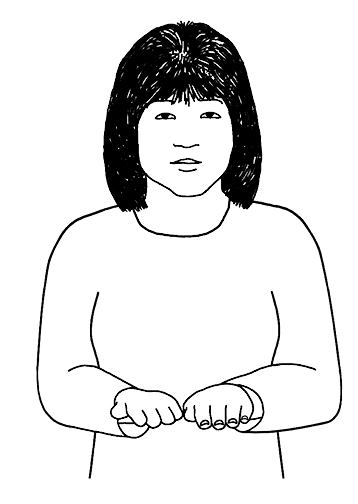
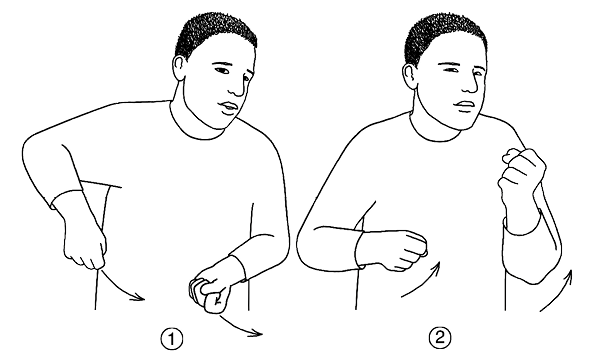
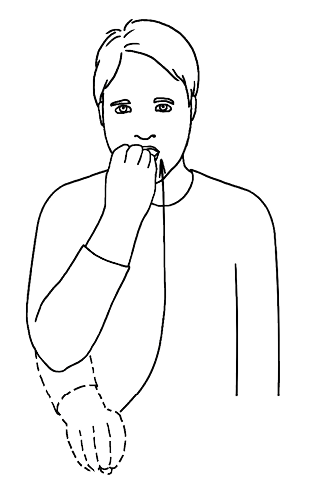
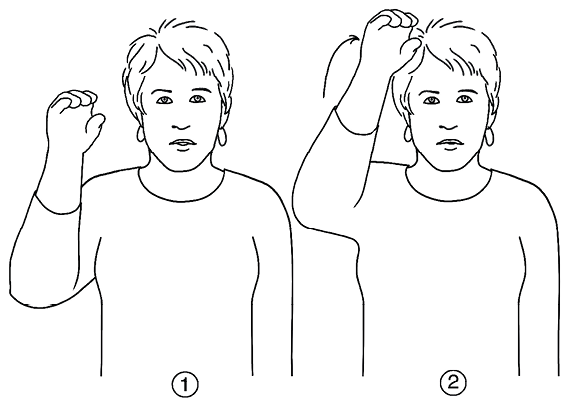

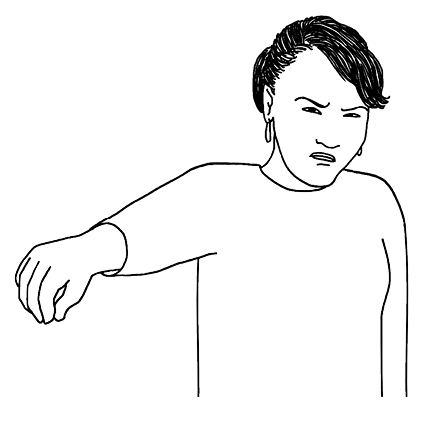
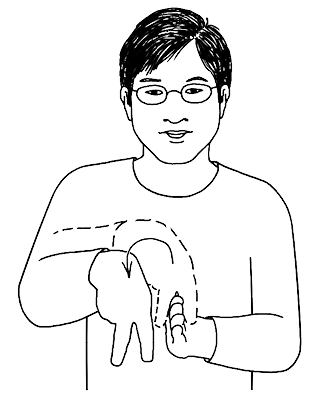
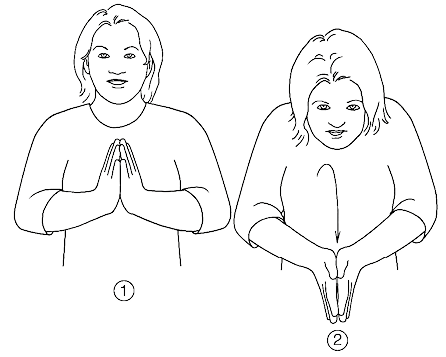
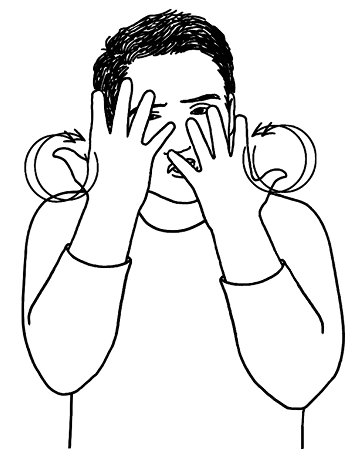


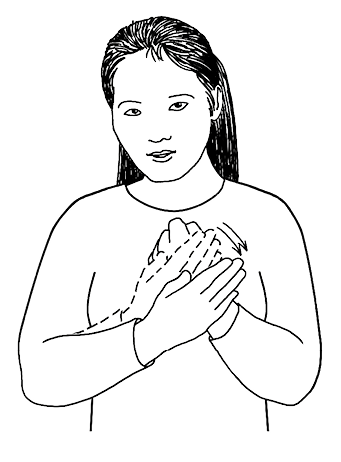


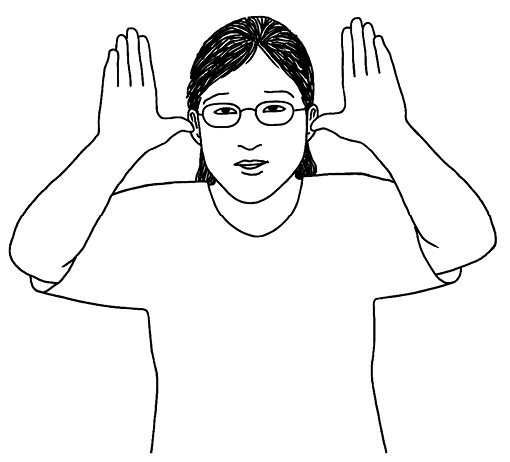
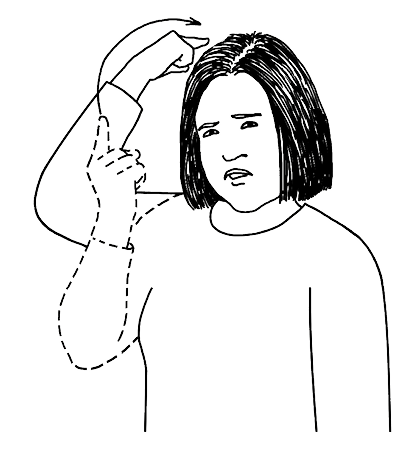
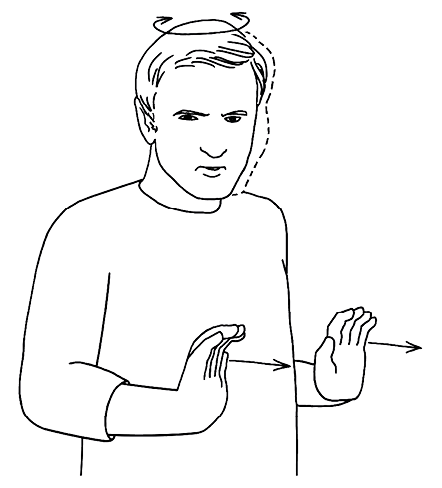

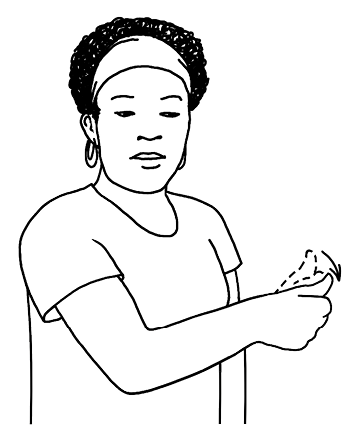

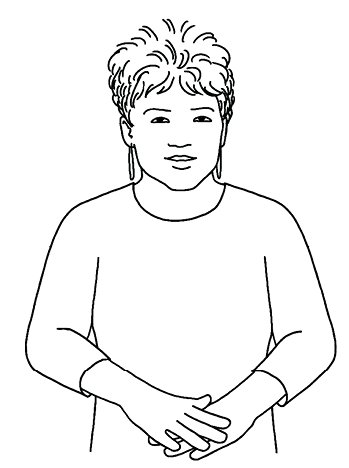

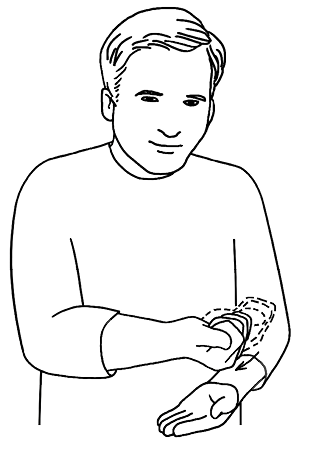
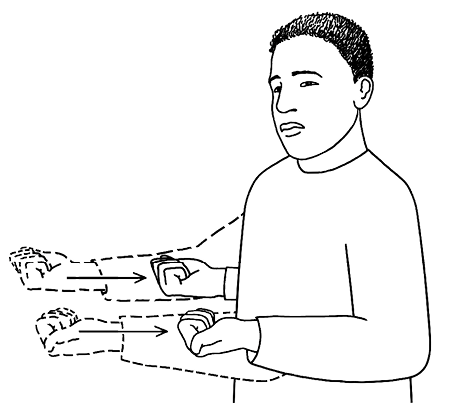
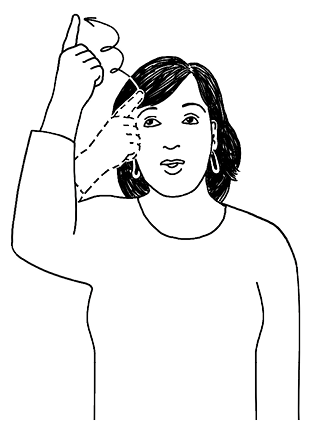

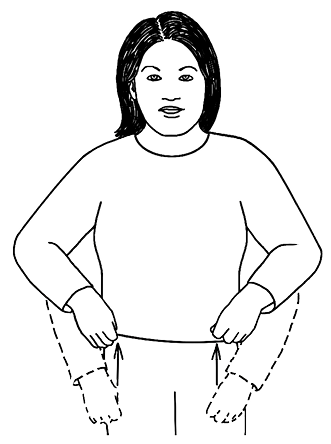
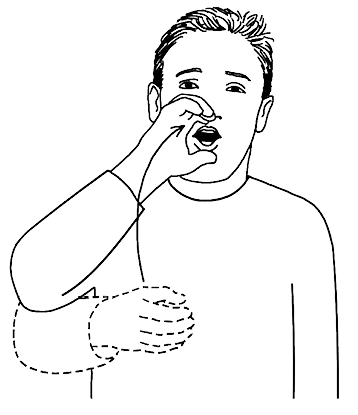

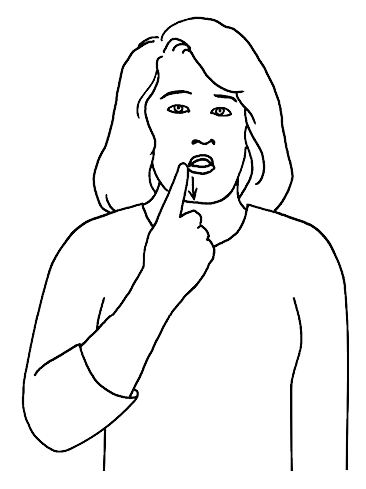


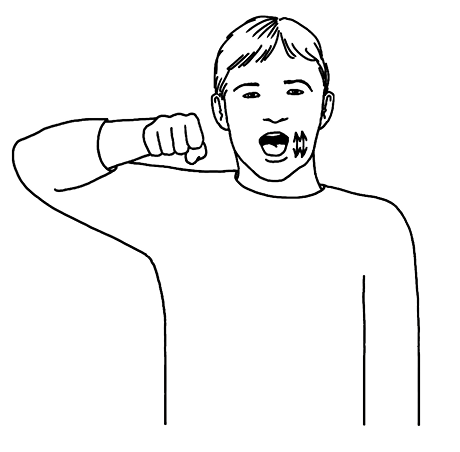
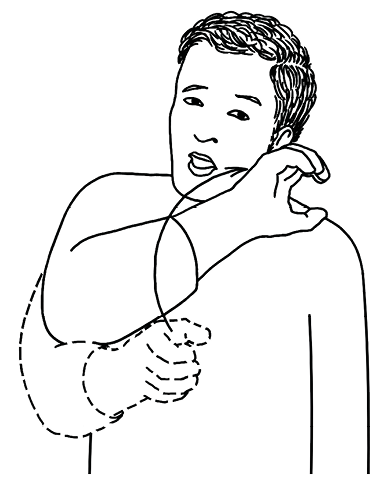
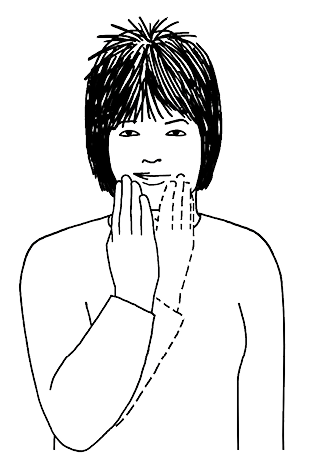
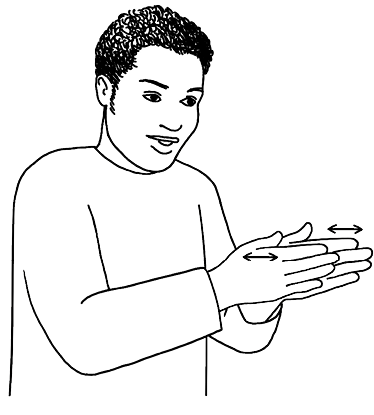
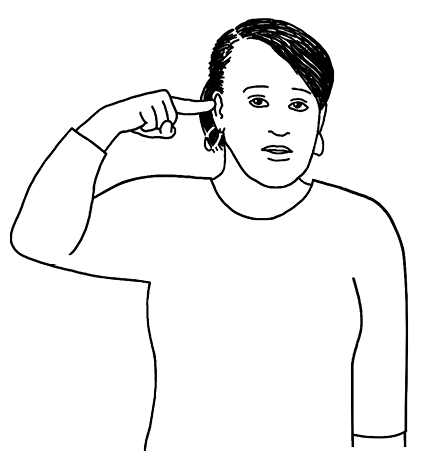
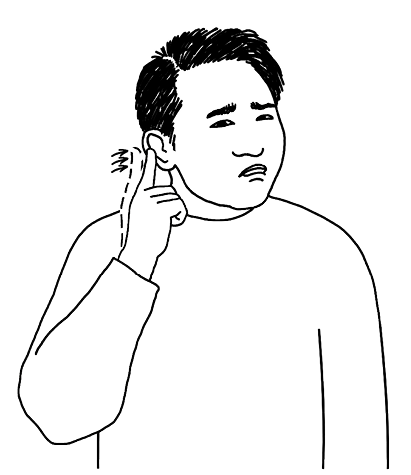
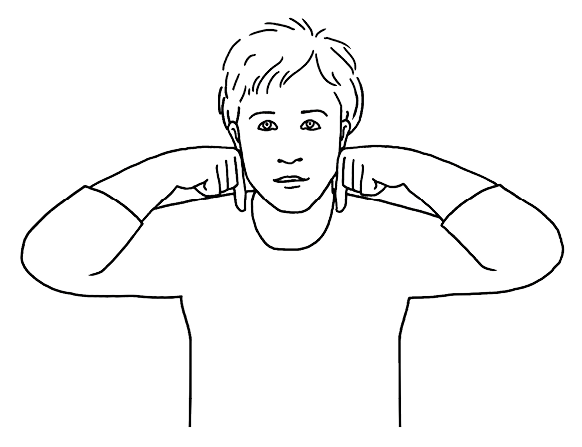
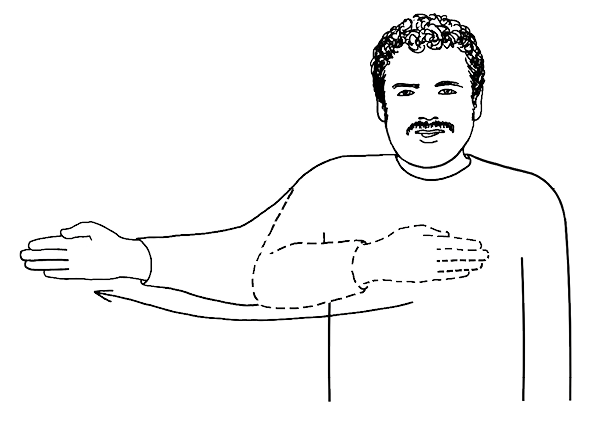
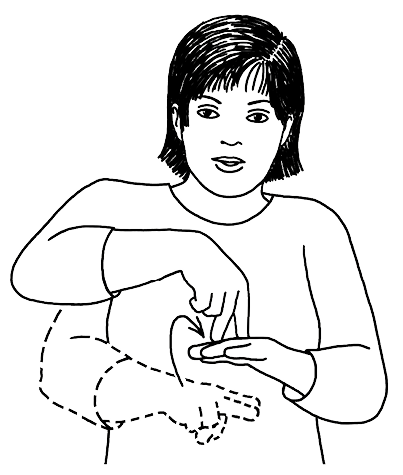
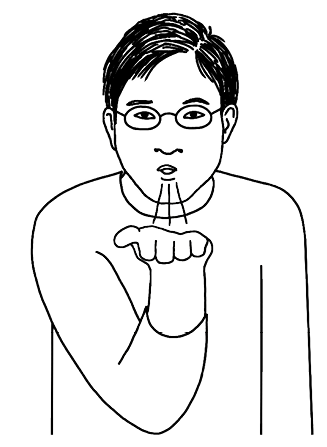


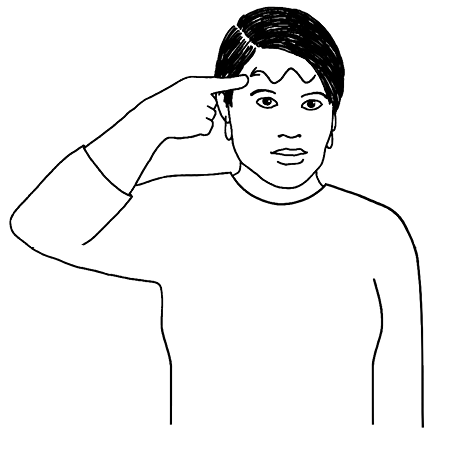


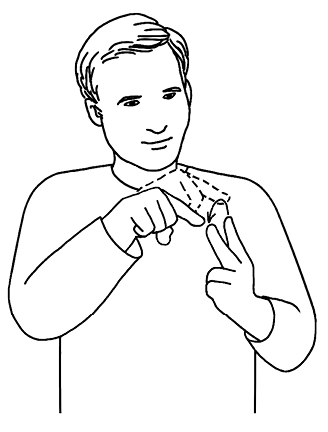
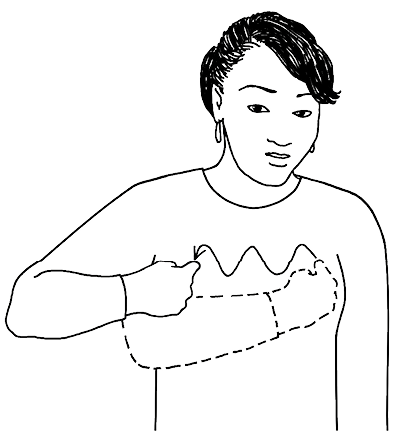


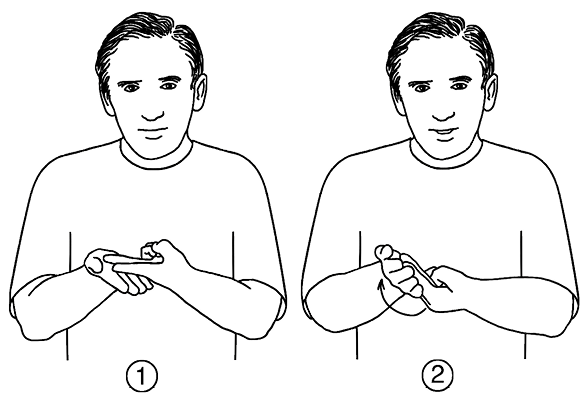

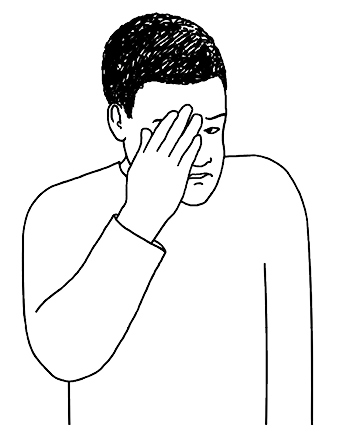

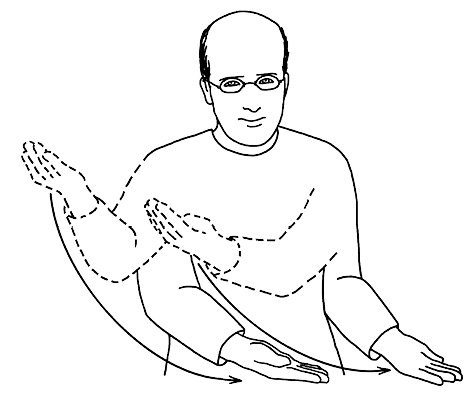

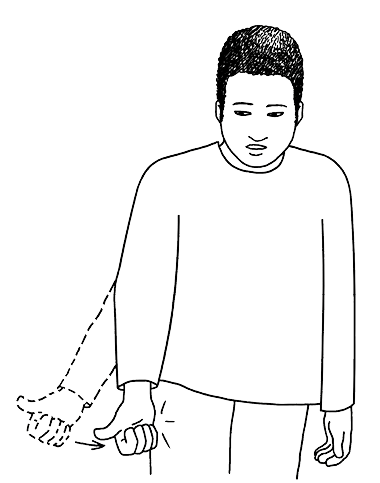
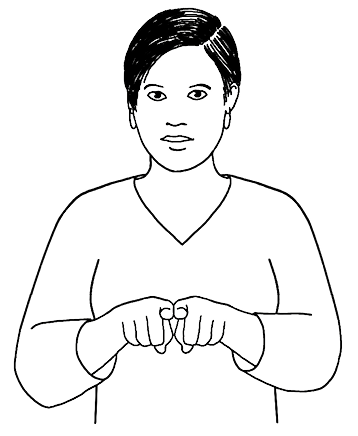

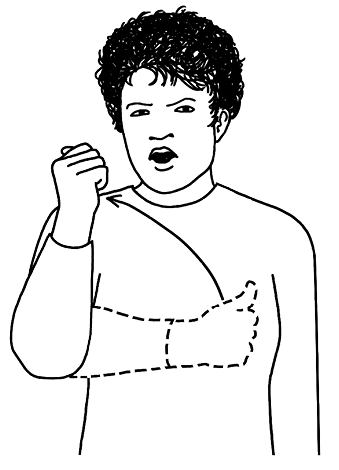

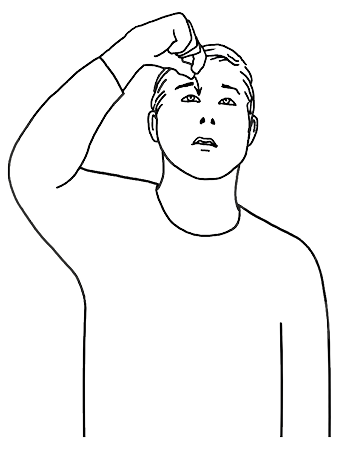
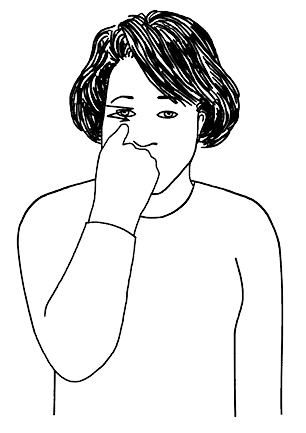
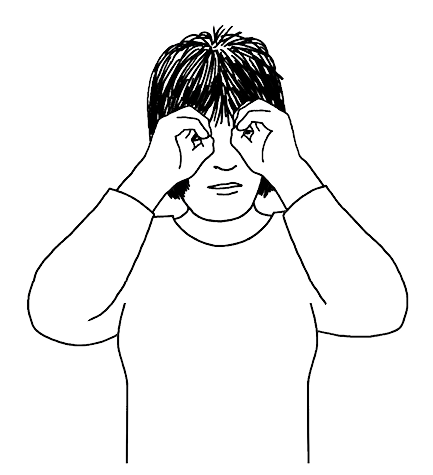
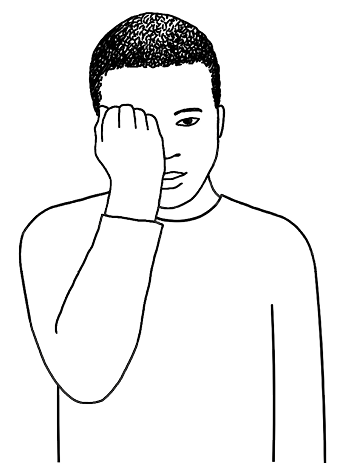


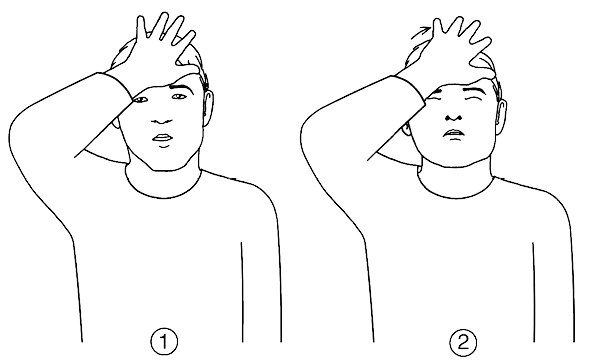
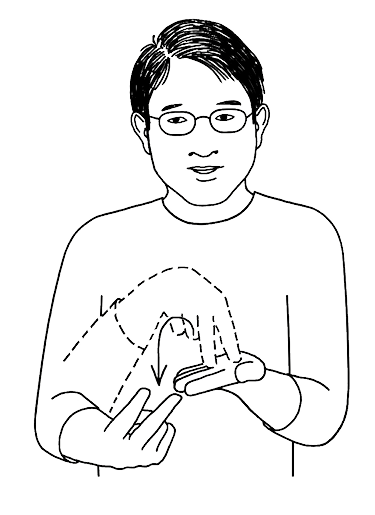


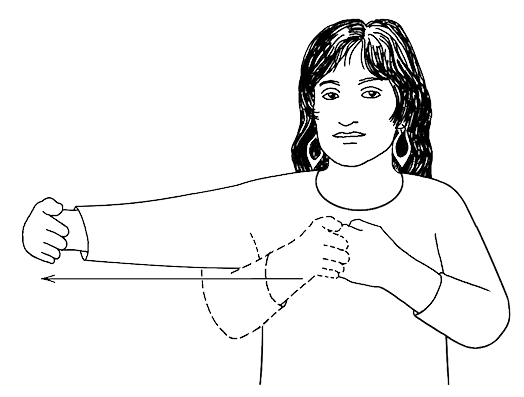

.png)

